
Groovy Mashed Potatoes - Travel Blog
Unique travel experiences, fun itineraries & offbeat places to help you plan your dream trip

Best W Trek Refugios and Campsites in Torres Del Paine
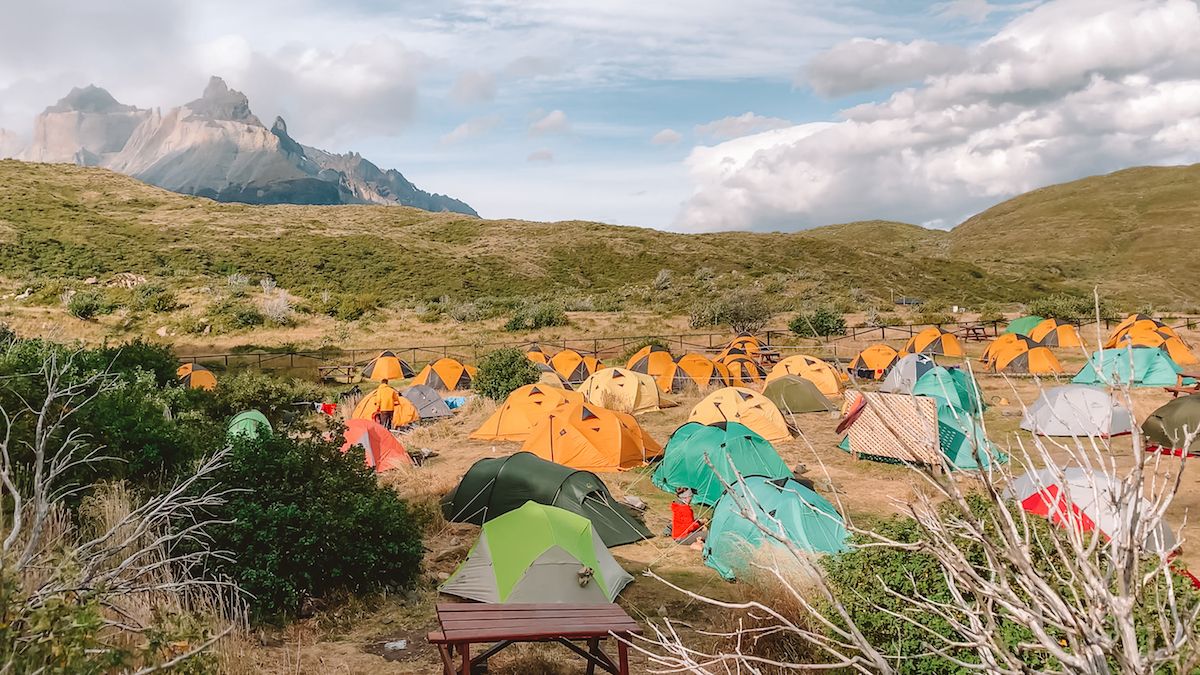
The nice thing about the W Trek in Torres Del Paine is that you have a variety of ways to hike it. The challenge is picking your route and finding all the information on the campsites or lodges. We stopped in at each W Trek Refugio and checked out their facilities. Campsites and lodges along the W Trek are operated either by Fantastico Sur or Vertice Patagonia , so you will have to book them independently using two websites.
We completed the W Trek from west to east and camped at the refugios with our own tent. We chose a full-board meal plan, which included breakfast and dinner at the lodges, and a packed lunch to bring on our hike. We did not see the beds/dorms or spend much time in the camp kitchens. Overall the food was better than expected with some refugios serving burgers and pizza for an extra fee.
If you are planning to do the W Trek in Patagonia without a tour, you should also check out our comprehensive guide and itinerary with the best route.
Torres Del Paine W Trek Map
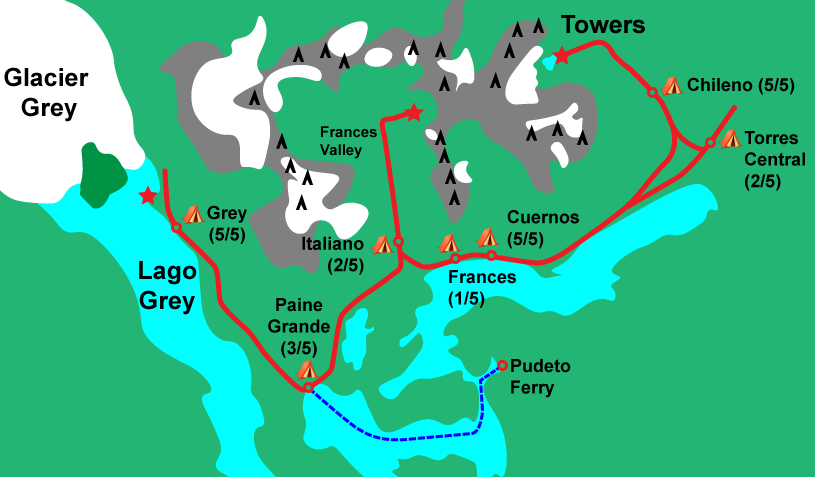
W Trek Refugios and Campsites: Ranked and Rated
Ranked w trek refugios in torres del paine, 1. refugio los cuernos (5/5).
It was love at first tent pad. Through the shrub emerged a beautiful lodge and storied tent pads leading up the hill as we approached Los Cuernos from the west. Each tent pad was spaced well apart with views of both the mountains and the lake. The lodge was intimate and cozy and our meal well put together. Cold Austral Lager beer flowed from a tap. Behind the camping pads near the waterfall were small private cabins with wood burning stoves that looked worth staying a full week in.
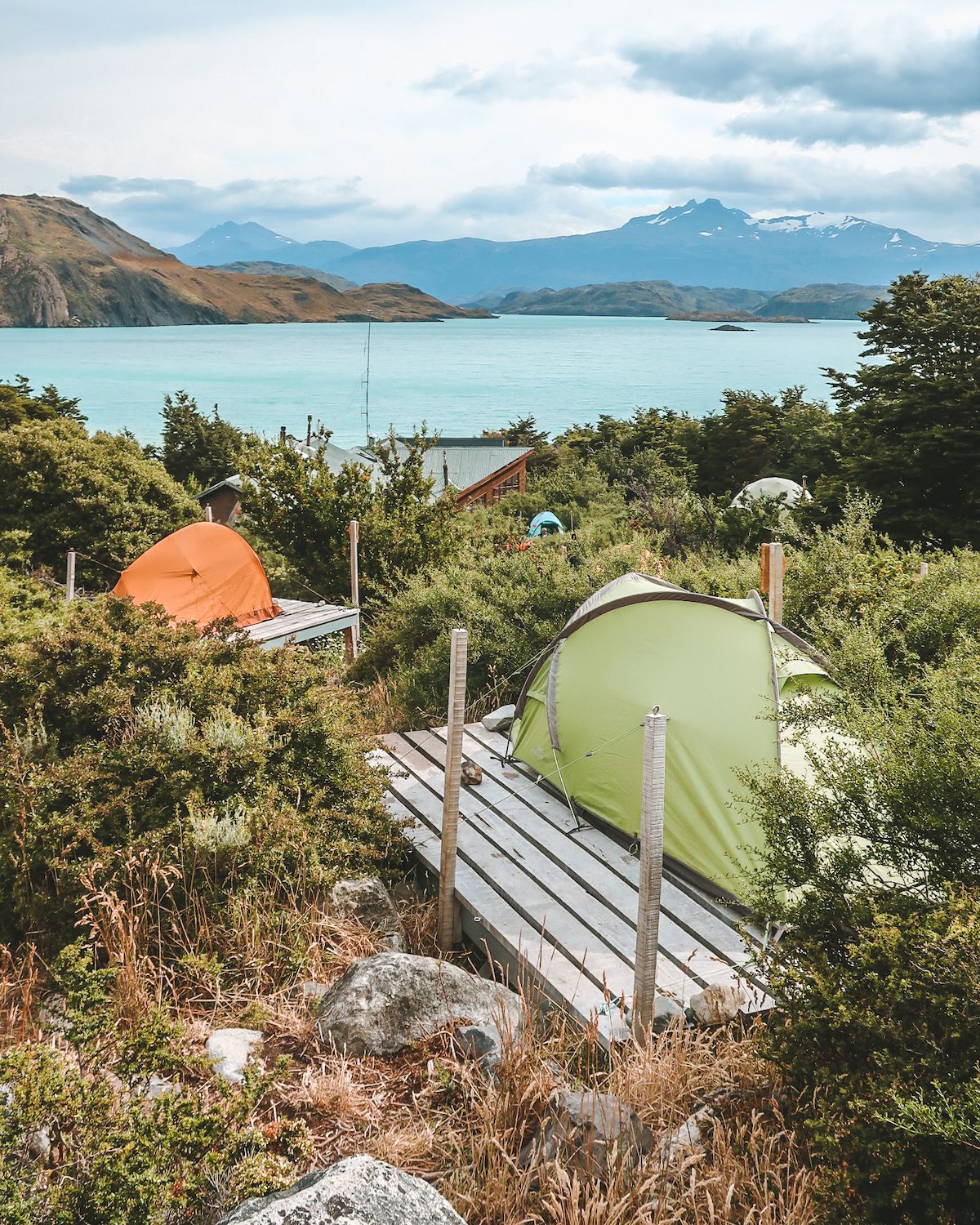
Refugio Los Cuernos Pros and Cons:
+ Most beautiful site + Not crowded and peaceful + Not as windy even though open with big views
− Location on route not ideal − Music too loud at the bar sometimes − Inadequate camp store
Los Cuernos is located 3km from Refugio Frances and it seemed as though most hikers we met stayed at Frances because it has a better strategic location on the route to go up the valley. Staying at Los Cuernos may be inconvenient depending on your route but we highly recommend it. The facilities at Cuernos were great and we saw someone order an immense looking charcuterie board. The camp store was almost non existent and did not have much to purchase.
2. Refugio Grey (5/5)
The Refugio at Grey Glacier has a smooth running operation with both dinner and breakfast being swift and efficient. All the people at the site eat together and there are no shifts which is nice. The tenting area is not very big but there are sites available under trees and also in the open. The smaller size of the campground made it feel less crowded and wild.
The highlight of staying at this camp was seeing the blue ice of Grey Glacier and the icebergs. There is a camp store here that is well stocked. The camping staff have a fun attitude and people enjoy congregating around the registration and kitchen area.
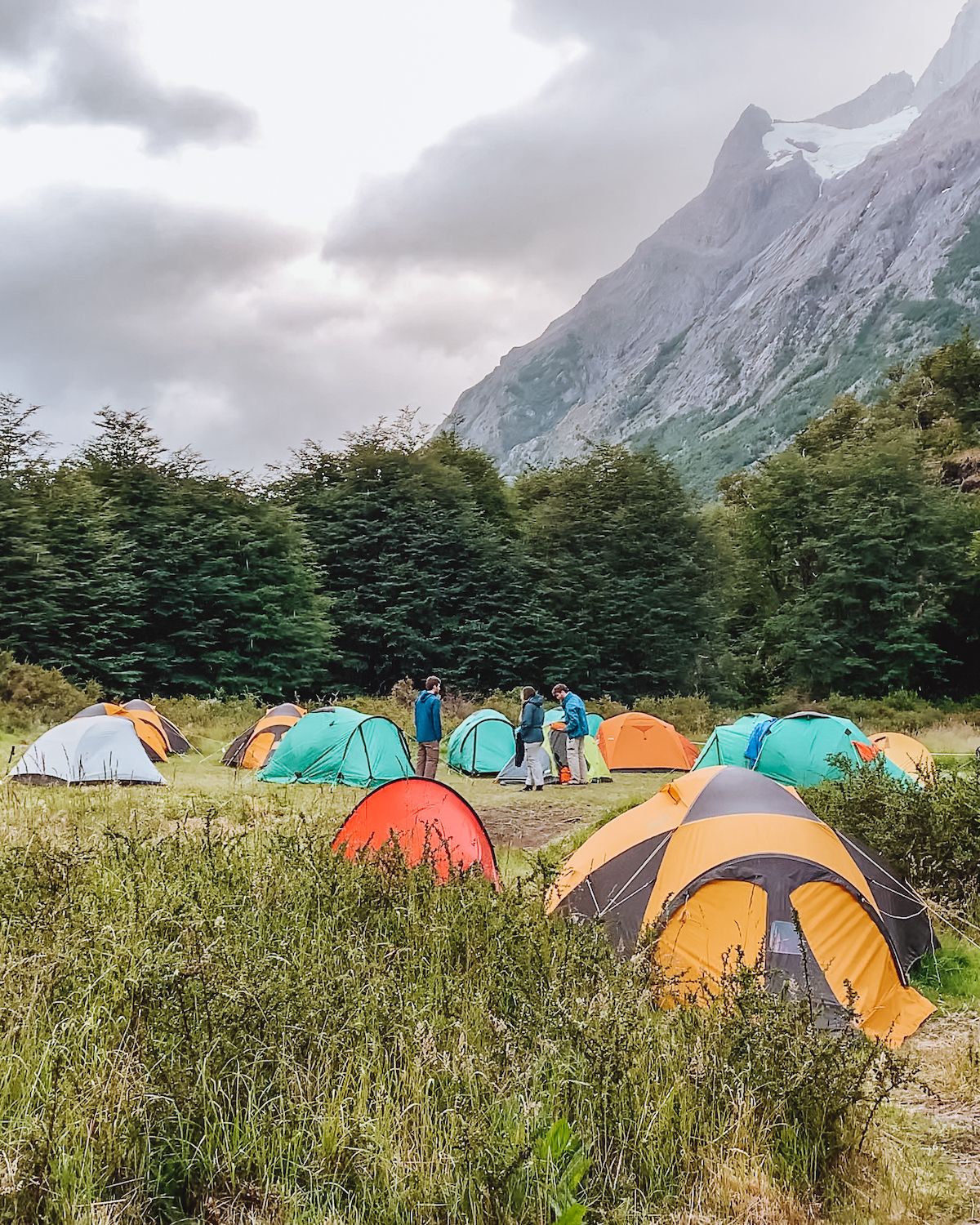
Refugio Grey Pros and Cons:
+ Fast and efficient food service + Well stocked camp store + Easy Glacier Grey access
− Some noise from partying − Books up quickly
3. Refugio Chileno (4/5)
Refugio Chileno is your last stop before hiking up to see the towers. This beautiful but windswept location is right in the valley beside the river. Chileno is the most rugged of all the camps and you can really feel the power of the mountains here. Tent pads are located in the trees on a hillside but the lodge is very busy as this is a stop for both circuit trekkers and day trekkers going to the towers.
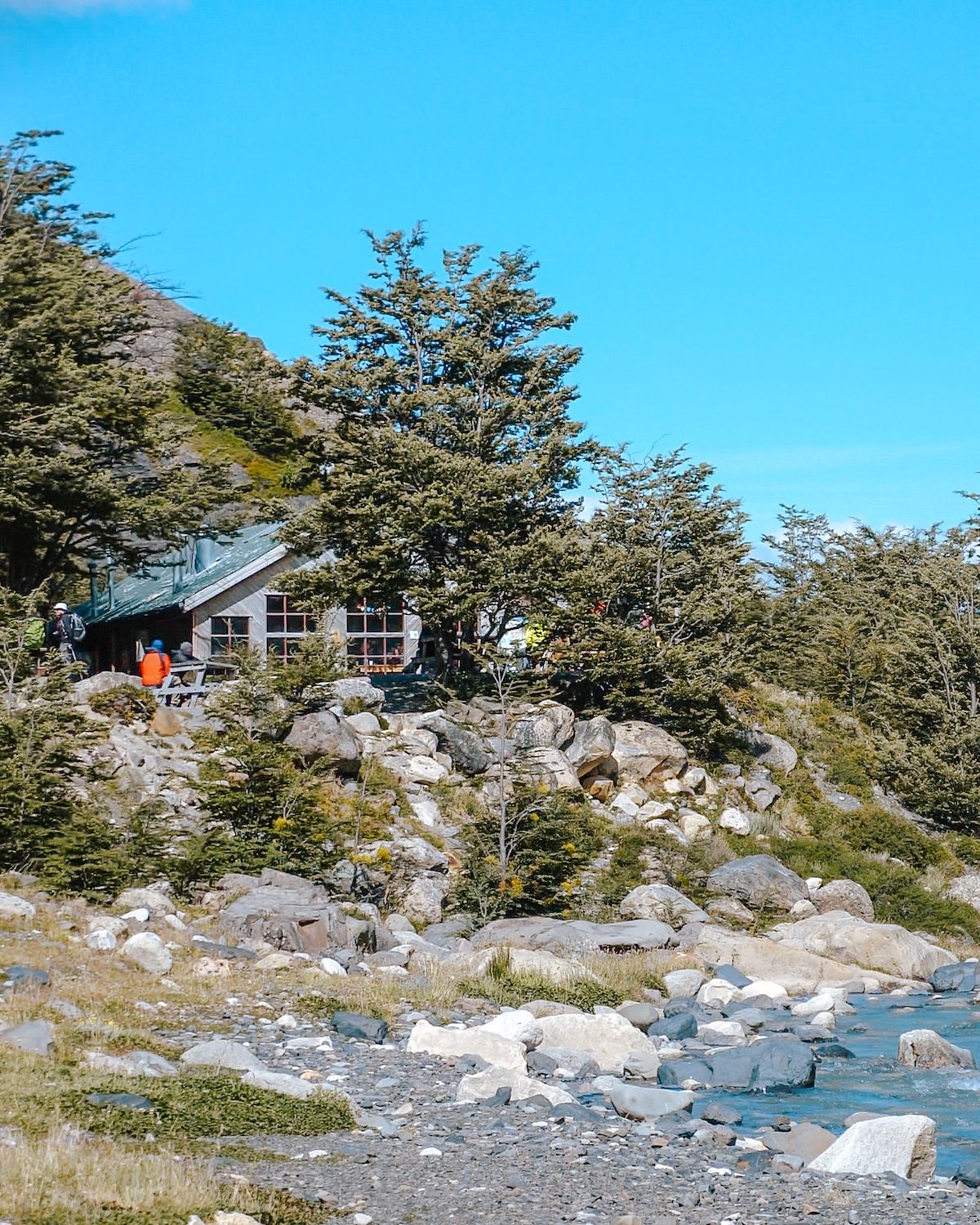
Refugio Chileno Pros and Cons:
+ Great location for heading to the Towers + Remote and rugged feeling + Best launch point for sunrise hike
− Very busy as it is a transit camp − Must reserve full board, no camp kitchen − Unpredictable weather, very windy
It may look like a good idea on the map to stay at Refugio Torres Central instead of Refugio Chileno, but there are several drawbacks of doing so. Torres Central is actually quite a bit off of the trail and may add significantly to your trek. There is a short cut between Chileno and Los Cuernos that saves elevation gain and a few kms. Torres Central is also located on a road, we didn't feel like we were on in the W Trek anymore when staying there because of all the machinery.
4. Refugio Paine Grande (3/5)
Located right next to the Pudeto ferry landing, the Paine Grande Refugio will either be your first or last sight on the W Trek. There is a huge lodge and massive camping area for lots of trekkers, making it the most populated of them all. The facilities are great and well stocked because of the easy access to supplies with the ferry. Meal times get busy. Plan to arrive at breakfast early, a line begins to form and we waited 30 minutes before eating and were late out onto the trail in the morning. There is a power plug in the camp store. We hung out there and played cards at a table while our gear charged.
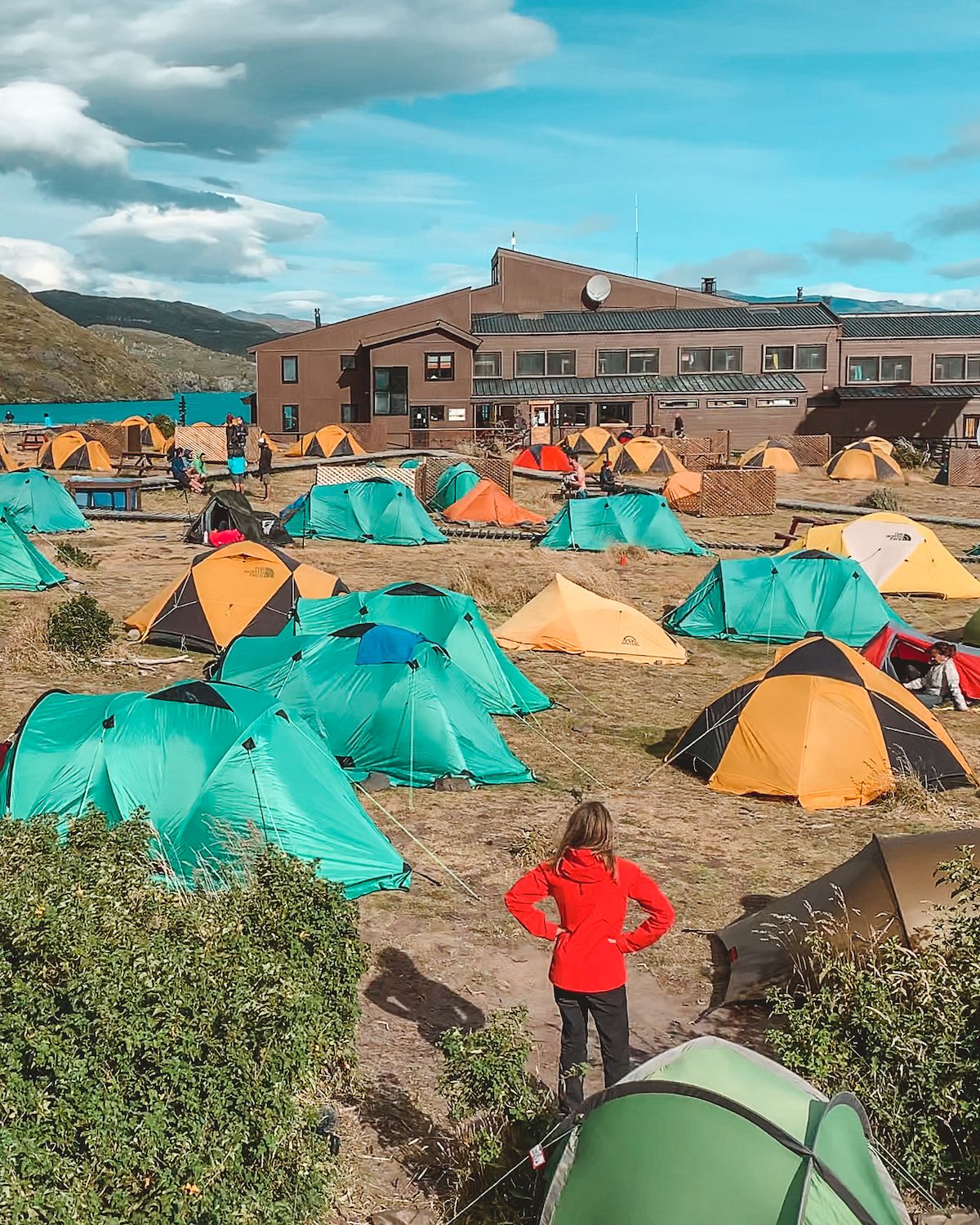
Refugio Paine Grande Pros and Cons:
+ Good meal portions + Lots of camping room + Great clean facilities
− Very busy and crowded − Lines and wait times for meals − Proximity to other neighbouring tents
5. Refugio Torres Central (2/5)
The most important thing to note about Torres Central is that when you arrive it feels as if you are not actually on the trek. Refugio Torres Central is located on a road with tour busses and other vehicles driving by. The benefits of this are a large campground, very good food and a beautiful lodge. The drawbacks are frustrating, mainly the terrible service, dirty camping facilities and 1 km trek to the main trail on a gravel road. Avoid this site and try to book Chileno!
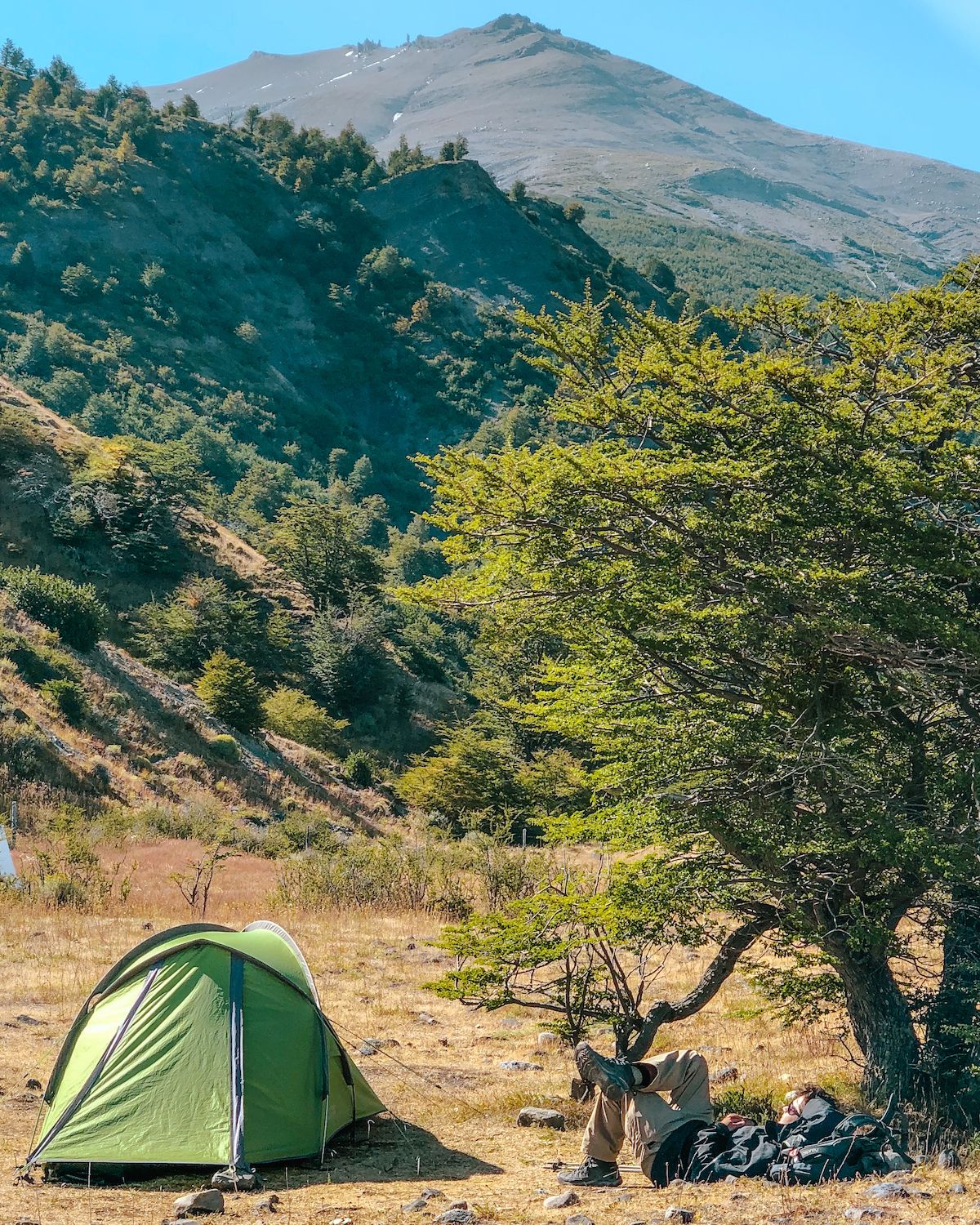
Refugio Torres Central Pros and Cons:
+ Tasty meals + Lots of camping room + Nice view of the towers (when not cloudy)
− Camping facilities small and dirty − Feels like you're at a drive up camground − Mind blowing bad service at lodge
We stayed at the Paine Grande Refugio for two nights. For some reason, the meal time operations are very inefficient at this refugio resulting in long lines and under served hikers. The people staying in the dorms at the lodge get served in the first seating. During breakfast this means they get the warmest food and the earliest hiking times. By the time we got seated for breakfast, there were no plates left on both days and I ate off of a napkin. One morning there was no coffee left... disaster! At dinner time, the second seating got delayed main courses and sometimes no desert. One group ended up finishing at 10 PM after starting at 7 PM.
After we hiked to the Torres Del Paine Towers we celebrated with a few drinks. I watched the bartender make up a Pisco sour, walk to the fridge to grab a half full plastic 2L bottle and pour out the excess from the shaker into it! Jungle juice for the staff I guess. Crazy to think an operation as bad as this can exist right next to the main road.
6. Refugio Italiano (2/5)
Italiano is the only site on the W that is free and run by the park commission itself. The other sites are run by private companies. What we discovered was that the toilets were dirty and smelly. Hikers going up the Frances Valley walk through the campsite and there was no option for full board. This site is great if you're on a budget, but hike on and head for a delightful stay at Los Cuernos.
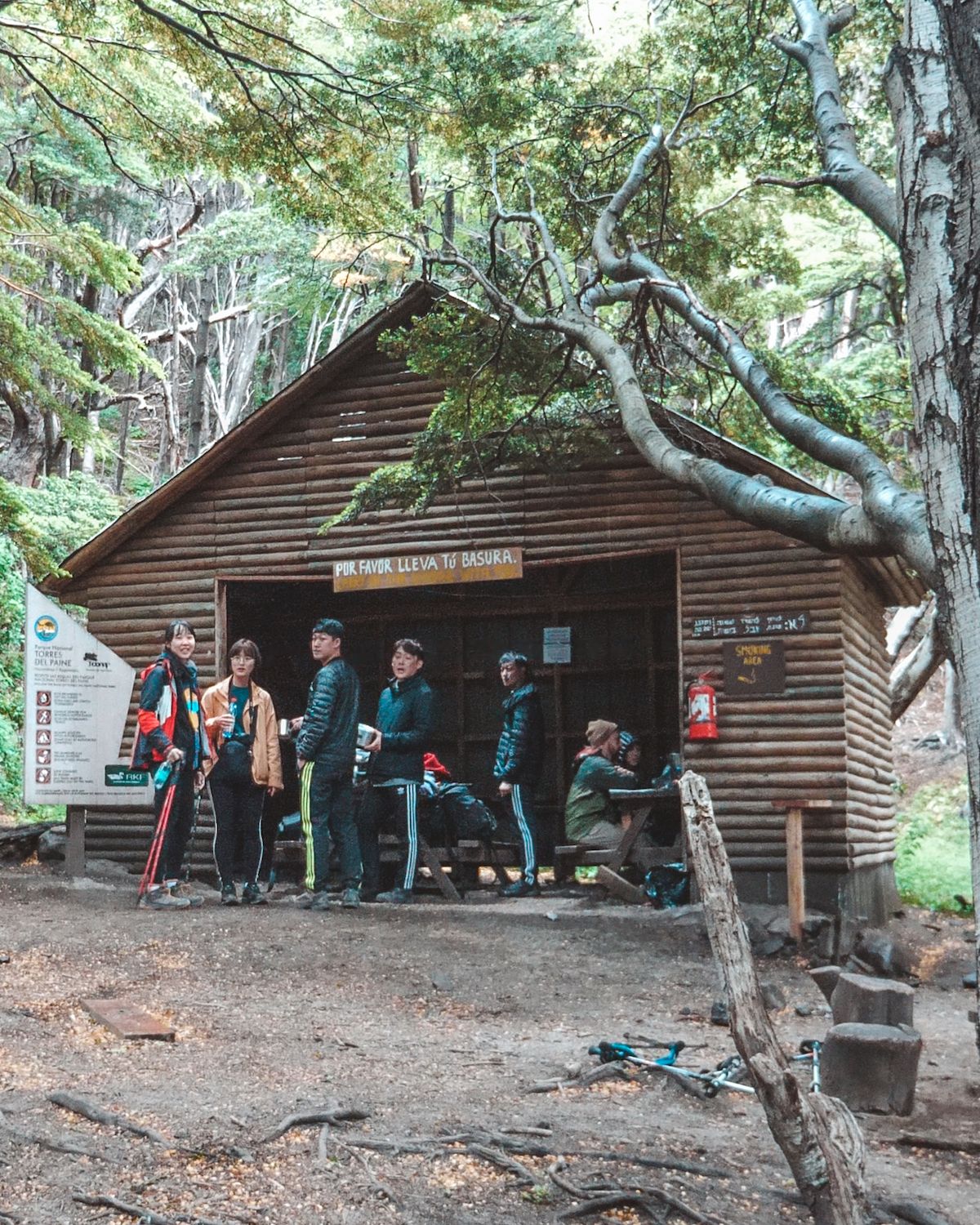
Refugio Italiano Pros and Cons:
+ Free to book + Great location + Headstart up the valley in the morning
− Camping facilities lacking and dirty − Extremely busy through route − Dark campsite
7. Refugio Frances (1/5)
We stopped in briefly to Refugio Frances to rest before our last leg to Los Cuernos and came up to a deserted check-in station next to tent pads under the trees on the hillside. We walked down a large hill to the bathroom/shower facilities which looked great and new but could not find the lodge and were unwilling to walk further down the hill to come back up again. We spoke to a few hikers who had stayed there and they said the walk is long between the lodge and tent sites. Also, the employees from the registration station often close up for 15 minutes or more.
The whole place seemed poorly organized and was uninspiring without views. There are shared domes you can rent here that look cool, but we have stayed in domes on our trip and they are very hot during the day and the sound travels very well inside them. Great if you love the sound of snoring! Try to book Los Cuernos instead if you can fit it into your route.

Refugio Frances Pros and Cons:
+ Newer facilities + Good location along W Trek
− Poorly layed out facility locations − Unattentive staff − No great views
8. Food and Facilities
We never had a bad meal at the W Trek Refugios, only bad service. Full board was plenty of food for us and the lunches were filling. The only thing about the bathrooms was that by the end of the evening sometimes toilet paper runs out and hot water gets cold. A major bonus about hiking here is that the water from the streams is drinkable, truly an amazing gift.
Don't miss our list of 17 things to know about the W Trek .
Here are a few candid shots from the W Trek Refugios:
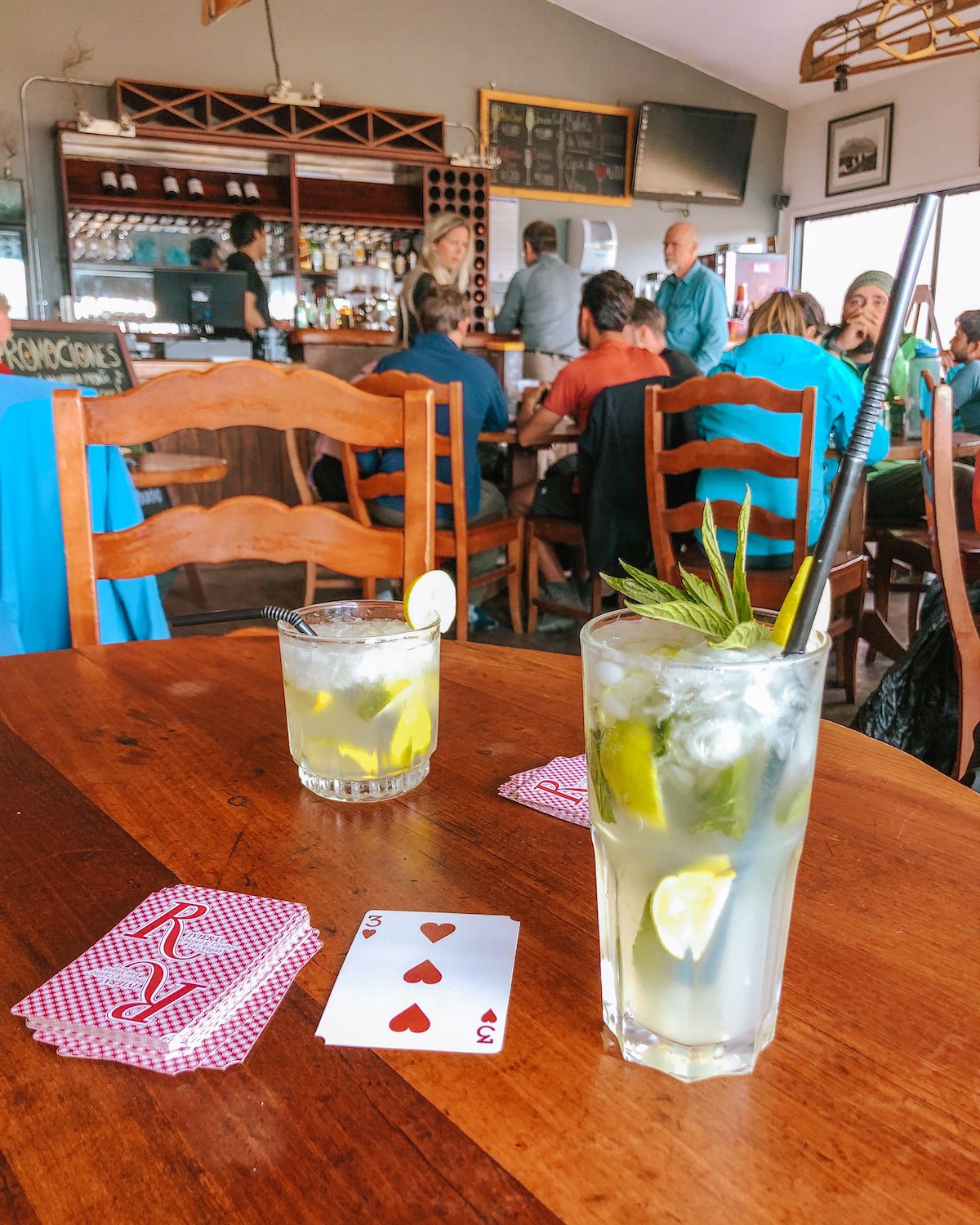
W Trek Packing List

This is what we brought with us on the W-Trek. Each item that is linked is what we own and highly recommend. We have used them over the years for numerous hikes and camping trips around the world (Peru, Nepal etc.).
Note: we ate half board/full board at the lodges, so this packing list does not include gear to make your own food.
Start planning your trip to Torres Del Paine National Park
- 🏔 Book your self-guided W Trek: see our comprehensive W-Trek guide including the best route and itinerary
- 💡 Travel tips: see our top 17 tips for the W Trek
- 🌃 Book your stay in Puerto Natales: Booking.com is our go-to for finding places to stay. Sort by top reviewed.
- 🚌 Buy your bus ticket to the park: book in advance through Busbud .
- 🥾 Rent your gear: we rented our camping gear from Rental Natales
- 🛫 Book your flight to Puerto Natales: use Skyscanner to compare flights across different airlines (we recommend booking direct with the airline however).
Check out what the W Trek Refugios were like in our Chile vlog!
Pin and save the W Trek Refugios and Campsites guide for later:
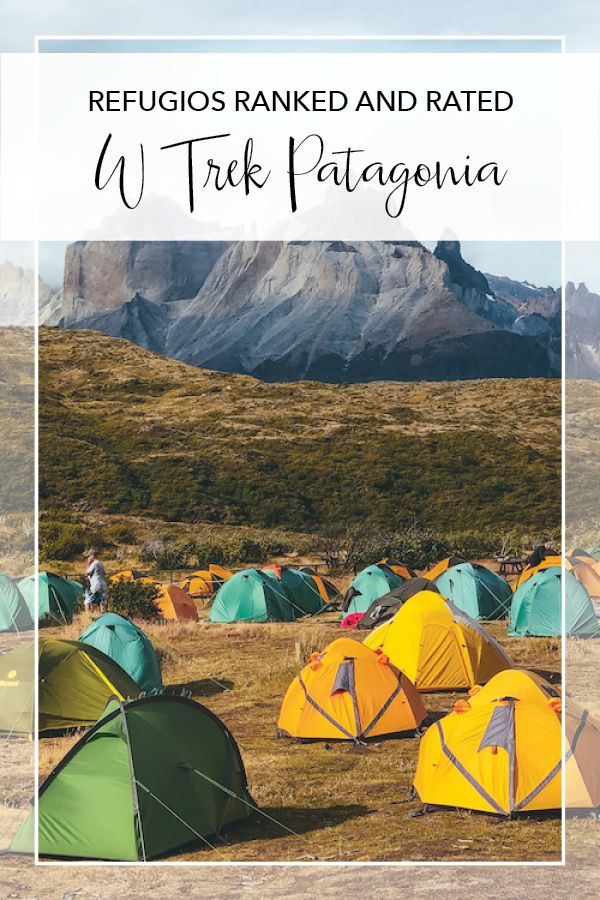
Featured Posts
5 days in mexico city for food, culture & architecture.
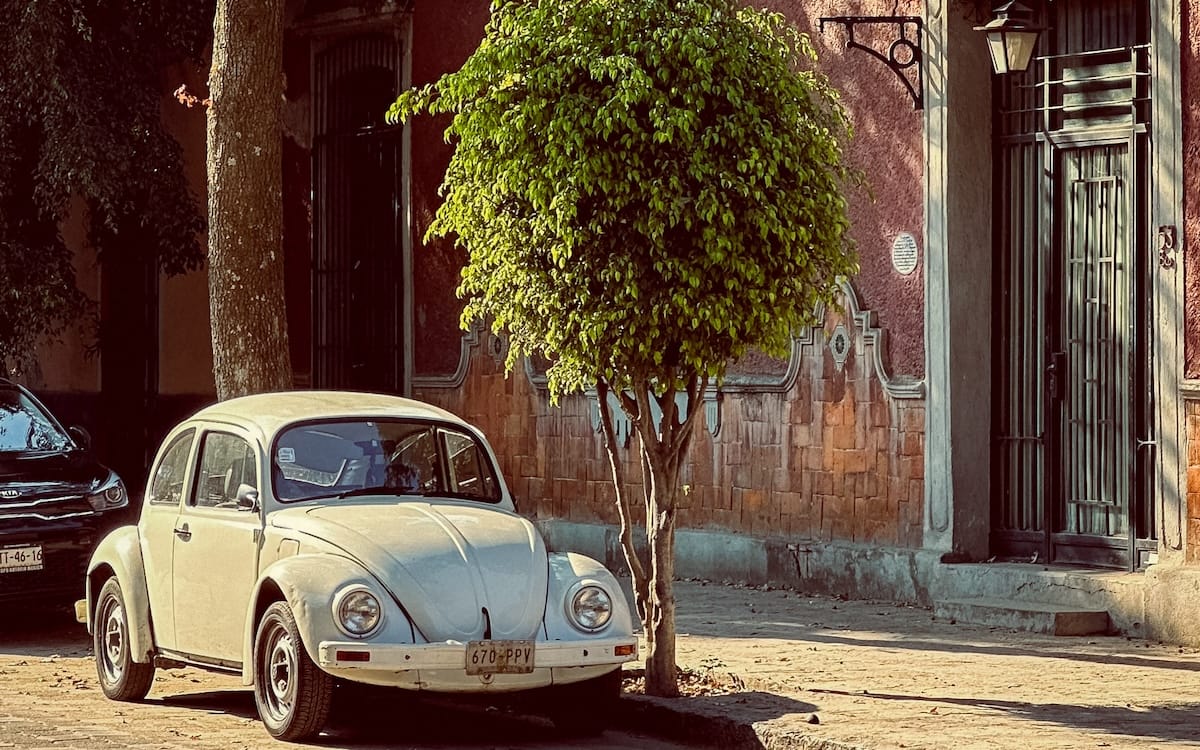
If you're a food, architecture and design enthusiast and love to immerse yourself in the local culture, this 5 Day Mexico Itinerary is for you. From mouthwatering street foods to striking architectural sights, your 5 days in Mexico City will be filled with unique experiences.
17 Unique Things to do in Condesa, Mexico City
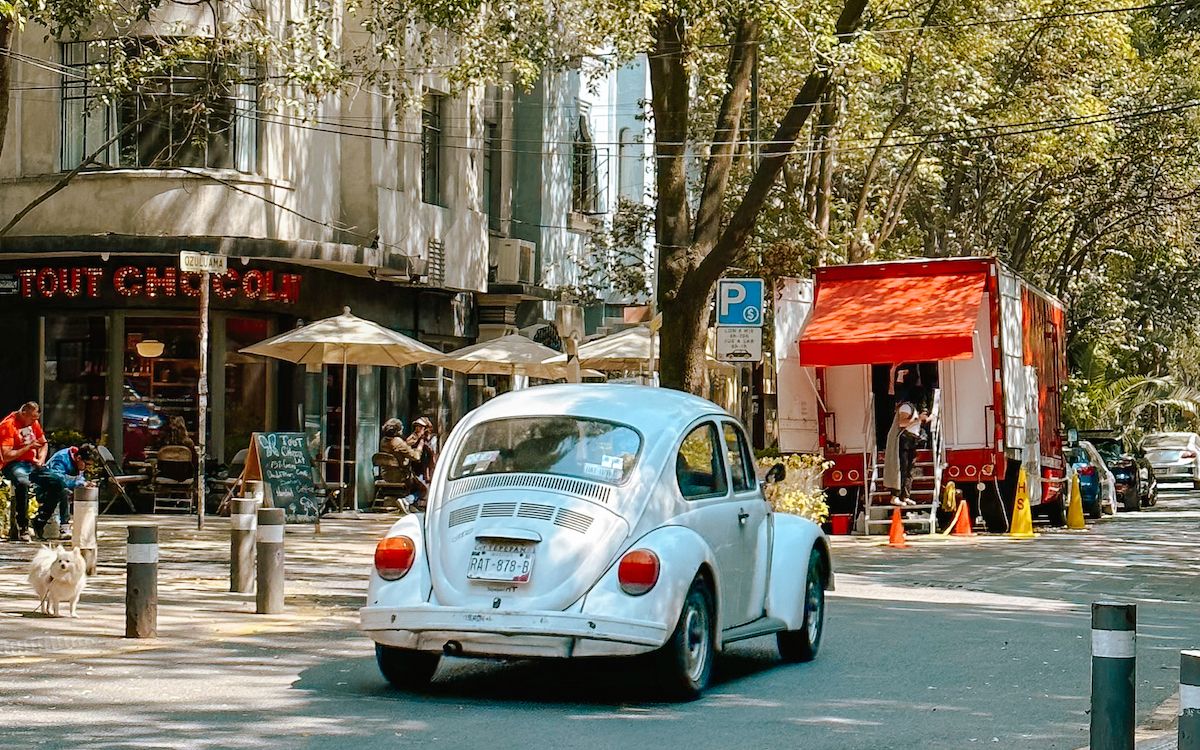
Condesa is a beautiful neighbourhood with hip eateries, green spaces, art galleries, Art Deco treasures, artisan boutiques, and a fashionable crowd. Soak up the chic neighbourhood atmosphere in our list of 17 fun things to do in Condesa Mexico City.
LEVEL8 Luggage Review - Standout Features & Considerations
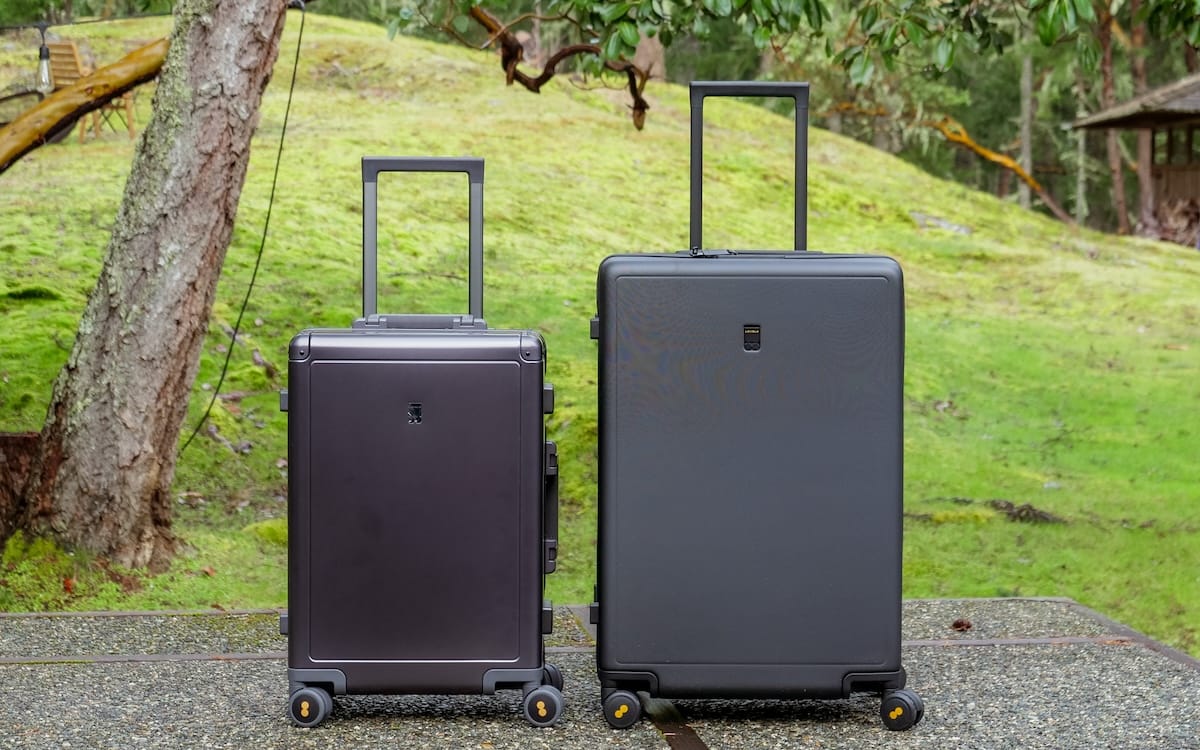
We set off on a weekend getaway to Victoria on Vancouver Island and couldn't wait to put our LEVEL8 Luggage to the test. Our LEVEL8 Luggage review reflects our genuine experience with our Luminous Textured Suitcase, Gibraltar Aluminum Carry-on and Atlas Laptop Backpack.
Search Groovy Mashed Potatoes - Travel Blog
Subscribe & get your free guide to going abroad!!
Ultimate Guide to the Torres del Paine Campsites and Refugios
The Torres del Paine trek is one of the premier treks in the world. Over 5 day “W trek” or the 9-day “circuit trek” you can experience some of the best landscapes and vistas Patagonia has to offer. Along the way, the Torres del Paine refugios offer a comfortable and convenient place to rest your head and enjoy a meal (with a glass of wine or beer). If you’re more of a minimalist and on a tighter budget, the Torres del Paine campsites are just as great, with good facilities, tents and sleeping bags for rent, and even hot water in most places.
With these great options, refugios, campsites, cabins, eco domes, and lodges, it can be difficult figuring out which Torres del Paine accommodation is best for you and how to book it.
Read on for an overview of the campsites and refugios of the Torres del Paine, an overview of amenities, and how to book them
- Torres del Paine Campsites and Refugios: Which is right for you?
- Map of the Torres del Paine Campsites and Refugios
How to Book Torres del Paine Refugios and Campsites
- Quick List of the Torres del Paine Campsites and Refugios
- Campsites on the W Trek
- Campsites on the O Circuit Trek
- Refugios on the W Trek
- Refugios on the O Circuit Trek
How to make a Torres del Paine trek happen for you…
- 3 Options If you can’t get all of the campsite reservations
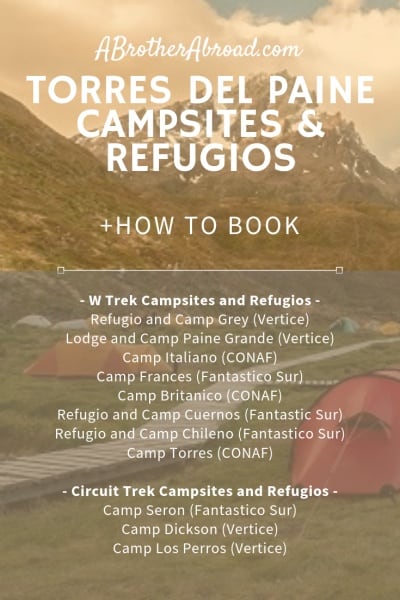
IMPORTANT NOTE FOR 2019-2020:
Fantastico sur and vertice patagonia have already opened their reservations systems, so you book your campsites and refugios asap as sites book up very fast, the refugios and campsites of torres del paine: which is right for you.
What’s the difference between a refugio and a campsite in Torres del Paine?
Essentially, a refugio is a mountain lodge. In Torres del Paine, these lodges are all equipped with beds and restaurants. When taking on the Torres del Paine W and Circuit, refugios offer the benefit that you only need to bring a minimum of gear – beds, sleeping bags, and meals at the restaurant can all be rented or purchased along the way. The downside is cost, as all in gear rental, meals, and refugio accommodation can easily hit ~$200 USD per day.
For the minimalist and budget crowd, the campgrounds of Torres del Paine are very well equipped. Hot showers are the norm and well setup tent sites, with platforms in some places, make camping simple and easy. Designated cooking areas with wind protection and sinks for washing dishes add a bit more enjoyment to camping.
Should you stay in a refugio, or camp?
If you have plenty of cash and don’t feel like carrying anything, go with the refugio option. Otherwise, camp.
Map of Torres del Paine Campsites and Refugios
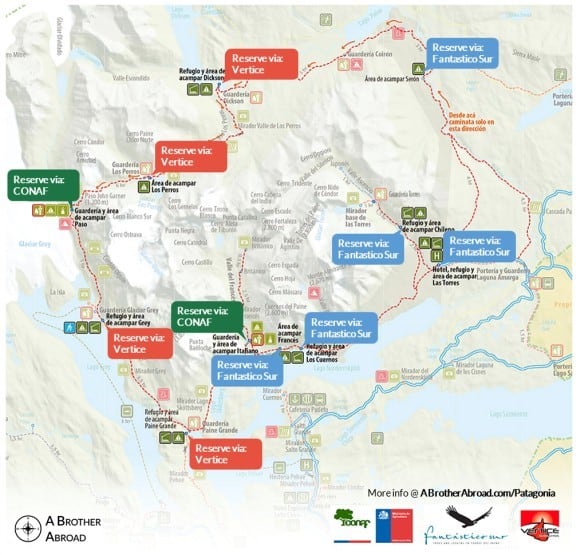
First, note that you must book all campsites and refugios in advance as you will not be able to walk up and take a last minute reservation
Second, note that you should book accommodations as soon as possible as everything (campsites, refugios, and hotels) book up extremely quickly and completely.
Now on to how to book your refugios and campsites…
All of the Torres del Paine refugios and campsites are run by one of three organizations. You will book with these organizations online via their booking sites and bring the confirmation with you into the park. Those organizations are:
- Vertice Patagonia
- Fantastico del Sur
(Click the links above to be taken to the respective booking sites)
All of the refugios and campsites are divided between these three organizations and managed separately. Vertice Patagonia and Fantastico del Sur are companies that operate their refugios and campsites, while CONAF is the national park service and manages the free campsites of Italiano, Britanico, Paso, and Torres.
To book at a campsite, follow the respective links above to each organizations booking page and follow the appropriate instructions. Note that you must bring proof of all of your reservations with you to the park . I recommend printing them and carrying them with you.
Here’s a list of the campsites and refugios in Torres del Paine and their managing organization to book through:
Quick List of Refugios of the Torres del Paine W Trek (in order)
- Torres Central and Norte Refugio and Campsite [ Fantastico Sur ]
- Chileno Refugio & Campsite [ Fantastico Sur ]
- Camp Torres [ CONAF – unavailable 2018-2019]
- Grey Refugio and Campsite [ Vertice Patagonia ]
- Camp Italiano [ CONAF ]
- Refugio and Campsie Frances [ Fantastico Sur ]
- Refugio and Campsite Cuernos [ Fantastico Sur ]
- Refugio and Campsite Paine Grande [ Vertice Patagonia ]
- Hotel Los Torres Patagonia
Quick List of Refugios of the Torres del Paine Circuit Trek (in order)
- Campsite Seron [ Fantastico Sur ]
- Refugio and Campsite Dickson [ Vertice Patagonia ]
- Campsite Los Perros [ Vertice Patagonia ]
- Campsite Paso [ CONAF ]
Scroll on for a review of prices, amenities, and booking options for each refugio and campsite
The Torres del Paine Campsites on the W Trek (In Order)
(Click each site for full campsite info)
Camp Grey (Vertice Patagonia)
Camp italiano (conaf), camp frances (fantastico del sur).
- Camp Britanico (CONAF)
Camp Cuernos (Fantastic Sur)
Camp chileno (fantastico del sur), camp torres (conaf – unavailable 2018-2019), torres del paine campsites on the circuit trek (in order), camp seron (fantastico del sur), camp dickson (vertice patagonia), camp los perros (vertice patagonia), the torres del paine campsites on the w trek.

- Price per night: ~$7.50 USD/Night ( $ 5,000 CLP)
- Shared bathrooms, cold water sinks, toilets, and hot showers.
- Dinner available but must be reserved by 5PM.
- Pub serving beer and wine and selling snacks
- Electricity outlets available during daytime hours
- Book with Vertice Patagonia
- Boarding costs (meals, gear, etc.): Full Board – $57 USD (breakfast, boxed lunch, dinner), tent -$30 USD, sleep bag – $22 USD
Camp Paine Grande [Vertice Patagonia]
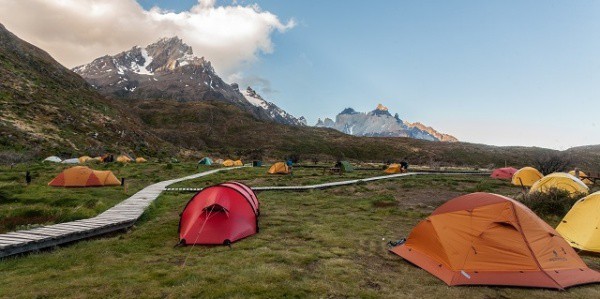
- Beer, wine and snacks for sale
- Coffee service available
- Price per night : Free
- Amenities : Cooking shelter, “long drop” toilet, no showers
- Book with CONAF
- Price per night: $21 USD/Night (High Season), $16 USD/Night (Low Season)
- Amenities: Shared bathrooms, hot showers, camping equipment rental (by reservation)
- Book with Fantastico Sur
- Boarding costs (meals, gear, etc.): Full Board – $80 USD (breakfast, boxed lunch, dinner), tent -$27 USD, sleep bag – $23 USD
Camp Britanico
- Amenities: Cooking shelter, “long drop” toilet, no showers
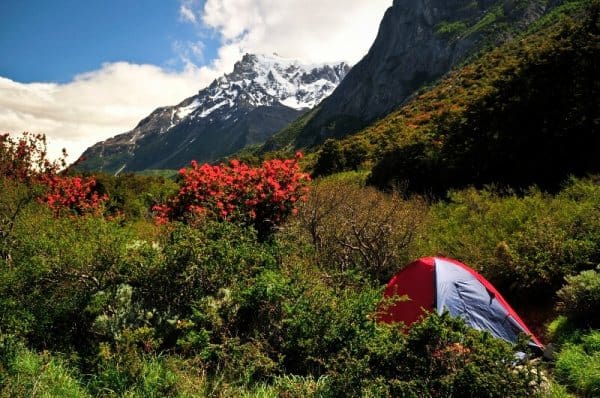
- Price per night: $21 USD/Night (High Season), $16 USD/Night (Low Season)
- Amenities: Shared bathrooms with hot water, restaurant at the refugio, equipment for rental by reservation (tents, sleeping bags, mats)
- Amenities: Shared bathrooms with hot water, equipment available for rental by reservation (tents, sleeping bags, mats), restaurant at Refugio El Chileno
——————
- Amenities: Bathrooms, equipment available for rent by reservation (tents, sleeping bags, mat)
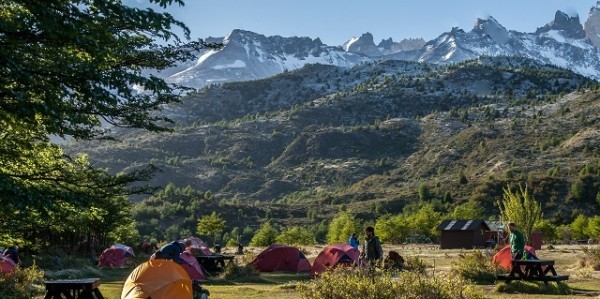
- Basic hygiene facilities available
- Cold showers
Camp Paso (CONAF)
- Price per night: Free
Torres del Paine Refugios
Torres del paine refugios on the w trek, paine grande lodge (vertice patagonia).
- Refugio Grey (Vertice Patagonia)
Refugio Frances (Geo Domes)
- Refugio Cuernos (Fantastic Sur) + Cuernos Cabins
Refugio Chileno (Fantastico del Sur)
- Refugio Torre Norte
- Refugio Torre Central
Torres del Paine Refugios on the Circuit Trek
Refugio dickson (vertice patagonia).
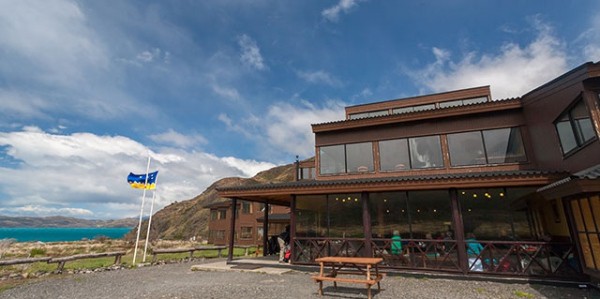
- Price per night: $57 USD / $34,000 CLP
- Bunk beds in mixed dormitory
- Shared bathrooms with cold water sinks, toilets, and hot showers
- Restaurant (with 1 vegetarian alternative) – dinner must be reserved by 5PM
- Beer and wine for sale
- Coffee service
- Electrical outlets available during daytime
- Boarding costs (meals, gear, etc.): Full Board – $57 USD (breakfast, boxed lunch, dinner), sleeping bag – $22 USD
Refugio Grey
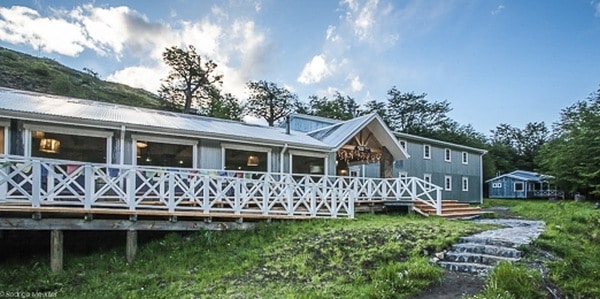
- Price per night: $37 USD / $22,000 CLP
- Warehouse with food items (eggs, salami, bread, etc.) for sale
- Boarding costs (meals, gear, etc.): Full Board – $57 USD (breakfast, boxed lunch, dinner), bed kit – $50 USD
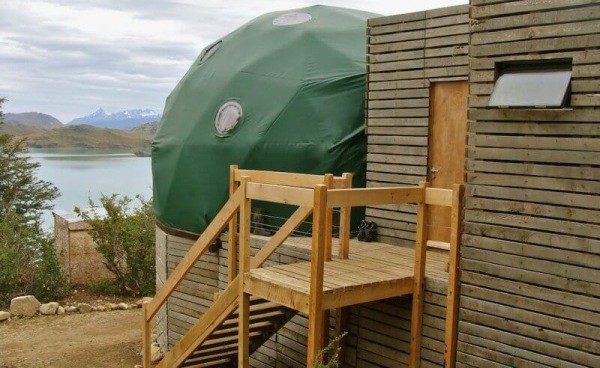
- Price per night: $116 USD/Night (High Season), $95 USD/Night (Low Season)
- Bunk Bed with sleeping bag
- Restaurant serving breakfast, dinner, and boxed lunches
Refugio Cuernos + Cuernos Cabins (Fantastic Sur)
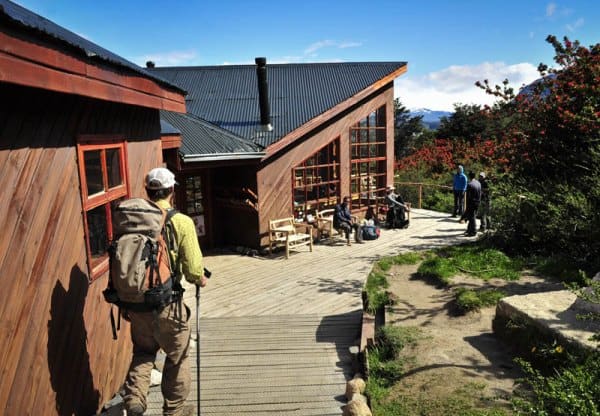
- Cabins available
- Bunk Beds with option of sleeping bag
- Shared bathrooms
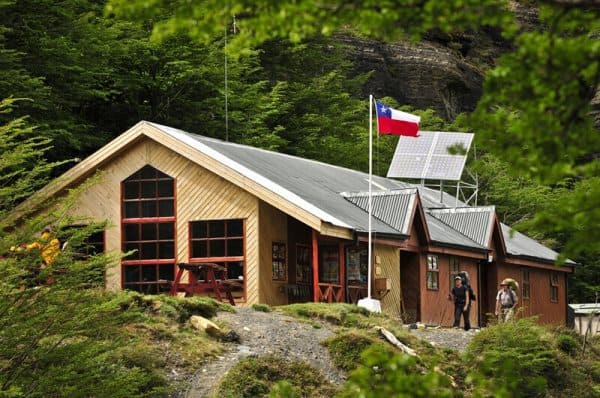
Refugio Torre Norte and Central
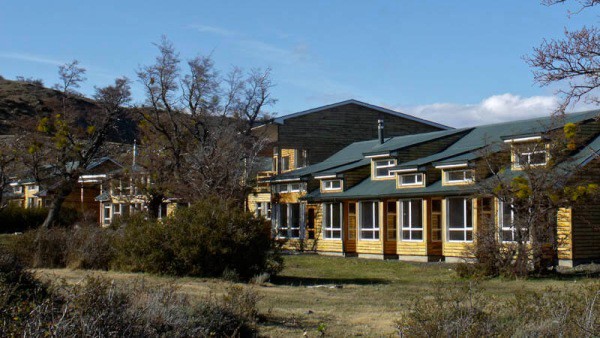
- Price Per Night: $116 USD/Night (High Season), $95 USD/Night (Low Season)
- Bunk Beds with sheets and covers
- Shared bathrooms with hot water and toilets
- Restaurant, bar, lounge, and shop
- Central heating
Hotel Las Torres Patagonia / Hosteria Las Torres
- Price per night : Starting at $460 USD per night
- Amenities: Full hotel amenities
- Booking platform: Booking.com (Independently Operated) or directly with Hotel Los Torres
- Price Per Night: $37 USD / $ 22,000 CLP

- Choose your trek (W trek or circuit)
Plan your route & itinerary
Book your reservations, print out and bring your confirmations, choose the trek (w trek or circuit).
With the beautiful vastness of Torres del Paine, you have two options for trekking: the 5 day W trek, or the 10 day “Circuit Trek”.
The W Trek is great for novices and has refugios and campsites every step of the way. Though it will definitely get busy during high season, the views are worth it. The hike starts with a view of the immense Grey Glacier, followed by a trek through the picturesque Valle Frances, and culminating with a sunrise view of the Torres del Paine.
The Circuit isevenbetter, as it takes the W trek and adds 4-5 days of more remote hiking. From snow topped mountains, to fields with Guanaco, to an unreal view of Glacier Grey climbing into the sky, the circuit is unreal and worth every step. Note that refugios don’t exist the entire way and campsites as some points are bare, so you’ll need a full camp kit. If you can manage 9 to 10 days of hiking, I highly recommend doing the Torres del Paine Circuit trek instead.
The route and itinerary for both the W Trek and the Circuit trek are fairly standard, traveling in a counter clockwise path around the park. Lucky for you, A Brother Abroad has two free ultimate guides to provide you an itinerary, budget planning, transportation planning, and packing list appropriate to the treks.
- The Ultimate Torres del Paine W Trek Guide
- The Ultimate Torres del Paine Circuit Trek Guide
Once you’ve decided which trek you’ll take on (the W or the Circuit), take the itinerary for our W Trek guide or Circuit Trek guide to find the campsites or refugios you’ll stop at along the way. Then, book each site well in advance through the respective managing organization’s links below
Once you have your reservations, print out and bring the confirmations with you on the trek. You’ll need them to stay and likely won’t have access to email or wifi while in the park.
3 Options if you can’t get all of the campsite reservations you need
- Contact the booking company (email or drop in)
- Book with a tour or agency
- Day trip (Torres, Grey Glacier, The Q tail)
1. Contact the booking company (email or drop in)
If you’re able to book some of the sites on your itinerary but not all, start by emailing Vertice Patagonia, Fantastico Sur, and CONAF to see if there are any available reservations or cancellations.
If you’re in Puerto Natales, go ahead and visit the office to speed up the process.
2. Book with a tour or agency
If you’re having difficulty finding campsites or refugio availability for your dates, consider a guided tour. Though the cost will be more, the staff will handle your accomodations. Alternatively, you may reach out and ask about booking one of their spots in a camp/refugio for an additional fee
3. Day trip or Overnight Trip (Torres, Grey Glacier)
If all else fails, go to Torres del Paine for the day. Grey Glacier and the Torres del Paine are by far the highlights of the W trek and reachable in a single, long day. Either travel in and out in a single day, or consider staying at Paine Grande or Torre Norte / Central to travel up to either vista and bus out the following day.
Other Great Content on Patagonia and Trekking
- The Ultimate Torres del Paine “W” Trek Guide
- The Ultimate Torres del Paine “Circuit” Trek Guide
- The Adventure of the Everest Base Camp Trek
- The Torres del Paine Packing List
ABOUT THE AUTHOR
Carlos is a nomad, slow traveler, and writer dedicated to helping others live abroad and travel better by using his 7+ years of experience living abroad and background as a management consultant and financial advisor to help other nomad and expats plot better paths for an international lifestyle. Click here to learn more about Carlos's story.

- Best Hikes In The World
- Appalachian Trail
- European Hikes
- Nepal Hikes
- Patagonia Hikes
- See All Hikes
- Mount Kenya
- Mount Kilimanjaro
- Mount Toubkal
- See All Mountains
- South Africa
- New Zealand
- Switzerland
- United Kingdom
- Packing Lists
W Trek Patagonia – Guide To The Most Popular Hike In Torres Del Paine
Chile , Hikes , Patagonia , South & Central America
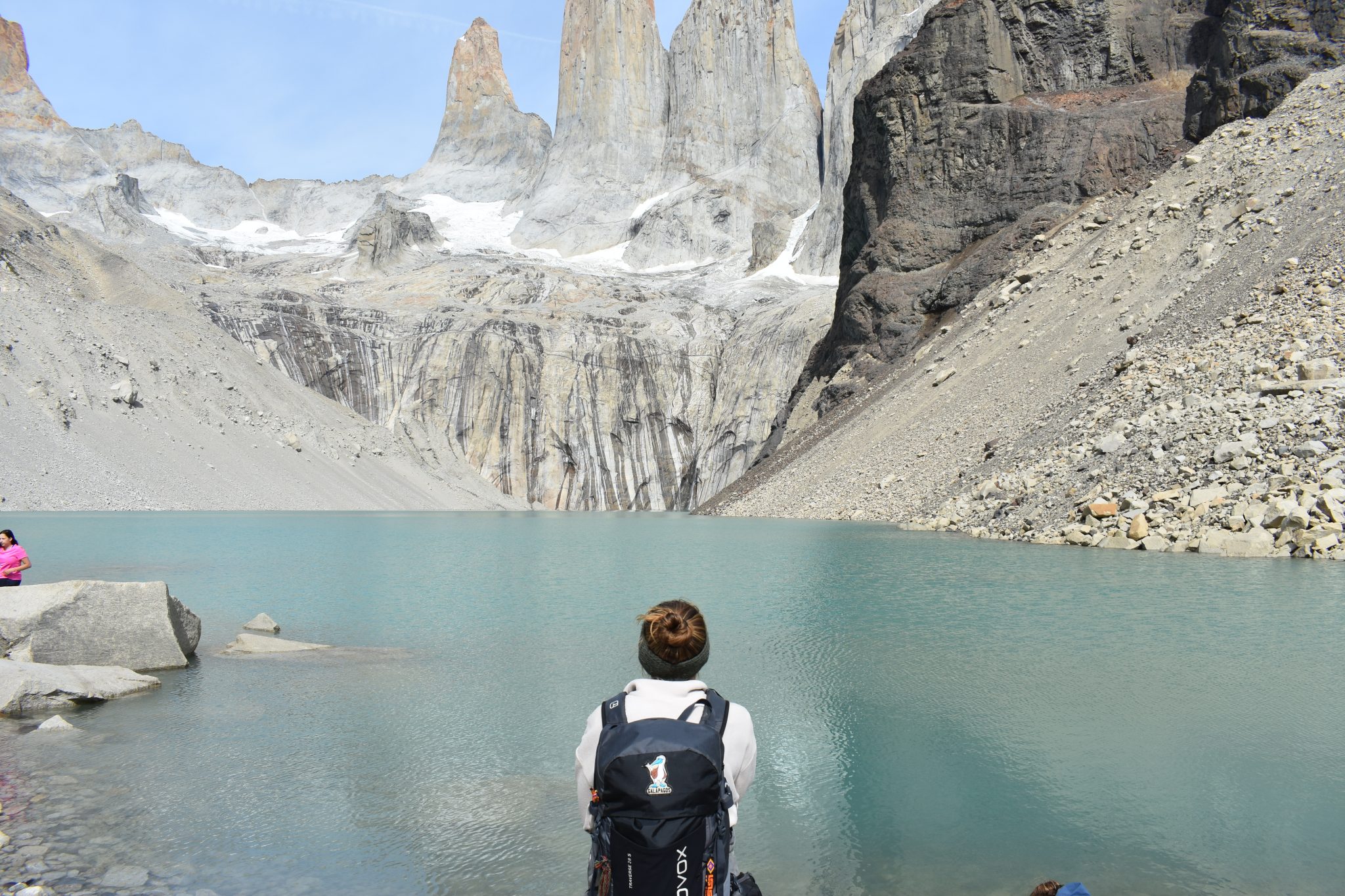
The Torres Del Paine W Trek in Patagonia is a 5-day, 100km adventure that brings you to some of the best features of Torres Del Paine. Visit Grey Glacier, the base of the Towers, the French Valley, and much more on this epic trek.
In this comprehensive guide, I'll go through everything you need to know about planning for and hiking this trail. I’ve also thrown in some up-to-date tips and links for booking campsites in Torres Del Paine.
Get ready to embark on the trail of a lifetime!
Why Hike The Patagonia W Trek?
See the highlights of torres del paine.
One of the main reasons why the W Trek in Patagonia is so popular is the stunning scenery that hikers encounter along the way. The route takes visitors past the park’s most popular features. See the granite spires of Torres del Paine, the turquoise waters of Grey Lake, and the vast glaciers that dominate the landscape.
An Accessible Trail If You Have Limited Time
Another reason why the W Trek in Patagonia is so popular is its accessibility. Unlike many other remote treks in Patagonia, the W Trek is relatively easy to reach and can be completed in a week or less. This is great if your Patagonian backpacking trip has a time limit.
Additionally, the W Trek offers several options for accommodations, from camping to refugios (mountain huts), making it accessible to a wide range of budgets and experience levels.
W Trek Patagonia- Know Before You Go
W trek in patagonia- location.
The Torres Del Paine W Trek is situated in Chile near the southern tip of South America. The park itself is located 112 km north of Puerto Natales and 312 km north of Punta Arenas.
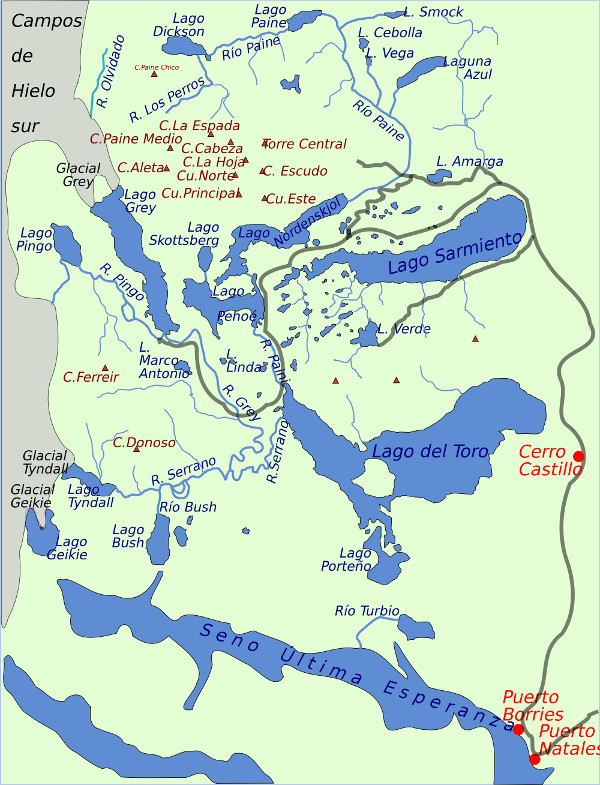
When is the best time to trek the W Hike Patagonia?
To highlight the pros and cons of each season, we have written a brief description of each below.
It’s worth also reading our articles on the best time to trek in Patagonia and, more specifically, when to hike in Torres Del Paine .
Spring - September to November
This is the perfect time of year to visit the park if you're wanting to experience warm, clear weather but without the huge crowds. Although not as warm as the summer months, the skies are often clear and you will get incredible views across the park. This is also the best season to see flowering flora in the region and witness the breeding season for wildlife.
Summer - December to March
This is the high season at Torres del Paine national park . Although the trails in Torres Del Paine are at their busiest, the weather is at its warmest. You'll get the maximum amount of clear days on your trek at this time of year. If you're the active type, then summer is also the period when you can horse ride, kayak, and mountain bike alongside your trek!
Fall - March to June
My favorite season without a doubt. The landscape becomes ablaze with color as the trails start to empty out and days become colder. The wind is often ferocious, but the spectacularly beautiful views are worth it!
Winter - June to August
Between May- September, self-guided hiking is not permitted in Torres Del Paine. Over this period, you can only hike Patagonia W Trek with a guide.
The major benefit of this season is that it is the quietest. There will be very few other visitors and you'll have many of the trails to yourself. This is the coldest period though and you will certainly experience cold nights and high, cold winds.
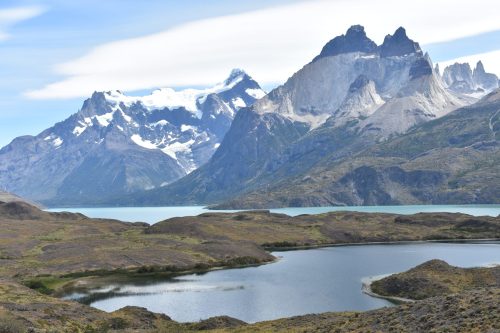
Torres Del Paine National Park
How Difficult Is Patagonia’s W Trek?
The Torres Del Paine W Trek is considered to be an easy multi-day trek as the elevation remains fairly steady throughout the hike. There is also the added benefit that the trek can be done over a longer or shorter period depending on your fitness levels.
Although regarded as easy, the trek still requires a solid level of fitness as you will be trekking a total of 100km/ 62 miles. This is 10-20km per day depending how many nights you camp out.
Hikers generally stay at the same elevation and certainly never go high enough for altitude sickness to become an issue.
The trails are well-defined and you’ll find signposts dotted along the trails at regular intervals. Water is available at all campsites, as is food. Ranger stations are dotted along the trail and you’ll most likely be among other trekkers (depending on when you trek).
Be careful though, storms are frequent in Patagonia and the wind can get extremely cold and strong. Always check weather forecasts before your day of trekking as the John Gardner Pass is often closed due to high winds.
Are Permits Required for The W Trek in Patagonia?
Yes, a permit is needed to enter the park. Permits cost $49 for more than three days. You need to book tickets online at least 24hrs before you visit.
You can print the permit or show it to officials on your phone. The park officials will need to see proof that you have booked your camping ground accommodation in advance.
Accommodation And Food On The W-Hike Patagonia
There are 11 campsites in the park which are run by three different companies. Currently, you can book campsites through Vertice Patagonia and Las Torres . Campsites cost between $10-$25 (Site only). Both companies also have the option to rent camping gear.
As well as tents, there is also options to stay in dormitories, cabins, and refugios. You can book these with the same companies mentioned above. I suggest using only one company to book your entire trek, for simplicity's sake.
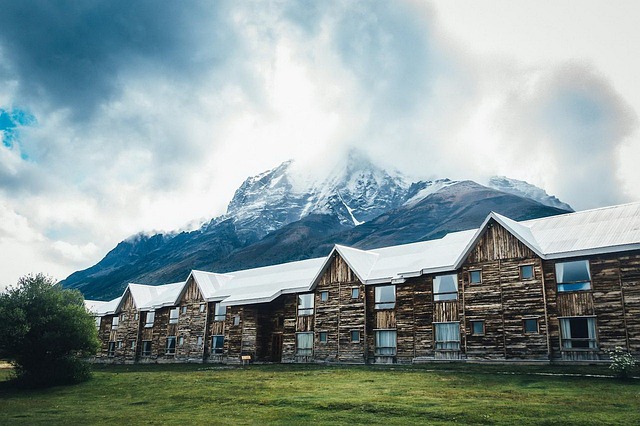
Hotel In Torres Del Paine National Park
At the camps, you will find bathrooms, shops, and even small restaurants. You may need to pre-order your meal so check beforehand.
Note: As of 2022/2023, the free CONAF campsites (El Paso and Italiano) are not available. It is unclear when and if these will re-open. It’s better to budget in paying for all your sites. If this has changed, please drop us a comment.
How Far In Advance Should You Book The W Trek, Patagonia?
Torres Del Paine treks are not something you can decide to do last minute. I’ve seen a friend break a sweat over finding campsites when she already had flights to Punta Arenas booked. This was a whole three months before her hike in November! To be safe, I’d say you should plan and book your trip at least six months in advance. Maybe even more if you plan on hiking the W Trek in the peak season (December-March)
Since 2016, the amount of people who can hike the W Trail is 80 persons per day. Visitors must reserve a place if trekking solo without an operator and you’ll need to take the trail in a counterclockwise direction.
How Do You Get To Torres Del Paine And The Start Of Patagonias W Trek?
Visitors can fly into Punta Arenas, Chile, or El Calafate, Argentina. From either of these towns. You can then take a bus to Puerto Natales.
The bus ride from Punta Arenas to Puerto Natales takes three hours and costs between $20-$30 dollars.
Buses between El Calafate and Puerto Natales are quite a bit longer (around 5 hours). Tickets cost between $30-$40.
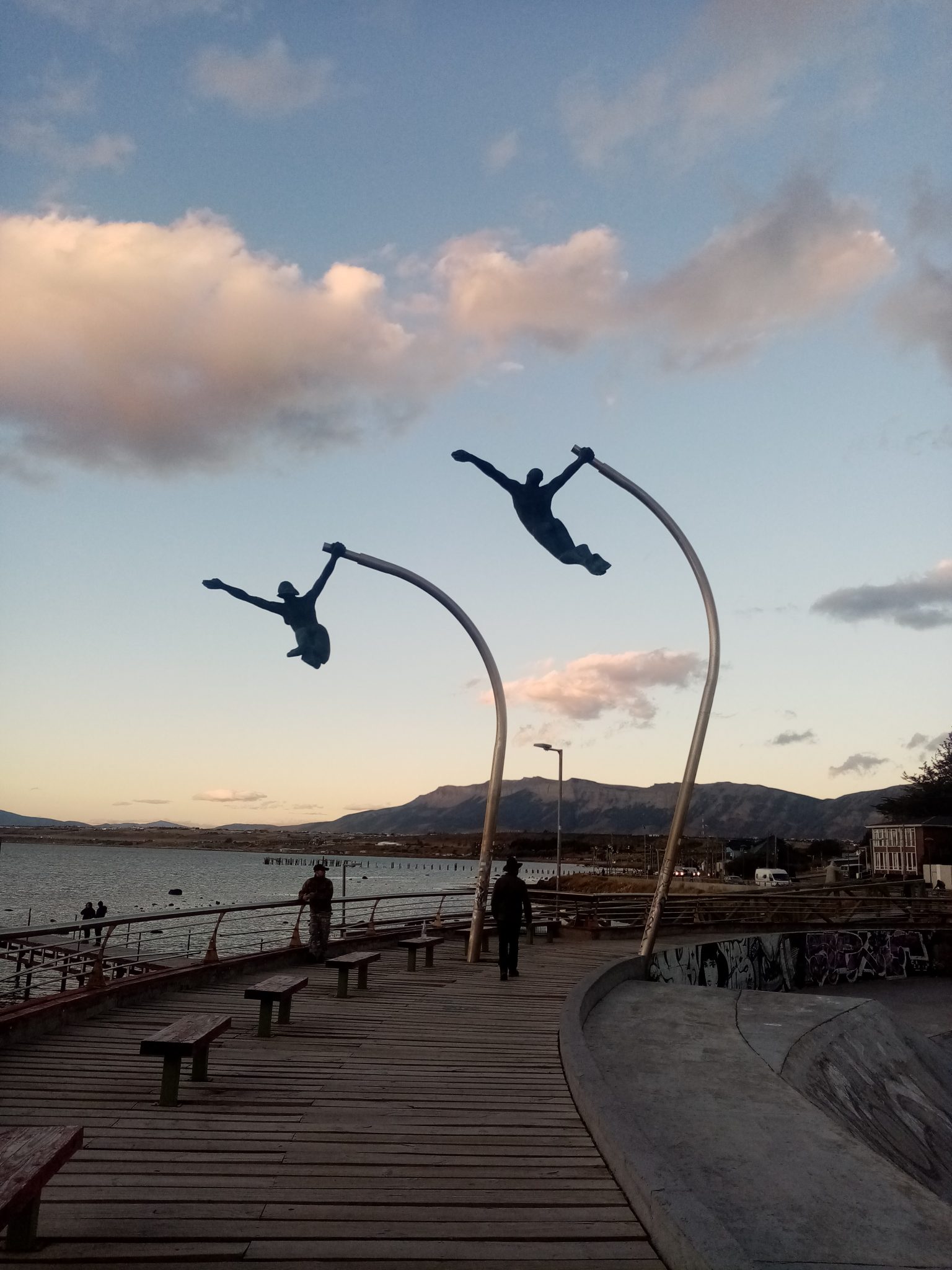
Its good to spend at least one night before the W Trek resting and exploring Puerto Natelensis
Daily buses run between the town of Puerto Natales to the entrance of Torres Del Paine. This ride will set you back $15-$15. If you have a higher budget, you could arrange a private transfer to the park and organize for the driver to pick you up after your trek.
How much does the W Trek Patagonia Cost?
The cost of a Torres Del Paine W Trek varies depending on when you book flights and when you trek (out-of-season tends to be a little cheaper). If you go with a trekking agency, local companies will be much cheaper than booking through an American or European operator. Trekking independently in Patagonia is always the most budget-friendly choice.
- Tour Agency: ~$500 for a cheap local agency to ~$2,000 for a pricey Western trekking agency
- Visa, Vaccinations, Insurance etc:~$300-$500
- Equipment (buying and hiring):~$500-$800 – camping gear can be rented at the park entrance for $200.
- Return flights to Punta Arenas: ~$1,500
- Tips: ~$10-20
- Misc (additional food, unplanned travel/hotels, etc): $50
Total costs with tour agency: $2,000 – $4,000 It is possible to plan an independent W trek for less than $300. This price includes food, park entrance, and camping (assuming you have your own equipment). Food can be purchased from refugios throughout the park, however, it is very expensive.
You may also like : Guide to Fitz Roy hikes
Hiking The W Trek Patagonia - Route Guide
The most popular trek in Patagonia , the Torres Del Paine W Trek is fast becoming one of the most well-respected short hikes in the world due to the trail's stunning scenery.
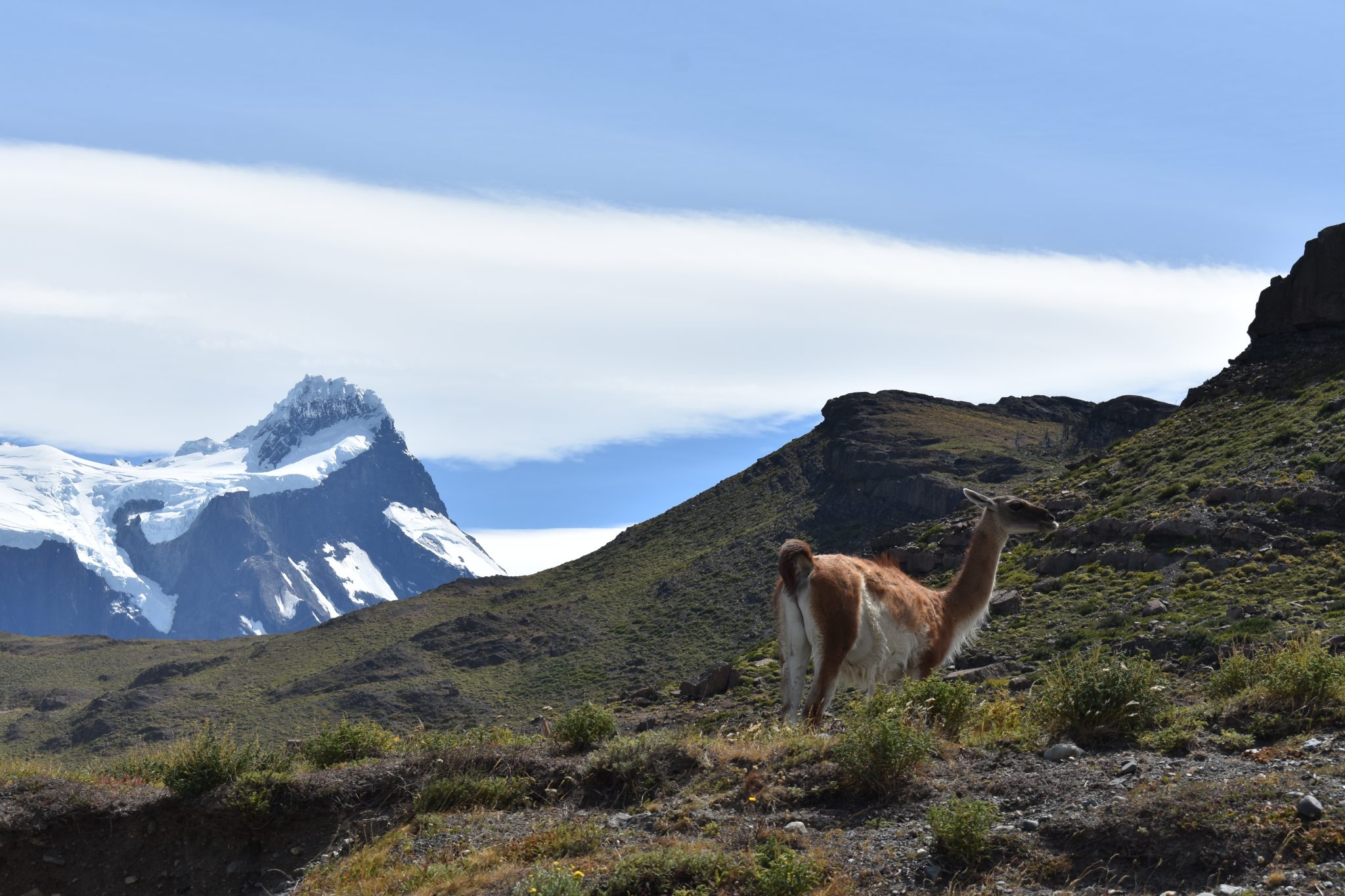
Guanaco in Torres Del Paine
Located in the amazing Torres del Paine National Park which was made a World Biosphere Reserve by UNESCO in 1978. The 100km trek generally takes around 5 days to complete. It takes visitors into the very heart of the park, through haunting forests, soaring mountains, and colossal glaciers.
Where does the W Hike Patagonia Start And End?
The trek begins with a lovely boat ride near the Grey Glacier and finishes with a magical sunrise at the famous Torres on the final morning. There is the option to do the longer full circuit O trek , however, most travelers opt for the shorter W Trek.
Patagonia W Trek - Day By Day Trail Information
Below is a standard, 5-day itinerary outline for your Torres Del Paine W Trek. This can vary depending on fitness levels, available camps, and routes. It should at least provide a good idea of what to expect. This is especially useful if you are trekking Patagonia independently .
Day 1: Puerto Natales to Refugio Grey (11km)
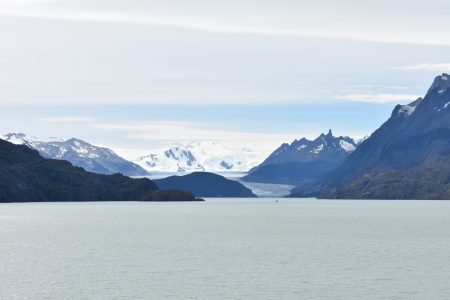
Grey Lake with Grey Glacier in the background, the start of the W Trek
Leave early from the town of Puerto Natales. Buses depart at 7:15, if you go with a tour or taxi, you will probably leave earlier.
Take your transportation Pudeto. This is the next stop after the park entrance.
If you have time, visit the local waterfall and take some pictures. You then take a lovely boat ride by catamaran to Paine Grande. After arriving you begin your trek in earnest with a 3-4 hour (uphill) hike along Lago Grey to Refugio Grey where you camp the night. If you have some energy after dinner, head down to the lake and feel the cold water!
Day 2: Grey Glacier to Paine Grande (19km)
Today you’ll be up early – around 8 am – to hike up to the former campsite of Paso. From the campsite, you take a small path to the lookout platform where you get stunning views across Grey Glacier.
After spending a little time appreciating the glacier, you have the option to continue the hike to Paso.
This is an uphill trek and will add extra mileage to your day. However, I’d recommend it as the trail is absolutely beautiful and gives incredible views all the way along the glacier.
After visiting Paso, return along the trail back down to where you camped the previous night.
After lunch, it is a 3-4 hour hike down to your next campsite at Paine Grande. If you can, find a campsite next to the hill so you’re not battered by the strong winds overnight.
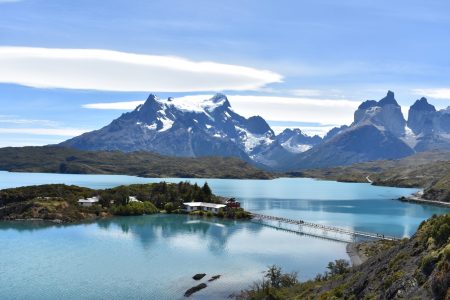
Refugio Paine Grande lies at the other side of Laguna Pehoe
Day 3: Valle del Frances to Los Cuernos (28km)
Today is a long one! Mentally prepare yourself for a full day of hiking. You begin your trek around 8am and hike for several hours until you reach camp.
At the camp, you should dump your large backpack at Campamento Italiano and head on up to Mirador Frances with your daypack. Take your lunch with you along with water and sunscreen.
The walk takes 2-3 hours and you should reach the Mirador around lunchtime.
After stopping to eat and explore the area, you’ll head back down to Campamento Italiano and retrieve your large backpack.
From there you head to your next campsite at Los Cuernos. This is roughly 2 hours walk away.
Day 4: Los Cuernos to Campamento Torres (20km)
This is the last full day of hiking on the circuit. After a leisurely breakfast, you should head off around 9 am towards Campamento Chileno.
Your trek begins on flat ground as you make your way along the Lago Nordernskjöld. After a few hours, you’ll come to a sign saying “shortcut to Chileno”.
Take the shortcut and walk for several hours until you reach the Refugio Chileno. Have lunch here before continuing on.
After lunch, you will walk uphill for an hour or so until you reach Campamento Torres. Leave your large backpacks here and head upwards for 45 minutes until you reach the Torres! Take a well-deserved break and soak in this iconic view.
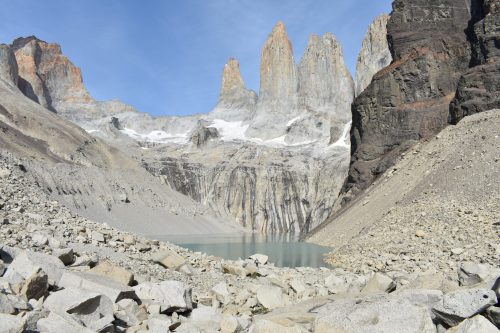
A steep climb up is rewarded with this view of the Iconic Las Torres granite spires
Back at the Refugio, make sure you hit the sack early. You’ll need to be up before sunrise the following day!
Day 5: Torres to Puerto Natales (10-15km)
Don’t sleep in on Day 5! You’ll want to rise early (around 5 am) to get the sunrise views at the mirador of the Towers. Sunrise happens around 6 am in summer and there is just a short walk to the viewing and picnic area. If you’re lucky with the weather, you’ll get an incredible view and witness one of the most beautiful sunrises on our planet! If it’s raining in camp, do not give up – the weather is frequently very different up near the viewing area and the weather can clear fast. It’s worth taking a chance. After your sunrise moment, head back down to camp and pack up all your gear. From camp, you will head down to the Hotel Las Torres. This walk takes roughly 3 hours. From the trail’s end, you can walk to the park entrance. The 7km/ 4.3 miles will take you around 1.5 - 2hrs. At this point, you will be exhausted and may prefer to take the 2 pm minibus to Laguna Amarga at the entrance. Its worth budgeting an extra $10 for this bus fee. The return bus to Puerto Natales leaves at 2:30 pm from the park entrance. Double-check bus times before you set off.
W Trek Patagonia Map
The best map I've found for the Torres Del Paine W Trek is the Torres del Paine Waterproof Trekking Map by Sergio Zagier. The map provides compressive satellite relief, contour lines, shelters, timed trails, camping, and inns.
Other W Trek FAQs
Is altitude sickness a risk on the w trek.
There is essentially zero risk of altitude sickness on the Torres Del Paine Full W Trek. The highest point reached is under 700 meters which is far too low to bring on altitude sickness. See our guide on altitude sickness .
What W Trek guidebook do you recommend?
The one guidebook that stands above all others is Trekking Torres del Paine: Chile’s Premier National Park and Argentina’s Los Glaciares National Park by Rudolf Abraham. The guidebook covers eight major trails within the park including the Full Circuit and the ‘W’ Trek. Maps, tips, and detailed information is provided for each trek and the book is a must for trekkers hiking solo.
What gear do you need for the W hike?
Trekking the W requires a certain amount of essential pieces of trekking clothing and equipment.
Many pieces of equipment including tents, sleeping bags, and mats, can be rented at the campsites. However, rental prices are high. We recommend bringing the most important pieces of gear with you.
To help you plan and prepare for your trek we have written a detailed hiking gear list .
About the author
Alison Macallister
With a degree in Nature Conservation and experience working with wildlife including the Big 5, Alison used to work as a guide for a 5-star safari reserve in South Africa. Today she is a full time traveller and editor for Mountain IQ. She has travelled and hiked extensively in South America, including many solo hikes in Patagonia, the Cusco region of Peru, Ecuador and Chile.
Leave a Reply
Your email address will not be published. Required fields are marked
We work with local guides to offer great value adventures at unbeatable prices
- Skip to primary navigation
- Skip to main content
- Skip to primary sidebar
Earth to Kerra

What is the W Trek? It gets its name simply from the shape of the route you take through Torres Del Paine, the massive park in southern Chile that is also a major highlight of the Patagonian region. If you look up a list of the most epic treks in the world, the W is most likely on that list (or the longer O Trek that connects the two points of the W). Iconic views of the Torres, glaciers, lakes, everything that makes Patagonia the go-to destination for outdoor enthusiasts can be found on the W Trek in Torres Del Paine, Patagonia.

While the W Trek Torres Del Paine continues to grow in popularity, there are restrictions on the number of people allowed in the park at once which helps conservation efforts and makes your experience still feel remote. These restrictions, in combination with language barriers, time zones, etc, make planning/booking campsites or Refugios for the W Trek a bit more very difficult which is why I’ve outlined a comprehensive guide for planning your own trip.
There may have been some arguments, tears, anxiety, while planning my own trip so hopefully this guide can keep you from some of the struggle!
Planning a trip to Patagonia? Start here .
What to Consider
Best time to do the w trek torres del paine, patagonia.
Torres Del Paine is not open to hikers without a guide during the winter months of May through September. October through April, however, is fair game for self-guided backpacking in Torres Del Paine.
October to November is spring time in Patagonia. The park is slowly coming back to life, the weather is getting warmer (40s-50s F), but there are still no mosquitos! This is t he best time of year to visit Patagonia , in my opinion.
- Pros: less people, cheaper prices, no bugs
- Cons: even more unpredictable weather
December to February is summer time in Patagonia. This is high season – prices increase, the weather is warmer (may get to the upper 60’s F) though the region experiences intense wind even more so this time of year. This time of year also sees the most crowds and lodging books up fast (book at least 6 months in advance)!
- Pros: best chances for great weather (exceptional winds though)
- Cons: most expensive time, mosquitos start to come out, peak season (more people)
March to April is fall in Patagonia and similar weather to spring time. This is also a best time of year to do The W Trek.
- Pros: less people, cheaper prices
- Cons: colder weather, still some lingering mosquitoes
We did the W trek in November and experienced every kind of weather – a day full of rain, a day of sunshine and warm temps, a day of intense wind, a day of all the above plus a spurt of snow. You truly must be prepared to experience every season in 1 week no matter what time of year you visit Patagonia.
How crowded is Torres Del Paine?
When we did the W Trek in Torres Del Paine in November, the park was pretty full – most lodging/campsites were booked up each night . We shared scenic points with others and passed fellow trekkers both ways on the trail but it never felt over-crowded . I was surprised by how close the tents were at each site but not much worse than typical campsites anywhere else in the world. This also helps minimize the environmental impact of camping which should be top priority anyway.
Choosing The Best Route for The W Trek

There are a few options for W Trek routes depending on preferred lodging and distances to cover in a day. To make matters even more complicated, there are 3 different entities that run the different lodging options: Fantastico Sur, Vertice, and CONAF. The map of Torres Del Paine above shows all the available lodging options for the W trek, numbered from east to west. I’ve outlined the options below.
Following the map above, Campsites vs Refugios vs Eco Domes
The Refugios and camping vary from site to site but I was impressed, overall, with how comfortable you could make your W Trek experience even with it being so remote (depending on how much you were willing to spend, too). There was always plenty of food, drinks, and even hot showers in some cases.
Booking Campsites and Refugios for the W Trek Torres Del Paine
***important note: Torres Del Paine is only growing in popularity. If you want to do the W Trek you should start booking your route first (even before flights) and build your trip around the booked campsites. The more flexible you are, the better options you’ll have.
Booking W Trek through 3rd Party:
I would recommend using a travel company that coordinates logistics for ease and peace of mind especially if you’re booking late in the game but obviously this adds to the expense. If you choose this route, I’d recommend Flashpacker (which we used and had no issues) or Venture Patagonia . Preferably Venture Patagonia: they are based in Puerto Natales, work with local staff, and can be of more help if something comes up and plans change last minute (they also do custom Patagonia itineraries based on your interests).
Self Booking W Trek Lodging
If not booking through a 3rd party, you will need to plan your route and go to the appropriate owner to book your lodging. This will require emailing or using the websites for Fantastico Sur or Vertice which are not for the faint of heart. I started this process and after phone calls, multiple emails, and back and forth opted for the 3rd party.
We also opted to do the camping option that would have our campsite setup for us and include food; this meant we didn’t need to bring tents, sleeping pads, sleeping bags, or camp food (another lifesaver as we were newbie backpackers).
Our Route: W Trek Torres Del Paine East to West
Day 1 take the 2:30pm bus from Puerto Natales to Torres Del Paine National Park and arrive at (#1)Camp Central about 2.5 hours later. Explore the area, enjoy the sunny weather, get a drink at the fancy hotel near camp and Pisco Sours with dinner at the Refugio. Settle in for the night filled with excitement and naïveté.

Day 2 Hike to Mirador Las Torres stopping at Chileno(#2) on the way up for some Hot Chocolate and snacks. This will fuel you for the climb through the lenga beech forest up to La Morrena where your legs will burn as you cover the rock trail to the look out. Afterwards, eat dinner with new friends, drink more Pisco sours, and take all of the Ibuprofen for achey muscles. Camp at (#1)Camp Central.
- Distance: 11.2 miles
- Elevation Gain: 3,000 ft

Day 3 Hike to (#4)Camp Frances. Get pelted with wind and rain the entire hike but take in the blue Nordenskjold Lake. Stop at (#3)Los Cuernos to warm up briefly, smell the delicious smells of pizza and blazing fireplaces, tell yourself not to indulge because you’re almost at (#4)Camp Frances. Arrive at (#4)Camp Frances and immediately regret your decision not to stay and enjoy (#3)Los Cuernos while you could. Eat dinner with new friends, cheer up as you share stories from the day, and even take a hot shower (!!!).
- Distance: 9 miles
- Elevation Gain: not much

Day 4 Hike from (#4)Frances to (#5)Italiano, drop packs, then head to Mirador Britanico. Cry happy tears while eating lunch with 360 views of majestic mountaintops in the warm sun. Continue down to pick up packs while it snows (??) and head to (#6)Paine Grande camp in freezing rain (!?!). Devour large portions of rice, meat, caramel cake, and make more new friends.
- Distance: 13.5 miles
- Elevation Gain: about 3500 ft

Day 5 Hike from (#6)Paine Grande to (#7)Glacier Grey. Realize this plan is too ambitious for current slow pace while fighting gusts of INSANE wind half knocking you over, stop at Mirador Grey instead, then head back for Austrel Cervezas before getting on the evening boat back to the park entrance. After the boat ride, take the bus back to Puerto Natales for the night, relish the fact that you just completed the W Trek, and begin planning your return!!
- Distance: planned= 6.8miles, actual = 3miles
- Elevation Gain: 1000 ft

W Trek Lessons Learned:
What I would have done different now knowing what I know.
Go West to East
This would have allowed our muscles to warm up before getting to Los Torres and ended on the high note
Hiked to Mirador Las Torres Day 1
We did not fully understand how much the weather would change day to day and had perfect sunny, clear skies on Day 1 which we assumed would continue on Day 2. I wish we took advantage of the weather and hit the trail ASAP. We were unlucky Day 2 and did not get to see the Torres up close which is very common.
Stayed at Los Cuernos instead of Camp Frances (only if I trained more)
Camp Frances was on a major slope and much smaller with no real view of anything. They did have hot steaming showers for a limited amount of time which was a huge redeeming factor.
Los Cuernos was larger, had more food options, warmer, and there was a better view all around.
Doing this switch would make day 3 even longer and more difficult, something to consider if you’re concerned about your physical ability mid-trek.
Stayed at Chileno and did the sunrise hike to Los Torres
Get to the Torres earlier with a better chance for visibility
This hike is brutal so starting from Chileno would save your legs some energy
I didn’t get to see the Refugio at Chileno so I can’t speak to how nice the accommodations are compared to Camp Central but the lodge and bathrooms were definitely a bit more rustic.
- INVESTED IN HIGH QUALITY RAIN GEAR

Biggest lesson learned on this trip – don’t skimp on the important stuff that keeps you dry and warm ! I bought “rain proof” pants on amazon and a low quality rain jacket all of which got drenched after an hour of hiking in the rain and never fully dried. Luckily, we only had 1 solid day of rain or I would’ve been in deep trouble.
Now I’ve invested in Gortex rain gear which I’ve tested out on multiple rainy trips with much success! What a different experience the right gear can provide!
Pack half as many trail snacks as I think I need
I am always concerned about having enough food. When we opted for the “full board” option which provides breakfast, packed lunches, and dinner on trail, I was nervous about how much food would be available for such a remote location; this was unnecessary! The Refugios will feed you well with large portions and options to purchase more small snacks at some locations.

Packed lunches consisted of deli meat sandwiches, fruit, cookies, nuts, etc. We never finished the whole meal.
Important note for dietary restrictions – most every meal centered around meat and lunches always involved bread. Definitely something to research if you have restrictions.
Keep going and do the full O Circuit!
We met a few groups who were doing the full O and we were definitely jealous. I would 100% go back and do the full circuit – this time with better gear and determination to see Las Torres up close!
Stayed in a Cabin or Eco-Dome

- Passing the cozy cabins in Los Cuernos sector while on our way to a cold, dark, wet tent at Camp Frances was a bit heartbreaking. Next time, I would splurge and try to book one of the cabins or eco-domes for the experience and for a break from the elements.
Do a practice run before the real thing
Beginner tip: test out your gear before beginning a backpacking trip – I obviously did not take this tip seriously when it came to rain gear.
Train with your pack and boots on. Physically, I felt fine after the W Trek with minimal training before the trip (i.e. I went to the gym maybe once a week). However, we did more hiking in El Chalten after this trek and I was hurting, so training more could’ve helped.

And that’s that, my friends! I hope this guide was helpful for your own planning or perhaps inspired you to visit Torres Del Paine in Patagonia someday soon – it is quite the adventure and certainly lives up to the hype.
Happy Travels xo
Pin now, read later:


The Ultimate Guide to Hiking the ‘W’ Trek in Torres del Paine Without A Tour
By Author Steph Dyson
Posted on Last updated: 12th December 2023
Hiking the W in Chilean Patagonia’s Torres del Paine National Park is one of the absolute highlights of a visit to Patagonia – I should know, I’ve done it twice!
Back in March 2016, I walked the Torres del Paine W trek as part of a tour around Patagonia and was so struck by the park that I returned in March 2017 to hike the Full O Circuit .
In September 2022, I returned on a third occasion, this time to explore the other attractions of Torres del Paine National Park beyond these two, multi-day hikes.
It’s fair to say that on all occasions I have fallen head over heels in love with this part of Chilean Patagonia.
The problem is, the first time I hiked the W trek in Patagonia, I did so as part of a guided tour. We were dropped off at the Pudeto ferry port on Lake Pehoé and from that point onwards barely even had to think for ourselves.
We hiked the W during the day led along the one path by our guides and arrived at night to pre-pitched tents and pre-paid food.
However, it didn’t take more than five minutes of being in the park to realize that a tour was utterly unnecessary and that trekking in Torres del Paine solo and self-guided is easy and will also save you a whole stash of money.
Click to navigate this article:
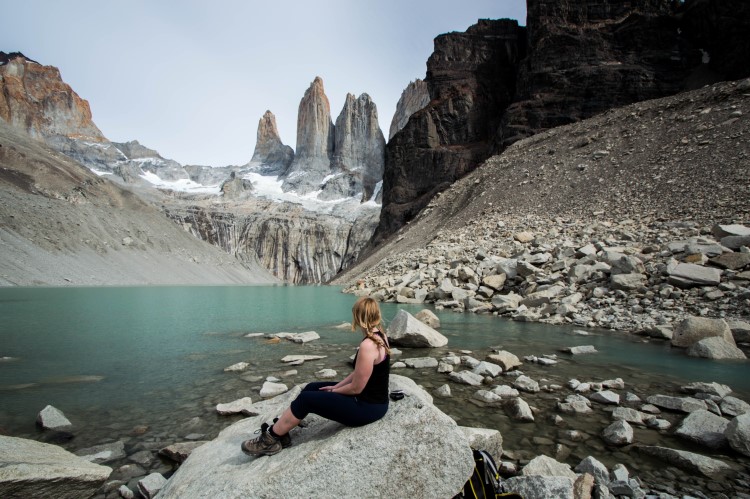
Know-before-you-go facts about the Torres del Paine W Trek
- How long is the W trek in Torres del Paine? It’s an 80-kilometer (50-mile) hike that most do over four or five days.
- When can you hike the W trek? The park is open year-round, however, for self-guided trekking, you can only hike between October and the end of April. If you want to hike during the winter months (May through September), you’ll need to arrange a guide. Our local partner, Chile Nativo, lead winter tours of the W trek and offer a 5% discount to Worldly Adventurer readers (use “Worldly Adventurer” in the referral discount box when you book!).
- Do you need to reserve camping spots/dormitory accommodation in advance of hiking the W? Yes, you must have reservations at each of the campgrounds or dormitories in which you plan to stay during the hike. You might be required to show your reservations when you enter the park, too.
- What about food? You can reserve full board at the campgrounds, which will include an evening meal, breakfast the day after your stay, and a packed lunch for you to take to the next campground. This typically needs to be booked in advance, although if you get to the campground early enough, you can sometimes do it on the day. Some campgrounds offer buffet dining (Grey and Paine Grande), so can be a good place to stock up on some snacks for the following day.
- Are reservations open for the campgrounds and dormitories along the W trek for the 2023/2024 season? Yes, reservations opened in July.
- How fit do you need to be to hike the W trek? While previous backpacking experience is not necessary, you do need a reasonable level of fitness to be able to climb up into the Frances Valley and up to the towers themselves. It’s helpful to have done a couple of practice walks, with a backpack weighing around 10 kilograms (22 pounds), in preparation for the trail.
- Do you need to book your park entrance ticket in advance? You must book online as they are no longer accept payments at the park entrance. Book your ticket online here . You need to download the QR code in Puerto Natales while you have internet (there is no signal in the park) and may need to show a copy of your passport to prove you do not live in Chile.
- How much does it cost to enter Torres del Paine National Park? The cost of entering the park varies according to how long you plan on staying. For up to three days in the national park, it costs $31,200 CLP ($34 USD) for adults and $16,000 CLP ($17 USD) for children aged 12 to 17. For over three days in the park, the cost is $44,500 CLP ($48 USD) for both adults and children.
- What is the altitude of Torres del Paine National Park? The highest point in the park is the John Gardner Pass at an altitude of 1,200 meters (3,900 feet) above sea level. However, only those trekking the O Circuit are required to reach this height; all of the W trek is at altitudes below this.
Firstly though, what actually is the W? The W is a four- or five-day hike in Chilean Patagonia’s Torres del Paine National Park. It’s named the W because it follows a W-shaped route and can be hiked either from west to east (my preferred route) or from east to west.
Along the way, you stay overnight in official campgrounds, which also have indoor dormitories, covered cooking areas for campers, and restaurants where you can eat pre-ordered meals.
Is the W worth it, though? It’s one of Patagonia’s easiest multi-day hikes and, while hiking for five days might not be at the top of everyone’s to-do list, the scenery in Torres del Paine National Park makes up for the hard work! Every day has spellbinding views: whether of Grey Glacier on day one, the French Valley on day two or three, or the eponymous towers on the final day of the hike.
You’ll finish tired but truly fulfilled by the experience – and proud of yourself for having completed it! Bear in mind that the W trek is a moderately challenging hike. If you’re able to walk up to 18 kilometers (11 miles) per day (and feel like you would be able to do that over multiple days), then you will find this hike perfectly doable.
That said, the hike up to the towers on the final day of the W (or the first, if you’re hiking east to west), is classed as a difficult hike due to the elevation gain of 900 meters (2,956 ft).
Bear in mind that you will be trekking with a backpack; the contents will depend on whether you’re carrying your tent and meals or planning on renting camping equipment and paying for meals at the campgrounds en route. Before hiking up the French Valley and up to the towers, you can also leave your backpacks at the rangers’ station or campsite, which means you won’t have to carry them up much elevation.
I highly recommend that, before heading to Patagonia, you go on a couple of hikes of around 18 kilometers (11 miles) with a backpack that will mimic the weight you’ll be carrying in the park – this will also help you to break in any hiking boots you might have bought for the trek and find out if they give you blisters!
How much does it cost to hike the W?
I’ve hiked the W twice: once as part of a tour and another time independently as part of hiking the O Circuit (which is a nine- or ten-day hike circumnavigating the national park and whose final five days are the W).
On my second visit to the national park, it became clear that I really didn’t need to hike the trails using a tour company. Not only is it expensive (it costs from $1,500 USD per person), but it’s unnecessary; all of the trails are clearly marked and busy with people and it’s easy enough to make camping reservations yourself.
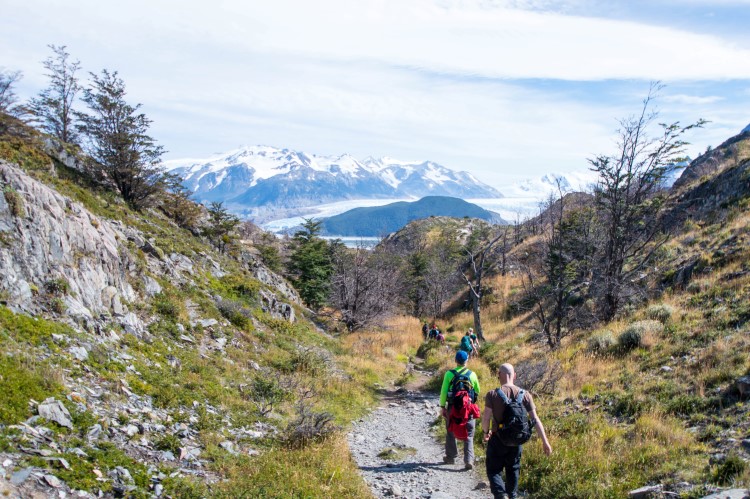
Hiking the W independently costs $157,000 CLP per person ($173 USD – check here for the most up-to-date conversion), plus the cost of food .
Camping and Transport cost breakdown*
- Return bus from Puerto Natales to Torres del Paine National Park: $13.323 CLP ($15 USD)
- Adult entrance fee into the park: $44,000 CLP ($49 USD)
- One-way ferry from Pudeto de Paine Grande Ranger Station: $30,000 CLP ($40 USD)
- Grey Campsite: $11,000 CLP (per person) ($12 USD)
- Paine Grande Campsite: $11,000 CLP (per person) ($12 USD)
- Francés Campsite: $31,000 CLP (per person) ($35 USD)**
- El Chileno Campsite: $31,000 CLP (per person) ($35 USD)***
* these figures are all updated for the 2023/2024 season.
**based on two people sharing a tent
***Torres Ranger Station (the free camping closest to the towers) is closed for the foreseeable future.
Food breakdown
- When we hiked the Full Circuit, we paid $68,620 CLP ($95 USD) between four people for all of our food. That’s $17,155 CLP ($20,5 USD) per person. No kidding.
- So for your food budget, expect to spend no more than $10,000 CLP ($12 USD) (read this full outline of exactly what we took with us in terms of food when we walked the Circuit)
If you want to save time, the website Torres Hike can show you the availability of accommodation and allows you to book it directly through them , rather than having to go via the Vertice Patagonia and Las Torres (previously known as Fantastico Sur) websites. All you need to do is plug in your dates and it’ll show you which campgrounds and refugios are available – saving you LOTS of time. You can then book directly with them, rather than having to try and book through the other websites!
How do you make campsite and refugio bookings for Torres del Paine?
The system for making refugio and camping reservations has changed dramatically over the past couple of years and a lot of the information you find online about the subject is out of date.
I also put together this epic, 5,000-word post about securing camping reservations in Torres del Paine that literally walks you through the process. However, I highly recommend just using Torres Hike . Yes, they charge you a small fee, but it honestly saves you so much time.
The reason it’s so challenging to make reservations independently is because there are two different companies who offer campgrounds and dorms in the park and you will have to reserve some campgrounds with one on their website and some with another on their website; trust me, it’s a painful process. Save yourself the stress and hassle of doing this by using Torres Hike instead.
Reservations are now open for the 2023/2024 season. If you’re struggling to find spots for the coming season, you should also read my article about alternative ways to hike the W if you can’t get camping reservations .
You can also check out this ultimate guide to Torres del Paine National Park , covering everything from the best time to visit, to where to stay and what to do beyond the W trek.
If you’re completely baffled by the process and just want someone else to deal with it, you can book with my partner in the region, Chile Nativo , who organise, guided, self-guided and fast-track (three-day) W treks. They give a 5% discount to Worldly Adventurer readers (use “Worldly Adventurer” in the referral discount box when you book!).
What equipment do you need to hike the W without a tour?
To pay as little as possible trekking Torres del Paine solo, it does require that you have the following pieces of equipment:
- A tent: I strongly recommend the lightweight Big Agnes Copper Spur HV UL2 tent ( REI | Backcountry | Amazon ), the North Face Stormbreak 2 (buy it on REI | Amazon ), or, for more room, the North Face Stormbreak 3 (buy it on ( REI ).
- A sleeping bag: I recommend the Nemo Disco 15 for women (buy it on REI ) and for men (buy it on REI ).
- A sleeping pad: Get a cheap foam pad ( REI | Backcountry | Amazon ) or a more comfortable Therm-a-rest Prolite (buy it on REI | Backcountry | Amazon ).
- A headlamp : Useful for midnight toilet visits and the hike up to the towers (buy one on REI | Black Diamond | Backcountry ).
- A cooking stove and gas: The affordable MSR PocketRocket 2 (buy it on REI | Backcountry | Amazon ) is great value for those on more of a budget, and is super lightweight.
- Cooking pots: I recommend the MSR pots set (buy them on Backcountry | Amazon ) as they’re good quality and food will stick less, which will make them easier to clean.
- Plates, a mug, and cutlery : A collapsible bowl is a great space saver (check out Sea to Summit on REI | Backcountry | Amazon ); I recommend a reasonably cheap, plastic mug (buy it on REI | Backcountry | Amazon ) and for cutlery, a multipurpose spork is a good choice (check them out on REI | Backcountry | Amazon ).
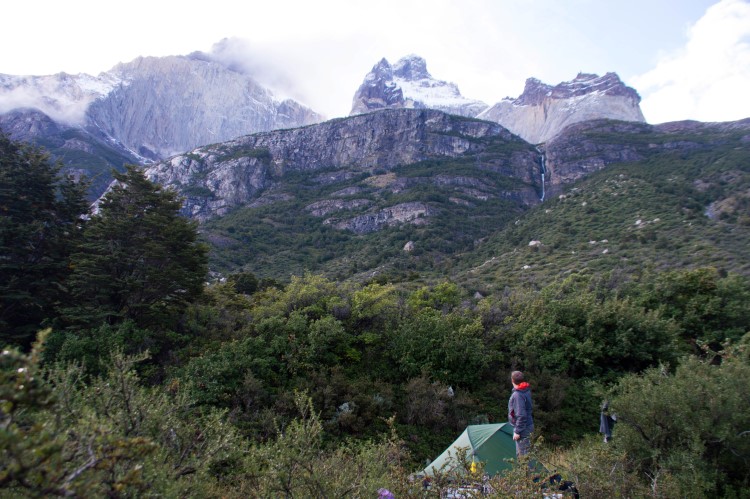
I’ve detailed exactly the items that I packed for the O Circuit in Torres del Paine (and which are still relevant to the W trek) and also what I pack in my rucksack on a trip to Patagonia in this packing checklist . Both have a free packing checklist download, too.
I recommend you take a look if you’re thinking of investing in camping equipment before you head over to Patagonia (something I would strongly advise if you plan on doing any other hikes or wild camping or if you’re looking at exploring the Carretera Austral ).
Planning Your Trip to Patagonia?
Save time, stress & money with a customized travel itinerary planned for you by a Patagonia expert
What previous clients have said:
Steph’s help laying out an itinerary for Chile was huge toward us having a great trip. She listened to our interests and compiled a framework that we could follow to make our plans. She included many practical tips as well as numerous options. She truly saved us many, many hours of research.
If you’re already traveling around Patagonia, what can you do to get your hands on this camping equipment for Torres del Paine?
You have three options:
Buy equipment in Punta Arenas or Puerto Natales
There is a wide range of hiking and camping equipment shops in these two towns. Punta Arenas is a tax-free zone so prices here are cheaper than you will find in Puerto Natales, although Calle Manuel Bulnes in the latter has some gear shops.
I actually found a pair of waterproof trousers for only $15,000 CLP ($18 USD) in one of the shops there, which is a lot cheaper than I thought they would be.
If you’re looking to buy equipment for camping and hiking in Torres del Paine National Park, you should be able to find everything that you need in these shops, but you will pay an elevated price for good-quality gear.
Estimated additional cost: $360,000 CLP+ ($400 USD+) per person
Rent equipment from Puerto Natales
Your second option is to rent all of your camping and cooking equipment from Rental Natales (you can book online) in Puerto Natales. However, they are very expensive.
There are other places in Puerto Natales to rent equipment too, so I suggest having a wander around and looking out for signs for rental equipment. Yaghan House (O’Higgins 584) and Lili Patagonico’s (Arturo Prat 479) have much cheaper, good-quality rental gear.
Remember to check the equipment thoroughly before committing as it does get a lot of wear and tear on the trail and you want something without holes and with zips that close to keep you warm and dry!
Estimated additional cost: $147,000 CLP ($162 USD) per person (based on two sharing) for five days’ rental
Rent equipment at each campsite in Torres del Paine National Park
Your final option is by far the most expensive. Each of the main camping grounds in Torres del Paine rents out tents, sleeping bags, and sleeping mats – but at a very high cost.
For example, in Grey campground, you can hire a two-man tent for $29,000 CLP ($32 USD), a sleeping bag for $21,000 CLP ($23 USD), and a sleeping mat for $8,000 CLP ($9 USD), bringing up your overnight cost (including the cost of the camping site) to $53,000 CLP ($58 USD) per person per night (based on two sharing).
Bear in mind, this doesn’t include the cost of hiring cooking equipment (which you can’t do at the campsites), so you will also need to pay for meals at each – an additional cost of between $55,000 CLP ($61 USD) and $80,000 CLP ($88 USD).
Estimated additional cost: $232,000 CLP ($256 USD) per person for equipment and $256,000 CLP ($282 USD) per person for full board for five days hiking the W circuit (based on two sharing).
How do you get from Torres del Paine National Park to Puerto Natales ?
It’s easy enough to get to Torres del Paine National Park with public transport.
Four companies travel from Puerto Natales to Torres del Paine each morning and all cost around $22,000 CLP ($25 USD) for a return ticket (which can be used on any of the company’s buses back from the park).
You can buy tickets online for Bus Sur (who have lots of departures); other companies do run this route, however you need to buy tickets from their offices, which are inside the Terminal Rodoviario (Av. España 1455) in Puerto Natales.
If there are a few of you, consider negotiating a group price like we did, which got us a few thousand pesos off per ticket.
It’s advisable to book your bus ticket at least a week in advance when visiting the park in high season (December through February).
Timetables for buses from Puerto Natales to Torres del Paine (east to south: Laguna Amarga, Pudeto and Administración)*
Conventionally, buses have departed from Puerto Natales and entered the park via the northeastern entrance at Laguna Amarga (for the minibus to the eastern starting point for the W), before continuing to Pudeto (for the catamaran to the western starting point for the W) and finally to Administración (not a destination along the W trek).
These now continue along to Hotel Lago Grey and stop at Camping Pehoé en route, too.
These bus timetables are below and can be booked online in advance via Bus Sur’s website:
Pre-pandemic, the following companies also offered services. However, their websites are no longer active and I can’t find them on any local booking sites.
That doesn’t mean they don’t have buses, however; if you can’t get a reservation with Bus Sur then it’s still worth going to the bus terminal in Puerto Natales as some will likely still be in operation and with similar departure times:
- Transport Maria José (tel. 61/2410 951)
- Buses Gómez (tel. 61/2415700)
- JB Buses Patagonia (tel. 61/2410 242)
- Buses Juan Ojeda (tel. 9/8943 7808)
*Service available November through April
Timetables for buses from Torres del Paine to Puerto Natales (Administración, Pudeto, Laguna Amarga)*
The following timetables are when buses can return you to Puerto Natales from the four different stops in the park. They can also be booked online and in advance via Bus Sur’s website.
Note that you have to return with the same bus company you entered the park with – you won’t be allowed on a different company’s buses. You don’t have to book a particular bus time; you will be able to turn up and get onto whichever bus you choose.
As above, there should be other companies offering buses to and from Puerto Natales into the park; visit the Terminal Rodovario in Puerto Natales to find out if you can’t make a reservation with Bus Sur.
Where do you buy your Torres del Paine entrance ticket?
The cost of entering the park varies according to how long you plan on staying. For up to three days in the park, it costs $31,200 CLP ($34 USD) for adults and $16,000 CLP ($17 USD) for children aged 12 to 17. For over three days in the park, the cost is $44,500 CLP ($48 USD) for both adults and children.
It’s no longer possible to buy your ticket at the Laguna Amarga entrance to the national park (the first stop on the bus if entering via that entrance) or at the Administración entrance (if entering via that entrance).
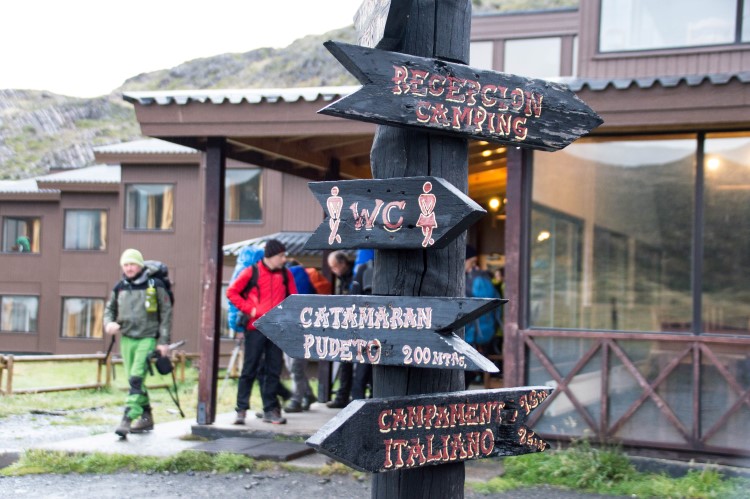
You must buy it in advance online here . You must download the QR code to your phone before you enter the park (as you won’t have signal when you get there!) and bring your passport to show that you’re not a Chilean resident.
Torres del Paine W trek itineraries
Hiking in Torres del Paine National Park is significantly cheaper if you go self-guided.
There is also absolutely no chance that you’ll get lost. Believe me, the W trek is now so busy that (unfortunately) you see people all the time.
If you want to trek Torres del Paine solo, you can either hike from west to east (my preference, as I’ll go into below) or east to west.
When you enter the park and pay your fee, you will be provided with a Torres del Paine W trek map to be used when you’re walking.
Unfortunately, the map that you get from CONAF doesn’t include distances. I would strongly recommend you download Maps.me, a free app that has all the trails marked and you can use it to work out distances if required.
Itinerary one: W trek in five days with sunrise at Mirador Las Torres (west to east route)
Why hike this route:
- This trail builds up to the most exciting part of the trek, the Mirador Las Torres viewpoint on the final day.
- It also starts with a short first day, giving you time to get into your stride.
Want to know how to book the campsites mentioned in this itinerary? Head over to this comprehensive article about booking Torres del Paine camping or hostel accommodation .
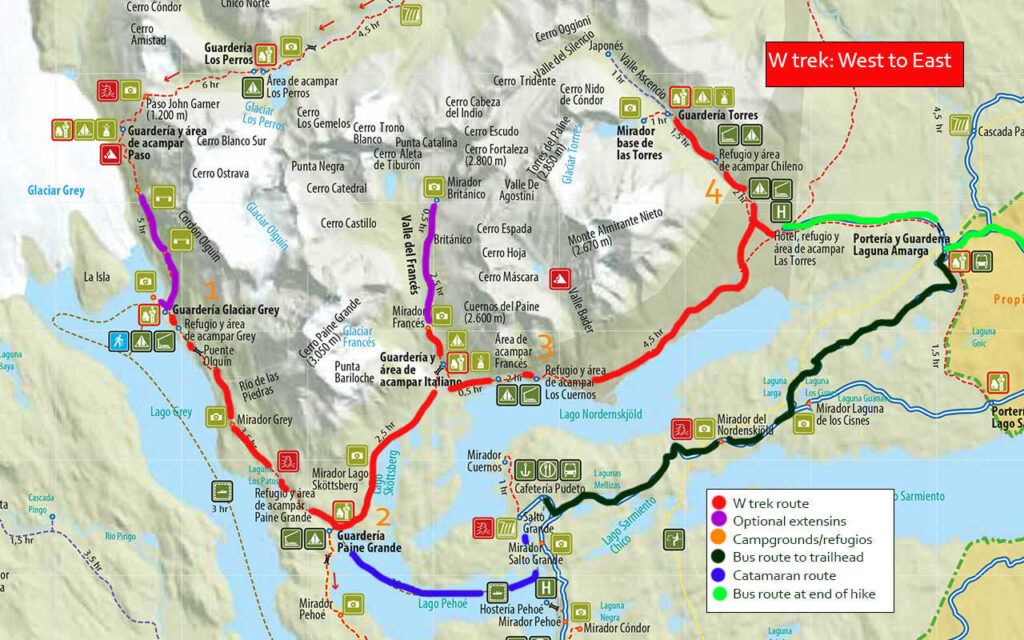
Day One: Puerto Natales to Grey
- Distance: 11 kilometers (6.8 miles)
- Duration: 3-4 hours hiking
6:50am Take a bus from Puerto Natales to the Pudeto (the catamaran ferry stop). You will stop at the park entrance when you first get into Torres del Paine to show your entrance ticket.
You must have bought this in advance online here and downloaded the QR code to your phone (there isn’t internet cell service at Laguna Amarga!).
9:50am Arrive at Pudeto. Queue up for the catamaran ferry across the lake.
10:30am Take the ferry across to Paine Grande*. This service is operated by Hielos Patagonicos ($25,000 ($30 USD) single, cash only). Tickets cannot be reserved in advance; you buy them at the ferry port.
Ferry schedules do sometimes change; you can check up-to-date ones here .
11:40am Arrive at Paine Grande and trek to Grey. The trail starts to go uphill but soon levels off and has great views of Lago Grey to keep your spirits up!
16:00pm The hike from Paine Grande takes between three and four hours so expect to arrive late afternoon at Grey to pitch your tent, meet some other hikers, and cook dinner.
Day Two: Grey to Paine Grande
- Distance: 18 kilometers (11 miles)
- Duration: 6-7 hours hiking
8:00am Wake up and have breakfast.
9:00am Leave your stuff at the campsite and return a few hours later to pack everything up. From the campsite, an additional one kilometre north through the forest brings you go two viewpoints lying over a kilometre from the glacier’s snout. From here, look out for enormous chunks of ice in the water.
Continue a further 2.5 kilometres (around a one-hour hike) along the path along the edge of the glacier to reach a series of two rope bridges hanging over ravines.
From here you get the best views of the glacier and, if you’re lucky and it’s a clear day, the Southern Patagonian Ice Field beyond.
Return to Grey along the same path and back to Paine Grande.
16:00pm You’ll arrive at Paine Grande at around 4pm, which is where you’ll spend the night. The facilities are great here, with a covered dining area for campers.
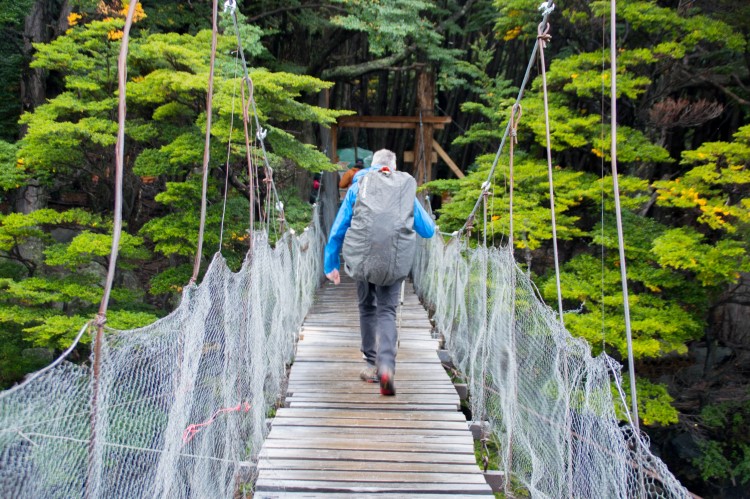
Day Three: Paine Grande to Francés
- Distance: 11.5 kilometers (6.8 miles) plus 9 kilometers (5.6 miles) for the extension to Mirador Británico)
- Duration: 4 hours hiking (7.5 hours with extension to Mirador Británico)
8:00am Get up, have breakfast and pack up your tent.
9:00am Today begins with a flattish trek around Lake Nordernskjold to Guardería Italiano. You can leave your bags here with the ranger before hiking up into the Francés Valley.
Note that there’s a new trail that begins about one km (15 mins) after you leave Paine Grande. It’s a little longer – 9 km (5.6 miles) rather than 7 km (4.3 miles) – and so takes around 30 minutes longer, but it has fewer hikers on it and is really pretty.
11:00am The hike up the Francés Valley may be long or painfully short – all depending on the weather. Both times I’ve walked Torres del Paine W hike I’ve experienced dreadful weather in the Francés Valley.
This part of the hike marks the central section of the W and it’s all uphill. After an hour’s steep gradient up a rocky, slippery trail to Mirador Francés, look for Glaciar Francés as it clings to the mountainside in the west.
If you’re feeling energetic, and the weather’s playing fair, you can continue climbing to Mirador Británico (an additional 3.5 km (2 miles) each way; around three hours’ return), where you’ll view a ring of toothy granite peaks, including the park’s second most famous landmark, the three-horned Cuernos del Paine.
It’s one of the park’s most stunning viewpoints—when the sky is clear. You may even see an endangered Southern Andean huemul (a type of deer) around here.
Luckily, the hike back is downhill to return to Campamento Italiano, where you pick up your rucksack and hike the 30 minutes to reach Francés.
13:00pm-16:00pm Arrive at Francés*, pitch up and enjoy the views across the lake.
*If there is no availability at Francés when you go to make your refugio or campsite reservations , you can instead book to stay at Los Cuernos, which is a further 3.5 kilometers (one hour) from Francés.
Day Four: Francés to El Chileno*
- Distance: 17 kilometers (10.5 miles)
- Duration: 4-5 hours hiking
9:00am Leave the campsite and begin the trek to El Chileno, situated about two hours from the bottom of the towers.
This trek meanders alongside the lake, gaining and losing altitude as it goes, until you reach the start of the valley where it becomes all uphill. The views are incredible but if it’s sunny, it will be hot!
16:00pm Arrive at El Chileno* and pitch your tent. Get everything organised for the morning as you’ll be leaving early. Check with the staff what time sunrise will be the next morning.
*For the 2023-2024 season, and for the foreseeable future, Torres Ranger Station is not open to the public. It’s no longer as easy to get to the towers for dawn as the distance is now around four kilometres, rather than one kilometre; however, it is still possible to do it.
If you can’t get a pitch at Chileno, it is possible to hike from Torres Central/Norte ($25 USD camping pitch per person). Although you’re not officially supposed to hike from here up to the towers, you can: leave four hours ahead of sunrise. It’s an additional one-hour 45 minutes if starting from Torres Central/Norte to reach the towers.
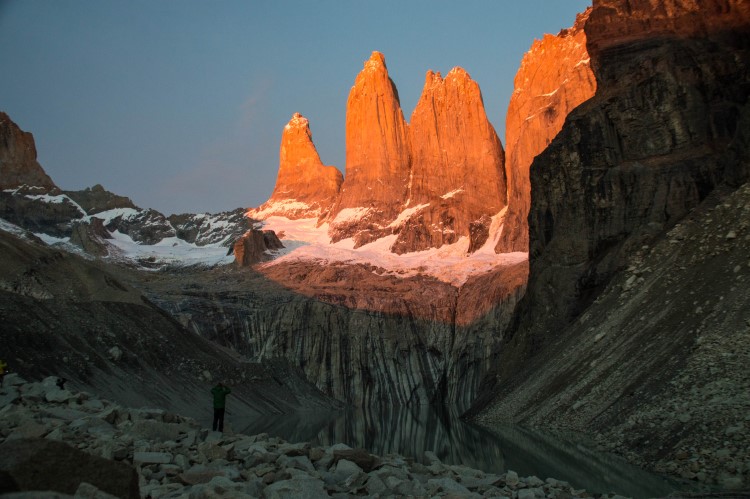
Day Five: El Chileno* to Laguna Amarga and Puerto Natales
- Distance: 13 kilometers (8 miles) plus 8 kilometers (5 miles) for the hike from the Centro de Bienvenida to Laguna Amarga)
- Duration: 6 hours hiking (add an extra 1.5-2 hours for the hike to Laguna Amarga)
4:30am Wake up and take a small bag (including warm clothes and a snack) to see the torres at dawn. Don’t forget your torch as the route is over rocks and can be treacherous.
4:45am Start hiking up to the torres . For us at the very start of March, dawn was at about 7:15am.
8:00am Leave the torres and return to the campsite. Pack up, have breakfast start the long walk down.
12.30pm When you get to Las Torres Hotel car park, there is a shop selling ice creams. To get the shuttle minibus to take you to Laguna Amarga, you need to hike one kilometre down the road towards Torres Central/Norte to reach the Centro de Bienvenida /Welcome Centre.
Shuttles ($4,000 CLP ($6 USD) – you must pay in cash at the shuttle) leave throughout the day to take you to Laguna Amarga. Departures leave the Welcome Centre at 8am, 2pm, 4pm and 7pm daily , and take about 30 mins.
If you can face the walk, it’s about another one and a half hours to the Laguna Amarga Ranger Station where buses are waiting to pick you up.
Hiking there, you can get good views of the towers as they rise out of the Cordillera Paine if the weather is clear.
14:30pm Take the bus from Laguna Amarga back to Puerto Natales.
17:00pm Arrive in Puerto Natales bus station and go and enjoy a pint at Cerveza Baguales on the Plaza de Armas to celebrate!
If time allows, consider spending a night in Puerto Natales to explore all the town has to offer before your onward journey. Our guide to the best hotels in Puerto Natales caters for all budgets, styles and preferences.
*If you can’t get a pitch at Chileno, it is possible to hike from Torres Central/Norte ($21 USD camping pitch per person). Although you’re not officially supposed to hike from here up to the towers, you can: leave four hours ahead of sunrise. It’s an additional one-hour 45 minutes if starting from Torres Central/Norte to reach the towers.
Make sure you bring a headtorch for climbing in the dark (it will get lighter as you reach the more difficult stretch of hiking just below the towers), plus warm clothing (even including a sleeping bag) to use at the top and keep you cozy as you enjoy the sunrise.
Itinerary two: Torres del Paine W trek in four days with sunrise at Mirador Las Torres (west to east route)
Why hike this route?
- It’s a good option if you don’t have much time
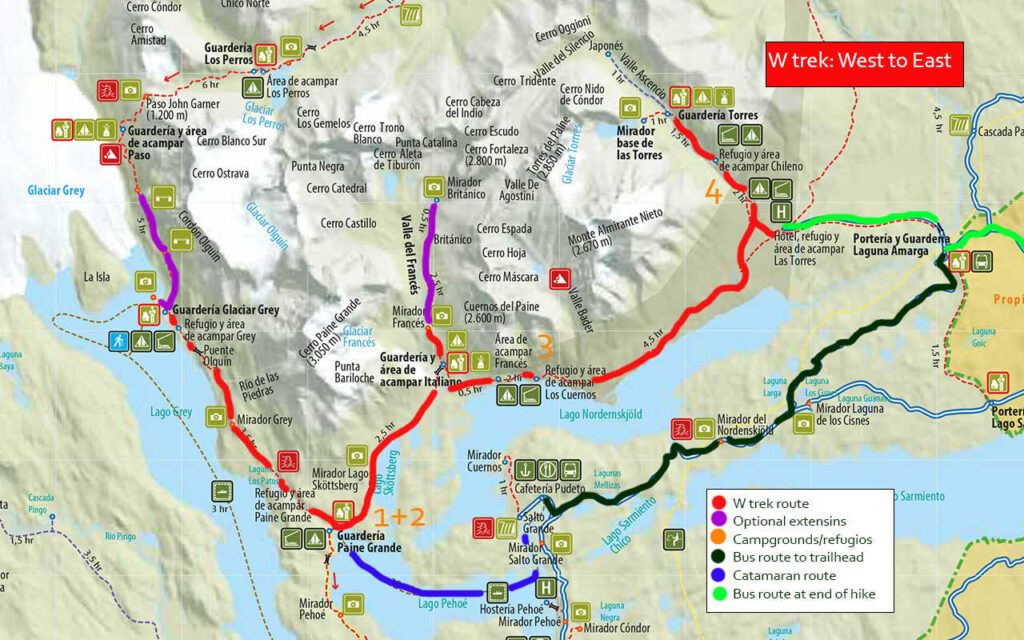
Day Zero – Puerto Natales to Paine Grande
- Distance: nil
- Duration: nil
2.30pm Catch the Bus Sur bus from Puerto Natales.
You will stop at the park entrance at Laguna Amarga when you first get into Torres del Paine to pay your entrance fee.
You must have paid for your ticket in advance online here AND downloaded the QR code; you will not find cell service or WIFI at the entrance.
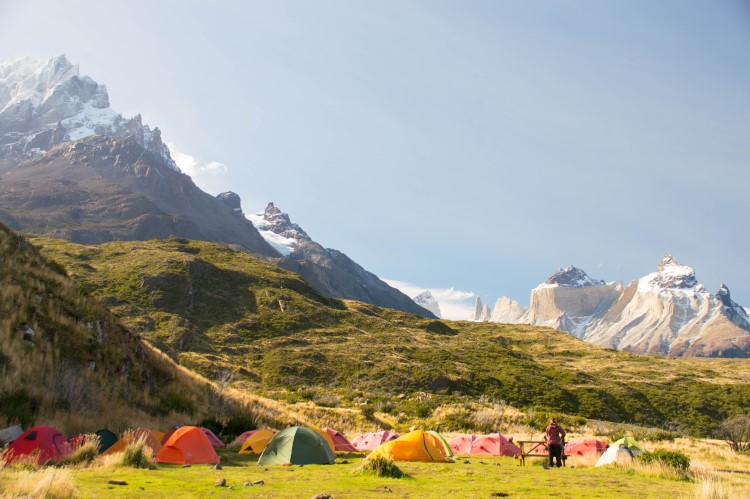
5.15pm Arrive at Pudeto take the ferry across to Paine Grande at 6pm. This service is operated by Hielos Patagonicos ($25,000 ($30 USD) single, cash only).
Tickets cannot be reserved in advance; you buy them at the ferry port. Ferry schedules and prices do sometimes change; you can check up-to-date ones here and the 9am ferry only runs November through the end of March.
6.30pm Pitch up at Paine Grande, have some dinner and then have an early night in preparation for a long day’s hiking tomorrow.
Day One – Paine Grande to Paine Grande
- Distance: 22 kilometers (14 miles) plus 7 kilometers (4.3 miles) if you hike to the last viewpoint)
- Duration: 7-9 hours hiking
7:00am Get up, have breakfast, and pack up your tent.
08:00am Take the trail towards Grey; it starts uphill but soon levels off and has great views of Lago Grey to keep your spirits up!
If you’re fit, you can hike an additional one kilometre north through the forest brings you go two viewpoints lying over a kilometre from the glacier’s snout. From here, look out for enormous chunks of ice in the water.
Turn back and return the way you came, past Grey and then back to Paine Grande.
17:00pm Arrive late afternoon back at Paine Grande to meet some other hikers and cook dinner.
Day Two – Paine Grande to Frances
9:00am Hike to the ranger station, Guardaria Italiano (around two hours), where you leave your rucksack with the ranger. You’ll pick it up on your way back down from the Francés Valley.
The hike up the Francés Valley may be long or painfully short – all depending on the weather. Both times I’ve walked Torres del Paine W hike I’ve experienced dreadful weather in the Francés Valley.
If you’re feeling energetic, and the weather’s playing fair, you can continue climbing to Mirador Británico (an additional 3.5 km each way; around three hours’ return), where you’ll view a ring of toothy granite peaks, including the park’s second most famous landmark, the three-horned Cuernos del Paine.
Luckily, the hike back is downhill to return to Italiano, where you pick up your rucksack and hike the 30 minutes to reach Francés.
*If there is no availability at Francés when you go to make your refugio or campsite reservations , you can instead book to stay at Los Cuernos, which is a further 3.5 kilometres (one hour) from Francés.
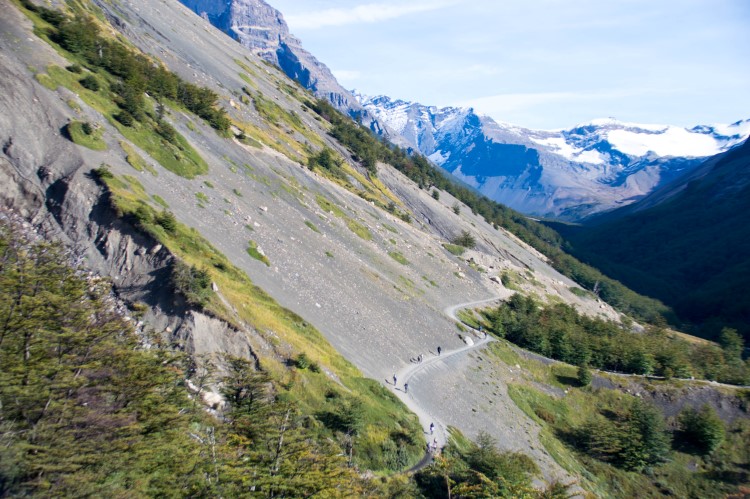
Day Three: Francés to El Chileno*
9:00am Leave the campsite and begin the trek to El Chileno, situated about two hours from the bottom of the towers. This trek meanders alongside the lake, gaining and losing altitude as it goes, until you reach the start of the valley where it becomes all uphill.
The views are incredible but if it’s sunny, it will be hot!
*For the 2023-2024 season and for the foreseeable future, Campamento Torres, the campground just below the towers, is not open to the public. It’s no longer as easy to get to the towers for dawn as the distance is now around four kilometres, rather than one kilometre; however, it is still possible to do it.
Day Four: El Chileno* to Laguna Amarga and Puerto Natales
Shuttles ($4,000 CLP ($6 USD) – you must pay with cash in the shuttle) leave throughout the day to take you to Laguna Amarga. Departures are at 8am, 2pm, 4pm, 7pm and takes about 30 minutes.
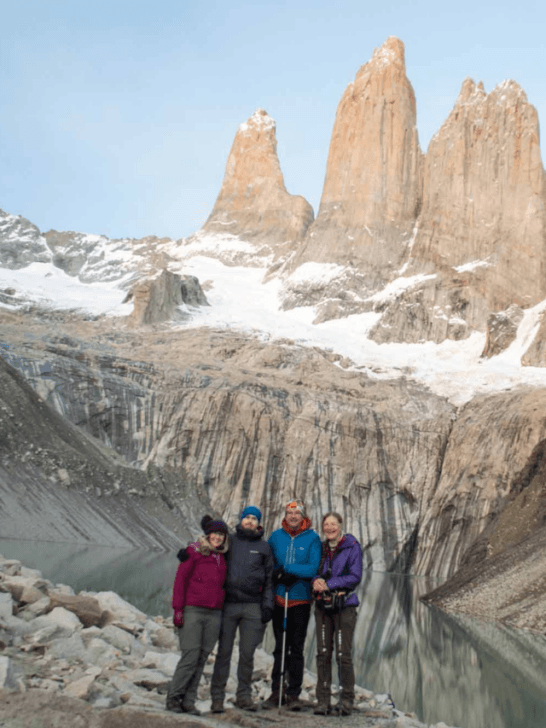
*If you can’t get a pitch at El Chileno, it is possible to hike from Torres Central/Norte ($25 USD camping pitch per person). Although you’re not officially supposed to hike from here up to the towers, you can: leave four hours ahead of sunrise.
Make sure you bring a headtorch for climbing in the dark (it will get lighter as you reach the more difficult stretch of hiking just below the towers), plus warm clothing (even including a sleeping bag) to use at the top and keep you cosy as you enjoy the sunrise.
Itinerary three: Torres del Paine W hike in five days (east to west route)
Why hike this route:
- Not only do you get to complete the W, it gives you time for a bonus extra hike to the Los Cuernos or Salto Grande viewpoints.
Want to know how to book the campsites mentioned in this itinerary? Head over to this comprehensive article about booking Torres del Paine camping or hostel accommodation .
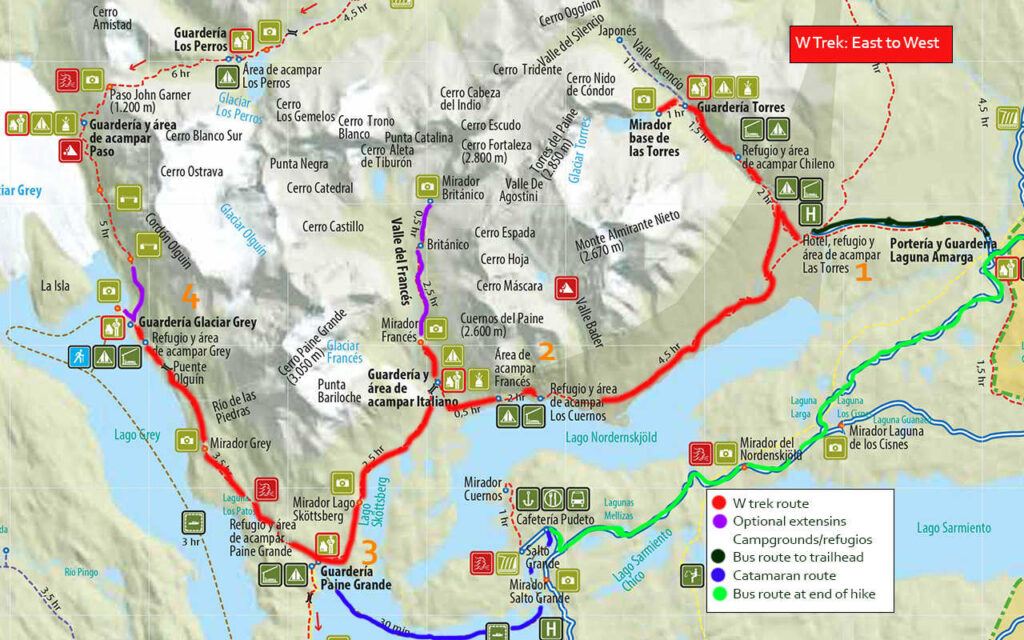
Day One: Puerto Natales to Mirador Las Torres & Torres Central/Norte
- Distance: 18.4 kilometers (11.4 miles)
- Duration: 6-7 hours hiking
6:45am Take a bus from Puerto Natales to Laguna Amarga. You can book tickets online with Bus Sur or go to the bus station in Puerto Natales the day before you start hiking and book with them or one of the other companies there.
8:45am Arrive at Laguna Amarga. Show your entrance ticket at the ranger’s station.
9:00am To get to the start of the W, you need to take a shuttle bus ($4,000 CLP ($6 USD) – you must pay in cash at the shuttle) to the Centro de Bienvenida (Welcome Centre).
Departures theoretically leave from Laguna Amarga at 9am, 3pm, 5pm and 8pm daily , and take about 30 mins. However, Las Torres (who run the shuttle service) have assured me that the shuttle bus awaits the arrival of the bus from Puerto Natales and will take all passengers that are waiting to board – sending for a second shuttle if there are more passengers than seats.
9.30am You’ll be staying overnight at the Torres Central/Norte campground, so check in and leave your big bags and take warm layers, food, and plenty of water for the hike up to the towers.
Start hiking up to the torres . It’s all uphill and it can be quite steep at points, but it’s worth the effort! All in all, you gain around 800m (2,620 feet).
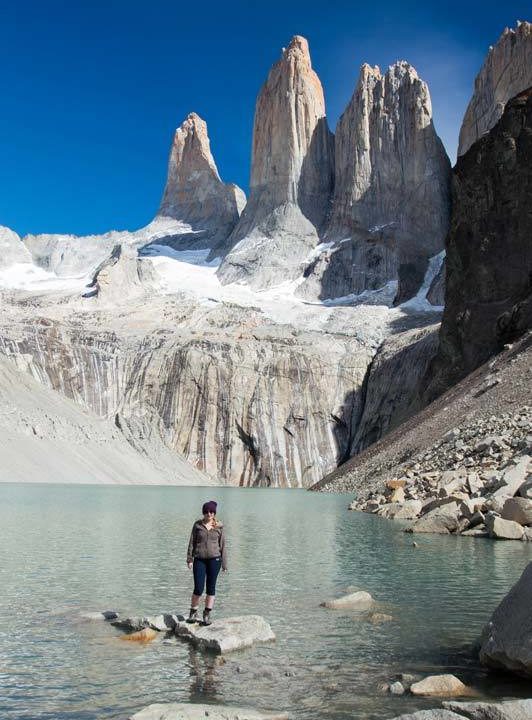
Take your time, drink plenty of water, and relax when you get to the top.
13:30pm Arrive at Mirador Las Torres and enjoy the views.
15.00pm Start hiking back to the campsite; you’re trekking back the way you came.
17.00pm Pitch your tent, have dinner, and relax!
Day Two: Torres Central/Norte to Francés
- Distance: 14.5 kilometers (9 miles)
- Duration: 5.5 hours hiking
9:00am Get up, have breakfast and pack up your tent.
10:00am You leave Torres Central heading west and reach Lago Nordernskjold. The trail meanders alongside the lake, gaining and losing altitude as it goes. The views are incredible but if it’s sunny, it will be hot!
15:30pm Reach Francés campground, where you’ll stay tonight. Pitch up and enjoy views across the lake. Bear in mind that check-in at Francés doesn’t start until 2.30pm and hot showers aren’t available until 5pm, so take your time on the hike.
Day Three: Francés to Mirador Británico & Paine Grande
- Distance: 14 kilometers (8.6 miles) from Francés to Mirador Británico and 7 kilometers (4.3 miles) from Guardería Italiano to Paine Grande
- Duration: 5.5 hours hiking from Francés to Mirador Británico and 2.5 hours from Guardería Italiano to Paine Grande
9:00am If the weather is good, today is going to be a long day as you climb up into the Francés Valley. Both times I’ve walked Torres del Paine W hike I’ve experienced dreadful weather in the Francés Valley.
From Francés, head west along the path beside the lake to reach Guardería Italiano, a rangers’ station and former (now defunct) campground. Here, you can drop your big rucksacks; just take warm clothing and food for the hike up to the Mirador Británico* (British Viewpoint). This part of the hike marks the central section of the W and it’s all uphill. After an hour’s steep gradient up a rocky, slippery trail to Mirador Francés, look for Glaciar Francés as it clings to the mountainside in the west.
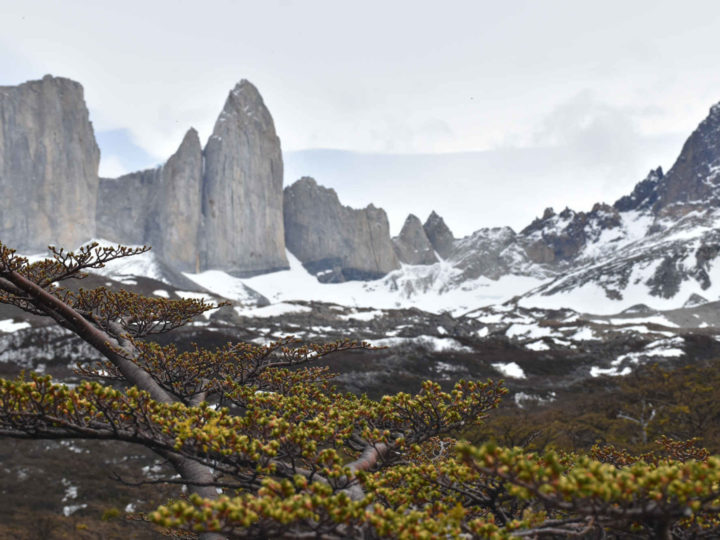
Luckily, the hike back is downhill to return to Guardería Italiano. Pick up your bags and take the new trail that begins just after the rangers’ station; take the lefthand fork that follows closer along the lake. It’s a little longer – 9 kilometers (5.6 miles) rather than 7 kilometers (4.3 miles) – and so takes around 30 minutes longer, but it has fewer hikers on it and is really pretty.
18:30pm Arrive at Paine Grande, pitch your tent and enjoy a hot shower!
*You’re only allowed to start hiking up to the viewpoint until midday, so don’t delay getting to the rangers’ station – although this rule isn’t always enforced!
Day Four: Paine Grande to Grey & Puerto Natales
- Distance: 11 kilometers (6.8 miles) plus six kilometers (3.7 miles) to reach rope bridges
- Duration: 4 hours hiking plus 1.5 hours to reach rope bridges
10:00am Take the trail heading north to Grey. It starts by going uphill but soon levels off and has great views of Lago Grey to keep your spirits up! It takes between three and four hours.
14:00pm Arrive at Grey, where you can leave your big bags. From the campsite, an additional one kilometre north through the forest brings you to two viewpoints lying over a kilometre from the glacier’s snout. From here, look out for enormous chunks of ice in the water.
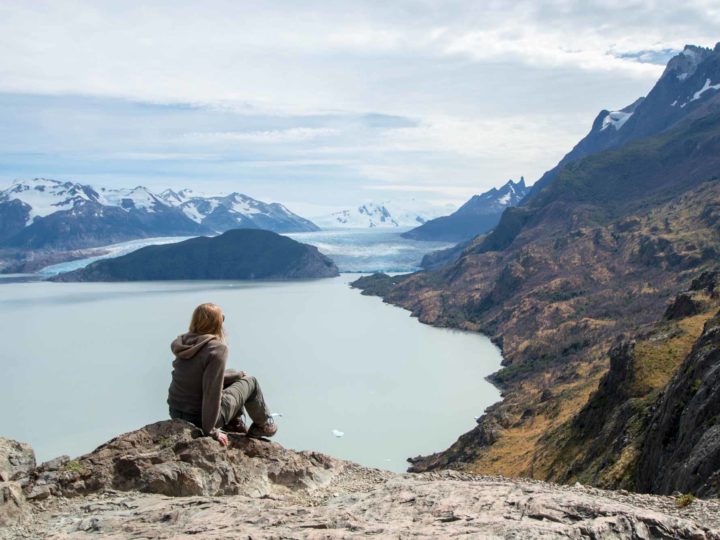
From here you get the best views of the glacier and, if you’re lucky and it’s a clear day, the Southern Patagonian Ice Field beyond. Return back to Grey.
16:00pm Arrive at Grey, pitch up and relax – you’ve almost finished the hike!
Day Five: Grey to Paine Grande and Puerto Natales
- Distance: 11 kilometers (6.8 miles) plus 2.3 kilometers (1.4 miles) to the Cuernos Viewpoint
- Duration: 4 hours hiking
7:00am Get up, pack up your tent, and have breakfast. Return to Paine Grande along the same path.
10:30am Join the queue for the ferry to Pudeto.
11:00am Take the ferry to Pudeto. This service is operated by Hielos Patagonicos ($25,000 ($30 USD) single, cash only). Tickets cannot be reserved in advance; you buy them at the ferry port.
11:30am Arrive at Pudeto. From here, you can either have lunch in the tiny cafeteria at the ferry dock or you can hike from Pudeto to the Cuernos Viewpoint, a 2.3-kilometer (1.4-mile) one-way hike from the ferry dock; it should take you around an hour each way and grants you incredible views west and east along the Paine Massif range.
A shorter option is the 600-meter (0.3-mile) trail to the Salto Grande Waterfall, which has stunning views of Los Cuernos behind it.,
2:30pm Take the bus from Pudeto back to Puerto Natales. You should arrive around 5.05pm.
Itinerary four: W trek in five days with sunrise at Mirador Las Torres (east to west route)
- You get to see the sunrise at Mirador Las Torres and hiking to it on your first day means your legs won’t be as tired.
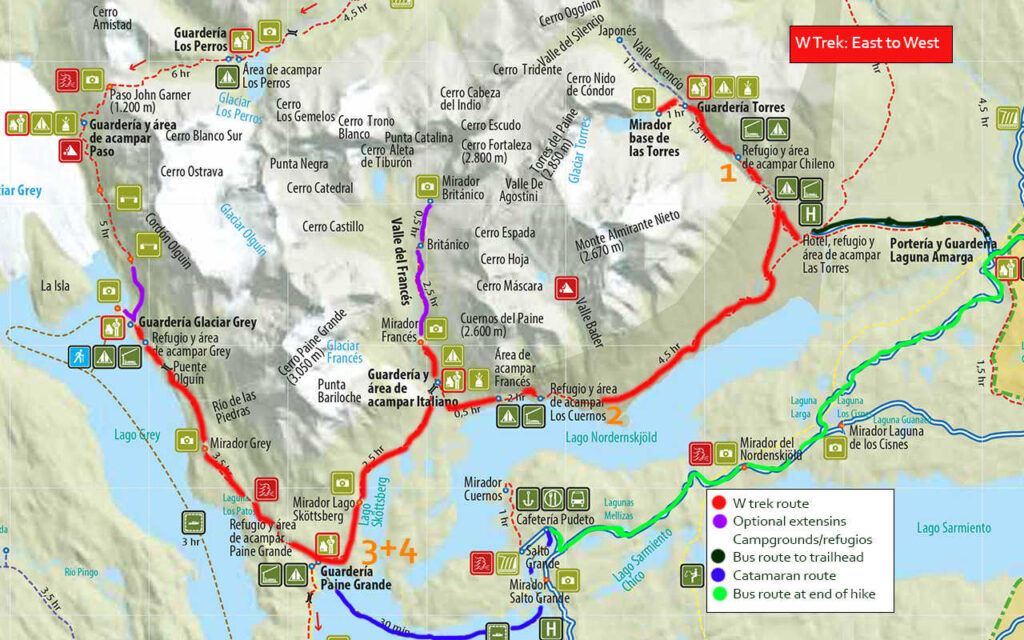
Day Zero: Puerto Natales to El Chileno
- Distance: 5 kilometers (3miles)
- Duration: 2 hours hiking
12:00pm Take a bus from Puerto Natales to Laguna Amarga.
2.00pm Arrive at Laguna Amarga. Show your entrance ticket at the ranger’s station.
2.30pm To get to the start of the W, you need to take the shuttle bus ($4,000 CLP ($6 USD) – you must pay in cash at the shuttle) to the Centro de Bienvenida (Welcome Centre).
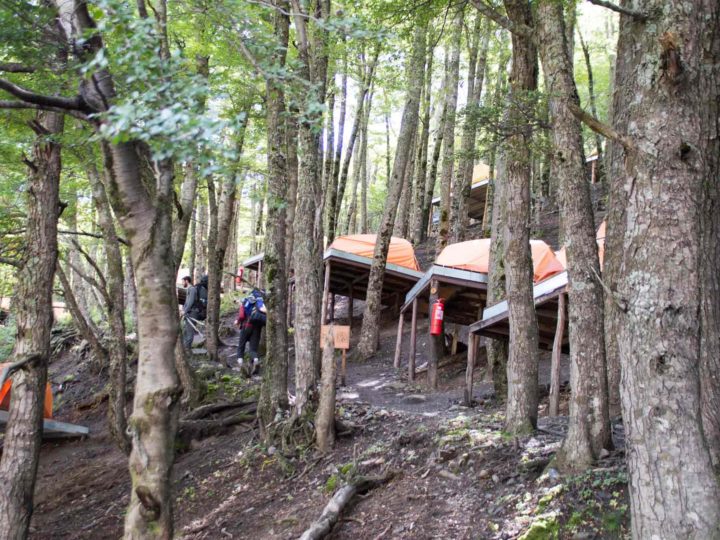
3pm Start hiking up to El Chileno, the closest campground to Mirador Las Torres, the famed viewpoint of the towers. This is the smallest campground, so sells out fast.
If you can’t get a spot here, you’ll need to camp at Torres Norte/Central and hike four hours tomorrow to reach the viewpoint.
5pm Arrive at El Chileno. Set up your tent, have dinner and relax.
Day One: El Chileno to Mirador Las Torres and then Los Cuernos
- Distance: 19.4 kilometers (12 miles)
- Duration: 6.5 hours hiking
4:30am Wake up and take a small bag (including warm clothes, a sleeping bag, and a snack) to see the torres at dawn. Don’t forget your torch as the route is over rocks and can be treacherous.
8:00am Leave the mirador and return to the campsite. Pack up, have breakfast start the walk down. When the trail splits, you’ll need to take the righthand path that goes alongside Lago Nordenskjöld.
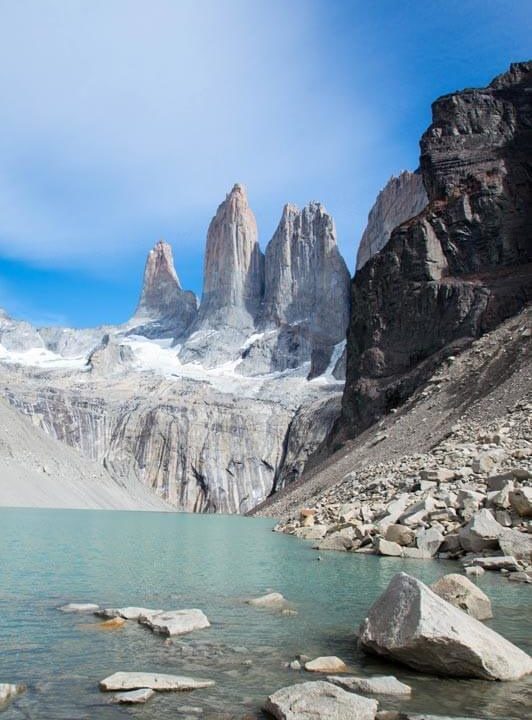
This trek meanders alongside the lake, gaining and losing altitude as it goes. The views are incredible but if it’s sunny, it will be hot!
3:00pm Arrive at Los Cuernos*, pitch up and relax.
*If there is no availability at Los Cuernos, when you go to make your refugio or campsite reservations , you can instead book to stay at Francés, which is a further 3.5 kilometers (one hour) beyond Los Cuernos.
Day Two: Los Cuernos to Paine Grande
- Distance: 17.5 kilometers (10.8 miles) from Los Cuernos to Mirador Británico and 7 kilometers (4.3 miles) from Guardería Italiano to Paine Grande
- Duration: 6.5 hours hiking from Francés to Mirador Británico and 2.5 hours from Guardería Italiano to Paine Grande
7:00am Get up, have breakfast and pack up your tent.
8:00am Today begins with the path alongside Lake Nordernskjold to Guardería Italiano. You can leave your bags here with the ranger before hiking up into the Francés Valley to Mirador Británico*.
10:30am The hike up the Francés Valley may be long or painfully short – all depending on the weather. Both times I’ve walked Torres del Paine W hike I’ve experienced dreadful weather in the Francés Valley.
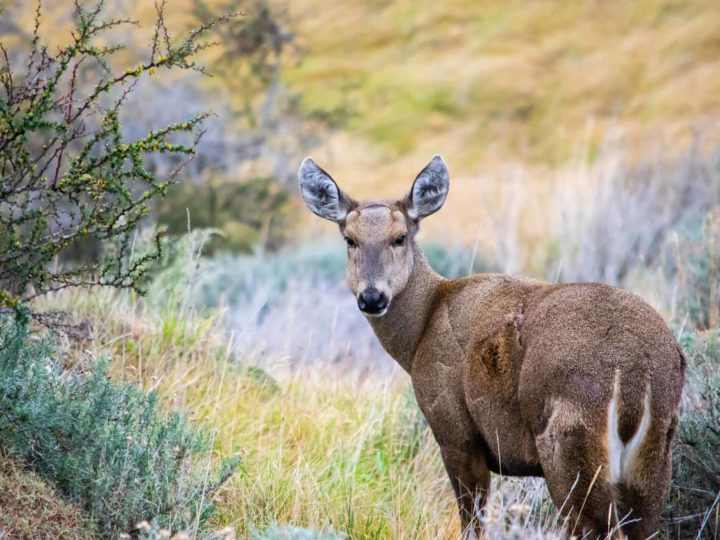
Luckily, the hike back is downhill to return to Campamento Italiano. From there, pick up your rucksack and hike the two remaining hours to reach Paine Grande.
Note that there’s a new trail that begins just after Campamento Italiano; take the lefthand fork that follows closer along the lake. It’s a little longer – 9 km (5.6 miles) rather than 7 km (4.3 miles) – and so takes around 30 minutes longer, but it has fewer hikers on it and is really pretty.
17:00pm-18:00pm Arrive at Paine Grande, pitch up and enjoy the views across the lake.
Day Three: Paine Grande to Grey and back to Paine Grande
9:00am Hike from Paine Grande to Grey; you can leave everything in your tent, except the items you need for today. The trail starts to go uphill but soon levels off and has great views of Lago Grey to keep your spirits up!
13:00pm Arrive at Grey. From the campsite, an additional one kilometre north through the forest brings you to two viewpoints lying over a kilometre from the glacier’s snout. From here, look out for enormous chunks of ice in the water.
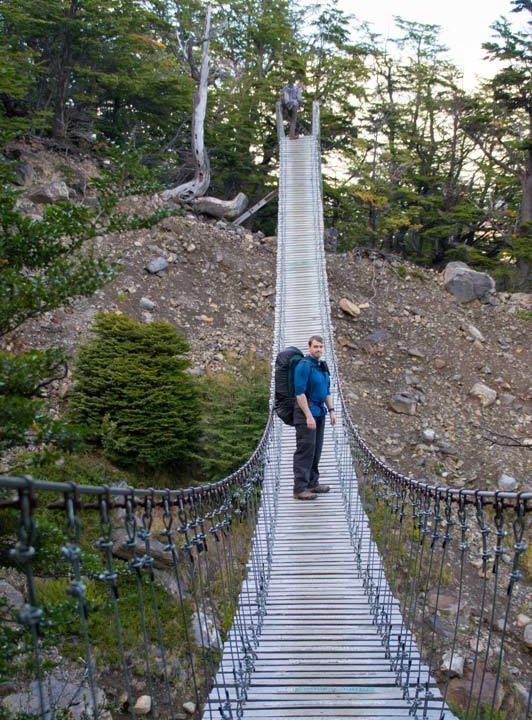
15:00pm Return to Grey along the same path and back to Paine Grande.
19:00pm Arrive at the campground, relax, have dinner and enjoy the feeling of finishing the trek!
Day Four: Paine Grande to Puerto Natales
- Distance: N/A
- Duration: N/A
9.00am Join the queue for the ferry to Pudeto.
9:30am Take the ferry to Pudeto. This service is operated by Hielos Patagonicos ($25,000 ($30 USD) single, cash only). Tickets cannot be reserved in advance; you buy them at the ferry port.
10:00am Arrive at Pudeto.
10.30am Take the bus from Pudeto to Puerto Natales and celebrate your successful completion of the W!
Top tips for hiking the Torres del Paine W Trek self-guided
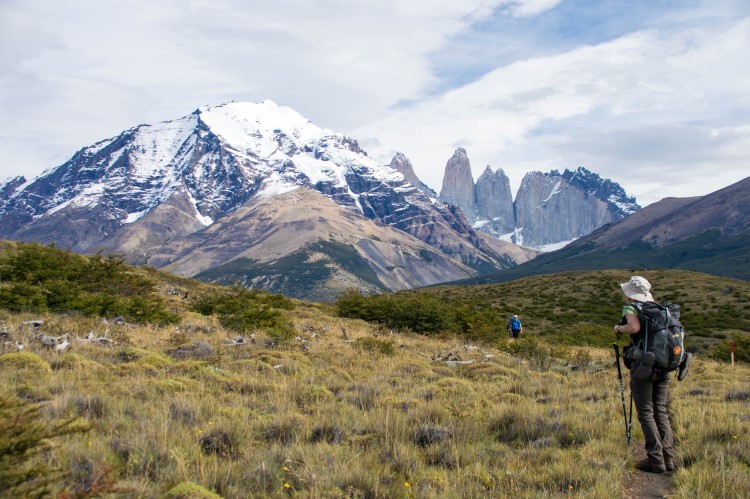
Having now been hiking in Torres del Paine National Park twice, I’ve learned a few important tips that have kept me happy, sane and comfortable en route :
Top equipment tips
- Camping in Torres del Paine at Francés, Los Cuernos, and El Chileno is on wooden platforms. If you plan to stay at any of these campsites, you will need extra cord or string to help you attach your tent without using pegs.
- Bring a range of warm and wet weather clothing. Check out my packing list for hiking the Circuit in Torres del Paine for the full guide to the clothing that I packed for the trip (and which is also a good guide to what to pack for the W). It also includes a free, downloadable checklist.
- Bring a book or some cards for the evenings as you tend to finish hiking quite early and if it’s cold and wet, you’ll want to retire to the shelters with something to do.
- Having a lightweight tent really does make a difference camping on this trek. Have a look at my review of the Big Agnes HVUL2 , the really lightweight backpacking tent that we used for the O Circuit.
- If you’re carrying all of your own equipment, a 60-litre rucksack should be big enough.
- Pack all of your clothes into dry bags (better than a bin bag which can easily rip). The weather changes rapidly and on days when it’s pissing it down, you’ll welcome the fact that your sleeping bag and clothes are dry. I recommend the Sea to Summit dry bags (buy them on REI | Amazon ).
- Bring a rucksack cover. I’ve heard mixed advice on this one, but a rucksack cover kept our bags dry (and so lighter) when we were hiking in Torres del Paine National Park and no, they didn’t blow away in the wind. If your rucksack doesn’t come with its own, you can find them in various sizes on | Osprey | Amazon (make sure it’s the correct size for your bag – otherwise it will blow away!).
Top food tips
- There is a much wider (and cheaper) selection of food in the supermarkets in Punta Arenas than in the one Unimarc supermarket in Puerto Natales. I recommend doing your food shop there before you take the bus to Puerto Natales. We left the stuff we didn’t need in our hostel in Punta Arenas.
- You can also buy trekking food and bring it with you , but it’s heavier and far more expensive than organising your food when you get to Puerto Natales.
- Pack everything into zip-lock plastic bags and bin all the original packaging that you can to save on carrying any extra weight. Also, don’t bring the full pack of rice if you’re only going to eat half of it – every bit of weight counts!
- You can buy basic staples (pasta, biscuits, tomato puree etc.) from the shops at Paine Grande, Grey, Francés and El Chileno to stock up on supplies. It’s pretty expensive, but totally worth it. They also all stock beer – an additional expense that I didn’t include in the costings for the W trek!
- You don’t need to bring water with you as it’s available from all the glacier meltwater streams that you’ll run into along the W and is drinkable from the taps at each of the campsites. If you’re nervous about drinking the water, you can also bring a Steripen (read my review of the Steripen Adventurer or buy one from Amazon or buy a newer Steripen UV Ultra from REI ) to zap anything that might be nasty or a Grayl ( REI | Backcountry | Amazon ) – find out why I recommend these water filters for South American travel .
- My dad is a pro at packing food for multi-day treks. Read what food we took with us for the O Circuit (and which you can use as a guide for the W too).
- You will need Chilean pesos on you for the park as nowhere accepts cards. You’ll need $25,000 CLP ($35 USD) for the catamaran ferry and then extras for additional food, beer, and anything else you want to buy.
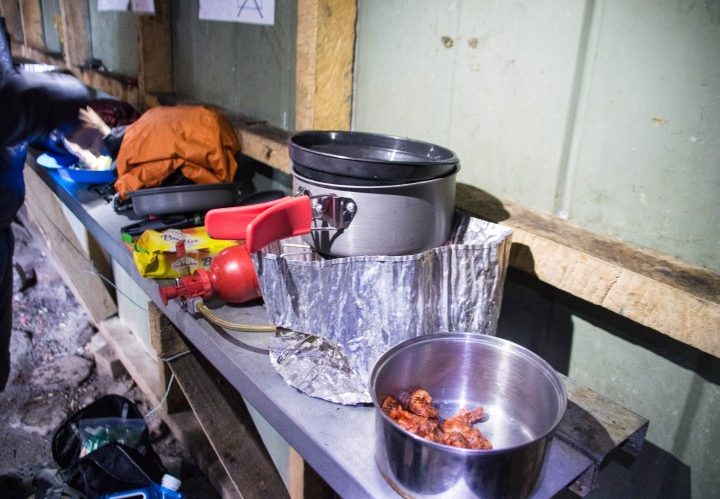
Camping in Torres del Paine
The following summarises some of the main points about booking campsites and refugios in Torres del Paine for the W trek, but you can get a full overview of how to book campsites in Torres del Paine with this article updated for the 2023/2024 season.
Reservations with Las Torres and Vertice Patagonia
You will need to book your campsites in Torres del Paine in advance. For example, in August 2022, many of the campsites and refugios were fully booked for December through February 2023, which just shows how far in advance it gets booked up.
Before you start panicking, what happens each year is that reservations free up again in September/October, probably due to the fact that tour agencies in Puerto Natales make mass reservations for the high season, and then cancel them when they don’t fill the bookings.
If you need anything planned well in advance, then this isn’t going to suit your plans. If your plans are a little more open and you can wait until closer until the time (and keep checking back to see if any spots have opened up), then you should still be able to hike the W during these months.
My recommendation would be to hike outside of these months anyway (November or March) to avoid the crowds as much as possible, but either way, you still MUST SECURE YOUR RESERVATIONS with Las Torres (Francés, Los Cuernos, El Chileno) and Vertice Patagonia (Paine Grande and Grey).
If you’re trying to get a space last-minute, you can always pop into either of their offices in Puerto Natales and see if they can book you in. I’ve heard of people having success with this with only a day or two’s notice.
Reservations with CONAF
For the 2023/2024 season, and for the foreseeable future, all of the CONAF campsites remain closed.
Upgrade your solo Torres del Paine W trek, Patagonia with these changes
If you’re not so bothered about hiking the W in Torres del Paine National Park on a complete budget, consider making the following small tweaks to your itinerary.
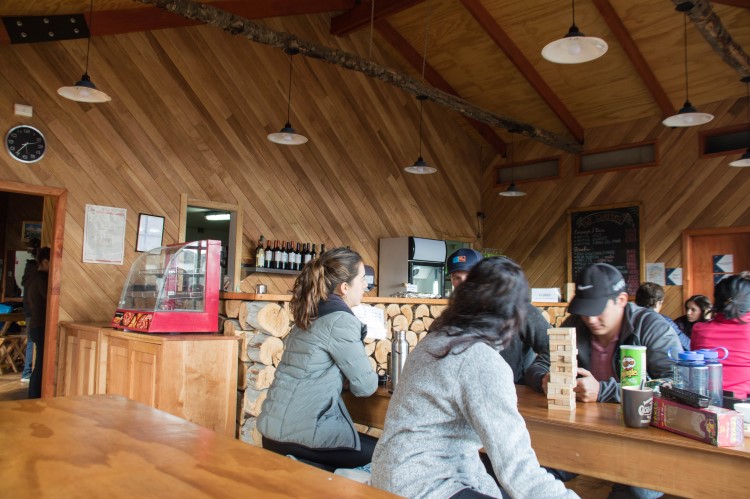
Stay overnight at Los Cuernos ($80,000 CLP ($88 USD) per person full board) instead of Francés
Again, this is only really possible if you stay overnight on Day Two in Paine Grande. When we hiked the Full Circuit, we decided to treat ourselves to an all-inclusive night at Los Cuernos.
This meant we still pitched our own tent on a wooden platform, but we had a three-course dinner, breakfast, and packed lunch for the next morning, which reduced the amount we had to pack in our rucksacks for the hike.
The food from Las Torres (previously known as Fantastico Sur) is much better than Vertigo Patagonia too, so I would recommend this instead of eating in the big canteen at Paine Grande.
Los Cuernos now offers camping sites without full board (previously you had to pay for full board at this campsite).
This means that for $25 USD per person you can pitch up your own tent here. They also offer half-board options priced at $62 USD per person, which include dinner and breakfast.
Book full board and a tent or bed at each campsite
You can rent gear and get food at all campgrounds, so if you don’t want to carry anything, then you can also book this way!
Bear in mind that full board at Los Cuernos comes in at $158 USD per person for a fully-equipped tent and full board – so it certainly won’t come cheap!
Did you find this guide to the Torres del Paine W hike useful? Pin it!
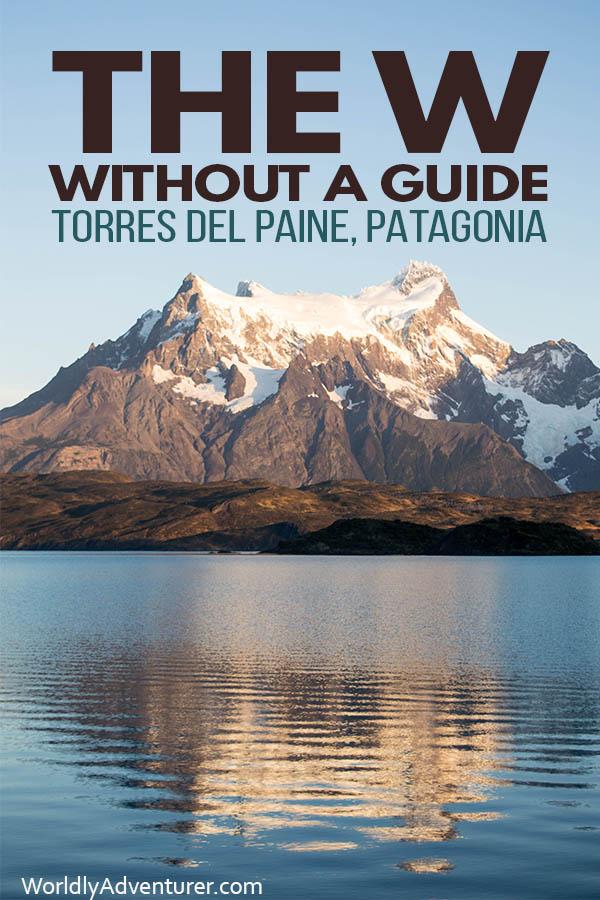
Helen Turner
Sunday 4th of February 2024
Excellent article. Plenty of food for thought. Thankyou
Steph Dyson
Friday 9th of February 2024
Thanks Helen! Steph
Sunday 26th of November 2023
We were hoping to hike to Refugio Grey, then take the Navigation boat toward Hotel Grey, then take a shuttle to our car at Pudeto. But I'm not sure how the timing works out. If we take the 14:00 navigation from Refugio Grey, is there time to make the last shuttle from Hotel Grey?
Tuesday 28th of November 2023
Hi Karen, I'm not sure. You would need to go off the timings on the Hotel Grey website or reach out to them directly. Steph
Jonny Collins
Tuesday 24th of October 2023
Thank you for your brilliant blog posts on all things South America - they're perfect for someone like me that loves knowing the logistics of our upcoming trips! My wife and I were meant to visit Patagonia for the first time in 2020 as part of a wider trip that was cut short due to COVID - we read your blog posts at the time whilst planning. We're finally planning to visit in 2024!
Unfortunately due to work commitments we are not able to take more than two weeks off and it is making our itinerary from the UK quite tight (we want to get to El Calafete and El Chalten in the same trip).
Whilst I appreciate you recommend doing the W Trek in 4 or 5 days, we are considering doing it in 3 days (we are experienced hikers and have done multi day hikes before). We had always planned hiking West to East. For the most even split on distance it seems that staying at Paine Grande and Los Cuernos would work best. We're really keen to see the towers at sunrise but appreciate that staying at Paine Grande and Torre Norte to do this would result in a very big second day. We have thought of two alternatives:
Option 1 (West to East): Night 1: Campo Italiano Night 2: Torre Norte
Option 2 (East to West): Night 1: Refugio Chileno Night 2: Campo Italiano
We've not considered yet if these options work with bus and ferry timetables. Do you think either of the above options are feasible to do the hike in 3 days and get to see the towers at sunrise? If not is there an alternative that might work, or if we do the trek in 3 days do we need to accept that we would not be able to see the towers at sunrise?
Any advice on the 'best' way to do the W trek in 3 days would be much appreciated. Apologies if anyone has asked this before! Thanks in advance :)
Sunday 28th of January 2024
Hi Steph, Thank you for your reply. In the end we decided to find an extra day from elsewhere in the trip so that we could do the W Trek and not miss out on anything! Thanks again for your help and for keeping this brilliant blog post up to date!
Thursday 23rd of November 2023
Hi Jonny, Italiano isn't open any more unfortunately. I would recommend just doing day hikes rather than the W. That way, you can actually enjoy your day hikes and not worrying about trying to cover the ground quickly. Steph
Tuesday 10th of October 2023
Great post, thank you! A group of five of us is heading to TDP to do the W-trek in January 2024. Very excited! We're flying from Santiago (SCL); is Puerto Natales a great option to fly into? I heard the drive to TDP from P. Natales is shorter than when coming from P. Arenas? It seems SKY airline has some flights during our time frame. Any great spot to hang out or visit at in P. Natales?
Hi LuAnn, yes you can fly directly into Puerto Natales. Steph
Wednesday 22nd of March 2023
Hi Steph! Can you please provide link where it is stated that a guide is required for hiking in May in Torres del Paine? I had not come across this requirement yet. Thank you!
Thursday 23rd of March 2023
Hi Megan, it's something I was told in a conversation with CONAF, the national parks office. You can reach out to them https://www.conaf.cl/parques/parque-nacional-torres-del-paine/ Steph
- National Turists
- Our Campings
- Our Mountain Hostels
- Torres del Paine
W Classic Circuit
Welcome to the most famous trekking in torres del paine, accommodation options.
- Mountain Hostel
- Mix Hotel Las Torres / Mountain Hostel
Portada » Circuitos de Trekking » W Classic Circuit
One of the best hikes in the world
The W Circuit will make you to fall in love with Chile’s Patagonia. The pictures speak for themselves but could never do justice to the sights, feelings, excitement and pure awe that you will experience while hiking the W Circuit. Hiking through unbelievably big mountains, deep valleys, and dense, mysterious forests will leave you grateful for life and the exact moment you’re living.
The W Circuit is the most popular hike in Torres del Paine National Park for a reason – it’s stocked with all the highlights including Las Torres Base Viewpoint, Los Cuernos Mountains, Francés Valley, Paine Grande and Grey Glacier .
You can choose your adventure style, from camping immersed in nature to full room and board in shared mountain hostels or private hotel rooms. While still remaining a physically and mentally demanding experience, the W Circuit offers luxuries like comfy beds, hot showers, warm, hearty meals, and stock-up points along the way.
The W Circuit gets its name from the way it starts at one end of the Park, winds up and back down two spectacular mountain valleys, and then comes to a close at the other end, forming a W from a bird’s eye view.
The 5 day/4 night W Circuit option gives you the first day to relax and thoroughly explore the numerous sights of the Las Torres sector.
What will you see?
Amongst the most famous mountains in the world, these three towering, granite peaks soar in the blue sky at 2850m / 9350ft, 2800m / 9200ft, and 2600m / 8500ft. Molded by pure glacial force, these are the breath-taking towers that give the Park its name.
Los Cuernos
These three mountains put up a fight with the Las Torres Mountains over prettiest in the Park. Standing at 2600m / 8500ft, 2400m / 7900ft and 2200m / 7200ft, the different types of rocks that make up this massif create a stark, beautiful, and multi-colored contrast. A 700m / 3000ft wide slab of granite crosses the middle of these uniquely shaped mountains.
Francés Valley
This lookout in the middle of the W Circuit boasts unmatchable views. To the west, you can gaze at the Cuernos, Espada, Hoja and Máscara mountains. To the east, the Francés Glacier overhangs Mount Paine Grande. To the north, the jagged Fortaleza and Aleta de Tiburón (shark’s fin) peaks stand out against the sky. As if that wasn’t enough, the valley is immersed in a Nothofagus forest filled with many species of trees and vegetation that produce a variety of flowers and change colors during autumn.
Paine Grande
Made up of four summits, Paine Grande is recognized as one of the most beautiful mountains in the world. The highest peak towers at 3050m / 10000ft, making it the tallest mountain in the Macizo Paine Range and also the technically hardest mountain to climb in the entire Torres del Paine National Park.
Glaciar Grey
This is the largest glacier in Torres del Paine National Park, measuring 6km / 4mi wide, 30m / 100ft tall and 19km / 12mi long. Its floating icebergs and glacial moraines are just as picturesque as the glacier itself, which tumbles down from the massive Southern Ice Field. To see this gorgeous ice formation up close, you can take a boat ride, a kayak tour or an ice-hiking excurision.
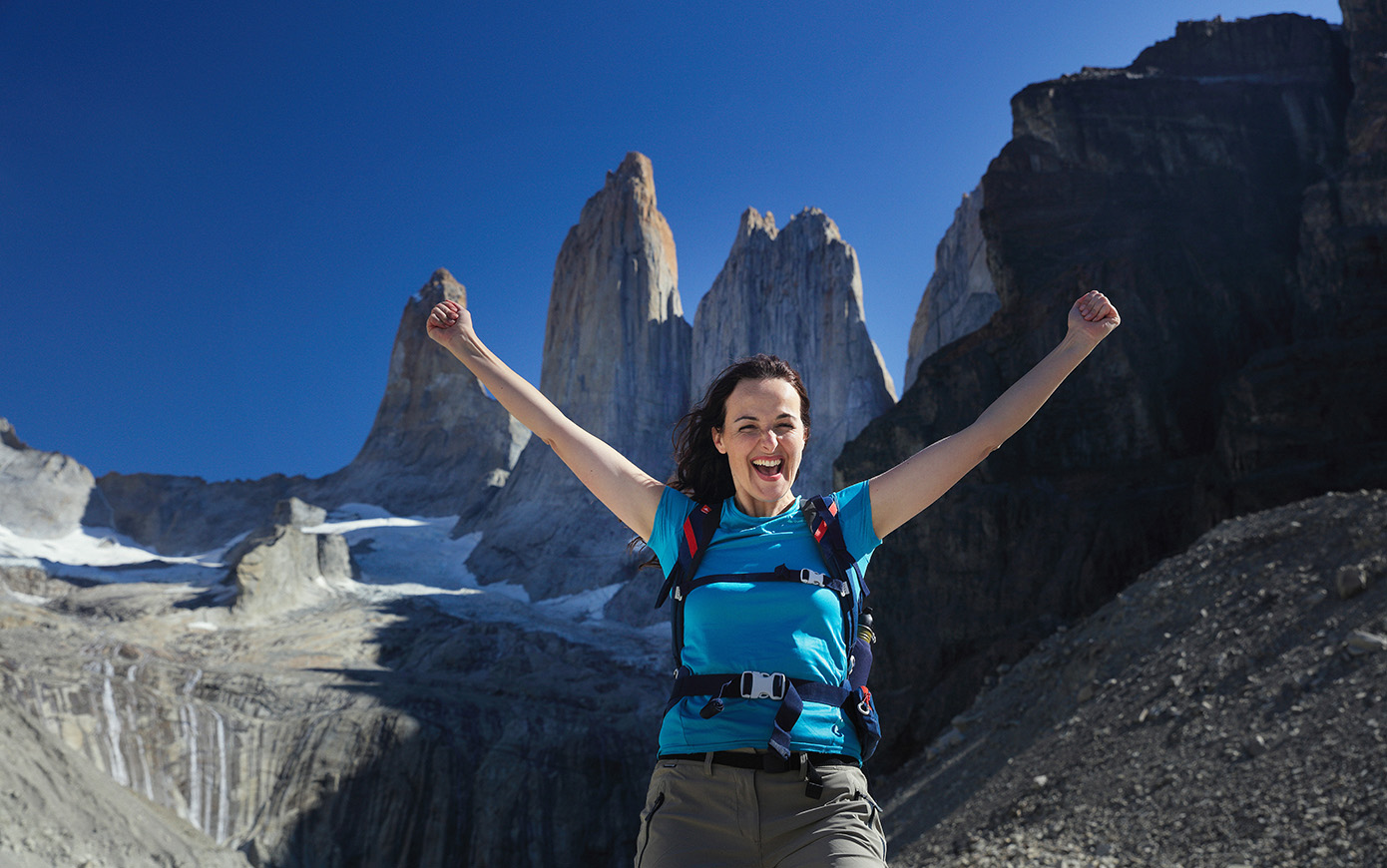
How is the Circuit?
5 days/ 4 nights. The most popular circuit in Torres del Paine will surprise you with the Torres Base Viewpoint, Los Cuernos, Valle del Francés, Paine Grande and the Gray Glacier. Options: independent self-guided, group self-guided or private guide.
What does it include?
- Premium Camping - Fully Equipped
- RESERVATION AND CANCELLATION POLICY
Premium Camping - Fully Equipped Experience
Day 1: Transportation from Puerto Natales to Torres del Paine, lodging at Central Sector. Day 2: Hike to Las Torres Base, lodging at Central Sector. Day 3: Hiking to Francés Sector (o Cuernos), lodging Francés Sector (o Cuernos). Day 4: Hike to the Francés Valley, lodging at Paine Grande Sector. Day 5: Hike to Grey Glaciar Lookout Point, then cross Pehoe Lake in catamaran and take transport back to Puerto Natales.
Based on double occupancy – 2 people, 1 tent:
- USD $ 1,180 p/p
Single Suplement:
- The published rates and dates are valid from October 2023 until April 2024.
- If you would like this option with a group, please book through the form at the bottom of this page.
- During Christmas Eve and New Years Eve an extra of USD $40 is charged per dinner.
- Food service is limited in capacity
- If you wish to book this program with a private guide, complete the form at the bottom of this page.
- Lake Pehoé catamaran may be subject to changes, which could include modifications in the itinerary, in that case we will help you find the best alternative
- 1 5 day Epic Trekking Circuit
- 2 4 nights in Fully Equipped Camping (Tent, sleeping bag, and sleeping mat)
- 3 All Meals
- 4 Transport to and from Puerto Natales to Torres del Paine National Park
- 5 Catamaran from Paine Grande
- 6 Park Entrance Fee
- 7 A hike of a lifetime
Mountain Hostel Experience
Day 1: Transportation from Puerto Natales to Torres del Paine, lodging at Central Sector. Day 2: Hike to Las Torres Base, lodging at Central Sector. Day 3: Hiking to Francés Sector (o Cuernos), lodging Francés Sector (o Cuernos). Day 4: Hike to the Francés Valley, lodging at Paine Grande Sector. Day 5: Hike to Grey Glaciar Lookout Point, then cross the Pehoe Lake in catamaran and take transport back to Puerto Natales.
Prices are per person based on 6 people per shared room:
- USD $ 1,490 p/p
- The published rates and dates are valid from October 2023 until april 2024.
- 2 4 nights in Mountain Hostel
- Prices valid until April 2024.
- Prices in USD are for foreign tourists only.
- If you would like to read our Reservation and Cancelation Policy please click here .
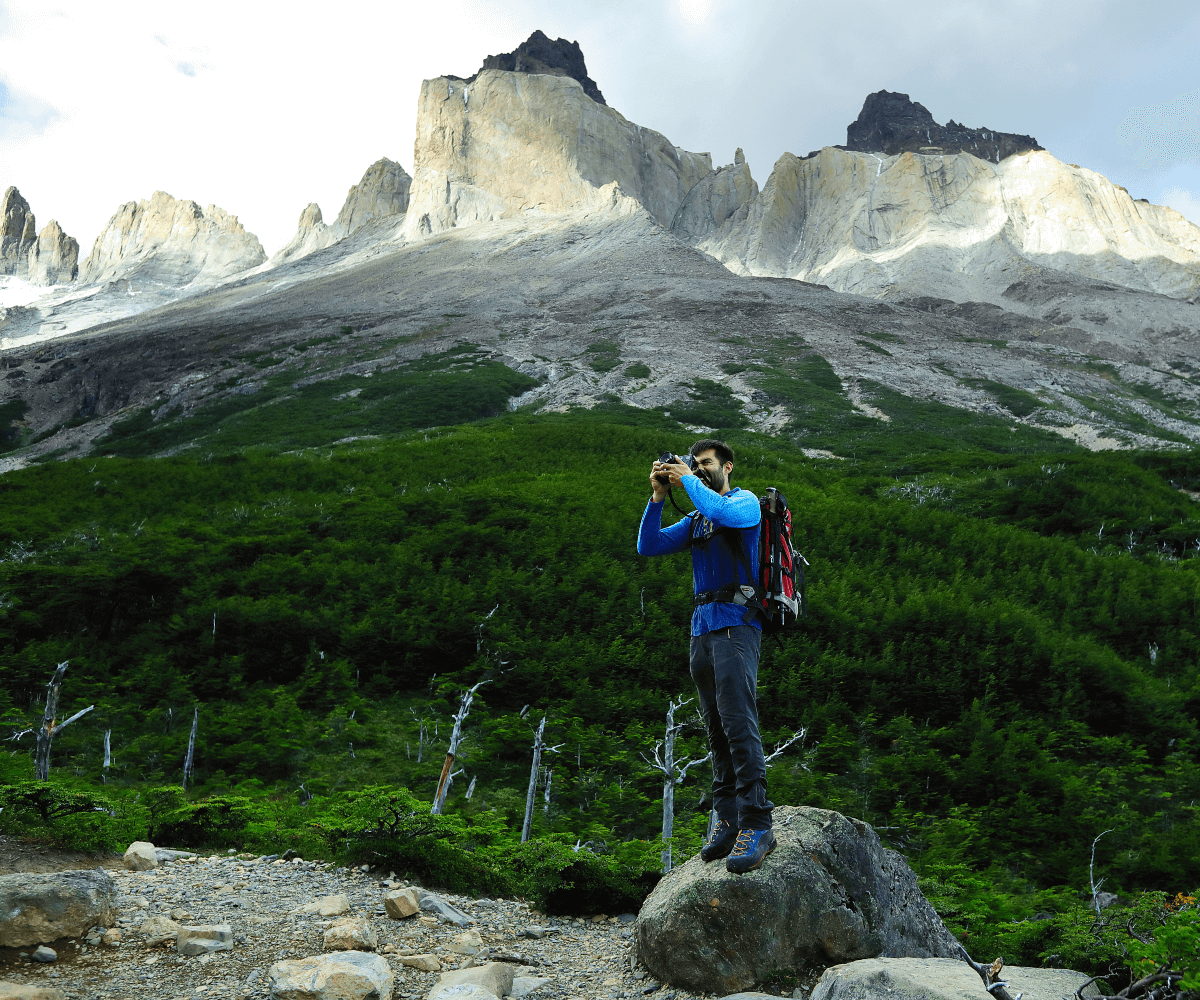
Make an inquiry or a Reservation Here
Other circuits you might be interested in, las torres base circuit 3d/2n from $750 usd, w circuit express from usd $945.
Las Torres Patagonia

Gracias por contactarte con Reserva Las Torres Patagonia

The ultimate guide to the Torres del Paine W Trek in Chile
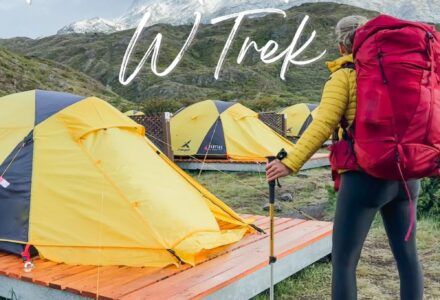
The W Trek in Chile is one of the hardest things I’ve ever done. And that’s coming from someone who thought it would be a good idea to cycle across the entire country of Jordan.
Now that we’ve got that out of the way, let me tell you why hiking in Torres del Paine National Park is also one of the most rewarding travel experiences I’ve had.
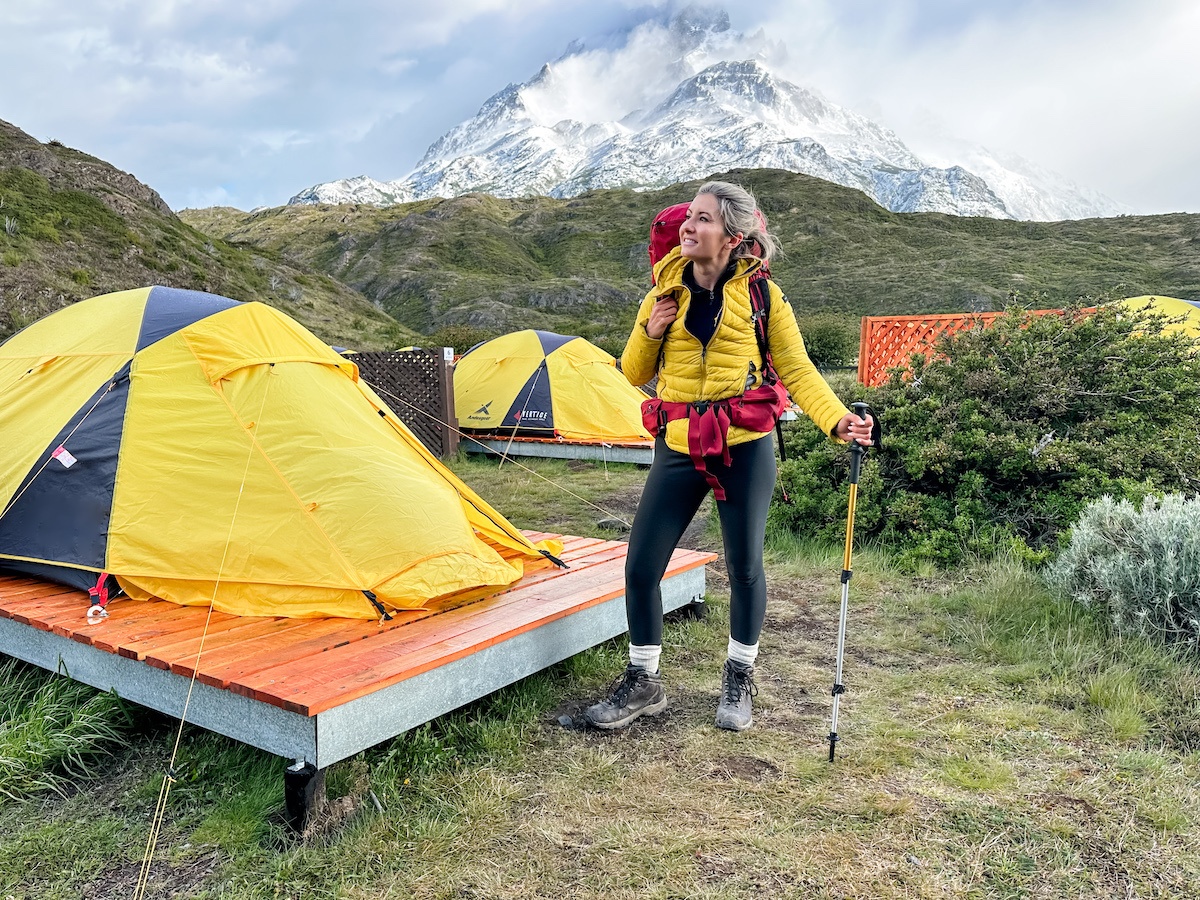
It’s rare to find an adventure that pushes your physical limits every single day, has you cursing under your breath more times than you can count as you face yet another sloshy water crossing or steep incline with a fully loaded pack on your back, and leaves you with aches, sore muscles and a few bruises on account of the inevitable stumbles over rogue rocks.
Yet, at the end of this multi-day grind, the feeling of accomplishment is unmatched. You just trekked through freaking Patagonia, one of the most remote and picturesque places on the planet!
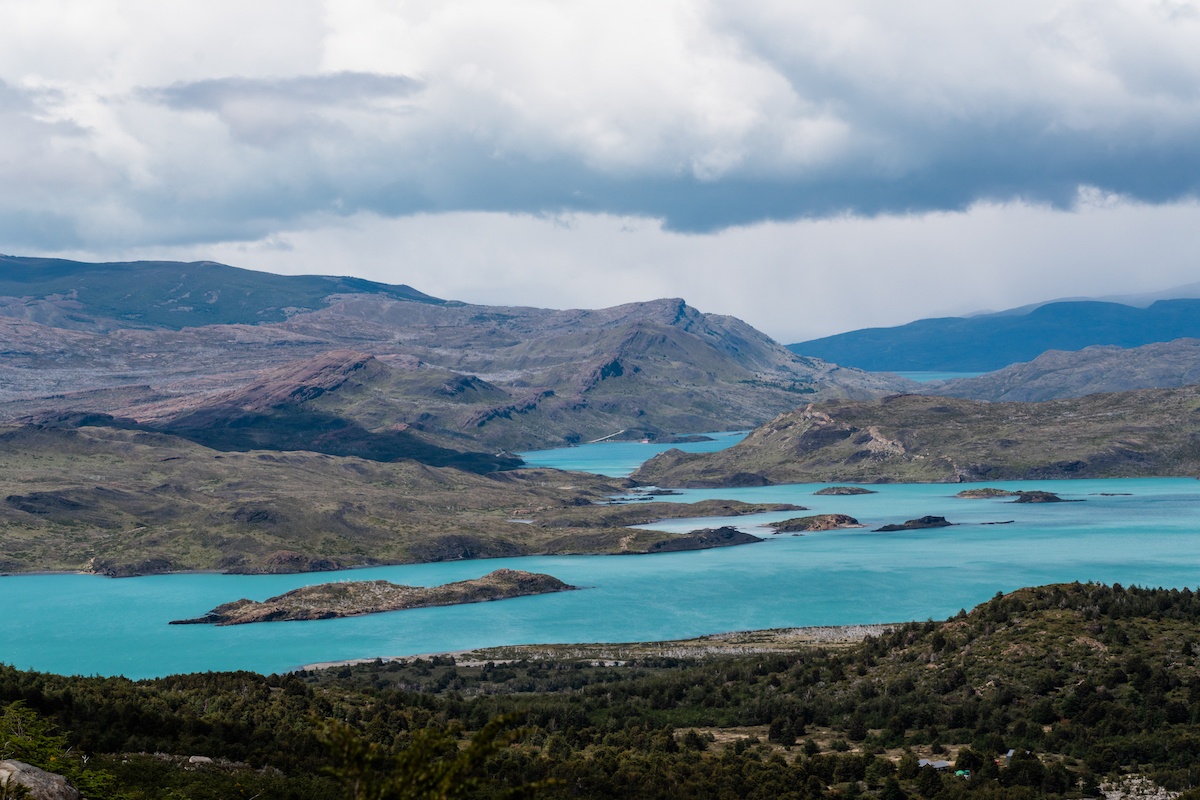
The scenery is stunning, the logistics and conditions are challenging, and your body is pushed to exhaustion with very little rest time.
Not only will you learn how capable your mind and body really are, but there’s the added bonus of not feeling guilty at all when indulging in a slice of chocolate cake and glass of Carmenere at a refugio at the end of each day. Because my god will you ever burn a lot of calories.
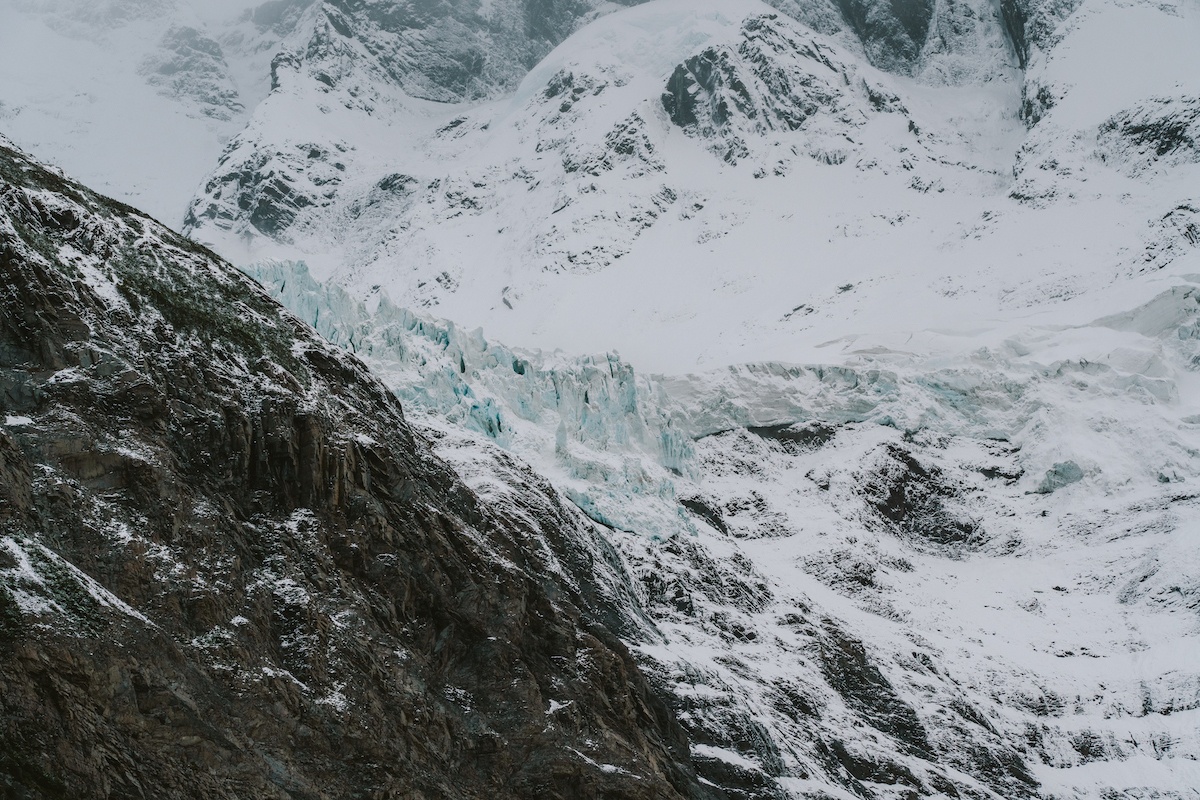
Is this trip for everyone? No.
Is it epic and unforgettable? Absolutely.
Here’s everything you need to know if you’re thinking about tackling the Torres del Paine W Trek in Chile.
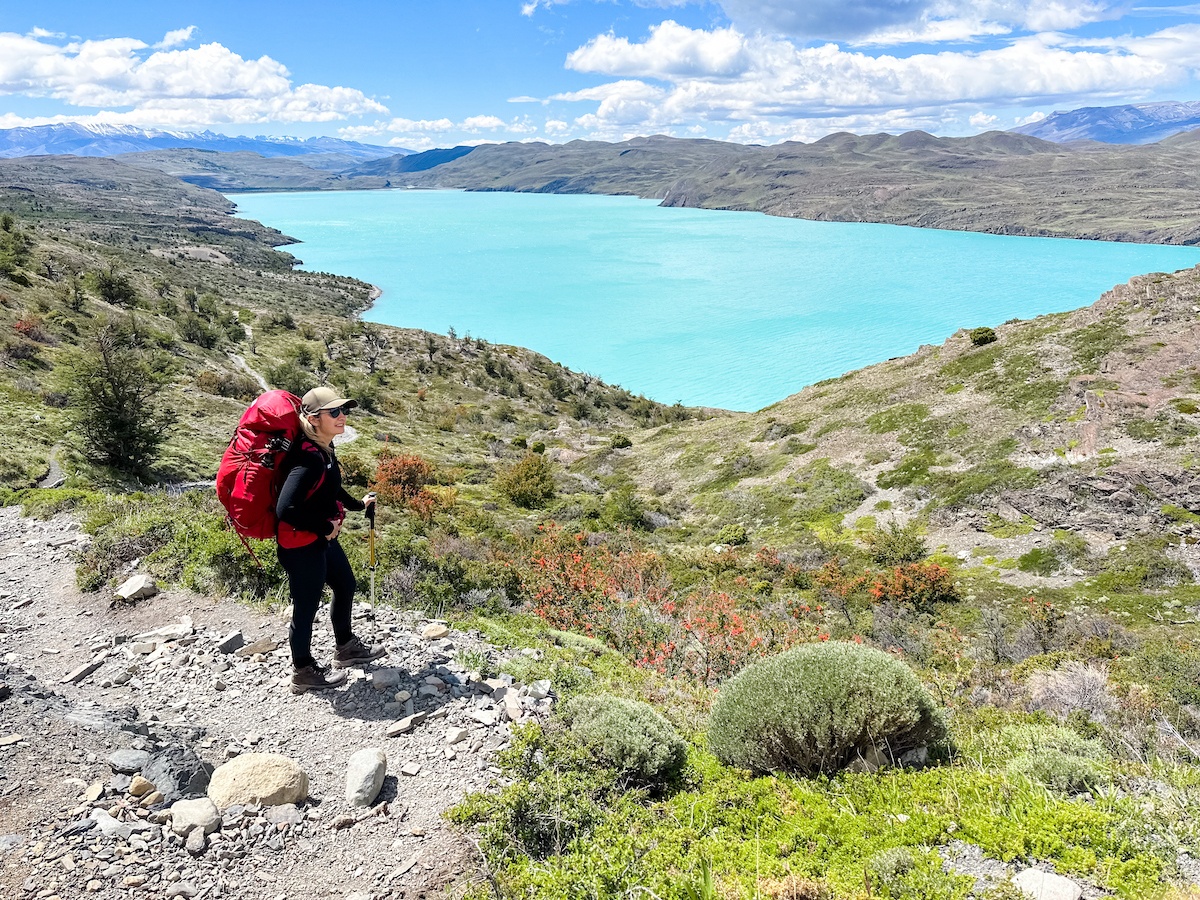
The Patagonia W Trek route
The W Trek takes four days to complete, and while its exact length seems to change depending on who you ask or which map you look at, the general consensus is that the trail is about 64 kilometers (40 miles) long.
Expect anywhere from six to 12 hours of hiking each day, more than 100,000 steps (my Apple Watch logged 125,458 to be exact) and of course countless photo-ops.
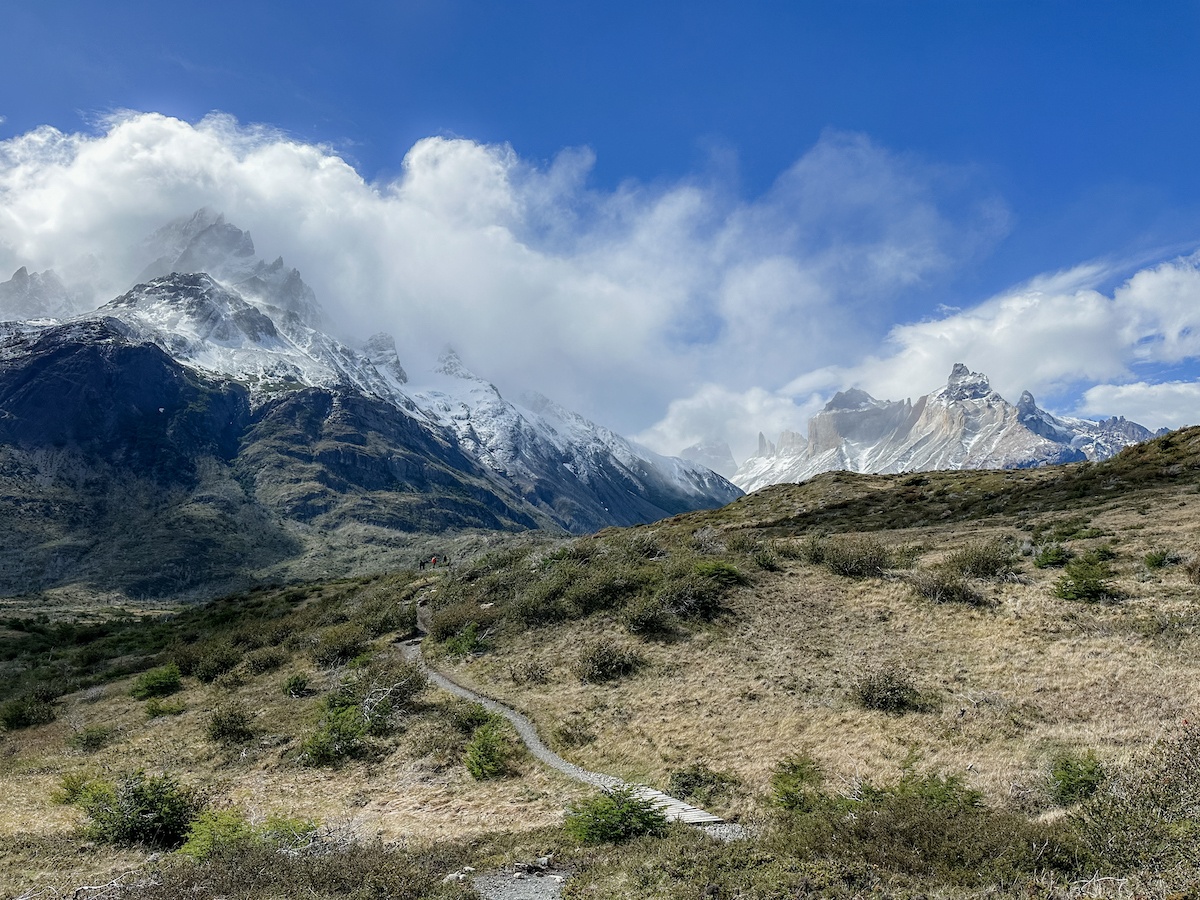
This is the most popular way to hike Patagonia, and those who are up for even more of a challenge can continue along the O Circuit which takes about nine days to complete the 122 kilometer, counter-clockwise loop.
This W Trek map outlines the exact route:
The W Trek in Torres del Paine can be done in either direction, starting from either the Torres del Paine Welcome Center on the east side or Lago Grey on the west which requires a boat ride over.
Deciding which side to start from simply comes down to preference and logistics, with the availability of refugios (the campsites that hikers stay at each night) being the most important to account for.
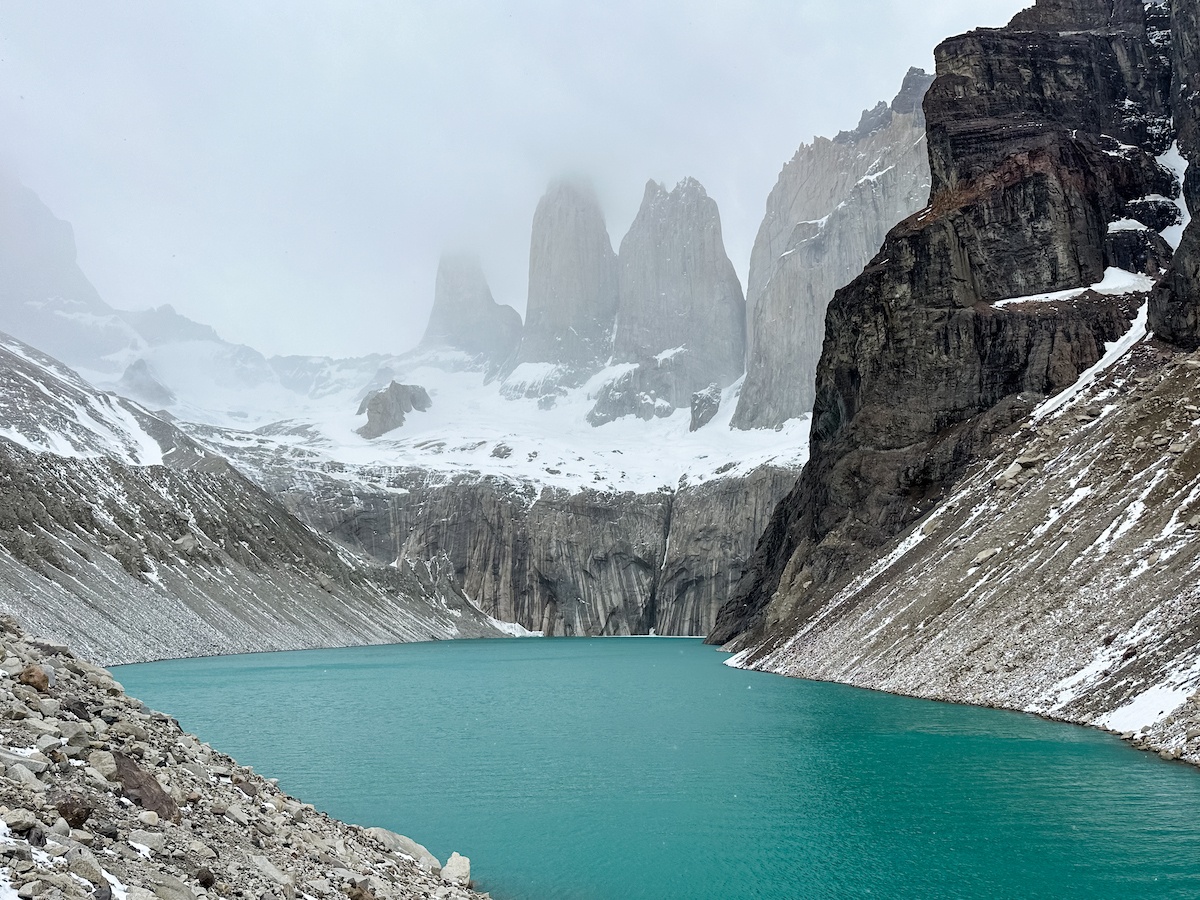
Another factor is when you want to take on the Mirador Base de Las Torres hike: this is the view you’ll see on pretty much every single postcard and basically the entire reason most people come all the way to Patagonia.
Thing is, it’s a very steep eight hour round trip hike, and the most challenging day of the W Circuit. So, some like to get it out of the way on day one while their legs are fresh, while others opt to start from the other side and save it for the last day of the hike as a culmination of their efforts.
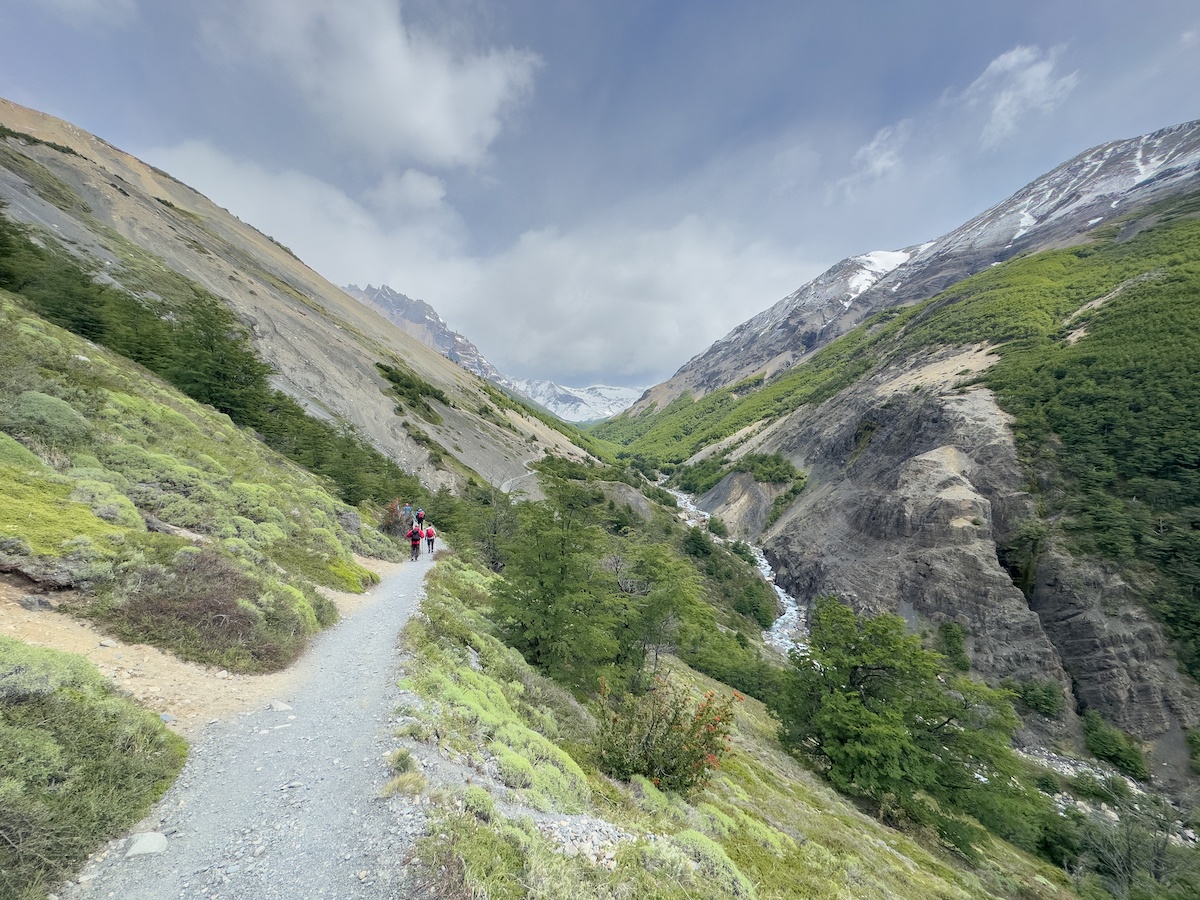
We did it on the first day, and there are pros and cons to both. I can’t imagine how much harder it would have been after already hiking for three full days and feeling worn down from camping and cold showers; that said, going full throttle on the first day wasn’t the best warmup as someone who doesn’t do intense hikes on a regular basis, and my legs were basically jelly the whole rest of the trip.
One perk of going from west to east is you can stay at Refugio Chileno the night before summiting Mirador Las Torres. That saves about 90 minutes of hiking compared to starting from Centro on the other side–a huge advantage for those wanting to make it up for sunrise or try and beat the crowds.
When I asked my guide who’s done the trek hundreds of times which direction he prefers, he said he likes to do it on day one to get it over with. So there you have it.
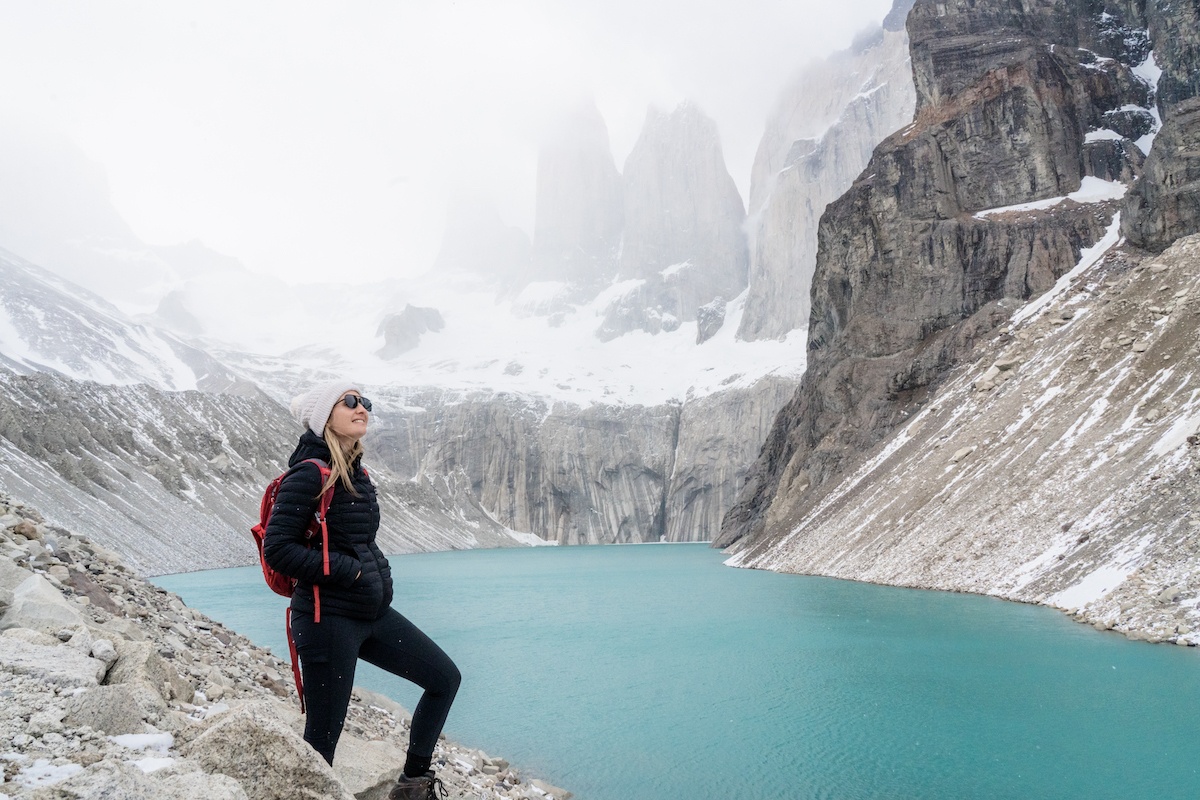
How to book a W Trek itinerary
As you might have noticed already, there are a stupid amount of logistics involved with trekking in Torres del Paine–and in true Chilean fashion, they don’t make it easy.
Some of the things you’ll need to book and consider are:
- Transportation to and from the park gates and to/from the welcome centre (yup, these are separate buses)
- Refugios for each night of the trek
- Food (either carry your own or book meals at each stop)
- Sleeping bag and mat rentals (if not carrying your own)
- Permits/entrance fees
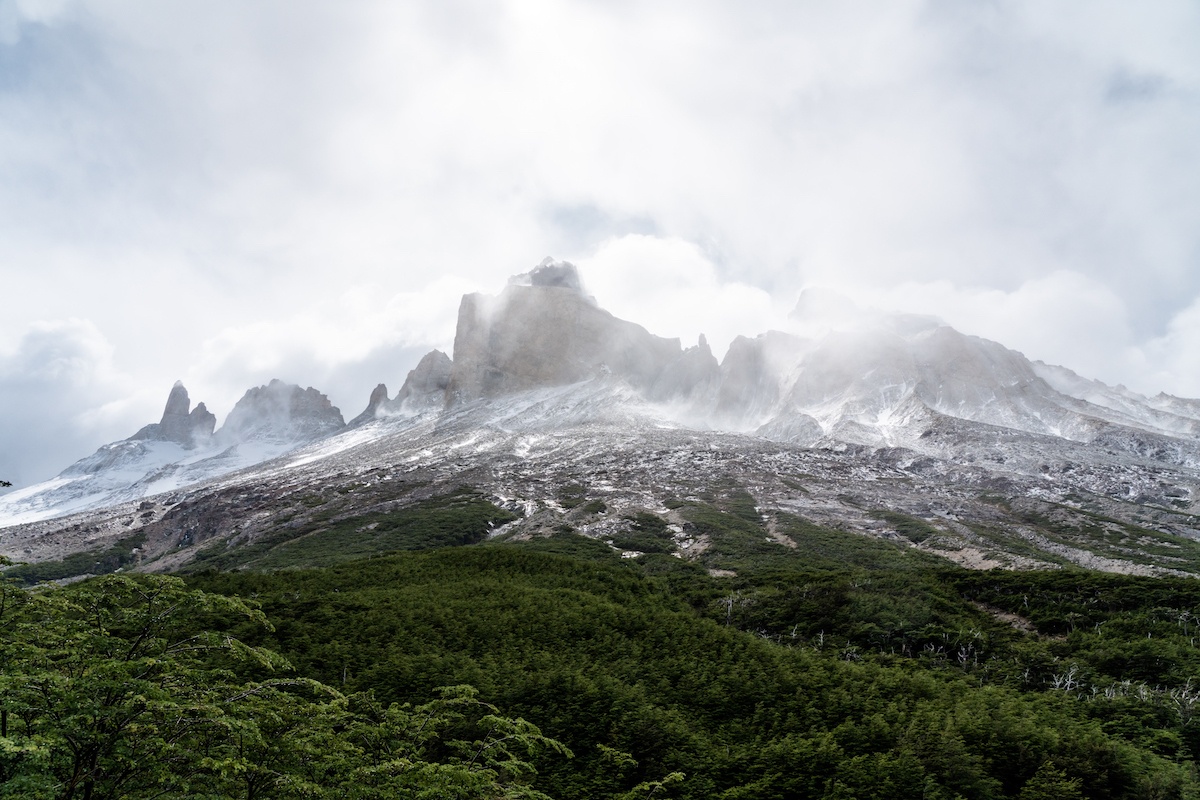
The problem is that tour operators secure a lot of the spots ahead of time, so there are a limited amount left for those planning self-guided trips. You’ll also have to ensure you book each night you need in the correct order of the route, and since two different companies ( Vertice and Fantástico Sur ) operate the refugios you’ll need to coordinate this on separate websites.
Fun, right?
Globe Guide tip: Some hikers have had success contacting the companies directly via e-mail or WhatsApp in advance to secure bookings.
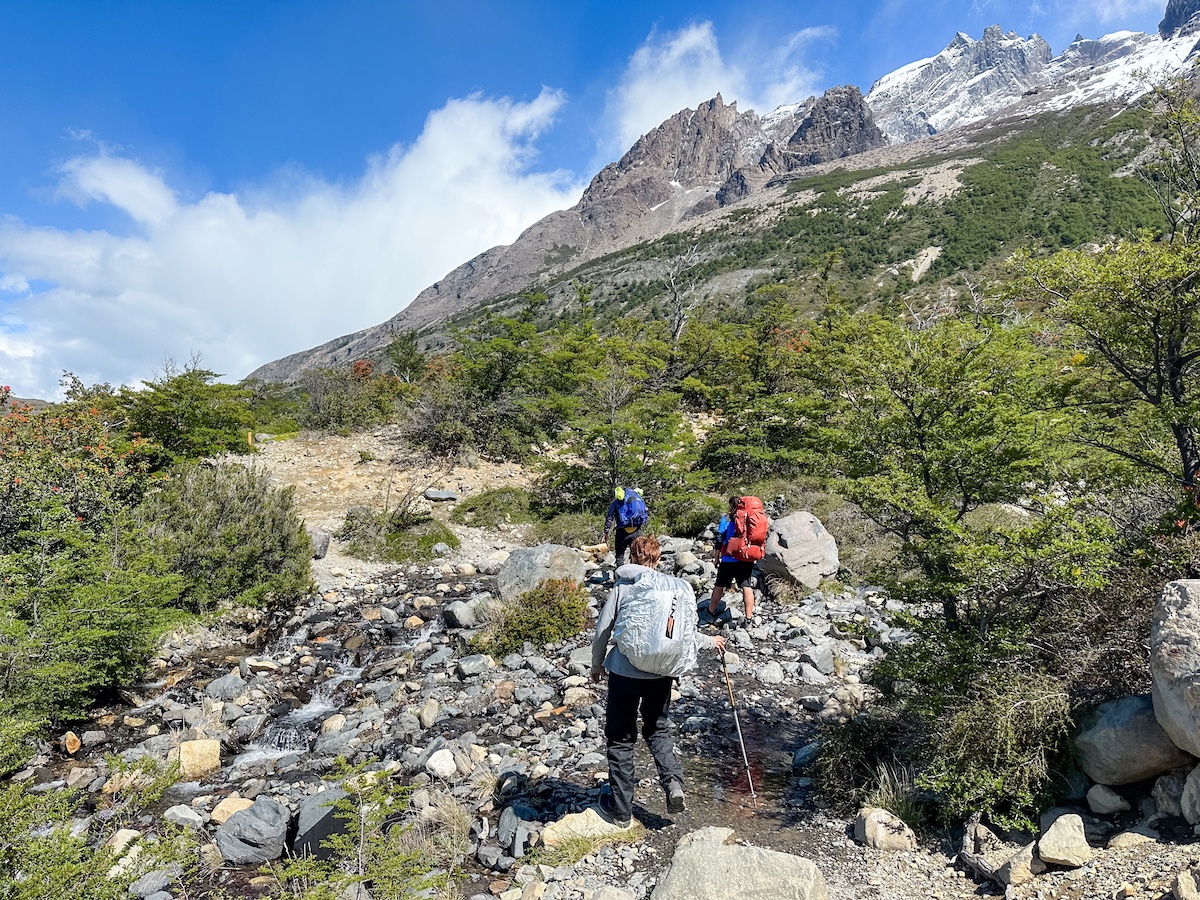
My recommendation: save yourself a lot of time and stress, and book through a small group tour operator instead.
I went with Traverse Journeys , which offers both self-guided and group trip options, as well as (optional) stops in the Strait of Magellan to see the famous penguins, horseback riding, wine tasting among the Casablanca vineyards and city sightseeing in Valparaiso and Santiago.
Traverse handles every single detail right down to what’s in your lunch bag, and donates a portion of the proceeds from each trip to support a local community partner. We saw this firsthand by learning about the efforts the Torres del Paine Legacy Fund is spearheading to conserve the fragile environment and ensure a safer experience for visitors, and even passed some of their volunteers working on the trail.
Globe Guide readers get $200 off of any booking with Traverse Journeys by entering code GLOBEGUIDE200 at checkout!
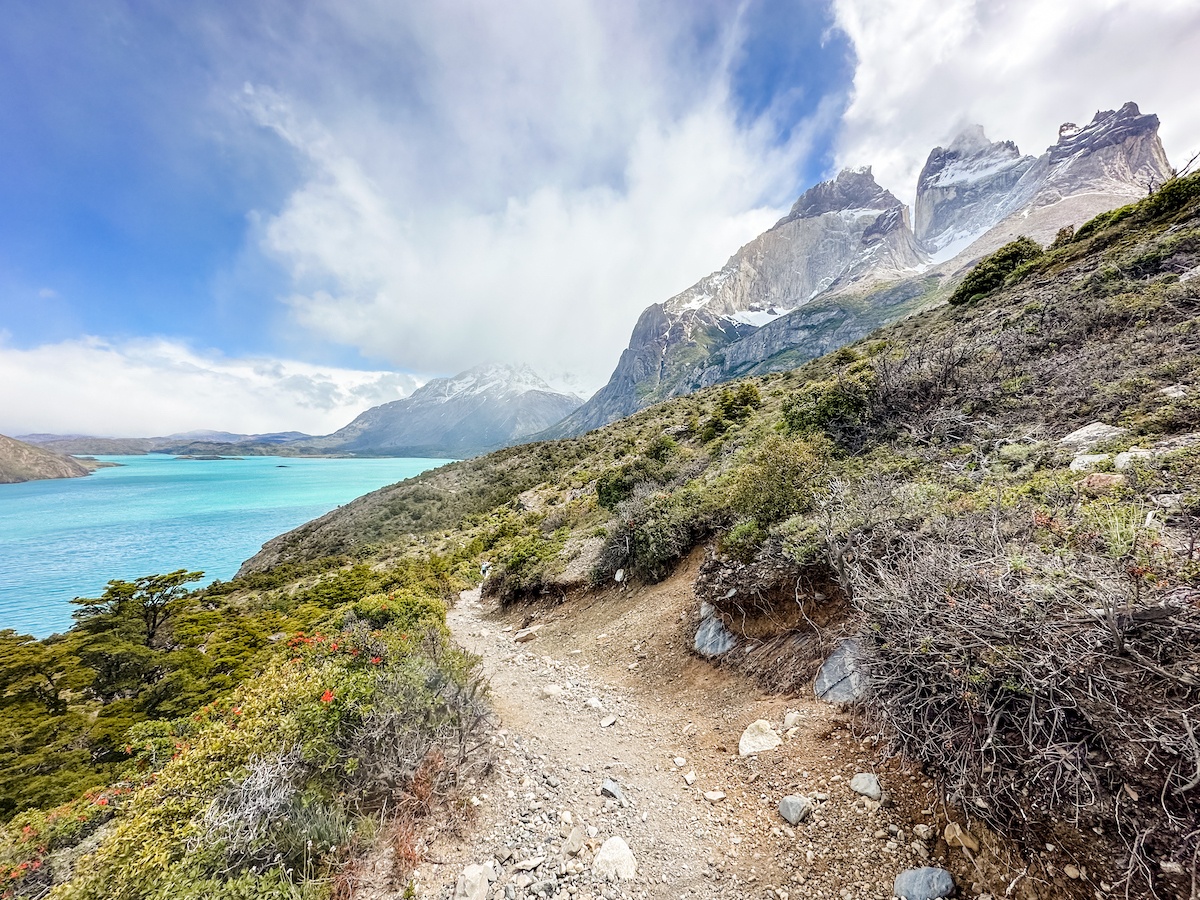
Getting to and from the entrances for trekking Torres del Paine National Park
The cute town of Puerto Natales is like basecamp for Torres del Paine National Park, despite being a scenic 90 minute drive away.
This is where the closest airport is, along with lots of great restaurants and accommodations, grocery stores for stocking up on food or snacks, and gear outfitters for any last minute purchases.
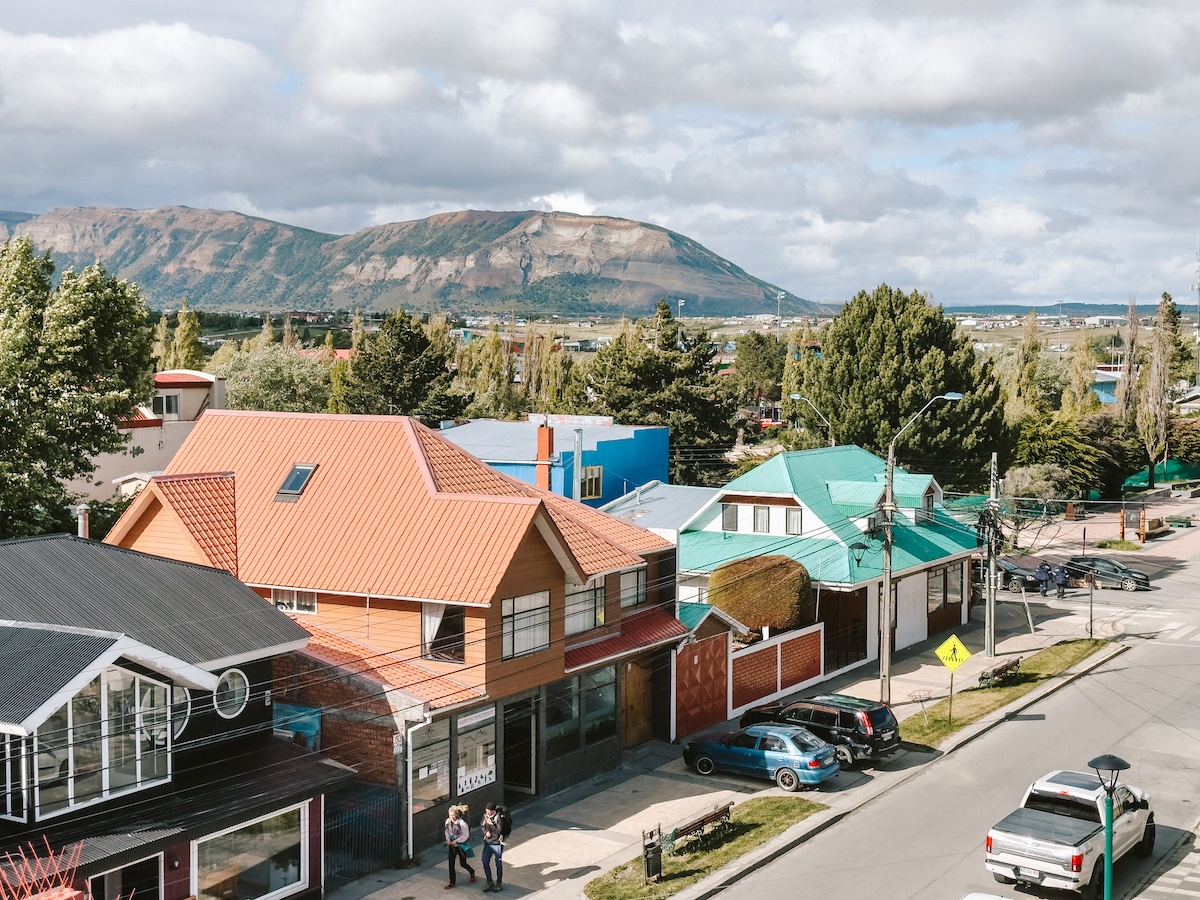
Buses depart from the main depot around 7 AM for both entrances to the park. If you’re starting on the east side like we did or doing the day hike up to Mirador Base Torres, you’ll present a QR code with your permit then hop on another bus (3,000 pesos) to get to the Torres del Paine Welcome Center.
Those starting from the west will head to Lago Grey and take a catamaran over. In theory this means all the way up to the glacier for incredible views, but if the weather is bad a ferry crosses Pehoe Lake to the Paine Grande refugio instead.
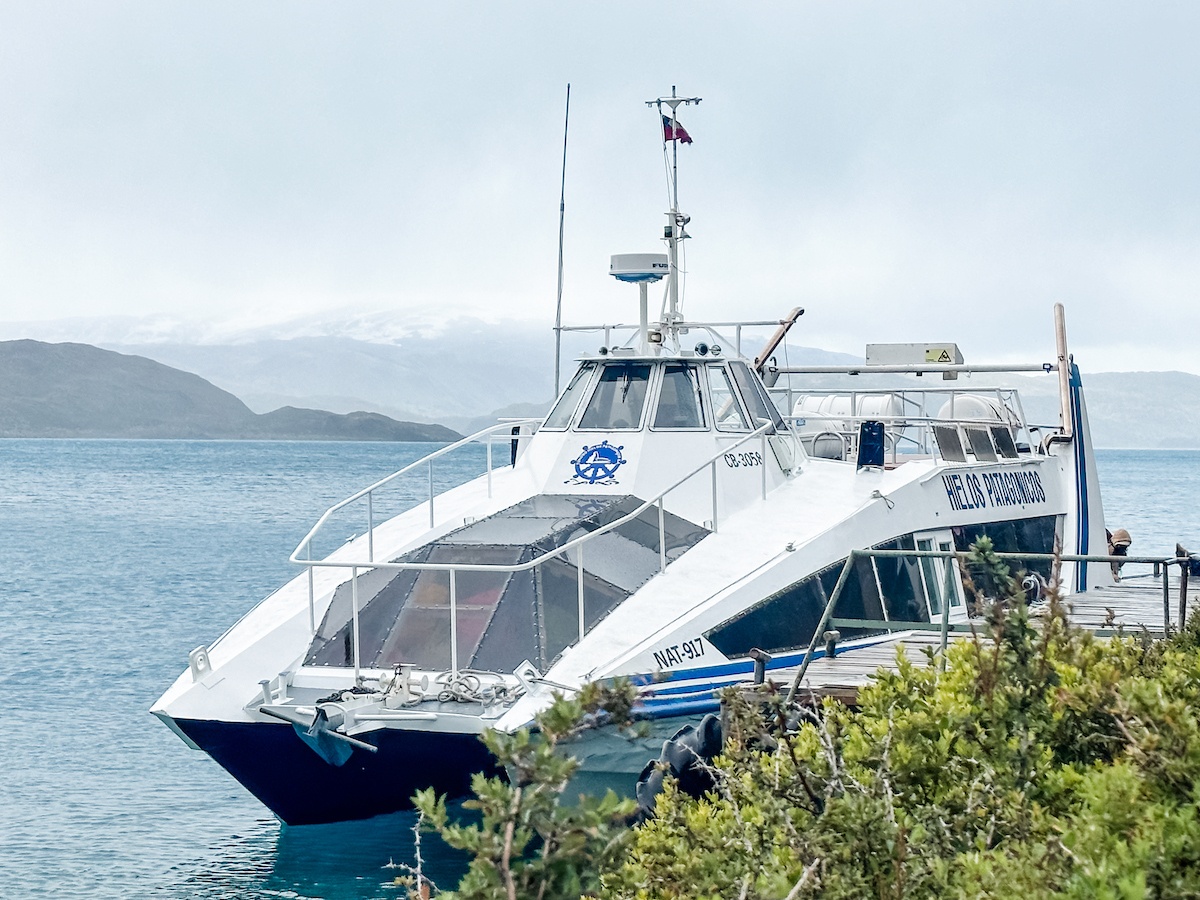
In this case, you’ll have to do an out-and-back to see the glacier on foot, before taking the ferry across Pehoe Lake. This website has more information on prices and schedules.
Globe Guide note: If neither of the boats are operating which happens on occasion due to weather or maintenance issues, it adds an extra 6-7 hours of walking to get to the pickup/dropoff spot.
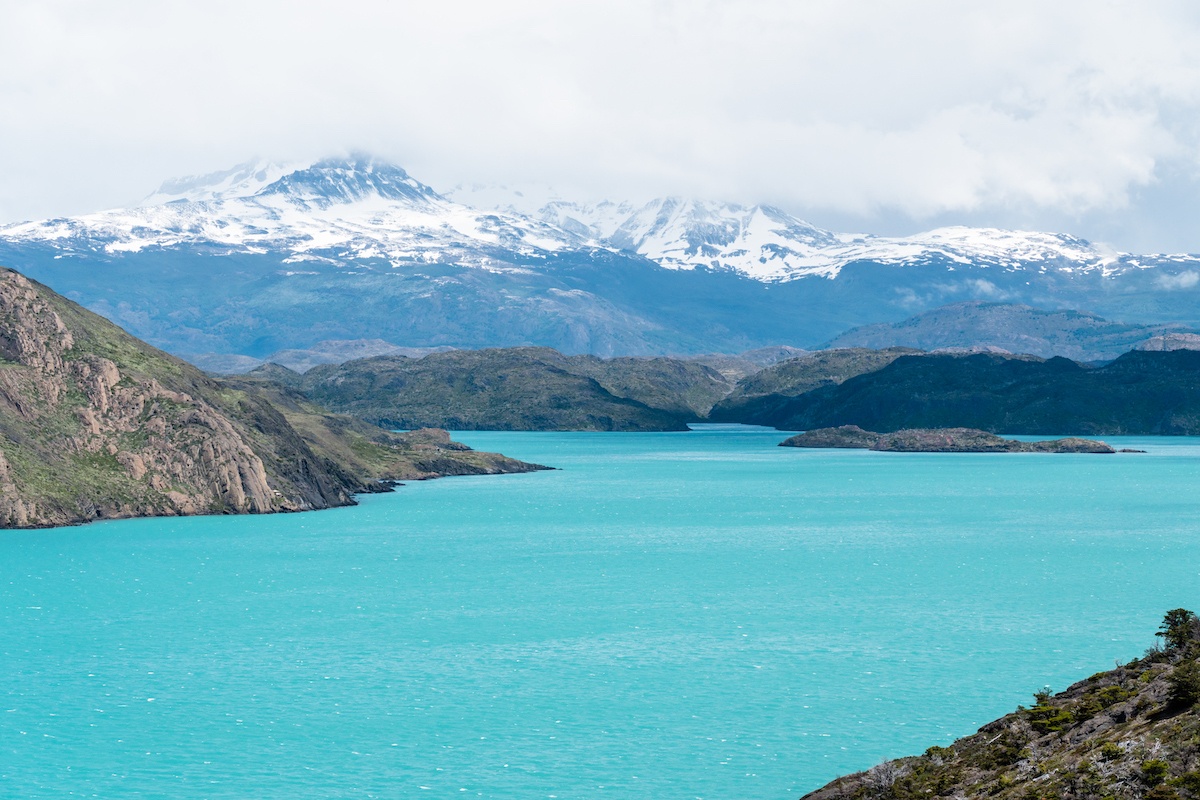
W Trek refugios
Refugios are a key part of the experience, and not all are created equally.
At the very least you can expect a communal eating area, shared bathrooms with (sometimes) warm sinks and showers, a canteen, bar and outdoor hangout area. Camping options are either elevated tents or tents on low platforms (both with sleeping pads), or sites for pitching your own tent.
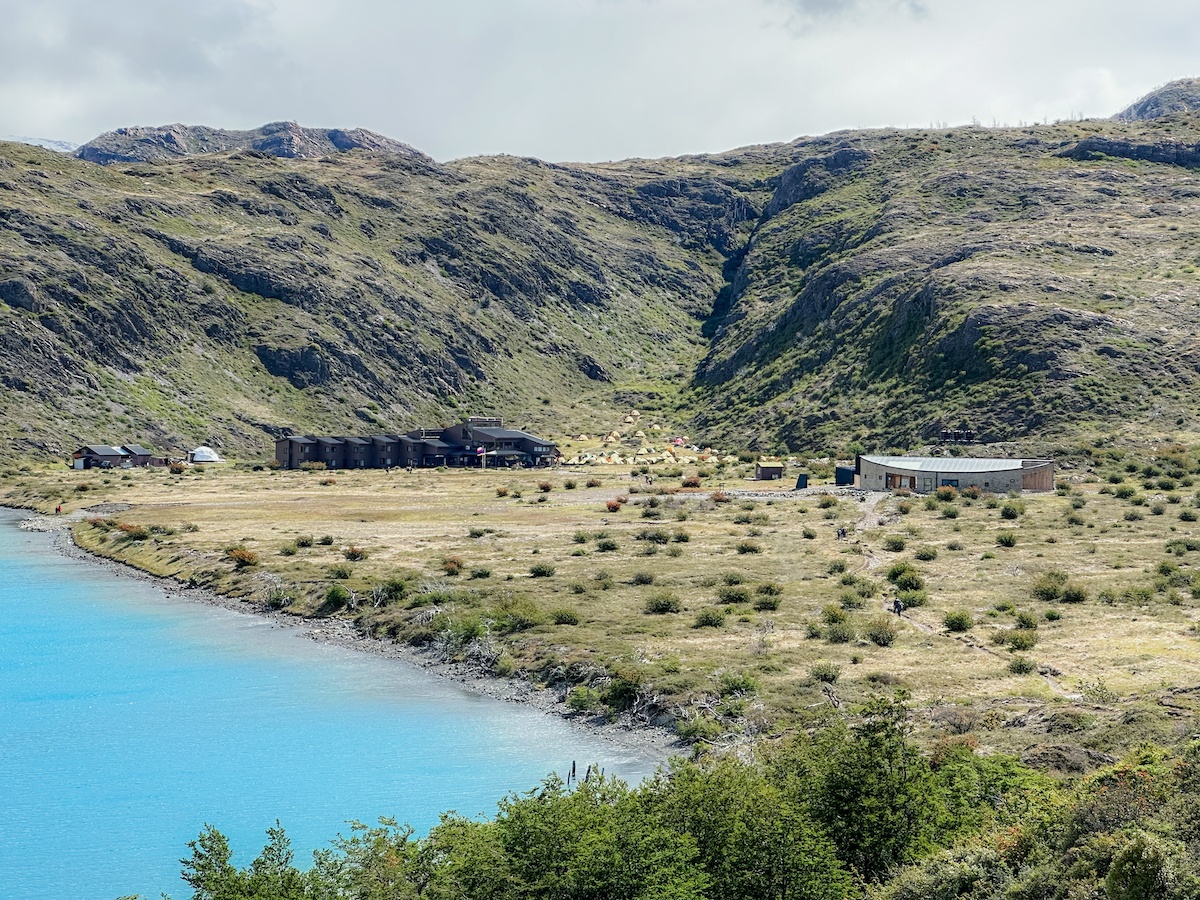
Some refugios also offer dorm-style rooms that sleep about six to eight people in bunk beds, private rooms for couples in the main lodge, and even unique accommodation options like domes and tiny houses.
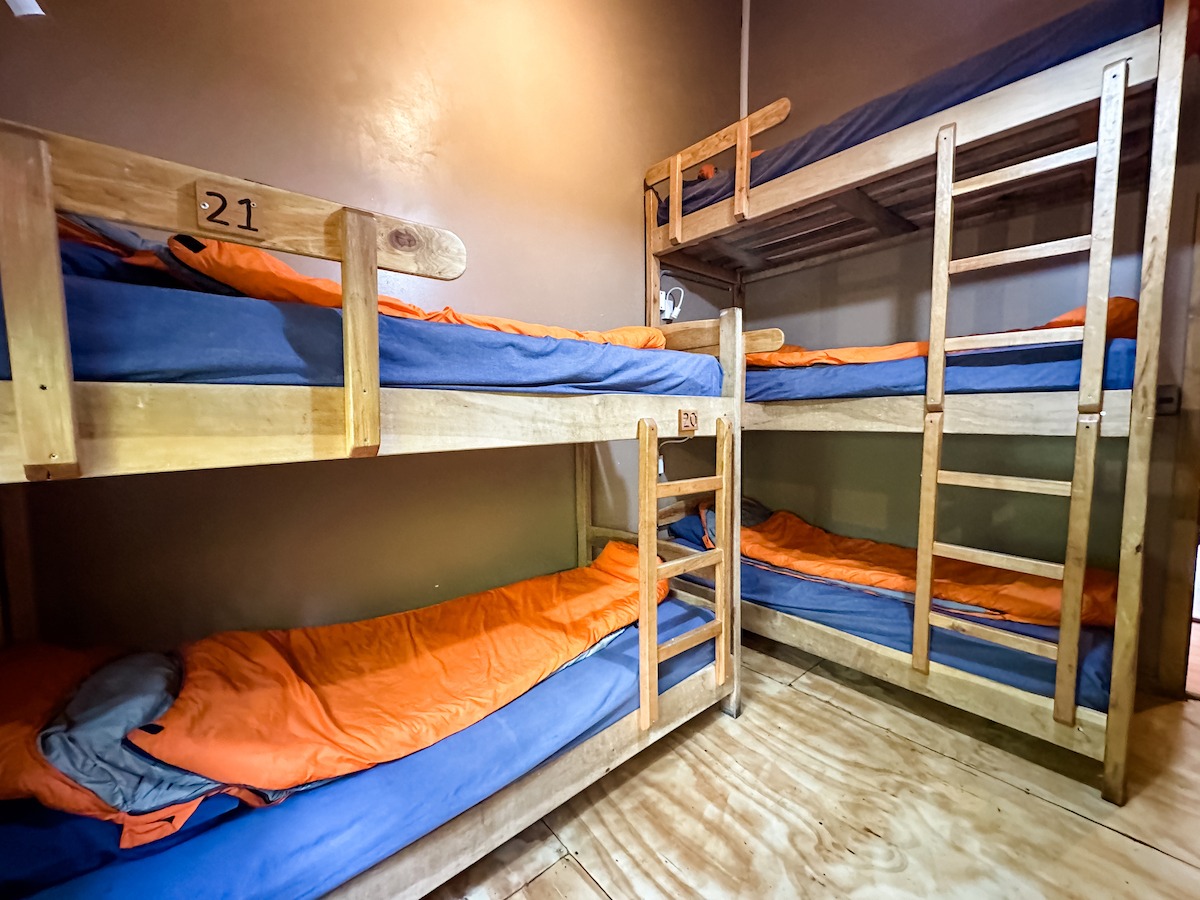
We didn’t get to stay at Refugio Los Cuernos, but absolutely loved the vibe of it from the short time we spent there on a lunch break. It has lovely views from the patio, a warm hangout space and some very cool accommodation options.
Paine Grande has a great feel with lots of communal spaces and a second-floor bar, and Centro has a cozy wood-stove fireplace and large dining area (though we didn’t love how far we had to trek to get to our tent–it felt like climbing another soggy mountain!).
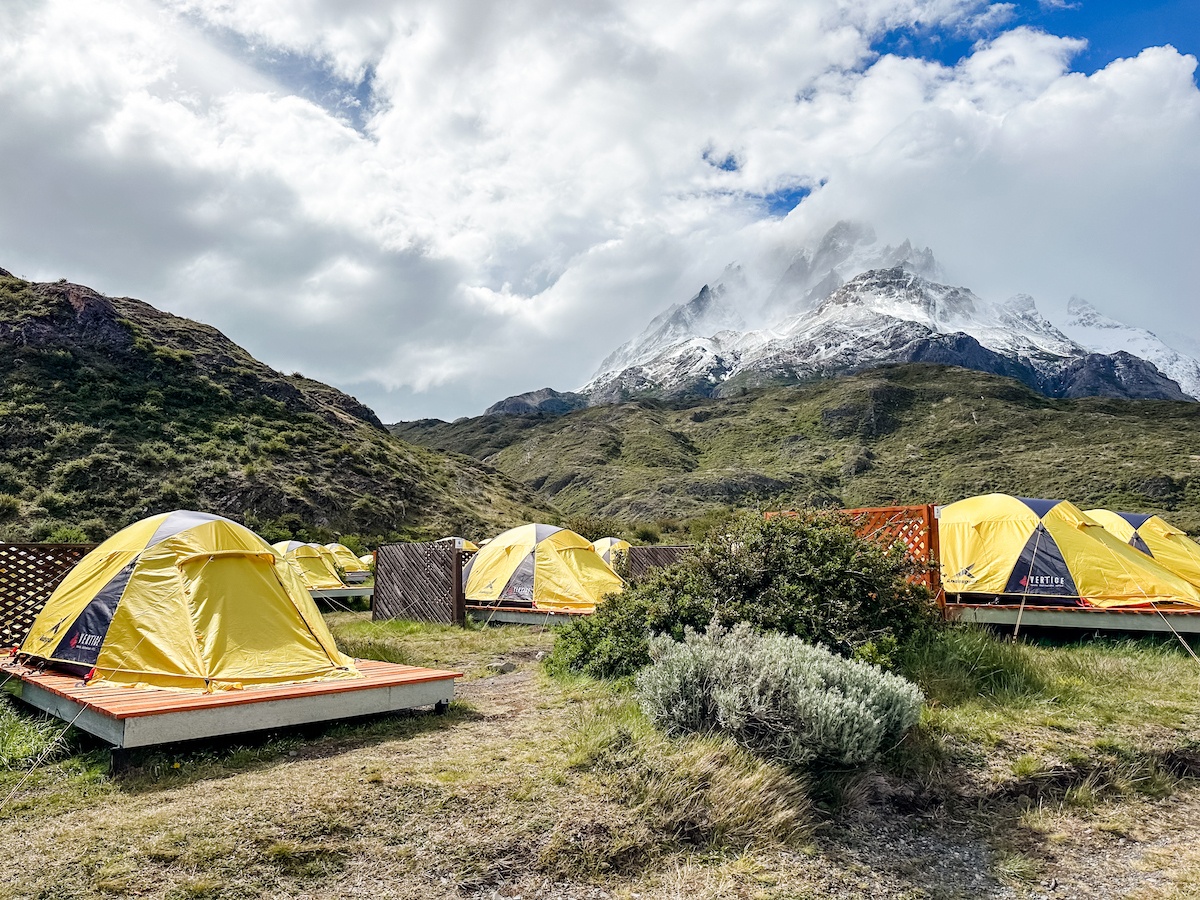
Frances was a total bust and we couldn’t wait to get out of there.
The layout is awful, with all the tents at the top of a hill and the restaurant at the very bottom and not well marked—not fun to deal with going up and down after a full day of hiking. To add insult to injury, dinner seatings start early and there’s no other warm place to sit or enjoy a drink, so you’re literally stuck out in the cold waiting to get in.
The bathrooms were filthy (to be fair, they aren’t very clean at most refugios ) and even though there were limited hours for hot water it still ran out before the time was up. My top tip would be to stay at Los Cuernos instead of Frances if possible.
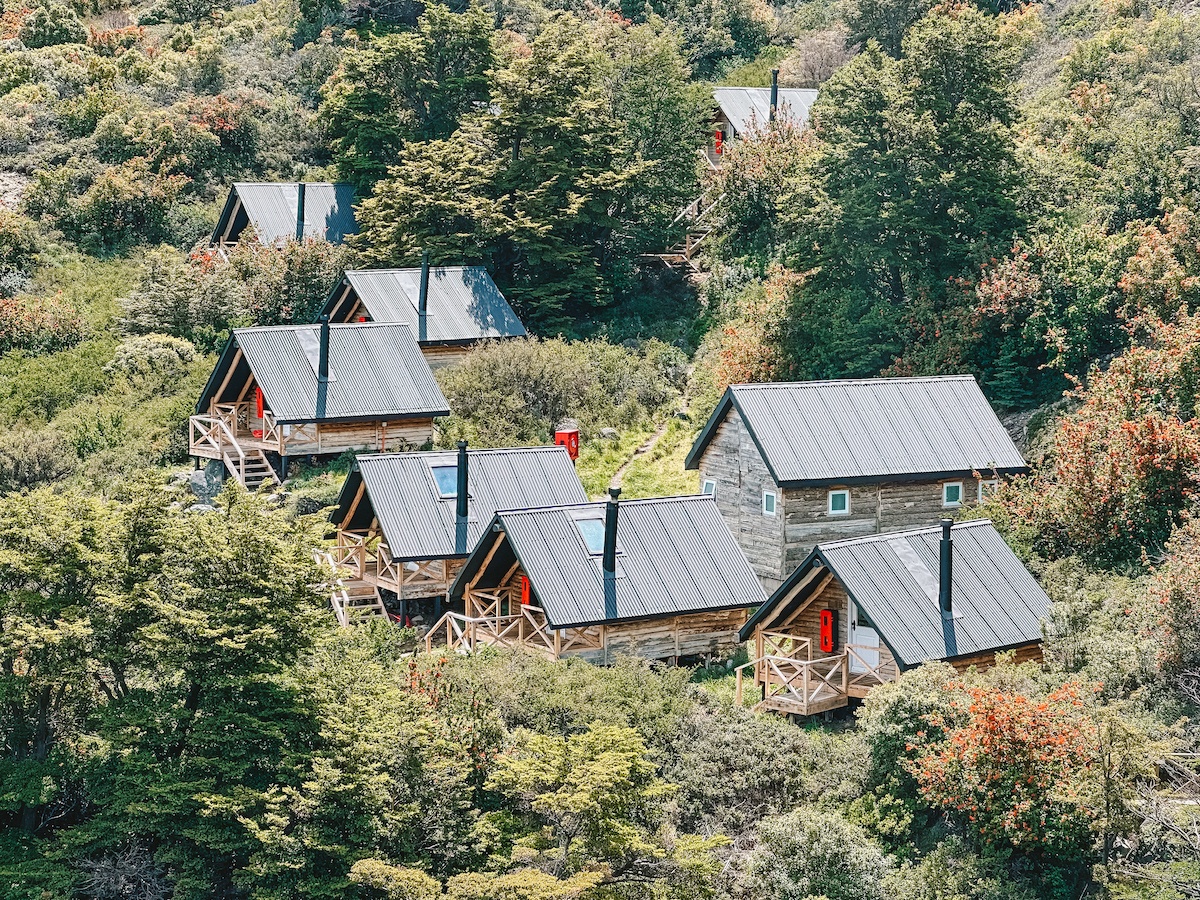
Prices differ by refugio , but expect to shell out about (per night, in USD):
- $13 for a campsite
- $40 for a tent
- $25 sleeping bag rental
- $12 mat rental
- $65 per bunk in bunk bed (comforter extra)
- $100+ for private accommodations like domes
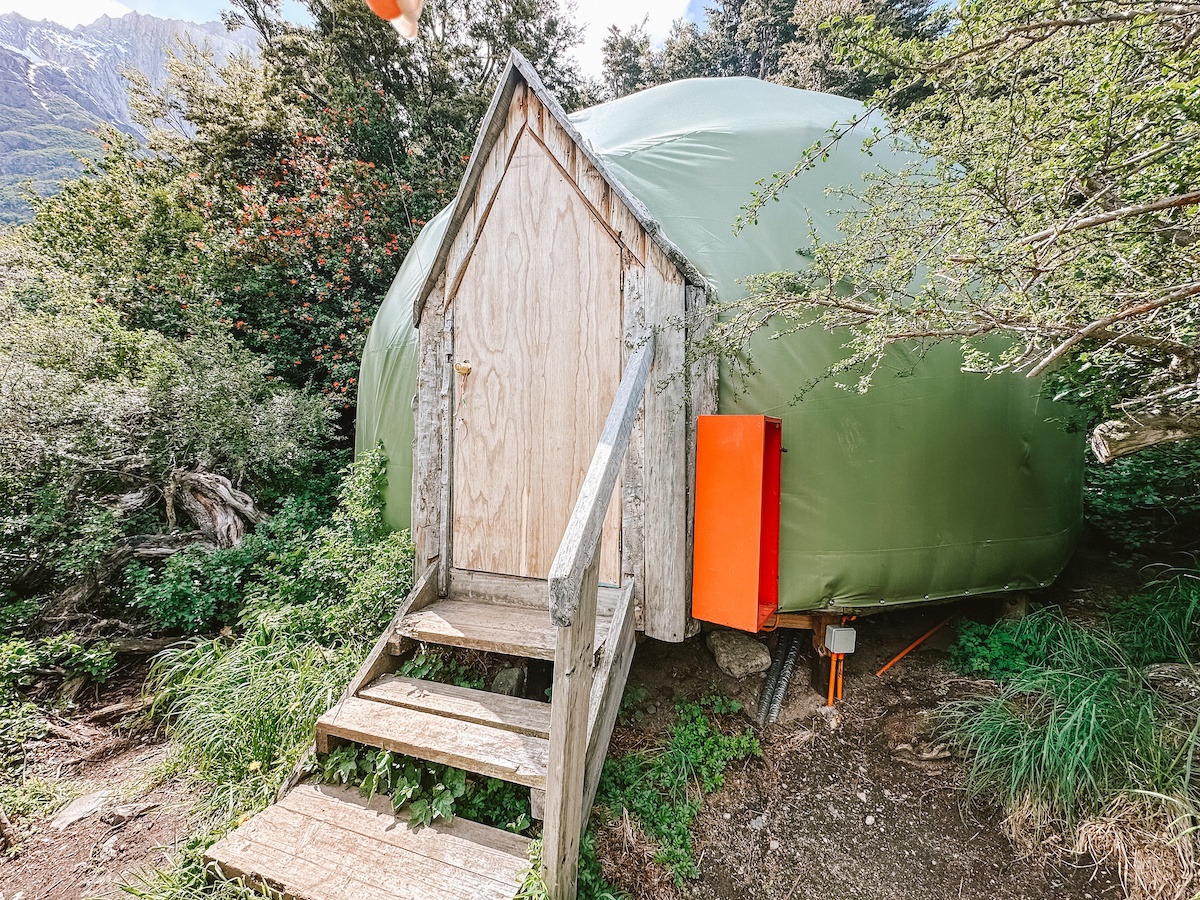
Hikers can bring their own food, or opt for a meal plan with breakfast (usually just bread and a small portion of scrambled eggs), boxed lunch and a hearty family-style dinner (timed seatings).
You’ll get a lot more out of the experience if you embrace being off-the-grid during the trek; however, those who need to connect can pay for minutes at the WiFi stations inside most refugios .
There are also outlets in the refugios for charging devices, but they can be in-demand so I recommend bringing a lightweight portable charger instead.
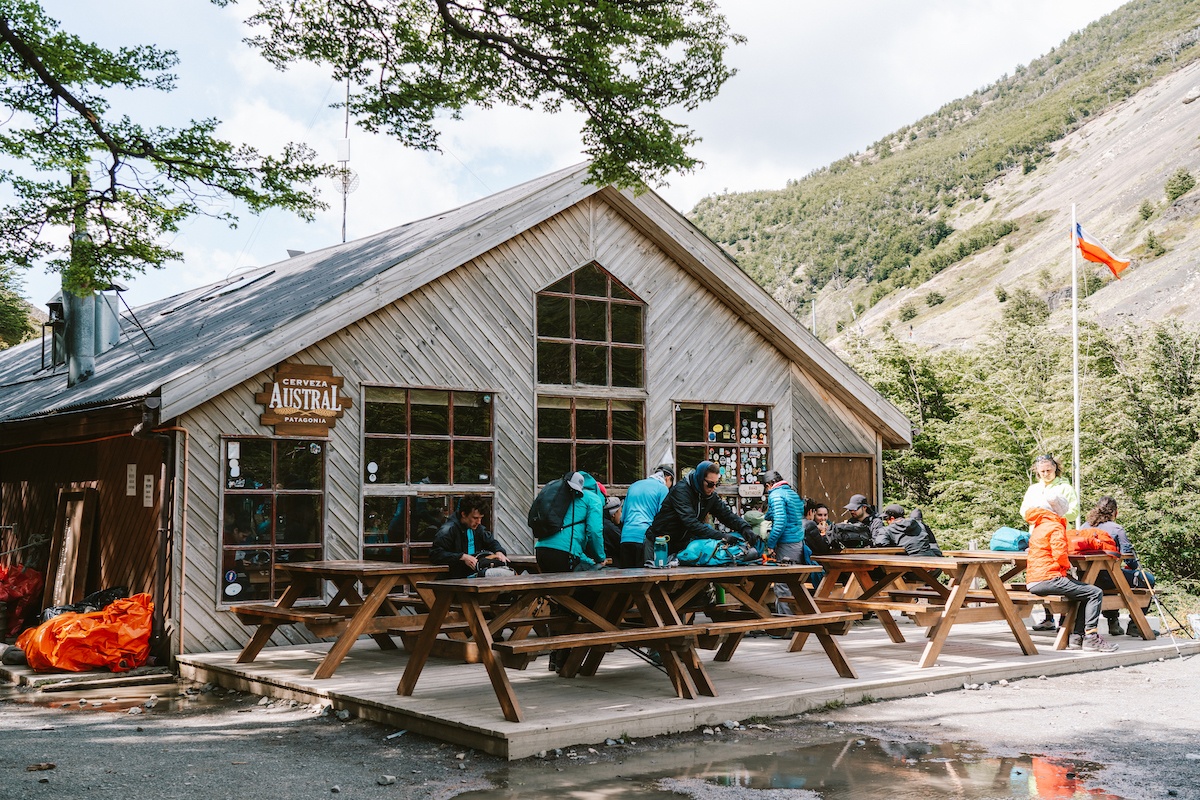
Life on the trail during the Torres del Paine W Trek
There’s a huge sense of camaraderie on the trails that feels like the good ol’ backpacking days. You’ll see the same people over and over, since there are only two potential routes and a handful of refugios.
You’ll spend anywhere from six to twelve hours walking per day (depending which part of the route you’re on), and likely only see a few dozen hikers until you get to a refugio.
The exception is the Mirador del Torres hike, which is absolutely packed with people. It sees about 1000 people per day since it’s the area’s most famous trail and can easily be done by day trippers from Puerto Natales.
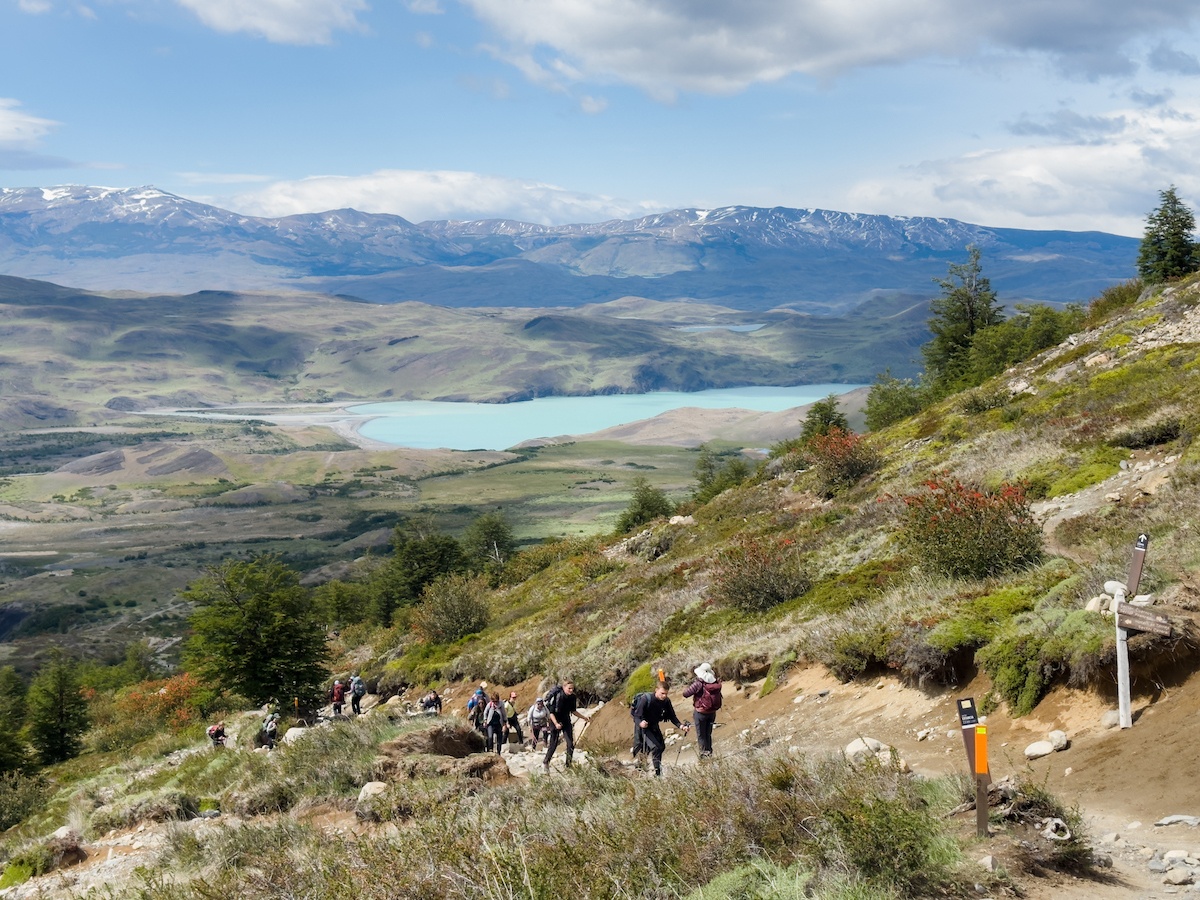
In terms of the age range, hikers seemed to be anywhere from in their early 20s to late 60s. My mom did it, and she’s turning 70 this year! I only saw one child the entire time, so the W Trek doesn’t seem to be popular with families.
It’s definitely a good idea to have hiking experience (and make sure you break in your shoes and test your outdoor gear ahead of time, obvs). That said, a couple people in our group aren’t regular hikers and managed alright, as it’s not a super technically challenging trail.
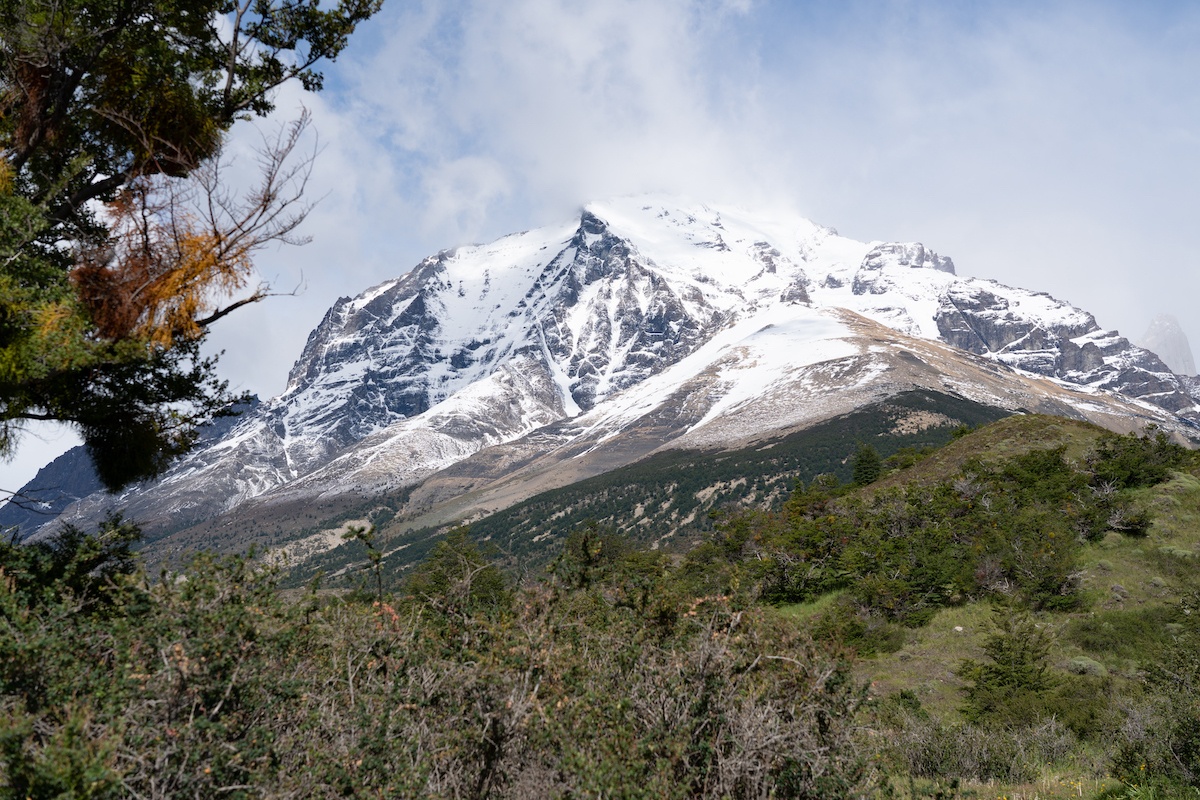
The main challenge for me was how long each day is, with very little time to rest before doing it all over again the next day. And let’s be honest, tents aren’t that comfortable. 10/10 would recommend upgrading to a bed if budget allows.
Completing the W Trek is definitely a mental and physical challenge–luckily, the feeling of accomplishment coupled with jaw-dropping scenery like soaring peaks shrouded in mist, calving glaciers and gem-toned lakes makes it all worth it.
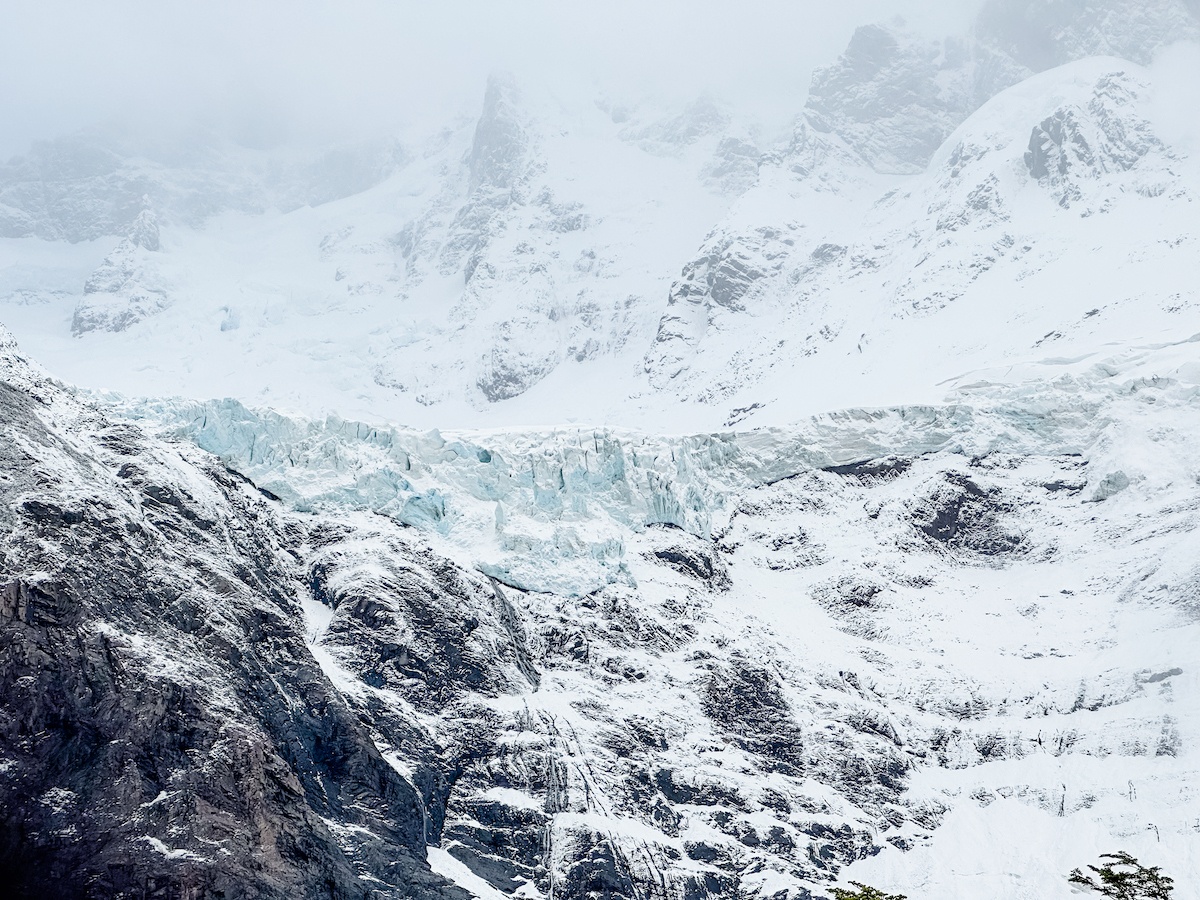
Patagonia packing list: The essentials
It’s not uncommon to experience all four seasons in a single hour in these parts, so preparation is key when planning your packing list for Patagonia.
Unless you hire a porter you’ll be carrying all of your belongings in a large trekking pack for at least two full days, and will also need to bring a lightweight sleeping bag, mat and travel pillow unless you rent them at each refugio.
READ MORE: Patagonia packing list for the Torres del Paine W Trek
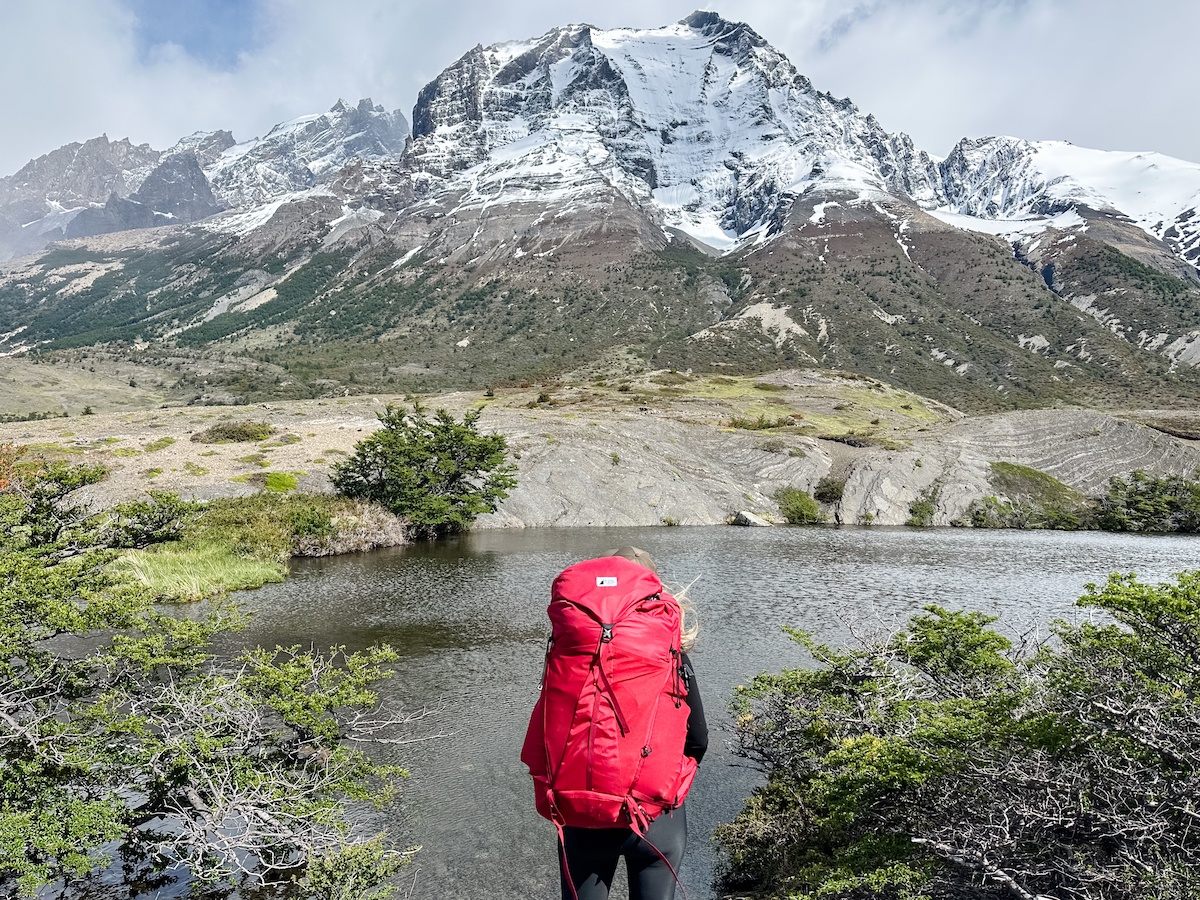
This W Trek packing list outlines every single item you’ll want to bring and a few you might not have thought of– you’ll definitely want a lightweight portable charger , collapsible hiking poles , a quick dry towel and Chilean pesos in case there’s a connectivity issue with using credit cards at the refugios .
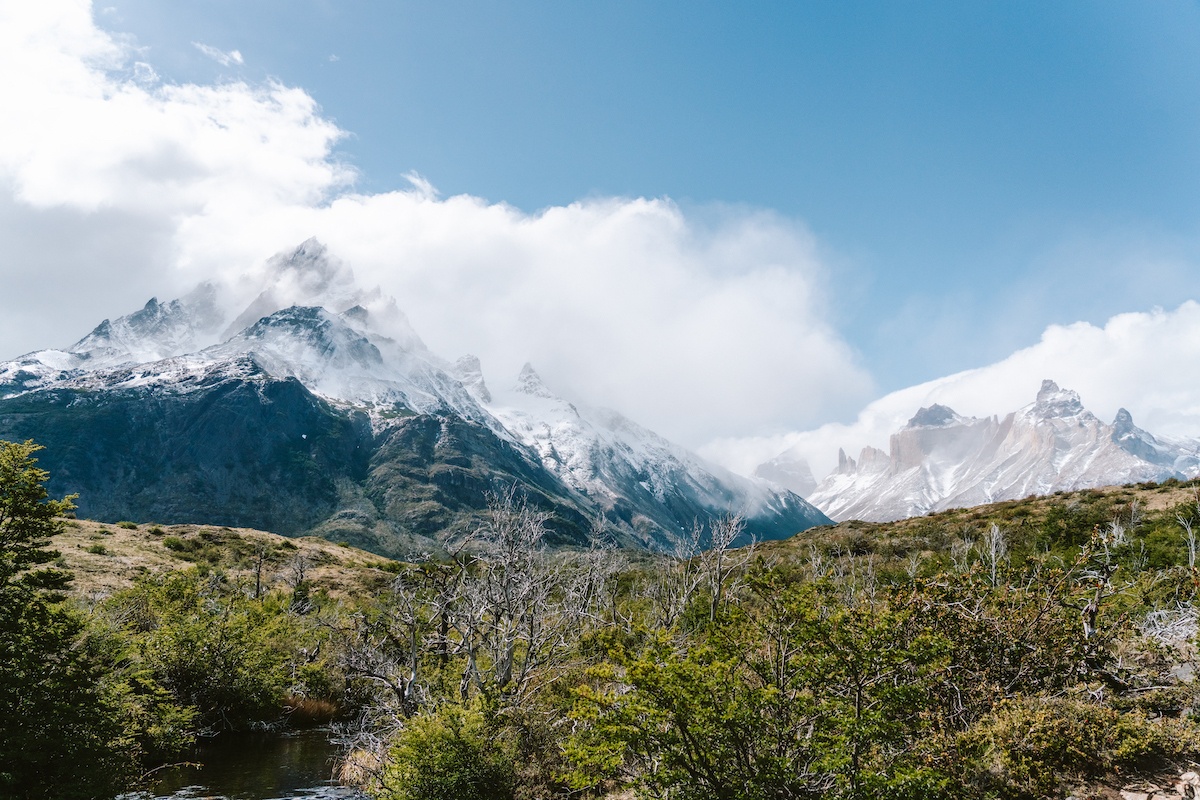
Insider tips for the W Circuit, Torres del Paine
- The Patagonia W Trek can be done all year round, but the best time is from November to March. Chile is in the southern hemisphere, so this is spring/summer when temperatures are warmer and there’s usually less rain and snow.
- If you’re planning to hike Torres del Paine without a guide, it’s critical to download a GPS map ahead of time. While the trail is generally well marked, one wrong step away from the path can get you lost in a hurry since the terrain is so untouched. Unfortunately this happened to me near Glacier Grey and resulted in a frantic 20 minutes of running up and down ravines and ridges, yelling ‘help!’ in hopes fellow hikers would hear me over the wind–luckily, a couple did. Man, was I ever thankful to see them (side note: stick with your hiking buddies!).
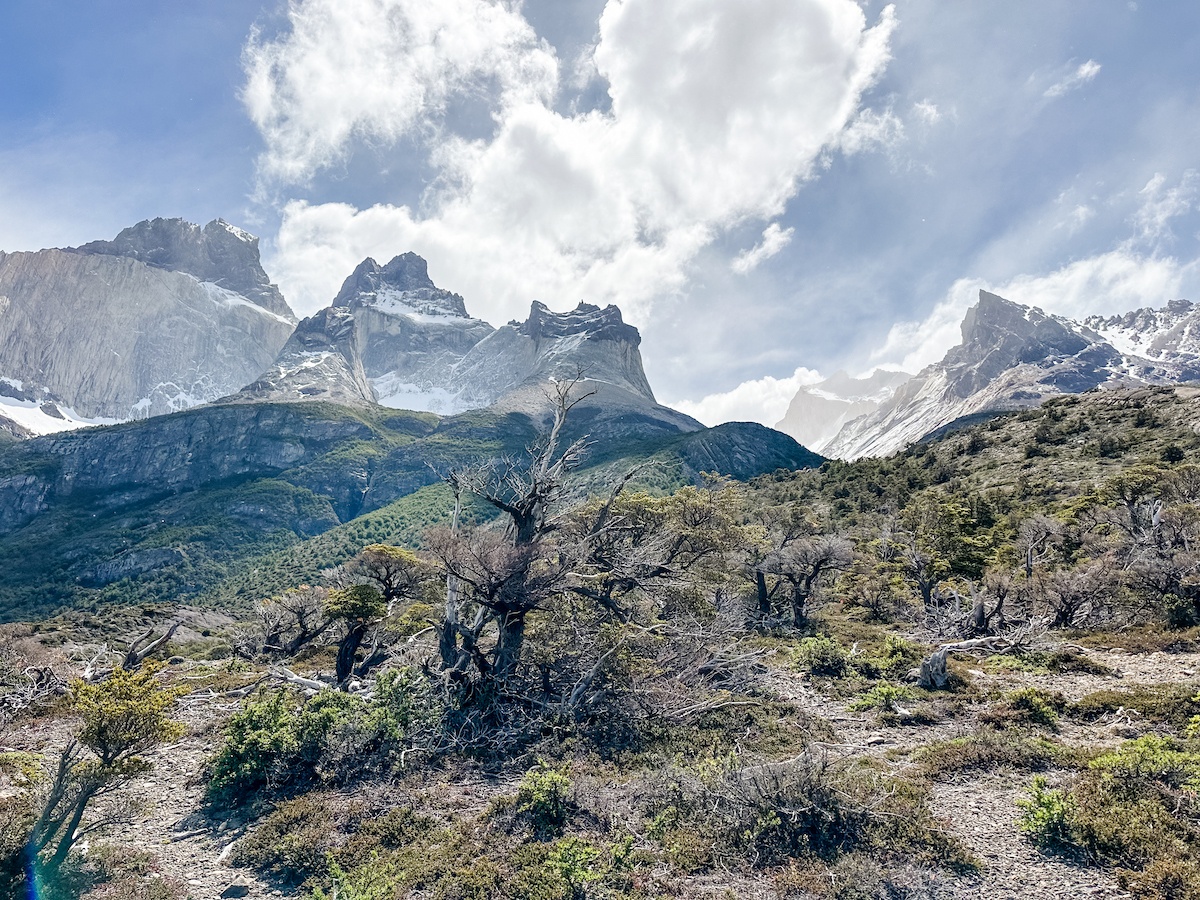
- While most people complete the W Circuit in four days straight, another option is to spend an extra day at Los Cuernos. Not only is it one of the nicest refugios with spectacular views, but that way you’ll be able to either spend the day resting up, or do the hike up to the French Valley and back to save several hours the day after by walking straight to Paine Grande.
- It’s not uncommon for refugios to ‘lose’ reservations, so bring a printed or screenshot confirmation of your booking with you on the Torres del Paine W Trek.
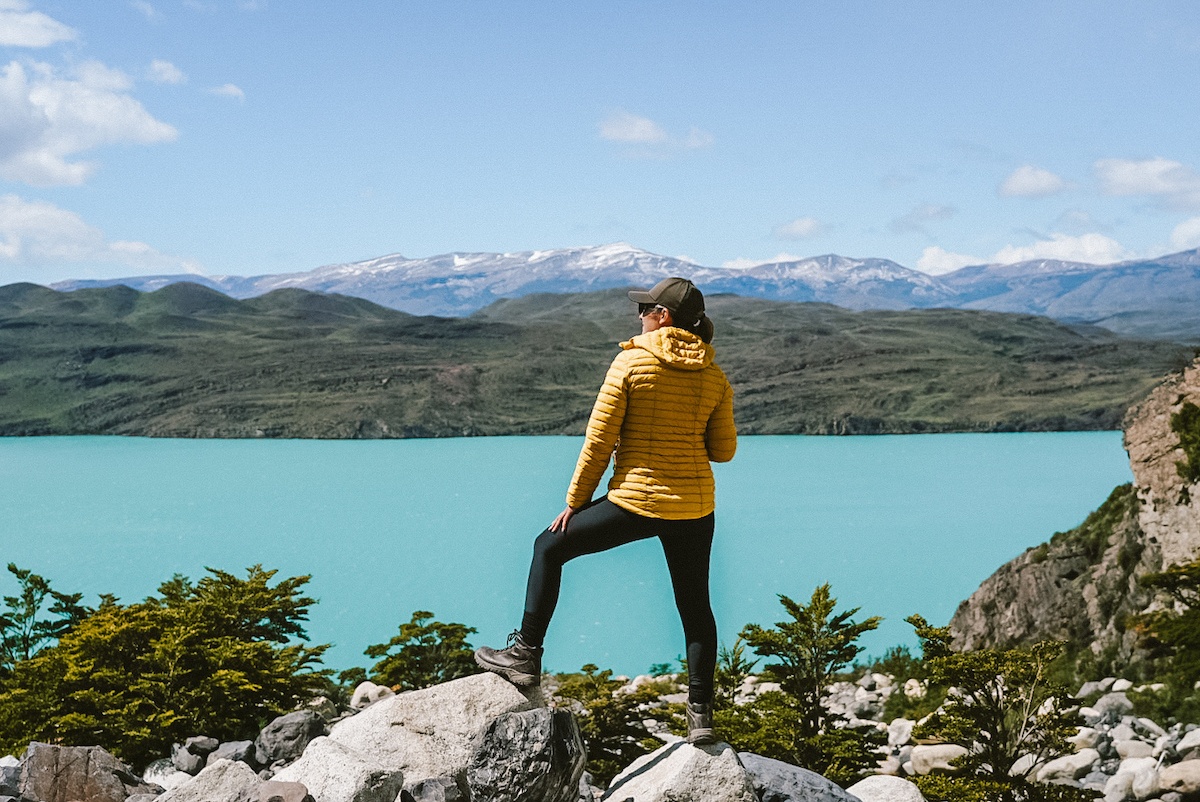
YOU MIGHT ALSO ENJOY:
- Patagonia itinerary: How to spend one week exploring southern Argentina
- 5 reasons to go backpacking in South America
- Epic hiking spots you need to add to your bucket list right now
SHARE THE PINSPIRATION! CLICK THE IMAGES BELOW TO PIN:
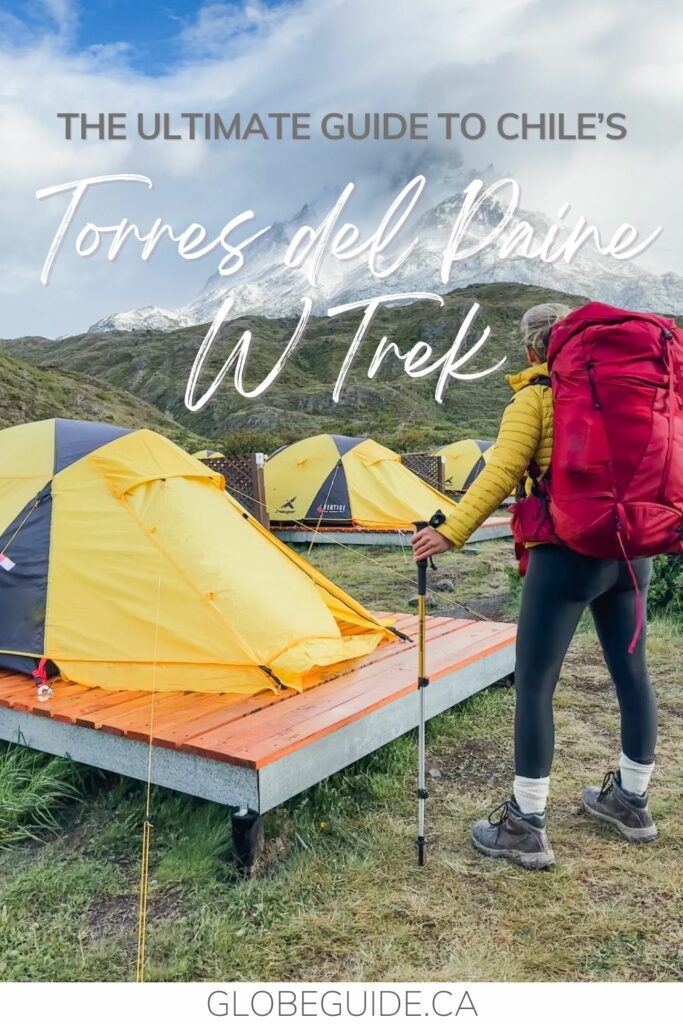
This post may contain affiliate links, which Globe Guide receives compensation for at no additional cost to you.
About The Author
Tamara Elliott
Leave a comment cancel reply.
Your email address will not be published. Required fields are marked *
Save my name, email, and website in this browser for the next time I comment.

Hiking the W Trek in Torres Del Paine, Patagonia: Itinerary, Gear & Camping Tips
Want to hike the W Trek in Torres Del Paine? We answer all of your questions about itineraries, gear, campsites, and whether a guide is necessary.
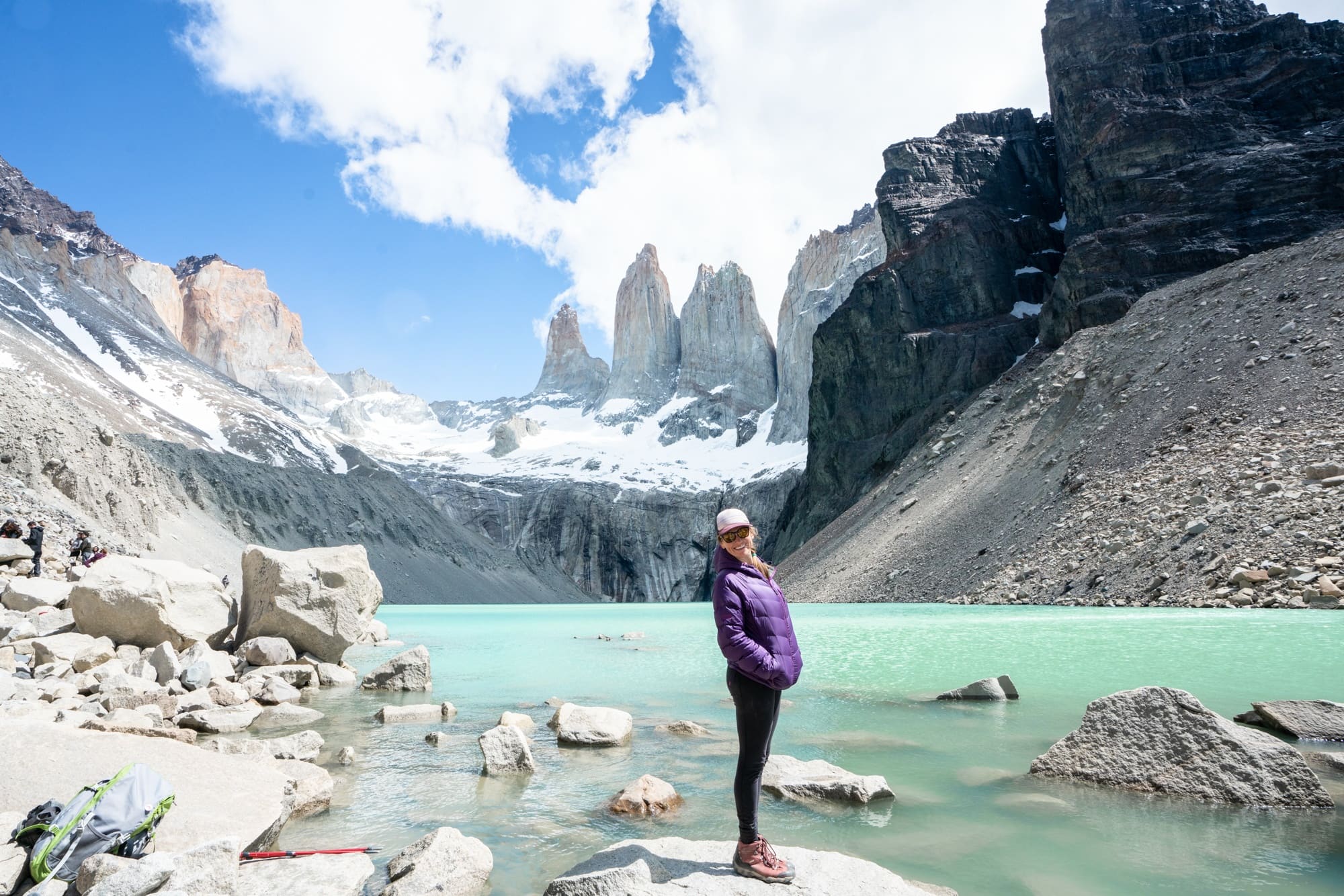
Find this post helpful? Learn how you can support Bearfoot Theory’s work here . You can also shop for gear through the affiliate links in this blog post where we get a small commission at no cost to you. It helps keep our team running and the lights on. THANK YOU! -Kristen
During our guided trip to Patagonia, we hiked the famous W Trek with G Adventures as part of the most recent Bearfoot Theory group trip. We spent four days and three nights in and around Torres del Paine and took in the amazing scenery of wild and rugged Patagonia.
There were comfortable campsites, home-cooked meals at the park’s well-known refugios which exist to serve backpackers and day hikers alike, not to mention top-notch guides. If you’ve ever thought about hiking this world-famous trail look no further.
As it goes in all of the destinations we share, please practice good trail etiquette and remember to Leave No Trace . This means packing out all of your garbage, being respectful to others on busy trails, and following the established rules.
Keep reading if you plan on hiking the W Trek in Patagonia for a complete itinerary, gear and camping tips.
[separator style_type=”icon” /]
W Trek YouTube Video
Watch my new YouTube vlog from our time on the W Trek in Torres Del Paine!
What is the W Trek in Patagonia?
Torres del Paine National Park in Chilean Patagonia is the most famous hike in the entire region. It’s a four to five-day hike that makes stops at the park’s iconic refugios for overnight stays with an option to hike the entire trek without carrying food. While hiking, it gives travelers unparalleled views of the granite towers and some of the park’s most well-known sites from up close.

[separator style_type=”single” /]
Do you need a guide to hike the W Trek?
Now I’ll say that I’m not necessarily a “guided-tour-kinda-person.” I love traveling independently and the spontaneity that comes with being your own guide. However, it really depends on the destination for me and in the case of hiking the W Trek, there are a number of benefits to joining a tour, or hiring a local guide at a minimum. Hiking the W trek requires a ton of advanced planning. All of the campsites are run by different operators and fill up from 6 months to even a year in advance . Getting your desired dates and sites can be difficult.
If you hike the W Trek with a tour, you can be more spontaneous with your travel plans since the campsite reservations are made for you. You won’t have to book a year in advance in the case that you find yourself with unexpected vacation time. You’ll also learn so much more about the culture, local language, geography and history of the park because of the guide’s own personal experience and familiarity with the area.
Our two local guides contracted by G Adventures, Jarek and Marcello (along with our G Adventures tour guide Marina ) were very knowledgeable, a lot of fun, and had high safety standards, and I had a more memorable experience because of them.
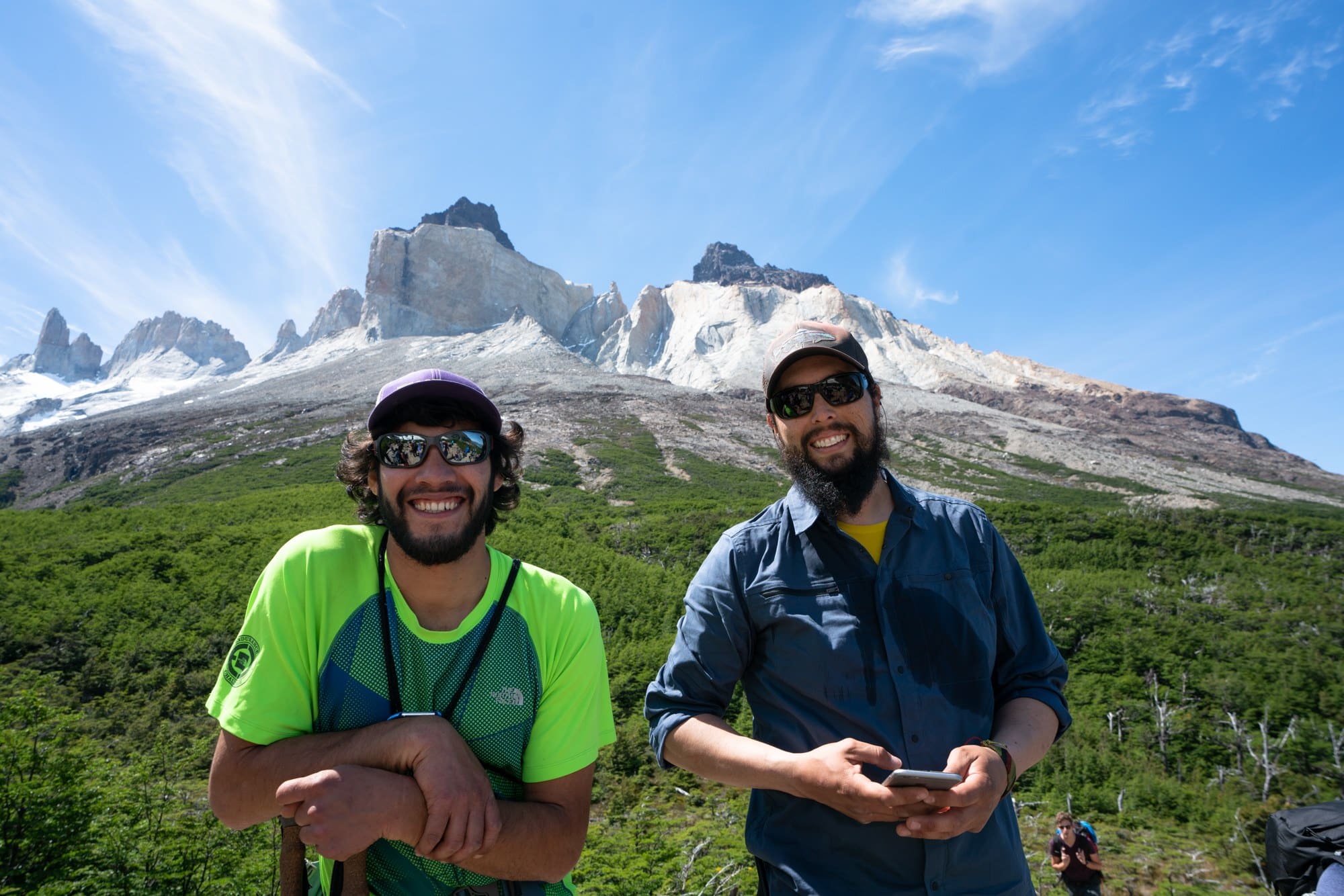
They were adamant about Leave No Trace practices and were full of local insight including what water sources were safe to drink, prime lunch spots, and more.
G Adventures even arranged for us to have all of our gear transported for us each day to the next campsite. So all we had to carry was our daypacks full of food, water, camera, and extra hiking layers. Plus, all of our meals were set up for us, we always had a hot breakfast and dinner at the refugios and were given a boxed lunch for the trail every day.
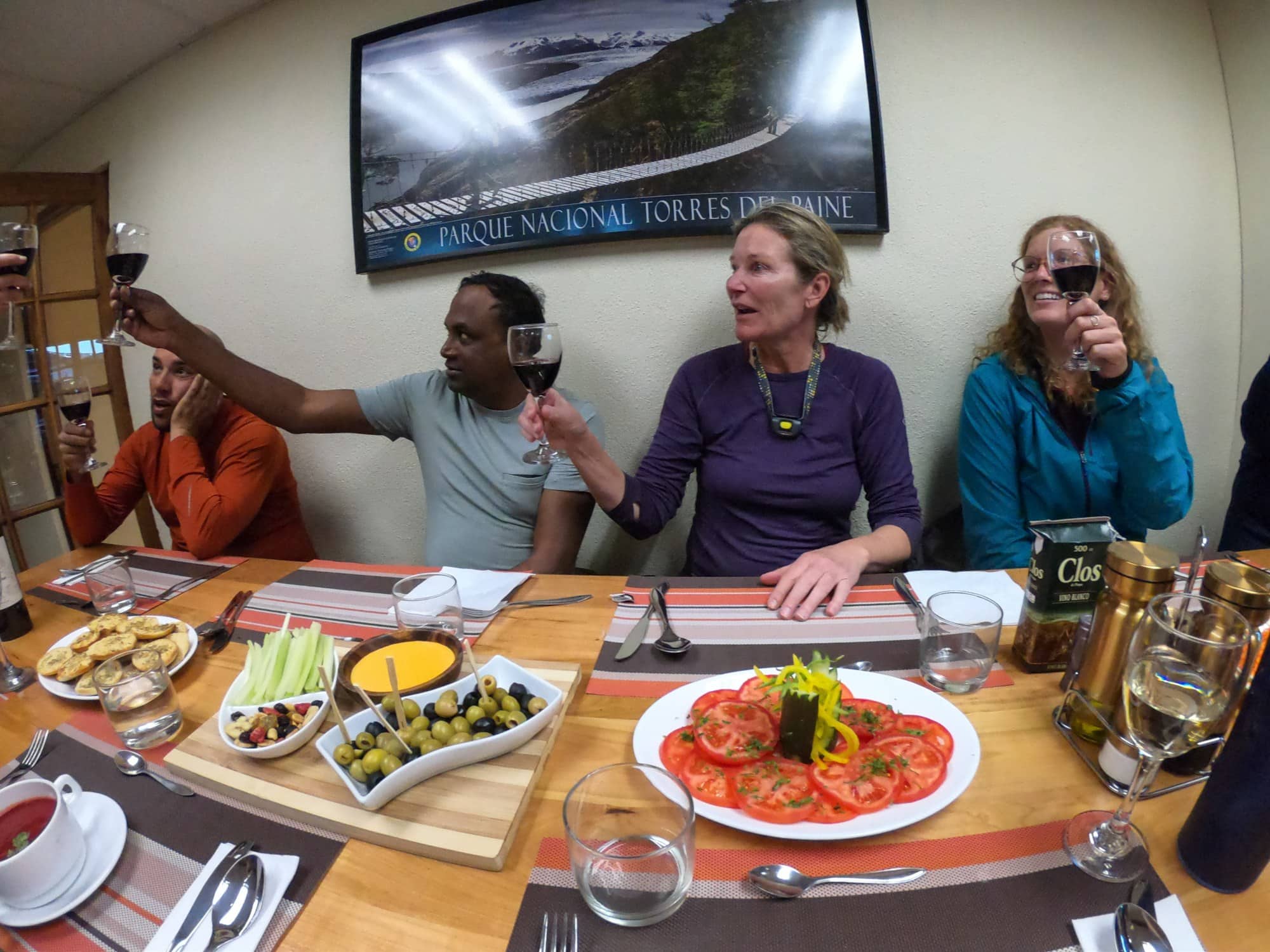
It’s worth pointing out that joining a tour or hiring a guide is the more expensive option; so you have to decide if the logistical conveniences are worth it to you. If you do decide to do it independently, don’t worry about hiking it solo. The trail is very well marked and well traveled, so it would be tough to get lost.
Overall, I thought our G Adventures tour was a great value given how much time and effort they saved us in planning and the amazing experience we had as a group. You can read the full review of my Patagonia G Adventures tour here .
If you do want to do it independently, check out these resources:
- Camping in Torres Del Paine
- 6 Options If You CAN’T Get Torres Del Paine Reservations
- Torres Del Paine Park Information, Fees, and Boat Schedules
Leave No Trace When Hiking in Patagonia
Whether you are traveling with a guide or not, please educate yourself on local Leave No Trace practices. Here’s a quick refresher if you’re a little fuzzy on the most basic (and global!) ethics…
- Anytime you go outside, pack out your toilet paper and don’t go to the bathroom near water sources
- Stay on the trail. Don’t cut switchbacks or take shortcuts.
- Only camp at established campsites (making your own campsite in Torres Del Paine is prohibited)
- NO CAMPFIRES OR BURNING TOILET PAPER (there was a huge fire recently that burned a huge portion of the park).
- There is also no smoking allowed on the trail.
- Make sure you secure your trash when you are eating. It is very windy in Patagonia and if you leave a wrapper sitting on your pack while you eat, there is a good chance it will blow away.
- Pack out all of your trash, and don’t leave your food trash in refugio bathrooms. It’s much easier if everyone just takes the trash they produce back with them to Puerto Natales and disposes of it there.
- Leave wildlife alone. If you are lucky enough to encounter wildlife, don’t approach or feed them.
- Yield to uphill hikers and be friendly . This is a world-famous hike and it’s important to share it and practice good trail etiquette.
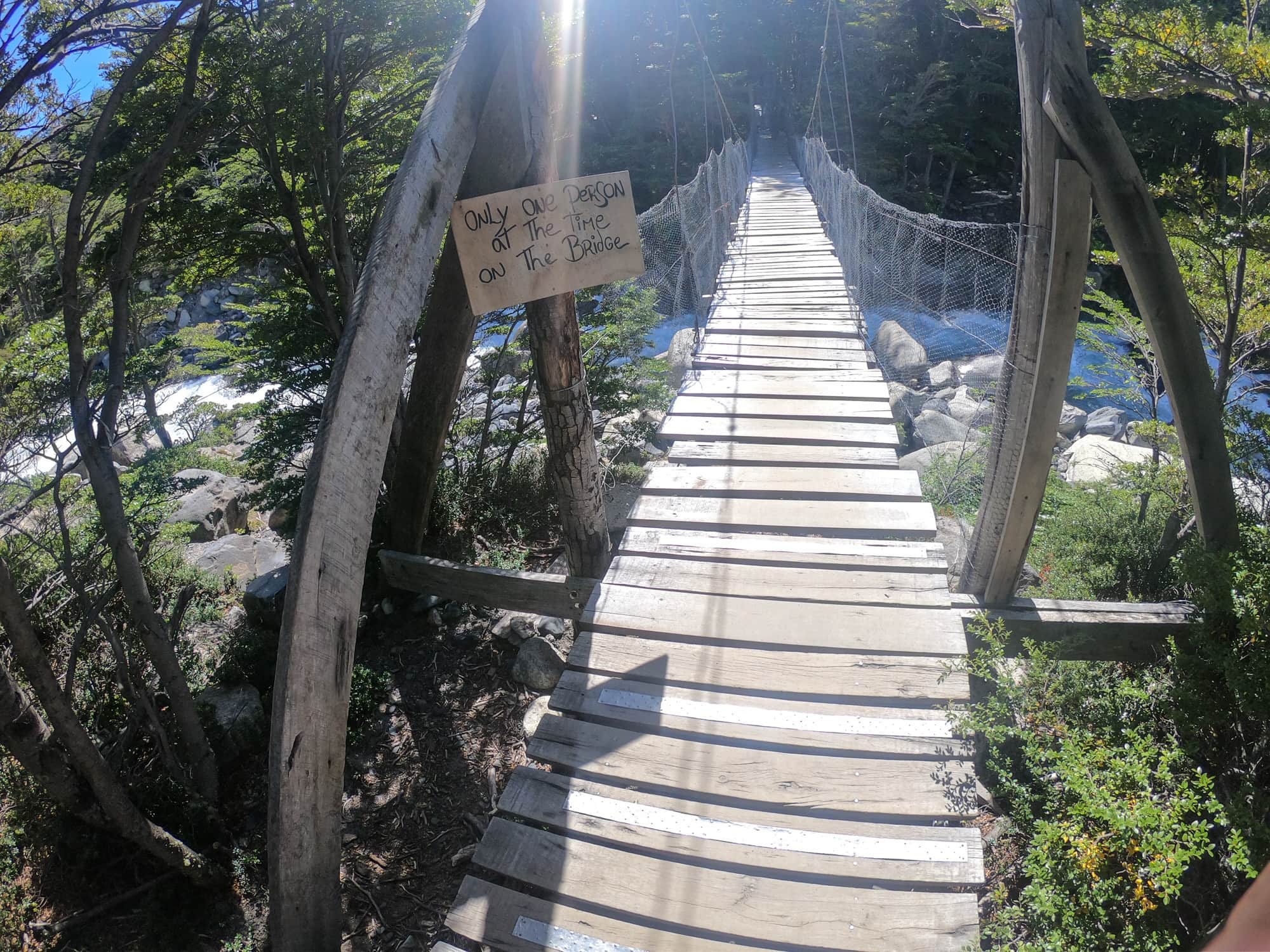
Best Time to Hike the W Trek
The W Trek can be hiked year-round (including winter with a guide). The busy season is December through late March. This is the warmest time of year, but also when you’ll experience the strongest winds. April is Patagonia’s fall with beautiful bursts of colors, while November is Spring when you’ll encounter wildflower blooms. No matter when you go, you should always be prepared for crazy weather.

What Gear do you need to hike the W Trek?
I wrote up a detailed W Trek gear list that you can check out here.
On our tour, G Adventures provided sleeping bags, tents, and sleeping pads. The tents and pads were already set up at each site so all we had to do was unpack our sleeping bag. We were given a small dry bag for all of our clothes and personal belongings for camping. Both that and our sleeping bag were put in the dry bag and transported for us each day to the next campsite. All we had to carry was lunch, water, camera, and extra layers in our day packs.
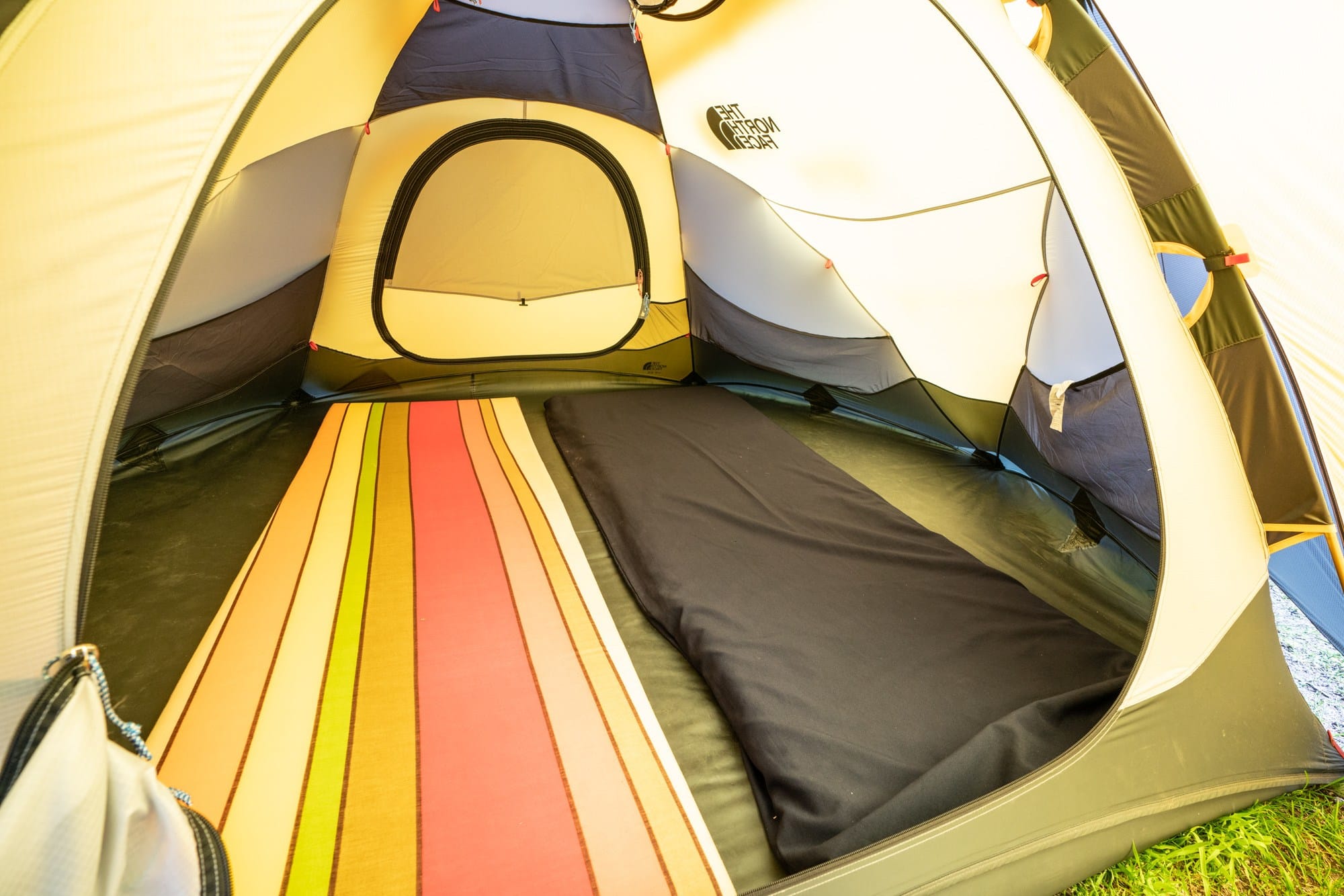
If you are hiking independently and need to carry all of your own gear, make sure you bring a backpacking pack that you’ve worn before . Since the summer season in Patagonia is known for the high winds, a rain cover might be ineffective in wet conditions, so in rainy condition, line your pack with a trash bag and then pack all of your stuff in that. Your tent also needs to be very solid and bring plenty of guy lines and stakes to secure your tent in high winds.
Aside from the windy conditions, it was hotter than I expected and I wish I had brought shorts. Pack layers with everything from warm to cold layers so you’re prepared for any kind of weather.
A half-buff is also helpful. A trick we learned from our guides is to use the buff as a headband over your hat so it prevents your hat from flying off in the wind.
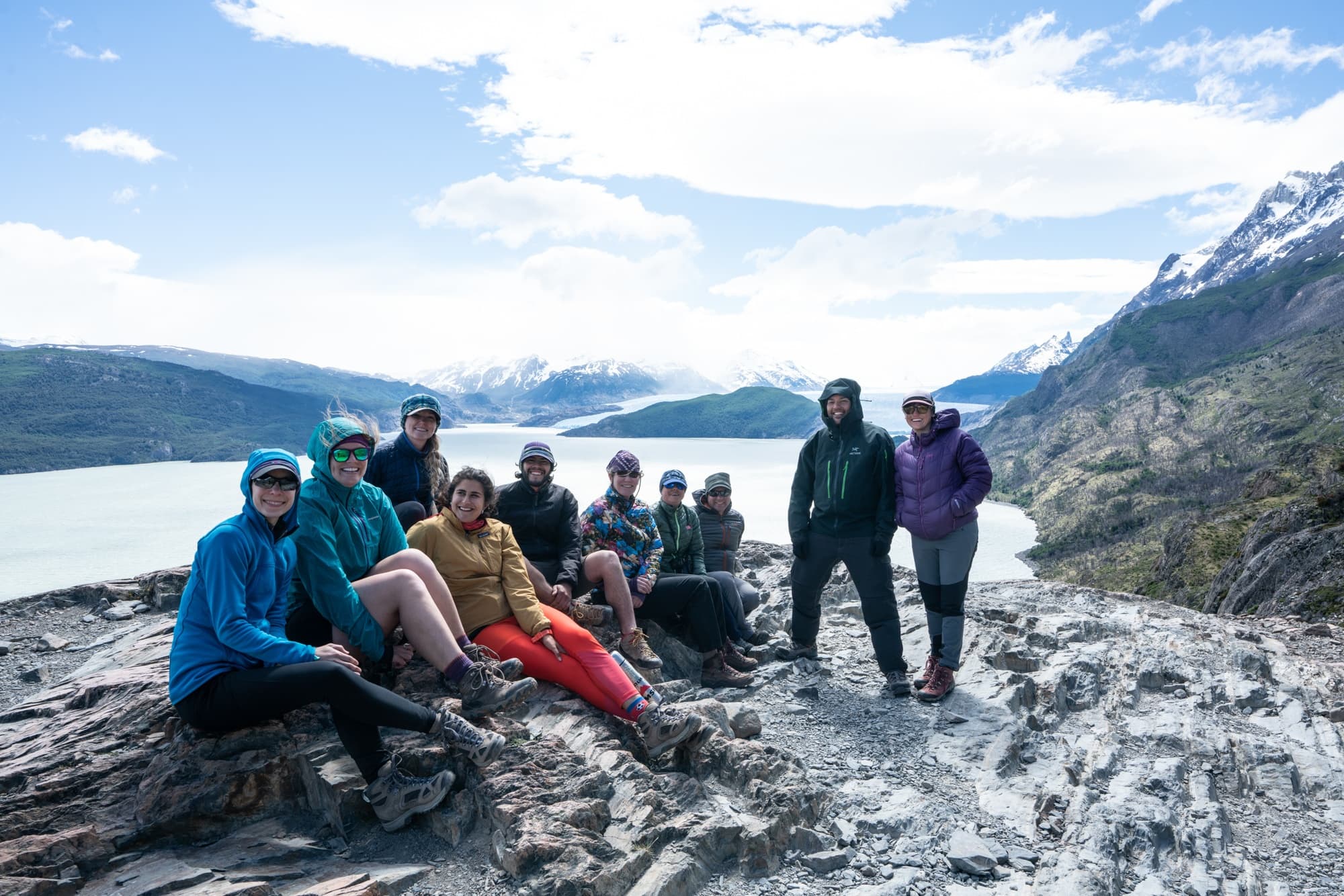
In addition to the clothing, I’d recommend bringing a portable water purifier, like a Steripen or a Grayl water bottle. I did drink unfiltered tap water and water right out of streams, but I’d bring a purifier just to be safe.
If you want to eliminate the need for heavier camping gear, the Refugios also offer rooms for rent.
My W Trek Itinerary
[bulleted_list icon=”fa-info-circle”]
What direction should you hike the W Trek?
[/bulleted_list]
On our trip, we hiked the W Trek a little out of order (roughly from East to West) which was due to the way G Adventures arranged for our bags to be transported. On Day One , we hiked out and back to the base of the Towers (the famous spiraling granite towers) so the bags could stay put. The second day , we took a ferry to Refugio Paine Grande, dropped our bags, and hiked another out and back to Gray Glacier.
On Day Three our bags were transported by boat, while we hiked from Refugio Paine Grande to the French Valley, ending at Refugio Los Cuernos.
On Day 4 , our bags were transported by horseback to our finish line back at the Base of the Towers trailhead.
Although we did hike the W Trek in a slightly different sequence, it seemed a little easier than the opposite direction. I liked that we hiked the busiest day first because every day after that got less and less busy. That said, there are many different ways to hike it, so get familiar with the map and different locations. If you go independently, it’s important to understand that your itinerary may be determined by campsite availability.

How many days do you need to hike the W Trek?
We hiked the W Trek in four days and three nights . The hike to the Towers and the French valley were pretty long days, but the other two were fairly mellow and I thought the days were planned well.
Some people take five days and take a boat out to Gray Glacier Refuge and start there. Taking 5 full days would also allow you to take a little more time and hike farther up into the French Valley.
Is it worth purchasing meals at the refugios on the W Trek?
Meals may seem expensive but remember that you are in the middle of nowhere and getting your meals through the refugios means you don’t have to carry four to five days worth of food on your back.
We were given lunch boxes each day by the refugios which consisted of a large chicken salad sandwich, cookies, fruit, trail mix and a piece of chocolate. Plenty of food to energize you for the day. Overall, I thought dinners at the refugio were better than the breakfasts which matters since you can purchase meals ala carte.
[images_2_col image_1=”35446″ image_2=”35383″ /]
To give you an idea of prices independent travelers paid at the time of my hike:
- Refugio Paine Grande: $55 US for dinner, breakfast, and a boxed lunch (not including accomodations or camping)
- Refugio Los Cuernos: $80 US for dinner, breakfast and a boxed lunch / $115 US for a fully equipped campsite (with a tent, bag, and pad rental) and all meals
- Nash Patagonia Lodge: $29 for dinner / $112 for a fully equipped campsite and all meals
Note that Patagonia is very remote, lodging and food options are limited, and prices reflect that.
[separator style_type=”double” /]
Day 1 – Hiking to the Base of the Towers (12 miles)
This is a very busy trail so be prepared for crowds and a steep uphill climb. At times the congestion made it feel like Disneyland, as a line formed hiking up the mountain. The lake was beautiful but this was honestly my least favorite day of the hike due to the crowds. We hiked on Sunday, so maybe it’s less busy mid-week?
Once you’re about 30 minutes from the trailhead, the trail starts climbing and doesn’t really quit. Make sure you pack plenty of water, as there isn’t a place to fill up until you reach a river crossing at Refugio y Camping El Chileno.
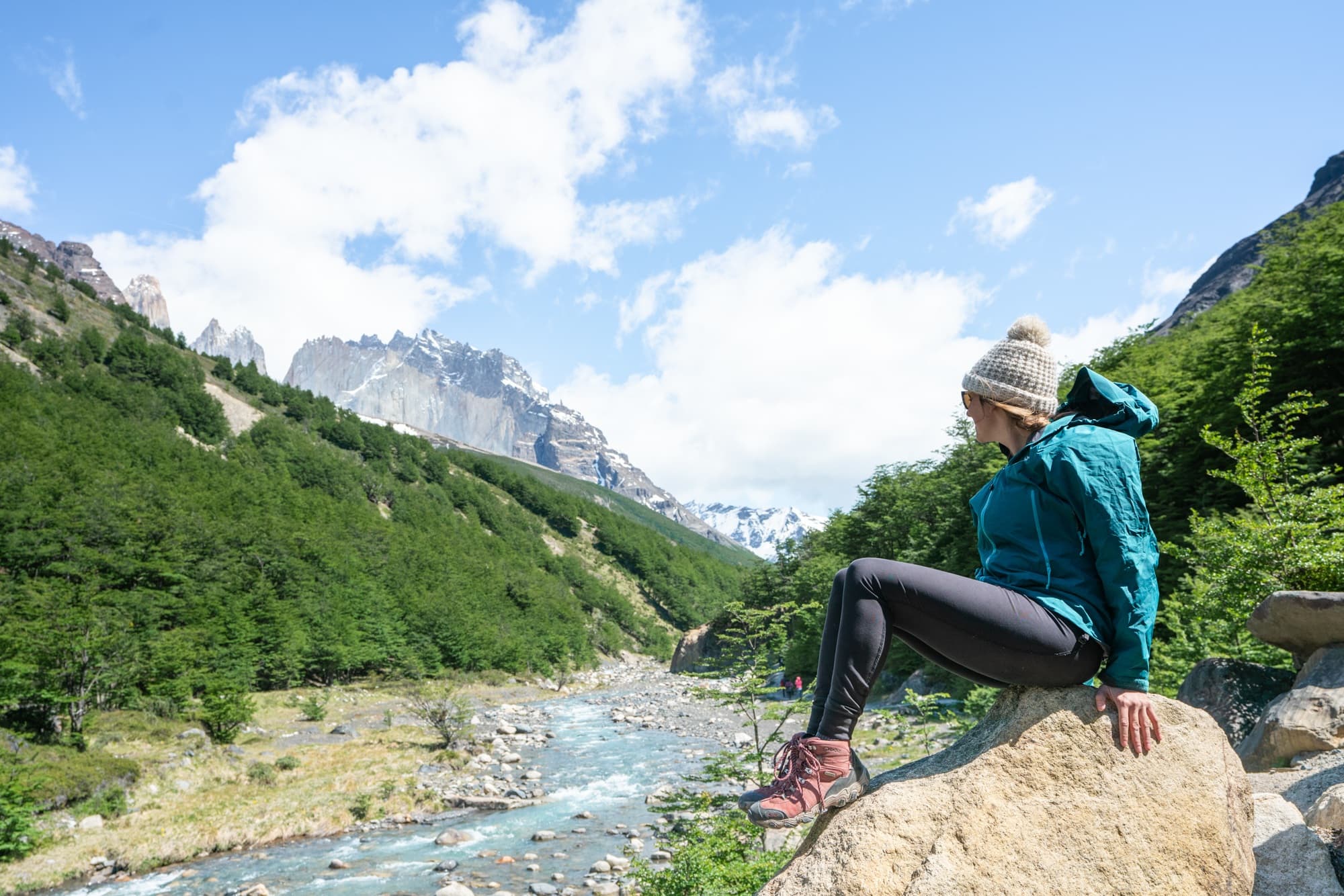
I will say that the lake is one of the prettiest lakes I’ve ever seen. Just set your expectations for crowds, or get a very early start to try and beat them. If you are doing the trek independently you could try to get a camping spot at the refugio which would allow you to hike to the base of the towers for sunrise.
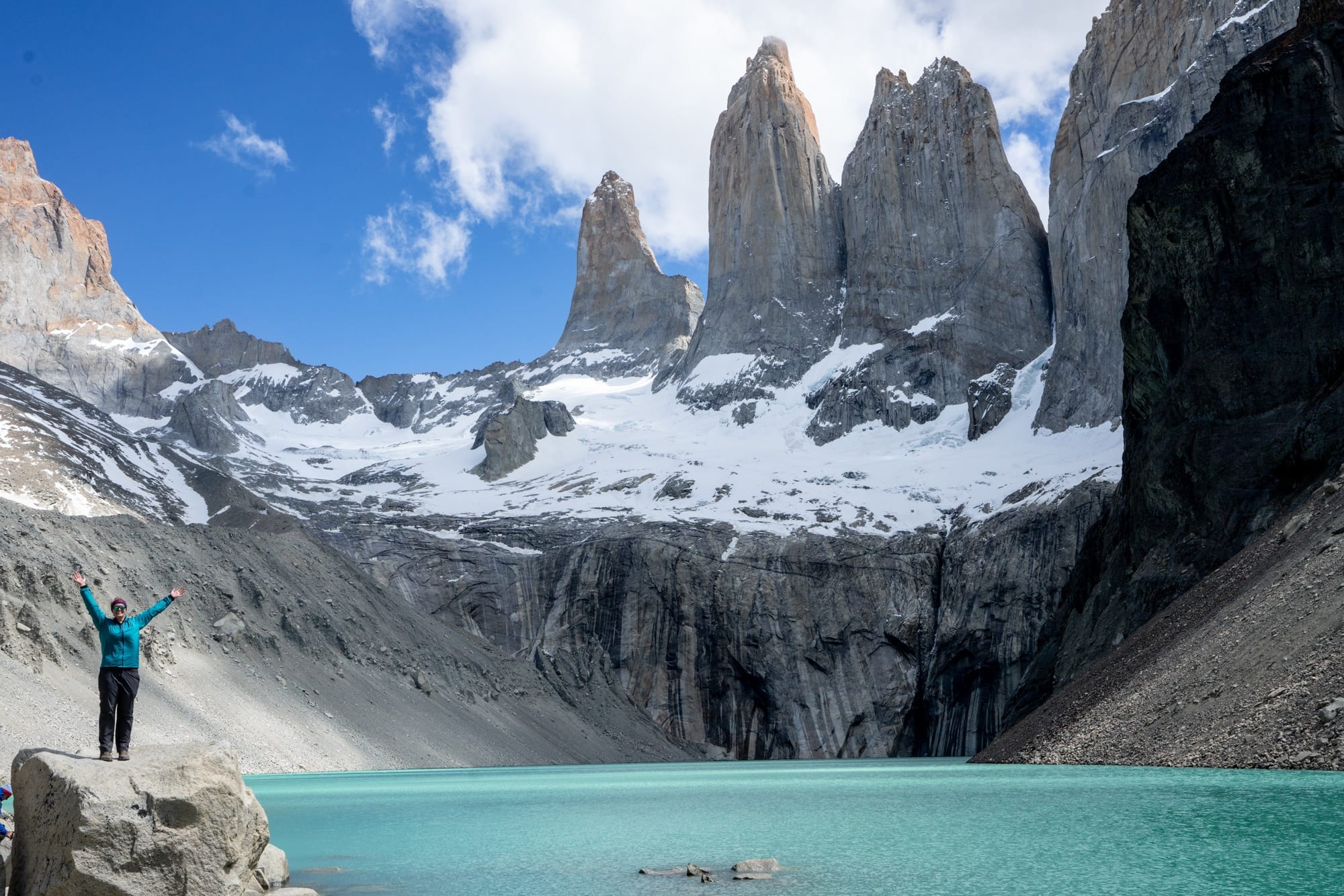
[bulleted_list icon=”fa-bed”]
Camping Night One
G Adventures booked out an entire campsite on the Serrano River called Nash Patagonia that we stayed on the first night. The campsite is just on the outskirts of the park with the friendliest staff of all of the refugios we stayed at. The drive to that campsite, while it may look long on the map, took only an hour and a half and was absolutely gorgeous. The drive was a way to get a feel for other parts of the park. The campground only had one other G Adventures group so it was very quiet with gorgeous views. We had a tasty group dinner with braised beef and vegetables.
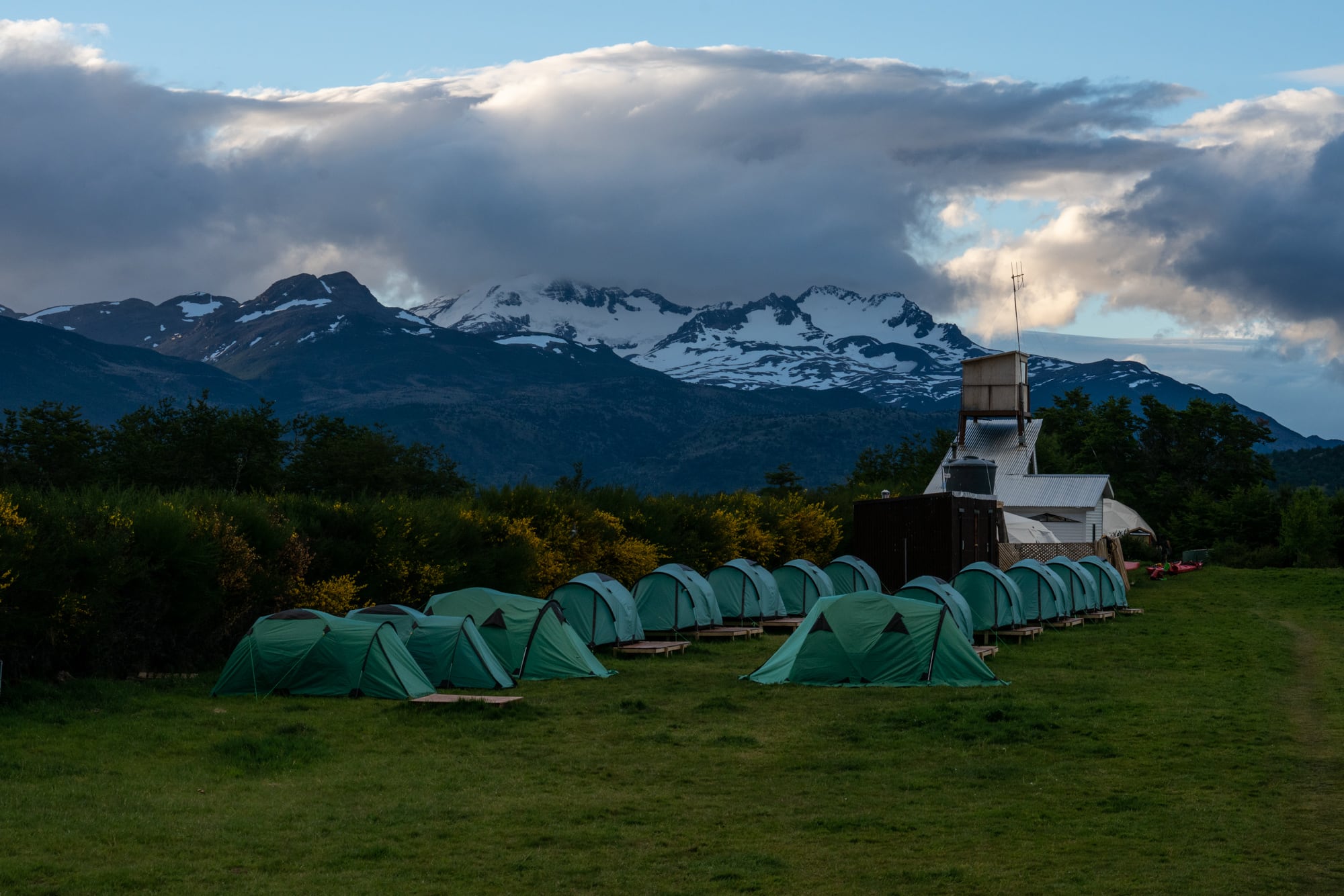
Day 2 – Refugio Paine Grande to Grey Glacier Overlook and back (7 miles)
The next morning we drove back into the park and took the 30-minute catamaran ferry across Lago Pehoe where we arrived at Refugio Paine Grande . On the G Adventures tour, our guide had reserved tents and sleeping pads that were already set up and waiting for us at each campsite. That way it was less for us to lug around on the hike.
[images_2_col image_1=”35399″ image_2=”35391″ /]
Day 2 to the Grey Glacier was a much more mellow hike than Day 1 that takes you over a ridge, past a Laguna Los Patos), and around the shoreline of Lago Grey. Eventually, it reaches a lookout with beautiful views of the Gray Glacier. If you want to get closer, you can keep walking all the way to Refugio Gray, which ends up being 13 miles round trip from Refugio Paine Grande.
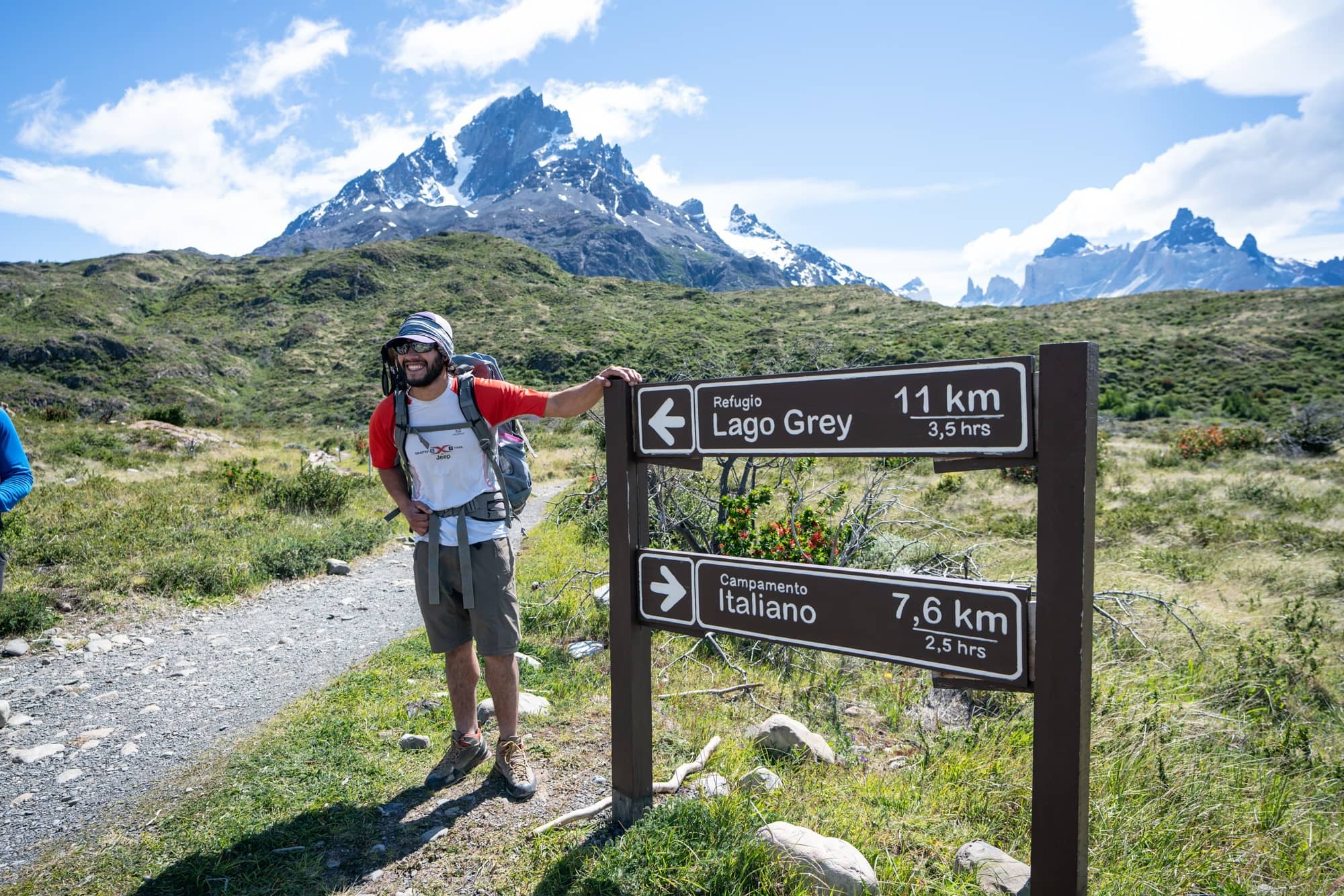
You’ll note from the map that on day two that we didn’t hike all the way to the Gray Glacier and only went to the lookout. I was satisfied, but I do think with a quicker pace, it would have been possible to hike all the way to the Gray Glacier and back. Alternatively, you can also arrange to take a boat to Refugio Gray and start your W Trek hike from there.
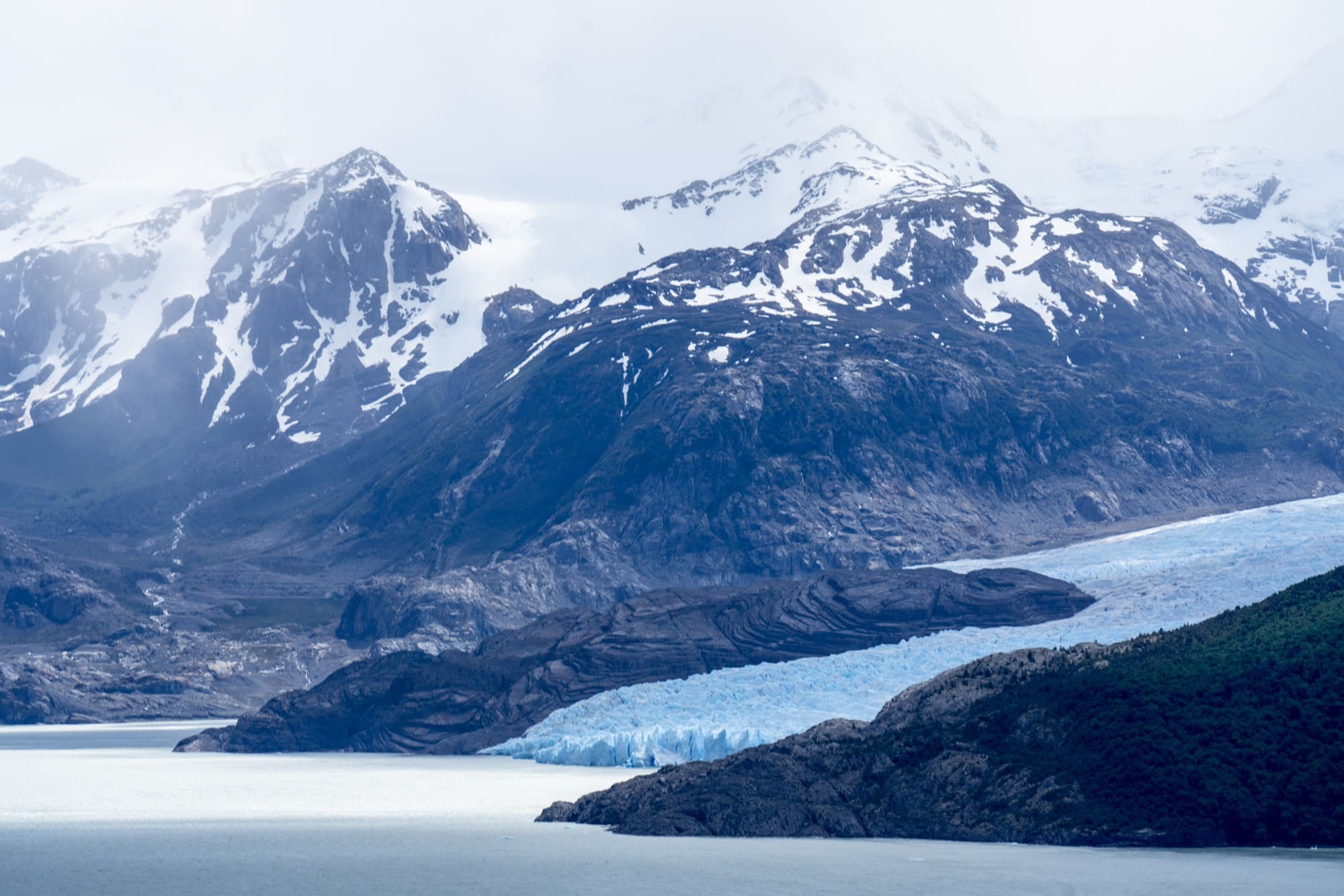
Camping Night Two
We stayed at the Refugio Paine Grande where there were hundreds of people camping and gorgeous views. Dinner is served cafeteria-style and was my least favorite food of the W Trek. Dinner times are assigned so you should get in line a little early. Good news is that you can cook your own food in a separate cabin if you want to bring your own food. There’s also a bar upstairs with beer and place to hang out. Hot showers were available at certain times of the evening.
[images_2_col image_1=”35388″ image_2=”35385″ /]
Day 3 – Paine Grande to the French Valley to Refugio Los Cuernos (11.5 miles)
On our third day of hiking the W Trek, the views from the trail were non-stop. First, you pass Lake Skottsberg, and there are a few different rocky outcrops that make for a good snack break.
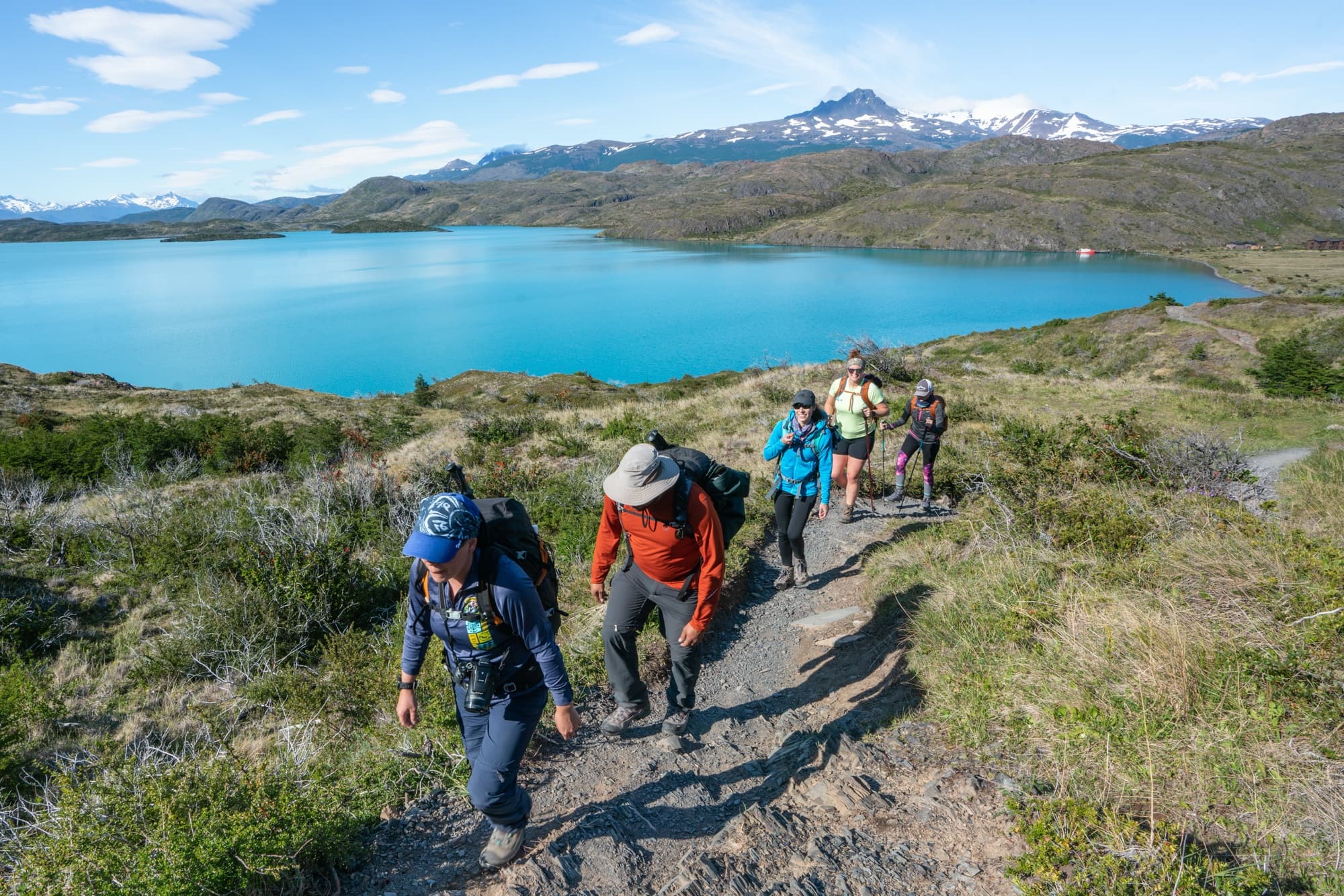
Next, you’ll hike through a burn area and eventually arrive at the Italiano campsite. Here you hang a left and start hiking up towards French valley. This is steep but didn’t feel as steep as the Base of the Towers hike and also had the bonus of way less people. The French Valley offered my favorite views from our entire time hiking the W Trek, and just past the main overlook, there is a nice lunch spot on the river where you can watch avalanches breaking off the glacier. You are also right under the Horn which is one of the famous peaks in Torres Del Paine.

On day 3, we only hiked to the French Valley (Mirador Frances) lookout but the trail continues quite a bit farther back to the Mirador Britanica. Our guides told us this was very difficult, and we still had 2 hours of hiking once we got back down to the Italiano campsite to reach Refugio Los Cuernos where we would be camping.
If you want to hike all the way to Mirador Britanica, you should consider starting or ending at the Italiano campsite and get a very early start. We heard this is one of the most beautiful and isolated areas of the park and would probably recommend five full days for the W Trek if you want to go to the very back of the valley.
Camping Night Three
This campsite was the Refugio Los Cuernos and also my favorite campsite. The refugio is located right underneath the Horn and had a beautiful beach with a great place to enjoy a beer from the bar. Luckily, there were clean, hot showers to boot. The dinner here was also my favorite spot. On the menu there was a hot soup, bread, braised beef with mashed potatoes, and a dessert.
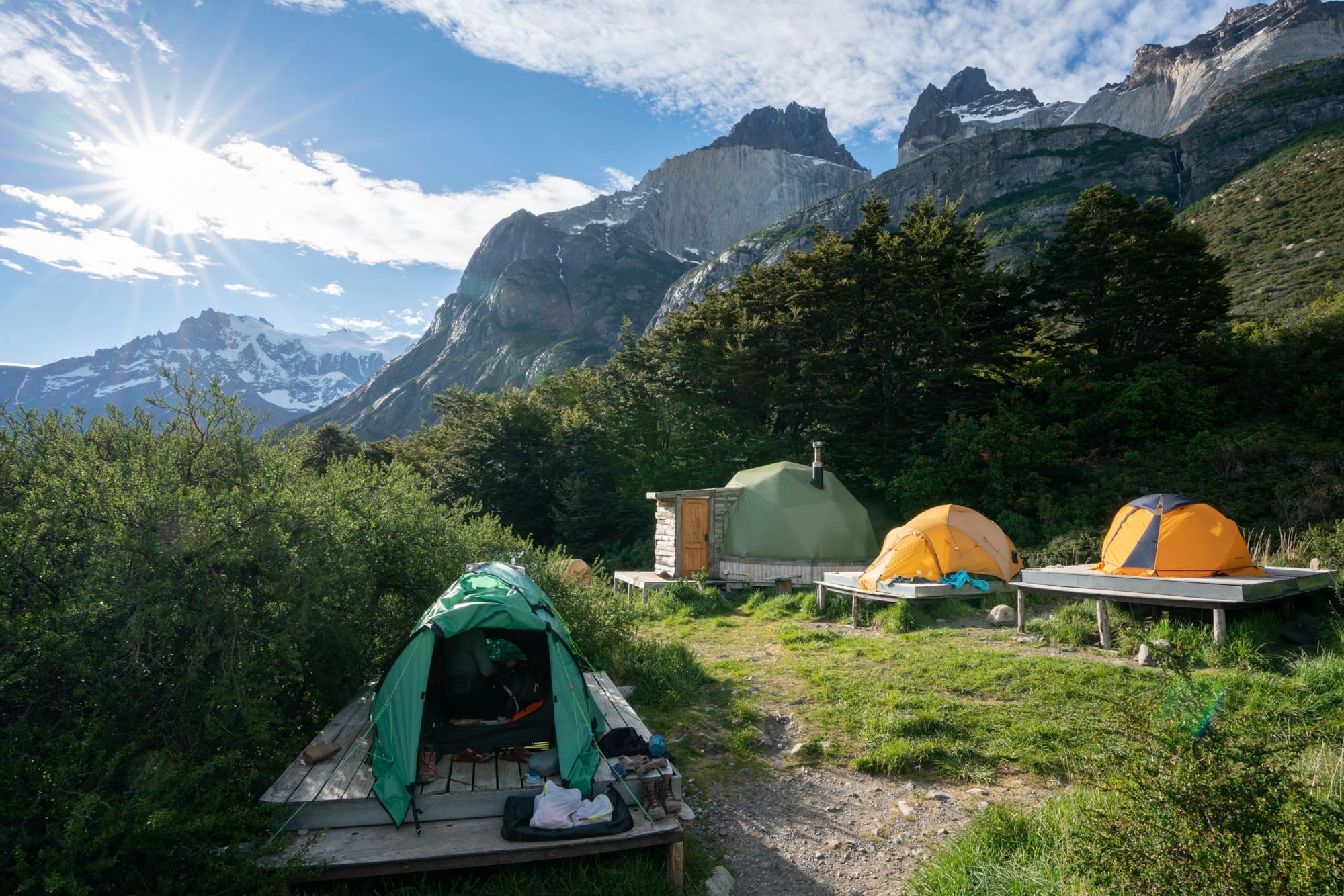
Day 4 – Refugio Los Cuernos to Hosteria Los Torres and back to Puerto Natales (7.5 miles)
This was a mellow morning and breakfast consisted of toast, eggs and coffee. Our day was fairly short so we were able to take our time and enjoy the scenery. There were lots of beautiful flowers in bloom and we hiked along Lake Nordernskjold the entire day so we had non-stop views. In total, it took us about four hours.

[images_2_col image_1=”35373″ image_2=”35374″ /]
Since we had a shorter day on the trail, we stopped at the last spot with a view of the lake, where we enjoyed lunch and some mate tea.

When we got back to our Day 1 starting point, our driver was waiting for us at the end to take us back to Puerto Natales where we grabbed pizza with our guides at the basecamp.
What questions do you have about hiking the W Trek in Torres Del Paine? Leave us a comment below!
[content_box title=”Read Next”]
4 Day El Chalten Itinerary
40 best gifts for outdoor lovers, planning your everest base camp trek, backpacking lake clark national park with alaska alpine adventures, g adventure hiking patagonia group tour review.
[/content_box]
Some of the links in this post are affiliate links. That means if you make a purchase, I make a small commission at no added cost to you. I only promote products I use and love, and your support helps keep the wheels turning at Bearfoot Theory. Thanks!
Related Posts

With two decades of hiking and seven years of van life under her belt, Kristen has dedicated her life to helping people experience the positive effects of nature. As a pioneer in the outdoor blogging space, she founded Bearfoot Theory in 2014 and has since authored more than 350 blog posts about outdoor travel, hiking, camping, and van life. Her work has been featured in National Geographic, Outside Magazine, and Backpacker, and when she’s not on the road, she lives in Park City, Utah with her partner Ryan, their son, and two adventure pups.
Leave a Reply Cancel reply
Your email address will not be published. Required fields are marked *
Save my name, email, and website in this browser for the next time I comment.
Awesome post. I appreciate your time and effort in your work. Keep posting..
Hi Kristen,
Thank you for your blog. I’m curious, when did you hike the W Trek? I have booked campsites for the second week in March and am hoping for some early Fall foliage on our visit.
Hi Rachel – Kristen hiked the W trek in November which is spring in Patagonia. I realize that you may have had to change your travel plans, but when you do make it to Patagonia, Fall begins in mid-late March so you just might catch some of that early Fall foliage you’re looking for if you go that time of year. Best of luck!
I’m looking for a guide to go with a small group in December 2021. Recommendations? Thanks!
There are a lot of great tour operators in Patagonia. Kristen’s group trip was with G-Adventures and she had a great experience. You can read more about it here: https://bearfoottheory.com/g-adventures-review-hiking-patagonia-in-depth/

W Trek: Alternative

W TREK CAMPING
Torres del Paine National Park, Patagonia Chilena
The 'W' trek is the name given to the W shaped beaten track that interlinks the 3 Granite Paine Towers, the French Valley, and the Grey Glacier. The trek is approximately 70 kilometers (43 miles) in total distance and is one of the most scenic treks in the world. This trek option includes camping along the trail every night. A great option for people looking for the authentic backpacking experience!

Locations: Torres del Paine National Park, Puerto Natales
Group Size: Private groups from 2+
Activity Level: 4-5
Included:
Transfers as stated in itinerary (All included from airport pick-up to drop-off)
Meals as indicated on itinerary (6 Breakfasts, 5 lunches, 6 dinners)
Equipment check and briefing before hike
4 nights camp sites in Torres del Paine National park
Hiking poles and small day pack for day hike to the base of the towers
Tour guide for first day hike to the base of the towers
Health/hospitalization/accident/travel insurance
Gratuities for Venture Patagonia guides
Torres del Paine National Park Entrance Fee: $21.000 CLP ($34.00 USD)
Not Included:

Itinerary Overview:
Day 1: Arrival to Punta Arenas airport, bus to Puerto Natales, welcome briefing
Day 2: Enter Torres del Paine National Park to hike to the famous “Towers” of Torres del Paine.
Day 3: Cruise across Lake Pehoe to hike to the heart of the French Valley.
Day 4: Enjoy sunrise on Lake Pehoe & explore two short hikes to discover new angles of the park
Day 5: Cruise on Lake Grey to view Grey Glacier [Optional ice hike/kayak (additional fee) ]
Day 6: Shuttle back to Puerto Natales in the afternoon.
Day 7: Travel from Puerto Natales to Punta Arenas. Departure flight from Punta Arenas (PUQ) or Bus to El Calafate, Argentina.


The Ultimate Guide to Camping in Torres del Paine
Planning to go camping in Torres del Paine on your trek? Here’s what you need to know.
There’s a reason why trekking and camping in Torres del Paine National Park are becoming increasingly popular each year: this place is stunning.
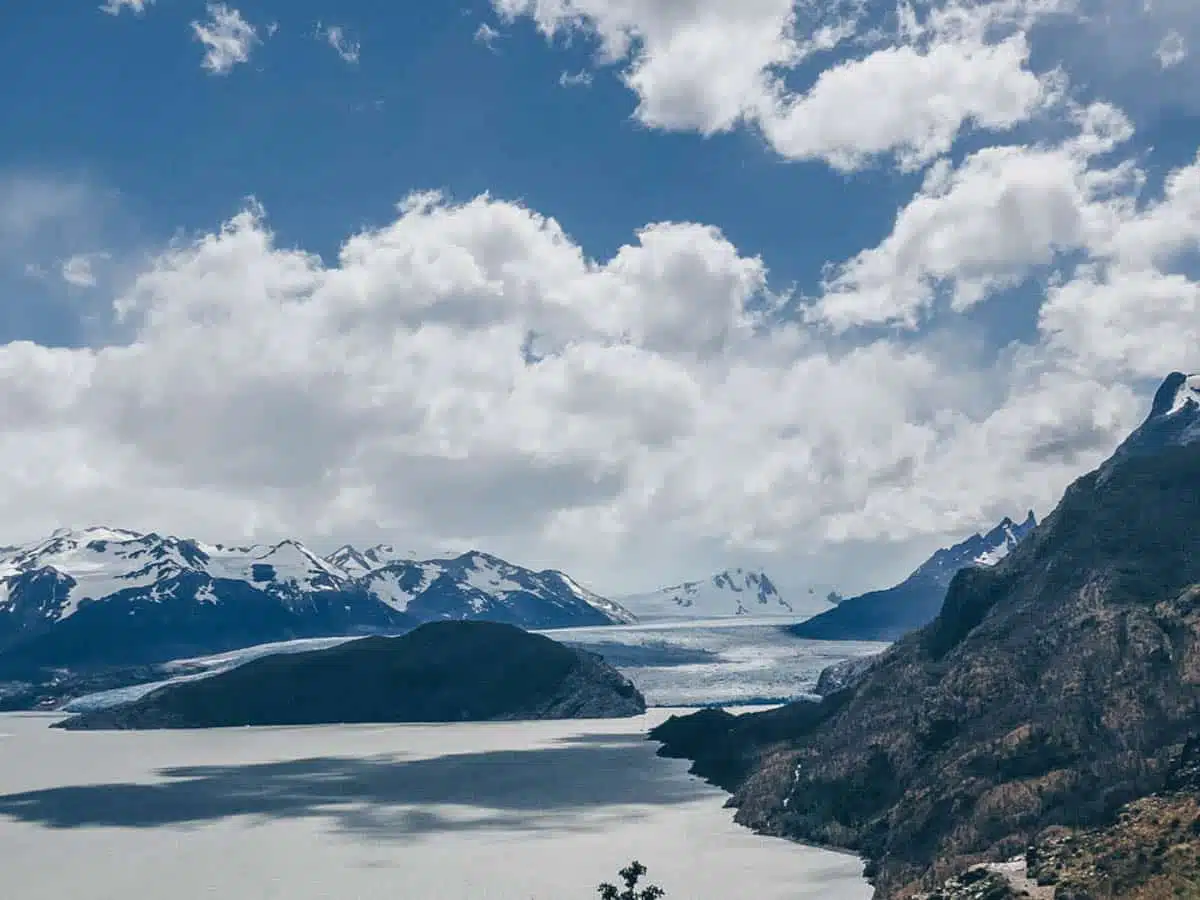
Like the kind of stunning you think is photoshopped, but it’s actually real . And despite the fact that tourist numbers are growing each year, Torres del Paine isn’t any less magical.
In fact, it’s a good thing that more and more people are excited about Torres del Paine, as long as visitors continue to respect the park and follow the rules.
However, the influx of hikers and campers in Torres del Paine means that if you want to visit the park, you need to be prepared and plan your trip far in advance.
Gone are the days of being able to show up at the park and standby at campsites; you now need to have your reservations fully sorted before entry.
If you’re willing to plan ahead, camping in Torres del Paine is an incredible and unique experience.
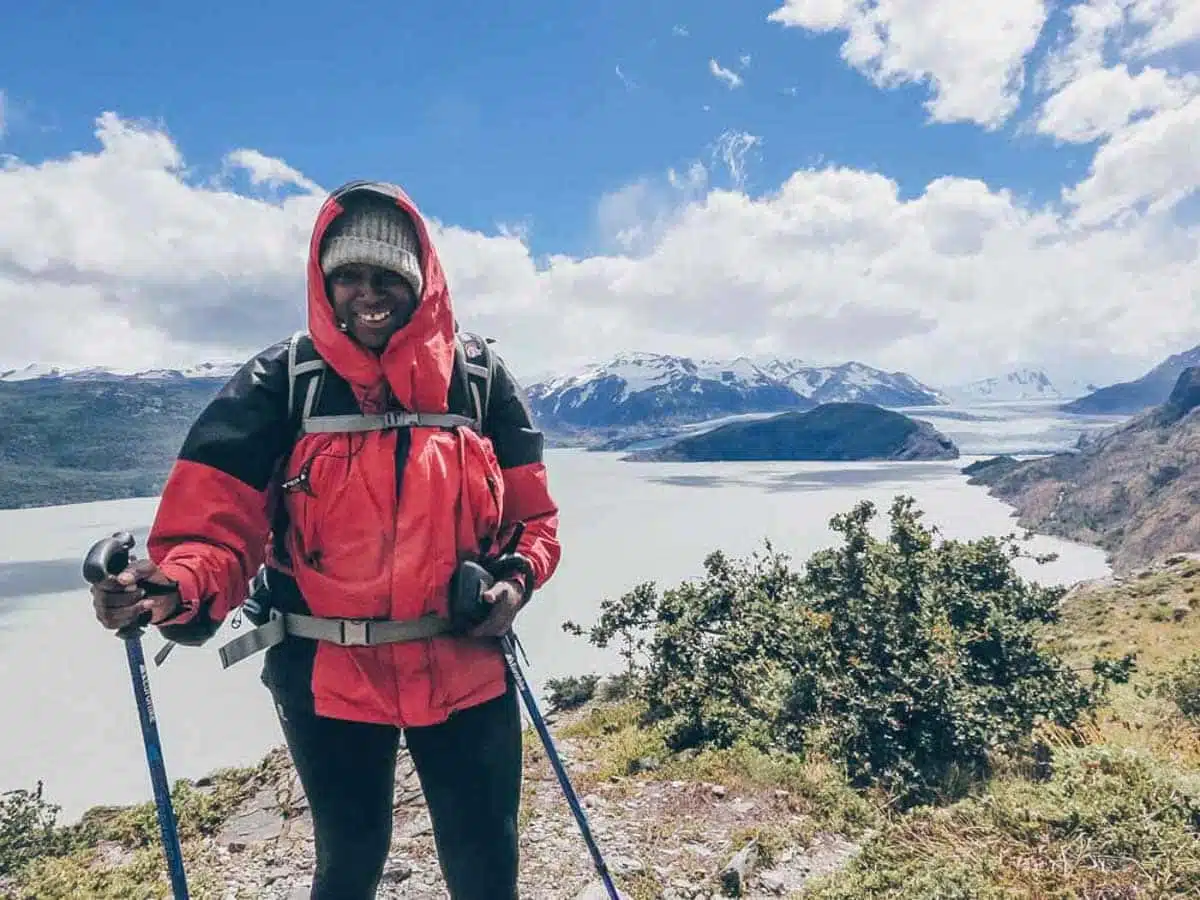
I may be biased, but I think that multi-day trekking is the #1 best way to see and experience Torres del Paine. And, by default, if you aren’t planning on staying in expensive refugios during your trek, you’re going to be camping in Torres del Paine.
Many hikers and visitors were confused and frustrated AF about the systems and processes needed to book campsites in Torres del Paine, so I wrote this whopper of a guide with every last detail you need to know about booking and staying in every campsite in the park.
Hopefully, if you’re reading this right now, you’re ready to plan and book your trip a couple of months in advance. If not, skip ahead to the “what to do if you haven’t booked anything and your trek starts tomorrow” section.
Get out your notebook and pen (or online notebook and keyboard) and get ready for this ultimate guide to camping Torres del Paine! I promise that it’s not as intimidating as it seems if you plan ahead and stay persistent.
Important Things to Know Before Camping in Torres del Paine
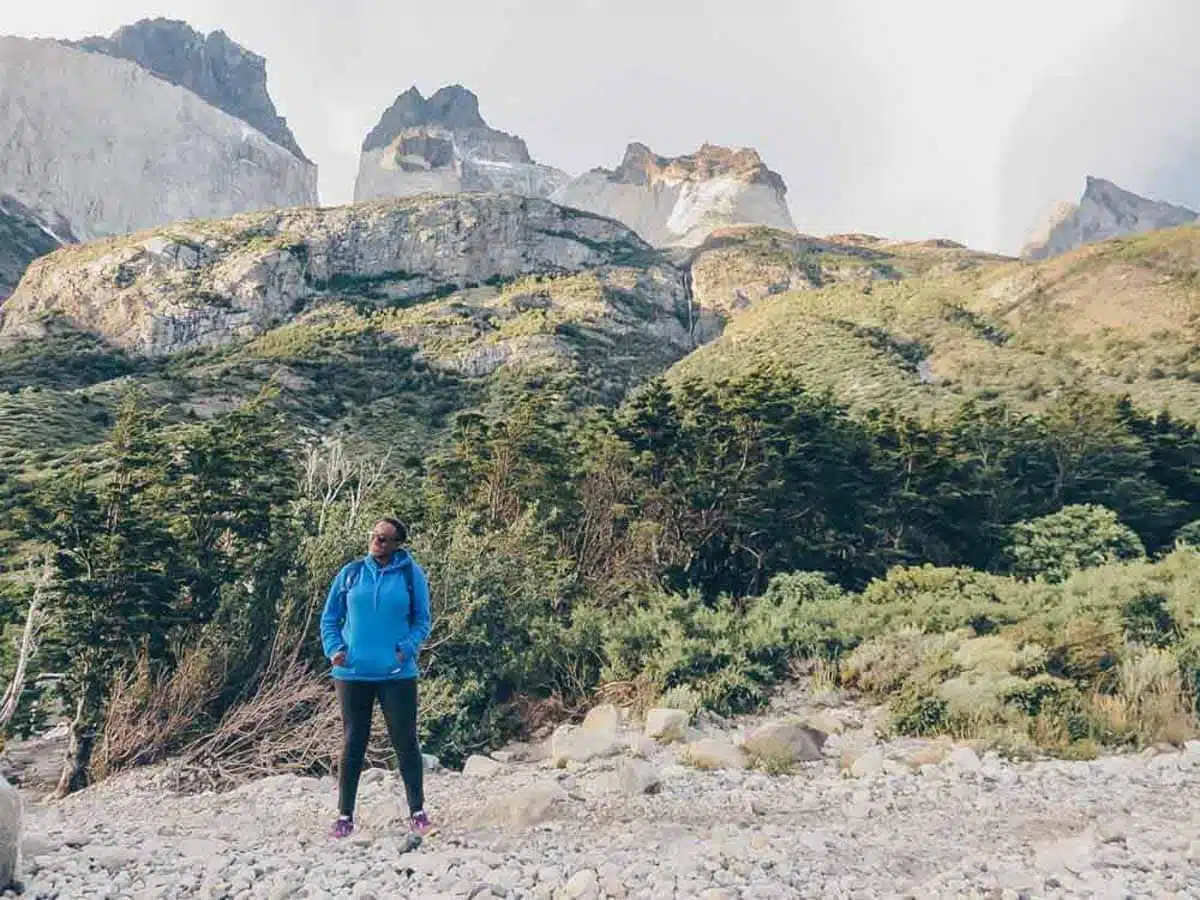
Patagonia’s allure comes from the its majestic mountains and landscapes. One of the best ways to experience this wild beauty is by completely immersing yourself in it.
Camping in Torres del Paine enables you to do just that: pitch a tent, listen to the sounds of the earth, and sleep in the center of this wild and beautiful place.
Travel Insurance
If you’re going to be doing any trekking or adventure activities, we always recommend buying travel insurance before your trip .
I use and recommend WorldNomads travel insurance for all of my international travel – it has literally saved my life and protected me in some very sticky situations.
Do yourself (and everyone who loves you) a favor and buy travel insurance before your trip.
Book Campsites
You MUST book all campsites well in advance. There’s no hard and fast rule for how far in advance you should book, but they do fill up a few weeks or months ahead of time, especially during the high season.
Be sure you make all of your reservations as early as possible in order to ensure your spot.
Don’t Start on a Monday
Try your best to not start your trek on a Monday.
Why? Because virtually the entire city of Puerto Natales is closed on Sundays, meaning if you need any last minute equipment, food, etc., you might be SOL.
Additionally, some of the camping companies and bus line offices are closed and you won’t be able to schedule anything with them if you’re there on a Sunday.
Go to the Erratic Rock Talk
Attend the 3 o’clock talk at Erratic Rock Hostel . This is a daily orientation to the park run by experts, which goes over the trekking routes, what to bring, weather conditions, and a long Q&A session.
Solo trekkers can meet up with others to coordinate their trek and sync up with other solo hikers.
Be Prepared for All Kinds of Weather
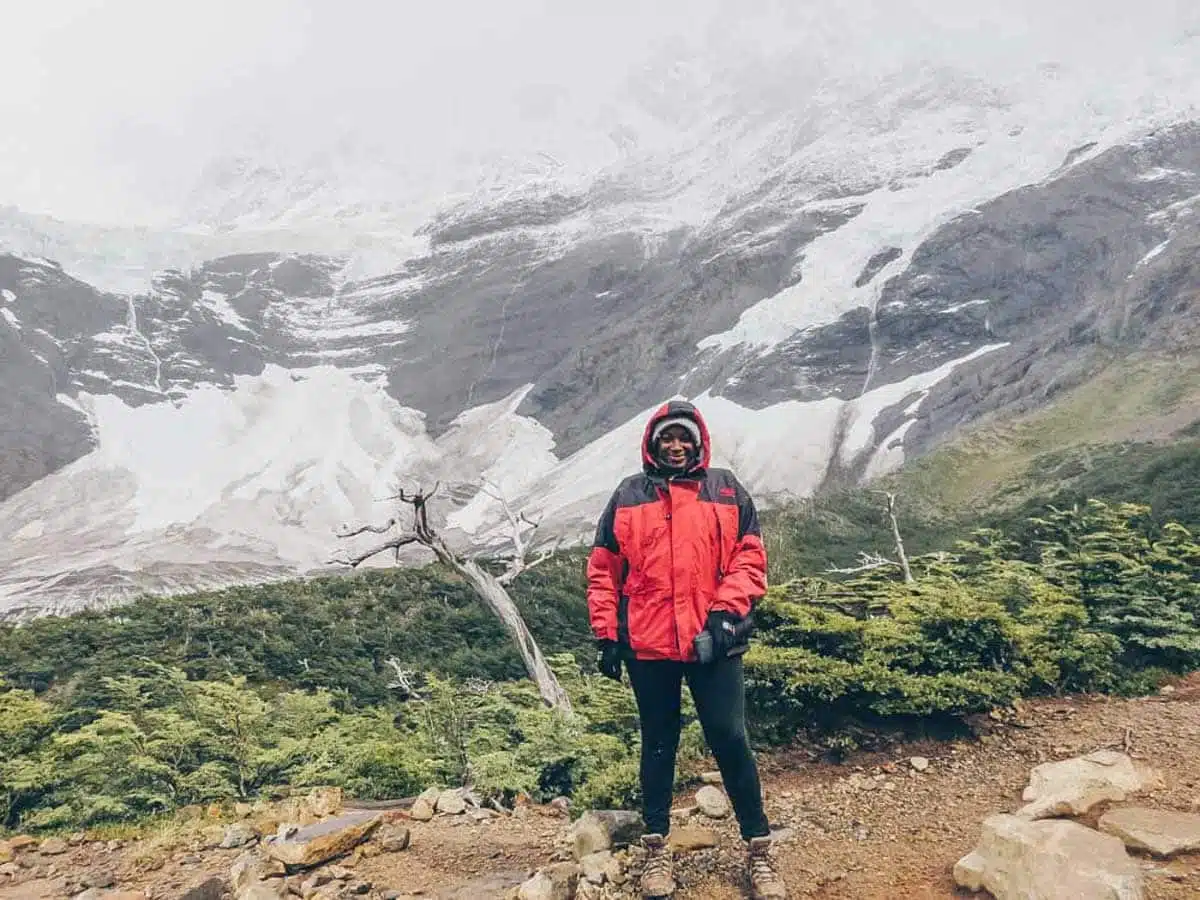
The weather in Torres del Paine is super unpredictable. I went camping in Torres del Paine for the first time in November, the “off season,” and the weather was literally perfect.
I went again in February, the “high season,” and the weather was awful.
No matter what, bring LOTS of waterproof equipment and plastic bags to keep your important items (e.g., sleeping bag, clothes, sleeping mat) dry in your bag.
Protect Your Gear
Protect your gear and food from wildlife. My boyfriend had his bag chewed through by hungry field mice on the very first day of our O Trek. The mice smelled his SEALED bag of walnuts and attacked while we were sleeping.
Aside from mice, condors, pumas, and foxes are also problematic in Torres del Paine – be sure to store your food properly and avoid putting anything scented inside your backpack or tent!
When to Go Trekking & Camping in Torres del Paine
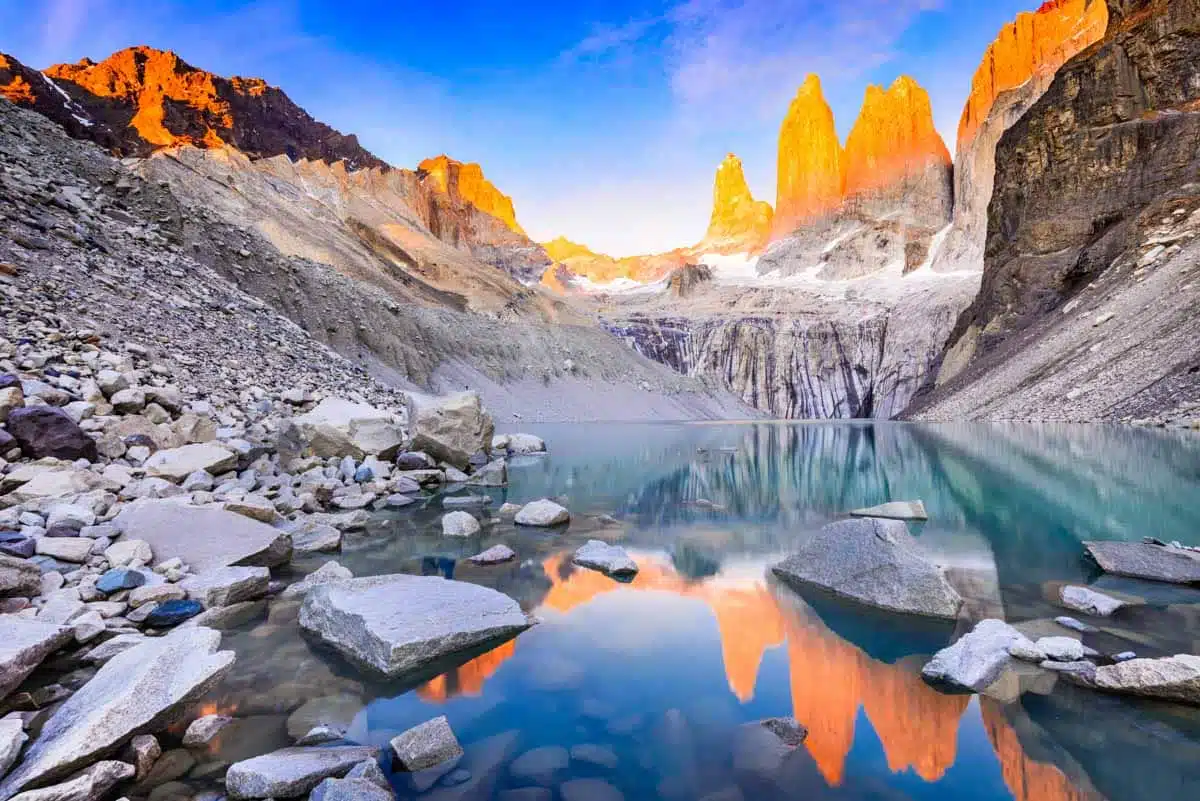
Whether you’re tackling the W Trek or the longer O Trek, choosing the right time of year to go is critical for planning a memorable and safe trip.
Summer in the Southern Hemisphere lasts from late November through February, with the warmest months in December and January.
Pro tip: Most trekkers visit Torres del Paine during the height of the Chilean summer – December through February. However, I heard from several local sources in Patagonia that in recent years, the mildest weather has occurred in November and early March.
In my own experience, the weather in November was much, much more stable and beautiful than when I returned in February. This is totally anecdotal advice, however, so don’t assume that every trip will be this way. Take it or leave it…
When to Go Hiking & Camping on the W Trek
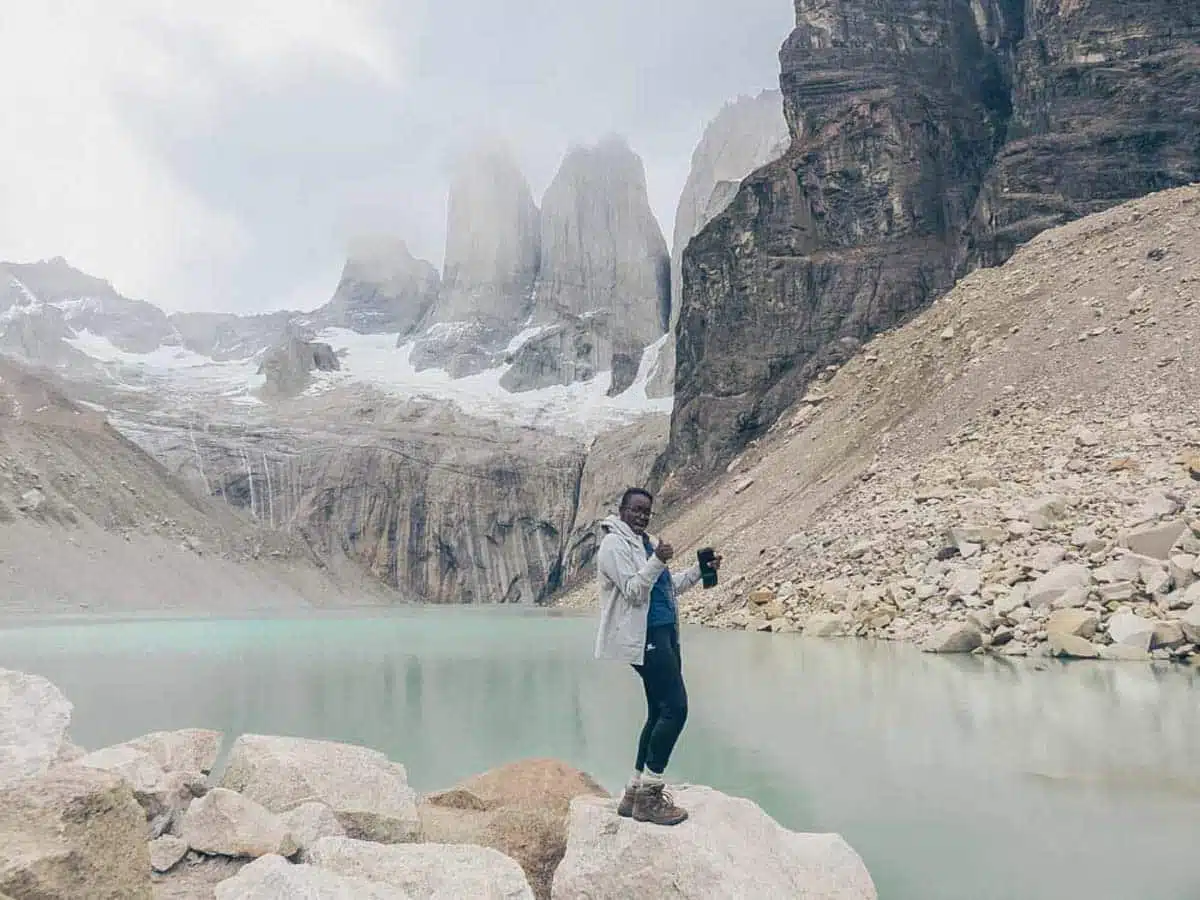
As Torres del Paine’s most popular trekking route, the W trek is open year-round to trekkers. The high season for this 4-5 day trek is from October to the following March. During this time, the trails and campsites are fully open to hikers.
During the summer, you definitely don’t need a guide for the W Trek. The trails are clearly marked with signs and well-maintained pathways.
There are also several other hikers around at all times, and you literally cannot miss the campsites when you pass by them. I hiked the W solo in November of 2016 (without a guide) and had no problems syncing up with fellow hikers or navigating around the trails and campsites.
If you opt to visit Torres del Paine in the winter, however, you’ll need a certified trekking guide to be able to enter the park.
During this time, weather conditions can be variable and downright hostile, but if you are brave and willing to stick it out, you can do a guided W Trek in the winter and stay in the refugios along the way.
When to Go Hiking & Camping on the O Trek
The O Trek is only open during Chile’s summer months – mid-November through mid-April.
This is because the backside of Torres del Paine is a lot more remote and inaccessible than the W trek, and the weather conditions back there can be much more volatile. Outside of these months, the O Trek areas are closed.
There are mixed recommendations for when the best time to do the O trek in Torres del Paine is, but I recommend going in late November or December. However, even during high season, you still may experience cold, wet, or windy conditions.
When we did the O Trek in February, we experienced beautiful, sunny weather on some days and ice, sleet, rain, and high winds on others.
Needless to say, it was beautiful, adrenaline-inducing, and terrifying all in one. But that’s what makes for some the best travel experiences, right?

What to Bring on a Torres del Paine Camping Trip: The Basics
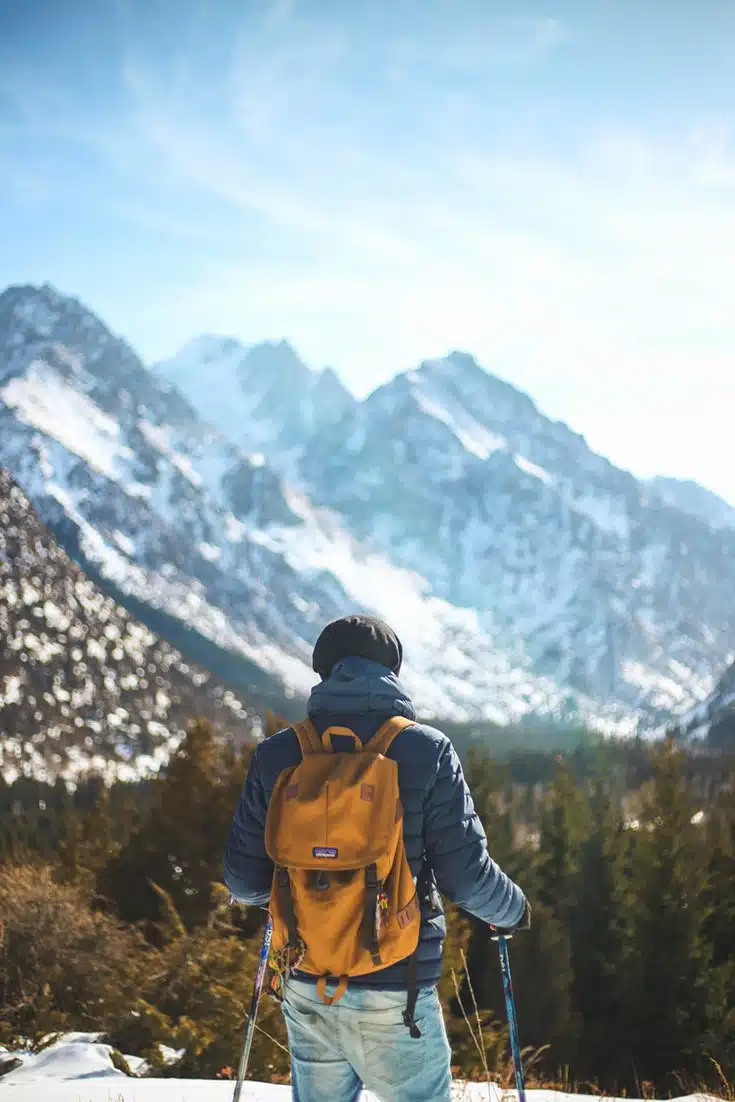
While I could write an entire novel on everything you should pack for camping in Torres del Paine, I thought we’d spare you this time and just give you a list of the basics. ( But don’t worry – I’ve also written a step by step guide! )
Personal Gear to Bring When Camping Torres del Paine
A comfortable backpack: You’re going to be walking up to 13 miles (21 kilometers) per day, so you’re going to need the most comfortable backpack possible that takes the weight off your shoulders.
If you’re planning on bringing your camping equipment with you, I’d recommend getting a 60-70 liter backpack.
Both times I went trekking in Torres del Paine, I used my Osprey Ariel 65 and felt like a million bucks, so I’d highly recommend getting that one if you’re in the market for a new hiking backpack.
Two sets of clothing: For both the W Trek and the O Trek, we recommend bringing two sets of clothes – one for trekking and one for sleeping.
Depending on your tolerance for cold, we’d recommend bringing several merino wool or synthetic layers that you can pull on and off depending on the weather conditions.
Women: Fleece jacket – Long sleeve – Short sleeve – Tank top – Leggings
Men: Fleece jacket – Long sleeve – Short sleeve – Leggings
Thermal and waterproof shells: Because the weather is so unpredictable, you should have some comfortable outerwear to trek in and sleep in. For multi-day treks, I swear by my Patagonia packable down puffer and my Marmot rain jacket .
Sturdy, waterproof hiking boots: Even if the weather is nice during your entire trip, you should wear waterproof hiking boots while you trek.
Why? Because you’ll need to cross muddy trails and cold streams nearly every single day. I’ve used these amazing waterproof hiking boots for over 4 years and I love them to death. Don’t forget a few pairs of thick wool trekking socks too!
Toiletries & a quick dry towel: One of the nice things about the campsites in Torres del Paine is that most of them have lukewarm hot water, which means you can take a nice, refreshing shower at least once every two days.
Don’t forget your toiletries ( I prefer the solid variety since, ya know, we’re in a national park and plastic isn’t cool) and a quick dry towel .
Critical Camping & Hiking Gear
A lightweight tent: I recommend the Big Agnes Copper Spur HV UL2 for all backpacking and camping excursions – it’s one of the lightest and most durable tents out there!
Sleeping bag and thermal sleeping mat: If you’re wondering what kind of sleeping bag to bring with you, follow two criteria: it should be a) lightweight and b) warm. I have a Kelty Cosmic Down that I bring basically everywhere with me and it was great for backpacking in Torres del Paine!
Lots of backpacker meals or lightweight food: We sampled a variety of backpacker foods and definitively decided that our favorite brand was Backpacker’s Pantry. They have tons of different flavors you can bring along with you (our favorite was the Three Sisters Stew ), and all you need to do is add boiling water!
Cooking supplies: You’ll need a packable cooking pot, stove, gas cannister, and silverware to cook your meals. I forgot silverware during my first time camping in Torres del Paine, and guess who ended up having to eat her food with her hands/a stick?
Eco-friendly soap and a quick-dry scrubber: Be sure to get eco-friendly soap (I love CampSu ds ) and a scrubber so you can clean your dishes after every meal.
Lots of recyclable plastic bags: Bring as many recyclable plastic bags as you can. They don’t give them away at stores in Puerto Natales, so I’d recommend bringing them from home. Not only can you use them to pack up your dry stuff and protect it from rain, but you can also use them to carry out your trash from the park.
Where to Rent Equipment for Camping Torres del Paine
In Puerto Natales, there are several places where you can rent camping and hiking gear, ranging from tents and sleeping bags to stoves and cookware to trekking poles.
Many people recommend Erratic Rock for equipment rentals, and while they’re great, I’ve found that their gear can sometimes be a bit worn out. They are the most popular hub for all things trekking, after all!
Both times I’ve gone to Torres del Paine, I’ve rented my gear from Carfran Patagonia . Located just off the main road of Puerto Natales, it’s one of my favorite gear shops in the city.
They have awesome stuff you can rent and really reasonable prices, and there’s never a wait or a line in there to talk to a sales rep. Here’s their gear rental and price list page. In addition to gear rentals, they also sell everything you might want to buy, from silverware and cups to beanies and rain gear.
Routes for Trekking in Torres del Paine
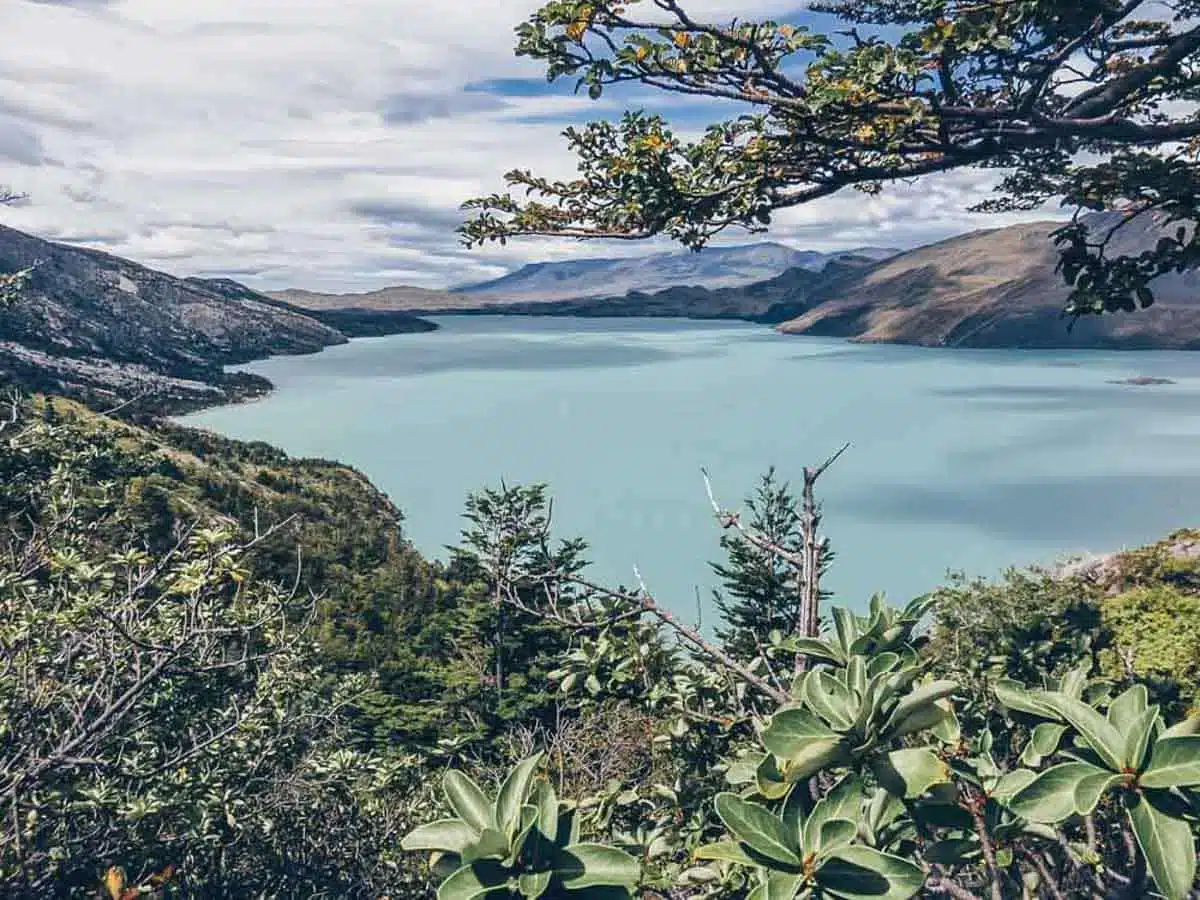
Before you can make your campsite reservations in Torres del Paine, you’ll need to determine what your route is and plan it out by date.
We’ve included 3 different itineraries for the W Trek and one itinerary for the O Circuit so you can choose the best one for your dates and timing.
Once you’ve chosen the best route, be sure to write down the dates and overnight stays on a piece of paper. You’ll need this information for when you book your campsites in Torres del Paine in the next section!
W Trek Routes for Torres del Paine
Condensed version: w trek in 3 days.
If you’re strapped for time, you can experience most of what the W has to offer. However, you’ll be hiking longer distances each day and stopping for less time at the landmarks.
In this itinerary, you’ll cut out Grey Glacier and instead head to Mirador Britanico and Mirador Torres.
Day 1 – Paine Grande to Mirador Britanico to Frances/Cuernos: You’ll take the 7:00 AM bus from Puerto Natales to Pudeto, then take the 11:00 AM catamaran from Pudeto to Paine Grande. From Paine Grande, you will begin walking directly to Campamento Italiano to drop your things off for the day hike to Mirador Britanico.
After the day hike, you’ll grab your stuff and walk over to either Frances or Cuernos campsites, depending on how much farther you’d like to walk that day. Overnight in Frances or Cuernos.
Day 2 – Frances/Cuernos to Chileno: On this day, you’ll hike from either Frances or Cuernos to Chileno, where you’ll spend the night. Overnight in Chileno.
Day 3 – Chileno to Mirador Torres to Puerto Natales: Your last day begins with a sunrise hike to the Mirador Base Torres. You’ll then hike back down to Chileno, grab your stuff, and then walk to Torres Central to catch the bus back to Puerto Natales.
*You can also reverse this route, starting at Torres Central and working backwards. You can also add in Grey Glacier and cut out Mirador Britanico, but I loved Britanico and it would be a real bummer to miss it, especially if the weather is nice.
Classic Version: W Trek in 4 Days
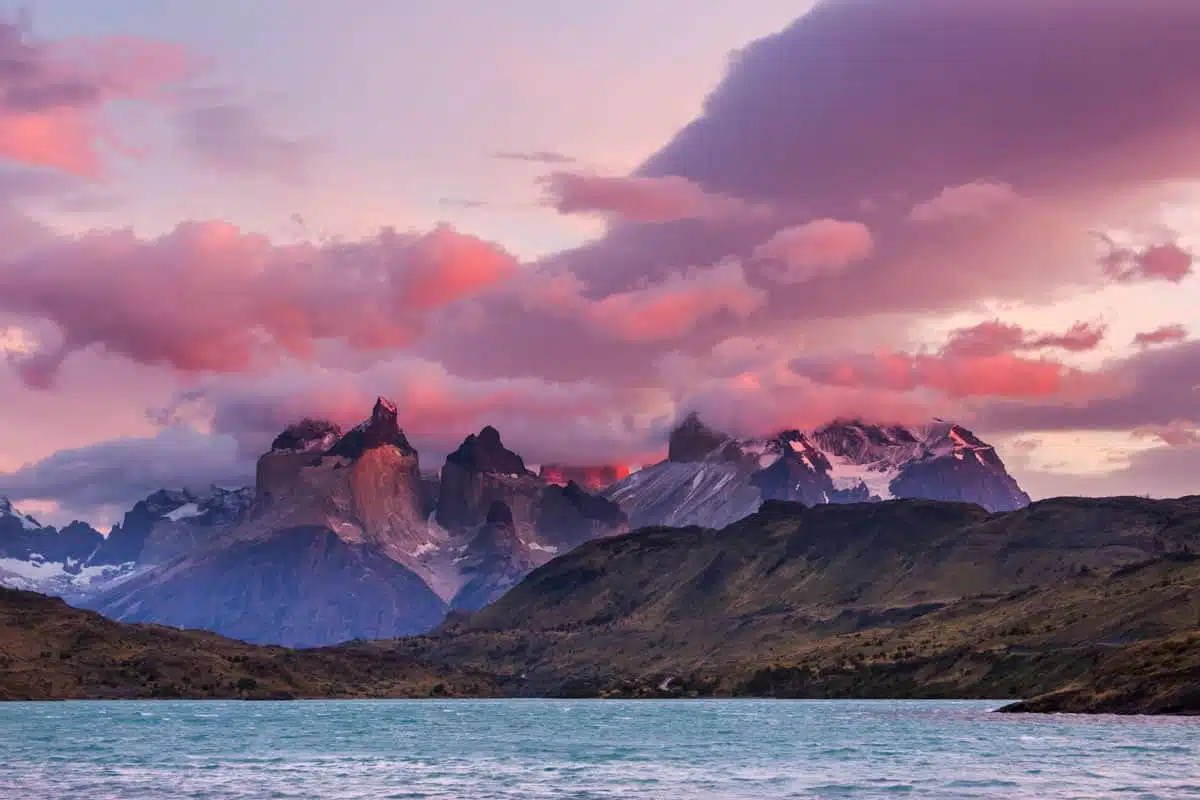
The Classic version of the W Trek in Torres del Paine ensures that you hit all of the main attractions on the front side of the park.
These include Grey Glacier, Mirador Britanico, and the Mirador Base Torres. Many people choose to do the 4 day version as a compromise – they shave off one extra day and still get to see all of the main highlights.
Day 1 – Paine Grande to Grey to Paine Grande: Take the 7:00 AM bus from Puerto Natales to Pudeto, then the 11:00 AM catamaran to Paine Grande. From Paine Grande, you’ll take a day hike up to Grey Glacier (4 hours each way, 8 hours return). Overnight in Paine Grande.
Day 2 – Paine Grande to Mirador Britanico to Italiano/Frances/Cuernos: From Paine Grande, you’ll head to Italiano then leave your stuff at the ranger station for the day hike to Mirador Britanico.
When you return, you’ll either set up camp at Italiano or continue on to Frances or Cuernos, depending on your energy levels and the amount of comfort you’re seeking. Overnight in Italiano/Frances/Cuernos.
Day 3 – Italiano/Frances/Cuernos to Chileno: You’ll spend the entire day hiking from your campsite to Chileno, passing by beautiful lakes and views of Los Cuernos. Overnight in Chileno.
Day 4 – Chileno to Mirador Torres to Torres Central to Puerto Natales: Rise and shine early in the morning (like 3:30 AM early) and hike up to the Mirador Base Torres for sunrise. Then, head down, grab your bags at Chileno, and hike down to Torres Central to catch your bus back to Puerto Natales.
*You can also reverse this route, starting at Torres Central and working backwards.
Complete Version: W Trek in 5 Days (Recommended)
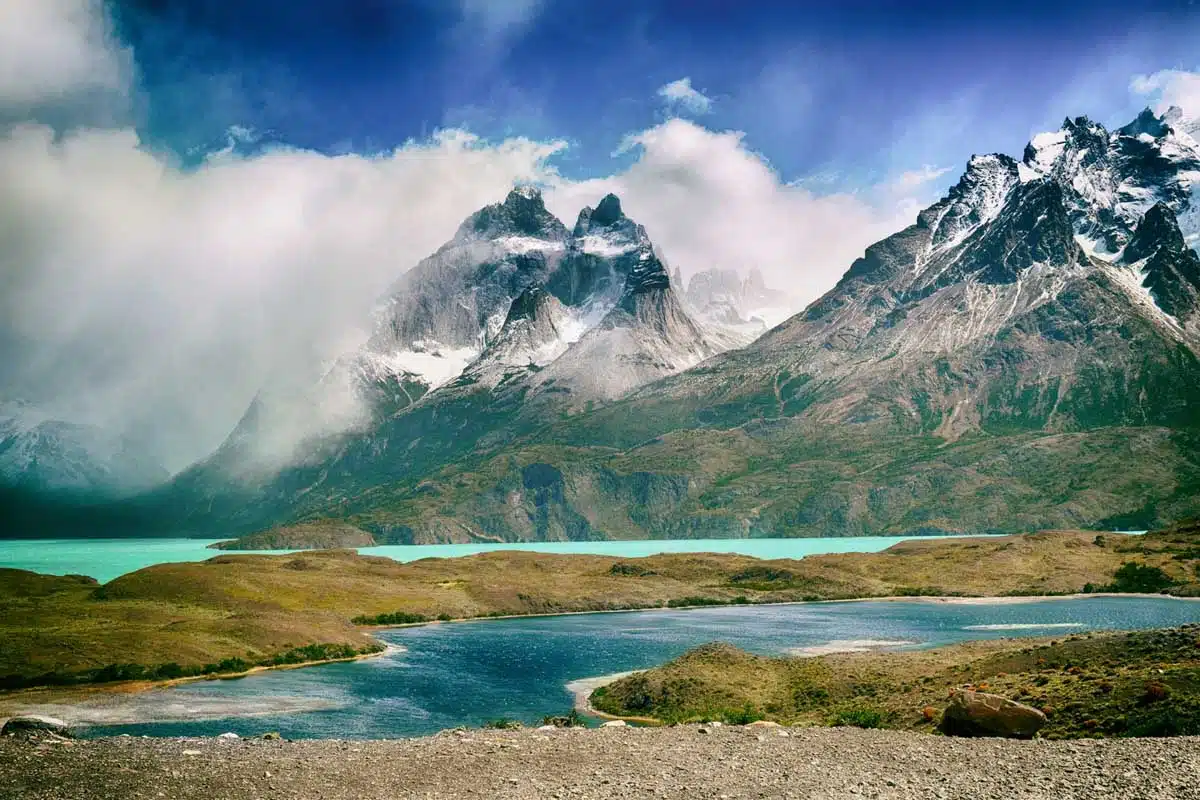
This was the itinerary the first time I visited Torres del Paine, and I loved being able to take the trails a little slower and enjoy the beautiful landscapes in the park for a day longer.
If you have enough vacation days, I strongly recommend taking this route – you’ll get to experience the W Trek to the fullest without feeling rushed.
Day 1 – Paine Grande to Grey: You’ll start this day by taking the 7:00 AM bus from Puerto Natales to Pudeto, then catching the 11:00 AM Catamaran to Paine Grande.
From there, hike up ~4 hours to Grey Campsite. Be sure to line up immediately when you arrive in Pudeto or you may not be able to get on the Catamaran. Overnight at Grey.
Day 2 – Grey to Paine Grande: After spending the night at Grey, you’ll hike ~3-4 hours back to Paine Grande. Before you go, you can hike up towards Paso campsite to see some massive hanging bridges that boast amazing views of Grey Glacier. Also, be sure to stop by the Grey Mirador on your way out, too. Overnight at Paine Grande.
Day 3 – Paine Grande to Mirador Britanico to Italiano/Frances/Cuernos: Head towards Italiano, drop off your stuff, then hike up to Mirador Britanico. Afterwards, head back and set up camp in Italiano or continue on to Frances or Cuernos to shorten your next day. Overnight at Italiano/Frances/Cuernos.
Day 4 – Italiano/Frances/Cuernos to Chileno: This hike is a long one from Italiano/Frances/Cuernos to Chileno, the nearest campsite to the Mirador Base Torres. Overnight at Chileno.
Day 5 – Chileno to Mirador Torres to Torres Central to Puerto Natales: Before sunrise, head up to Mirador Torres. Then, pick up your stuff in Chileno and head back to Torres Central to take the bus. Return to Puerto Natales.
*You can also reverse this route, starting at Torres Central and working backwards
Read Next: Complete Guide to Trekking the W Torres del Paine
O Trek Route for Torres del Paine
Start at seron (recommended).
There are really only two ways to do the O Circuit, since you are required to go counter-clockwise. The first is starting at Seron (which I personally did and recommend).
Starting on the Backside
Day 1 – Puerto Natales to Torres Central to Seron: Take the 7:00 AM bus from Puerto Natales to Laguna Amarga, then take a shuttle to Torres Central. From there, you’ll find the Seron trailhead behind and to the right of the campsite. Here, you’ll begin trekking until you reach Seron. Overnight in Seron.
Day 2 – Seron to Dickson: From Seron, you’ll hike all day (~6-7 hours) to Dickson campsite. Side note: I think this is literally the prettiest campsite in the entire park! Overnight in Dickson.
Day 3 – Dickson to Perros: Wake up and head to Perros campsite. You’ll pass by rushing rivers, evergreen forests, and hanging glaciers on your way to Perros. Overnight in Perros.
Day 4 – Perros to Paso: This is one of the trickiest days of the O Circuit. From Perros, wake up early and head up to the John Gartner Pass.
Once you’ve crossed the pass, you’ll continue downhill until you reach Paso campsite. Some people choose to continue on to Grey, but it’s another 3-4 hours and we were already exhausted when we reached Paso. Overnight in Paso.
Entering the W Trek Area
Day 5 – Paso to Grey: This is an easy, 3-4 hour day. Once you’ve eaten breakfast, head towards Grey. You’ll pass 3 hanging bridges which are terrifying to cross but gorgeous. Grey Glacier will constantly be peeking out from behind the trees during your trek. Overnight in Grey.
Day 6 – Grey to Paine Grande: Today’s hike is a leisurely downhill from Grey to Paine Grande, past some nice lookout points. Overnight in Paine Grande.
Day 7 – Paine Grande to Mirador Britanico to Frances: This is my favorite day of the entire hike (if the weather is good). Hike to Italiano, drop your stuff, then hike back to Mirador Britanico. Then, pick up your stuff and hike for one more hour to Frances. Overnight in Frances.
Day 8 – Frances to Chileno: From Frances, you’ll hike the entire day to Chileno. It’s a leisurely hike for most of the day, but make sure you take a left at the “Chileno Shortcut” to cut down your time hiking. Overnight in Chileno.
Day 9 – Chileno to Mirador Torres to Puerto Natales: Your last day! Wake up early for sunrise, head up to the Mirador Base Torres, then descend down to Torres Central to catch the bus back to Puerto Natales.
*You can also start the O Trek at Paine Grande and work your way around counter-clockwise. I advise against this because a) you’ll have to pay for the Catamaran twice, and it is expensive, and b) because you do the W before the backside (and the backside is significantly harder). In my opinion, it’s better to start with the backside first to get it done while you still have lots of energy in the beginning.
Camping Torres Del Paine: Booking Your Campsites
CONAF is the national parks service in Chile, and they’re the organization responsible for running and maintaining Torres del Paine National Park. They kind of have an English version of their website, which you can find here .
On their website, you can book the free CONAF campsites as well as purchase your park tickets in advance. Park entrance costs 21,000 CLP for foreign adults, 6,000 for kids, and 6,000 for Chilean residents.
To book your campsites and pay for your entrance ticket, click the big green button like in the photo below:
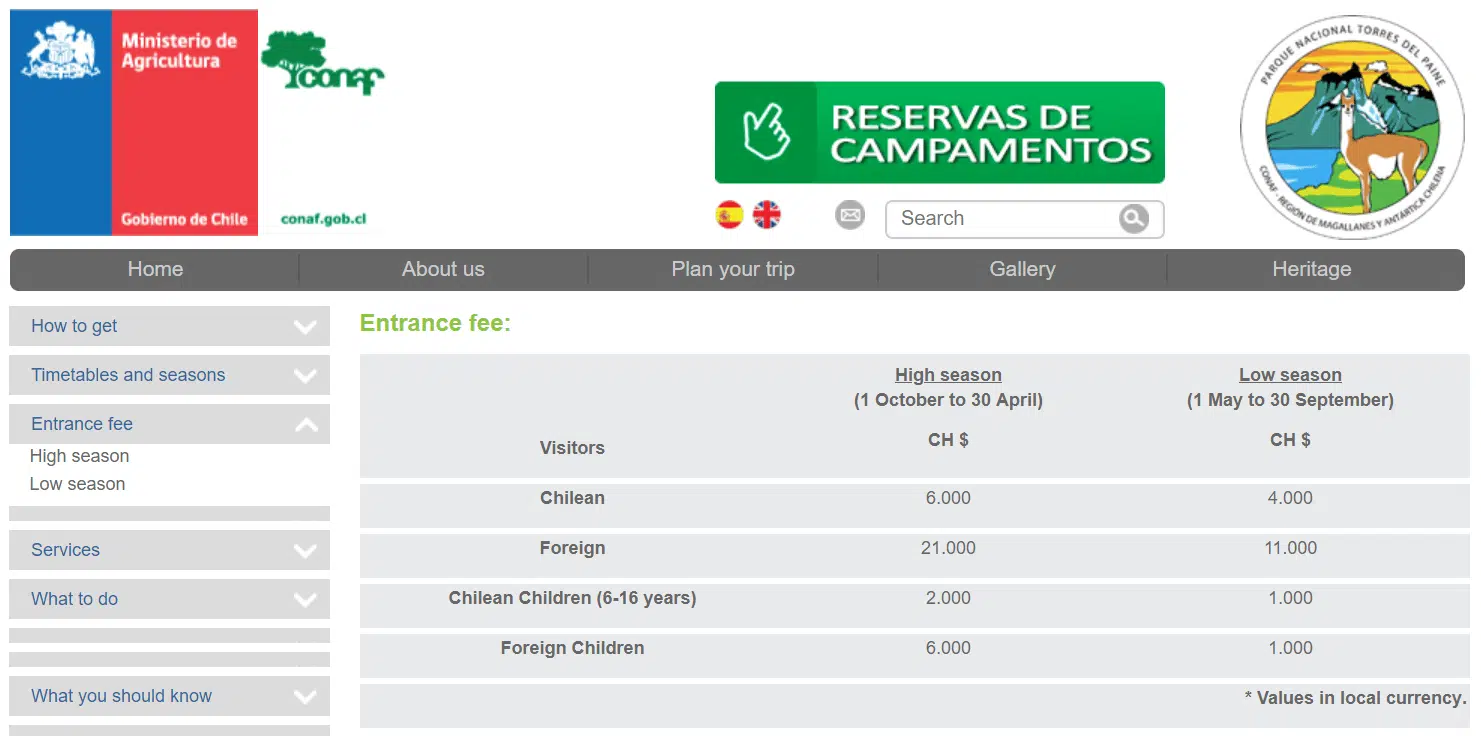
Once you’ve booked your campsites and purchased your ticket, I’d strongly recommend printing them out for entry into the park. I’ve heard conflicting stories from different sources about whether your park tickets need to be printed, so it’s best to play it safe and print them at your hostel or hotel beforehand.
Vertice is a private company that manages the campsites and refugios on the North and West sides of the park: Dickson, Perros, Grey, and Paine Grande. In order to stay at any of these campsites, you’ll need to make a reservation through Vertice.
These are generally cheaper than Fantastico Sur and typically consist of tent camping with a few equipment rental spaces. In Vertice’s campsites, you’ll find a small check in area and store, hot showers, running water, and a kitchen/cooking area.
You can book the campsites, refugios, equipment rentals, and meals on their website. The booking interface is fairly easy to use. You’ll choose whether you’re doing the O or the W trek, then you’ll choose the campsites and dates afterwards. See below for an example:
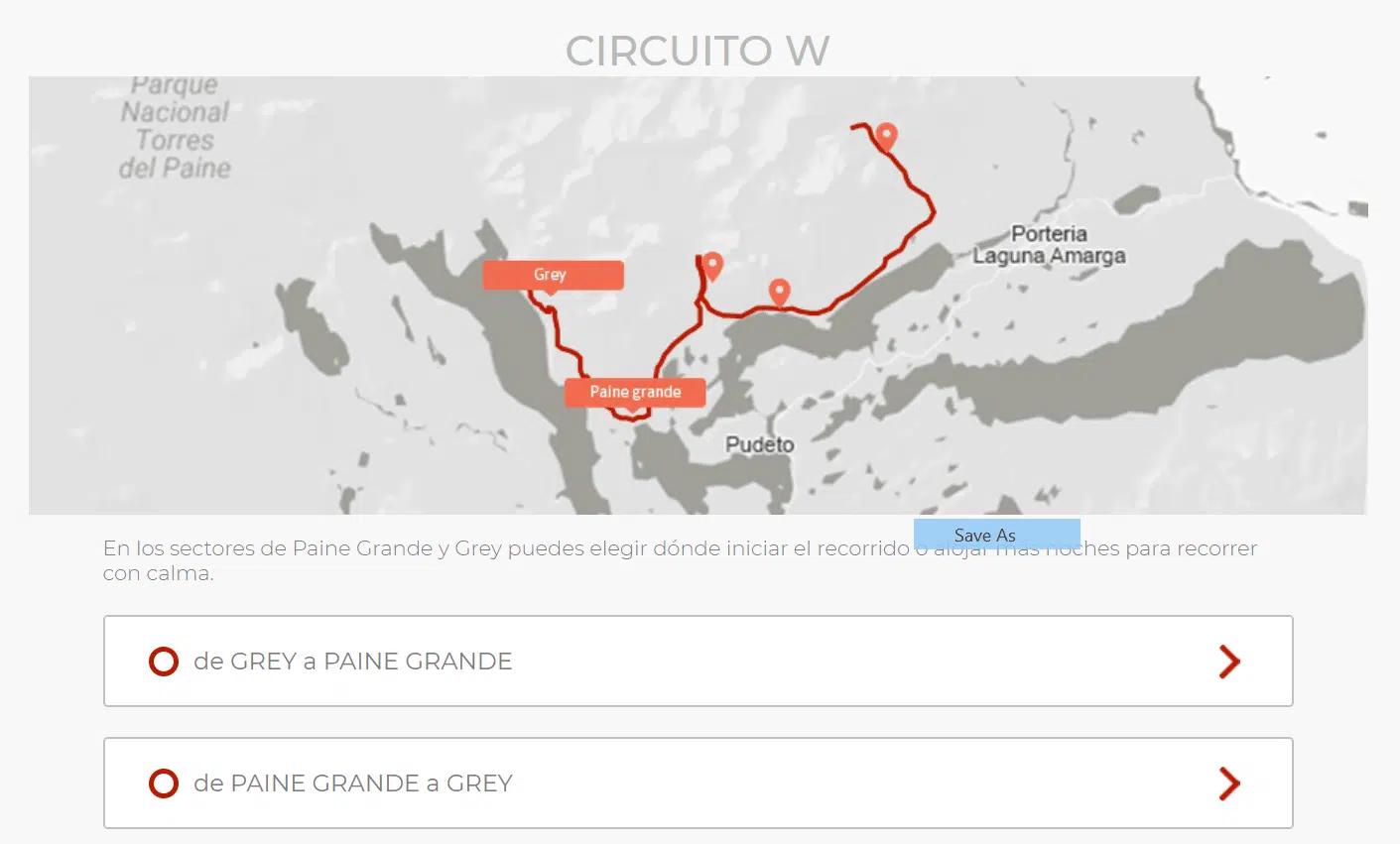
Pro tip: At any given point, Vertice’s reservations website may or may not be working, so if you have trouble accessing the reservations or finalizing your booking, I’d strongly recommend emailing them your dates and desired campsites.
FWIW, both times I went to Torres del Paine, I struggled with Vertice’s online booking system so much that it made me want to chuck my computer out the window.
Don’t do that. Just email them instead.
Fantastico Sur
Of all of the campsites in Torres del Paine, Fantastico Sur’s are the nicest, but they’re also by far the most expensive. Many of them have strange rules about cooking, which means you’ll be required to buy a partial or full board plan (which can run you up to $80 per day…yikes!).
As of March 2019, here’s what we know:
- Frances, Cuernos, and Chileno are wooden platform camping.
- Chileno requires you to buy full board for both their refugio and their campsites. I’ve heard rumors that they are trying to build a cooking shelter, but both times I went to Torres del Paine, it was like this.
- Cuernos, Chileno, and Torres Central have refugios, while Frances and Seron have eco-domes and tents only.
- All campsites have hot showers and a meal service.
To book, head to the Fantastico Sur website and click on the slightly inconspicuous red button on the right side of the homepage labeled “Book Now”:
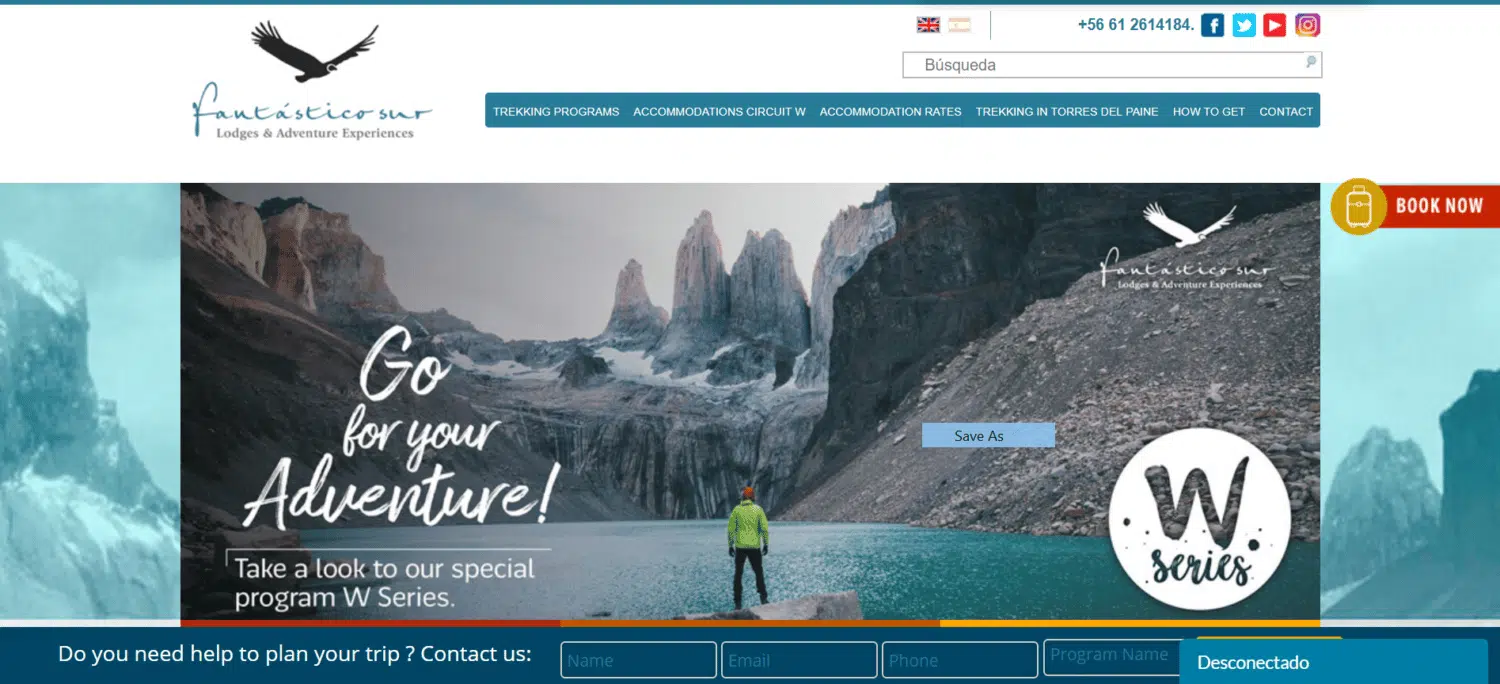
From there, you’ll be taken to the booking page for ALL of their campsites and refugios, where you can make individual bookings. Their date system is a little bit confusing, so make sure to double and triple check the dates on your reservation to make sure they are correct.
Again, the Fantastico Sur website can sometimes be a little buggy or just flat out refuses to cooperate. If this happens to you, contact them directly at [email protected] to get your campsites sorted out.
Arrival in Torres del Paine: What to Expect
Leaving puerto natales.
Most buses to Torres del Paine from Puerto Natales leave sometime between 7:00 and 7:30 AM. You’ll need to head to the bus station a day or two before to reserve your bus ticket.
There are probably half a dozen bus companies that service Torres del Paine. Erratic Rock will recommend Bus Gomez, but we disliked them for a number of reasons during our most recent trip.
Personally, I’d recommend going with Bus Sur , which always gave us really good service, ran on time, and was comfortable and clean. All buses leave from the Rodoviario Puerto Natales.
You’ll want to grab a ticket for the 7:00 AM bus so you can get in line for the entrance sooner. However, getting a 7:00 AM ticket doesn’t actually guarantee that you’ll get on the 7:00 AM bus (We know, we had 7:00 AM tickets and got booted to the 7:30, meaning we ended up being the last of the park entrants that morning…that sucked. Don’t try it.)
To actually ensure you’re on the 7:00 AM bus, I recommend getting to the station no later than 6:40 AM.
Entering the Park
This should be really straight forward because everyone has to do it, but unfortunately, entering Torres del Paine is a chaotic, disorganized mess. Hang in there, I promise that the park is worth the initial frustration!
First of all, remember what your bus and driver look like if you’re going to Pudeto. If you’re headed to Laguna Amarga, get your stuff off the bus and carry it with you in the line.
Once you (and all 10 other 7:00 AM buses) arrive at the entrance to Torres del Paine, a park ranger will enter the bus and give you instructions for how to proceed.
Generally, this means getting in a long AF line, watching a short video about fire safety in the park, and then proceeding to buy your ticket.
Yes, you still have to wait in the long AF line if you bought your ticket online. (Insert sad face emoji here.)
Once you pass into the room with the cashiers, people who bought tickets online can skip past them to the final checkout place, where a ranger will hand you a park map and send you on your way.
The park map is your BFF. DON’T LOSE IT. If you haven’t bought your ticket yet, the second room is the place to do so, and as of March 2019, you could only pay in cash.
Pro tip: They don’t let you bring backpacks into the cashier room, so set yours down on the porch outside before entering or you’ll have to leave the line and get in the back. Yes, this happened to us.
If you’re heading to Laguna Amarga (Torres Central or Seron), you’ll bring all your stuff from the entrance and catch a local shuttle (3,000 CLP, cash only) to the trails.
For those heading to Pudeto for the catamaran (Paine Grande or Grey), head back to your bus (I hope you haven’t forgotten which one was yours…?) and continue on to the pier.
Checking Into Campsites
There wasn’t a single campsite (CONAF, Vertice, or Fantastico Sur) where we needed to have our reservation printed out. I’d say it’s safe to have your reservations screenshotted or saved onto your phone for campsite check-in. You’ll usually also need to provide your passport(s) and put a tag onto your tent.
Generally, it’s a good idea to try and get to campsites earlier in the day so you can snag an awesome spot, but it’s not necessary. Just make sure you don’t arrive after dark.
A Complete Guide to All of the Campsites in Torres del Paine National Park
W trek torres del paine campsites.
If you’re planning on trekking the W , you can complete it in anywhere from 3-5 days, depending on how quickly you hike and where you choose to stay.
There are two options for starting the trek: the west side (Lago Grey) or the east side (Torres Central). The itineraries in the previous section are a loose estimate of the routes that hikers typically take on the W trek.
In this guide, we’ve provided details on each campsite so you can choose where to stay and plan your route. For ease of reading, this guide starts with Grey and works through the campsites counter-clockwise.
- Description: A charming campsite and refugio located near the Grey Glacier lookout point.
- Booking Company: Vertice
- Amenities: Hot showers, kitchen area with running water, shop, computers with Internet for paid use, camping equipment available for rent
- Refugio? Yes
- Cost: Campsites are 5,000 CLP ($8 USD) per person; refugio beds start at ~22,000 CLP ($35 USD) per person
Situated next to Grey Glacier, this campsite is located in a partially wooded area at the foot of a beautiful rocky mountain.
Here, you can find a check in area, a small store, and some computers with Internet that you can pay to use. There’s also a kitchen area with running water and “hot” showers. ( When I was there they were VERY lukewarm…just a warning. )
I’d recommend getting there as early as possible as the campsite is really long and some of the camping areas are quite far from the bathrooms and kitchen. If you prefer the peace and quiet, cool! But if you’d rather have the luxury of choice, lace up those hiking boots and get hustling.
Pro tip #1: Treat yourself to some delicious hot food and drinks ( of the alcoholic variety, or not…up to you ) at the Grey Refugio! It’s gorgeous inside, with wooden beams, big windows, and cozy couches you can sit on while you snack and sip.After 3 PM, they sell pizzas, hamburgers, prix-fixe-style dinners, wine, cocktails, and beer. It’s not cheap, but after a few days of hiking, it sure is worth it.
Pro tip #2: If you’re up for an adventure, book a kayaking or glacier trekking tour on Grey Glacier with Bigfoot Adventures . I’ve tried to do this every time I’ve gone, but sadly the weather never seems to cooperate. However, it’s worth making a booking and crossing your fingers for calm weather! (They don’t make you pay for cancelled trips.)
Paine Grande
- Description: Windy lakeside campsite with a large lodge & refugio, ample cooking space, and a wide tent camping area.
- Amenities: Hot showers, large kitchen area with running water, indoor cafeteria and bar with food for purchase, WiFi (paid), camping equipment available for rent
- Cost: Campsites are 6,000 CLP ($10 USD) per person; refugio beds start at 33,000 CLP ($55 USD) per person
Located right next to the Catamaran stop, this is a typical stop for people who want to take a day hike to Grey Glacier (about 7-8 hours round trip from Paine Grande). Surrounded by mountains and grassy fields, it is a pretty introduction to the park for those just arriving on the catamaran.
This campsite has all of the necessary amenities, from hot showers to a massive indoor kitchen and dining area. The refugio also has a coffee shop, convenience store, cafeteria, and bar.
Paine Grande is located right next to the lake, which means that the sunrises here are pretty freakin’ epic as they illuminate both Paine Grande and Los Cuernos mountains.
Pro tip #1: It’s not uncommon to see a fox (or two, or five…) wandering around here and there. They’re friendly, don’t worry! But don’t offer them food or try to pet them. They are wild animals and often come to the campsites in search of food, and it’s not cool to feed them.
Pro tip #2: If you’re low on food and need to restock, Paine Grande has the best convenience store in the park. They sell lots of snacks and cookable foods like couscous, hot dogs, pasta, sauces, and more. There’s also a large cafeteria with meals and snacks and a bar with cocktails, beer, wine, and pastries if you get lazy and don’t feel like cooking.
- Description: A rudimentary campsite in a pretty forested area by a river. Some campsites have direct views of Paine Grande mountain, which is pretty cool.
- Booking Company: CONAF
- Amenities: Drop toilets, outdoor cooking area with picnic tables
- Refugio? No
- Cost: Free (with reservation)
Although basic, Camping Italiano is located in one of the best places in the entire park. Situated right next to Paine Grande’s massive glaciers and a running stream, this campsite is a fantastic place to rest for the night if you don’t need fancy amenities. The best part? It’s FREEEEEE.
If you are backpacking with your tent, Italiano is a fantastic place to stop because it will help you cut down on costs. However, there are no camping gear rentals available here, so if you aren’t traveling with gear, I’d recommend choosing Frances or Cuernos instead.
Pro tip: Grab a spot by the river. It’s amazing to drift off to sleep with the sound of the water running and glaciers cracking in the distance.
- Description: A wood platform-based campsite and refugio located between Italiano and Cuernos.
- Booking Company: Fantastico Sur
- Amenities: Hot showers, cooking/dining area, camping equipment available for rent
- Refugio? Yes, including Eco Domes
- Cost: Campsites cost 13,000 CLP (~$20 USD) per person; refugio starts at 68,000 CLP (~$105 per person)
Camping Francés is a wooded campsite with platform camping located in between Paine Grande and Los Cuernos. This is a fantastic place to rest if you’re looking for upgraded amenities from Italiano, like an indoor dining area or hot showers. Within the campsite, there are also eco “domos” and a refugio.
Here, you can find wooden platforms to pitch your 1-person or 2-person tent. There’s also a cooking area for campers to cook with gas and a stove.
Pro tip: Choose Frances (or Los Cuernos) if you’re planning to hike to Chileno the next day. It’s only ~1 hour from Italiano and you’ll be able to shorten the long trek to Chileno. Plus you’ll have access to a hot shower and running water, which you’ll definitely want after your scramble up to Mirador Britanico.
Los Cuernos
- Description: The most beautiful campsite and refugio on the W Trek in Torres del Paine, located right next to the Los Cuernos rock formations.
- Amenities: Hot showers, running water, cooking/dining area, small shop, camping equipment available for rent
- Cost: Camping costs 13,000 CLP (~$20 USD) per person (plus $11 single supplement if you’re a solo hiker); the refugio starts at 68,000 CLP (~$105 USD) per person
Right next to one of the park’s most iconic rock formations, Los Cuernos campsite is one of the most central places to go camping in Torres del Paine National Park. It’s also arguably the most beautiful of the W campsites, located right between Los Cuernos mountains and Lago Nordenskjold.
There’s a beautiful wooden refugio here with a spacious indoor dining area that you can use if you buy food from their cafeteria. Historically, you could not cook at Los Cuernos, but they’ve recently changed the rules! Now, they have a cooking area for campers and you can cook using your gas and stove.
Pro tip: Stay here. Just do it. Before our plans got foiled the last time I was in Torres del Paine, I was planning to stay here. I was super bummed when we had to evacuate the park the day before we arrived at Los Cuernos. It’s a beautiful campsite and it’s worth it.
- Description: Rustic campsite at the base of the Torres del Paine Mirador
- Amenities: Drop toilets, outdoor cooking area
If you’re hoping to reach the Torres del Paine mirador at sunrise, this is the best campsite to choose. It’s a free CONAF site, so don’t expect anything too luxurious, but it’s a cozy, wooded campsite in a super peaceful and quiet location.
Coming from Italiano/Frances/Cuernos, it’s a bit of a hike to get up here. After you reach Chileno, it’s still easily another 1-1.5 hours fully packed to reach this campsite. However, if you’re hoping to catch a glowy, gorgeous sunrise the next morning, the pain miiiiight be worth it.
Although it’s bare bones, the campsite is less than an hour from the mirador, meaning you can wake up at 5 AM and make it up there in time to see the Torres burn bright red in the morning sun.
- Description: Cozy campsite and refugio with wood platform camping and hot meals
- Amenities: Hot showers, WiFi (paid), hot meals upon request
- Cost: Camping costs 13,000 CLP (~$20 USD) per person (plus $11 single supplement if you’re a solo hiker); the refugio starts at 68,000 CLP (~$105 USD) per person. You are also required to purchase full- or half-board to camp here.
Located on the trail leading from Torres Central to the Torres del Paine mirador, Camping Chileno is currently the closest campsite to the Torres del Paine Mirador (as the Torres campsite is closed).
At the campsite, you’ll find the best hot showers in the entire park (my personal opinion), a pretty, wooden indoor dining area with hot meals, and cozy camping platforms to pitch your tent. At Chileno, you currently have to purchase full- or half-board with your campsite reservation, as cooking isn’t allowed here.
You can still hike to the mirador at sunrise from Chileno, although you’ll need to leave around 3:30 AM to make it in time. I’ve done it and it wasn’t too bad of a hike, just make sure you have a headlamp as it is still pitch black outside until a few minutes before the sunrise!
Camping Torre Central
- Description: Large campsite near the Visitor’s Center near the trailhead for the O/W Treks
- Booking Company: Fantastico Sur
- Amenities: Hot showers, running water, outdoor cooking area, shop, Wi-Fi access (paid), access to Torres del Paine Lodge restaurant & both refugios
- Refugio? Yes (Torre Norte & Torre Central)
This campsite is located right next to the Torres del Paine Lodge and the Torre Norte/Central refugios, and has all of the necessary amenities, including hot showers, cooking areas, and WiFi (for an extra fee).
Since it’s so large and there’s a lot of foot traffic from the trails, refugios, and the lodge, this campsite can be a bit more noisy and crowded than some of the others. However, it’s really convenient and has the most amenities out of all of the places to go camping in Torres del Paine, so the trade off is worth it.
If you don’t feel like cooking, the restaurant and bar at the Torres del Paine Lodge are really nice and reasonably priced, considering you’re out in the middle of nowhere. This is the perfect option for those looking to spend just one night in the park, and take a day hike up to the Torres del Paine Mirador.
- Description: A large campsite located in an open field; usually the first stop for people doing the O Circuit.
- Booking Company: Fantastico Sur
- Amenities: Hot showers, running water, cooking and dining area, indoor dining, small shop, camping equipment available for rent
- Refugio? No, but there are Eco Domes available
- Cost: Campsites cost 13,000 CLP (~$20 USD) per person
O Trek Torres del Paine Campsites
If you’re hiking the O Circuit, Seron will most likely be your first stop. It is located about 5-6 hours from the Torres Central campground. Located in a wide open field, Seron has plenty of space to pitch your tent and settle in for the night.
Seron includes a small check-in area and shop, a restaurant, a tented cooking/dining area and bathrooms with hot showers. For people without camping gear, there is camping equipment available for rent here.
When you arrive and check in, you’ll be given a green tag to put on your tent. Personally, I’d recommend getting a camping space that’s somewhat close to the main cabin/bathrooms.
There’s a decent bit of wildlife that roams around here at night and I prefer to be as close as possible to the things I need when it’s dark out!
Pro tip: BEWARE OF MICE AND CONDORS! My boyfriend had a huge issue with mice here that ended up chewing through the side of his backpack and stealing our walnuts. In the morning, we woke up to condors in the campsite scavenging for food. Protect your food by hanging it in sealed plastic bags on the inside of your tent (above the ground).
- Description: Idyllic lakeside campsite on a peninsula, situated between some really stunning snow-capped mountains
- Booking Company: Vertice
- Amenities: Hot showers, running water, indoor cooking area, shop, refugio with meal service
- Refugio? Yes
- Cost: 5,000 CLP ($8 USD) per person
The second stop on the O Circuit is Camping Dickson, located about 20 kilometers (6-8 hours) from Serón. When you arrive at this campsite, you might feel a little disgruntled because of the steep hill (and SUPER steep downhill) leading up to its entrance.
However, once you get there, you’ll realize why this is often quoted as one of the most beautiful campsites in Torres del Paine (and definitely the most beautiful on the O Circuit).
In addition to campsites, Dickson features upgraded amenities like hot showers, a small store, and indoor cooking/dining area and restaurant, and camping gear rental.
Pro tip: There’s a small trail behind the campsites that leads to a beach. If you’re up for a short adventure, I strongly recommend going to the beach in the morning, when the sun hits the mountains head-on. The Dickson beach was one of the most gorgeous and tranquil places I saw during my entire time on the O Circuit. (But don’t swim–the water is freezing!)
Not many people who were staying at the campsite seemed to go to the beach (it was completely empty both times I went), so let’s just keep this as our little secret.
- Description: Forested campsite with basic amenities (buildings are still under construction)
- Amenities: Cold shower, running water, indoor cooking area
- Cost: 5,000 ($8 USD per person)
Los Perros is the third campsite on the O Circuit, located just past a glacier pass with some really stunning views of an alpine lake.
They’re currently in the process of constructing new buildings and amenities, so I would imagine that this campsite will be really nice in the next year or two. However, while we were there, it was the most basic of all of the paid campsites in the park.
At Perros, you can find an indoor cooking area, a small store, and communal bathrooms and showers with cold water only.
- Description: A bare-bones free campsite and ranger station located a few kilometers after the John Gardner Pass.
- Booking Company: CONAF
- Amenities: A single squat toilet, cooking area
- Cost: Free (with advance reservation)
The final stop on the O circuit “backside” is Paso, which is about a 6-hour (fairly treacherous) hike from Los Perros. This is a CONAF free campsite, which mean amenities are basic, but on clear days you can see excellent views of Grey Glacier peeking through the trees!
You’ll probably arrive at Paso tired from climbing the John Gartner Pass, but I’d recommend getting here early as the best campsites (near the glacier side of the campground) go really quickly. Upon arrival, you’ll need to sign in and show the ranger your reservation.
At Paso, you can expect a single squat toilet for all hikers (as you can imagine, it gets gross REALLY quickly) and a small, outdoor cooking area that gets really cramped during lunch and dinner.
But, I will admit that although we were tired and grumpy, we did make the most friends and have the most fun conversations at Paso.
Non-Trekking Torres del Paine Campsites
- Description: Located outside of the main O and W Trek areas, Pehoe is an independent campsite for roadtrippers to Torres del Paine
- Booking Company: Pehoe (an independent management company not connected with the others)
- Amenities: Hot showers, running water, cooking area, shop, restaurant with indoor dining, camping gear rental
- Refugio? No, but they have eco-domes
- Cost: 11,000 CLP per person
While Camping Pehoe is not part of the O or W Treks, it is an additional camping option for people who drive their own cars to Torres del Paine. Located across from Lago Nordenskold, past Pudeto bus stop, Pehoe has a stunning view of Los Cuernos that you can drive right up to.
The campsite features open tent camping, eco domes and tent rentals, and a restaurant with hot meals and indoor/outdoor seating (should you decide you don’t want to cook).
More Resources for Trekking & Camping in Torres del Paine
Phew, that was a long journey, but I hope you were able to crack the “camping in Torres del Paine” code. It’s a bit confusing but once you’re there, your efforts will definitely pay off. Now that you’re ready to embark on your Torres del Paine journey, here are a few more articles and guides you may find helpful:
- The Ultimate Guide to the W Trek in Torres del Paine
- The Complete Torres del Paine Packing List
- Incredible Things to do in Chile
I’m Kay. I’m originally from small town Virginia, but have moved all around the East Coast and the United States for basically my entire life. I spent my childhood days blissfully wandering through the Blue Ridge Mountains, rolling in leaves, playing in creeks…you know, the usual overly adventurous 5-year-old stuff.
But those early years spent outside gave me a real problem: I’m now an adventure addict. Basically, if I’m not at my computer banging out articles or photos, I’m probably out hiking, biking, or camping somewhere beautiful.
Related Posts
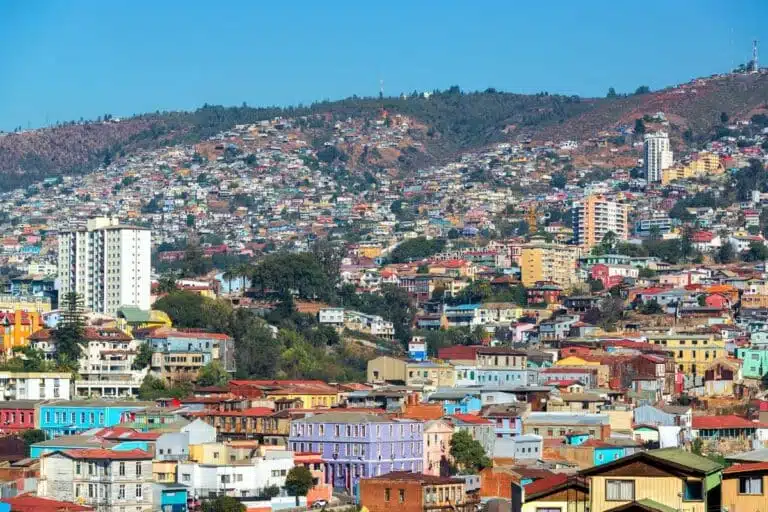
When’s the Best Time to Visit Chile?

Hotel Desertica Review: Boutique Luxury in San Pedro de Atacama
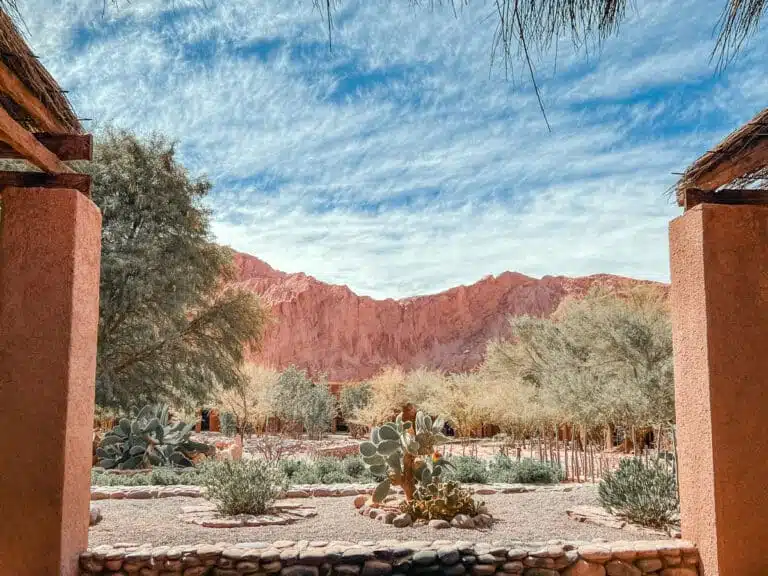
Nayara Alto Atacama Review: A Desert Escape Like No Other
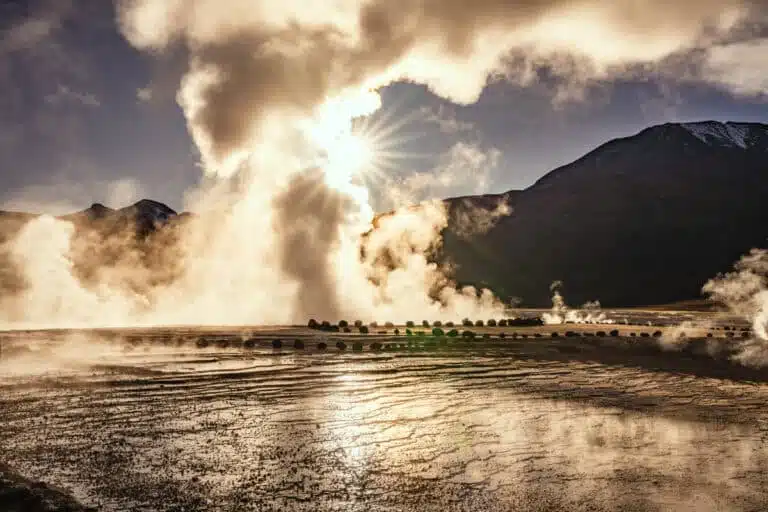
The Ultimate Guide to El Tatio Geysers: Hot Springs, High Peaks and a Dawn of Fire
One comment.
Great post – thank you! Just wondering – when booking Vertice sites can you skip any? wasn’t planning on stopping at Grey but this doesn’t appear to be an option?
Leave a Reply Cancel reply
Your email address will not be published. Required fields are marked *

Follow me on Instagram for travel inspiration, tips, and guides.

Hiking The W Trek In Patagonia: A Self-Guided Itinerary [2024]
01 apr 2024 11 nov 2023 | dan.
You can choose your own adventure when it comes to trekking in Chile, but if you like to plan ahead, here’s our tried-and-tested 5 day/4 night, east-to-west, self-guided itinerary for hiking the W Trek Patagonia .
Last updated on 26 March 2024 by Dan
Torres del Paine National Park is a place so epic and otherworldly, its name is often spoken with a kind of hushed reverence. This vast and dramatic stretch of Chilean Patagonia is home to some of the most mind-blowingly beautiful scenery on Earth, and hiking the W trek is one of the greatest ways to immerse in it.
This is Patagonian hiking at its very best, but how you trek the W trail is entirely up to you .
You can go with a guide, or do the W trek self guided (in the warmer months anyway). You can stay in lodges and enjoy a cooked meal and a warm bed. You can carry your own gear and pitch your tent in one of the designated campsites along the way, or carry no gear and book a tent at each site. You can carry all your food, or add a half or full board meal package to your booking, or do a bit of both.
We opted to camp but rather than carry all the gear, we arranged for a pitched tent to be waiting for us each day. We packed food for most of the trek and booked a full board meal package (dinner, breakfast and packed lunch) at one of our overnight camping stays.
The direction you hike and the time you take to do the trek is also your call. As occasional hikers with temperamental knees, we opted for the typical self guided W trek itinerary of 5 days and 4 nights .
Many argue that hiking west to east, and saving the striking granite peaks of Las Torres for the last day is a fitting finale to this incredible hike. We took the opposite view though, starting with the awe-inspiring torres and hiking the W trek east to west so that we could tackle the toughest legs of the trail in the first couple of days, while we still had plenty of energy.
At the end of the day, no matter how you take on the W hike, you’re still trekking one of the most spectacular trails on the planet. And you’ll still get to enjoy the jaw-dropping vista of Las Torres. Twice even, if you’re keen.
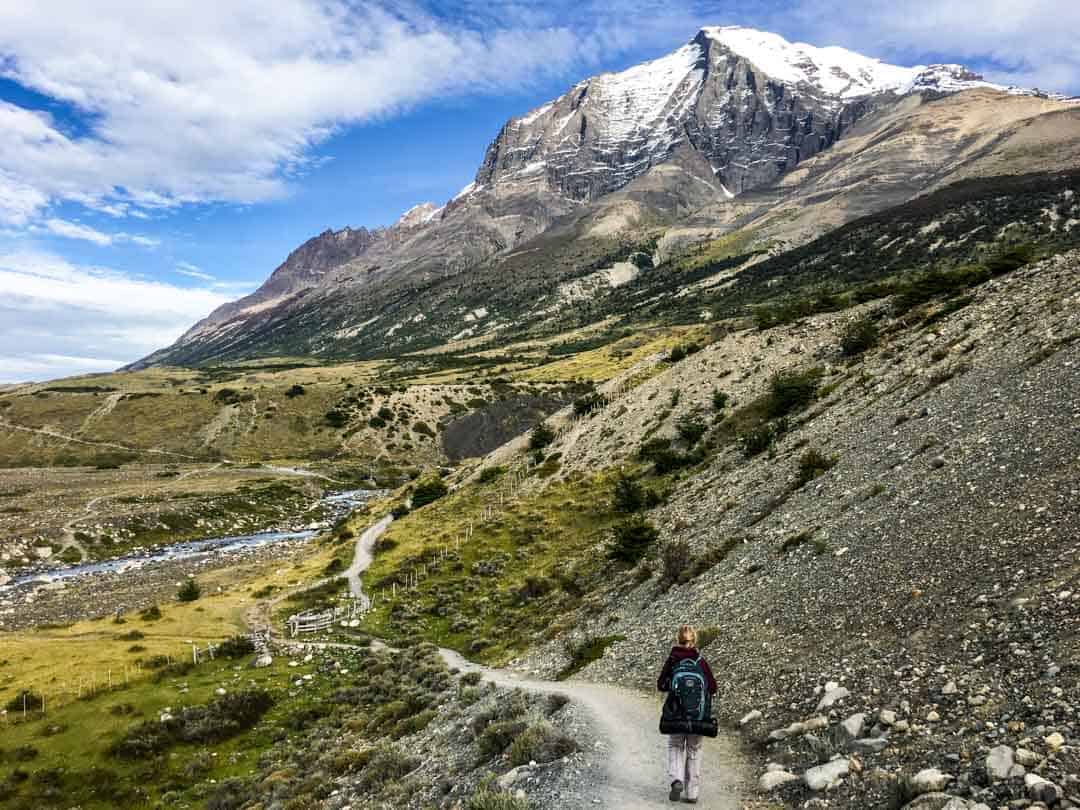
Hiking the W Trek Snapshot Location: Torres del Paine National Park, Chile Nearest town: Puerto Natales, Chile Getting to and from the park: Torres del Paine is easily accessible by bus from Puerto Natales. Park entry: Park entry tickets and overnight stays in the park (campsites and lodges) must be arranged before visiting the park. Start and finish: The W Trek traverses a roughly w-shaped route through Torres del Paine National Park between Refugio Las Torres in the east and Refugio Paine Grande in the west. For this itinerary, we start in the east and hike west. Distance: appx. 74 kilometres (46 miles) one-way Time: This itinerary is 5 days and 4 nights Difficulty: Moderately difficult, with some challenging stretches and steep climbs, plus highly changeable weather. We’re occasional hikers but with some preparation and a reasonable level of fitness, we found the W Trek very do-able (even if all our muscles were screaming for days afterwards!).
What’s in this post?
Preparing for hiking the W Trek Patagonia What time of year is best for hiking the W? Where to stay before and after the trek Entry to Torres del Paine National Park Booking Camping and Accommodation on the W Trail Bus tickets to and from Torres del Paine Packing for the W Trek Our Self-guided itinerary for hiking the W Trail Day 1 – Puerto Natales to Chileno via Las Torres Day 2 – Chileno to Francés Day 3 – Francés to Paine Grande via Francés Valley Day 4 – Paine Grande to Grey Day 5 – Grey to Paine Grande (and return to Puerto Natales)
This post contains affiliate links. If you find these links useful and you choose to purchase through these links we may receive a small commission, at no extra cost to you, which helps us to keep this website running. Your support is much appreciated!
Preparing for hiking the W Trek Patagonia
We aim to fully check and refresh this post for each trekking high season (October to April). Things can change without notice though, so we recommend also visiting the links below for information while you’re planning and before you go:
- For the latest updates on requirements for travel to Chile, visit the official Chile tourism website .
- Torres del Paine National Park is managed by the park agency CONAF. Visit the official national park website for park reports, park entry information and more.
- When you check-in at the park for your trek, you’ll receive an information guide with a map showing the park’s trails, services and accommodations. The current brochure can be found here .
What time of year is best for hiking the W?
Patagonian weather will keep you on your toes no matter when you visit Torres del Paine National Park. Be ready for everything. However, there are two distinct periods to be aware of when planning your trip.
High Season – October to April
These are the warmer months in the southern hemisphere, and December to March is the busiest time of year to trek in the park, with visitation peaking over January and February. During this period, you can choose to do a self-guided hike or go with a guide .
If you’re travelling in high season, and particularly if you’re planning to visit during the peak months, be sure to reserve your place in the lodges or campgrounds as far in advance as possible . Torres del Paine is now one of the most popular places to trek in Chile and overnight places book up very quickly.
We hiked the W trail towards the end of March, and while sections were busy, like the path to Las Torres, there were stretches where we wouldn’t see more than a handful of people in hours.
That said, despite making our campsite reservations months prior to our visit, we initially struggled to find availability and had to change our trekking dates to suit what we were able to book.
Low Season – May to September
Many people say winter is even more magical in Torres del Paine.
The park entry fee drops during the low season and you’ll find far fewer people in the park. But temps will also be lower, daylight hours are shorter, rain is frequent and there can be snow and ice. Many of the mountain trails are closed, as are a number of the mountain lodges and services. Trails that are open can also close suddenly due to weather (though that can happen at any time of the year).
Most importantly, to do the W Trek or hike to the base of Las Torres during the low season, you must have a qualified guide . This period typically runs from 1 May to the end of August, but check the official Torres del Paine website for more information if you’re planning to visit over this time.
The bottom line: No matter what time of year you visit Torres del Paine, given the changeability of the weather there, you should check in with park agency CONAF for latest updates and closures.
Where to stay before and after the trek
The nearest major population centre, and the main jump-off point for a Torres del Paine trek is Puerto Natales , a low-key Patagonian town hugging the shores of the picturesque Última Esperanza Sound.
The drawcard of Torres del Paine’s trails has seen Puerto Natales develop a buzzing trekker scene.
We suggest giving yourself a couple of days in Puerto Natales before your trek to get organised, shop, hire any gear you need, and sort out transport to and from Torres del Paine if you haven’t already (see our section on sorting out bus tickets further on).
Just about everyone staying in Puerto Natales is out and about doing the same thing, so having extra time in town means you can stress less if you don’t find what you’re looking for in the first place you visit.
Spending a couple of days here after your trek is also worthwhile – you can rest your weary bones and enjoy this charming little town.
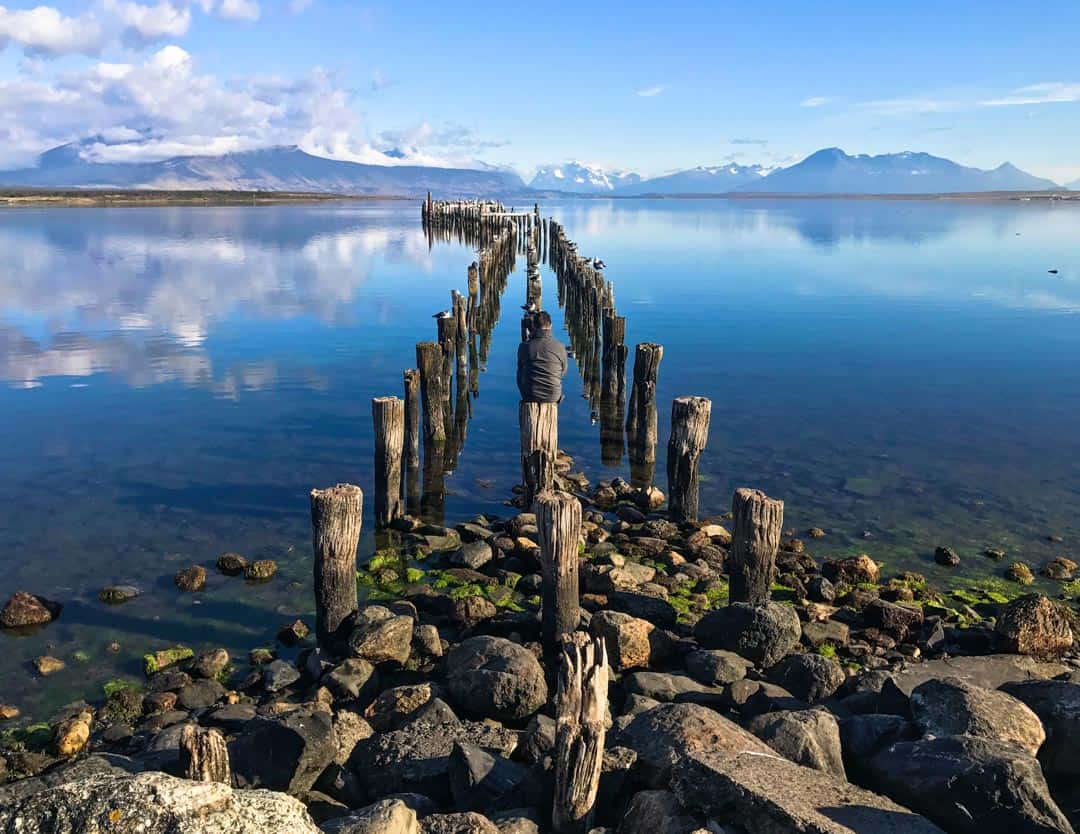
Accommodation in Puerto Natales
Puerto Natales isn’t a big place, but you’ll find everything from budget hostels through to five-star luxury in and around the town.
We stayed at the charming, centrally-located Hotel Aquaterra both before and after our trek. This is a great mid-range option and we really enjoyed our time here. They also stored our luggage for us while we were on the trail.
For more accommodation options like this in Puerto Natales, take a look at Booking.com . Or, if you’re after something more in the budget range, you’ll find various hostel options here .
One place we’ve definitely got our eye on for a future stay is this unique domed apartment . It’s about eight kilometres (five miles) out of town, but with the views this place has, we wouldn’t be moving from the window seats anyway. Perfect for a post-trek, legs-up retreat!
Entry to Torres del Paine National Park
Entry to Torres del Paine National Park is ticketed and there are capacity limits in the mountain lodges and campgrounds. This is for the long-term care and protection of this wild and remote place, and for the safety of visitors to the park. So whether you’re planning to hike the W, trek the O circuit or visit for the day, you will need a ticket to get into the park.
You must now buy your entrance ticket for Torres del Paine National Park at least 24 hours in advance of your visit to the park. You can no longer buy an entry ticket at the park itself. Visit the CONAF website to buy your park entry ticket .
Entry fees vary depending on whether you are Chilean or international, as well as your age, and whether you intend to stay in the park up to, or more than, three days. At last check, international adults 18 and over will pay CLP$31,200 (CLP is Chilean pesos) for up to three days in the park, and CLP$44,500 for more than three days.
Download your ticket to your phone before you head to the park (you won’t have reception there) and carry a printed copy just in case. You should also carry a copy of your passport as you may be asked to show your ID/nationality.
Booking Camping and Accommodation on the W Trail
There are various ways to stay overnight on the W trek in Torres del Paine National Park, but whether you’re planning a lodge stay, hiring camping equipment, or camping with all your own gear, you’ll need advance reservations to do so.
Overnight reservations are mandatory for Torres del Paine and, like park entry tickets, need to be made in advance . You cannot book camping or accommodation once you’re at the park, or camp outside the designated bookable camping zones.
You’ll also need to carry evidence of your overnight reservations as you may be asked to show proof at any time by a park ranger or when passing through checkpoints. We printed our reservation confirmations and carried these with us.
With trekking in Torres del Paine becoming ever more popular, limited accommodation spots and advance booking necessary, sorting out campsites or lodge accommodation is – in our experience – probably the trickiest part of planning a self guided W trek itinerary.
For this reason, we recommend booking your overnight stays as far in advance as possible , preferably as soon as bookings open for the season.
It also pays to be flexible about where you stay, as you may find you need to rework your trekking dates and approach based on what’s available.
Our final W trail hiking itinerary was the direct result of where and when we could get an overnight booking.
How to book your overnight stays in the park
There are a number of mountain lodges (refuges) and campsites in Torres del Paine, and you can only stay overnight in these designated zones.
Broadly speaking, the zones in the east are managed by Las Torres Patagonia (formerly Fantástico Sur) and those in the west are managed by Vertice Travel .
There are also a couple of free campgrounds in the park which are managed by the Chilean park agency CONAF. However, these campgrounds are closed for the 2023-24 season – visit the CONAF website for updates.
You can book direct via the Las Torres Patagonia and Vertice Travel websites, however we know from experience that trying to align availability and book spots for a workable W circuit itinerary across different websites can be complicated and time-consuming. Another reason to plan well ahead.
We’re now aware of a new website called Booking Patagonia , which offers an integrated booking system for travel, tickets and accommodation for Torres del Paine. Tours can also be booked through this site. We haven’t used it yet so we can’t personally vouch for it, but if you do use it, we’d love to know how you go (one of our readers has recently provided some feedback about their experience in the comments at the end of this post).
Bus tickets to and from Torres del Paine National Park
We based ourselves in Puerto Natales, the nearest town to Torres del Paine, before and after our trek and most travellers do the same. From Puerto Natales, it’s an easy bus trip to and from the park.
If you’re travelling by bus, we recommend organising your bus tickets to and from Torres del Paine well in advance . Don’t leave this until the day you head to the park or you may find the buses already full.
If you plan to buy your tickets when you arrive in Puerto Natales, aim to do so as soon as you arrive in town. You can buy bus tickets at the main bus station (Terminal Rodoviario), or through your hotel or hostel. We travelled to Puerto Natales by bus so we bought our tickets to Torres del Paine at the bus station the day we arrived. You can also search bus services and buy tickets online here .
It’s important to note that your bus drop-off/pick-up points at the park may vary depending on your final W trail itinerary, so keep this in mind when booking your bus ticket.
If you follow this itinerary and trek from east to west, you’ll start with the bus from Puerto Natales to Laguna Armaga . After your trek, you will board the bus at Pudeto for the return journey to Puerto Natales (this follows a catamaran ride across Lake Pehoe to Pudeto from Paine Grande). Vice versa if you’re hiking the W from west to east.
To ensure you’re on the trail in good time (and in line with this itinerary), we recommend booking one of the earliest buses out of Puerto Natales on Day 1.
Packing for the W Trek
Any hike, but especially a multi-day hike, can quickly lose its appeal if you’re carrying too much weight in your pack; something we can personally attest to. So we strongly recommend packing light and only carrying the clothes, gear and food you need for the trek.
If you’re travelling longer term and have more stuff with you – which was our situation – leave it in storage at your hotel. Your back will thank you for it.
You can find most of what you need to buy or rent in Puerto Natales for hiking into the surrounding landscapes, from sleeping bags, camping stoves and hiking poles to dried fruit and nuts for your trail mix.
That said, this is a small and relatively remote town and the local prices reflect it. We’re told there’s more choice and better prices at the supermarkets and shops in Punta Arenas, so if you’re coming from or via Punta Arenas, you might consider doing your trek shopping while in that town.
We’ve also read recent reports that it hasn’t been so easy to find dehydrated meals lately in Puerto Natales. If you’re planning your menu around these, you might think about sourcing them elsewhere.
It’s important to know that Chile has stringent rules around what foods you can and can’t bring into the country (fresh foods, fruits, honey, etc are a no-no). Be sure to declare any foodstuffs you do bring in and plan on buying most of what you need for trek meals and snacks once you’re in the country.
We had a tight meal plan for our spin on the W, but with hindsight, we would swap out some of the bulkier food stuffs we packed for lighter, more compact foods. Next visit, we’ll be looking to pack some dehydrated camping meals and light-weight but filling carbs like cous cous and oats.
The night before the trek, organise any food you’re carrying into daily packages of brekkie, lunch and dinner. Pre-bundling your meals saves scrabbling around in your pack for particular items on the trail). Then pack all the gear you’ll be taking with you in waterproof bags inside your backpack.
Cash, pesos or credit card? One question we get asked is whether to carry US dollars or Chilean pesos into the park, and whether the refuges accept credit cards. We carried all three. We paid for some things in pesos, like snacks and the shuttle to the trail head, and other things in USD, like the catamaran from Paine Grande to Pudeto. We also used our credit card at one of the refuges to buy beers. It’s our understanding that all of the refuges accept credit cards.
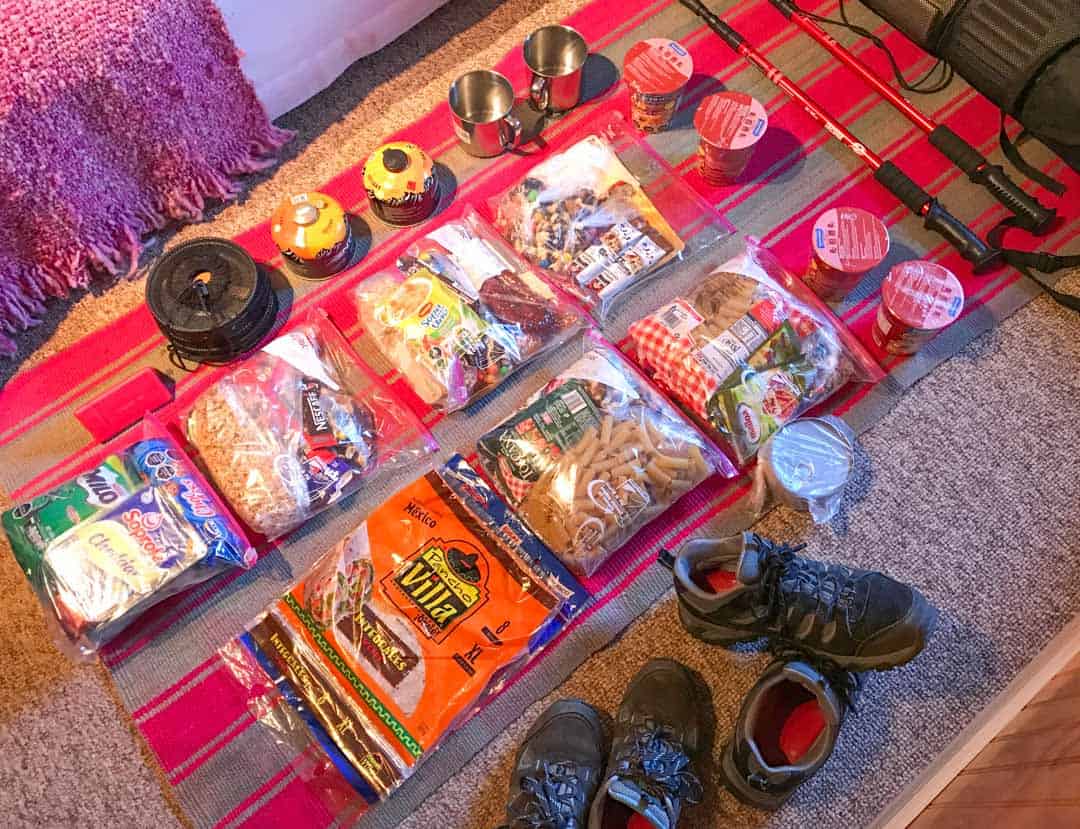
Our self-guided itinerary for hiking the W Trail
Day 1 – puerto natales to chileno via las torres, total distance: appx. 13.8 km (8.5 miles) total time: appx. 8 hours overnight: camping chileno.
Let’s get trekking! Hopefully you’ve secured your seat on one of the earliest buses out of Puerto Natales this morning (see above regarding buying your bus tickets in advance).
Buses making the run to Torres del Paine National Park generally depart from Terminal Rodoviario in town. Find your bus and load your pack, then kick back until it’s time to go. It’s around two hours to Laguna Amarga, the gateway to Torres del Paine National Park, so settle in, this is a perfect excuse to grab some extra sleep before starting the hike.
When you arrive at the Laguna Amarga Ranger Station, have your pre-purchased park entry ticket ready on your mobile phone or bring a printout. Here, you’ll check in and receive information about visiting the park, and its rules and regulations.
Don’t forget to buy your entrance ticket for Torres del Paine in advance, and at least 24 hours before you head to the park . It’s no longer possible to buy entry tickets on arrival at at the park. Head to the CONAF website for more information .
At Laguna Amarga, hikers split into two groups: those starting their journey here at the eastern end of the park, and those heading to the western starting point at Paine Grande, which involves a further bus trip to Pudeto and a catamaran ride across Lake Pehoé (even if you’re hiking west to east, you’ll get off the bus here to check-in before reboarding the bus for Pudeto).
If, like us, you’re hiking the W from east to west , your next step after check-in is to jump aboard the Hotel Las Torres public shuttle bus from Laguna Amarga to the Welcome Centre and the eastern starting point of the trek. This costs around US$5 per person and is paid in cash as you board (we paid this in pesos).
Alternatively, you can start your hike here from Laguna Amarga. The shuttle will just spare you a dusty 7 kilometre walk along the gravel road.
There’s a toilet at Laguna Amarga, and another at the Welcome Centre. This is a good chance to go before setting off into the mountains.
Trekking tip: We booked our first night’s accommodation at Camping Chileno, which is en route to today’s main destination – the towering granite peaks of Las Torres. We’ll be checking in at Chileno on the way and dropping off our packs ahead of the steep and challenging climb to the Las Torres mirador. If, however, you’ve booked your first night at Hotel Las Torres or Central Refuge and Camping, then we’d suggest dropping off your packs there first, and setting out on today’s hike to Las Torres with a lighter load.
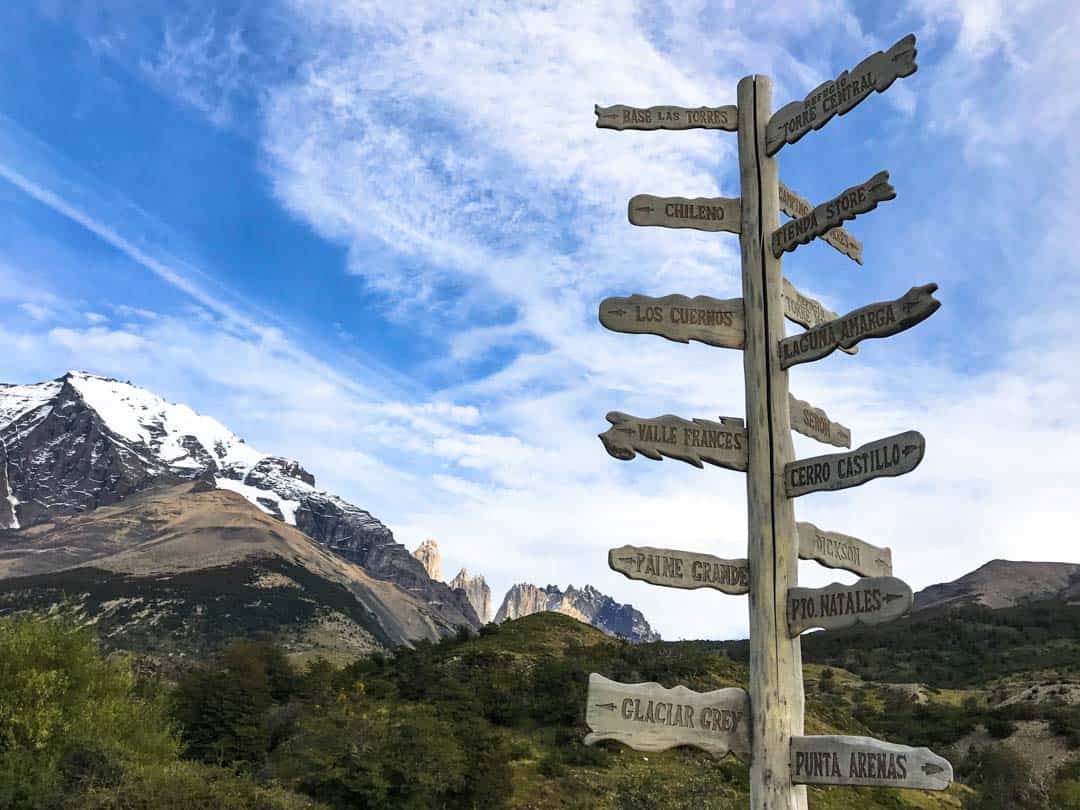
1st Leg: Hotel Las Torres to Chileno ( appx. 5 km / 3.1 miles, around 2 hours)
We’re officially underway on the W trail around 10.30am and from the word go, the views are eye-popping. After a flat kilometre or so, the path starts to climb: get used to it, it’s pretty much uphill from here.
The hike is moderately steep in some spots, until about a kilometre (0.6 miles) or so from Camping Chileno, where the trail flattens out a little before descending into the campground.
Despite feeling like our hearts might explode for much of this first stretch, we cover the distance in around two muscle-busting hours, with frequent stops to take in the views, rehydrate, and give our racing pulses a break.
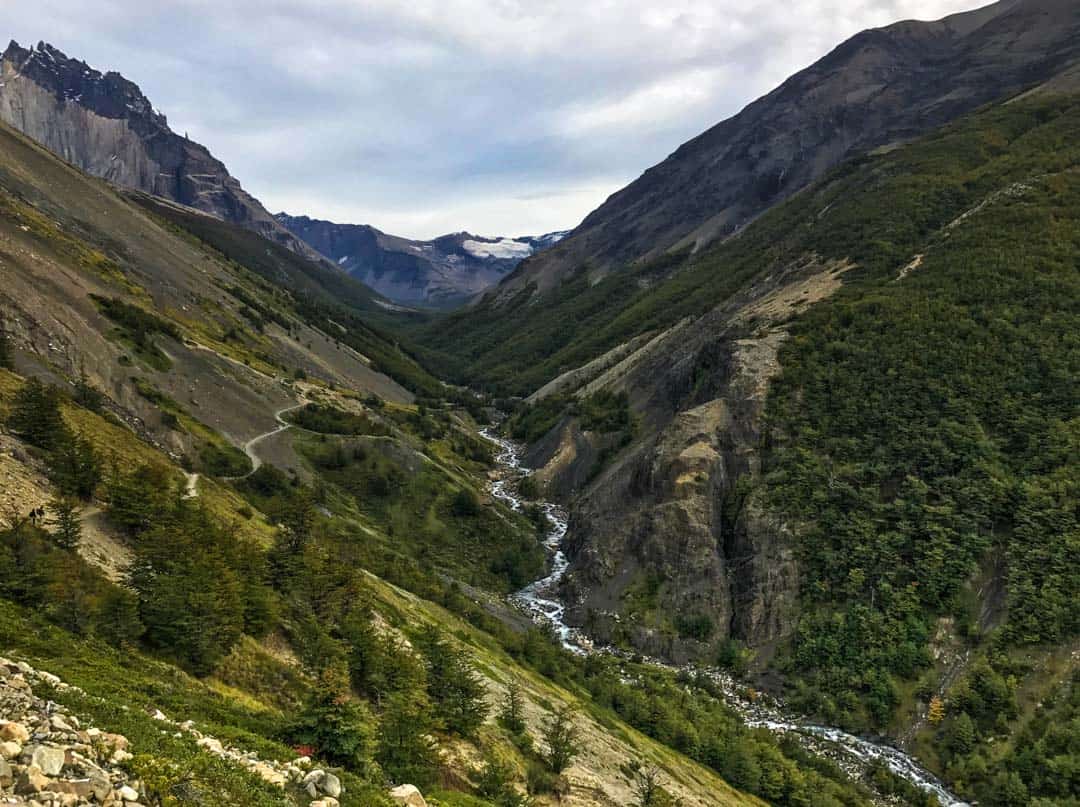
Drinking water There’s no need to lug extra water with you on the Torres del Paine circuit. You’ll pass pristine mountain streams regularly throughout your journey. Bring a water bottle, fill up at nature’s tap and enjoy some of the purest water you’ll ever drink. Just remember to top up well away from the camps and upstream of the trails.
We haul our packs into Chileno around 12.30pm . This campground is operated by Las Torres Patagonia (formerly Fantástico Sur), and is the closest camp you can stay at to the famous Las Torres hike and mirador (the CONAF-managed campground near the base of the Las Torres climb has been closed for some time).
The riverside setting at Chileno is truly stunning and the sheer peaks of the three granite towers – our ultimate goal today – rise tantalisingly above the forested mountains ahead.
The campground itself is a nice set-up of tiered camping platforms among the trees. There are shared bathrooms with hot showers, and a restaurant and bar with big windows, plus an outdoor terrace for soaking up the epic views.
Our tent is ready for us when we arrive at Chileno, so we check in, drop our bags in our tent, grab a smaller pack with snacks, water bottles and cameras, eat the lunch we prepared last night, and set out for Las Torres around 1.30pm . Timings here may vary depending on your check-in.
2nd Leg: Chileno to Las Torres (appx. 4.4 km / 2.7 miles, around 2 hours)
This is without doubt today’s toughest leg, so there’s a huge bonus in not having to tote your full pack up the mountain.
From Chileno, you’ll hike for around 3 kilometres (1.9 miles) or so along a meandering path through pretty woodland, across rushing rivers, and through a wonderfully moody stretch of fallen forest that we dub the ‘tree cemetery’. It’s a lovely, moderate walk, and we have no sense of what’s ahead when we reach the sign that tells us ’45 minutes to Mirador Las Torres’.
My notes from this point in our trek simply state: ‘hiking hell starteth here’. A touch dramatic maybe, but as irregular hikers, this was probably the hardest section of the entire W for us. Maybe you’ll breeze through it, just be ready for it.
Shortly after the sign, the climb to Las Torres begins in earnest. It’s a gritty, rocky terrain of steep, gravelly inclines and large boulders. The panoramas as you climb are absolutely breathtaking, but so is the hike itself. There are moments while we’re in the throes of it, looking up and spotting the tiny trekkers far above, that this stretch feels like it will never end.
It does end though, about an hour later, and the scene that awaits as we round a final boulder and face the towering granite pillars of Las Torres makes every single breath-wrenching step worth it.
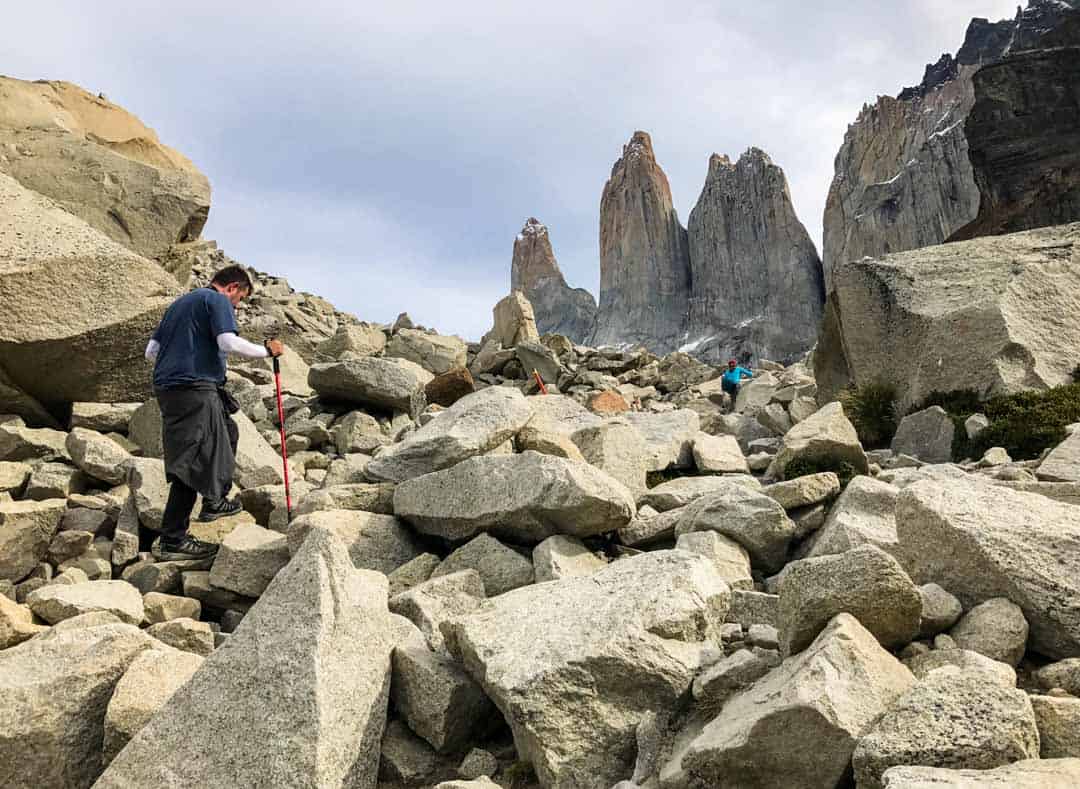
It’s buzzing at the top: hikers drape the rocks surrounding the glacier lake; a bushy-tailed Patagonian fox weaves its way between the boulders; there’s even a guy getting his hair cut at the water’s edge (one hairdresser’s quirky approach to memorialising his travels while promoting his business).
We spend some time taking pics before settling onto a boulder of our own to simply take in this awe-inspiring scene. Aim to spend around an hour at Las Torres .
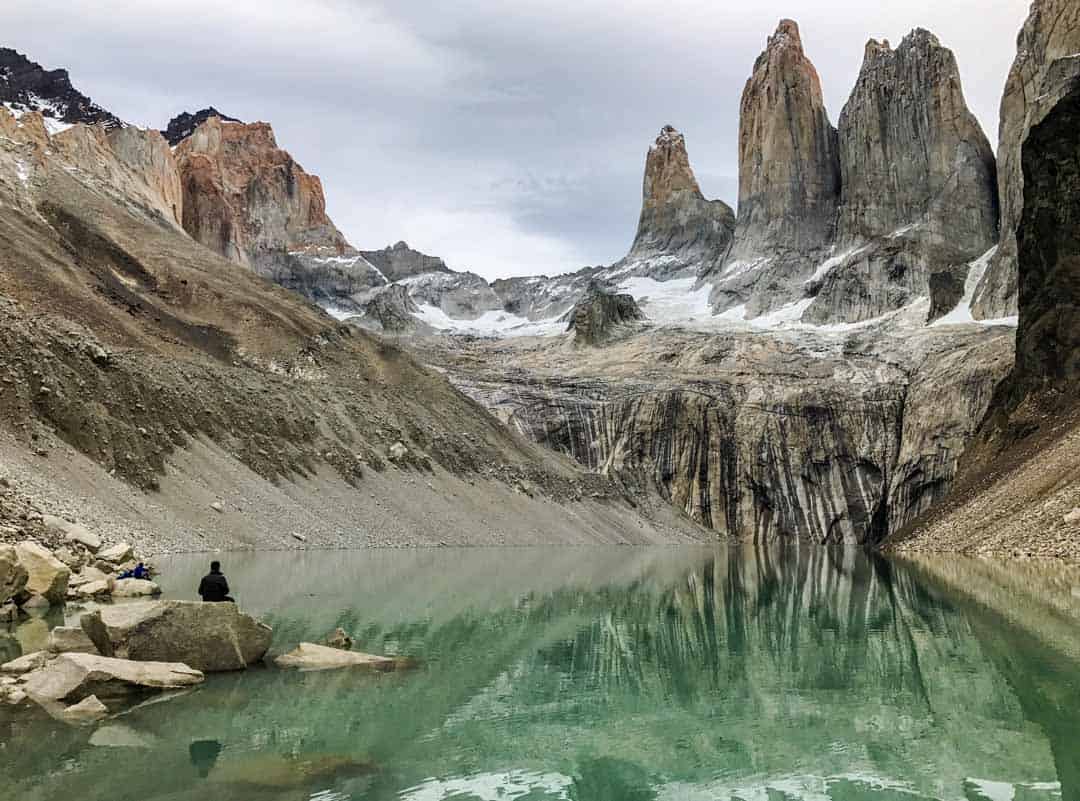
3rd Leg: Las Torres to Chileno (appx. 4.4 km /2.7 miles, around 2 hours)
The journey back down from Las Torres is in some respects even more challenging than the climb up. The constant down is tough on knees and the gravel makes the going slippery. We’re beyond grateful for our hiking poles, though we both still manage to pull off some memorable butt slides.
Trekking tip: Hiking poles made all the difference for us when we were trekking in Patagonia. We carried one each, which was ideal as it left us both with a hand free to grab branches and rocks, haul each other up and down, and catch our fall when we slipped. Which was often.
It takes us around two hours to get back to Chileno; we have time to shower, buy a couple of well-earned beers and watch the sunset burn the tips of Las Torres molten gold.
It was cloudy the entire time we were up at the base of the towers, so watching them all beautifully backlit now is a bit of a kicker, but if there’s one thing you’ll learn quickly hiking the W Patagonia, it’s that the weather doesn’t give a rats what you think.
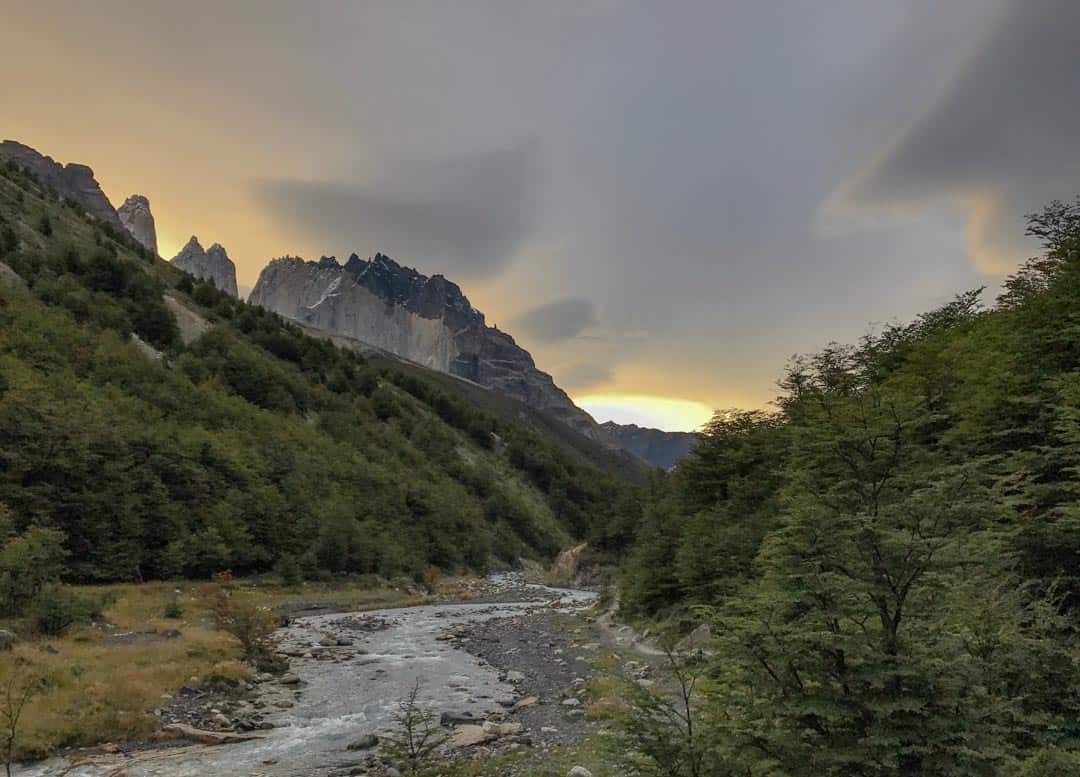
Preparing for Patagonian weather If there’s one constant about the weather in Patagonia, it’s that there’s nothing constant about it. We were particularly lucky on our five days in Torres del Paine, but you should be ready for four seasons in a day. Layer up, have a rain jacket handy, and wear quick-dry clothes. Skip a rain cover for your bag though. While we never experienced the legendary winds that tear through the park from time to time, we heard plenty of stories of pack covers being whipped off suddenly and disappearing into the wilds. Expect to get rained on, and pack your gear in bag liners or waterproof bags inside your backpack instead.
Cooking stoves are not allowed to be used in the Chileno zone, so we opted for the full board food package here, which includes dinner tonight, breakfast tomorrow and a packed lunch to take with us.
Later in the evening, we join a host of other hikers in the restaurant for a surprisingly tasty and filling three-course meal full of protein and carbs.
We’re absolutely wrecked by the end of dinner, and we’re tucked up in our sleeping bags by 9.30pm.
Sunrise at Las Torres When we originally planned our itinerary for hiking the W, we had every intention of doing a second trek to Las Torres for sunrise on Day 2. In late March, this would have entailed getting back on the track up the mountain by 5.30am . As we climbed into our sleeping bags that first night though, we decided to pull the pin: we were just too tired, and we were also a little wary of making the tricky climb in the poor dawn light.* It was a tough call at the time, and it didn’t help when we poked our heads out of our tent the next morning to see the torres erupting with golden light above the silhouetted foreground. As we watched though, the clouds rolled in and soon enough the peaks were shrouded in mist. There’s no accounting for Patagonian weather, or how your body may feel after a long day of hiking. The best you can do is plan, and be flexible on the day. *PS. For safety reasons, hiking in the dark isn’t actually allowed in Torres del Paine. Trail sections have opening and closing times, check the park brochure for more info.
Day 2 – Chileno to Francés
Total distance: appx. 18 km / 11.2 miles total time: appx. 6 hours 45 minutes overnight: camping francés.
Sunrise is around 8am when we do the W trek in late March, and as we haven’t made the dawn hike to Las Torres, we enjoy a more leisurely start to the morning on Day 2.
If you do decide to do the dawn hike up to Las Torres for sunrise, factor in around five hours this morning and adjust the following timings for today’s next legs accordingly.
As breakfast is part of our full board package at Camping Chileno, we pack up our gear and head to the dining room at 8.30am for a hearty kickstart to the day.
1st Leg: Chileno to Los Cuernos (appx. 15 km / 9.3 miles, around 4.5 hours)
We’re on the trail by 9.15am , heading back towards Hotel Las Torres. We won’t be going all the way to the hotel though as there’s a shortcut off to the right around half-an-hour after leaving Chileno. The shortcut is signposted and takes you along a mostly downward sloping path surrounded by undulating hills and lake views.
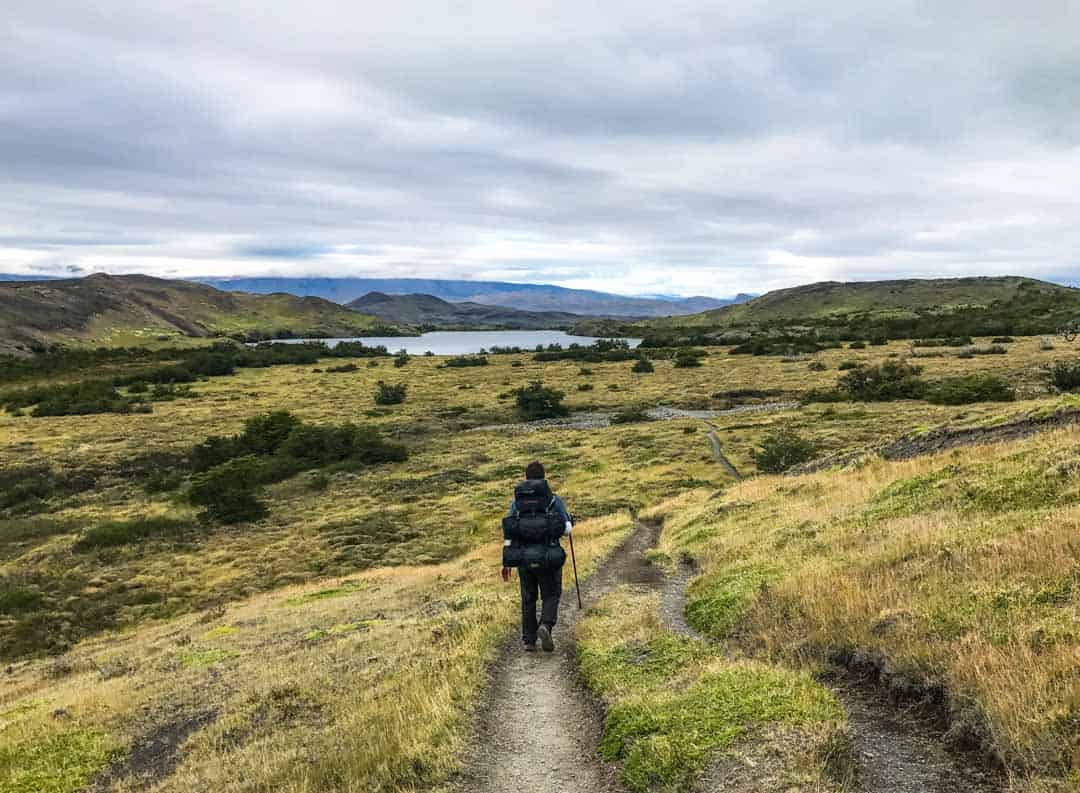
We reach the end of the shortcut and rejoin the main W route around 11am . At some point after this though, we suddenly find ourselves in what can only be described as the Patagonian Swamps of Mordor and we start to wonder whether we’ve veered off on to a secondary trail by mistake.
We can still glimpse the Nordernskjöld Lake off to left, and we know the official trail travels alongside it. To this day, we’re unsure if we did actually go off piste (though the number of bootprints in the mud suggests not).
Eventually, we seem to be back on track according to the map, just a little muddier for the experience (and even more grateful for our depth guage hiking poles).
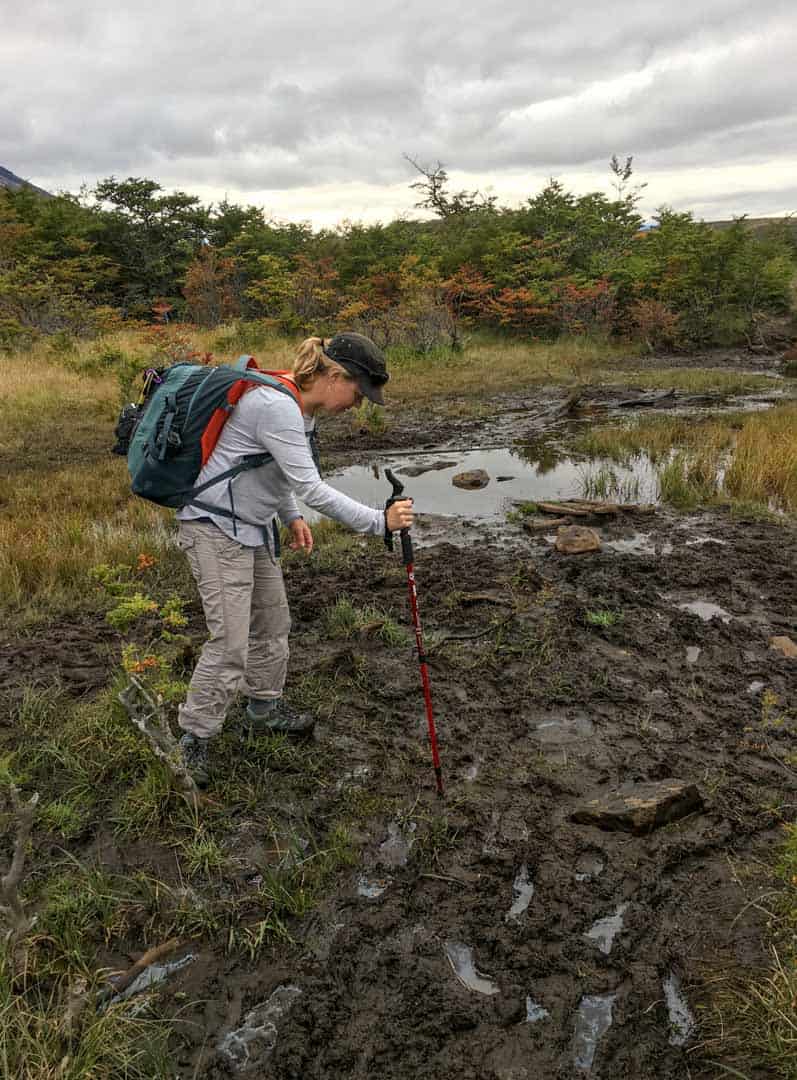
The next stretch travels up and down through very pretty lakeside country, with the occasional steep section, before passing down into the valley at Los Cuernos. We arrive at the Los Cuernos shelter and camping area around 1.45pm .
You could stop at any point along the stretch to Los Cuernos for a lunch break; we stop just past the shelter and find a nice rock with a view. We opted for the full board meal package with Camping Chileno so we’ve been provided with a packed lunch today as part of this.
We chill for around 45 minutes and then set off around 2.30pm for Camping Francés , where we’ll be staying tonight.
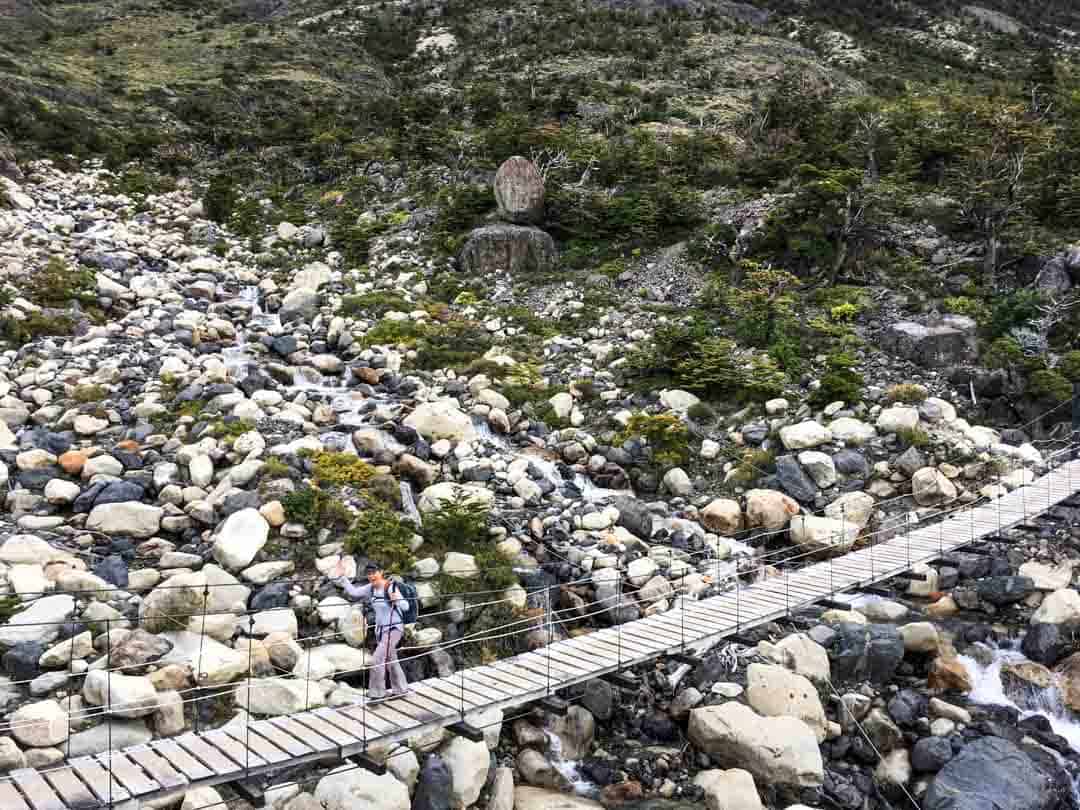
2nd Leg: Los Cuernos to Francés (appx. 3 km / 1.9 miles, around 1.5 hours)
The trail to the Francés campground is up and down and rubbly, with some steep sections, and a pretty pebbly beach crossing. Today’s walk has been positively sedate compared to yesterday’s heart-starter climbs, but never fear, a leg-burning rise awaits just before the descent into the camp.
We arrive at Camping Francés around 4.00pm . The campground here is run by Las Torres Patagonia (formerly Fantástico Sur).
The tent platforms are clustered between the trees and there’s a good shower and toilet block a short walk from the campsite. There’s also a small shop with basic amenities.
By 5.15pm we’re checked in and set up on our platform. We’ve arranged for a tent at Camping Frances but we’re cooking our own food tonight.
Sunset is close to 8pm in late March, and having made it through our second day on the W trail, we’re zipped up in our sleeping bags soon after.
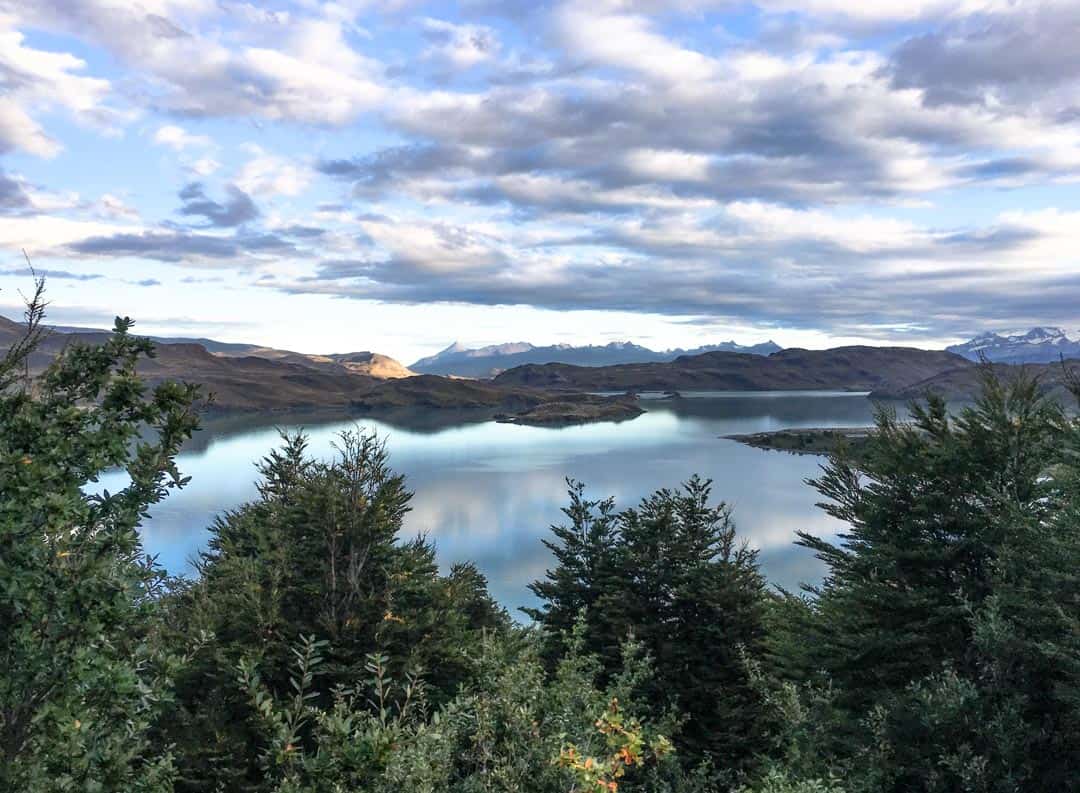
Day 3: Francés to Paine Grande via Francés Valley
Total distance: appx. 20.3 km / 12.6 miles t otal time: appx. 9 hours overnight: camping paine grande.
Despite our fatigue, neither of us sleeps particularly well on our second night and we’re both groggy when the alarm goes off at 7am.
Our restlessness is partly due to the strange soundtrack that has accompanied us throughout the night: sharp cracking sounds like distant shot gun blasts and deep, thunderous rumbles. It’s not until we set out on the trail through the Francés Valley today though, that the source of the unnerving noises becomes obvious.
On this itinerary, today is the longest day hiking the W, and based on our experience, we recommend getting on the trail by 8am at the latest to maximise your time in the Frances Valley. We departed later when we trekked, so we’ve adjusted the timings below to suit an earlier start.
1st Leg: Francés to Italiano Ranger Station (appx. 2 km / 1.2 miles, around 30 minutes)
The first leg this morning is a rejuvenating, 30-minute leg-stretcher to Italiano Ranger Station. Aim to pack up and set out from camp by 8am.
There’s a ranger at the Italiano Ranger Station when we arrive. He points to some racks opposite the office building; this is where we opt to leave our backpacks ahead of the challenging hike into Francés Valley.
We sort our valuables and lunch into a smaller daypack, lock up the big packs, and get going again. Look to be back on the trail by 8.45am .
2nd Leg: Italiano Ranger Station to Británico Lookout (appx. 5.4 km / 3.4 miles, around 3 hours)
The first kilometre (0.6 miles) out of Italiano is a flat trail through pleasant forest, after which the track starts to climb steeply through a rocky, rubbly stretch.
The scenery is seriously beautiful, serving up views of the ironically named Paine Grande Hill – 3,050 metres above sea level – and the Francés glacier that clings to it. This is the source of the crackshots and grumbles we’ve been hearing as the hanging ice shifts, melts and avalanches down the mountain.
Soon enough, you’ll reach the Francés mirador, a lookout offering spectacular panoramas over the ‘hill’ and its glacier; this is the perfect spot for a short break and a snack, as the next stretch is tough.
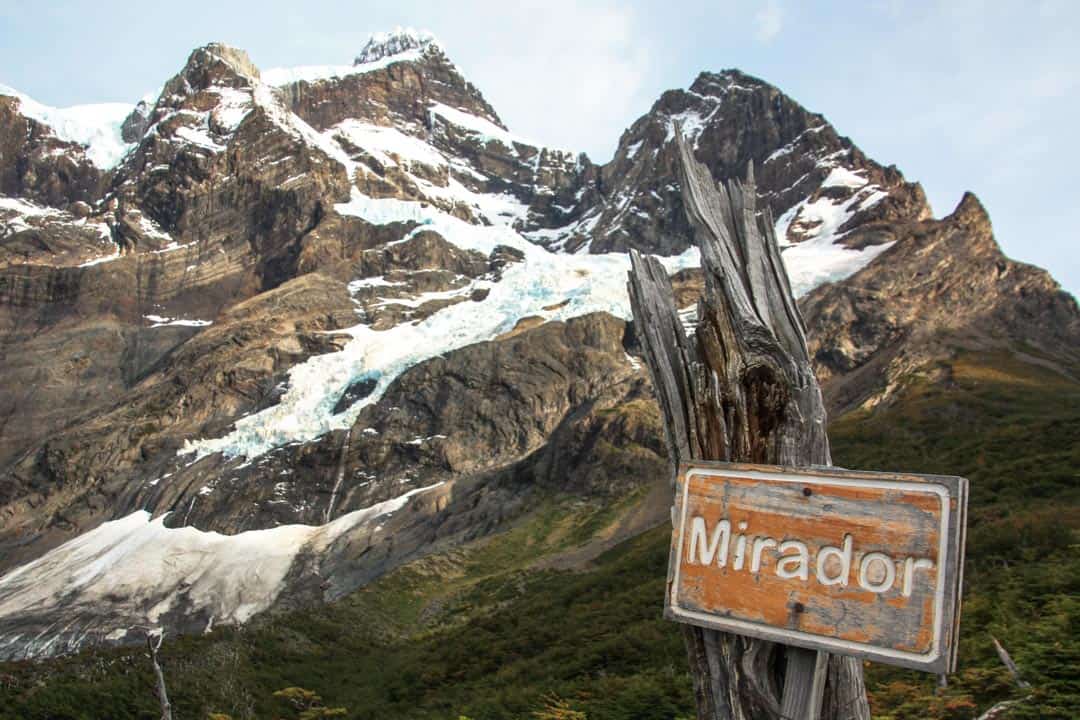
From here, the trail to Británico Lookout is a challenging, rubble-strewn boulder dash with lots of climbing.
A flat, rocky clearance scattered with the parched white trunks of dead trees and overshadowed by the jaw-dropping Cuernos massif, marks the final stretch before a steep, 10-minute climb to the mirador itself.
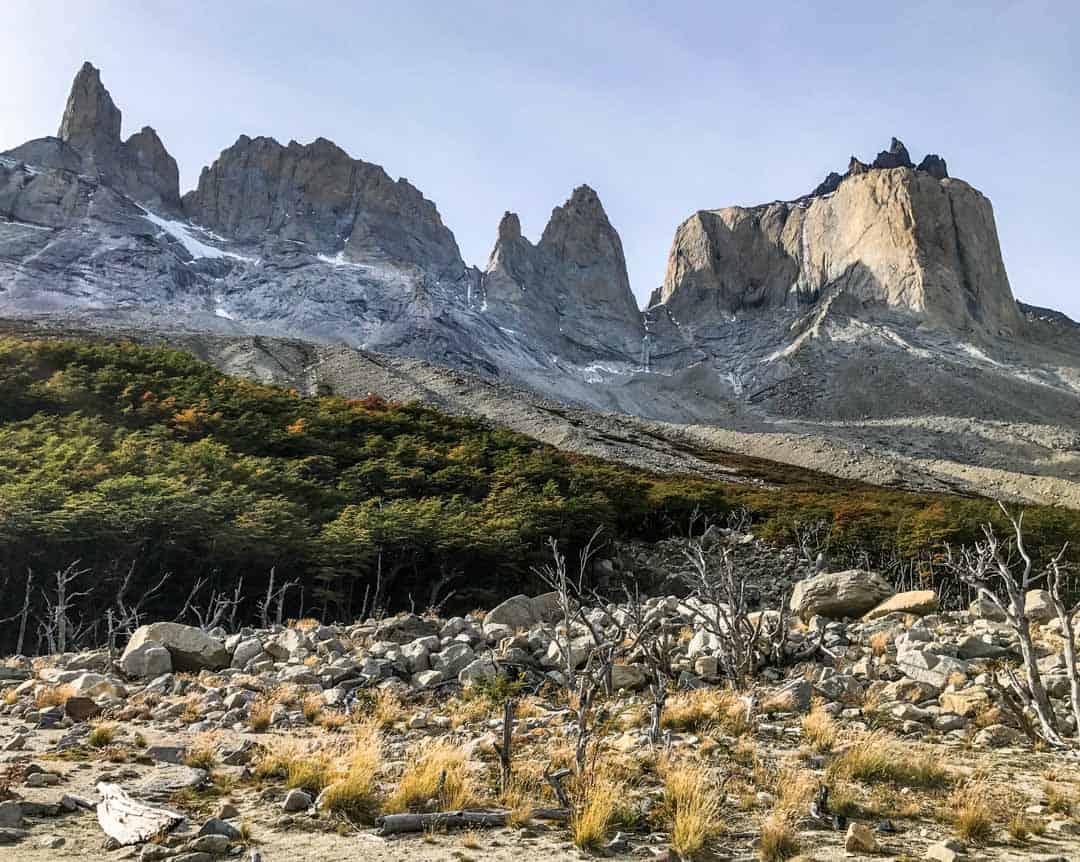
Summitting the boulders of the Británico Lookout around three hours after setting out , we cast our eyes over what will become our favourite panorama of this epic journey: the vast and spectacular Francés Valley. Find a rock to perch on and settle in for lunch with this glorious scene at your feet.
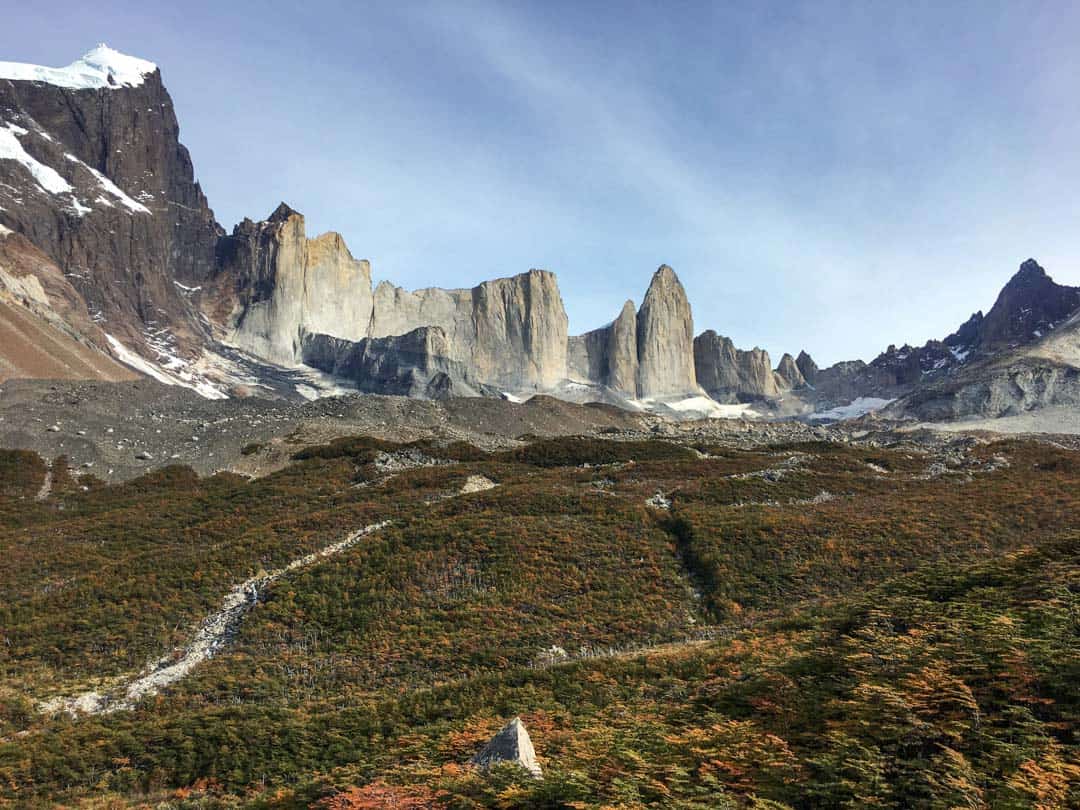
We’ve come a long way, but there’s still a huge day of hiking the W ahead. To our eternal regret, we were only able to linger here for half an hour as we left camp too late on this morning. That’s why we recommend getting on the trail no later than 8am today – trust us, you’ll want as much time at Britanico as possible and by arriving around 11.45am, you’ll have close to an hour here.
We’ve promised ourselves that next time, we’ll spend an extra day or two in this valley so we can take in this view at our leisure. For us, this remains one of the most magnificent vistas we’ve come across in all our world travels.
Trekking tip: Get on the trail by 8am at latest this morning so you can hang out for at least an hour at Britanico, or better yet, stay an extra day in the Francés Valley.
3rd Leg: Británico Lookout to Italiano Ranger Station (appx. 5.4 km / 3.4 miles, around 2 hours)
Aim to set off back down the trail to Italiano around 12.45pm . We find this a knee-buckling downward journey and our legs are screaming by the time we reach our packs back at the Italiano Ranger Station just over two hours later.
Once we’ve retrieved our packs (now four-deep in a giant bag pile), re-sorted them, and stopped for a quick breather, we set out for the Paine Grande refuge and camping area, starting with a bridge crossing out of Italiano. It’s around 3pm by this stage .
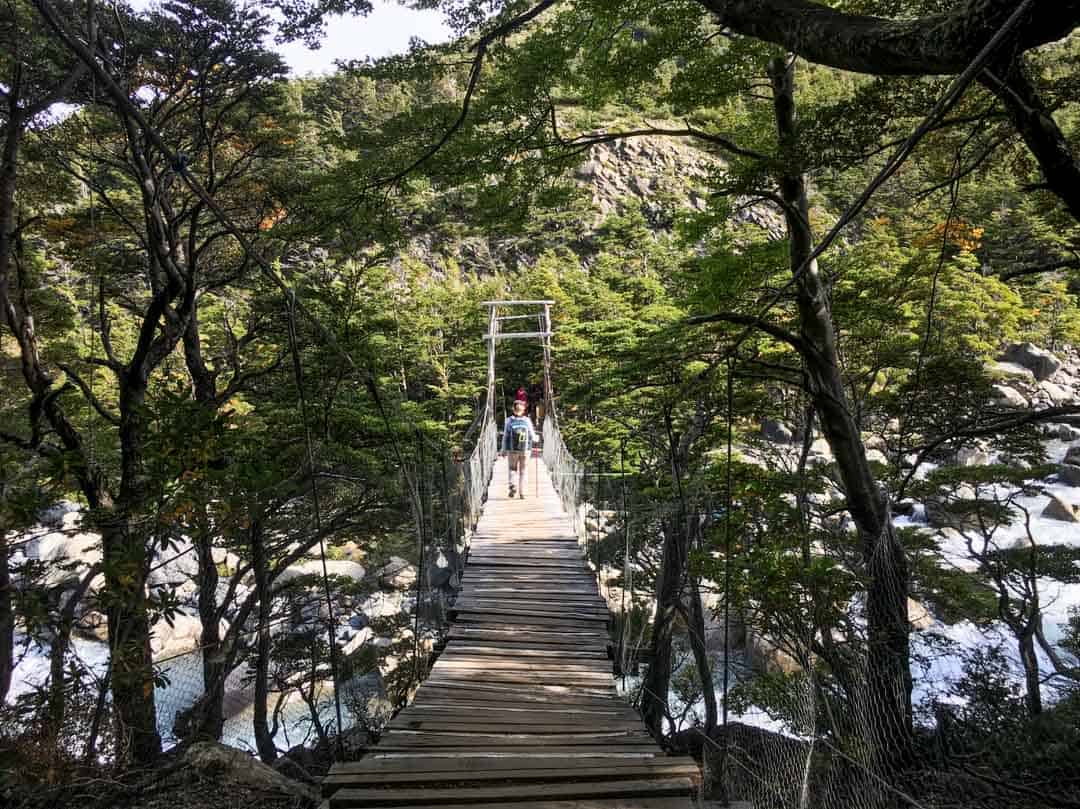
4th Leg: Italiano Ranger Station to Paine Grande (appx. 7.5 km / 4.6 miles, around 2.5 hours)
The final stretch of the W trail today is a journey of around 7.5 kilometres (4.6 miles) and it’s mostly flat with some sloping ups and downs.
Travelling out of the valley and along the raised walkway as you head towards Sköttsberg Lake, remember to turn around and take in the mountain scene back the other way: it is immense.
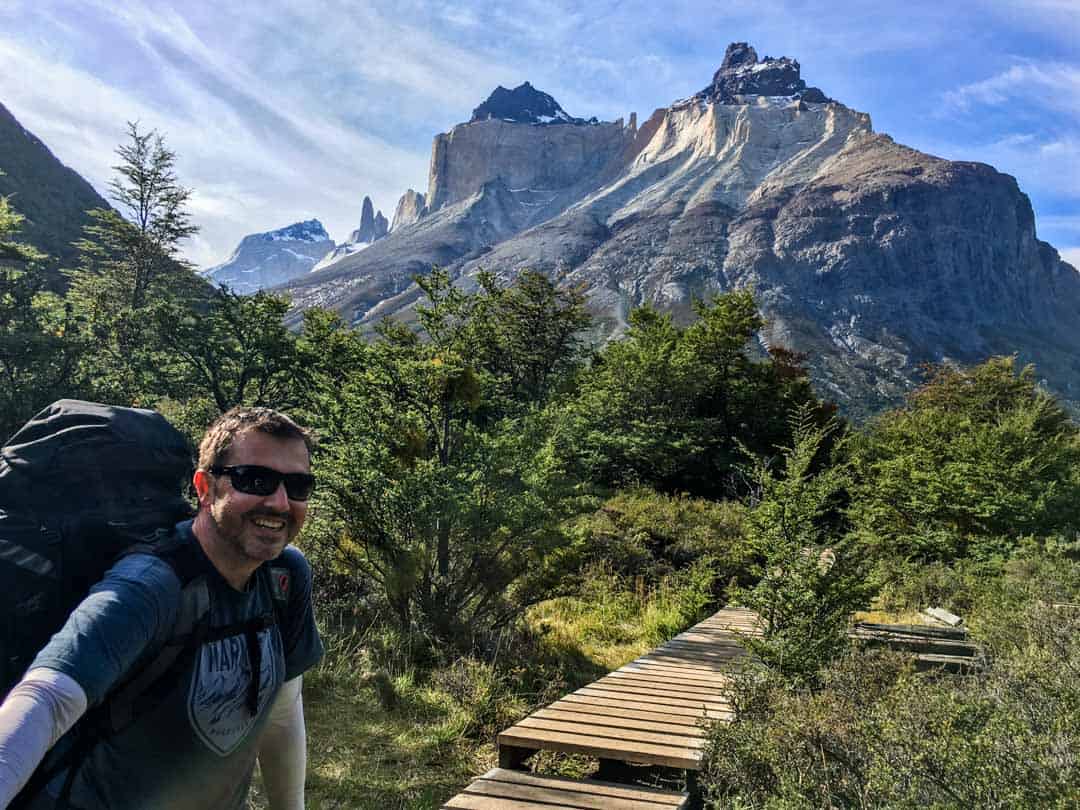
After some more steady rises, we make our final descent into Paine Grande Refuge and Camping around 5.30pm . By this stage, we’re seriously sore and tired and very ready for a beer from the lodge bar, which is the first thing we do once we’ve checked in and dropped our packs at our tent.
The campground at Paine Grande, which is managed by Vertice Travel, is large and separated into sections for campers carrying their own gear, and those like us who have booked a tent. A wooden walkway links the campgrounds with the lodge, the campers’ kitchen and bathrooms.
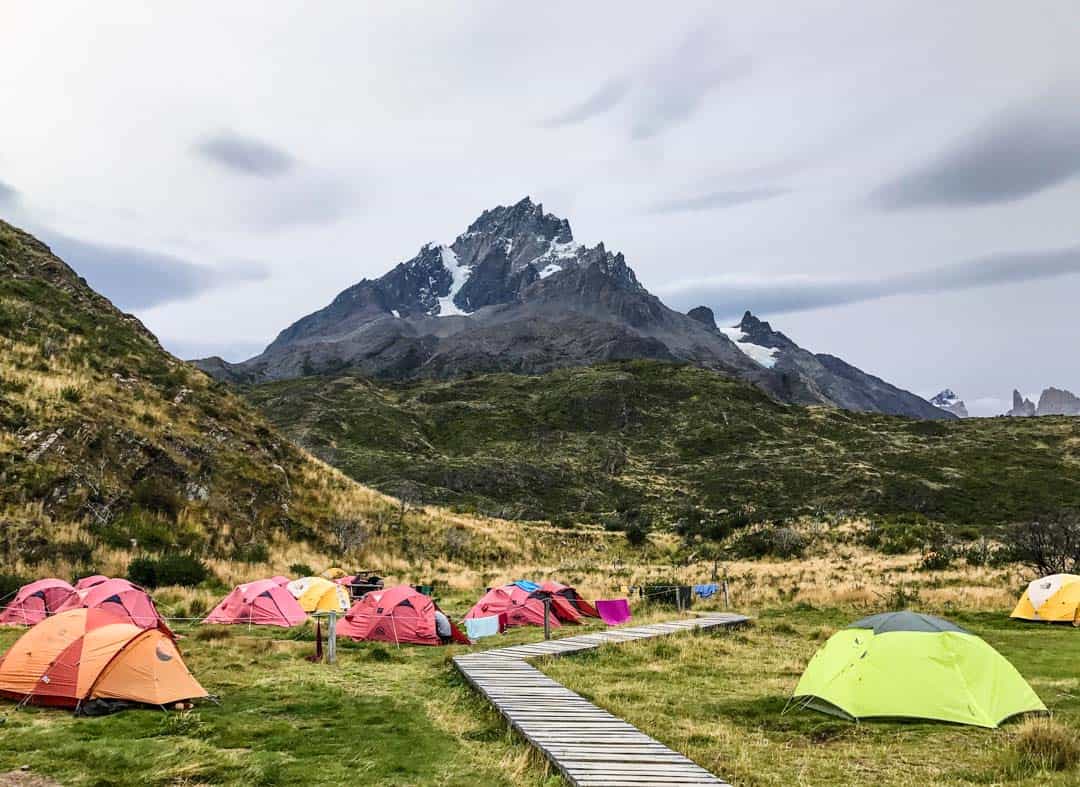
As Paine Grande is the western starting point for hiking the W and a transit point for O circuit trekkers, as well as for day trippers and short stay visitors, this is the largest and busiest lodge and campground in the park.
There’s a good-sized kitchen building, which is heaving with trekkers when we make our way in there to cook dinner around 7pm.
The camp shower and toilet facilities here are basic. We recommend getting your ablutions out of the way while everyone else is cooking dinner and before the post-meal rush. Paine Grande also has dorms, a restaurant and bar, and a mini-market.
We’re tucked up in our tent just as a light rain begins to fall around 8.30pm.
Day 4 – Paine Grande to Grey
Total distance: appx. 11 km / 6.8 miles total time: appx. 3 hours 45 minutes overnight: camping grey.
Today is our shortest day so far on the W trail, so we decide to set out a little later as we’re definitely starting to feel the past three days’ hiking, and a strange kind of exhilarated fatigue.
We’re up at 8am with plans to be on the trail by 9am. However the banshee-like screeches of a fox followed by the thrilling appearance of a large, tawny-coloured puma on the hill behind the camp has us – and everyone else – lingering for a while in hushed awe, until the sleek big cat disappears around a bend into the next valley. Which happens to be the same valley we’re about to trek into.
After checking in at the ranger station for advice on what to do if we see the puma again, we set off through the narrow, pretty dell at around 10am . We’re both relieved (and maybe a touch disappointed) to find no further sign of our feline friend.
The big cats of Patagonia Don’t let the thought of pumas roaming the forests of Torres del Paine put you off trekking there. The fact is, these magnificent creatures are extremely shy and actively avoid humans. Seeing a puma is incredibly rare. Spotting one near camp as we did is apparently almost unheard of. However, it’s important to be across what to do and how to act if you do encounter a puma; you’ll find advice on this in the guide that you receive when you register for your Torres del Paine trek.
The valley walk is flat at first but soon begins to climb, and continues to serve up steady inclines followed by some steep descents into the Grey refuge and camping area.
The scenery on this leg is still epic, but maybe a touch more serene than the high drama mountainscapes of the last couple of days. Grey Lake is flat and still on the day we hike the trail, and dotted with blueish lumps of ice from the vast Grey Glacier at its head.
About halfway along the trail, a rocky lookout reveals the first glimpses of this immense glacier, a sea of ice six kilometres (3.7 miles) wide and 30 metres (98 feet) high in places.
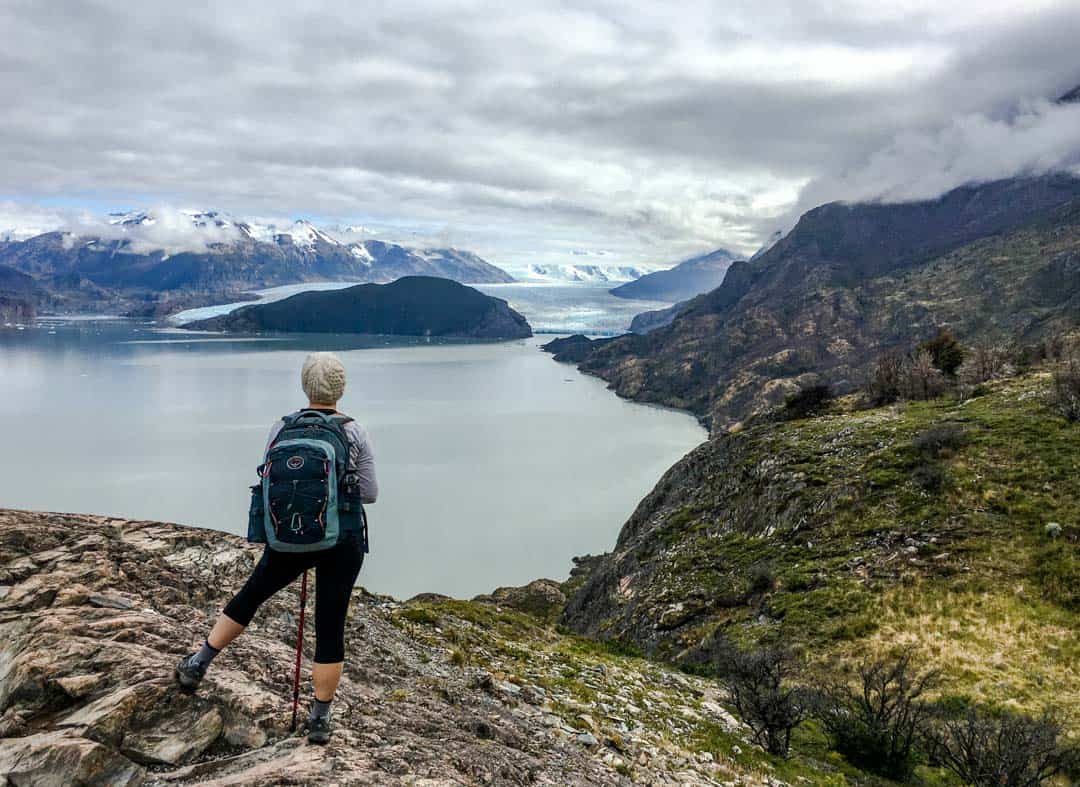
We arrive at the Grey Camping area around 1.45pm , a journey of 3 hours and 45 minutes, with plenty of photo and snack stops along the way.
Grey Refuge and Camping is also operated by Vertice Travel. The lodge has a lovely bar and lounge area in addition to its dorms, and the campground out front is overlooked by the stunning peaks of the Cordon Olguín. By the time we arrive, the clouds have cleared and the mountains burn golden as the sun drops.
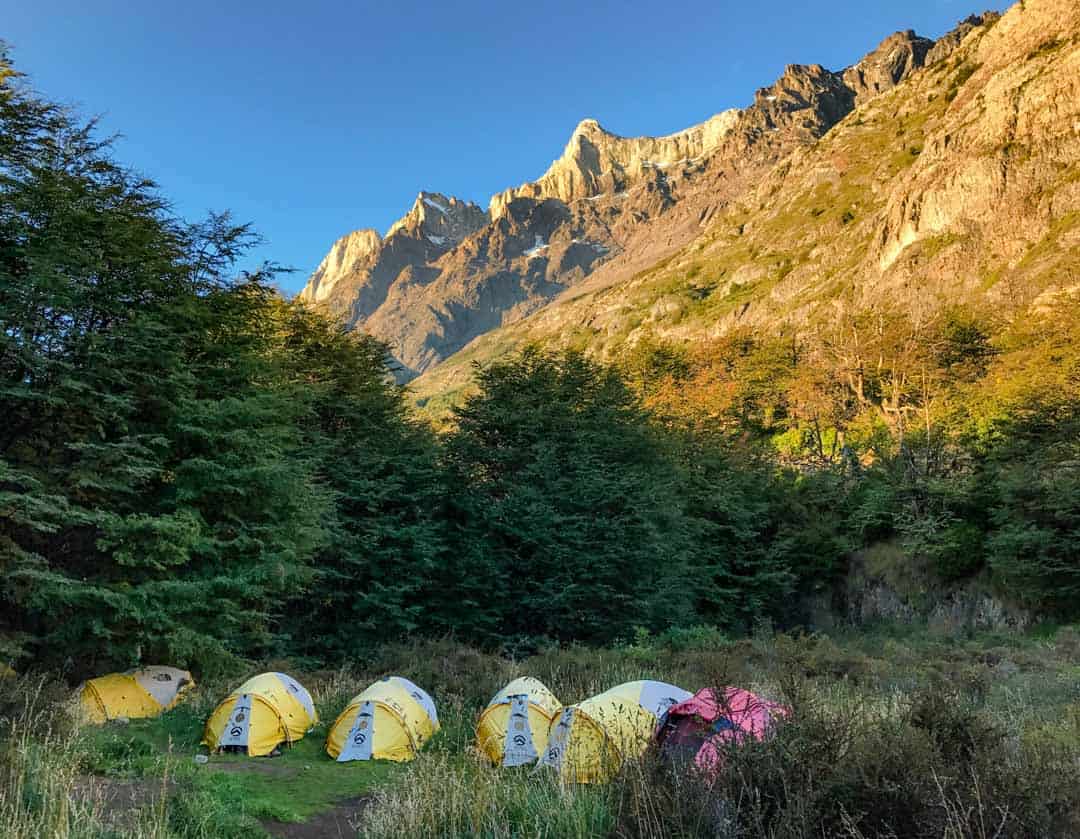
If you’ve got the energy, check in (or leave your pack with the office if check-in hasn’t opened yet), and then head back out to hike past the western tip of the W trail and on to the first leg of the O circuit towards Paso Ranger Station. This will bring you much closer to the glacier, but bear in mind, it’s a five hour, one-way hike to Paso itself.
Trekking tip: Leaving Paine Grande at 10am worked well for us, but if you do want to hike a stretch of the trail from Grey towards Paso and back to Grey today, consider starting out from Paine Grande earlier in the morning so you have more time to do this.
We opt to stop and enjoy our lunch with mountain views, then roll out our mats and nap in the sun until check-in opens.
After getting our tent sorted, we hike to a rocky outcrop on the lake just 15 minutes from camp. The views from here towards the glacier’s terminus are gorgeous and we spend time here just soaking up the scene.
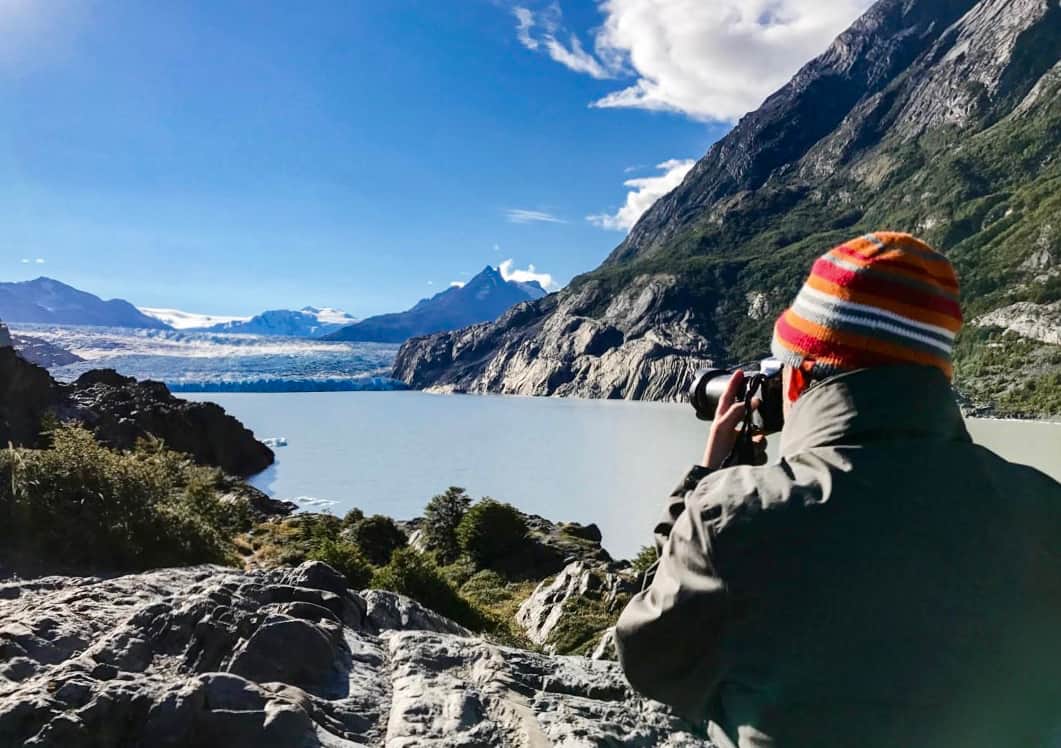
On our return to camp, we head to the lodge for a drink at the bar before making dinner on one of the picnic benches outside the buzzing campers’ cooking area.
In addition to the bar, there’s a restaurant at Grey, and a small shop selling grocery basics. There’s an equally small toilet and shower block for campers (the showers only have certain hours of operation but the water is hot).
We’re in bed by 9pm and prepped for a very early departure in the morning.
Day 5 – Grey to Paine Grande (and return to Puerto Natales)
Total distance: appx. 11 km / 6.8 miles total time: 3 hours 15 minutes.
It’s our last day on the W hike! We’re on the trail early so we can get back to Paine Grande in time for the late morning catamaran across Lake Pehoe to Pudeto, where we’ll pick up the bus back to Puerto Natales.
It shouldn’t take more than four hours to get back to Paine Grande from the Grey campground, but we’re feeling pretty exhausted by this stage and John has nurtured some nasty blisters, so we’re up and on the trail before sunrise .
It’s freezing when we set out at dawn but as the day lightens, we’re treated to a stunning peach-tinted sky reflecting off the lake, and we stop often to snap pics.
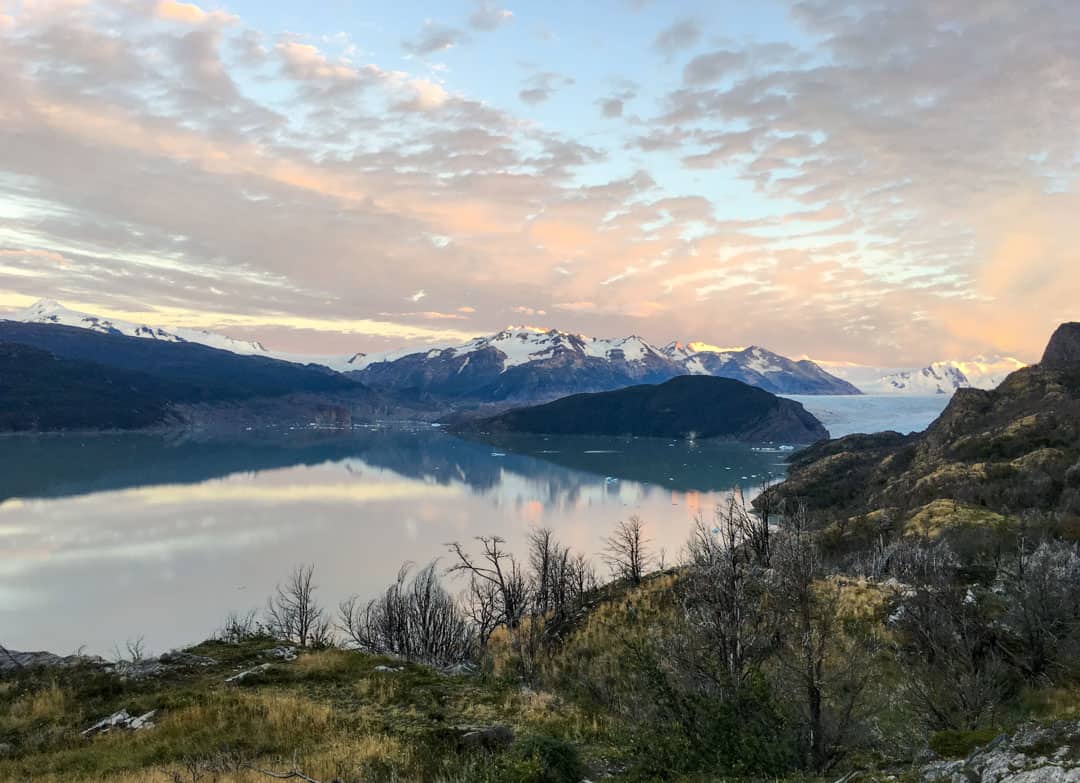
Despite John’s sore feet, we make good time on the return journey and while we’re climbing for much of the first half, it feels easier than the trek up from Paine Grande yesterday. Maybe it’s because we’re on the home run, even though the thought makes us sad.
Our journey back to Paine Grande takes us 3 hours and 15 minutes , 30 minutes less than yesterday’s hike in the opposite direction.
We haven’t eaten breakfast and we’re starving by the time we arrive. We were planning to grab something to eat at the restaurant at Paine Grande, but we discover it’s closed between breakfast and lunch.
We make do with our leftover trail mix instead, which is a bigger deal than you might think: we packed way too much of the bitty hiker’s snack and after five days we have a serious love/hate relationship with it.
Fortunately, there’s now a mini market at Paine Grande, which is apparently open from 7am. But if you’re setting out really early like us, perhaps have something you can eat on the go for this final morning.
Tickets and times for the ferry between Paine Grande and Pudeto Ferry departure times from Paine Grande and Pudeto change throughout the year so be sure to check the schedule when you’re planning your w trek itinerary, and adjust your final day hiking start time to ensure you arrive back at Paine Grande at least 30 minutes before the ferry departs. You don’t need to reserve a place on the boat, just hop aboard and buy your ticket with cash (at last check, it’s US$30 for internationals). The journey to Pudeto takes around 30 minutes.
We board the late morning catamaran for our return to the eastern side of the park. The boat trip across Lake Pehoé offers spectacular views of the entire mountainscape we’ve spent the last five days traversing. It’s an epic perspective of the W panorama and a mesmerising finale to our W trek itinerary.
If the weather is nice, we totally recommend taking a seat outside on the catamaran so you can properly admire the breathtaking scenery.
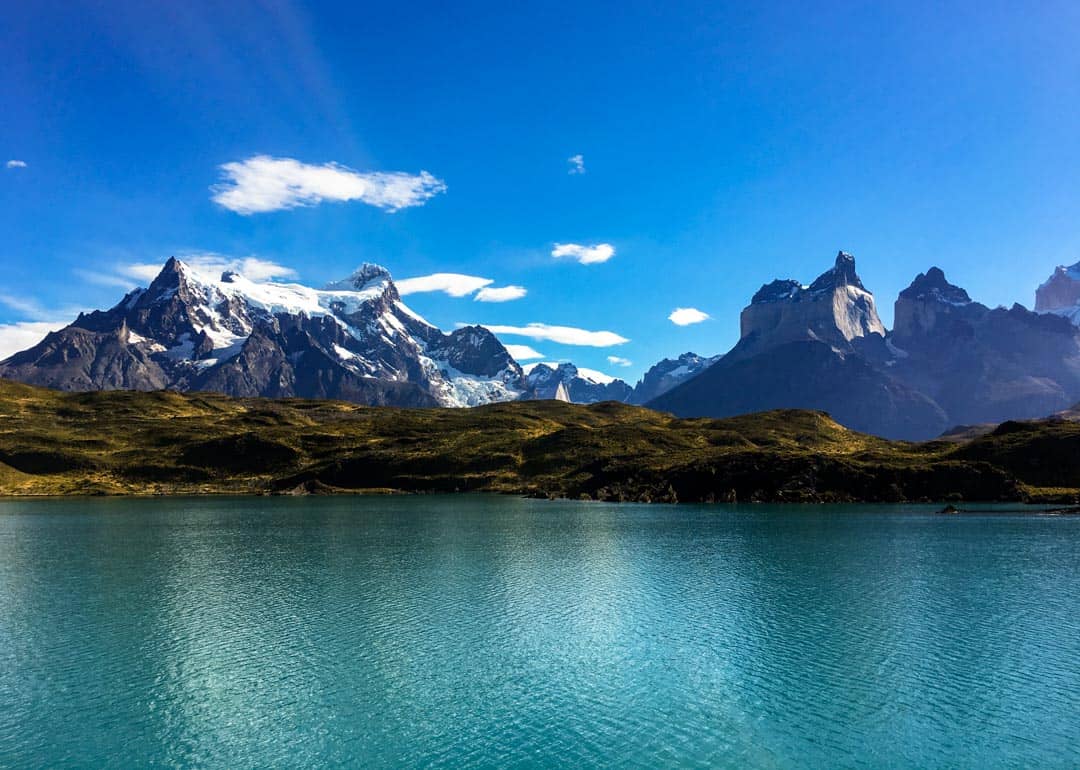
Disembarking the ferry at Pudeto, we grab a coffee from the lakeside café (open from October throughout the trekking season), take a seat in the sun, and enjoy our last moments in Torres del Paine while we wait for our bus.
Pudeto ferry and bus connections In addition to checking ferry times for the catamaran between Paine Grande and Pudeto when you’re organising your trek, it’s also worth checking the bus connections to and from Pudeto, so you can work out the best approach for your final day on the trail.
From Pudeto, the bus makes its way back to the Laguna Amarga Ranger Station to collect hikers finishing their trek at the eastern end of the park. From there, we settle in for the return two hour bus journey to Puerto Natales .
Tonight, back in Puerto Natales, after a good hot shower and a lamentation on the ridiculous amount of trail mix we’ve got left over, we head out for a celebratory drink.
Our legs might be seizing, our knees protesting and we’re beyond exhausted, but we’re buzzing with the sheer thrill of having completed this epic trek. We’re already talking about when we might come back and hike the W trail again, or better yet, take on the longer O circuit.
However we do it, trekking in Torres del Paine is one nature experience we’re keeping firmly on our bucket list.
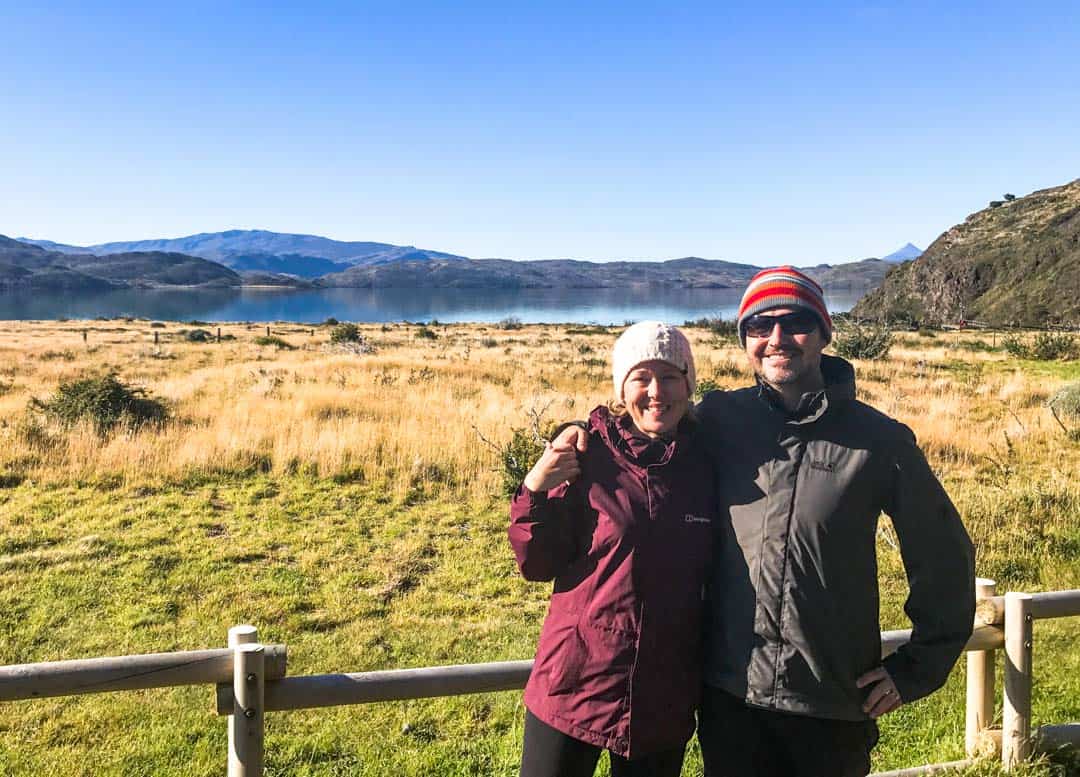
Got any questions? Have you trekked in Torres del Paine recently? We’d love to hear from you, drop us a message below.
For more exciting experiences and things to do in this incomparable part of the world, head to our Chile page or our South America section.
49 thoughts on “Hiking The W Trek In Patagonia: A Self-Guided Itinerary [2024]”
Great website! We’re hoping to do this February/March 2025, and are wondering how best to spend our time on either side of this hike. Did you travel to El Calafate and El Chalten while you were in the area? Or do you recommend other areas down there? Any advice greatly appreciated!
Hi Lisa, thanks for your message! Fantastic to hear you’re planning a trip to Patagonia! Besides the W Trek, there are various activities you can do in and around Puerto Natales and Torres del Paine, like boat trips on Grey Lake to Grey Glacier or horseback riding.
We most definitely did travel to El Calafate and El Chalten after our trek and absolutely recommend, especially if you’re keen to get out on some further hikes. We bussed from Puerto Natales to El Calafate and the next day did a day trip to the Perito Moreno Glacier, which is an absolute must. From El Calafate, we travelled by bus to El Chalten (the panoramas on the bus ride in are wow – try and get the front seats!) and spent a good couple of days exploring this gorgeous area and just hanging out. There are a range of hikes you can do out of El Chalten – the day hikes to Laguna de Los Tres and Cerro Torre are epic.
If you head south from Puerto Natales to Punta Arenas, you can do day trips to see King penguins, Magellan penguins, whales and dolphins, so that’s another option.
Have a wonderful time and happy trip planning! Cheers, Danielle
Thank you for sharing your Patagonia insights! I found it very thorough and incredibly helpful. I we are planning our trip for October 2024. I have a question. How did you book your meal plan? Thanks! Kim
Hi Kim, thanks for your feedback, we’re glad you’ve found our post helpful! When you go through the booking process for each accommodation (including camping) along the trail, you’ll have the opportunity to add meals as part of those bookings. Links to the accommodation providers are in the post. Good luck with your planning and happy trekking in October! Cheers, Danielle & John
Hi thank you so much for this detailed blog. It appears that one would have to stay at Frances camp if going east to west in order to shave hiking time on day 3. Is there a bus company through which we have to pre-book a bus ticket from Pudeto ferry to Las Amargo? Or is it a shuttle service? Do you have any idea if booking a guided tour via Las Torres means that they carry your heavy rucksacks?? Is the last day at Grey really worth it ? Or would you rather end the trek on day 4? Thank you!
Hi SK, thanks for your message. Until the CONAF Italiano camp reopens, Frances camp is the closest camp to the Frances Valley so yes, it is the best bet timing-wise for getting in and out of the Frances Valley and on to Paine Grande on Day 3 if travelling from east to west. You could also stay at Los Cuernos, but that would add around 1.5 hours to Day 3.
The buses running from Puerto Natales to Torres del Paine drop off and pick-up from Laguna Amarga and Pudeto. When you buy your bus ticket to Torres del Paine, you’ll note where you’ll be getting off and on again (it will depend on your itinerary, but for us, travelling from east to west, we got off at Laguna Amarga and boarded at Pudeto on our return. Check out the section in our post on bus tickets to and from the park for more info. There’s a shuttle that runs between the Laguna Amarga ranger station and Hotel Las Torres for a fee.
We would suggest contacting the tour company you’re interested in for advice about whether porter services are available on their guided tours. We left most of our luggage in one of our backpacks at our hotel in Puerto Natales and carried only what we needed for the trek to keep the weight down.
We personally feel that every leg of the W is absolutely worth it – the scenery is superb throughout. Five days gave us just the right amount of time to enjoy the whole trail without pushing too hard. To do the trek in four days, you’d likely need to compromise on either the full hike into Frances Valley or the Grey leg in order to reach camps before dark, and we wouldn’t want to skip either. But that’s us. If four days was all we had to trek, we would possibly leave Grey but we’d have to make sure we did a boat tour out to the glacier instead! 🙂
All the best with your planning! Cheers, Danielle & John
This is seriously one of the best breakdowns I’ve read. Patagonia is one of three “Someday” treks I have on my list to head off on once my son is a little bigger and can carry more of his own gear. We’re building up now with longer and longer trips around Central/Eastern Europe
Love this site!
Thanks for your message Brian, we really appreciate your feedback. So cool that you and your son are already hiking together, and what an awesome bucket list adventure to look forward to with him! Happy trekking and thanks again! Danielle & John
Do you have a map with the accommodations you booked or where you rented out tents/gears? Planning on doing this solo in June!
Hi Erika, thanks for your message! There’s a trail map available at the official Torres del Paine website: https://parquetorresdelpaine.cl/mapa-2023-2024/ – it shows all the accommodations/campsites along the trail. You can also find links in our post to the accommodation providers we booked our campsites and camping gear through.
As you’re considering a June trip, we’d also encourage you to check out the official Torres del Paine website for information about winter hiking regulations – https://parquetorresdelpaine.cl/permisos-especiales/ . Many of the accommodations and trails close over winter and while you can visit the park, we understand it’s mandatory to have a guide for the W Trek and the trek to the base of Las Torres between 1 May and 30 August (though the timeframes can change depending on weather). All the best with your planning! ~ Danielle
Hello Dan, What a great find this was. Thank you so much for writing it. I’m looking to mimic your trek with some modifications. I will very likely have a car rental when I arrive into Punta Arenas. My plan is to drive myself and 2 others into the park and leave the vehicle parked at the welcome center or hotel (unsure if this is allowed). At the end you mention that you ferry to Pudeto- then catch a bus that swings by Laguna Amarga into Puerto Natales. Is there a bus that goes directly back to the welcome center or hotel from Pudeto so we can get back in my rental? It looks like the Laguna Amarga ranger station is about 8.5 km from the welcome center. Or is it best to just shuttle from Puerto Natales for the whole thing and leave the rental somewhere in town?
Hi Bruce, thanks so much for your message and feedback! Very good question re. parking – based on our limited research into this, our understanding is that you can leave your car at Hotel Las Torres while you trek if you’re a guest there, otherwise, cars can be parked at the nearby Welcome Centre. We’ve also seen reference online to a small car parking area at Pudeto, so in theory you could arrange bus tickets from Pudeto to Laguna Amarga, and from there get the hotel shuttle to Hotel Las Torres/the Welcome Centre. I would suggest posting your question on Tripadvisor and hopefully someone has done something similar recently and can provide latest info. It might also be worth contacting Hotel Las Torres and asking their advice; no doubt they get questions like this frequently. All the very best for your trip planning and the trek itself – it’s an unforgettable experience! Cheers, Danielle & John
Thank you so much for the great information. I’m a long term planner and we’re looking to book for our family of four, Christmas 2024. I found this blog really really helpful in hiking cost effectively. Thanks Again!
Hi Melissa, thank you so much for your message, we’re really happy you’ve found our post helpful in your planning. Also very excited for you and your family – what a fantastic Christmas experience! We hope you have a really wonderful time hiking the W, it’s just such an incredible place! All the best and happy hiking! Danielle & John
Thanks for the article, I find it very useful. I have just booked the circuit trail for this April. About that: I looked into using Booking Patagonia for the reservations, and it works really well. Though, there is a downside: they charge an extra $90. You’ll notice this at the very and of the booking process, which I found quite frustrating. For me that was a reason to book directly at Vertice and Las Torres Patagonia, which works fine.
Hi Valentijn, thanks so much for this update, that’s really helpful to know! Thanks also for your feedback on our post, we’re pleased you’ve found it useful. All the best for your upcoming trip in April, have a sensational time and happy hiking! Cheers, Danielle & John
Thanks for the great write up. The details are useful and your descriptions are inspiring. I’m leaving for Chile in a couple days and your post just added to my excitement.
Hey Mike, thanks so much for your feedback, we hope you have a really fantastic trip. Chile is an incredible country, one of our faves!
Cheers, Danielle & John
Thank you for that informativ Blog! I have a question: are there any possibilities to heat up some water in the Refugiés without a stove?
All the best Sophie
Hi Sophie, thanks for your message!
As we had a cooking stove (and booked meals at Chileno where stoves can’t be used), we can’t personally say for sure whether hot water is currently available at all of the stops on the route. That said, we did find a trekker’s report online from late 2023 noting that they were able to access hot water (not boiling) through the coffee/tea dispensers at each of the refugios they stayed at, which they used for their dehydrated meals. Would suggest seeing if there are other trip reports from this season, or posting on a forum for latest updates. Or perhaps hire a stove in Puerto Natales and buy a gas canister just to be on the safe side! We’d love to know what you find out!
Have a magic time trekking the W!
Cheers, Dan & John
Hi guys. Thanks for all the detailed info. Just wondering if you could give an estimate of how much it cost for the W trek. I am being quoted $1180 per person for 4 nights and five days starting 12th February with this included:
• camping accommodation with all the equipment • all the meals • transportation from/to natales-park • park entrance • catamaran • welcome kit
Not sure if this price is really high or if it would work out as that much if I book everything myself separately anyway.
Many thanks
Thanks for your message and feedback – we’re really excited for your trek in Torres del Paine.
We were travelling long-term when we did the W Trek so we went out of our way to keep costs down by booking the campsites directly, carrying some of our own camping gear and bringing most of our own food. Travelling as a pair also helped as the single supplements can add quite a bit. We’d also note that, like everything, prices have hiked post-Covid.
We’ve included some costings in our post but not many as we’re conscious things can change quickly (plus there are so many potential cost combos for accommodation/food, it’s tricky to provide a general estimate). As the bulk of your costs will be in the camping, gear and food components, you might consider checking out the latest price lists for camping and food package options on the Vertice and Las Torres Patagonia websites; that would give you a sense of costs in the context of your quote. Given how quickly accomm/campsites book up for the season and the challenge of trying to coordinate an itinerary across multiple websites, having a third party making the arrangements, while costing more, would take the hassle out of that.
All the best with your planning and we hope you have a sensational time trekking!
Cheers Danielle & John
Your hikes sounded amazing. We are going in Feb and I wasn’t sure what to expect. Sounds like I should do some training! Do you recommend stiff hiking boots to navigate the big rocks or are light hikers enough support?
Thanks for sharing, Karen. Canada
Hi Karen, many thanks for your feedback! To be honest, if you’re a regular walker/hiker, you may find the W Trek a breeze – we met plenty of people who barely cracked a sweat, lol. As irregular hikers, we found some of the steeper sections a little more ‘breath-taking’ but still very do-able. We both wore regular lightweight hiking shoes and they were fine (apart from John developing blisters towards the end), but we also saw people in solid boots. I guess it depends on your preference. We did find having a hiking pole each was useful on some of the more uneven terrain like the rocky climb to Las Torres. We’d love to hear about your trek when you get back – have a fantastic time! Danielle
Going in February, cant wait. Did you know how anyone who did the kayak at Grey and talked about there experience?
Hi Efren, that’s so exciting! We don’t personally know anyone who has kayaked at Grey but we wish we’d had time for it – what an amazing experience! The lake is beautiful and the glacier is epic! If you do kayak, we’d love to hear about it! Have a fantastic time, Cheers, Danielle & John
Awesome Post!
I’m looking at doing this the same direction as you guys did around the same time in 2025.
You mentioned availibilty determined your campgrounds; that being said would you change any of your stays if you could in retrospect? Maybe saw some better campgrounds/lodges along the way that you wish you could have booked had there been availibilty?
Hi Chris, thanks for your message and good question! We were on a long travel stint when we did the W Trek so we opted for camping to keep our costs down, plus the campsites we ended up with proved to be very well located for a five-day itinerary. That said, all of the lodges and refuges looked quite nice so if we were to do it again (and we hope to!), we would consider adding some lodge/refuge stays, following the same itinerary. Location-wise, the Cuernos and French refuges would be good alternatives to camping (though these are beds in dorms, which is less appealing to us). We would definitely consider the Cuernos Cabins (2-3 people per cabin), especially if we were planning a longer stay in the French Valley! We’d also consider staying at the lodge at Grey next time as, of all the campgrounds, this was probably our least favourite (plus we were very ready for a bed by that stage!). Overall, the quality of the campgrounds/refuges throughout the park is very good and we were really happy with our camping experience and itinerary. Best of luck with your planning and we’d love to know how you go! Happy travels!
Wonderful description. We are going in Jan 2024! Looking forward to it.
Hi Kishore Joshi, thank you so much for your feedback, we hope you’ve found it helpful! Wishing you a fantastic W Trek, it really is the most incredible place! Happy travels!
Hi! How much cash would we need, knowing that the bus and entrance are paid for and also full board meal plan at the refugios is booked? So for snacks, water or other costs etc? Do they accept USD or should we have it exchanged? Thanks!
PS, did you also really use ‘poop bags’ for your used toilet paper along the way? 😅
Thanks for your message. We carried both USD and Chilean pesos with us just in case, and we were able to use credit cards at the refuges. We paid for the shuttle from Laguna Amarga and the catamaran from Paine Grande in pesos, though we have read that the catamaran operators may take USD in high season. It’s handy to have pesos for smaller purchases like snacks. We carried a refillable bottle and filled up in streams and at the refugios, so we didn’t purchase water.
We have packed degradable doggy bags for carrying out toilet paper on past hikes! 🙂 On the W Trek though, we carried a loo roll and some trusty Ziploc bags, but we mostly just made strategic use of the campground facilities!
Happy trekking!
Hi John and Dan Thanks for such good info. Is it safe doing it self guided ? Thanks
Hey Iris, thanks so much for your message, we hope you found the post helpful. We found going self-guided very easy – the trails are well trodden and during the peak season, there are plenty of other people hiking too (guides are mandatory in winter). Plus all trekkers have to stay in the designated camping and accomm areas so there are others around and you can stay in dorms if you’re not keen on camping. Conditions can vary dramatically though and it is the great outdoors, so having appropriate gear is essential and hiking with friends is good idea though we hear lots of people do it solo. Everyone we met en route were friendly, encouraging and helpful too. We absolutely loved the hiking the W and hope you get to experience it too! Happy travels! Dan & John
This is really helpful thank you so much. Did you have much hiking experience before you took this on? Would you recommend any training prior to going? What size backpack would you recommend taking?
Thank you so much
Hi Jo, thanks for your kind words, we’re glad you found the post useful! We’re casual hikers and while we’d done a bit of hiking before the W, it was certainly one of the ‘biggest’ hikes we’d done. We definitely tried to up our walking/hiking game before the W in preparation and glad we did as we personally found some of the steeper, sustained-climbing parts of the trek relatively tough – we just took our time and had lots of breaks; necessary anyway to take in the gorgeous views! I carried a 30L daypack and John carried a 50L backpack – between us we carried everything we needed for the five day hike, but I would note that we didn’t have to carry tents, sleeping bags or mats as we hired these. We hope you have the chance to hike the W trek, it remains at the very top of our hiking list! Happy travels!
Thank you all for this awesome breakdown and information! We followed it exactly to book our accommodations and plan to do the trek end of March. Thanks again!
Hi Kristen, thanks so much for your feedback! We’re stoked you found our post helpful and we’re very excited for your upcoming trip. Torres del Paine is sooooo spectacular, wishing you a fantastic trek – let us know how you go! ~ Danielle & John
Thanks Dan for the great details and info.
Hi Kristen. I am doing the trek around of march with a friend. We are travelling from Perth, Australia. Would be great to collaborate in planning.
Thanks Bikash
Hello! This page is fantastic, thank you so much. We are looking at November and can be flexible in terms of dates. Did you book your accommodation first? Are there any other considerations i.e. tickets or entry to the park? Or should we just arrange accommodation and go from there? Do you mind sharing how much you paid approximately for your camping accommodation? No worries if not. Thanks 🙂 Amie
Hi Amie, many thanks! We booked our accommodation first and a couple of months in advance. Site availability ended up driving our approach to the trek – so it’s good that you have flexibility! Would definitely get in as early as possible to book. Tickets for the park itself are arranged at the park entry office, but you will need to have the accomm bookings in place (and evidence of them) when you get to that point. So it’s important to book the accommodation and bus tickets to the park in advance. Bus tix you can buy when you get to Puerto Natales, but try and do that as soon as you arrive rather than on the day you intend to travel to the park. Prices for camping and cabins may have changed since we trekked, but if you head to the accomm links in our post, you’ll be able to find out the current prices as it’s all bookable online. Hope that helps and have a fantastic trek! Cheers, Dan & John
Thank you for the detailed information. We are trekking this exact route this March 2020!
Hi Jackie, thanks for your message, we’re really happy you’ve found it helpful for planning. Hope you have a sensational trek!
Thank you so much for the detailed guide! This is really helpful 🙂
Hi Katherine, thanks for getting in touch! We’re really pleased you found the guide useful – happy hiking!
How did you book the campsite ? I unable to locate the source to book just the campsite
Hey Rajesh, thanks for the message.
The Camping areas are run by three different operators in the park, and you can find links to all three operators in our post.
All three operators’ websites have information about their camp sites, and how to book.
Hope this helps.
John & Dan
Exactly what I’m looking for, thanks! Chileno and Los Torres always been there on my bucket list, now I know where and how to start.
Awesome, thanks Rika, we’re really pleased you’ve found it helpful. It is the most spectacular walk – even if you just did the one leg to Las Torres, you’d have photography opps galore! Happy travels!
Leave a comment Cancel reply
Save my name, email, and website in this browser for the next time I comment.
Hrmm. Looks like you're using an older browser, which means some site features may not work they way they should. For the full gadventures.com experience, we recommend upgrading to the most recent version of your browser . It's worth it! Honest!
View all tours
North America
Central america & caribbean, south america, north africa & middle east.
Few travellers make it to this icy continent, but the lucky ones who do get to explore a frozen Eden ruled by the elements and teeming with wildlife.
G Adventures Land
G adventures sailing & cruises, g adventures private travel.
Whether it’s a family retreat or a girls trip, you can surround yourself with a hand-picked crew and customize a tour that fits you all perfectly.
The Geluxe Collection
Our new line of premium active adventures is officially here. With perfectly paced itineraries, one-of-a-kind accommodations and elevated dining, this is adventure at its finest.
National Geographic Journeys
Go deeper into the cultures and habitats of the places we explore. More is included and you’ll enjoy greater hands-on exploration, interactions with local experts, and freedom to roam.
National Geographic Family Journeys
Are you an adventure-loving family in search of meaningful ways to discover the world together? These tours are specially designed for travellers seven and up and their inquisitive families.
Jane Goodall Collection
Step deeper into the animal kingdom while respecting all of its inhabitants. Our incredible collection of 20 wildlife-focused tours is endorsed by the world-renowned ethologist.
Roamies by Hostelworld
The thrill of adventure. The awesomeness of hostels. Get ‘em both on these immersive small group trips for 18 to 35-year-old travellers.
Why choose us
As the leader in small group travel for 30 years, we know how to do it right: flexible itineraries, freedom to roam, safety, peace of mind, and locally based guides.
Change the world just by having the time of your life. When you travel with us, you become a force for good by acting responsibly and creating positive impact.
Together with our non-profit partner, Planeterra, we ensure local communities touched by our tours benefit from our visits in as many ways possible.
Trees for Days
Leave your destination even greener than you found it! For every day on tour, we’ll plant a tree in your honour and ensure that our forests get to live their best lives.
Travel resources
Last minute deals.
Looking to have the time of your life in the next 90 days or so? You can save big if you’re ready to book now.
Loyalty discount
Back home from a G Adventures tour? Submit a quick trip evaluation to save 5% on your next tour with us.
Student discount
Got proof that you’re pursuing higher learning? Then we’ve got a travel voucher with your name on it.
All travel deals
New ways to save pop up all the time. Here’s where you’ll find every hot deal in one easy place.
Torres del Paine - The W Trek
6 days, puerto natales to puerto natales.

- Full itinerary
- Tour details
Here's a quick six-day trip that's simply perfect as an add-on to other Patagonian adventures. Torres del Paine's W Trek is celebrated by active travellers globally as one of the most scenic treks anywhere. Spend four days walking through stunning landscapes surrounding Grey Glacier, French Valley, and the imposing three towers. While the trek alone is challenging enough, the real contest comes in needing to take your camera out so frequently.
Puerto Natales to Puerto Natales
Is this tour for me, travel style: active.
Hiking, trekking, biking, rafting, and kayaking adventures all over the world, made for outdoor types.
Service Level: Camping
Camping most nights with some hotel/hostel stays to start and throughout; affordable public and private transport.
Physical Rating: 4 - Demanding
Some high-altitude hikes or more strenuous activities, but accessible to most healthy travellers.
Trip Type: Small Group
Small group experience; Max 16, avg 12
Age requirement: 12+
All travellers under age 18 must be accompanied by an adult.
Check Your Visa Requirements
Before booking, use our handy entry requirements tool so you know which documents you need to enter and travel through the countries on your trip.
See how your trip uplifts communities
In a number of impactful ways, your adventure directly benefits the local people and places we visit.
Help us spread love around the world — with trees! Together with Planeterra, we'll plant one tree in your name for every travel day.
Trees planted for this trip: 6
Ripple Score
Want to create ripples that change lives? The higher the Ripple Score percentage, the more money stays in the local communities you visit.
Ripple Score for this trip: 100
More from Torres del Paine - The W Trek
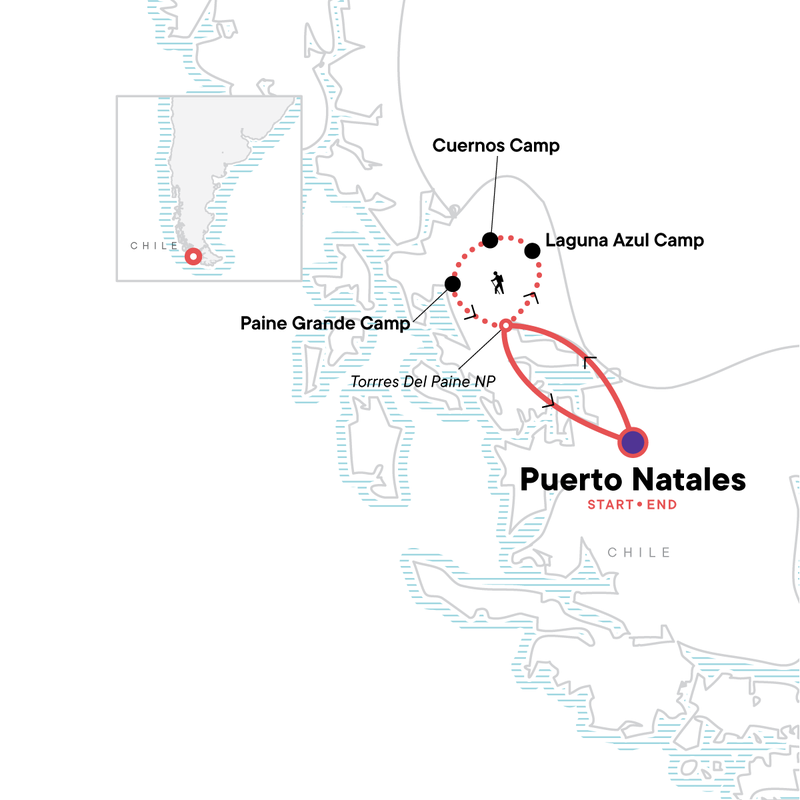
Places visited
Ready to take on Patagonia? Get familiar before you go.
Day 1 Puerto Natales
Arrive at any time.
Exclusive Inclusions:
Day 2 puerto natales/laguna azul camp.
Embark on a 4-day excursion within Torres del Paine National Park, hiking the famous W Trek. Start the 62km (38.5 mi) route by trekking to the base of Las Torres to see the dramatic three towers and turquoise lagoon below.
Meals included:
Day 3 laguna azul camp/cuernos camp.
Wake up surrounded by breathtaking landscapes. Enjoy breakfast with a view, pack your bag and jump in the van. Our drive today goes along the Paine river until we reach the Welcome Center in Torres del Paine NP. Be on the lookout to spot some wildlife! Once at the welcome center, meet the porters and continue hiking along the W route towards Cuernos Campsite. Stop at Nordenskjöld lake and enjoy the view before reaching Cuernos Camp.
Day 4 Cuernos Camp/Paine Grande Camp
Today hike to the French Valley lookout to see the imposing French glacier hanging over Paine Grande mountain. Take in the dramatic, contrasting greens and greys on the landscape and enjoy a 360 view from above. Head to Paine Grande Campsite after crossing an eerie and beautiful forest of dead trees.
Day 5 Paine Grande Camp/Puerto Natales
The final day of the W Trek leads to Grey Lake and the lookout point for Grey Glacier. Gaze off into the distance admiring the scale of this immense glacier. Hike back to Lake Pehoé and finish by taking a picturesque ferry ride across the lake enjoying the sense of accomplishment before returning to Puerto Natales for the night.
Day 6 Puerto Natales
Depart at any time.
What's Included
- Your Welcome Moment: Welcome Moment - Meet Your CEO and Group
- Torres del Paine National Park camping and trekking excursion along the the "W Route" (3 nts)
- All transport between destinations and to/from included activities
Accommodations
Hotels (2 nts), camping (3 nts).
5 breakfasts, 4 lunches, 3 dinners Allow USD80-105 for meals not included.
Transportation
Van, ferry, hiking.
Staff & experts
CEO (Chief Experience Officer) throughout, specialist mountain guides in Torres del Paine NP, local guides.
Available extras (Add these to your tour when you book)
My own room - from $59.00.
If you're travelling solo and would prefer to have your own private room throughout your trip, select this option during the online booking process.
Make it a private tour
Book this tour as a private departure, with your own CEO and all the benefits of a G Adventures group tour.

Solo Hiking the W Trek in Torres del Paine: A Comprehensive Guide to Trekking without a Guide in Chilean Patagonia
Are you ready to embark on an epic solo hiking adventure? Look no further than the W Trek in Torres Del Paine, Chile. This comprehensive guide will equip you with everything you need to conquer the one of the best hikes in Patagonia . Whether you’re a seasoned hiker or new to the trail, we’ll ensure you have all the information you need for solo hiking the W Trek. From crafting your perfect itinerary to packing the essentials and navigating the logistics, let’s prepare you for the journey of a lifetime.
This article contains affiliate links from the Amazon Associate and Travelpayouts programs. Wild Travel Tales will earn from qualifying purchases, at no extra cost to you .
Key Takeaways
- Day 1: Puerto Natales to Grey (bus, ferry, 11km walk)
- Day 2: Grey to Paine Grande (11km), plus optional glacier hike
- Day 3: Paine Grande to Francés/Los Cuernos (21km)
- Day 4: Francés/Los Cuernos to El Chileno/Central (18km)
- Day 5: El Chileno/Central to Mirador Las Torres to Puerto Natales (9km)
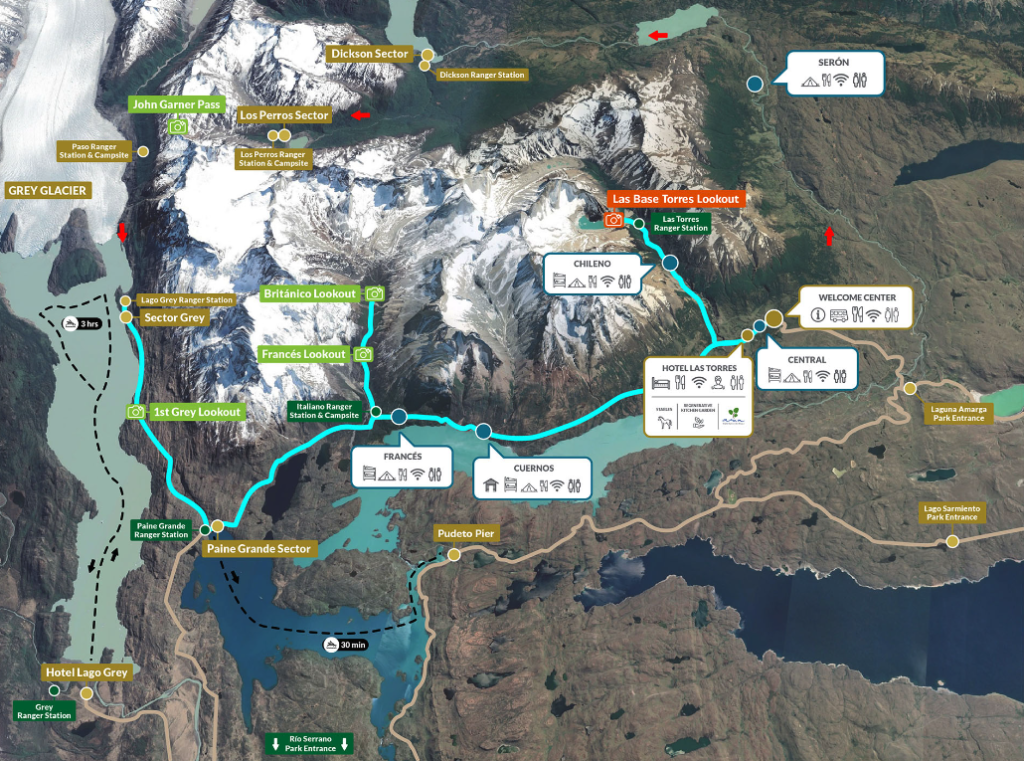
Checklist to Hike the W Trek without a Guide
This post explains everything you need to do to plan your W Trek adventure in detail. Before we get started, here is a simple checklist you will need to check-off.
- Book your accommodation via Torres Hike , or directly via Vertice and Las Torres – you need to book as early as possible, as it it can book out!
- Book your entrance ticket to Torres del Paine National Park online
- Pack proper equipment and food
- Book your return bus ticket from Puerto Natales to Torres del Paine National Park
- Ensure you have at least $28,000 pesos in cash ($25,000 pesos for the ferry, $3,000 pesos for the shuttle bus) as well as extra for any additional purchases you may want to make while in the park (e.g., snacks, drinks, meals, etc) – you should definitely bring extra money, just in case!
Where is the W Trek Located?
The famous W Trek is located in Torres Del Paine National Park, nestled in the southern reaches of Chilean Patagonia. This UNESCO Biosphere Reserve boasts pristine landscapes, dramatic peaks, and crystal-clear lakes, making it a dream destination for adventurers like you. The name “W Trek” originates from the distinct W-shaped path you’ll follow through the park, which offers a curated experience of Patagonia’s finest offerings.
When is the Best Time to Do the W Trek?
Planning your visit to Torres Del Paine is a crucial first step. While the park is open year-round, selecting the best time to hike the W Trek can greatly impact your experience. This will mostly come down to your preferences and desired experience.
Here’s a breakdown of your options:
- Shoulder Seasons: For milder weather and fewer crowds, consider hiking during late October to early November or late March to early April.
- Peak Season: If you crave the vibrant colours of Patagonian spring or the lushness of summer, be prepared for larger crowds during the peak season from November to March.
Where to Stay on the W Trek?
The W Trek offers a range of accommodation options to suit various preferences and budgets:
- Camping: Experience the wild by camping under the stars. This is a budget-friendly option for adventurous backpackers.
- Refugios: For a more comfortable stay, opt for refugios, which are similar to hostels. They offer a warm and cozy atmosphere after a long day of hiking and often provide shared facilities.
Camping vs Refugios on the W Trek
For those with an adventurous spirit and a desire to be as close to nature as possible, camping is an excellent choice. It is also substantially cheaper than staying in a refugio, which is a great way to bring down the cost of hiking the W Trek.
Many campsites are strategically located right outside the doors of refugios, granting you easy access to their facilities. This means you can enjoy the perks of refugios, such as meals and hot showers, while still savouring the authenticity of sleeping under Patagonia’s star-studded skies. It’s worth noting that you’ll need to carry your camping gear, including a suitable tent, sleeping bag, and cooking equipment, to ensure a comfortable stay. However, there are premium campsite options available with a pre-erected tent provided!
On the other hand, if you prefer a bit more comfort and convenience, the refugios are ready to welcome you. These cozy mountain lodges provide dormitory-style accommodation and shared facilities, including dining areas and hot showers. Staying in a refugio means you don’t have to lug heavy camping gear with you, allowing for a lighter backpack. However, it will make hiking the W Trek more expensive.
Booking Campsites & Refugios for the W Trek
As one of Patagonia’s most sought-after hikes, it can be difficult to secure campsites or refugio beds for the days you want. It is essential that you book your accommodation in advance (as early as possible), especially during the peak season. It is not uncommon for campsites and refugios to book out.
The campsites and refugios at different points along the W Trek are operated by two different companies, Vertice and Las Torres (formerly Fantastico Sur) . You have two different options to book these sites:
- Book via Torres Hike , a platform which aggregates availability from both Vertice and Las Torres. All you need to do is enter your planned dates, the direction of your hike and which type of accommodation you want, and the website will allow you to make one single booking (instead of coordinating separate bookings via both Vertice and Las Torres). This will save you lots of time compared to the second option…
- Make reservations with Vertice and Las Torres directly, via their websites. This option requires you to ensure the availability of campsites offered by both providers aligns with your planned itinerary in the correct order of your hike, then booking each night of accommodation on each company’s separate website. Meticulous planning is necessary.
Why would anyone book through separate websites when it is all collated in one platform via Torres Hike? Good question. Unfortunately, Vertice and Las Torres only allocate a limited number of campsites for purchase via Torres Hike. And because Torres Hike is a far easier process, these sites will book out more quickly than direct bookings. So, if Torres Hike does not show any availability for the dates you want to hike the W Trek, you may be able to book under your original itinerary if you book via Vertice and Las Torres.
There are often different options you could book for each night, depending on the distance you plan to cover each day. Below are the campgrounds along the W Trek in order.
- Refugio and Camping Paine Grande (Vertice Patagonia)
- Refugio and Camping Grey (Vertice Patagonia)
- Domes and Camping Francés (Las Torres)
- Refugio and Camping Los Cuernos (Las Torres)
- Refugio and Camping Torres Central (Las Torres)
- Refugio and Camping El Chileno (Las Torres)
You will only stay at 3 or 4 of the campsites, depending on how many days you plan in your itinerary. Plan ahead, consider your preferences for camping or staying in refugios, and make those reservations promptly to guarantee a smooth and enjoyable W Trek experience.

How Difficult is the W Trek?
The difficulty of the W Trek can vary along its route. Understanding its challenges is paramount for a successful journey. Here’s an in-depth look at what you can anticipate.
Physical Fitness: The W Trek is considered moderately strenuous, making it accessible to hikers with a range of fitness levels. While it doesn’t require you to be an elite athlete, it’s essential to have a reasonable level of physical fitness. This includes the ability to hike for several hours a day, navigate uneven terrain, and endure uphill climbs and descents. Prior conditioning and cardiovascular endurance can significantly enhance your experience.
Changing Trail Conditions: Patagonia’s weather is notorious for its unpredictability. Be prepared for rapidly changing conditions that can range from sunny and pleasant to windy, rainy, or even snowy. Proper clothing and gear are crucial to adapt to these changes and ensure your safety and comfort.
Route Options: The W Trek offers flexibility in choosing your direction, whether east-to-west or west-to-east, each with its own highlights. Starting from the east provides a dramatic introduction to the famous Torres Del Paine, while the west-to-east route saves the iconic towers for a breathtaking finale. Your choice can influence the level of challenge and the order in which you encounter terrain difficulties.
Mental Preparedness: Apart from physical stamina, mental preparedness is equally vital. The W Trek can be mentally demanding due to its length and the ever-changing Patagonian weather. Staying positive, focused, and patient in adverse conditions or challenging moments will contribute significantly to your overall experience.
Trail Easing Tips: To make your hike more manageable, consider using hiking poles for stability, wear appropriate footwear with ankle support, and break in your hiking boots before the trip. Additionally, packing smartly, including essential items, such as moleskin for blisters, sunscreen, and extra layers, can help ease your journey.
Prepare mentally and physically for the challenges that await you, and you’ll conquer the trek with confidence.
What Should I Pack for the W Trek?
The key to a successful W Trek is packing the right gear. Here’s a list of essentials.
Camping Gear:
- Sleeping bag (rated for 20 degrees or less)
- Sleeping mat
- Gas stove /jet boil
- Gas canister
- Lightweight bowl/plate /utensils
- Travel towel
- Layers are essential. Pack a handful of lightweight shirts/base layers.
- Fleece jacket
- Waterproof jacket
- Waterproof gloves
- Water-resistant pants
- Several pairs of socks
- Hiking boots
- Camp/refugio slippers
- Comfortable camp clothing
Hiking Gear:
- Consider hiking poles for stability
- Moleskin for blisters
- Refillable water bottle
- First-aid kit
With the right gear in your backpack, you’ll be prepared for whatever Patagonia throws your way.
How Long Does it Take to Hike the W Trek?
The W Trek offers flexibility in both duration and direction. You can choose to complete it in 4, 5, or 6 days, depending on your pace and preferences. A fit hiker can complete the route in 4 days with careful planning. Choosing a 5-day itinerary can provide some extra time to explore side trails and enjoy the scenery, without rushing to meet longer distances. If you are new to hiking and want to take it easy, make it a 6-day adventure.
How Do I Get to the W Trek?
The best way to get to Torres del Paine National Park is from Puerto Natales, a charming town that serves as the main entry point to the national park. Wherever you are, you need to get here!
Travellers can now enjoy the convenience of direct flights from Santiago to Puerto Natales, thanks to the Teniente Julio Gallardo Airport (PNT), with a flight duration of approximately 3 hours. After landing, a short 10-minute taxi ride will swiftly transport you from the compact airport to the heart of downtown Natales, where the majority of hotels and accommodations are thoughtfully situated for your ease and comfort.
If you need other options, you can also catch a flight to Punta Arenas and take a bus to Puerto Natale. We recommend booking your bus tickets in advance, especially if you’re aiming for early morning departures, as they can fill up quickly.
Stay overnight in Puerto Natales to rest and prepare for your adventure. The town offers various accommodation options , and it’s an excellent opportunity to stock up on supplies, including any last-minute gear or provisions you might need for your trek. After a peaceful night’s rest and final preparations, you can embark on the short journey from Puerto Natales to the enchanting wilderness of Torres Del Paine National Park, where the W Trek awaits, ready to unveil its natural wonders.
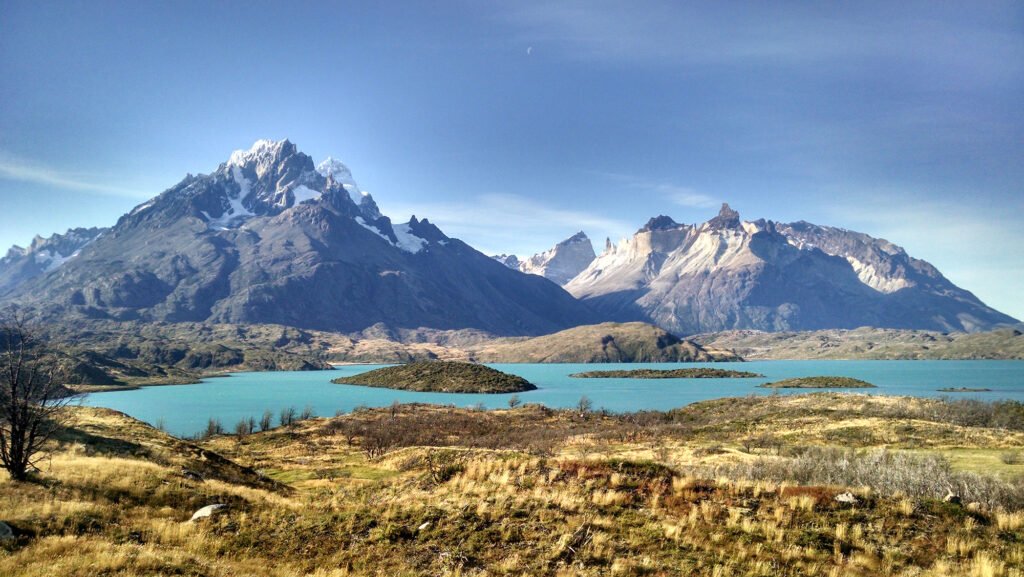
Food & Water for the W Trek
You will be able to buy food and drink at each of the refugios along the W Trek. However, this can get very expensive. We recommend that you try to be fully self-sufficient – and bring some extra cash to treat yourself on difficult days!
Food: You can stock up on food supplies from a supermarket in Puerto Natales, before departing to Torres del Paine National Park. Make sure to take a high-quality gas stove , gas canister, and mess kit .
Water: All campsites have access to fresh water sources to cook and refill your bottles. To avoid waterborne illness, we suggest that you use a water purification filter or water purification tablets before drinking this water.
5-Day Itinerary for Hiking the W Trek without a Guide
You will hike the W Trek one-way – meaning, it’s not a loop! You can choose to trek from either direction, east-to-west or west-to-easy. Each offers its own unique highlights:
- East-to-West: If you start from the east, your journey begins with a dramatic encounter with the famous Torres Del Paine, leaving you with diverse landscapes to explore.
- West-to-East: Opting for this direction allows you to save the magnificent towers for your grand finale while hiking through stunning valleys and forests.
The choice is yours, so customise your adventure to match your desires. The itinerary below is a sample 5-day itinerary for solo hiking the W Trek, from west-to-east. You can follow the plan below in reverse to do the trek from east-to-west, or make amendments to shorten or extend your total hike.
Please note that this itinerary provides an overview of the daily routes, but actual hiking times may vary based on your pace and trail conditions. Additionally, availability at refugios and campsites should be confirmed and booked in advance, especially during the peak trekking season. Enjoy your unforgettable journey through the stunning landscapes of Torres Del Paine!
Day 1 (Puerto Natales –> Refugio Grey)
- Total Kilometers: Approximately 11 km
- Estimated Time: 3-4 hours
- Start Point: Puerto Natales
- Finish Point: Grey
Begin your journey by catching the 7 am bus from Puerto Natales to Torres Del Paine National Park. This service will get you to the Leaving early will ensure you have enough time to hike and explore, without stressing about daylight.
Most buses that leave from Puerto Natales will stop:
- First at Laguna Amarga, where you get off if you plan on hiking the W Trek from east-to-west
- Second at Pudeto, where you get off if you plan on hiking the W Trek from west-to-east

Everyone will get off the bus at Laguna Amarga to show your entrance ticket for the park. You need to book your National Park permit online in advance. It is also advisable to download a copy of your ticket to your phone, as you are unlikely to have cell service in the park. If you are hiking the west-to-east route, you will then get back onto the bus to continue to Pudeto and Lake Pehoé.
When you get off the bus and Pudeto, stroll to the wharf. A catamaran service operated by Hipsur departs Pudeto for Paine Grande, transporting you for 30 minutes across Lake Pehoé to the start of your hike. The service departs at 9:30am, 10:30am, 4:15pm and 6:00pm over December to March. You should check their website for up-to-date operating times. The catamaran costs $25,000 pesos or $30 USD one-way, cash only. Tickets cannot be reserved in advance.
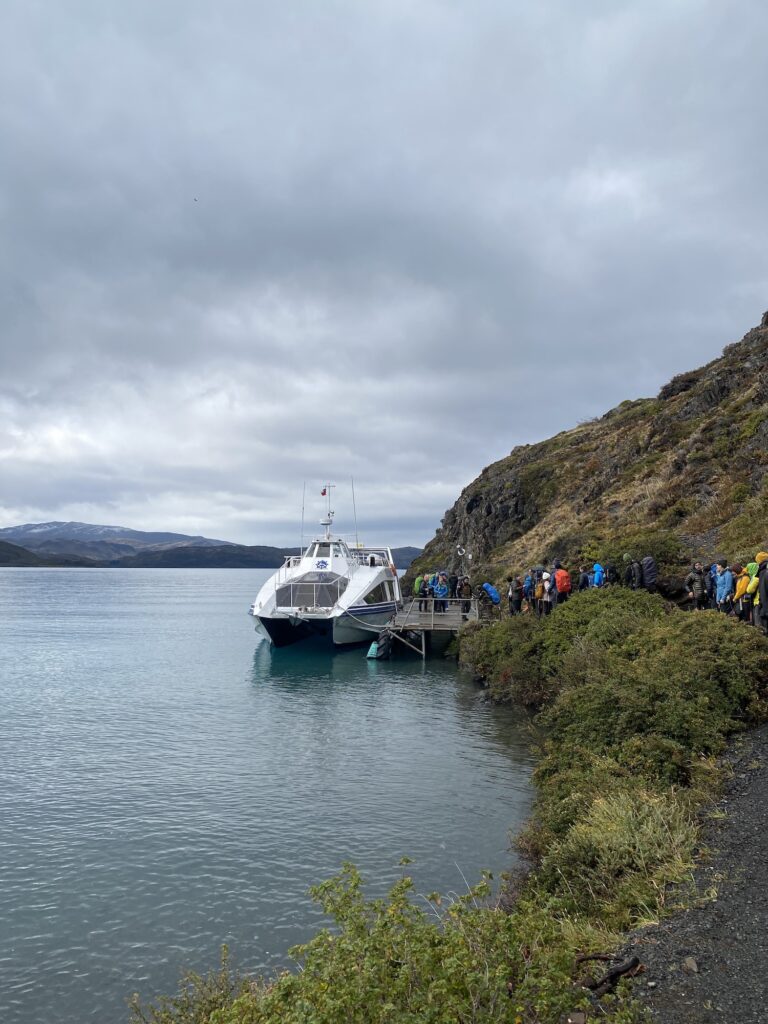
The hike to Grey Lodge is approximately 11 km and offers spectacular views of Lake Pehoé and the surrounding mountains. You’ll pass through enchanting forests and possibly catch a glimpse of local wildlife. Refugio Grey or Camping Grey is your destination for the night, offering stunning lakefront views. You should arrive in the early afternoon, so pitch your tent, meet some other hikers and cook dinner.
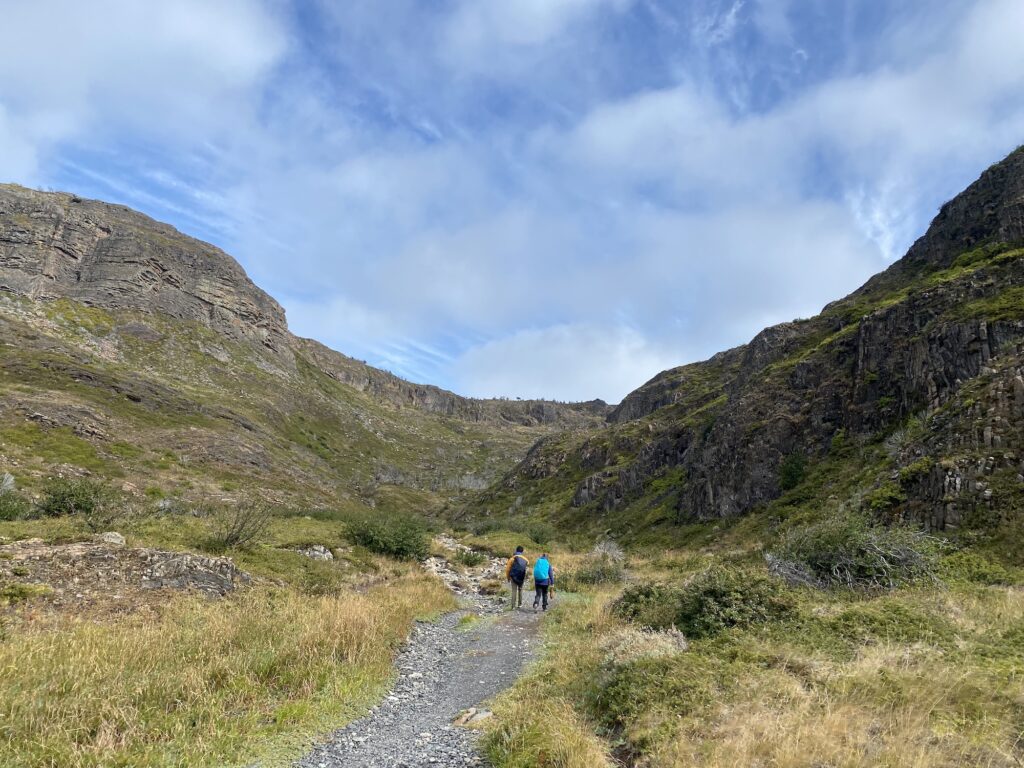
You can also choose to take an optional side trek, by continuing further north past the campsite. An extra 1 km through the forest will bring you to the snout of Grey Glacier, where you will have views of the enormous ice field. A further 2.5km along the path by the edge of the glacier will take you over a series of rope bridges with amazing views. This is about a 1hr round trip.
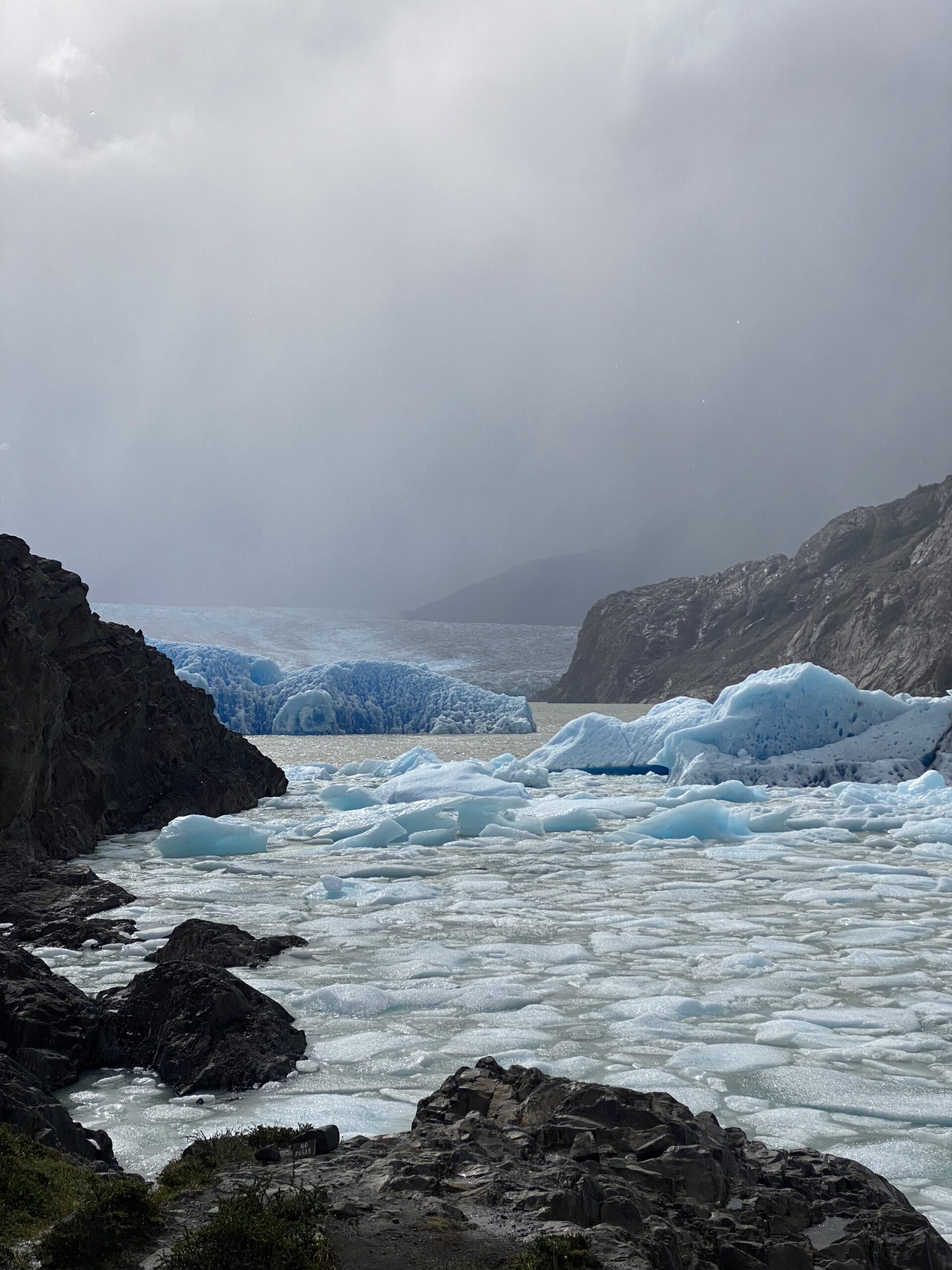
Day 2 (Grey –> Paine Grande)
- Start Point: Grey
- Finish Point: Paine Grande
Today, you’ll retrace your steps back to Paine Grande. The trail is mostly flat or downhill, making for a more relaxed walk. Along the way, you can choose to hike to the hanging bridges for an extra adventure.
Optional Add-On: Grey Glacier Ice Hike
One optional adventure you can undertake on the morning of Day 2 of the W Trek is an ice hike on Grey Glacier . Equipped with crampons and guided by experts, you can venture onto the glacier’s surface, exploring its captivating formations, deep blue crevasses, and surreal ice caves. This excursion provides an up-close encounter with the mesmerising world of glacial ice and a chance to witness the park’s natural wonders from a whole new perspective. It’s an unforgettable addition to your W Trek adventure for those seeking an extra dose of excitement and natural beauty.
Cost: The cost for the ice hike on Grey Glacier can vary, but it’s typically around $150 to $200 USD per person. This fee includes the necessary equipment such as crampons and the guidance of expert glacier guides.
Company: The ice hike on Grey Glacier is organised by Bigfoot Patagonia . This experienced tour provider ensures your safety and provides guidance throughout the excursion.
Duration: The ice hike adventure can take approximately 3 to 4 hours. This allows you to explore the glacier’s stunning features and take in the awe-inspiring surroundings.
Overnight Stay: To partake in the ice hike, it’s recommended to stay overnight at the Grey Lodge or campsite. This is because the ice hike usually takes place early in the morning to ensure the best ice conditions.
Adding the ice hike to your W Trek itinerary can be a memorable and thrilling way to connect with the glacial beauty of Torres Del Paine National Park.
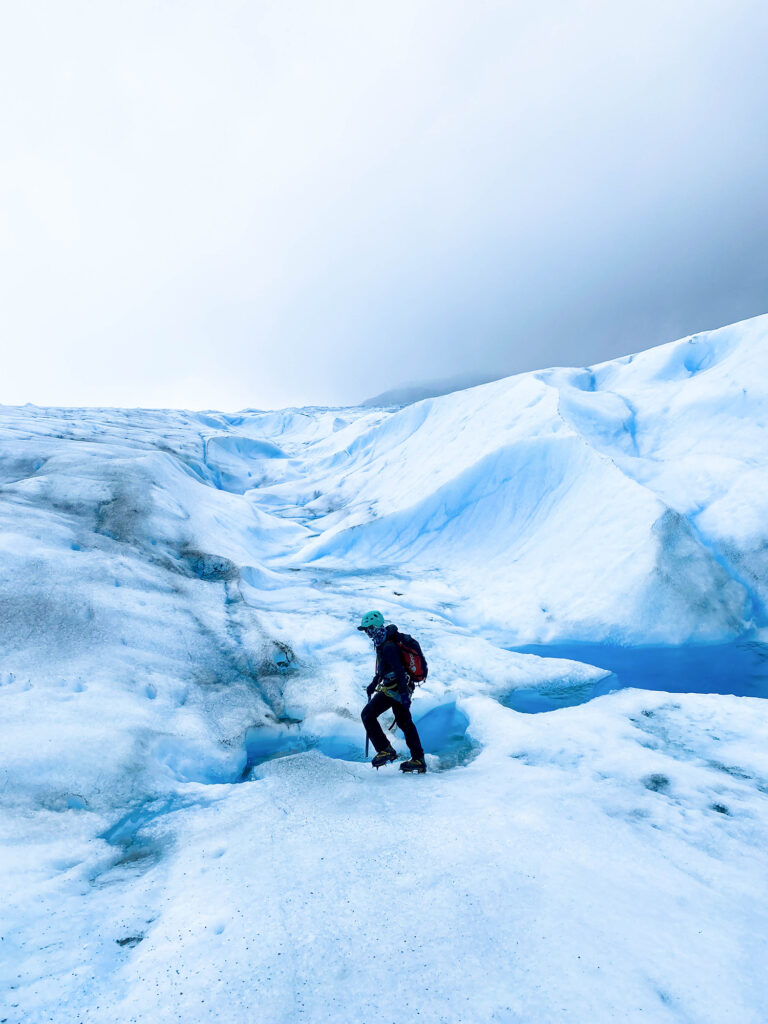
Day 3 (Paine Grande –> Francés/Los Cuernos)
- Total Kilometers: Approximately 21 km
- Estimated Time: 8-9 hours
- Start Point: Paine Grande
- Finish Point: Francés or Los Cuernos
This is a challenging day involving significant elevation gain, but it rewards you with some of the trek’s most stunning vistas. The trail takes you through valleys, along the shores of Lake Nordenskjöld to Guardería Italiano. You can leave your bags here with the ranger before hiking into the Francés Valley.
Hiking through the Francés Valley can vary greatly depending on the ever-changing Patagonian weather. This stretch of the hike marks the central segment of the W, and it’s a relentless uphill journey. After an hour of navigating steep and rocky terrain on a sometimes slippery trail, you’ll arrive at Mirador Francés, where you can catch sight of Glaciar Francés clinging to the western mountainside.
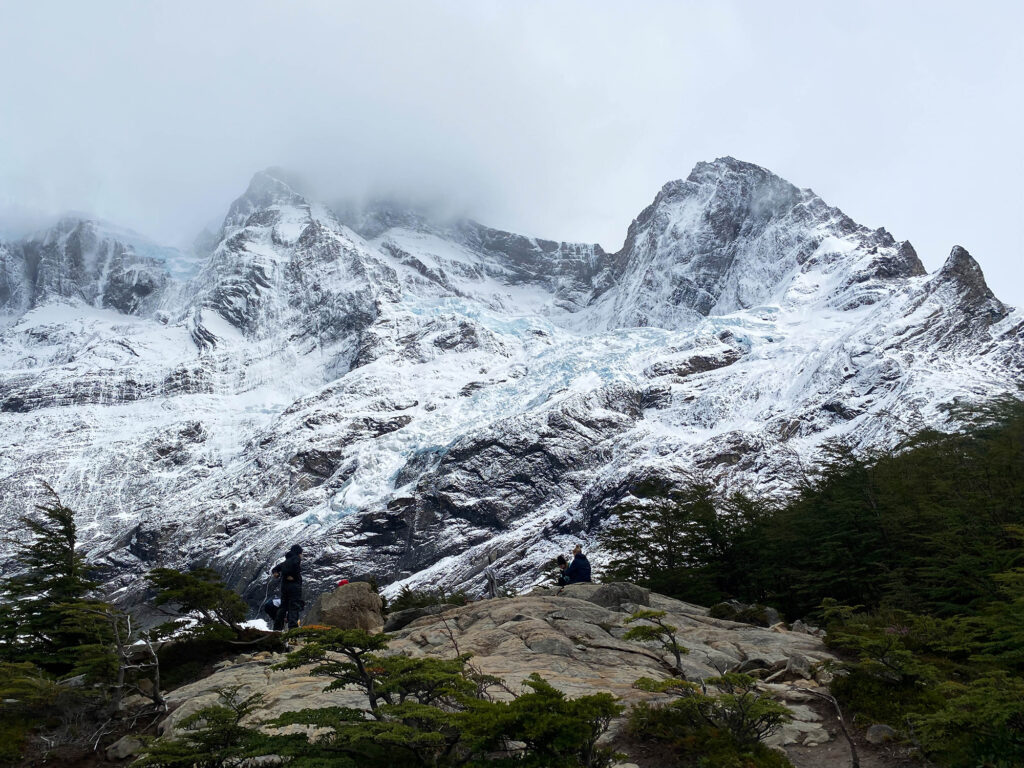
For those feeling especially adventurous and blessed with fair weather, there’s the option to continue ascending to Mirador Británico, adding an extra 3.5 kms each way, roughly three hours for the round trip. At Mirador Británico, you’ll be rewarded with panoramic views of a circle of jagged granite peaks, including the park’s second most famous landmark, the three-horned Cuernos del Paine. This spot ranks among the park’s most breathtaking viewpoints, particularly when the sky is clear. Keep a sharp eye out, as you might even spot the endangered Southern Andean huemul, a rare deer species, in this area.
Thankfully, the return journey is downhill as you make your way back to Campamento Italiano, where you can retrieve your backpack. Continue on for about 30 minutes to stay at Francés. If there is no availability at Francés, you can instead book to stay at Los Cuernos, which is a further 1 hour from Francés.

Day 4 (Francés/Los Cuernos –> El Chileno/Central)
- Total Kilometers: Approximately 15 km
- Estimated Time: 6-7 hours
- Start Point: Francés or Los Cuernos
- Finish Point: El Chileno or Central
The trail from Los Cuernos to El Chileno includes a steady elevation gain throughout the day. You’ll be treated to beautiful river and lake views along the way. As you approach El Chileno, you’ll be surrounded by lush Patagonian forests. Camping and refugio options are available for your overnight stay.

El Chileno is the ideal campsite for Day 4, as it is 4 kms from the Torres del Paine towers. This is important if you want to catch the sunrise at the viewpoint, so you don’t need to wake up so early! If you can’t get a booking at El Chileno, it is possible to hike from Central, but it is an additional 1hr and 45 minutes to reach the towers.
Day 5 (El Chileno/Central –> Torres del Paine –> Puerto Natales)
- Total Kilometers: Approximately 9 km (round trip to Mirador las Torres)
- Estimated Time: 5-6 hours (including time at the viewpoint)
- Start Point: Camping El Chileno or Refugio El Chileno
- Finish Point: Puerto Natales
Rise early to hike the trail to the famous Torres del Paine viewpoint. This is about 4km from El Chileno, meaning you should leave camp about 2hrs before dawn. If you are staying at Central, the hike is about 9km and you should leave camp about 4hrs before sunrise. Make sure you bring a head torch, as the rocky trail will be difficult in the dark. Expect the sun to rise around 7am – but be sure to check with the campground the night before your ascent.
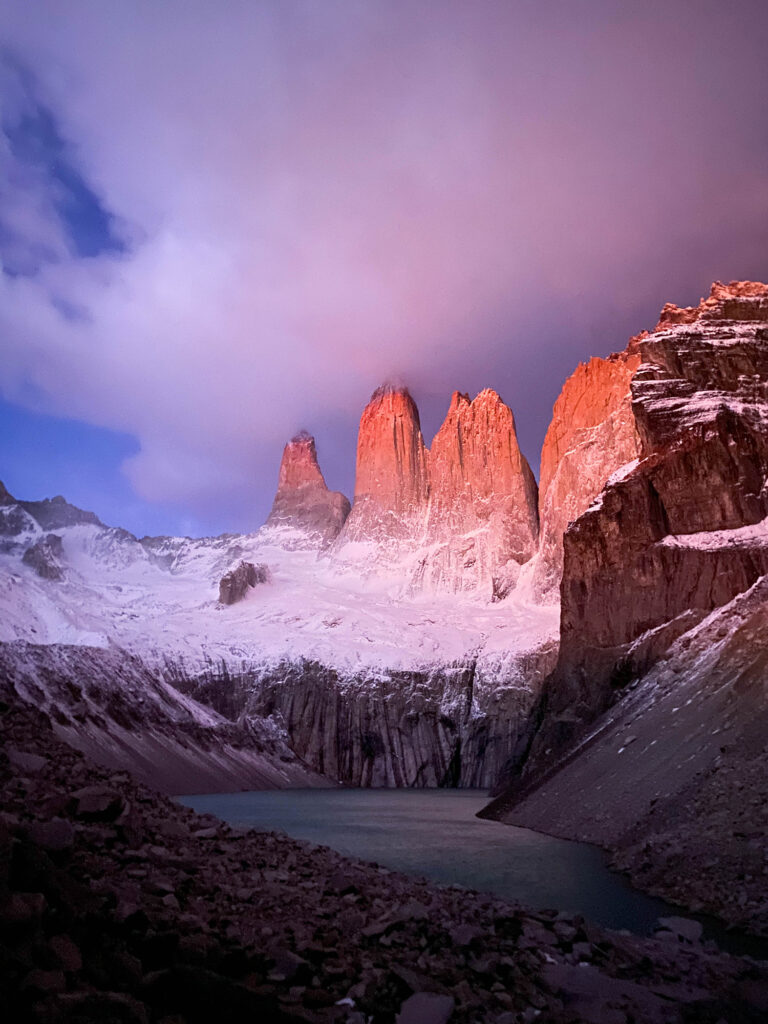
This challenging ascent is rewarded with breathtaking views of the iconic towers. After visiting the towers, descend to Hotel Las Torres. From here, you can take a shuttle bus back to Laguna Amarga for $3,000 pesos, cash only. This is where you get on a bus back to Puerto Natales, completing your W Trek adventure.
How Much Does it Cost to Hike the W Trek Without a Guide?
Before embarking on the W Trek in Torres Del Paine, it’s essential to have a clear understanding of the costs involved. This detailed cost breakdown will help you budget for your adventure effectively:
1. Park Entrance Fee – the park entrance fee for Torres Del Paine National Park varies depending on the season:
- High Season (November to March): Approximately $40 to $50 USD per person.
- Shoulder Season (Late October to early November, late March to early April): Around $20 to $30 USD per person.
- Low Season (April to September): Roughly $10 to $15 USD per person.
2. Transportation:
- Flights: The cost of flights to reach Teniente Julio Gallardo Airport (PNT) in Puerto Natales can vary widely based on your departure location. On average, round-trip flights from Santiago to PNT range from $150 to $300 USD.
- Buses: Bus tickets from Puerto Natales to the park entrance or various points within the park can cost approximately $20 to $50 USD round-trip. You can book tickets from the companies’ offices at the Puerto Natales bus station.
- Pudeto to Paine Grande Ferry: This ferry route is commonly used for the W Trek, and it crosses Lake Pehoé. The cost of the ferry ride can vary, but it was typically around $30 to $40 USD for a one-way ticket. The duration of the ferry ride is relatively short, approximately 30 minutes.
3. Accommodation:
- Camping: Camping fees at the park’s designated campsites typically range from $10 to $20 USD per person per night. These campsites are equipped with facilities such as bathrooms, showers, and cooking areas.
- Refugios: Staying in refugios offers more comfort but comes at a higher cost. The price per night in a refugio can vary between $60 and $150 USD per person, depending on the level of luxury and the time of year. This often includes meals.
- Self-Cooking: If you opt to prepare your meals, you can expect to spend approximately $10 to $20 USD per day on food. This estimate includes purchasing supplies in Puerto Natales before your trek.
- Meals at Refugios: Dining at refugios can be convenient, but it’s also more expensive. An average meal at a refugio restaurant can cost anywhere from $15 to $30 USD. Keep in mind that some refugio packages include meals.
5. Gear Rental:
- If you need to rent gear such as tents, sleeping bags, or hiking equipment, budget an additional $20 to $40 USD per day, depending on the items you require.
Please note that these cost estimates can vary based on individual preferences, the exchange rate, and any special promotions or discounts available at the time of booking. It’s advisable to check current prices and plan your budget accordingly to ensure a worry-free W Trek experience. Additionally, consider carrying some extra cash for unexpected expenses or emergencies during your journey.
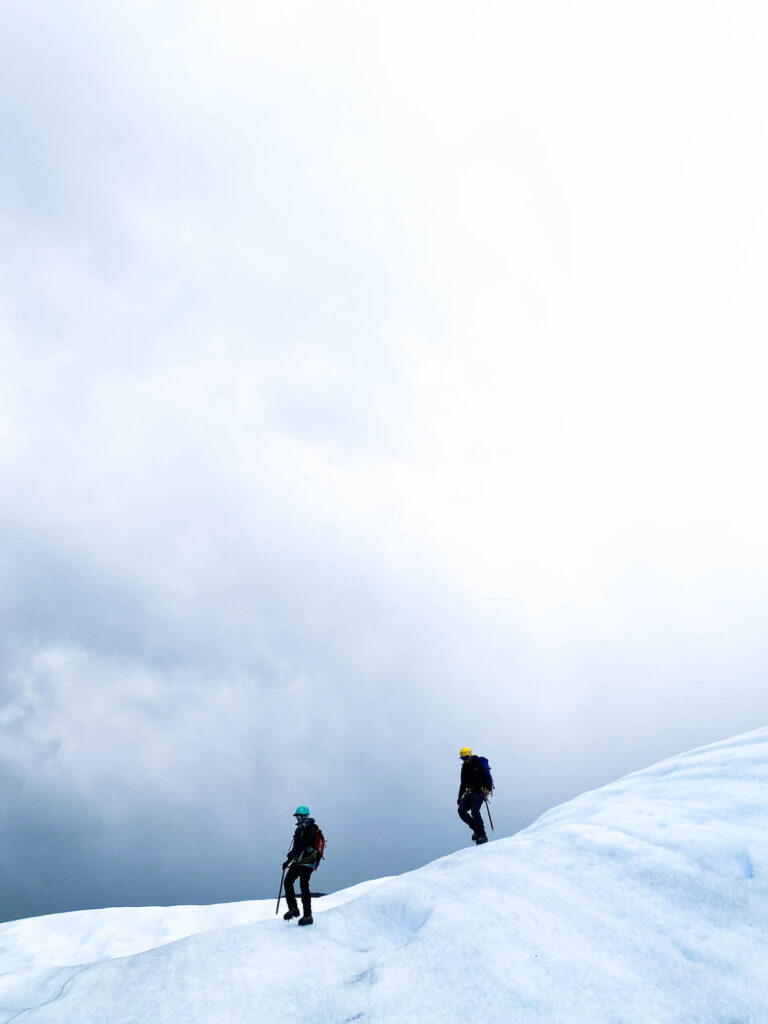
Hiking the W Trek Independently vs With a Guide
Deciding whether to embark on the W Trek independently or with a guide is a significant choice, and it largely depends on your preferences, experience, and what kind of adventure you seek. Below, we delve into the pros and cons of both options to assist you in making an informed decision:
Hiking Independently:
- Flexibility: Independence grants you the freedom to set your pace, choose your daily itinerary, and make spontaneous decisions along the way. You have full control over your adventure.
- Cost-Effective: Independent trekkers often find it more budget-friendly, especially when it comes to accommodations. You can opt for camping and self-cooked meals to save money.
- Personal Connection with Nature: Solitude in the wilderness can provide a deeper connection with the natural surroundings and a more profound sense of adventure.
- Adventure of Self-Reliance: Successfully navigating the W Trek independently can be immensely rewarding, boosting your self-confidence and outdoor skills.
- Logistical Challenges: Planning and booking accommodations, transportation, and permits can be time-consuming and occasionally frustrating, especially during peak seasons.
- Navigation: You must rely on your navigation skills and research to stay on the right path, which can be challenging in the ever-changing Patagonian weather.
- Safety Considerations: Solo travellers should be well-prepared for emergencies and have basic wilderness first aid knowledge.
Hiking the W Trek with a Guide
- Expert Guidance: Guides are experienced and knowledgeable about the trail, local wildlife, and weather patterns. They can enhance your understanding and appreciation of the environment.
- Safety Assurance: With a guide, you have a safety net. They can provide assistance in emergencies, navigation, and first aid.
- Group Camaraderie: Joining a guided tour allows you to meet like-minded adventurers and share the experience, making it a social and potentially less solitary journey.
- Simplified Logistics: Many logistical aspects, such as accommodations and permits, are often handled by the guiding company, reducing your planning burden.
- Cost: Guided tours can be more expensive due to the added services and expertise provided.
- Less Independence: Your schedule and daily activities are often predefined, leaving less room for spontaneity.
- Group Dynamics: Group tours may vary in size and composition, and you might not always have full control over the pace or itinerary.
In conclusion, the choice between hiking the W Trek independently or with a guide is a matter of personal preference and what aligns with your goals for the journey. Consider your budget, level of outdoor experience, desire for flexibility, and your comfort with navigating the trail. Both options offer unique advantages, and the W Trek promises an unforgettable adventure, regardless of the path you choose.

Trek Highlights and Scenic Spots
The W Trek in Torres Del Paine National Park is a visual symphony of natural wonders. Each leg of the journey unveils a new chapter in this captivating wilderness narrative. Here, we delve into the breathtaking highlights and scenic spots that await you:
1. Torres Del Paine – The Crown Jewels:
- Iconic Towers: No visit to Torres Del Paine is complete without witnessing the park’s namesake – the monumental Torres Del Paine. These three towering granite peaks, sculpted by the forces of nature, rise majestically against the Patagonian sky. The sight of the Torres, especially during sunrise or sunset, is a moment that etches itself into your memory forever.
2. Spectacular Valleys:
- French Valley (Valle del Francés): This emerald green valley enchants with its hanging glaciers, colossal rock faces, and panoramic vistas. Hiking through the French Valley feels like stepping into a postcard, surrounded by nature’s grandeur from every angle.
3. Lush Forests:
- Patagonian Wilderness: The W Trek meanders through pristine Patagonian forests, where moss-covered trees, vibrant lichens, and unique flora create a rich tapestry of greens. Walking amidst these ancient trees evokes a sense of timelessness.
4. Azure Lakes:
- Lago Pehoé and Lago Nordenskjöld: These crystal-clear lakes reflect the azure sky and surrounding peaks like mirrors. Their beauty is not only in the vibrant blue hues but also in the tranquility they offer. Pause by their shores and feel the serenity wash over you.
5. Glacier Grey:
- Glacial Majesty: Glacier Grey is a spectacle of ice and light. As you approach its shimmering blue face, you’ll be captivated by the sheer size and beauty of this ancient ice giant. The viewpoint offers an up-close encounter with one of Patagonia’s most remarkable glaciers.
6. Flora and Fauna Encounters:
- Wildlife: Keep a watchful eye for the diverse Patagonian wildlife. Guanacos, foxes, condors, and even the elusive puma inhabit these lands. Birdwatchers will be delighted by the variety of avian species that call this region home.
7. Mirador Cuernos:
- Cuernos Lookout: This viewpoint provides a mesmerising panorama of the iconic Cuernos del Paine, the horn-like peaks that define the landscape. It’s a place to pause, take in the surroundings, and appreciate the rugged beauty of Patagonia.
8. Southern Patagonian Ice Field:
- Distant Giants: While not part of the W Trek itself, the view of the Southern Patagonian Ice Field from certain points along the trail is awe-inspiring. Witness this vast expanse of ice, where countless glaciers originate, and feel the enormity of the natural forces at play.
The W Trek is a mesmerising journey through a pristine wilderness that will leave you humbled by nature’s artistry. Each of these highlights adds a unique stroke to the masterpiece that is Torres Del Paine National Park. Whether you’re an avid photographer, a nature enthusiast, or simply seeking serenity in the wild, the W Trek has something extraordinary to offer at every turn.
Booking the W Trek and Practical Information
Embarking on the W Trek adventure requires meticulous planning, from securing permits to arranging transportation. Here, we delve into the practical details you need to know to ensure a seamless journey through Torres Del Paine National Park:
1. Permits and Excursions:
- Booking Your Trek: The W Trek is in high demand, especially during the peak season (November to March). You must secure your accommodations and camping permits in advance. Remember that the campsites and refugios are operated by two different companies, Vertice and Fantastico Sur. Each has its own booking system, so it’s crucial to book dates that align with your itinerary. Start the booking process as early as possible, as securing the exact dates you need can be challenging.
- Excursions: If you’re interested in guided excursions or activities within the park, such as glacier hikes or boat trips, it’s advisable to book these in advance as well. This ensures you don’t miss out on the experiences that enhance your W Trek adventure.
2. Timetables for Buses and Park Entrance Tickets:
- Getting to Puerto Natales: To reach the starting point of the W Trek, you’ll likely fly into Santiago and then take a flight to Teniente Julio Gallardo Airport (PNT) in Puerto Natales. A 10-minute taxi ride will transport you from the airport to the downtown area, where most accommodations are situated. It’s recommended to spend a night in Puerto Natales to stock up on supplies before heading to the national park.
- Buses to the Park: From Puerto Natales, you’ll need to take a bus to Torres Del Paine. Various bus companies, such as Buses Fernandez, operate this route. Ensure you purchase your bus tickets in advance, particularly if you plan to catch an early morning departure. Timetables can vary, so check the schedules well in advance to align them with your trekking itinerary.
- Park Entrance Tickets: You’ll need to pay an entrance fee to access Torres Del Paine National Park. These tickets can be purchased at the park entrance or online. Having your entrance tickets ready in advance will save you time and streamline the process when you arrive.
3. Equipment and Supplies:
- Gear Checklist: Ensure you have all the necessary gear for your trek, including camping equipment, clothing layers, hiking boots, and more. Refer to the packing essentials section for a comprehensive checklist to make sure you’re well-prepared.
4. Safety and Emergency Contacts:
- Emergency Preparedness: While the W Trek is a stunning adventure, it’s essential to prioritise safety. Familiarise yourself with emergency contacts and park regulations before setting out. Have a plan for communication and emergency situations.
5. Accommodation Flexibility:
- Last-Minute Options: While booking accommodations in advance is wise, some refugios may have last-minute availability for hikers. Keep this in mind if your plans are flexible, but don’t rely on it entirely, especially during peak seasons.
Navigating the logistics of the W Trek ensures that your adventure unfolds smoothly, allowing you to focus on the awe-inspiring landscapes and experiences that await you. By planning ahead, you’ll maximise your enjoyment and make the most of your journey through the pristine wilderness of Torres Del Paine.
In conclusion, embarking on a solo adventure along the W Trek in Torres Del Paine, Chile, is a remarkable experience that will leave you with memories to last a lifetime. By planning carefully, packing smartly, and embracing the breathtaking beauty of Patagonia, you’ll embark on an unforgettable journey that showcases the very best of nature’s wonders.
To hike the W in Torres del Paine, plan your itinerary, book accommodations, and obtain permits in advance. Start from either the east or west side, following well-marked trails and taking in the breathtaking landscapes along the way.
Yes, you can definitely hike the W Trek without a guide. Many solo hikers and groups explore the trail independently. The trail is well marked and sign-posted the whole route. Just be sure to plan and prepare well, including booking accommodations and permits in advance. If you are new to hiking and camping, consider hiking the W Trek with a guide or group.
No. Camping in Torres del Paine is restricted to designated campgrounds. This means there is no free camping. The purpose is to minimise the environmental impact and reduce the risk of fires, which have previously ravaged significant portions of the park, covering approximately 17,000 hectares (41,000 acres) or 7% of its total area.
The duration of the W Trek can vary depending on your pace and itinerary. On average, hikers complete the W circuit in 4 to 6 days. It’s a flexible trek that allows you to choose your route and pace.
While it’s technically possible to complete the W Trek in 4 days, it would be a very strenuous and rushed experience. Most hikers opt for a 5-day itinerary to fully enjoy the trek and its stunning landscapes. A 4-day trek would require covering significant distances each day.
The difficulty of the W Trek varies, but it’s generally considered a moderate hike. It involves steep ascents and descents, variable weather conditions, and covering significant distances. Being physically prepared and having the right gear is essential.
To start the W Trek, you’ll typically fly to Santiago, then catch a flight to Puerto Natales, the gateway to Torres Del Paine National Park. Spend a night in Puerto Natales to stock up on supplies before heading to the park.
Charging facilities are available at some refugios and campsites along the W Trek, but they may be limited. It’s advisable to bring a portable power bank to ensure you can keep your devices charged throughout the trek.
The best months to hike Torres del Paine are during the shoulder seasons of late October to early November and late March to early April. These periods offer milder weather and fewer crowds. However, if you prefer vibrant spring or summer landscapes, consider the peak season from November to March.
Absolutely! The W Trek is worth it for its stunning natural beauty, iconic landmarks like Torres Del Paine, and the sense of adventure it offers. It’s a memorable experience for nature enthusiasts and hikers.
Yes, you can find water sources along the W Trek route. It’s essential to bring a water purification filter or water purification tablets to ensure the water is safe to drink from streams and rivers.
For the W Trek, it’s essential to bring lightweight, high-energy, and non-perishable foods. Consider items like energy bars, nuts, dried fruits, instant oats, pasta, dehydrated meals, and freeze-dried options. Make sure to pack foods that are easy to prepare on camping stoves and provide the necessary nutrition for your journey. Additionally, you can purchase some supplies at refugios along the trail if needed.
While some places in Torres del Paine accept credit cards, it’s advisable to carry some cash. Cash can be useful in case you encounter places that don’t have card payment facilities, or when reception in the park is not working. You will also need cash for the boat from Pudeto to Paine Grande.
Yes. There are well-maintained toilets at each campsite along the W Trek.
Torres del Paine can be relatively expensive due to park entrance fees, accommodation costs (especially in refugios), and dining options. However, there are ways to manage costs, such as camping and preparing your own meals if you’re on a budget.
Some of the best parts of the W Trek include witnessing the iconic Torres Del Paine towers, exploring spectacular valleys, hiking through lush forests, and marveling at crystal-clear lakes that dot the landscape.

Lucas is a travel writer with deep experience exploring South America. He enjoys hiking through mountain ranges, cycling across deserts and paddling down rivers.
Best Food in Puerto Natales: 17 Top Restaurants & Cafes
Backpacking packing list: what to pack for a backpacking trip in 2023, get our best tips direct to your inbox.
+1 206-892-8877

Send Us a Message
W trek - torres del paine (camping - self guided), 5 day trek in patagonia, chile.
Explore the awe-inspiring wonders of Torres del Paine National Park on our 5-day self-guided camping tour along the iconic W trek. Immerse yourself in the pristine beauty of glaciers, lakes, forests, and the majestic Paine Towers, indulging your passion for trekking with each unforgettable step.
Named after the distinctive W-shaped route formed by the convergence of trails in the southern sector of the Macizo del Paine, this trek showcases the park's most renowned attractions, including Base Torres, Francés Valley, and Grey Glacier.
Forget the hassle of packing camping gear – we've got you covered. Upon arrival at your nightly destination, all camping equipment will be provided and set up, allowing you to focus on soaking up the natural splendor of Patagonia without worrying about the logistics. Join us for an unforgettable adventure in one of the world's most breathtaking landscapes.
*All camping gear is supplied and set up upon arrival to your nightly destination.
Highlights:
- Base Torres : Begin your journey with a hike to the iconic Base Torres, where you'll be greeted by breathtaking views of the towering granite peaks and glacial lakes.
- Francés Valley : Traverse through the stunning Francés Valley, surrounded by rugged mountains and lush forests, and witness the awe-inspiring beauty of the landscape.
- Grey Glacier : Explore the majestic Grey Glacier, one of the park's most impressive natural wonders, and marvel at its immense size and striking blue hues.
- W-shaped Route : Follow the distinctive W-shaped route that winds its way through the southern sector of the Macizo del Paine, offering unparalleled views of the surrounding scenery.
- Camping Experience : Enjoy the unique experience of camping in the heart of Patagonia's wilderness, with all camping gear provided and set up upon arrival at each nightly destination.
Group guidance: Tuesday and Thursday's
Private Guided: Every day
Self Guided: Every Day
+$320usd single supplement for solo campers

Trip Itinerary
Day 1: arrive at torres del paine national park - hike to the base of the towers.
We will After breakfast at your hotel in Puerto Natales, your packed lunch will be delivered, and you'll catch a 7 am public bus departing straight to Torres del Paine National Park. Journey across the vast Patagonian plains before reaching the entrance at Laguna Amarga, where it is required to register with CONAF (park rangers). Board the "Las Torres" shuttle bus that will drop you off at the Visitor’s Center. Register with the Cerro Paine Reserve and walk a short distance to Refugio Torre Central. Whether your accommodation is a shared-dorm room in the Refugio or camping, make sure to check-in prior to beginning your hike.
Today’s trek follows the Ascensio Valley as it snakes through windswept hills and wide-spread beech forests. During the final ascent, you’ll traverse an immense boulder field until reaching one of the most iconic mountain viewpoints in the world, the Base of The Towers. At a height of 900 meters (2953 feet) above sea level, marvel at the sheer granite walls of the (north, south, central) towers and the brilliantly turquoise glacial lake below. Take some photographs and have lunch before following the same path downwards to Refugio Torre Central. After a long day of hiking, enjoy a warm dinner at the lodge.
Distance: 22 kilometers (approximately 13.7 miles)
Time: 8-10 hours
Level of Difficulty: Strenuous
Accommodation: Refugio or Camping Torre Central
Meals: Packed lunch + Dinner
DAY 2: Trek to Refugio Los Cuernos
Enjoy breakfast and request your packed lunch in the dining area. Today, the trail leads you deep into the park towards Refugio Los Cuernos, one of the more secluded mountain lodges. Navigate over crystal clear streams, admire the hanging glaciers off of Mt. Almirante Nieto (2,670 meters or approximately 8,760 feet), and search for condors as you border the mesmerizing green-blue waters of Lake Nordenskjold. Follow the well-marked trail until you reach Refugio Los Cuernos, where you’ll unwind for the evening.
Distance: 12 kilometers (approximately 7.5 miles)
Time: 4-5 hours
Level of Difficulty: Moderate
Accommodation: Refugio or Camping Los Cuernos
Meals: Breakfast, packed lunch, and Dinner
DAY 3: Explore the French Valley
Set out on an early morning adventure for a full-day hike to the heart of Torres del Paine Park. Following breakfast, organize your packed lunch and prepare for a day filled with breathtaking Patagonian landscapes. Traverse through the Frances Campsite, and after 2-2.5 hours of hiking, you'll reach the base of the French Valley. Leave your backpack at the Italiano Ranger Station and commence your journey up the valley.
Ascend through a vast boulder field and follow a tree-lined ridge until you reach the French plateau (Mirador Frances). Here, you'll be greeted by stunning vistas of Los Cuernos (the Horns), turquoise glacial lagoons, and magnificent blue hanging glaciers cascading down the east face of Paine Grande (3,050 meters or approximately 10,007 feet). If you're fortunate, you may even hear the thunderous roar of water and ice cascading down, as avalanches are common in this area. Capture some memorable photographs and enjoy your packed lunch before descending back to the Italiano Ranger Station.
Retrieve your backpack and hike to Refugio Paine Grande (approximately 6.25-7.5 miles). Take it easy for the evening and indulge in a delicious meal at the lodge.
Distances: Mirador Frances: 17km (approximately 10.6 miles )
Time: Mirador Frances: 6-7 hours
Level of Difficulty: Demanding
Accommodation: Refugio Paine Grande or Camping Paine Grande
DAY 4: Grey Glacier (Optional hike to suspension bridges)
Begin your day by trekking through a narrow, winding valley leading to Laguna de Los Patos. As you progress, catch glimpses of the expansive Southern Patagonian Ice Field and the iceberg-studded Grey Lake. After encountering the occasionally very windy lookout point at Glacier Grey, the trail descends through a hilly forest until you stand face to face with the majestic Grey Glacier.
Distance: 11 kilometers (approximately 6.8 miles)
Time: 4-4.5 hours
Accommodation: Refugio or Camping Grey
OPTIONAL HIKING EXTENTION:
Embark on an extraordinary journey for an unparalleled panoramic vista of Grey Glacier. Extend your adventure by an additional 3-4 hours (round trip) beyond Refugio Grey to reach the renowned suspension bridges. Upon crossing the second suspension bridge, gaze down upon the vast expanse of deep blues and tiny turquoise lagoons adorning the magnificent Grey Glacier. With luck, witness the spectacle of ice calving into the icy depths of Grey Lake.
Distance: 4 kilometers
Time: 3-4 hours (round trip)
DAY 5: Trek to Refugio Paine Grande – Return to Puerto Natales
On your final day in the park, you have two options:
Retrace your steps along the trail to Refugio Paine Grande to catch the 11:30 AM catamaran departing for the Pudeto boat dock. From there, board the 1:00 PM public bus back to Puerto Natales. Anticipate arriving in Puerto Natales around 4:30 PM.
Meals: Breakfast, Packed lunch
If you missed the opportunity to visit the suspension bridges the previous day, spend the morning exploring the breathtaking panoramic vistas of Grey Glacier. Afterwards, follow the same trail back to Refugio Paine Grande to catch the 6:30 PM catamaran to the Pudeto boat dock. From there, board the 7:00 PM public bus back to Puerto Natales. Expect to arrive in Puerto Natales around 10:00 PM.
Additional Information - Restrictions and Suggestions:
• This itinerary is not suitable for children under the age of 10.
• Participants should be capable of carrying their personal belongings throughout the program. We suggest utilizing 40-liter backpacks.
• For those desiring to lighten their load during the hike, we provide luggage storage in Puerto Natales.
Departure Details:
• Departures are available every day (subject to availability) from October to April.
Program Adjustments:
• All outings are contingent upon weather conditions.
Pre-Trip Briefing: Expect a briefing at our local partner's office in Puerto Natales the day before your journey.
Camping: Enjoy fully-supported camping, including a two-person tent, sleeping mat, and sleeping bag, with all meals provided along the route. Your daypack should contain lunch (provided) and personal items for each overnight stop.
Refugios: Accommodations at refugios consist of dormitory rooms. Some refugios offer sleeping bags and pillows, while others provide sheets, blankets, and pillows.
Luggage Storage: You can safely store your luggage with our local partners in Puerto Natales, or at your selected hotel.
Optional Excursions: Availability varies for these excursions and must be booked and paid for in advance, as they are not included in the trip price. Contact us for further details.
Boat Trip on Glacier Grey: Experience a boat trip on Day 5 from Refugio Grey to the southern end of the lake, followed by a private transfer to Puerto Natales. This option skips the hike from Refugio Grey to Refugio Paine Grande, but allows for an optional hike to the Ferrier lookout (3hrs, 5.6km, 651m elevation gain) after the boat trip. USD $130 per person.
Kayaking in Front of Glacier Grey: Enjoy kayaking in front of Glacier Grey on Day 4 or 5. USD $180 per person.
Ice Hike on Glacier Grey: Experience an ice hike on Glacier Grey on Day 4 or 5. USD $240 per person.
Single Supplement: Solo travelers incur a single supplement of USD $360.
Rates are quoted for October 2023- April 2024.
For 2024/2025 pricing please inquire
Getting to the start of the W trek: The trip begins and ends in the Chilean town of Puerto Natales, a touristic bus is provided in the package to/from Torres del Paine National Park. Flights are recommended from Santiago to Puerto Natales, in the case there are no flight direct to Puerto Natales from Santiago, you can fly into Punta Arenas, ground transfers can also be arranged from the Argentina town of El Calafate at an extra cost.
Additional Trip Info
- Transport on a regular bus from Puerto Natales to Torres del Paine National Park and back.
- Accommodations: Camping and/or lodge arrangements as per your itinerary.
- Camping accommodations include pre-set tents, sleeping bags, and sleeping pads. (no need to carry any camping gear)
- Transportation: Public bus transfers to and from the park, along with a shuttle bus ticket to the Visitor’s Center.
- Meals: Enjoy meals outlined in your itinerary, sit down Breakfast & Dinner, Pack Lunches also included.
- Dietary Restrictions: Notify us during reservation to accommodate any dietary needs. Please note, prior notice is required for dietary restrictions.
- Catamaran boat tickets and entrance fee to Torres del Paine National Park are covered.
- Welcome Kit: Includes dry bag, water bottle, large map, buff (bandana) or welcome drink. You receive this kit and your program vouchers prior to your trek. *Please note: contents may change without notice and at the discretion of our supply.
- Guide (additional cost -please inquire)
- Any service not specified in the program. Additional activities
- Travel Insurance - We recommend World Nomads , or Global Rescue
Packing List for the W Trek can be found on our Blog here .
See our W trek Self Guided FAQ in our blog here

Have Questions?
Related trips, ecodome - torres del paine w trek, patagonia - 5 days, w trek - torres del paine (refugio - self guided), highlights of the chilean patagonia - 9 days, best of el chaltén - 4 days, related blog posts, interested in building a custom trip we want to help you travel to places you have dreamt about..

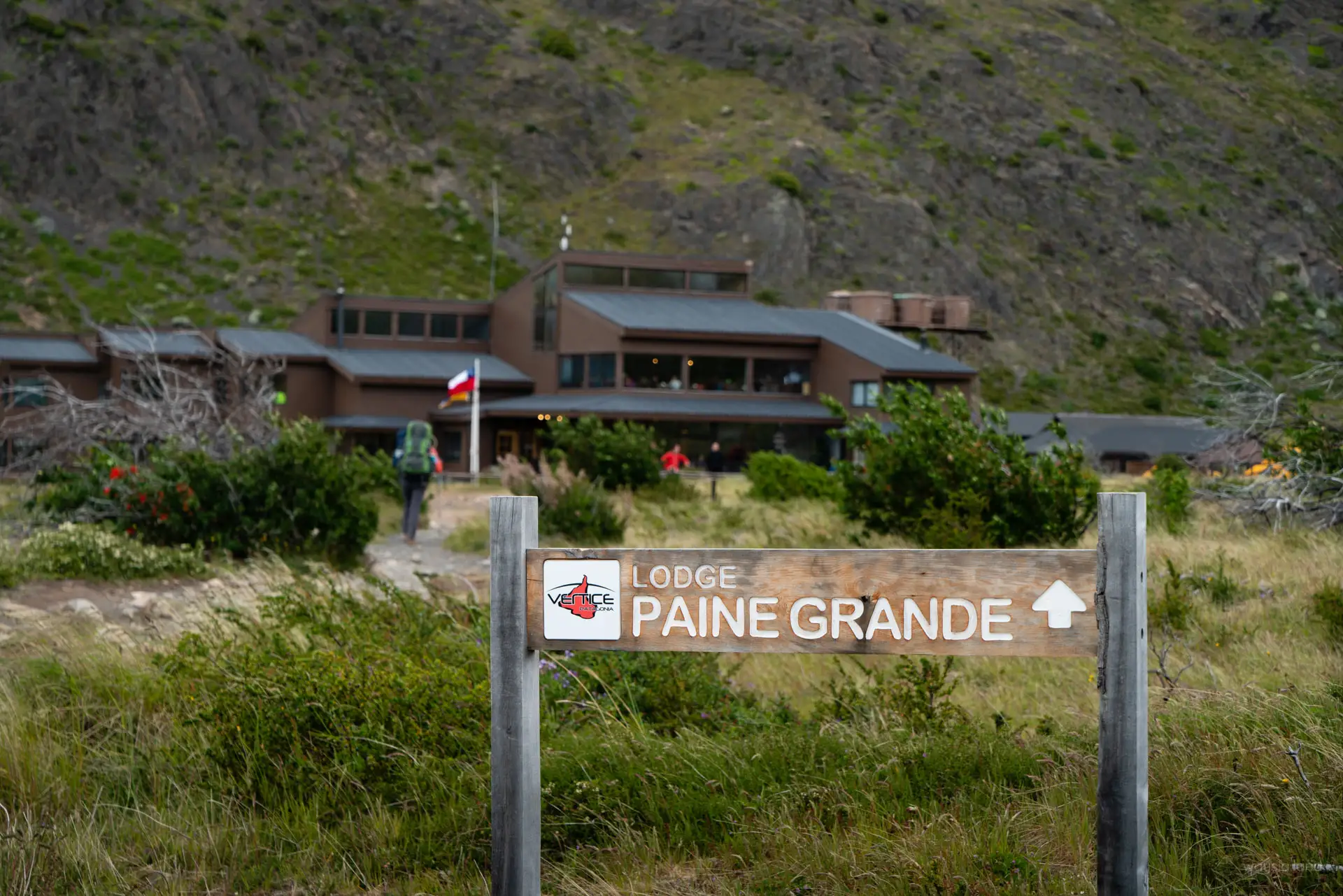
Chile , South America , Travel Tips , Treks and Hikes
How to book campsites in Torres del Paine
How to successfully book campsites for Torres del Paine in 2020 You've tried everything and now you're pulling your hair out.
Booking the O Circuit (O trek) or W trek in Torres del Paine is no easy feat – some even say it’s harder than the trek itself. If you’re reading this then you’ve probably hit a snag in the convoluted booking process.
When I did the trek, I spent about 2 weeks reading up on Torres del Paine including the booking process. I then spent a solid 2 days trying to actually book the damn campsites/refugios.
This isn’t an introductory post about Torres del Paine camping. I’ll write that in the future. This post is for you if you’re finding that you can’t book your desired campsites/refugios for whatever reason, or you’re simply trying to plan ahead.
Why booking a campsite/refugio in Torres del Paine is hard
To successfully book your campsites for Torres del Paine you need to know why it’s hard in the first place.
3 different companies
First and foremost, all the campsites are operated by one of three different companies. CONAF which is government-run, Fantastico Sur and Vertice Patagonia. In terms of bookings, they don’t work together, at all. From a practical sense, for 99.9% of people, it is impossible to only stay at 1 company and you will most likely require at least 2.
Limited places
In the case of Torres del Paine, campsites can be booked out months in advance. Torres del Paine is really accessible and really stunning, which makes it a highly sought after destination.
The O trek is less popular than the W trek by far but is increasingly more popular amongst hikers given that it’s only 2-3 extra nights over the W trek offering a more secluded experience. However, it has a cap on the total number of people allowed daily while the W trek has no cap. This isn’t a hard cap but rather a soft cap enforced by limited accommodation on the trek. Whereas the W trek has multiple campsite options for certain areas and can also be done via day hikes from town, the O trek has very limited options. The only option being if you are physically able to hoof it to the next campsite within a day (quite far). It’s first come first serve and having your bookings effectively means having a ticket for the O trek. Therefore, campsite bookings are THE priority.
It is unclear what the soft cap of the O trek is although word is that it’s around 80. The first O trek campsite Serón has a capacity of 50 campsites according to one source. However, you could theoretically skip Serón meaning the soft cap is higher than 50. I can’t find official figures for Los Perros but given that it’s situated within trees, there is most definitely is a limit for that campsite.
Seasonal limitations
The O trek isn’t open at all during Winter season (May to September) and the W trek is only open if you use a guide during Winter. Despite the broader Torres del Paine park seasons, the campsites/refugios have their own opening dates with large blackouts in September, October and April. For example Fantastico Sur states:
Opening dates season 2019-2020:
Camping Central and El Frances: 01 September to 30 April Refugio Central: 15 September to 30 April Refugio Torre Norte: 15 October to 31 March Sector de El Chileno: 01 October to 30 April Sector Frances: 15 September to 30 April Refugio and camping Los Cuernos: 01 October to 31 March Cabins Los Cuernos: 21 October to 31 March Sector Seron : 01 October to 31 March
Pockets of availability
Like booking accommodation in a hotel or hostel for more than 1 night you may find that availability is only available on specific days, not the days you want. However, in the case of Torres del Paine, depending on the campsite, this availability can be useless and serve as a dead vacancy. For example: If campsite 2 has availability on Day x+1 but campsite 1 doesn’t have any on day x, then the vacancy for campsite 2 is wasted. This is a generalisation and I’ll get into why this isn’t always a bad thing later, but it illustrates the point.
O trek must be done counterclockwise
The non-W portion of the O trek must be hiked counterclockwise and I’d say it’s probably due to trails that are as wide as a single person. In terms of booking, this is almost a positive in disguise. It reduces the permutations of possible itineraries making you able to zero in on success or failure a lot faster.
The booking websites aren’t up to par
Don’t get me wrong, the websites are good but they are far from perfect. From experience, there is definitely a discrepancy between the availability of campsites on the websites and what is actually available. If I had to guess I’d say the companies are working from different systems and require a manual update every so often leading to an incorrect amount of inventory being displayed, and therefore bookable online.
Bookings can be made but refunded within 1 month
As of writing, Fantastico Sur allows you to book but you can get a full refund if you cancel more than 1 month earlier. CONAF campsites are free but with limited places (although I believe now you must buy the entry ticket if you want to book the campsite). This causes all sorts of havoc since people can sit on bookings for a considerable amount of time.
You need to thoroughly plan
One thing that’s overlooked is that you need to plan, and thoroughly at that. If you want to fly by the cuff, chances are you won’t succeed, at least not when it comes to booking campsites in Torres del Paine.
Step 0: Have your own tent
If you have your own tent you can get away with a lot more than if you didn’t have your own tent. As with some of the beds in the refugios (lodges), quality tents already set up for you can be rented. Some tents can also be rented with extras such as sleeping pads and sleeping bags. All these beds, tents and extras are limited in number whereas your own tent needs only a plot of land.
If you don’t have your own tent you can still make it work, it will just be harder since space will be limited due to the reasons above.
Step 1: Choose O trek or W trek (or Q trek)
W trek is by far the most popular showing you the highlights of Torres del Paine with ski lodge-style accommodation available in addition to camping.
O trek requires camping which alone excludes a lot of people who simply don’t want to camp. The W trek is part of the O trek so by doing the O trek, you see everything.
Almost no one does the Q trek but it is essentially an extra bit tacked on the O trek. I hiked a short part of it to get to Mirador Pehoé and based on the map, I don’t think hiking any further would provide any additional unique views (unless you’re talking about the viewpoints on the Bus route).
Step 2: Allow for flexibility in cost and dates
If you’re planning on doing the O trek in say 8 days then pick 8 specific dates and plan around getting exactly those dates, you better book damn early and not expect to secure your ideal booking. The same goes for the W trek. Flexibility is extremely key to getting the trek booked. You should aim for a range of dates and if required, modify your trek to be shorter which may open you up to new availability at campsites. You could make it longer but that will probably end up being more annoying than it’s worth.
My trip was extremely flexible and when I tried to book in early October it was a complete nightmare. It didn’t matter if I was looking at immediate availability or in March. It was hell trying to find the campsites required on consecutive dates. I threw ideal months out the window (including ideal weather but wound up getting lucky with that) and tried to get any dates that would work.
I ended up booking a bed at Los Cuernos refugio on 1 night simply because there was no other option, at least online. I didn’t bring my own tent (Step 0) so I couldn’t stay at Italiano. Francés and Los Cuernos didn’t have any tents available for rent. It cost a small fortune (US$110) but hey, I ended up getting to do the trek so there was that.
In terms of other unwanted costs, I also booked a tent that came with food, sleeping pad and sleeping bag. I brought my own sleeping pad and sleeping bag so I didn’t need those. However, when trying to book, there was no other option. Perhaps if I contacted them I could have gotten just the tent, but I just wanted it locked in ASAP. The sleeping pad ended up being something like a thick futon mattress, which was a nice surprise. The food theoretically saves you weight but the food was for my night 1 dinner and day 2 breakfast – leading to a lighter pack for a whopping 4 hrs total. I also ended up carrying way too much food regardless. 🤦♂️
Step 3: Check the booking websites and check often
Website bugs, cancellations, I don’t know. Whatever the reason, sometimes availability can turn up when it previously showed as unavailable. For me, I checked and availability for a campsite was there when it wasn’t just the day earlier. Hooray!
Step 4: Prepare a spreadsheet
You’ll need a spreadsheet, trust me. The idea is to see possible itineraries and daily trekking distances and timings.
Step 5: Forget the standard itineraries
Itineraries are recommendations only and if you can’t get it exactly, no problem. Don’t get me wrong, start with one but modify it. For example, what if an itinerary states you stay at Serón > Dickson > Los Perros in that order but you can’t get all 3 campsites on consecutive days? Are you fit? Can you do a 10hr+ day? Then, why not miss Dickson and do Serón > Los Perros? This is what I did. I wasn’t originally planning to skip Dickson but I wouldn’t look back now as it worked out for the better.
It’s here I’ll mention it’s key to understanding how far and how fast you can trek. Remember, these are mountain kms not regular walk around town kms. Although large portions of the trek are flat, you could be carrying a heavy pack. Understanding this will allow you to gauge if you can complete a planned day’s hike and determine whether alternatives are viable, keeping in mind trail closing times.
Step 6: Substitute campsites
Some campsites in Torres del Paine are very close to each other. Close is a relative term and could be many minutes to a few hours away. The point is if you are capable of walking x hrs more on 1 day (thus x hrs less on the next), and your itinerary has a hole that can be filled by booking a substitute site, then your problem is solved. Some examples of substitutable campsites with official distance and timings:
- Italiano and Francés (2km/0.5hrs)
- Francés and Los Cuernos (3km/2hrs)
- Italiano and Los Cuernos (5km/2.5hrs)
- Chileno and Central (3km/1.5hrs)
- Grey and Paine Grande (11km/3.5hrs)
- Paso and Grey (7km/5hrs)
It’s worth noting that not all campsites have the same facilities. Some have nicer showers and toilets, some have food you can buy, refugios have a bar, etc. A perfect example is Italiano vs Francés vs Los Cuernos. If that’s something that doesn’t matter to you, at least for the particular nights in question then this is an easy win.
The Torres campsite (between Mirador base de las Torres and Chileno) has been closed for some time now (unknown reopening) which makes Chileno highly sought after for a Torres sunrise. As such if you can’t get Chileno, your next best option is Central. Keep in mind the official stance is that you’re not supposed to hike from Central to the Torres for sunrise. But official schmicial amirite?
Step 7: Start somewhere else
Building further on forgetting the standard itineraries, starting locations are also flexible, even for the uni-directional O trek. I was so fixated on Serón being the first campsite for the O trek that I completely missed that I could start at Paine Grande. Instead of ending the trek with the Torres as the final major view, Glacier grey would be the culmination of the trek. I did eventually end up getting Serón as my first campsite but the options are there if you’re not so lucky.
Some variants for Day 1 are as follow:
- Central to Serón (O trek only)
- Central to Mirador base de las Torres to El Chileno (O trek and W trek)
- Central to Mirador base de las Torres to Central(O trek and W trek)
- Central to Dickson (31km, O trek only)
- Paine Grande to Glacier Grey to Grey (O trek and W trek)
- Paine Grande to Glacier Grey to Paine Grande (O trek and W trek)
Step 8: Still missing campsites? Send an email
The above steps are where you’ll spend most of your time. Chopping and changing, seeing what works, or rather what doesn’t. If after all that you’re still missing campsites, what then?
Send an email to the respective campsite operator (they understand English). As hopeless as that sounds, it worked for me. Remember when I said the websites weren’t up to par and had some manual process involved? I secured 5 nights via online website booking and 1 night via an email. I paid the email booking via Paypal and the whole process didn’t take more than 2 days (albeit a butt-clenching 2 days). It was quite strange since that’s the process I’d expect from a small business, not from a company that receives thousands of visitors per year.
Basically, I booked what I could online just to lock them in. Then I emailed Fantastico Sur and Vertice separately asking if they had availability for campsite Dickson or Los Perros (not both) and Chileno. Providing Vertice with 2 campsite options gives me more chances of success with minimal back and forth. Back and forth over email can be a pain and end up taking days, time which you really don’t have. Both itineraries would be physically possible with one preferred over the other but remember flexibility is the key.
Los Perros was secured via email and I was informed Chileno was booked out. I had already secured Central, but Chileno was ideal. So that was my set of bookings complete! Phew, what a doozy.
Step 9: Skip staying at Italiano, Francés or Los Cuernos
On the W trek, you’ll probably have to stay at either Italiano, Francés or Los Cuernos especially if you want to hike to the amazing Britannico lookout. These are all small campsites and it’s logistically mandatory staying at one of them, or so it seems…
Paine Grande to Britannico to Los Cuernos is 23.3km with the initial hike to Británico being taxing. If you’re doing Mirador Pehoé on the same day that’s about an extra 8km. While possible, this makes it very hard to go from Paine Grande to Británico to Central in a single day as you’re looking at 34.9km without Mirador Pehoé, 42.9km with Mirador Pehoé. If you skip Pehoé and Británico instead settling for Mirador Francés (like most people do), I’d say it’s a lot easier but you’re still looking at a ~30km day (you’re also missing out). I don’t know how many see Pehoé but my friend Cat and I were the only ones going there at sunrise.
Alternatively, if you break the W so it becomes more like a ‘UI’, skipping Italiano to Central (arguably one of the least impressive sections of the park), you can still see all the highlights without staying at Italiano, Francés or Los Cuernos. The way to do it is from Paine Grande to Británico to Paine Grande. Now you can either stay at Paine Grande (or Grey) to see Glacier Grey the next day, or if you’ve planned to see it earlier, catch the catamaran to Pudeto, bus to Laguna Amarga (entrance) then make your way to and stay at Central (to do the Torres hike the next day). Alternatively, if you’re placing Británico at the end of your trip, simply head back to town.
Don’t want to break the W? You could theoretically do Paine Grande > Británico > Paine Grande (camp) > Central (camp) over 2 days but you’d be walking Paine Grande <> Italiano a total of 3x. It’s a nice walk but it’s also very crowded at parts which makes it less nice since it’s very hard to overtake someone in this section especially the closer you get to Italiano.
Step 10: Make the W trek your backup (if O trek is your plan)
First, ask yourself if you’d be happy if you just did the W trek. What is the likelihood that you’d ever return to do the O trek if you so fancied? Some people do it and in fact I keep reading people wanting to return to do the O trek. Personally, I wouldn’t unless I was showing someone around as there are other places in the world that I have yet to experience. If you simply must do the O trek then by all means, ignore this step but you’re running out of options if you’re this far down the list and may have to wait till another year. If you can live with this step then you’ve made your life much easier.
For me my original plan was to do the W trek, that is until I got all hyped up for the O trek after speaking to some people. Then I ran into the booking problems. I wound up securing 5 of the 6 campsites over a stressful 2 days with the plan to do the O trek. Even if I didn’t secure the last O trek campsite, I would still have all the required campsites for a W trek. Knowing that was a huge relief. It would allow me to try all the last minute stuff below and leave me with a backup plan. Stars aligned and I later ended up securing all the campsites allowing me to do the O trek.
In hindsight, I wouldn’t settle for the W but that’s after trekking the O. If I had never experienced it then I’d be none the wiser.
Step 11: Ask at the offices in Puerto Natales
This step is something I wouldn’t do personally. That is, book a partial trek and hope for the best after risking the leave I’ve already taken and money I’ve already spent on flights and everything. However, there are multiple sources saying that asking at the respective offices in Puerto Natales can work. I suppose it would work similar to the email router but with a faster response time.
So how does this even work? One potential contributing factor, last-minute cancellations.
Two, take for example a potential closure of John Gardner pass. I don’t know how often that would be but when it does happen, it doesn’t take a genius to figure out all the bookings will be out of whack. I’ve been informed everyone radios around so people will be aware you won’t be checking in or you will be staying at the same camp again. However, there would be a build-up of people at Los Perros (the campsite just before the pass) and free space at Paso, Grey or even Paine Grande (the campsites after the pass) for that night created by everyone that didn’t cross in time. The subsequent nights’ bookings are also messed up since people that didn’t make it, are now 1 day behind schedule, creating both availabilities (where there was none before) and overcapacity (when fully booked). How is this overcapacity handled if backup spare beds (or tents) aren’t available?
Three, if I had to put money on it, I’d guess the companies have an allocation that isn’t available generally that they can provide at their discretion.
And four, perhaps the system is just terrible. Serón looked crowded but didn’t look full (everyone moved their tent behind the building for protection against the wind). Grey and Paine Grande looked busy but by no means full either. It’s hard to tell due to the permanent tents there for rent, which are possibly empty. Dickson looked like a ghost town, at least when you take into account the size of the land there. The other campsites were hard to gauge due to the layout. The ranger logbooks that you sign also didn’t have pages and pages of people in them. Perhaps I got there early but I wouldn’t consider leaving camp between 0830 and 1100 early. So why did I have so much trouble booking?
Step 12: Make friends
So you’ve decided to book what you’ve gotten and boarded the plane despite not having a full set of campsites booked. You’re planning to ask in Puerto Natales or have already asked and that’s failed. Now what? Everyone in Punta Arenas and Puerto Natales is liking planning to do the same thing, which is to visit Torres del Paine. Get along with someone? Ask about their itinerary and if it lines up with yours, ask if they have space on whatever night you’re missing. Tents that are rented from Vertice and Fantastico Sur are 2-3 man tents with ample space for 2 people and their gear. Unless they’re ultralight hikers, even people with their own tents can tend to fit an extra person in.
Step 13: Wing it by just showing up with as many bookings as you can make
Given that I wouldn’t be boarding the flight without the bookings, you won’t find me doing this either. Not a step to take lightly. At worst you could be denied entry when they look at your itinerary and you’re missing far too many bookings. At the very least you could be prevented from proceeding past certain points (e.g. not having either Los Perros or Dickson) which would really put a dampener on your trip.
However, I met people on the trek that winged it. One was missing a campsite and ending up booking a refugio bed on the spot. Having your own tent is probably the only way you could get away with this reliably (see Step 0), unless you manage to mooch a friend’s tent. Another group was traveling ahead of their itinerary. They were also *ahem* quite attractive so they had that going for them. The larger the campsite, the more availability there will be and thus better chances of success.
Step 14: Break up the trip into multiple park visits
This will be pretty inconvenient and there will be the cost of transfers, multiple park entries and time but it will allow you to see the park with either minimal bookings or bookings on non-consecutive days. Many people see the Torres or Glacier Grey as a day hike, you don’t need to stay in the park. Understanding that you could plan your bookings around this.
Perhaps you have Serón and Los Perros booked and nothing else. This will allow you to complete the entire non-W portion of the O trek. So once you get to Glacier Grey you head to Paine Grande and take the catamaran out (26km day with the mountain pass) and head back to town or accommodation outside of the park. The next day you return to the park on the bus and hike up to the Torres. Perhaps now you can find accommodation and can stay in the park. If not, return to town again and come back the next day to do the Británico hike. I did say it would be a pain physically and mentally, but using that example you can see the entire park with just 2 campsites. For that example, you probably need to convince the rangers of your fitness or they might expect you to have accommodation at Paso or Grey. Keep in mind this is but 1 example, once you look at the trek this way you’ll realise the options are rather endless, especially when it comes to the W trek.
Step 15: Book a tour
In general, tour agencies either book out accommodation early or have a special allocation they can use. Having seen the prices for the tours this is by far the last thing I’d consider doing for Torres del Paine. However, there may be those of you where this is the only viable option, and it is an option, after all, just an expensive one.
After it’s all booked and you’re on the trek
Despite all the planning and stuff you may not want to stick to your planned itinerary even if you have all the campsites booked. Arriving at a campsite far too early can be downright boring and if you read people’s accounts, they do end up arriving much earlier than anticipated. It’s hard to plan how fast you can hike unless you’ve done this thing before. Not only that but you could meet people who you want to keep trekking with, if your itinerary is slower than theirs then you need to speed up your already booked itinerary. As with ‘wing it’ step, your own tent is required unless you can mooch someone else’s tent.
That’s how to book Torres del Paine successfully
And there you have it, how to book Torres del Paine campsites and refugios. If you do find a hit on all campsites on consecutive days, don’t mull it over, don’t sleep on it – book it immediately or it may be forever gone.
One last tip is to set a date range for Fantastico Sur’s website. e.g. Try to book a campsite for the whole month. It will tell you the dates that it’s not available. It’s annoying to read but it’s far easier to see availability in bulk.
Did I miss anything? Let me know in the comments below.
Official websites:
Fantastico Sur – http://int.fantasticosur.com/en/online
Vertice Patagonia – https://www.verticepatagonia.cl/home
CONAF – http://www.parquetorresdelpaine.cl/
Leave a Reply Cancel reply

Torres del Paine Campsites & Refugios | Map, Bookings, & More!
By: Author Charles
Posted on October 25, 2023
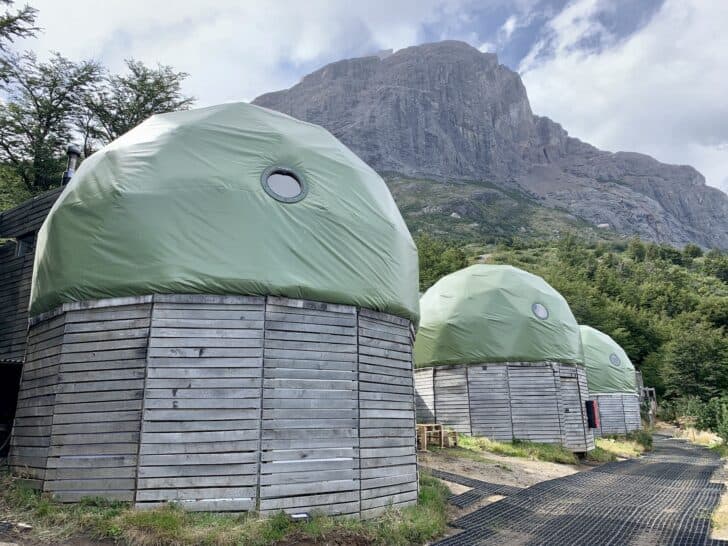
Throughout Torres del Paine National Park you will find nine paid campsite & refugio sectors. If you decide to sleep overnight within the National Park, you will be able to stay at these campsites & refugios during your trip.
This guide will deep dive into all of these Torres del Paine sectors. From choosing your itinerary to understanding the booking process, you will learn everything there is to know about Torres del Paine campsites & refugios.
Read on to learn more!
* Affiliate Disclosure : This post may contain affiliate links, which means I may receive a commission if you make a purchase through the links provided, at no additional cost to you. Thanks for supporting the work I put into TripTins!
1) Torres del Paine Campsites & Refugios
To start, let’s just understand the various Torres del Paine campsites & refugios (mountain huts with shared rooms) that can be found in the National Park.
I have listed these out in order in the counter clockwise direction (the first three are ONLY used for the O trek).
Paine Grande
Free Campsites : there are also two free campsites within the National Park run by CONAF – Paso & Italiano . Currently these are not open, but I will touch upon them later on. In general, I would recommend sticking to the campsites mentioned on the list either way.
The chart below gives you a great overview of what these campsites offer in terms of pricing, accommodation, food, and where you can fit them into a trek itinerary.
You will see a couple of these referenced as “A” or “B”. This is because you can choose between two options for certain nights in the park. These campsites are close enough to one another, that it gives visitors more than one option to choose from.
Throughout the remainder of this guide, I will be diving into more details about it all. Feel free to refer back to this though as needed, as you read through.
Note : chart below reflects updated 2023/2024 pricing
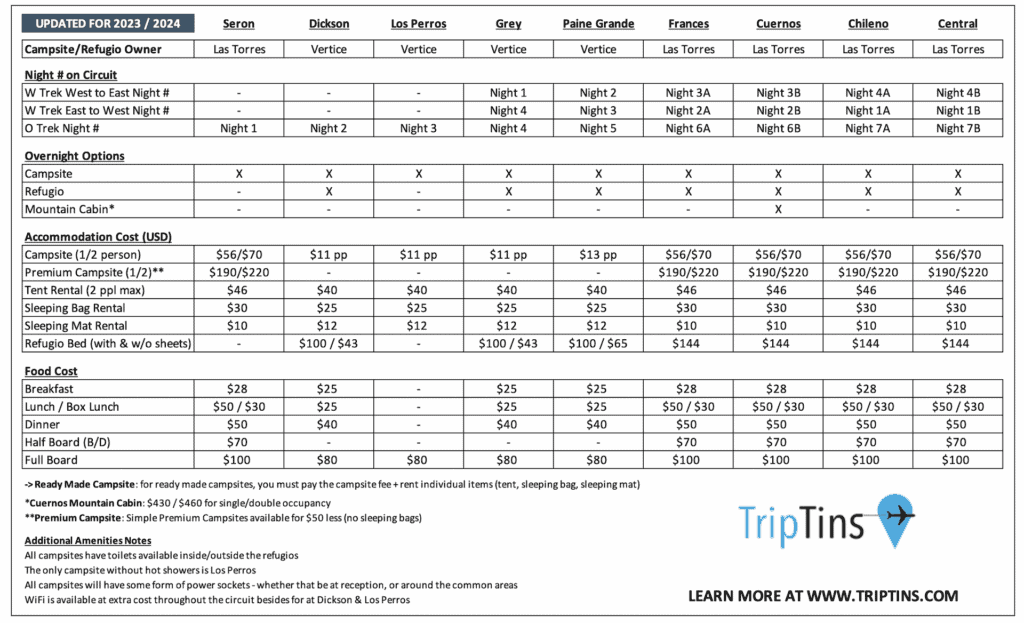
2) Torres del Paine Campsites Map
To better visualize the where the campsites & refugios are located, below is a Google Maps view of them all.
These are purposely placed where they are to give hikers just the right amount of hiking time/distance on a daily basis.
3) Campsite & Refugio Companies
There are two companies that run the 9 paid campsites within Torres del Paine. These are called “Vertice” and “Las Torres”.
Formerly, Las Torres was known as Fantastico Sur (just in case you come across that name as well).
Vertice Campsites
Las Torres Campsites
Since these campsites are run by two different companies, you will need to make reservations at both Vertice & Las Torres (although there is a way to now make all reservations through one site – more on that soon).
As mentioned earlier, there is a third company called CONAF, that runs two free campsites at Paso & Italiano.
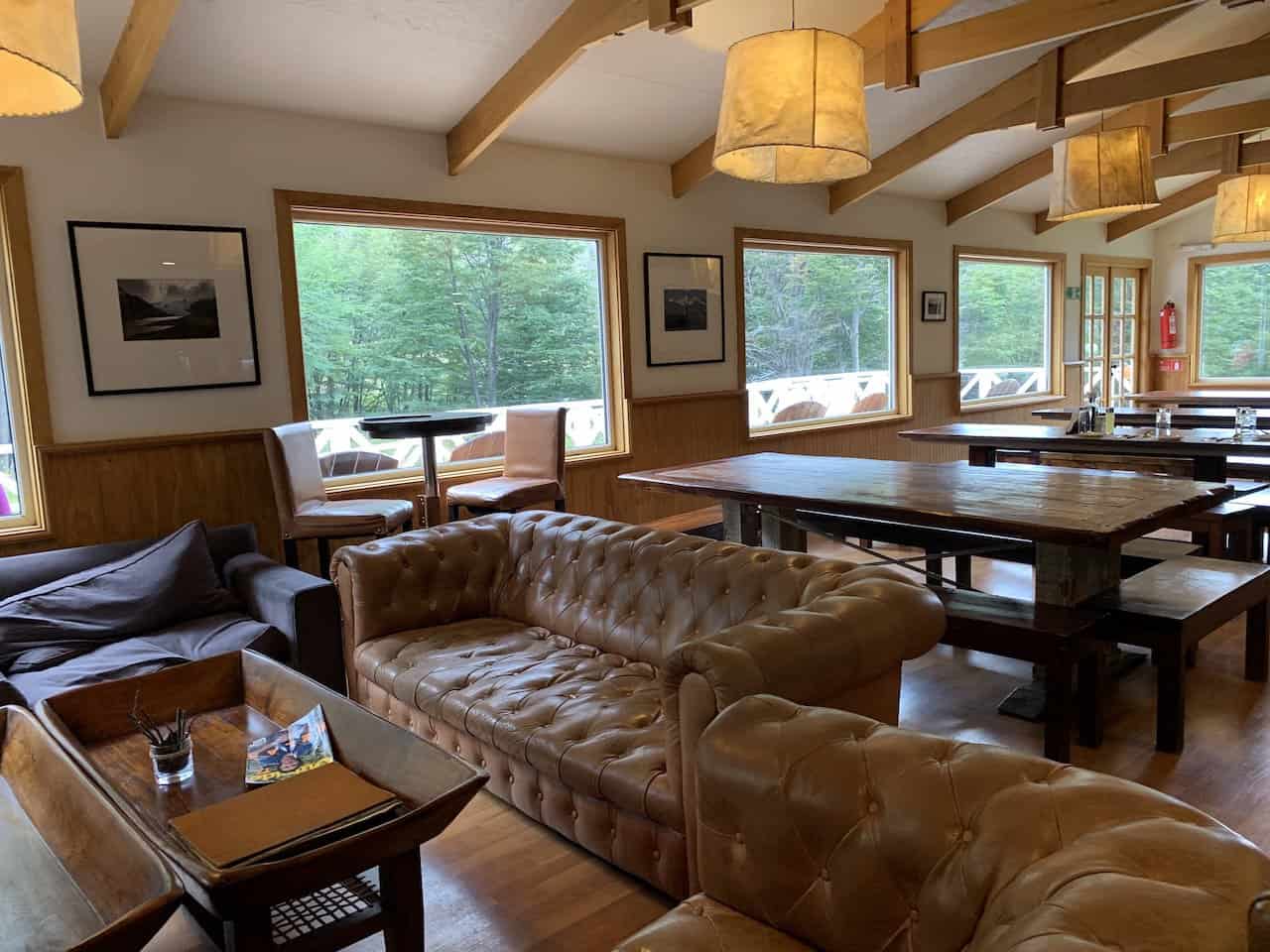
There are two main treks to consider when taking part of a multi-day hike in Torres del Paine National Park. The W Circuit is a 5 day hike and the O is an 8 day hike.
These are called the “W” and “O” because the shape of the route itself spells out the letters (as you can see more clearly on the maps above).
4) Torres del Paine W Trek Camping
Although the W Trek can be shortened, a 5 day W Circuit is the ideal amount of time to spend out on the trail. The W can be completed either west to east (preferred direction), or east to west.
Learn More | W Circuit Torres del Paine
Below would be the itineraries to consider with either option:
W Trek: West to East Camping
- Day 1 : Paine Grande to Grey (Overnight Grey)
- Day 2 : Grey to Grey Suspension Bridges to Paine Grande (Overnight Paine Grande)
- Day 3 : Paine Grande to Frances/Cuernos via Valle del Frances (Overnight Frances OR Cuernos)
- Day 4 : Frances/Cuernos to Chileno (Overnight Chileno OR Central)
- Day 5 : Chileno to Mirador Las Torres to Welcome Center
W Trek: East to West Camping
- Day 1 : Welcome Center to Mirador Las Torres to Chileno (Overnight Chileno OR Central)
- Day 2 : Chileno to Frances/Cuernos (Overnight Frances OR Cuernos)
- Day 3 : Frances/Cuernos to Paine Grande via Valle del Frances (Overnight Paine Grande)
- Day 4 : Paine Grande to Grey & Suspension Bridges (Overnight Grey)
- Day 5 : Grey to Paine Grande
Note that there are two nights where you can choose between campsites:
Frances or Cuernos : in general, there isn’t a big difference here as these are just a couple kilometers apart
Chileno or Central : most people would recommend Chileno as their first choice. This is especially true when going west to east in order to more easily take part of sunrise at Mirador Las Torres .
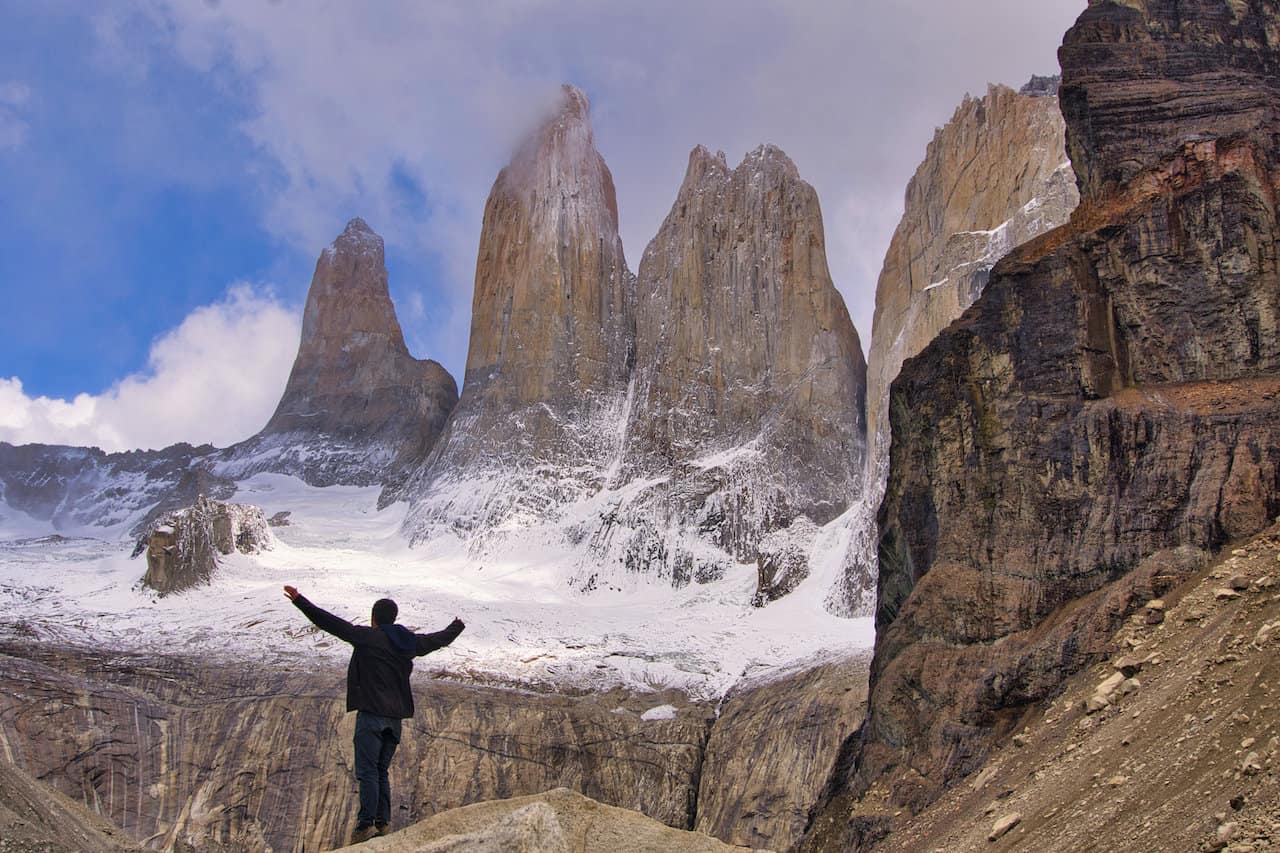
5) Torres del Paine O Trek Camping
The O Circuit can only be done in the counter clockwise direction. This makes your route/decision pretty straightforward. Similarly, you will have those two campsite choices to make as well.
Learn More | O Circuit Torres del Paine
- Day 1 : Welcome Center to Seron (overnight Seron)
- Day 2 : Seron to Dickson (overnight Dickson)
- Day 3 : Dickson to Los Perros (overnight Los Perros)
- Day 4 : Los Perros to Grey (overnight Grey)
- Day 5 : Grey to Paine Grande (overnight Paine Grande)
- Day 6 : Paine Grande to Frances/Cuernos via Valle del Frances (overnight Frances OR Cuernos)
- Day 7 : Frances/Cuernoes to Chileno (Overnight Chileno OR Central)
- Day 8 : Chileno to Mirador Las Torres to Welcome Center
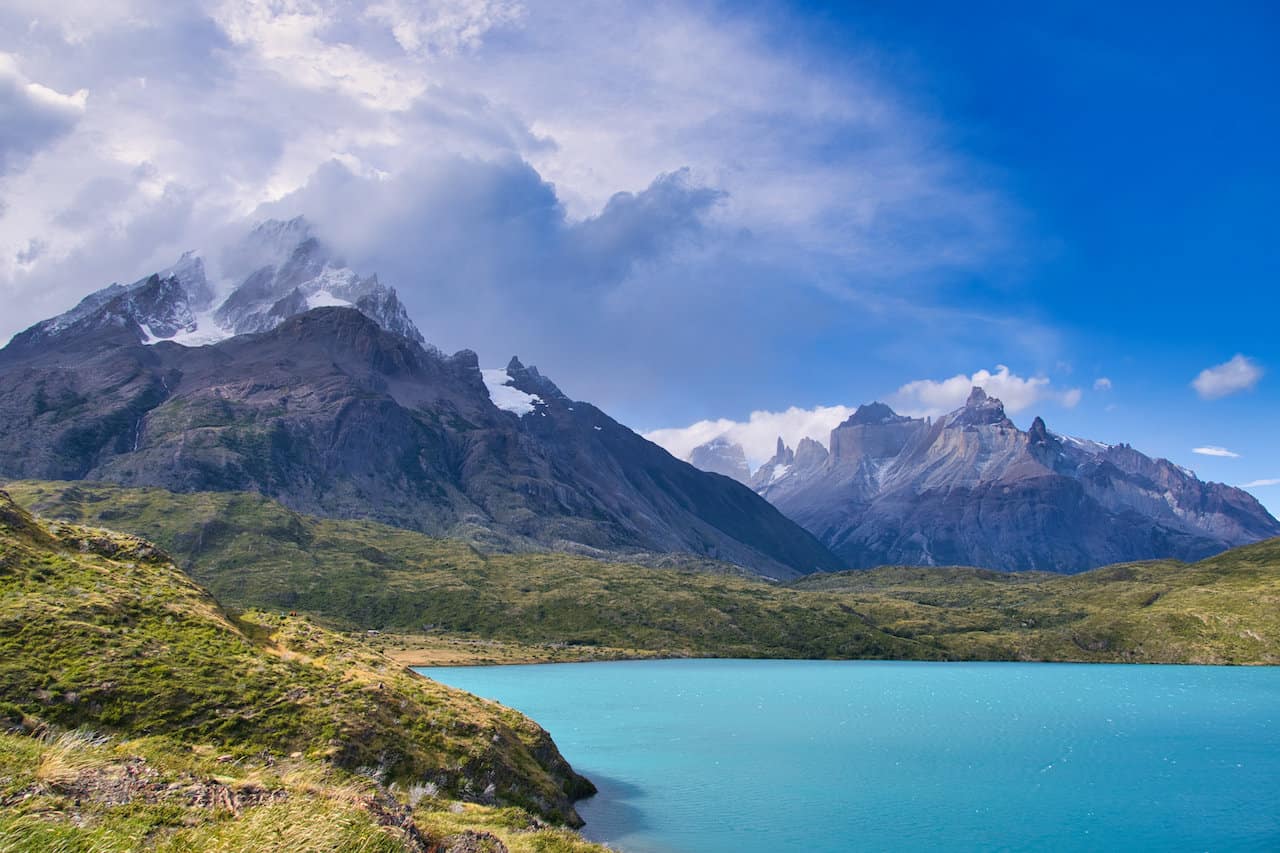
6) Campsites, Ready Made Campsites, or Refugios
In general, there are three ways to go about your overnight options in Torres del Paine. You can choose from a regular campsite (bring your own gear), a ready-made campsite (no need to bring your own gear), or refugios (mountain huts).
At every single one of the 9 sectors, you will find the option for campsites & ready-made campsites. Refugios are available at 7 of the sectors -> just not available at Seron and Los Perros (both only on the O Circuit).
There actually is also a 4 th option – a mountain cabin. These are only available at the Cuernos sector.
If you opt for campsites, that means you will need to bring all your hiking and overnight gear with you along on the trail. Your tent, sleeping bag, mattress pad, & other gear will need to fit in your backpack.
Learn More | Torres del Paine Packing List
You can either bring all of that gear from back home or you can opt to rent the gear in Puerto Natales.
When booking campsites, you will then only need to pay the campsite fee.
Gear Note : you can also rent individual items at the campsites (tent, sleeping bag, mattress pad). So, if you did not want to bring ALL of your own gear in order to lighten your backpack, that could be an option too.
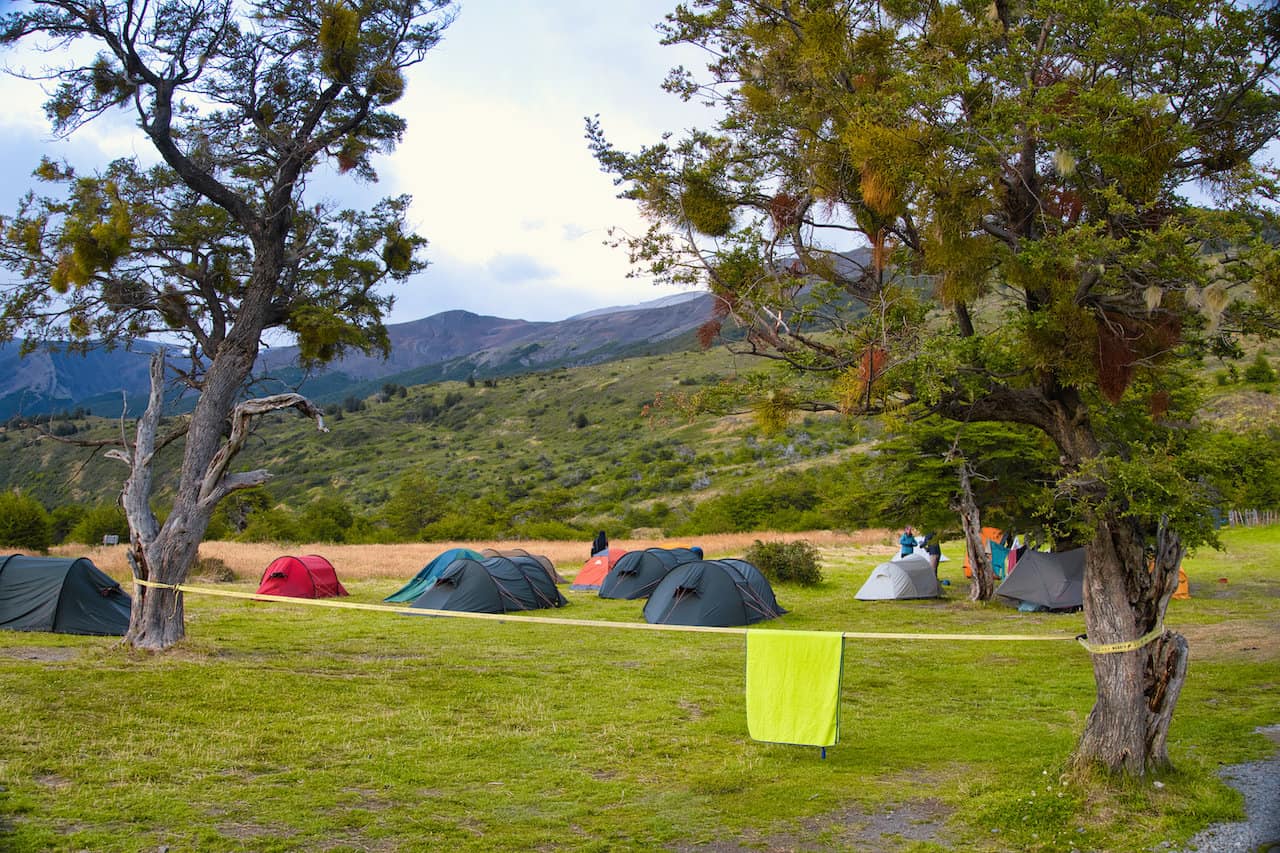
Ready Made Campsites
For those that don’t want to bring any of their own overnight gear, then ready-made campsites are great options for you.
This would entail just showing up at the campsite, and already having a tent, sleeping bag, and mattress pad, all set up for you.
When it comes to pricing, this would be your middle ground option right in between campsites & refugios.
Booking Note : when booking campsites, you may need to select “campsite”, “tent”, “sleeping bag”, and “mattress pad” individually.
Premium Campsite : Las Torres also offers ready made premium campsites. These are even more comfortable, higher elevated platforms off of the ground. In addition, they offer “simple” premium campsites that do not include sleeping bags.
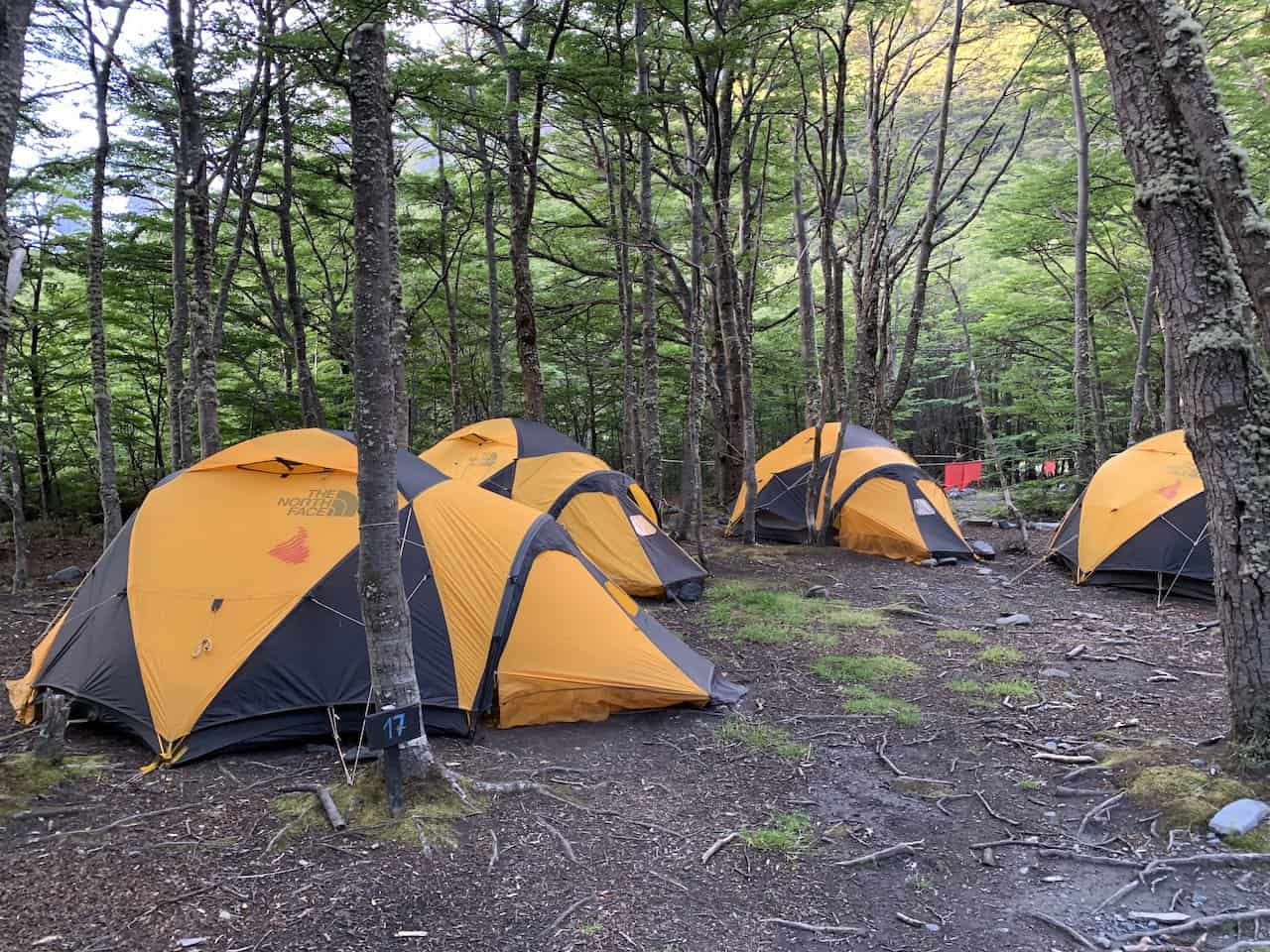
The last main option here will be sleeping in refugios. For the most part this entails a more comfortable indoor setting with shared bunk bed rooms.
By staying in the refugios, you will be better protected by the elements, and should have a more comfortable sleep altogether.
When you are booking these refugios, you will see options with or without sheets. This is because some people may bring their sleeping bag and not require sheets.
Note that you certainly can mix and match your accommodation options each night. Even if you bring your own gear, it can be nice to stay in a refugio here or there.
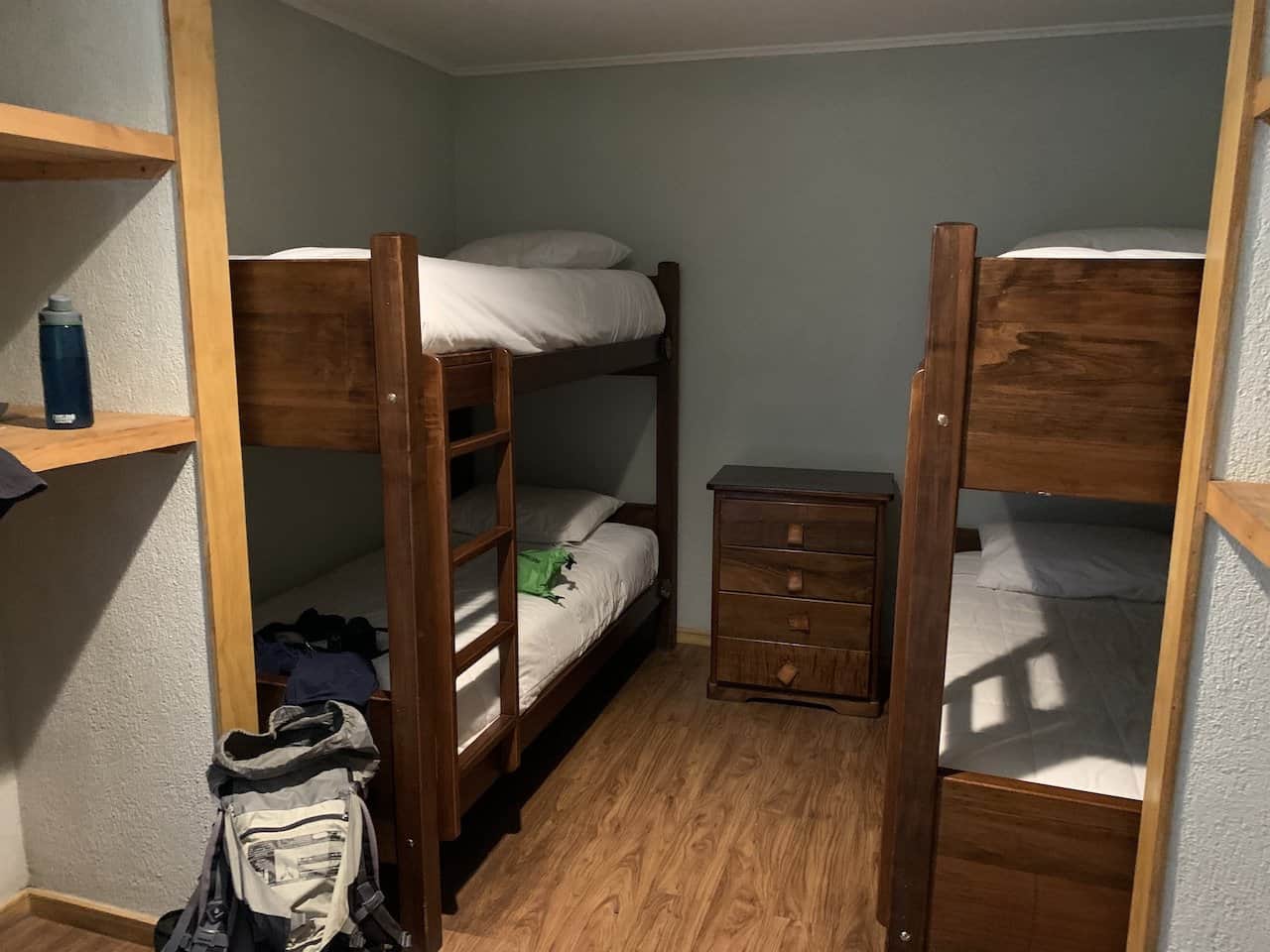
7) Accommodation Cost
One of the major considerations to think about during your trip is your overall budget. The three options above will all be priced differently, so that will be something to think about when visiting Torres del Paine.
When it comes to costs, below will be the main accommodation prices for the various options (note all amounts in USD):
2023/2024 : all prices below are updated for the new season
Vertice Campsites: Dickson, Los Perros, Grey, Paine Grande
- Campsite Fee per Person : $11
- Tent Rental : $40
- Sleeping Bag Rental : $25
- Mattress Pad Rental : $12
- Refugio Bed with Sheets : $100 ($43 without sheets)
→ Los Perros : No refugio available → Paine Grande : $13 campsites fee, $65 refugio bed without sheets ($100 with sheets) → Ready Made Campsite : you will need to pay the campsite fee + rent the individual items
Las Torres Campsites: Seron, Frances, Cuernos, Chileno, Central
- Campsite (single/double) : $56 / $70
- Premium Campsite : $190 / $220
- Simple Premium Campsite (no sleeping bag): $140 / $170
- Tent Rental : $46
- Sleeping Bag Rental : $30
- Mattress Pad Rental : $10
- Refugio Bed : $144
- Cuernos Mountain Cabin : $430 / $460
→ Seron : No refugio available → Ready Made Campsite : you will need to pay the campsite fee + rent the individual items
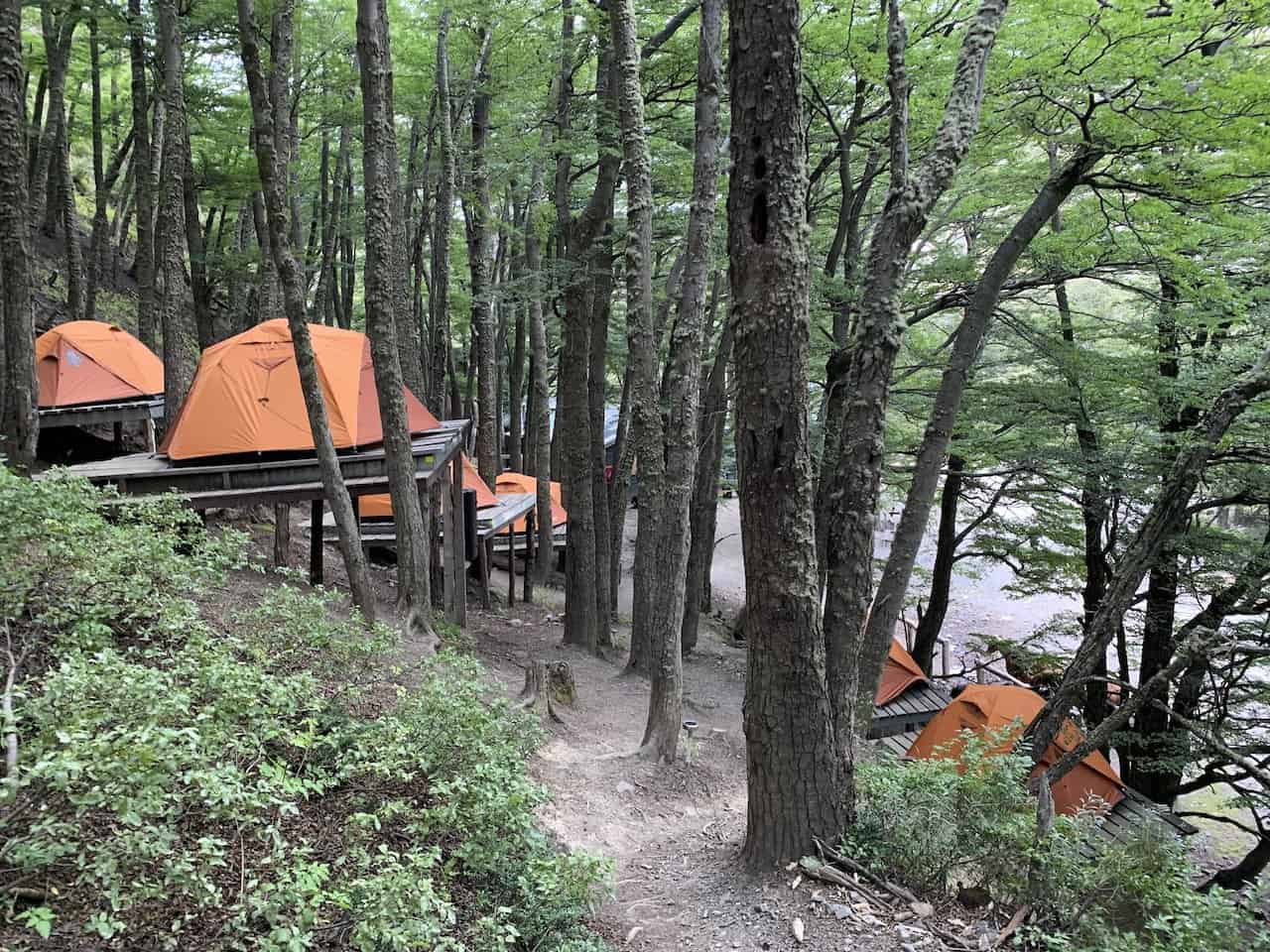
8) Torres del Paine Campsite Food & Meals
While accommodation is one consideration to think about when visiting Torres del Paine, food will be the other major one.
When going about booking each night’s accommodation, you will also be given options to choose meals. This can be in the form of full board or individual meals.
The nice thing about booking the meals, is that you will not need to carry any of your own food (beyond any snacks you may want to bring along). This will greatly help with your backpack weight.
The downside, however, is that the meals can be quite expensive, so you will want to budget out what works best for you.
Of course, you can also mix and match throughout your trek. Certain nights you can make your own food, while other nights you can have a nice meal cooked for you at the refugio.
Below are the prices for Vertice and Las Torres meal options:
- Full Board : $80
- Breakfast : $25
- Lunch/Box Lunch : $25
- Dinner : $40
Note : Los Perros only offers full board
- Full Board : $100
- Half Board (Breakfast & Dinner): $70
- Breakfast : $28
- Lunch/Box Lunch : $50 / $30
- Dinner : $50
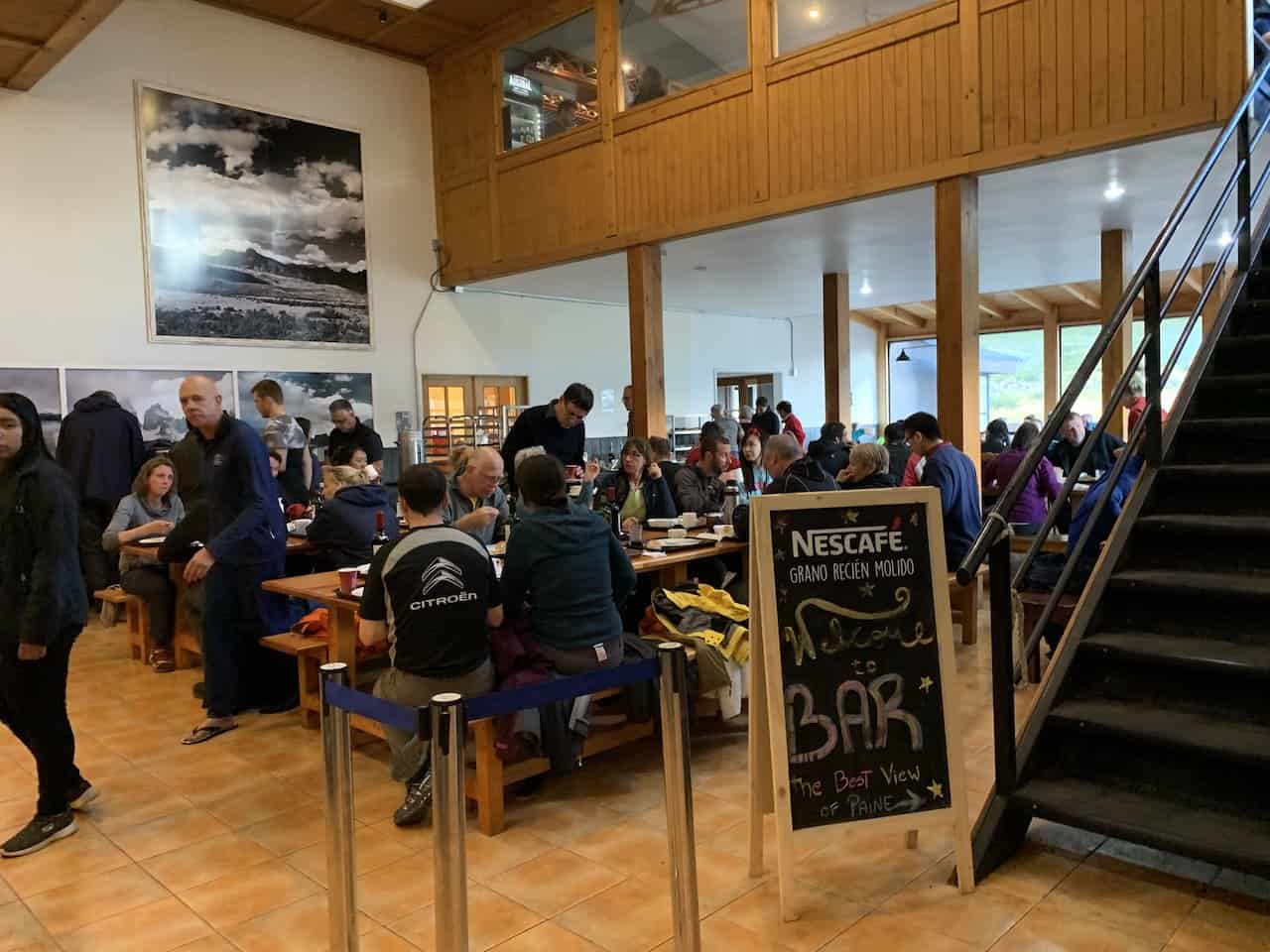
9) Campsite & Refugio Amenities
Before getting into the booking process, I just wanted to point out some basic amenities that can be found at the campsites & refugios around Torres del Paine. Not every sector is built the same, so you will find more or less amenities depending on where you are in the park.
Toilets : every campsites & refugio offers toilet blocks. If staying in refugio, there will be toilets in the building. If staying at campsites there usually is a separate toilet/shower block that is used.
Showers : throughout all of the sectors you will find hot showers available (except for Los Perros, where there are cold showers only). You will be asked to keep showering to a minimum in order to conserve water & energy.
Electricity : every sector will offer some sort of electricity to charge your electronics. These may be in common areas, by the front desk, or in refugio rooms.
Bringing a small powerbank will always be helpful for your time on the trail, but don’t worry too much about keeping things charged. Note that electricity usually is turned off at night to conserve energy.
WiFi : you will also find a paid WiFi service throughout the sectors (besides Dickson & Los Perros). The WiFi is only available around the refugios/campsites & not on the trail itself.
For $5 – $12, you will be able to connect for 1 – 10 hours depending on the plan chosen.
Food Mini Markets : the sectors also offer small mini markets, where you can purchase snacks, drinks, and other basic items. Each mini market will be a bit different, but just know something is out there.
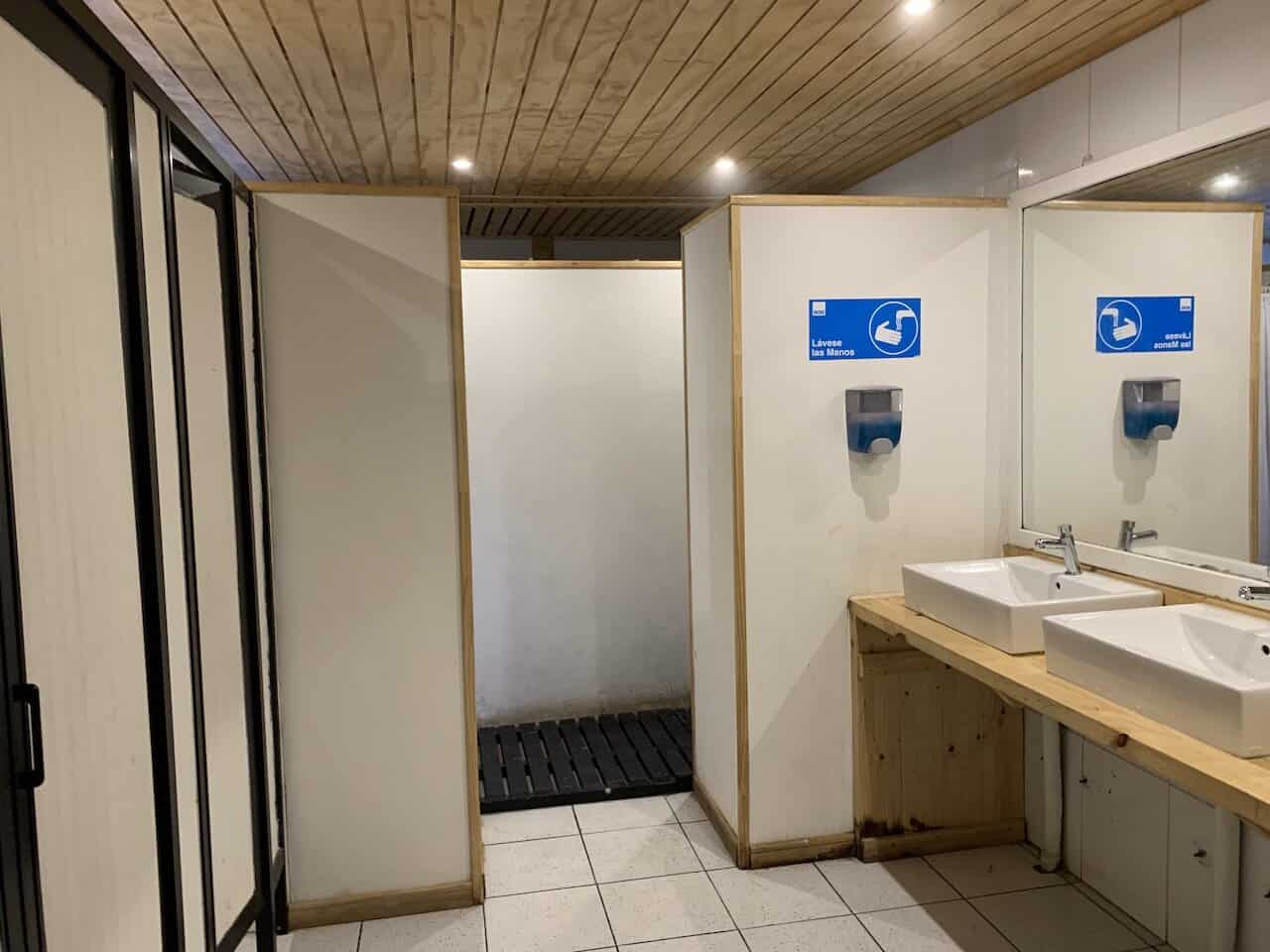
10) How Do I Reserve Campsites & Refugios in Torres del Paine
Now that you have a better idea about what the Torres del Paine campsites are and how much they cost, let’s dive into the booking process.
Since the campsites are run by two separate companies, you will need to book with each one for the specific nights you are interested in.
That means you first must lay out your itinerary dates, and then look up availability between the Vertice and Las Torres websites. You do not want to book one set of dates without knowing if the second set of dates are available.
With that said though, recently there have been some websites where you can book everything in one. Booking Patagonia is one of those sites, and it is very user friendly.
If I were to do it myself, I much rather just book with the one website instead of the two individual ones. I have also heard that the customer support is very helpful in the case that you need to make changes.
Not only does the site include both the Vertice and Las Torres bookings, but you can also buy bus tickets to/from the park, and purchase Torres del Paine entrance tickets. It really is a 4 in 1 type of site.
See below for booking instructions for Vertice, Las Torres, and Booking Patagonia:
Vertice Booking
Below are the steps to go about booking with Vertice for Dickson, Los Perros, Grey, and Paine Grande.
- Step 1 : Go to the Vertice website
- Step 2 : Choose the number of people, your nationality, & currency
- Step 3 : Choose the W or O Circuit (Paine Massif)
- Step 4 : Choose your starting point (Dickson or Los Perros)
- Step 5 : Continue choosing your next nights
- Step 6 : Once complete, click the red button “Yes, I want to choose my date”
- Step 7 : Choose your starting date (the rest will fill out automatically)
- Step 8 : Once you choose your accommodation and additional services (food, rental gear) for each night, click Continue. From there you will be shown your booking summary and you will have 25 minutes to then put in your personal details and pay for the reservation.
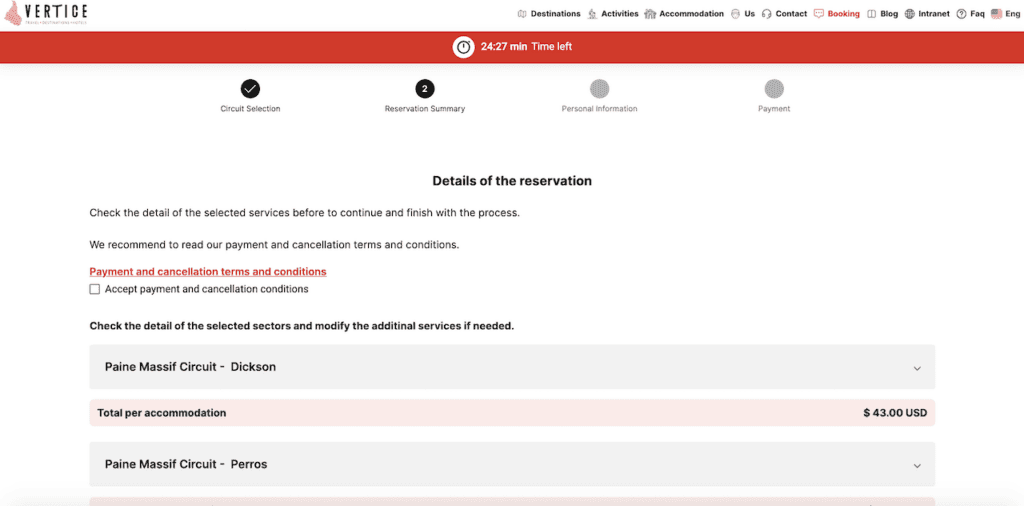
Las Torres Booking
Below are the steps to go about booking with Las Torres for Seron, Frances, Cuernos, Chileno, and Central.
- Step 1 : Go to the Las Torres website
- Step 2 : You will be taken directly to the booking page where you will find the five campsites/refugios to choose from with check in / check out dates (change these initially before continuing to the next step).
- Step 3 : By clicking the magnifying glass icon on the right hand side of each sector, you will be shown booking options for that night.
- Step 4 : Choose your accommodation and food options for each of the three nights needed
- Step 5 : Click the “Book Here” button, and follow the instructions to fill in your personal details & pay for the reservation.
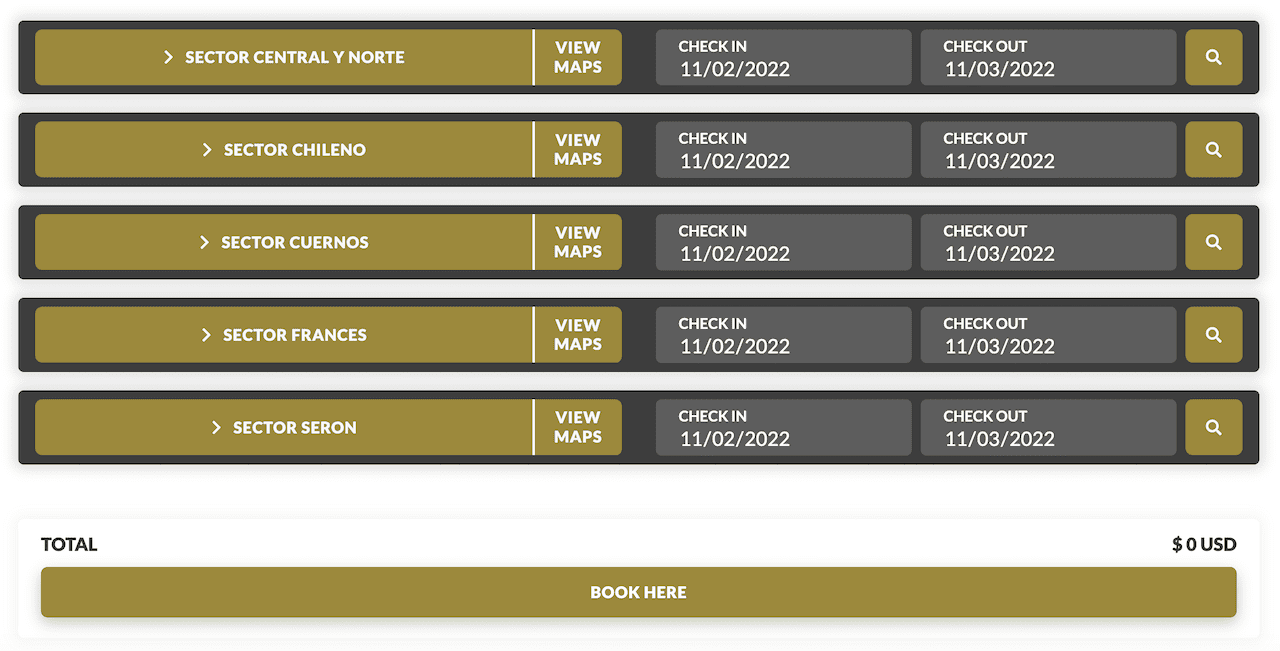
Booking Patagonia
Recently a new site called Booking Patagonia now offers the opportunity to book both Vertice & Las Torres through a single site . Prices seem to be in line with the two companies, so that may be an easier option moving forward.
It is a great website interface, where you can build your route as you go. In addition to purchasing the food and accommodation, you can also purchase bus tickets and entrance tickets to Torres del Paine
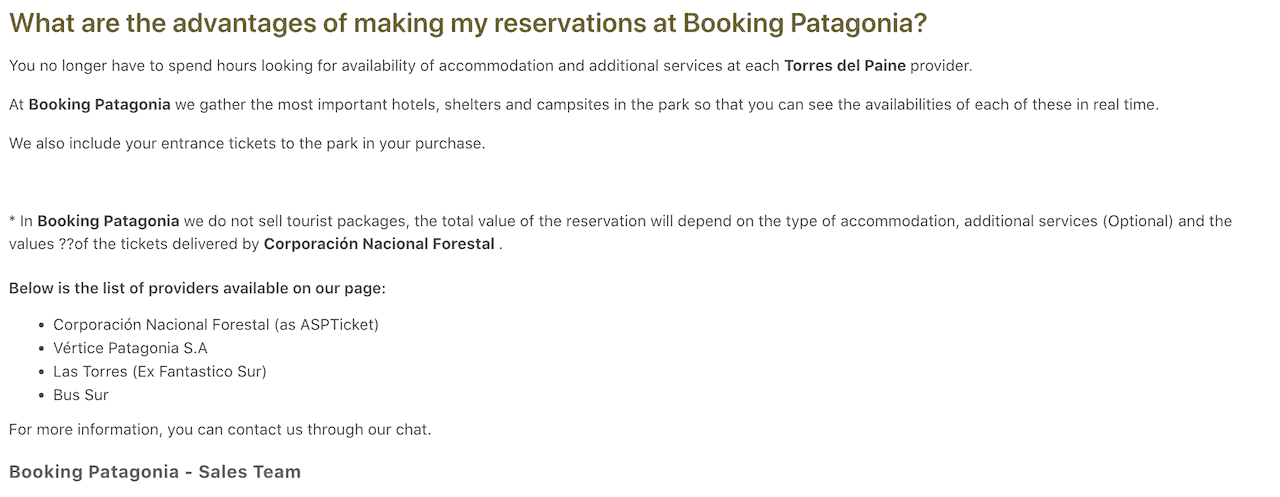
11) Torres del Paine Camping
Each one of the campsites throughout Torres del Paine will be a bit different from one another. Feel free to read a bit more about what each campsite in Torres del Paine entails.
Vertice Patagonia Campsites
We will start out with the four Vertice run campsites in Torres del Paine:
The Dickson sector is only used if taking part of the O Circuit. This would be the second night out on the trail.
The campsite is beautifully located just on the edge of Dickson Lake, with many Patagonian peaks in the surrounding areas.
You will find an open field with campsites set up along with the refugio.
Once you arrive in camp and get yourself situated, feel free to head to the lakeside to grab some photos and relax by the water font.
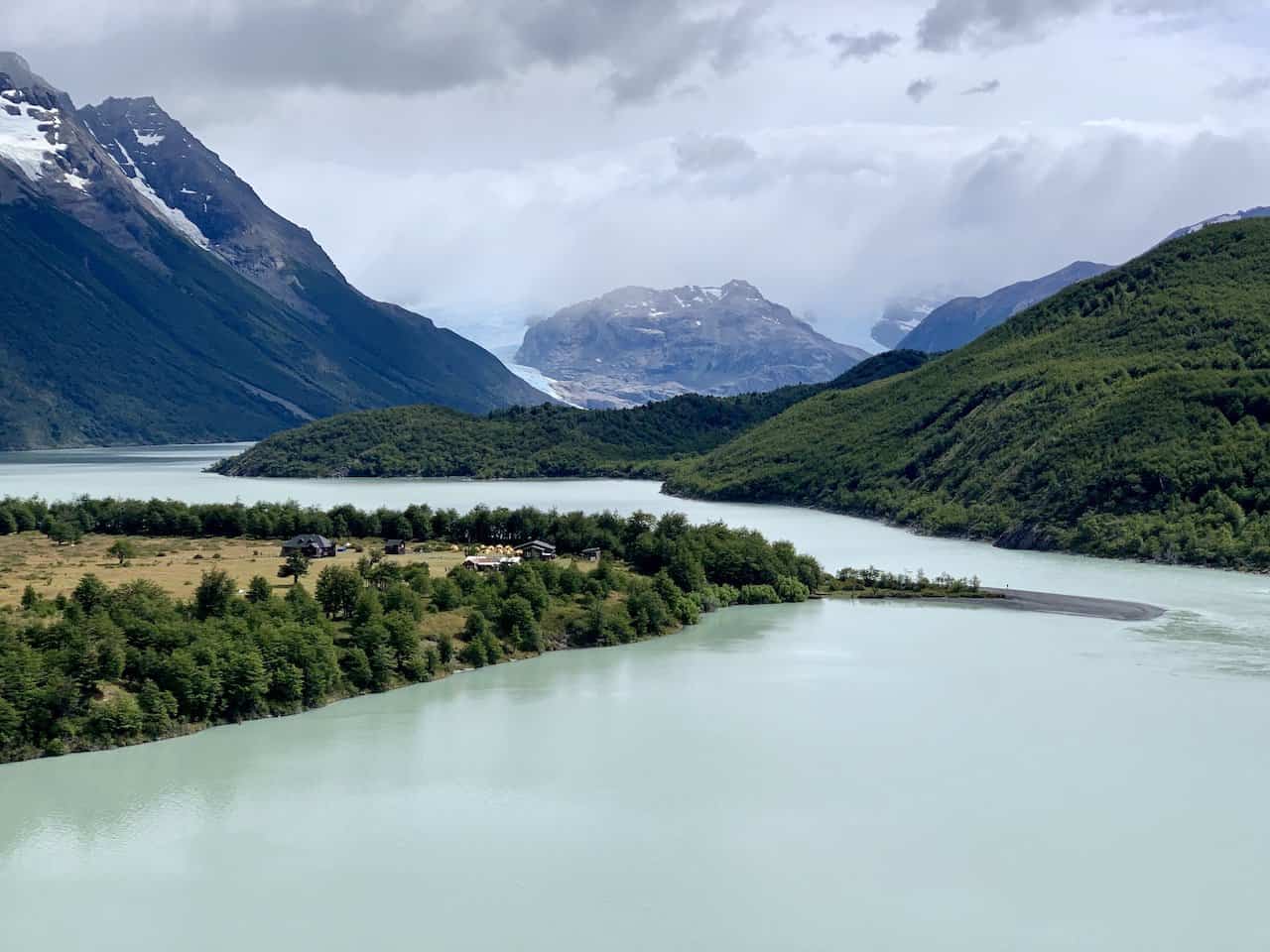
Just a few hours away from Dickson is the Los Perros campsite. Out of all of the campsites on the circuit, Los Perros is the least maintained one.
You will only find campsites available here along with a smaller shared dining area. Remember, there is no refugio option at Los Perros.
Only cold showers are available and don’t be surprised if the toilets don’t work too well either.
Since it is a shorter day out on the trail, I would recommend spending the afternoon at the Laguna Los Perros overlooking the Los Perros Glacier.
You would be passing by the lake on the way into camp (just a few minutes away from each other). Once you are all set up in camp, retrace your steps for a few minutes and hang out by the lakeside.
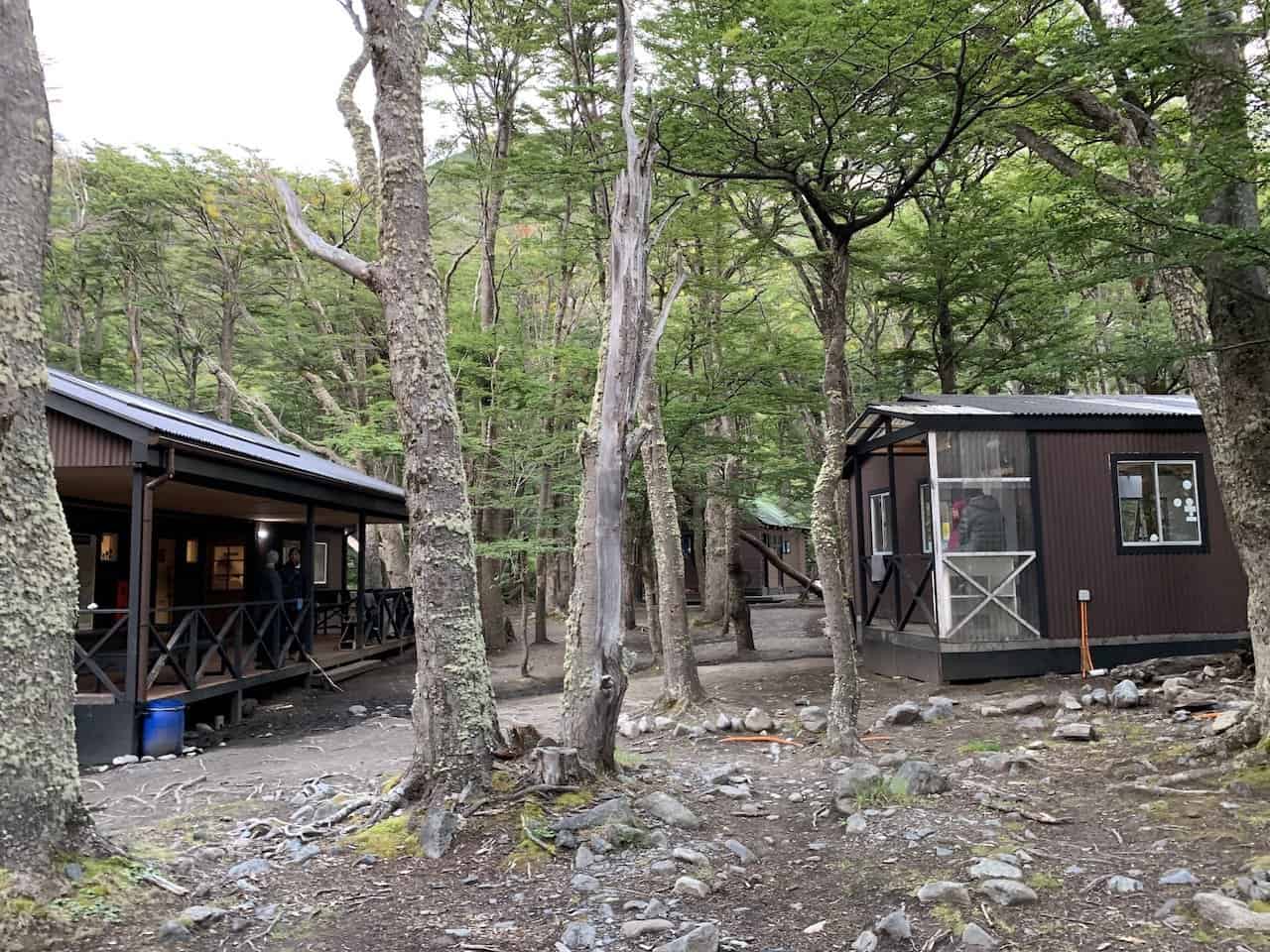
When it comes to campsites & refugios, Grey may be one of the best there is.
Since it is one of the most popular sectors in the park – part of the W and O, as well as mini treks – you will find it to be quite comfortable.
The common room is quite large with great hang out areas and a la carte food options. There is also a separate building with a small shop and computer area (for a fee).
During your time at Grey, be sure to head on the trail to lakeside, where you will find a great lookout over the iceberg lagoon and Grey Glacier .
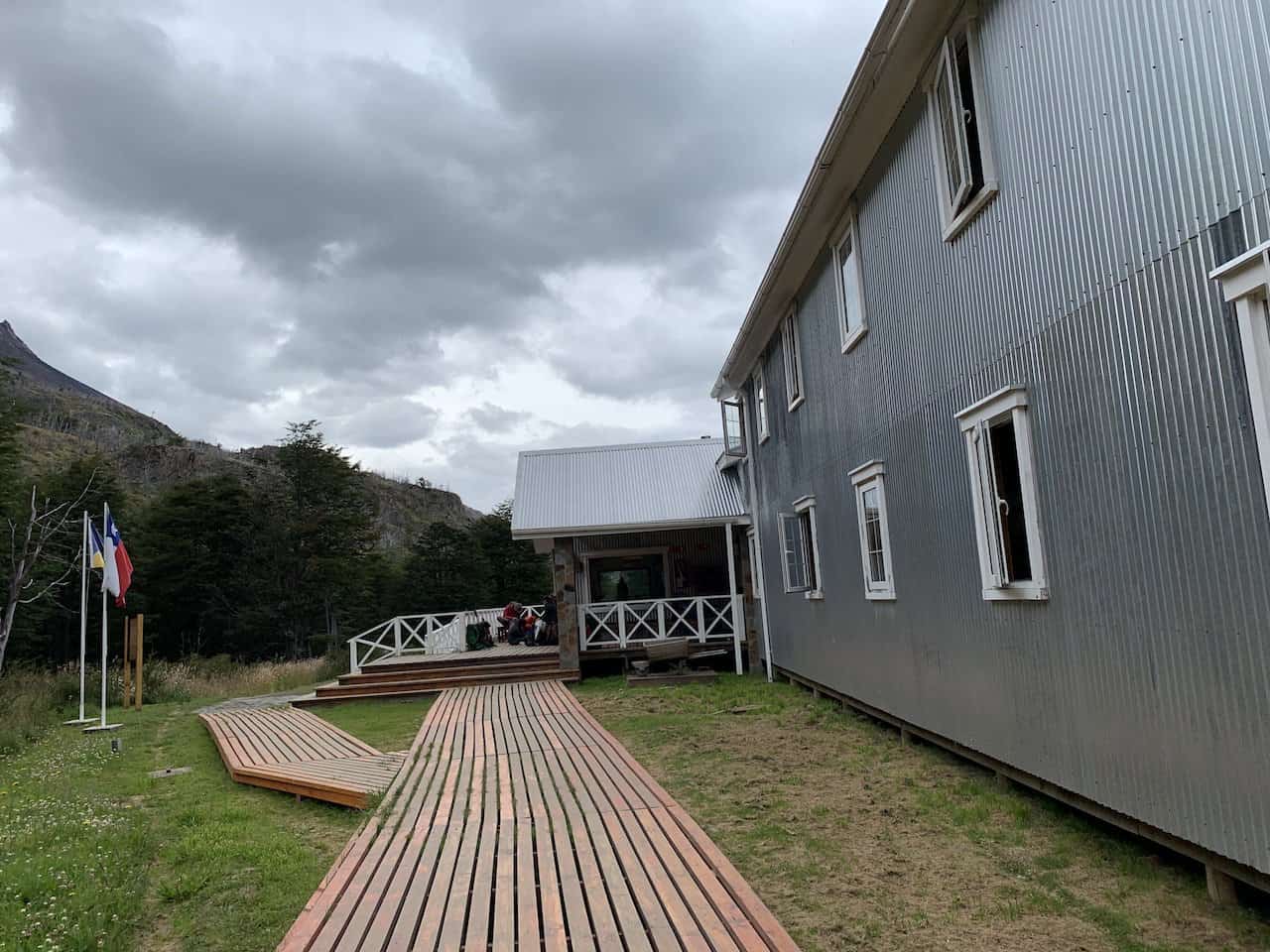
Another well-established sector is at Paine Grande. Similarly, you will find a large campsite area and comfortable refugio to stay at.
The dining area at Paine Grande is the largest of them all, and you will also find an upstairs bar area to enjoy.
The views from Paine Grande are the best in my opinion. From the doorstep you will get beautiful views of the Cuernos del Paine and Lake Pehoe.
Once all situated at camp, I would recommend heading on the trail along Lake Pehoe. The trail extends for several miles, but just walking 10-20 minutes along it, will give you great views to enjoy.
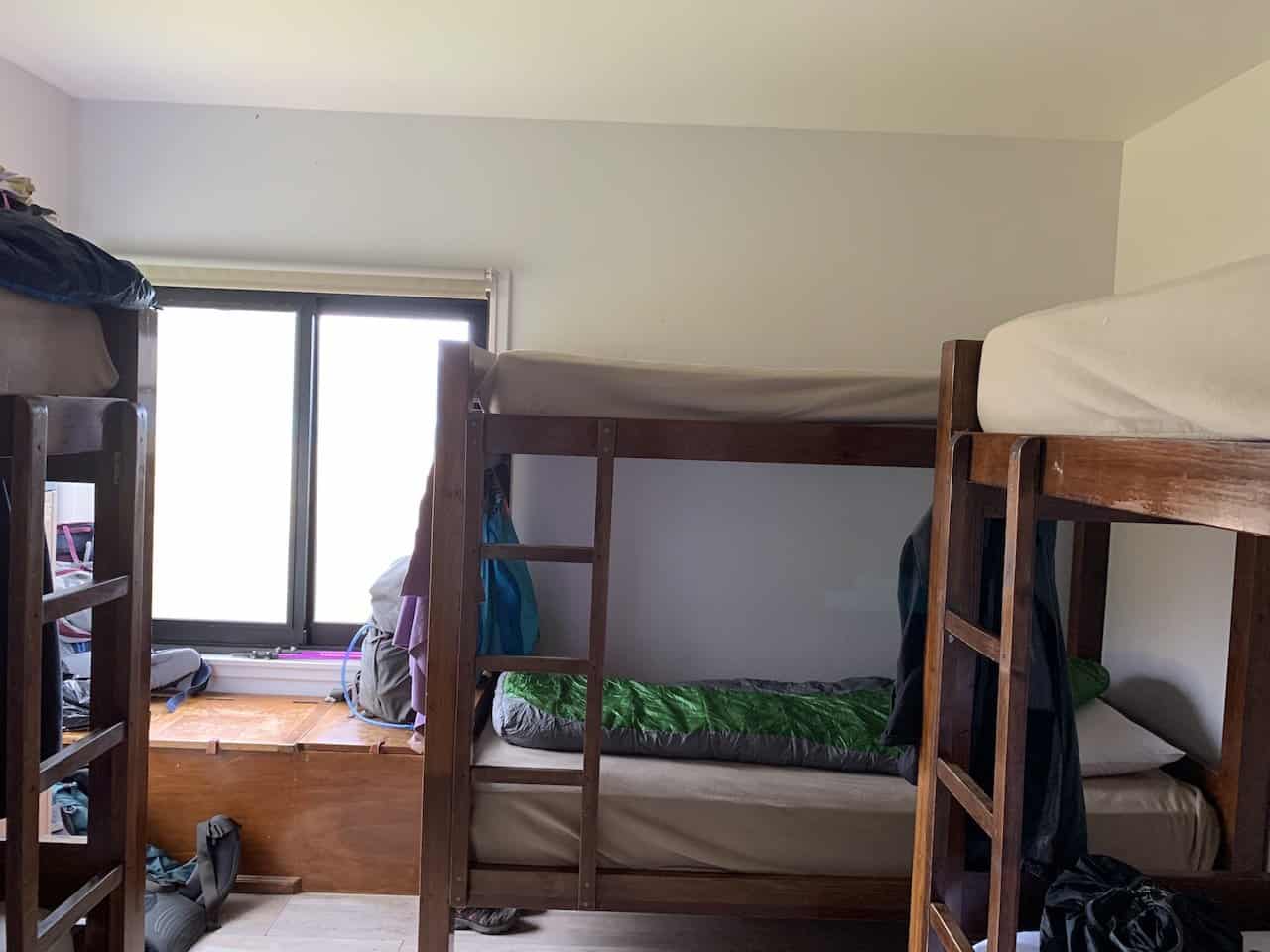
Las Torres Patagonia Campsites
The other 5 campsites in Torres del Paine are run by Las Torres. While these sectors are most expensive, I would not consider them any better than Vertice. It is simply what they charge.
If taking part of the O, Seron will be your first night out on the circuit. This is the only campsite on the backside of the O run by Las Torres.
Altogether, it is a simpler campsite as there is no refugio available. Instead you will find an open field of campsites and platforms, where you will stay for the night.
There is a smaller main common room area, where you can hang out in, and a separate structure with toilets & showers.
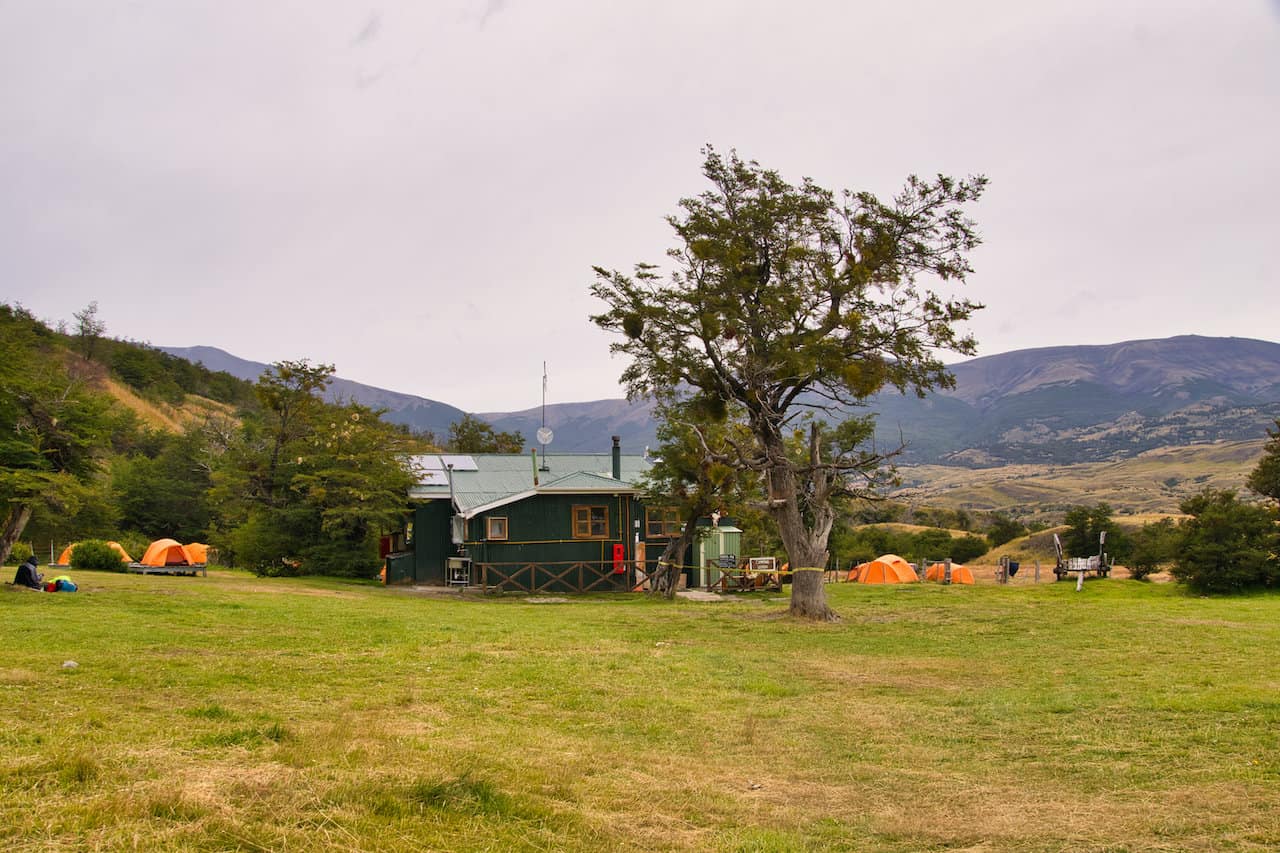
Moving back to the front side of the National Park, you will find the Frances campsite. Frances is a bit unique as its refugios are actually domed structures. This is much different than the rest of the refugios on the circuit.
The campsite side of things is set back a bit further inland, where you will find platforms scattered throughout the forest.
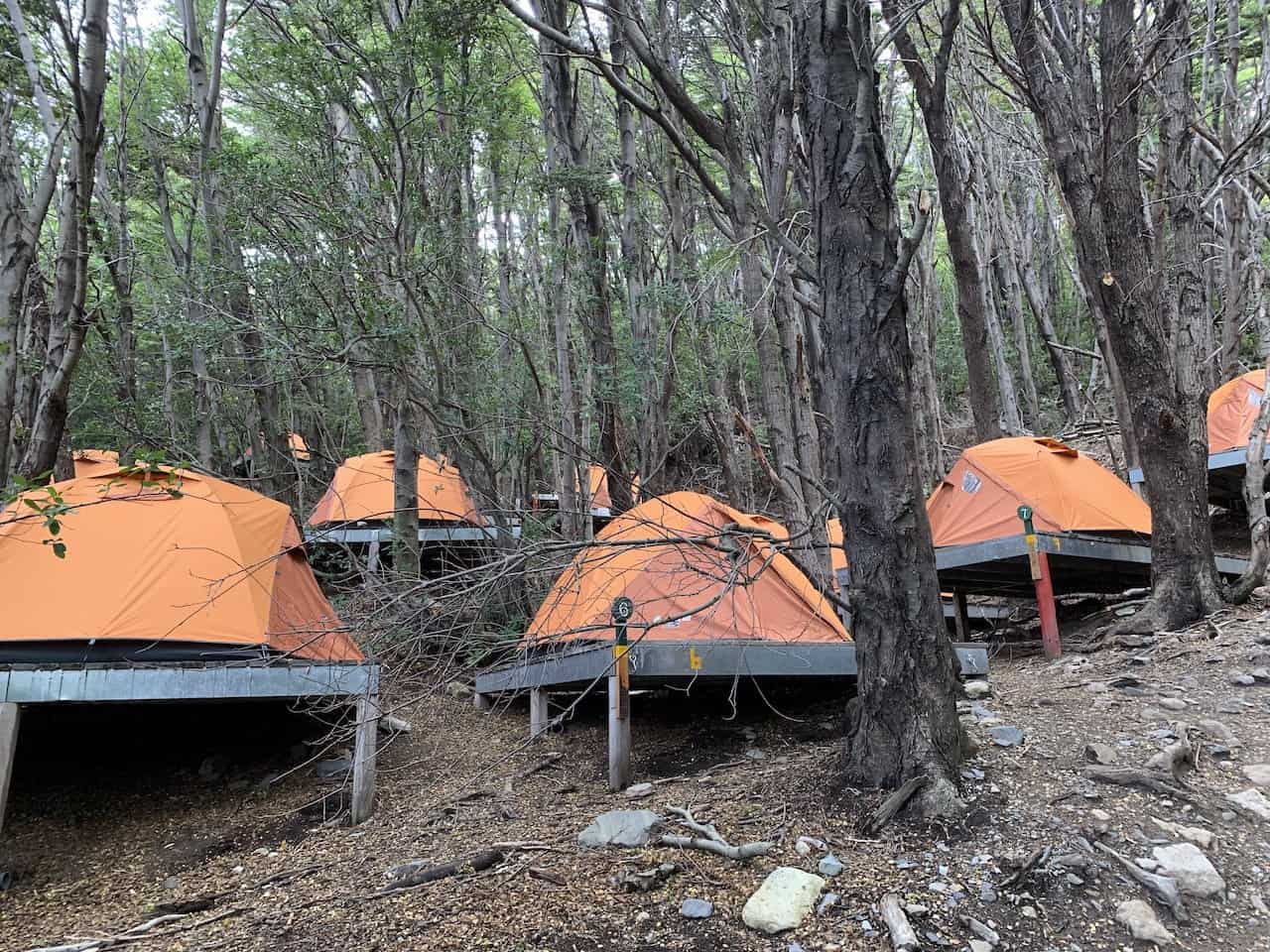
While I did not stay at Cuernos, I did pass by it between Frances and Chileno. You will find Cuernos just a couple kilometers further along from Frances.
Due to their proximity, you can really choose between either of these options when considering your overnight options. If one is sold out, simply check out what the other offers.
Cuernos is also the only sector that offers private mountain cabins. So, if you wanted an indoor accommodation without the shared room, then Cuernos is for you.
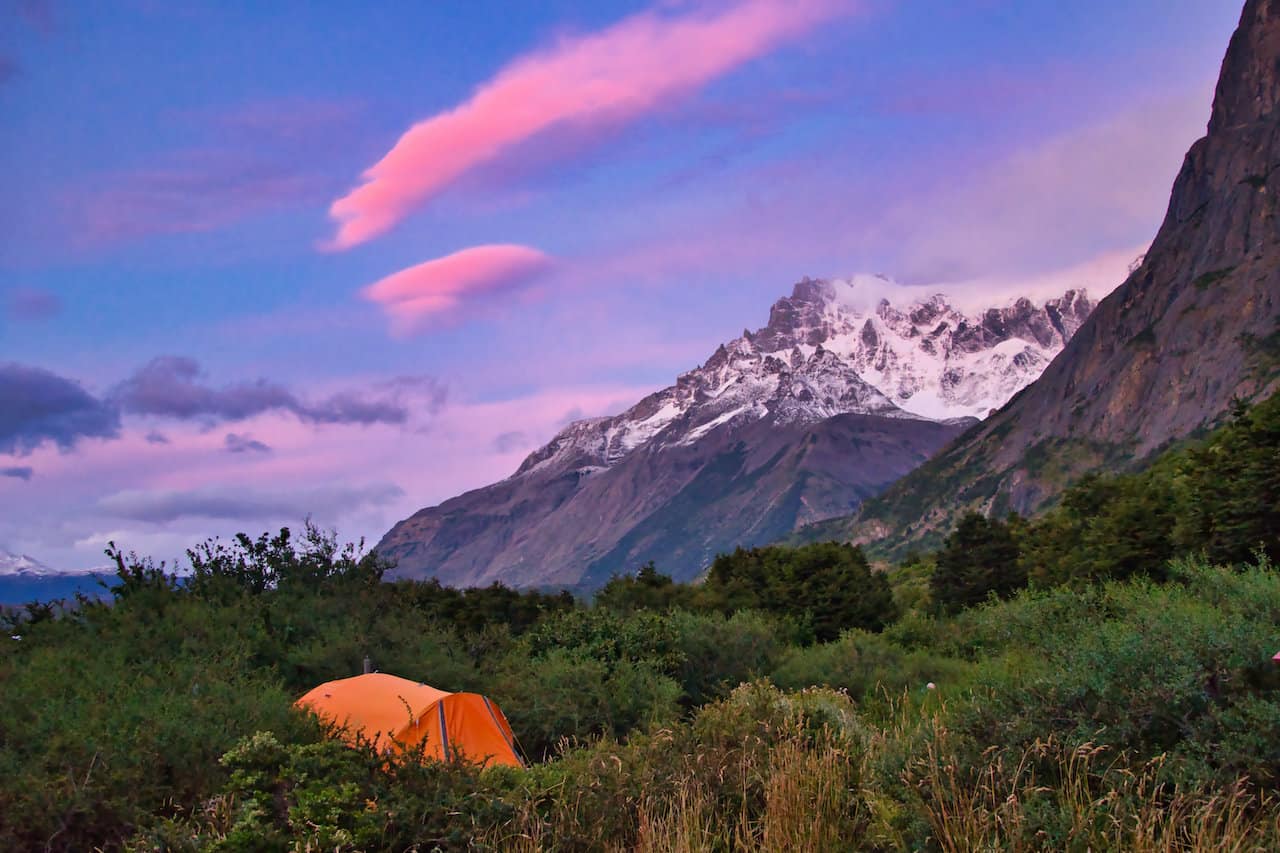
The closest sector to the famous Mirador Las Torres is Chileno. Many people choose Chileno (instead of Central) due to this proximity.
One highlight of Torres del Paine is to see sunrise at the Las Torres. By staying at Chileno, you will have the shortest trek in the dark in order to get to the lake in time for sunrise.
At Chileno, you will find a common dining area connected to a short hallway, where the refugio rooms are located.
Just outside the refugio, you will find the Chileno campsites on platforms spread throughout the trees.
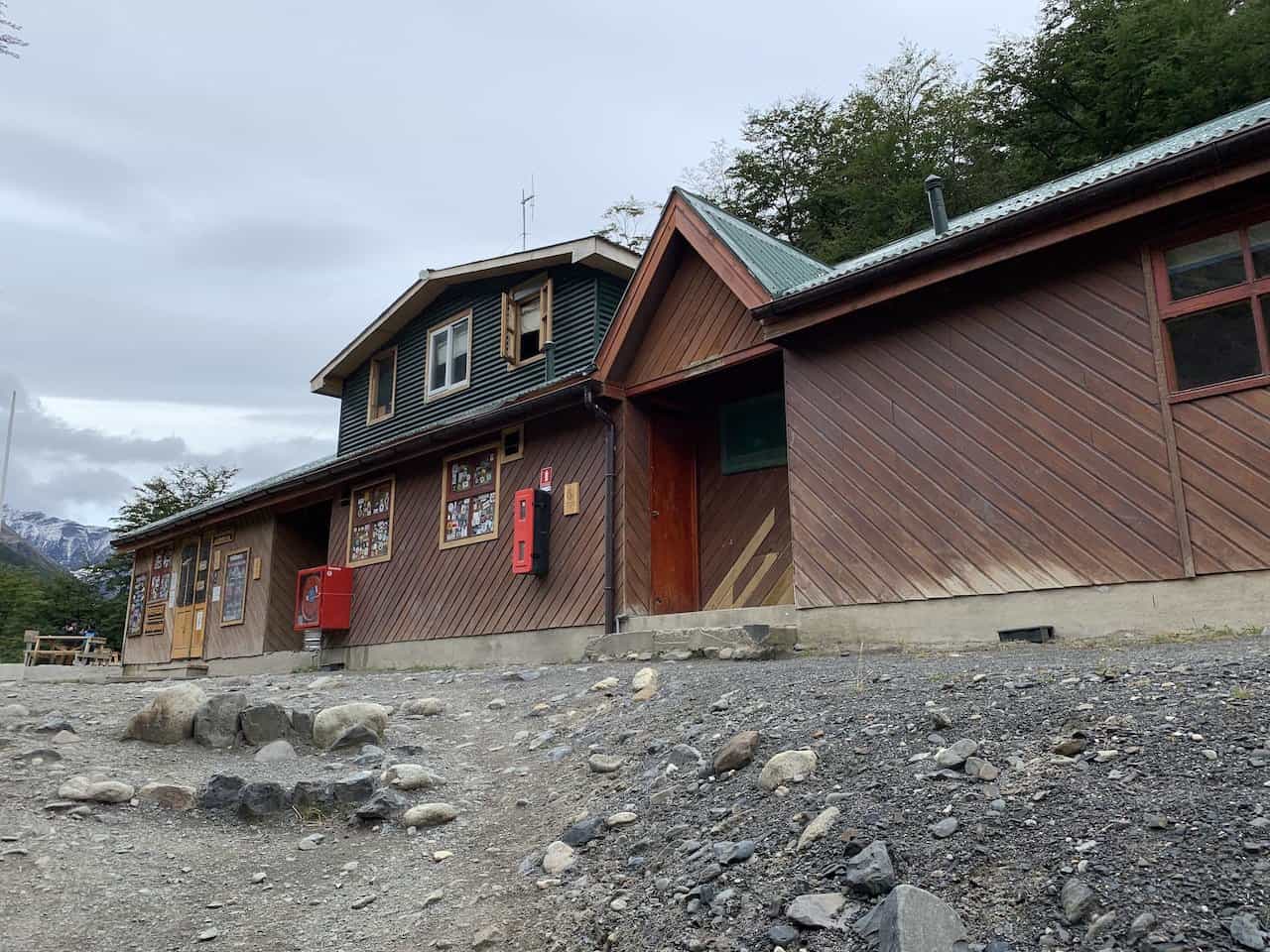
The Central sector is located right by the entrance of Torres del Paine. If Chileno is all booked up, then Central is going to be your best bet. While it is a longer distance between the two, you should not need to change an overall itinerary.
Right nearby Central you will also find Hotel Las Torres. This is an actual hotel located within the National Park. So, you also have that option if you want some real comfort during your stay.
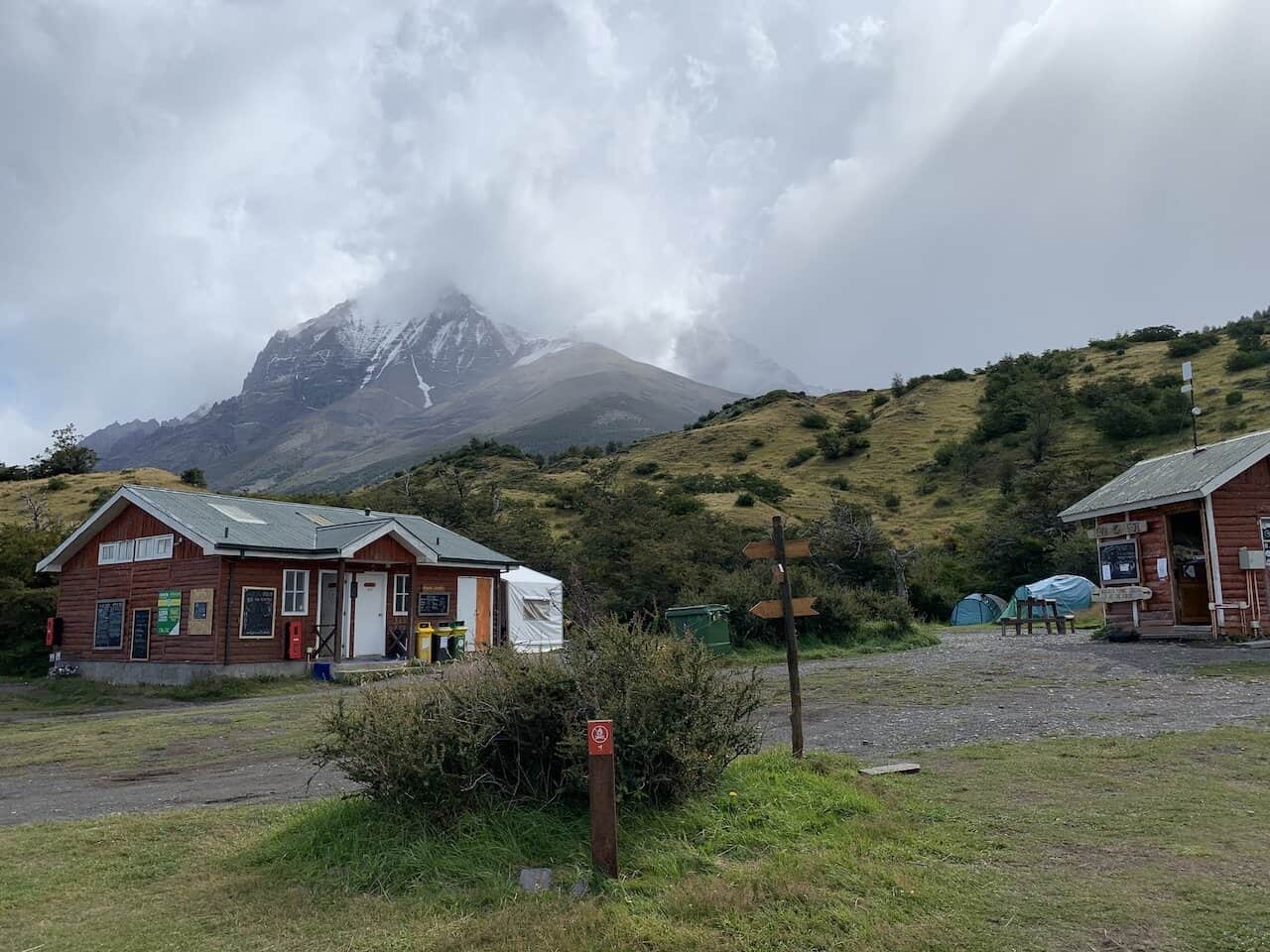
CONAF Camping TDP
Within Torres del Paine you will also find two free campsites run by the National Forest Corporation – CONAF. This is the organization that runs the park in general.
Currently the two campsites are closed but you can check their website for more up to date information.
Paso – this is a campsite located between Los Perros and Gray. It is not really one that I would even recommend to stay at since it doesn’t really fit with a standard itinerary.
Italiano – the Italiano campsite is located at the start of the Valle del Frances (just nearby the Frances campsite). You could stay here instead of Frances or Cuernos if that would be of interest to you.
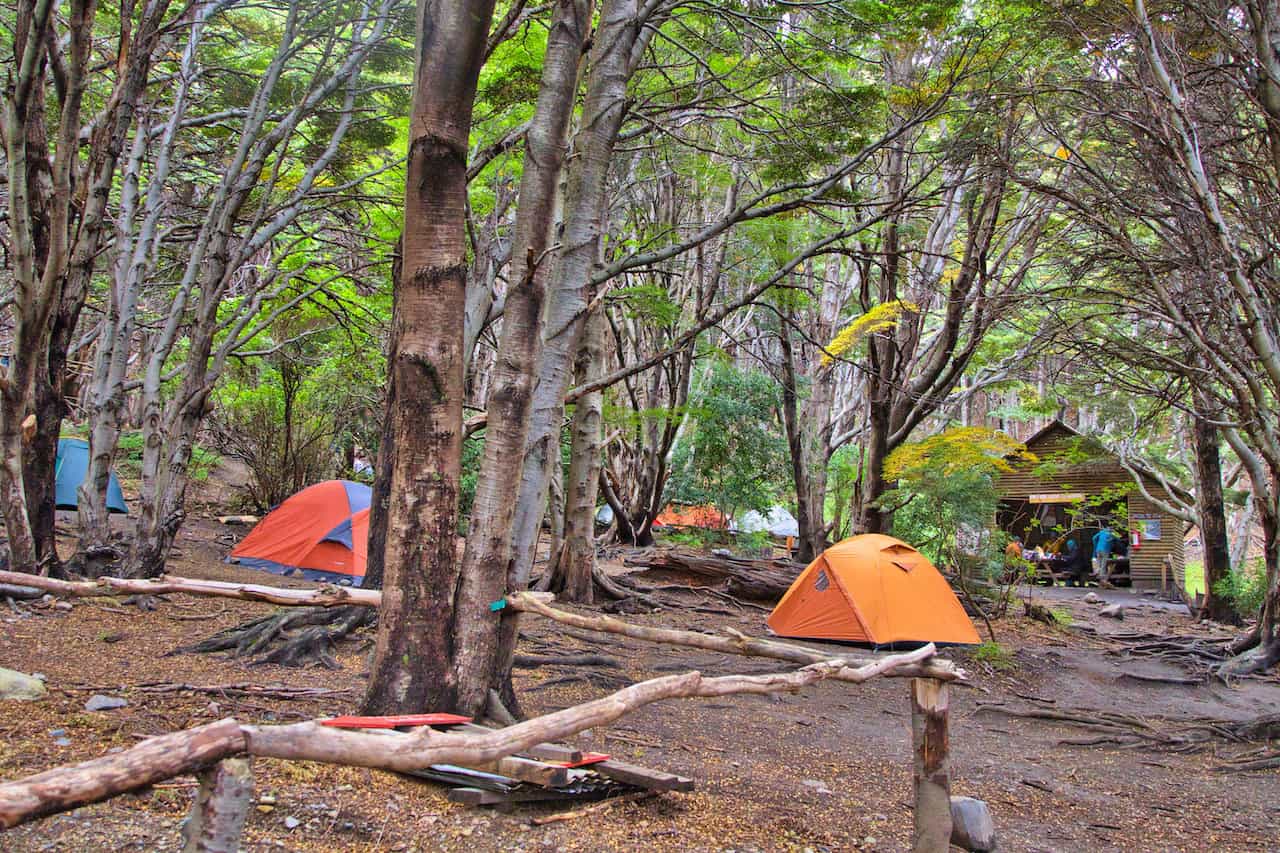
12) Torres del Paine Campsite Booking Tips
Here are some helpful tips & things to know when it comes to booking accommodation is Torres del Paine:
Book in Advance
Torres del Paine really isn’t a year-round destination. Most of the trekking happens in the summer/shoulder months between September and April.
Due to its popularity and the fact that spots are limited in the park, I would highly suggest booking your spot well in advance.
During peak season, you will find that spots fill up very quickly. There may always be some availability here or there, but to string together the 4-7 nights needed can be difficult.
I would recommend keeping an eye on those openings and book as your dates become available.
Before even booking flights or thinking about anything else on your overall itinerary, you will want to be sure there are open campsites/refugios for your dates.
Booking with an Agency
Now, if you are set with particular dates in mind but you find that there is no availability, not all is lost.
There are local travel providers in the area that could still have spots available. These providers usually buy up spots when they become open and then offer all in one packages to customers.
So, you don’t even need to think about booking anything on your own. By just working with a local provider, they can take care of everything for you.
While that sounds like the perfect solution, do note that these packages will come with a higher price point. The agencies do need to make some money, so don’t be surprised if you see a markup on the normal price.
Last Minute Availability
During my time in Torres del Paine, I found out that there are instances where these local travel providers can’t sell through the spots that they have bought.
So, what happens in these situations, is that a couple weeks prior to a date, they will give back the nights to Las Torres and Vertice.
As I write this article in the middle of peak season, I am seeing availability even at refugios in a week’s time. Maybe this is just do to lower demand, but I would not be surprised if it was due to some travel providers giving back their unused reservations.
If you are looking for last minute reservations, always be sure to check availability. You may be surprised on what you come across.
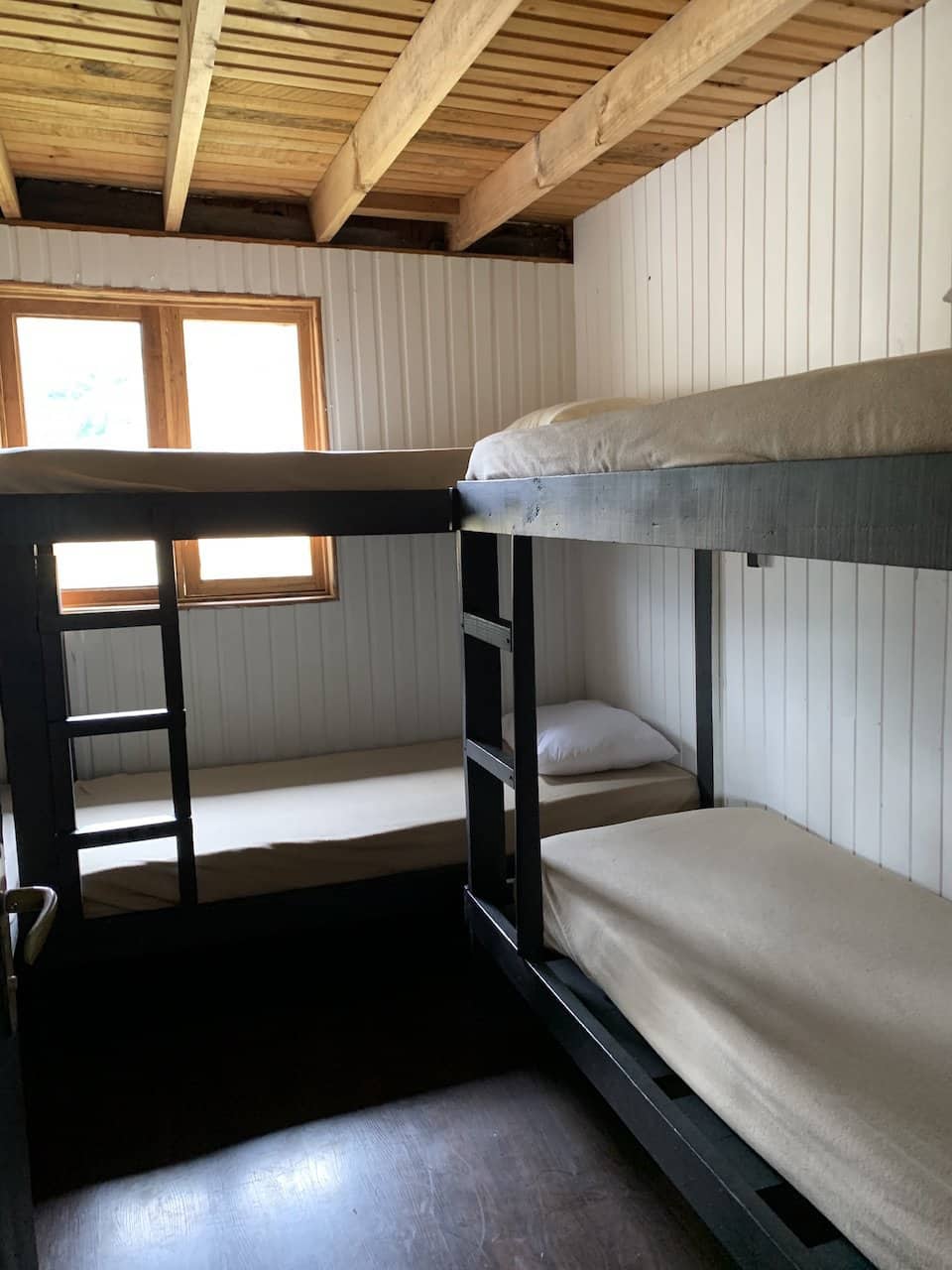
13) Torres del Paine Camping FAQs
To wrap up, I did want to answer some of the most frequently asked questions when it comes to Torres del Paine camping.
Can You Camp Anywhere in Torres del Paine?
No, you cannot camp anywhere in Torres del Paine National Park. Wild camping is prohibited.
Instead, you must only camp at the designated sectors within the park. This can be done by reserving your spots in advance through the booking systems mentioned earlier.
Can You Camp in Torres del Paine Without Reservations?
You cannot just show up to Torres del Paine without reservations for your overnight accommodation.
While reservations are not needed for day trips into the National Park (just an entrance ticket), you do need to reserve your overnight accommodations before entering the park.
If you are looking for last minute reservations, it is possible you will come across some in the online reservation systems.
Can You Do Torres del Paine Without Camping?
Yes, you can do Torres del Paine without camping. All throughout Torres del Paine you will find refugios (mountain huts) side by side next to campsites.
These refugios have shared bunk bed rooms along with shared bathrooms and hot showers in the hall.
So, if you do not want to sleep in a tent, then refugios will be your best option.
Note that refugios are not available at two campsites on the O (Seron and Los Perros). If you want to complete the O, you will need to camp for those two nights.
If heading on the W, then you will be able to stick to refugios for the full trek.
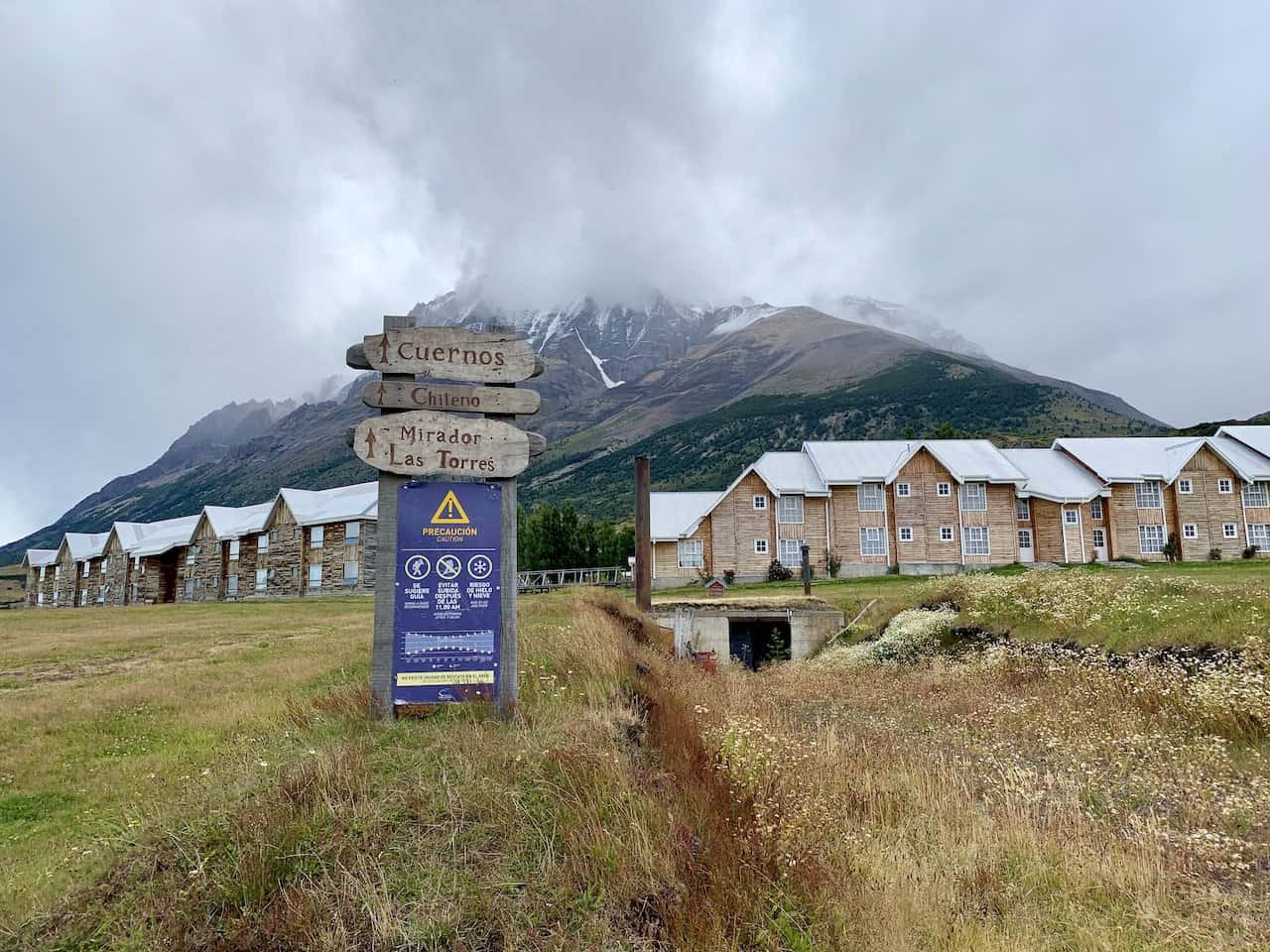
14) Puerto Natales Hotels
During your time visiting Torres del Paine, you most likely will be staying in Puerto Natales at one point or another.
While you can visit the park from the Argentinian towns of El Calafate and El Chalten , I would recommend staying directly in Puerto Natales. This way you can more easily explore the park and not be subject to just a single day trip from Argentina.
Puerto Natales is a town built for the thousands of tourists who want to visit Torres del Paine. You will find plenty of gear shops, restaurants, and hotels all throughout town.
Below would be a few of my highly rated and recommended options when it comes to hotels in Puerto Natales:
- Hotel Vendaval
- Lady Florence Dixie
By now you should have all the information you need about Torres del Paine campsites. Feel free to include any questions or comments below.
Also, don’t forget to check out the other Patagonia itineraries and guides up on the site.
Have fun out there and safe travels!
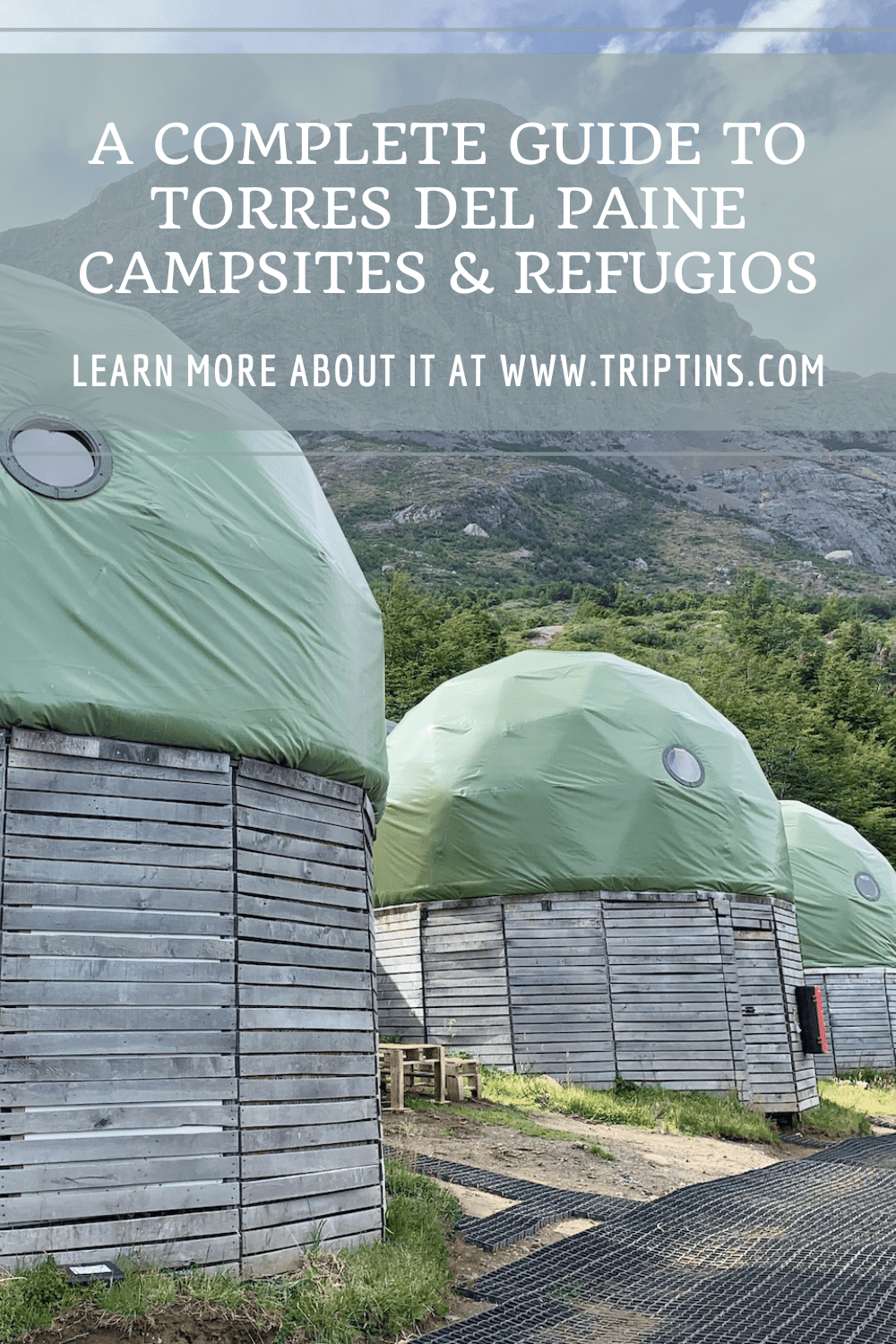
Related posts:
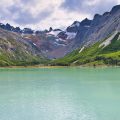
Sharing is caring!
Pavan Pakala
Wednesday 1st of November 2023
hey Charles, How much cash to bring for the O circuit? secondly, is USD fine or do we need Chilean pesos? Thanks a bunch for all your help! Pavan
Monday 13th of November 2023
@Charles, Thanks for the info. Appreciate it.
Saturday 4th of November 2023
Hi Pavan - I would recommend local currency and a credit card. I dont think I used cash though since I brought most of my food.
hey Charles, Any some suggestion/input. I am planning to bring salted nuts, dried fruits (dates, boji berries), bars and oatmeal in addition to dehydrated meals from the US to Chile for the "O" circuit. I am reading conflicting reports on google on this if this would be allowed even if declared or not. Would it be OK to bring them or buy them in either Arenas or Natales? Thanks!
Hi Pavan - I cannot speak to what is and what is not allowed by customs. I have had no issues in the past bringing dehydrated meals and fruit/nut mixes around the world. There are supermarkets though with plenty to choose from.
Tuesday 4th of July 2023
Hey Charles,
Can I buy park fees ahead of time or can I pay before starting the hike at the entrance? We are doing the O circuit in mid-december and got all the campsites booked. I am seeing conflicting information that we can buy ahead of time. Appreciate the clarification. Thx pav
Hi Pavan - yes you can buy the entrance tickets beforehand. In the O Trek guide on the site, you should see a section that links out to the booking site. Hope you have a great trek!
Monday 26th of June 2023
Hey Charles, Thanks for everything you to provide awesome info. Approximately, how many refugios and/or camp permits is given per day on the O circuit? I am curious what the numbers are for our planning purposes since we may have large group to travel in mid December. Thx!
Hi Pavan - it all depends on the sector. For example, Seron has space for 50 campsites and Grey has space for 120 campsites (and 60 people in the refugio). I would recommend that you refresh the booking websites each day and book as soon as possible once they open up. Enjoy it!
Saturday 3rd of June 2023
Hey guys, Thanks so much for such detailed info. Do they set up the tent if I were to only rent the tent on each of the campsites or do I have to select the option to also include setting up the tent? I am planning to carry rest of the stuff and rent the tent only on the O ciruit.
Sunday 4th of June 2023
Hi Pavan - yes, the tent should be set up already for you (at least that is what happened when I was there). Hope you have a great time.

Passing Thru Travel
15 Best Places in Patagonia To Visit in 2024
Posted: February 24, 2024 | Last updated: February 24, 2024
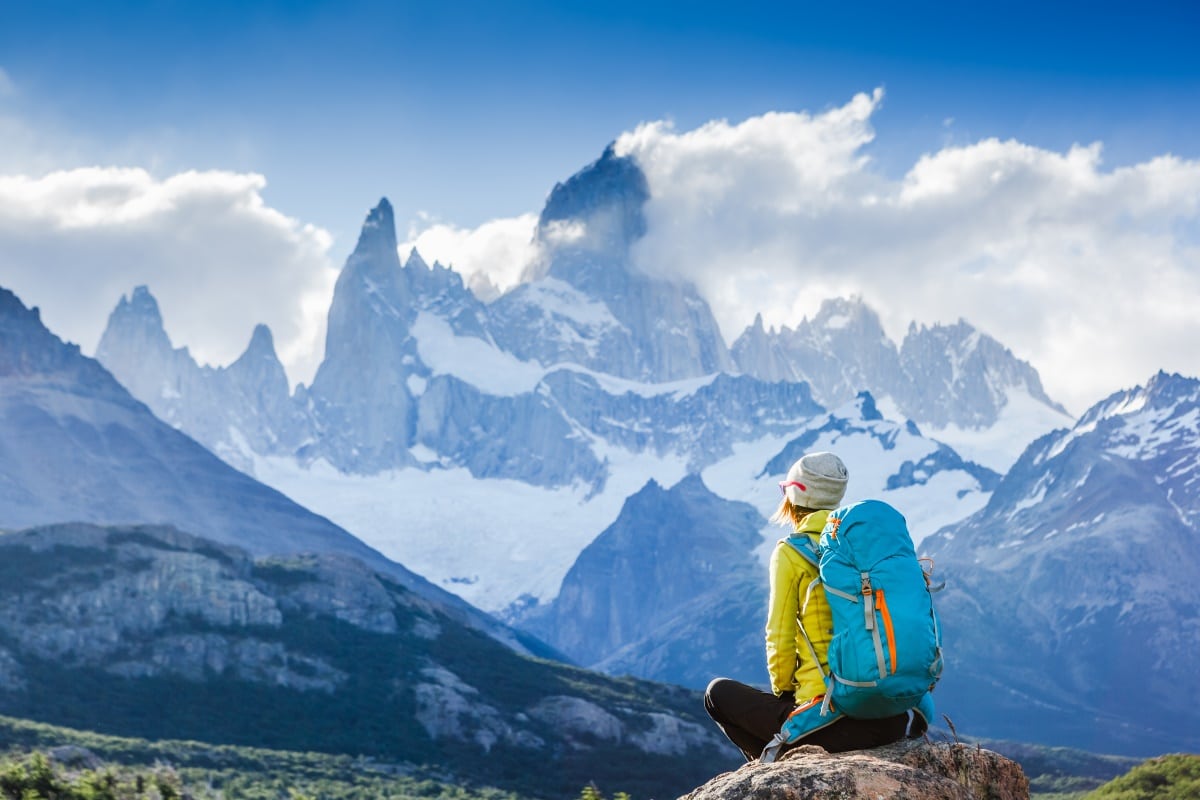
Patagonia, a region shared by Argentina and Chile, is a land of awe-inspiring natural beauty. Known for its rugged landscapes, towering mountains, and pristine glaciers, Patagonia is a haven for adventurers and nature lovers alike. This guide takes you through the most breathtaking destinations in Patagonia, each offering a unique experience of this wild and untamed region. Patagonia’s diverse landscapes promise an unforgettable journey from the iconic Torres del Paine to the remote Tierra del Fuego.
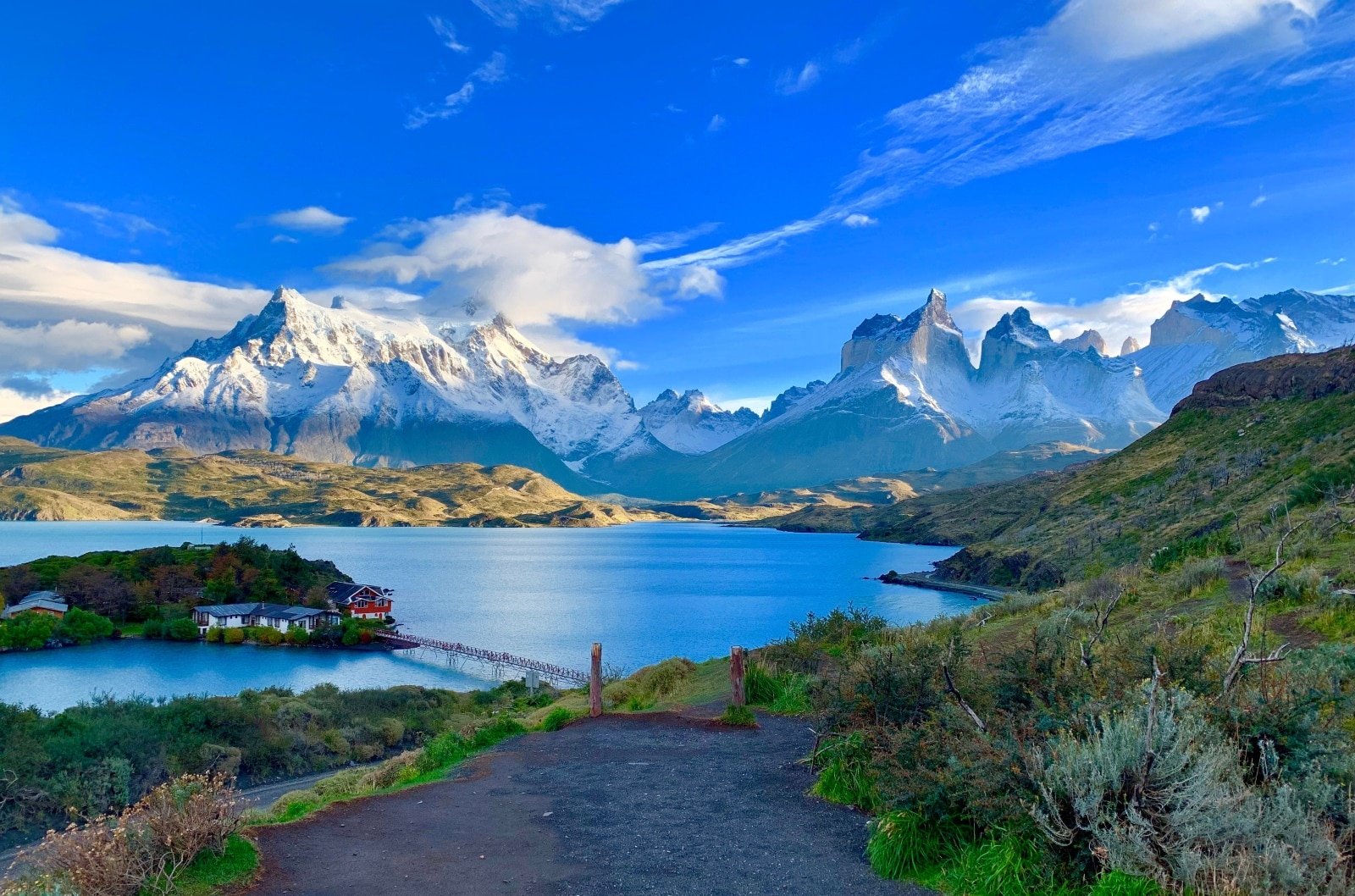
1. Torres del Paine National Park, Chile
Torres del Paine National Park, a highlight of Chilean Patagonia, is renowned for its dramatic peaks, bright blue icebergs, and vast pampas. The park’s network of trails, including the famous W Trek and the O Circuit, offers some of the world’s best trekking experiences. Hikers are treated to stunning views of the park’s namesake towers, the Paine Massif, and the Grey Glacier. The diverse ecosystems within the park, from steppe to subpolar forests, are home to an array of wildlife, including guanacos and condors.
Insider’s Tip: Book refugios or campsites well in advance if you plan to trek.
When To Travel: The best time to visit is during the Southern Hemisphere’s summer, from November to early March.
How To Get There: Fly to Punta Arenas in Chile and then take a bus or a rented car to the park.
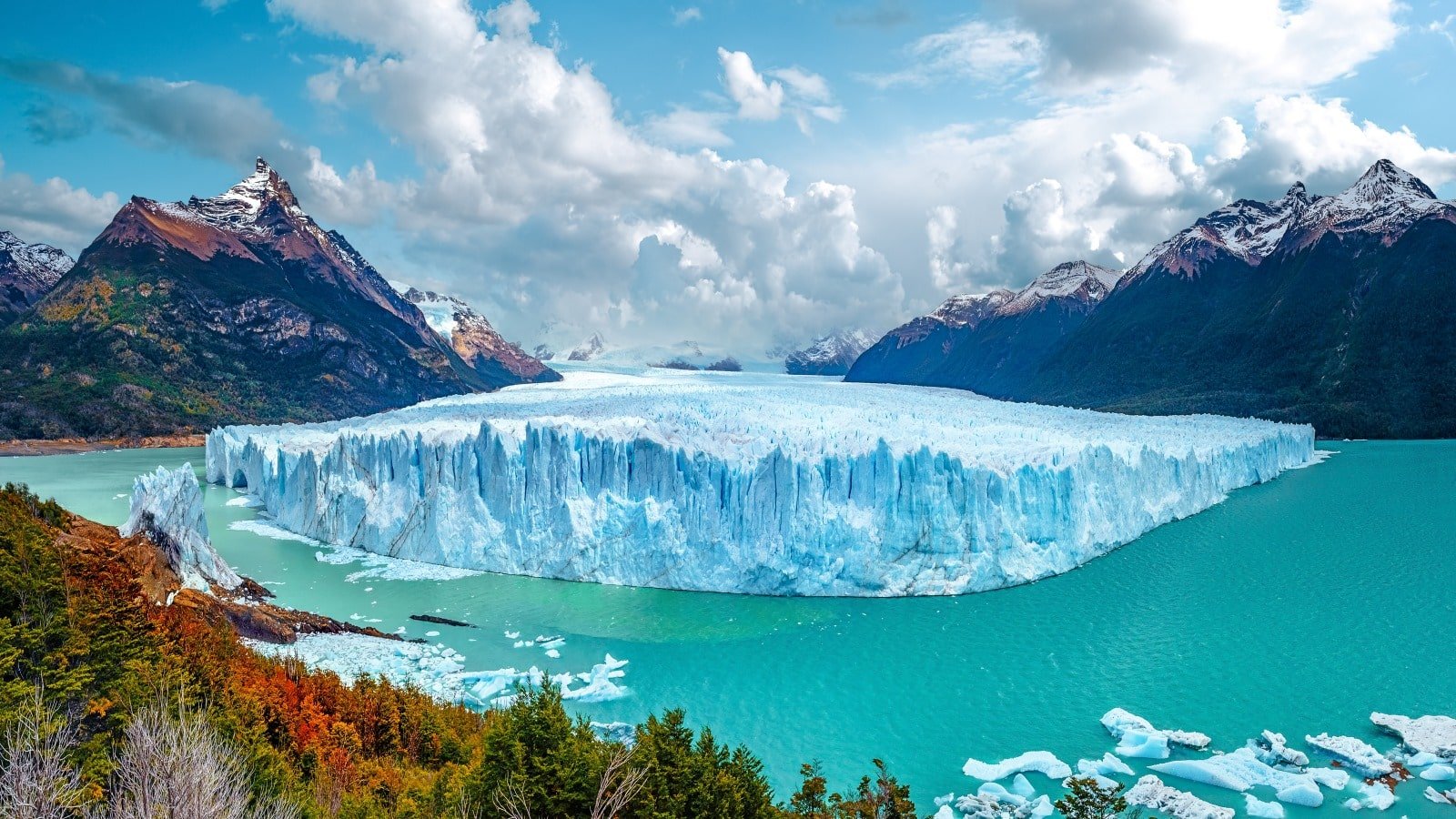
2. Perito Moreno Glacier, Argentina
The Perito Moreno Glacier, part of Argentina’s Los Glaciares National Park, is one of the most accessible and dynamic glaciers on the planet. Visitors can witness the awe-inspiring sight of ice calving from the glacier into Lake Argentino. The park offers various viewing platforms and boat tours for different perspectives of this natural wonder. Unlike many other glaciers worldwide, Perito Moreno is one of the few still growing, making it a particularly fascinating site for glaciology enthusiasts.
Insider’s Tip: Take a guided glacier walk on the ice for a memorable experience.
When To Travel: Visit between October and April for milder weather.
How To Get There: Fly to El Calafate in Argentina, and then it’s a short drive to the glacier.
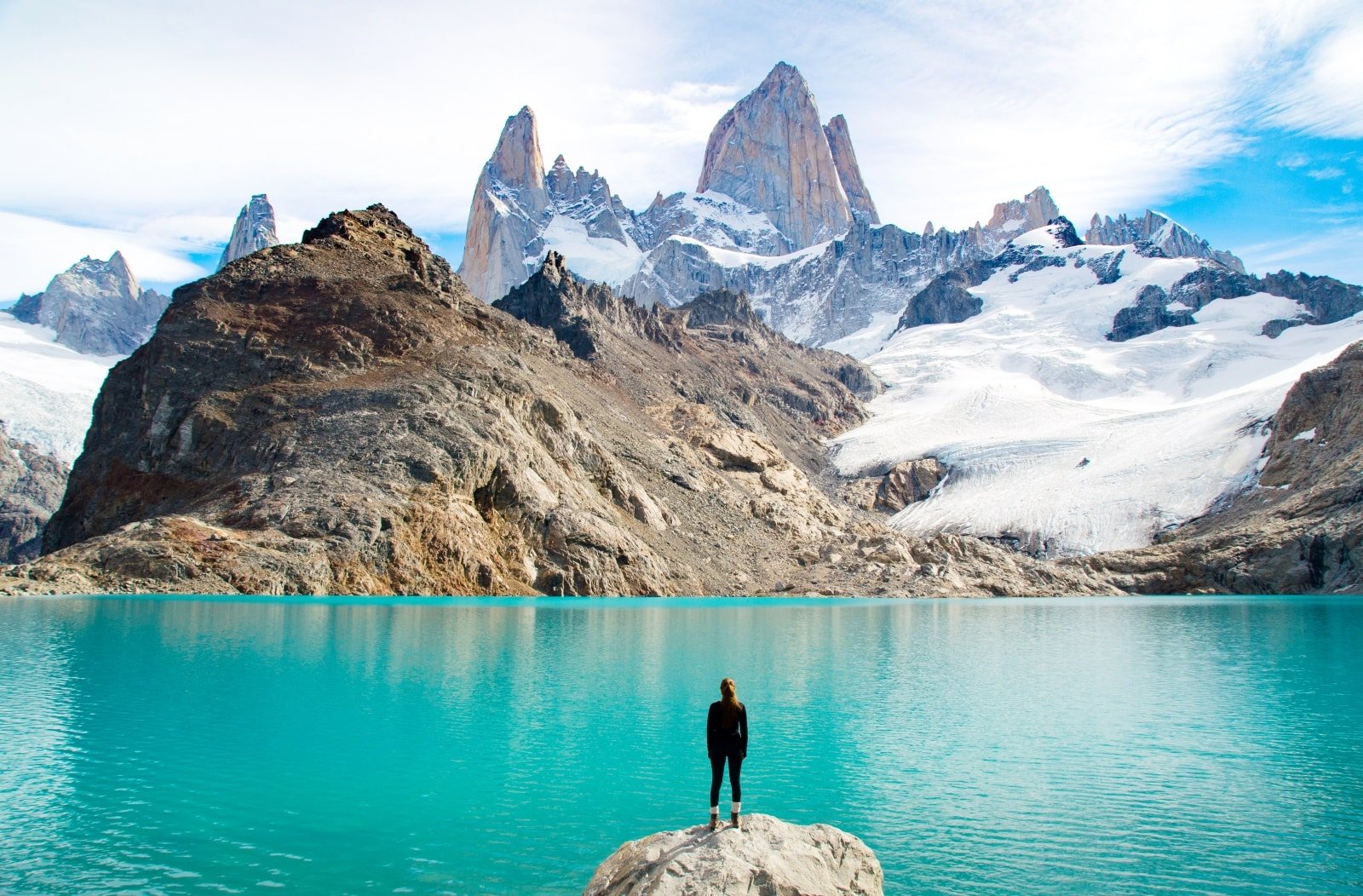
3. Fitz Roy Mountain, Argentina
Fitz Roy Mountain, near the small town of El Chaltén, is a paradise for experienced hikers and climbers. The mountain’s iconic jagged peaks present one of the world’s most challenging and rewarding climbs. For those seeking less strenuous activities, numerous trails like Laguna de los Tres offer breathtaking views of Fitz Roy and the surrounding Patagonian landscape. The town of El Chaltén itself is a charming base for exploring the region, with cozy accommodations and local eateries.
Insider’s Tip: Start your hike early in the morning to avoid crowds and enjoy the best views.
When To Travel: Trekking season runs from November to April.
How To Get There: Fly to El Calafate and then take a bus to El Chaltén.
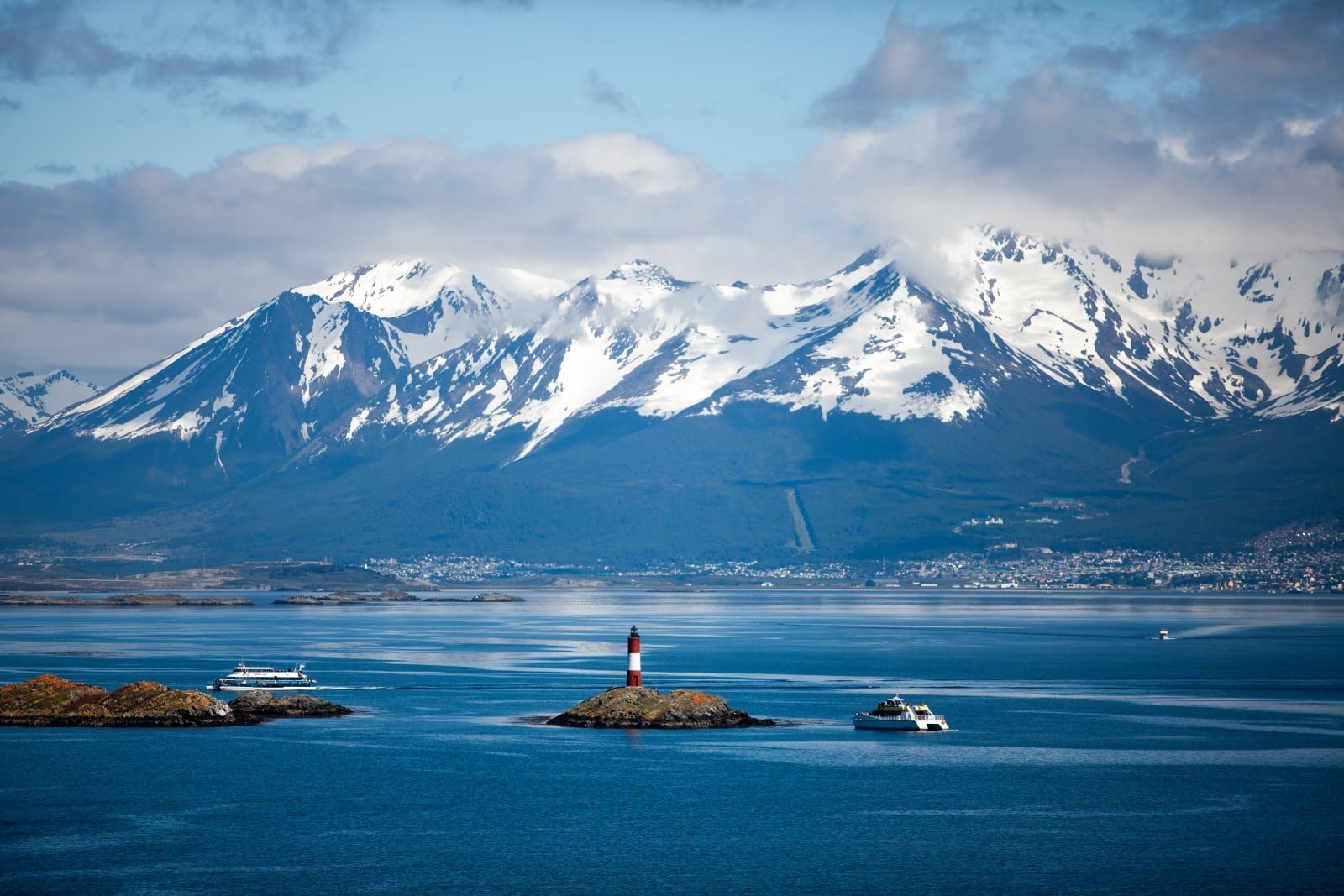
4. Tierra del Fuego, Argentina and Chile
Tierra del Fuego, an archipelago off the southern tip of South America, is a land of stark contrasts and extreme beauty. Ushuaia, the world’s southernmost city, is the gateway to this remote region. Here, visitors can explore the Tierra del Fuego National Park, take boat trips along the Beagle Channel, or embark on expeditions to Antarctica. The region’s unique flora and fauna, including Magellanic penguins and Andean foxes, make it a fascinating destination for wildlife enthusiasts.
Insider’s Tip: Visit the End of the World Museum in Ushuaia to glimpse the area’s history.
When To Travel: The best time is during the Southern Hemisphere’s summer, from December to March.
How To Get There: Fly to Ushuaia from major cities in Argentina or Chile.
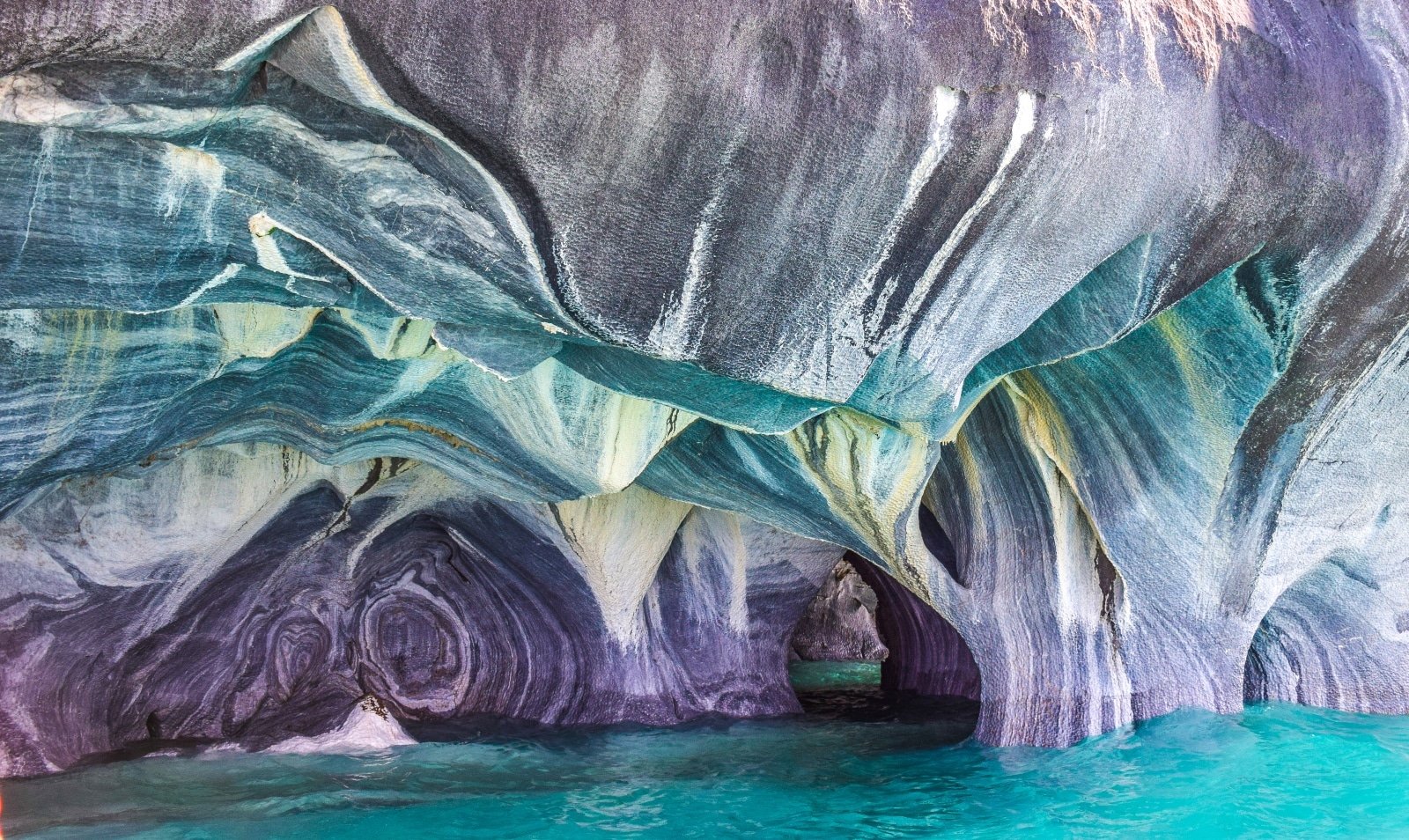
5. Marble Caves, Chile
The Marble Caves on Lake General Carrera are a breathtaking natural formation. Millennia of waves washing against calcium carbonate have sculpted these caves into stunning formations. The caves’ walls, with their swirling patterns of blue and grey, are a photographer’s dream, especially when reflected in the lake’s azure waters. Accessible only by boat, the caves offer a serene and otherworldly experience.
Insider’s Tip: Take a boat or kayak tour for the best views of the caves.
When To Travel: Visit between September and February for the best weather.
How To Get There: Fly to Balmaceda, then drive to Puerto Río Tranquilo, where tours to the caves are available.
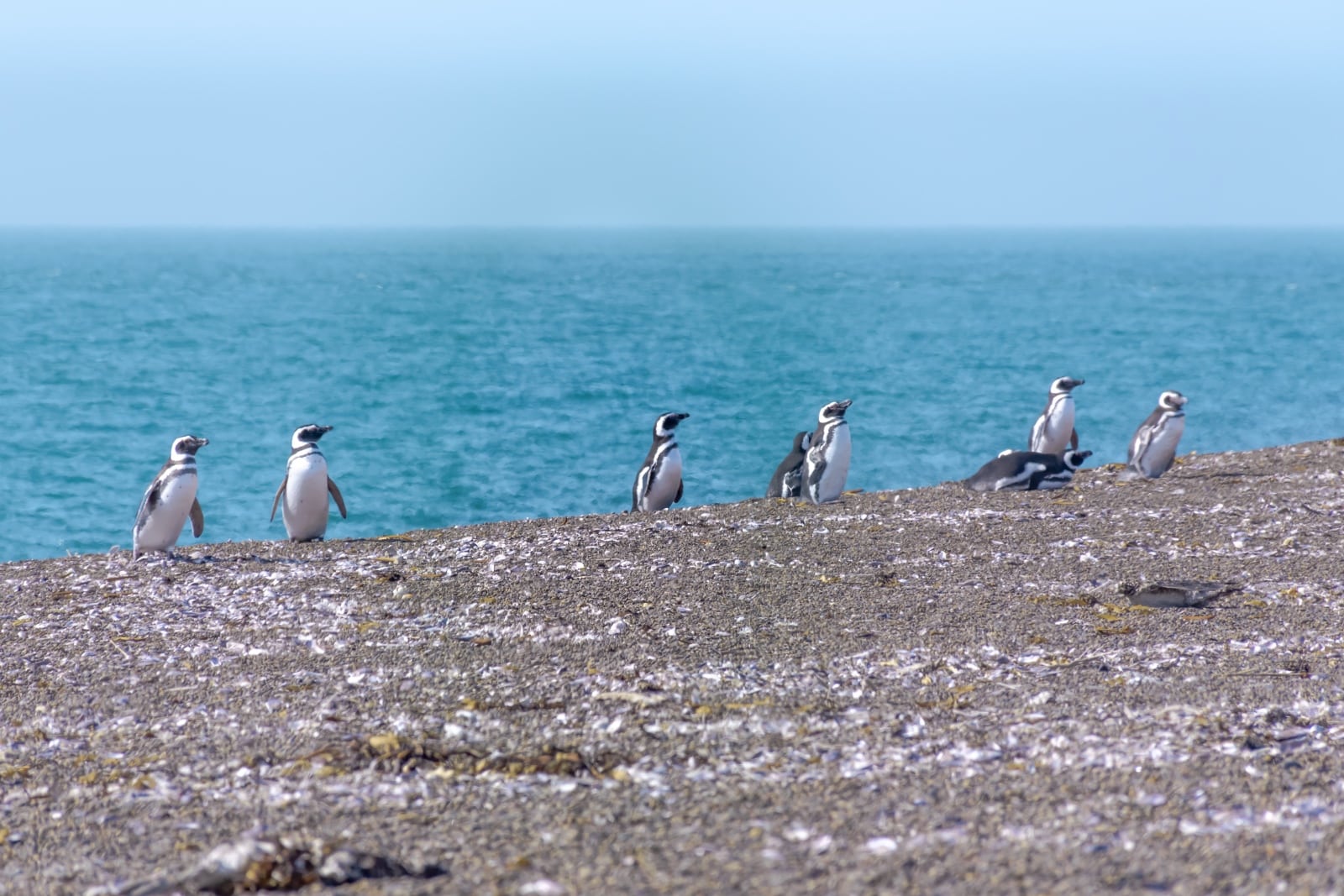
6. Valdés Peninsula, Argentina
Image Credit: Shutterstock / Natalia Di Marco The Valdés Peninsula is a UNESCO World Heritage Site celebrated for its unique marine wildlife and rugged coastline. It’s one of the best places in the world to see Southern Right Whales, which come close to shore between June and December. The peninsula also hosts large colonies of sea lions, elephant seals, and various bird species. Its steppe-like interior and dramatic coastline offer stunning landscapes and excellent wildlife viewing opportunities.
Insider’s Tip: Take a whale-watching tour between June and December to see Southern Right Whales.
When To Travel: Wildlife viewing is best from September to March.
How To Get There: Fly to Puerto Madryn or Trelew, then drive to the peninsula.
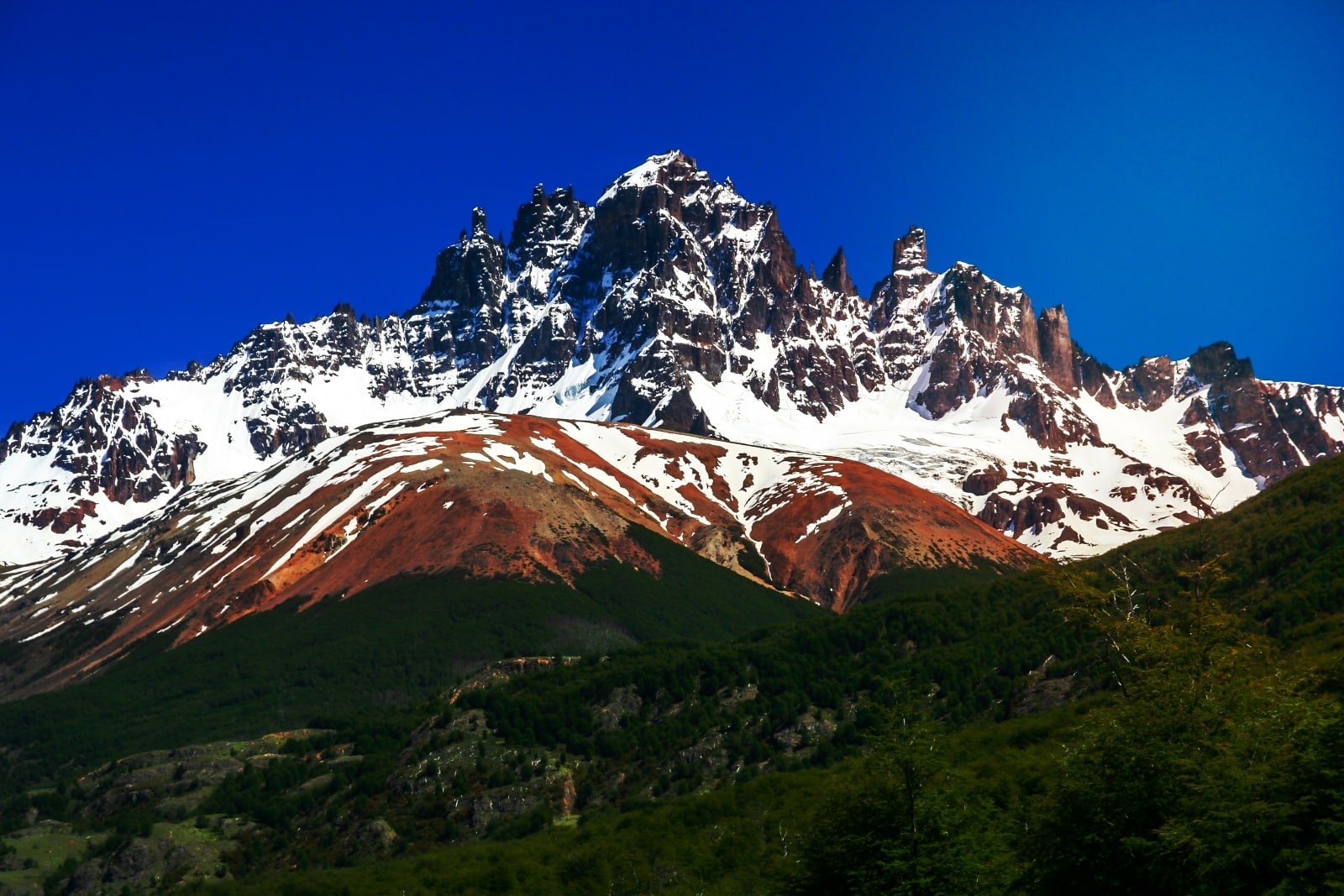
7. Cerro Castillo, Chile
Cerro Castillo, less crowded than Torres del Paine, offers equally stunning scenery for those willing to venture off the beaten path. The trek around Cerro Castillo takes you through diverse landscapes, including forests, alpine meadows, and high mountain passes, with the castle-like peaks of Cerro Castillo as a constant backdrop. The trek is challenging but rewards hikers with incredible views of glaciers, turquoise lakes, and the Patagonian wilderness.
Insider’s Tip: Pack for all weather conditions, as the weather can change rapidly.
When To Travel: The trekking season is from November to April.
How To Get There: Fly to Balmaceda and then drive or take a bus to Villa Cerro Castillo.
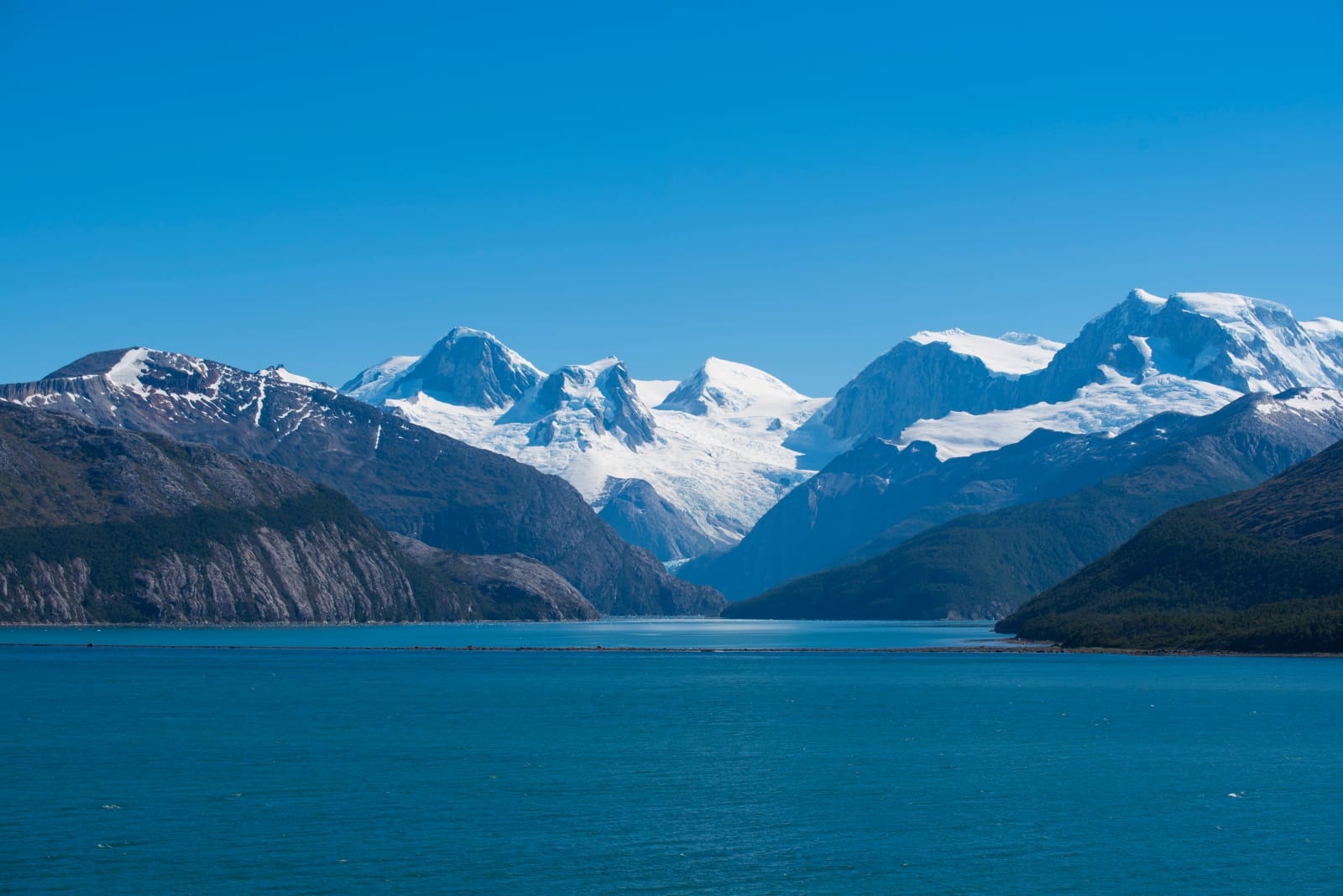
8. Cape Horn, Chile
At the southernmost tip of the South American continent, Cape Horn is a legendary location known for its challenging sailing conditions and rich maritime history. Cruises to this remote area offer a unique opportunity to experience the wild beauty of the southern seas and the sense of adventure that comes with reaching the “end of the world.” The area is also significant for its unique flora and fauna adapted to harsh conditions.
Insider’s Tip: Choose a cruise that includes lectures on the region’s history and wildlife.
When To Travel: Cruises run during the Southern Hemisphere’s summer, from December to March.
How To Get There: Cruises to Cape Horn typically depart from Ushuaia.
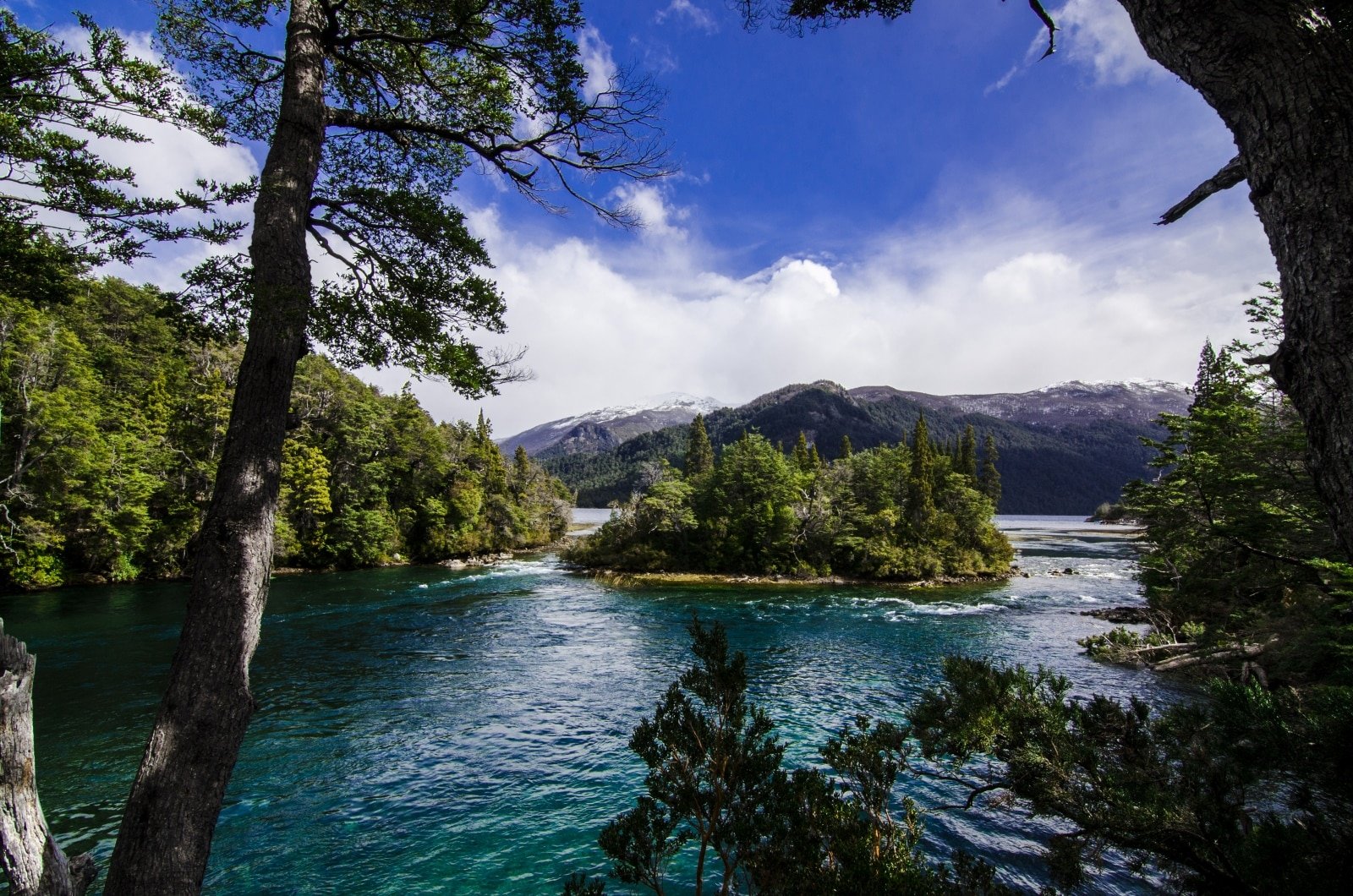
9. Los Alerces National Park, Argentina
Los Alerces National Park, a UNESCO World Heritage Site in Argentina, is known for its ancient Alerces trees, some of which are over 3,000 years old. The park’s lakes, rivers, and forests offer a serene setting for hiking, kayaking, and fishing. The park is a testament to Argentina’s commitment to conservation, with well-maintained trails and minimal-impact tourism practices. The park’s diverse ecosystems are home to various wildlife, including deer, pumas, and several bird species.
Insider’s Tip: Explore the Arrayanes Forest for a magical walk among unique cinnamon-colored trees.
When To Travel: Visit from October to April for the best weather.
How To Get There: Fly to Esquel and then drive to the park.
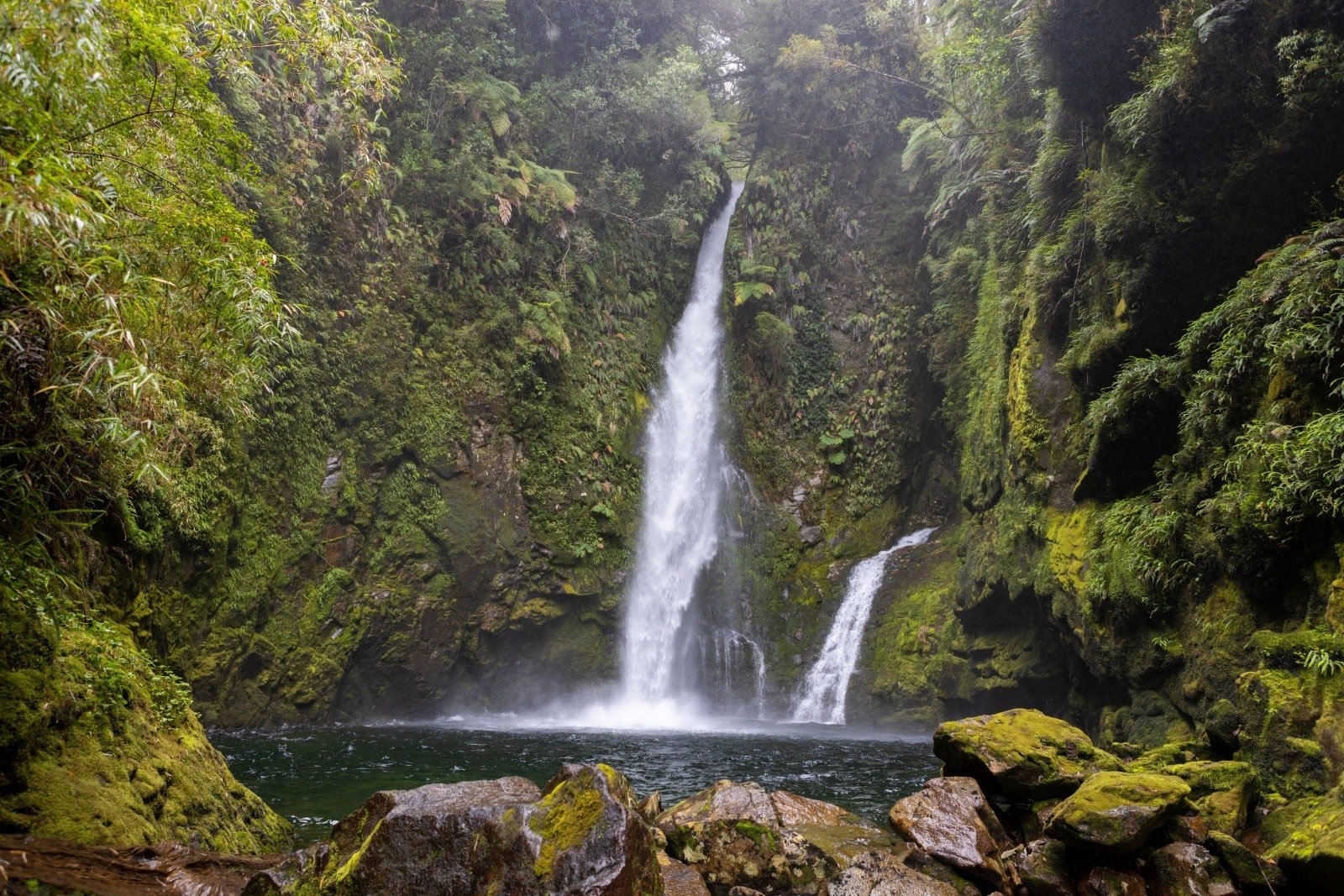
10. Pumalín Park, Chile
Pumalín Park, one of the largest private parks in the world, is a testament to conservation efforts in Chilean Patagonia. Created by conservationist Douglas Tompkins, the park spans over 400,000 hectares of temperate rainforests, fjords, and waterfalls. Visitors can hike through pristine forests, kayak along untouched fjords, and witness the park’s commitment to environmental preservation firsthand. The park’s infrastructure, including trails and campgrounds, is designed to minimize human impact on the environment.
Insider’s Tip: Visit the park’s environmental information centers to learn about its conservation efforts.
When To Travel: The best time to visit is from December to March.
How To Get There: Fly to Puerto Montt, then drive or take a ferry to the park.
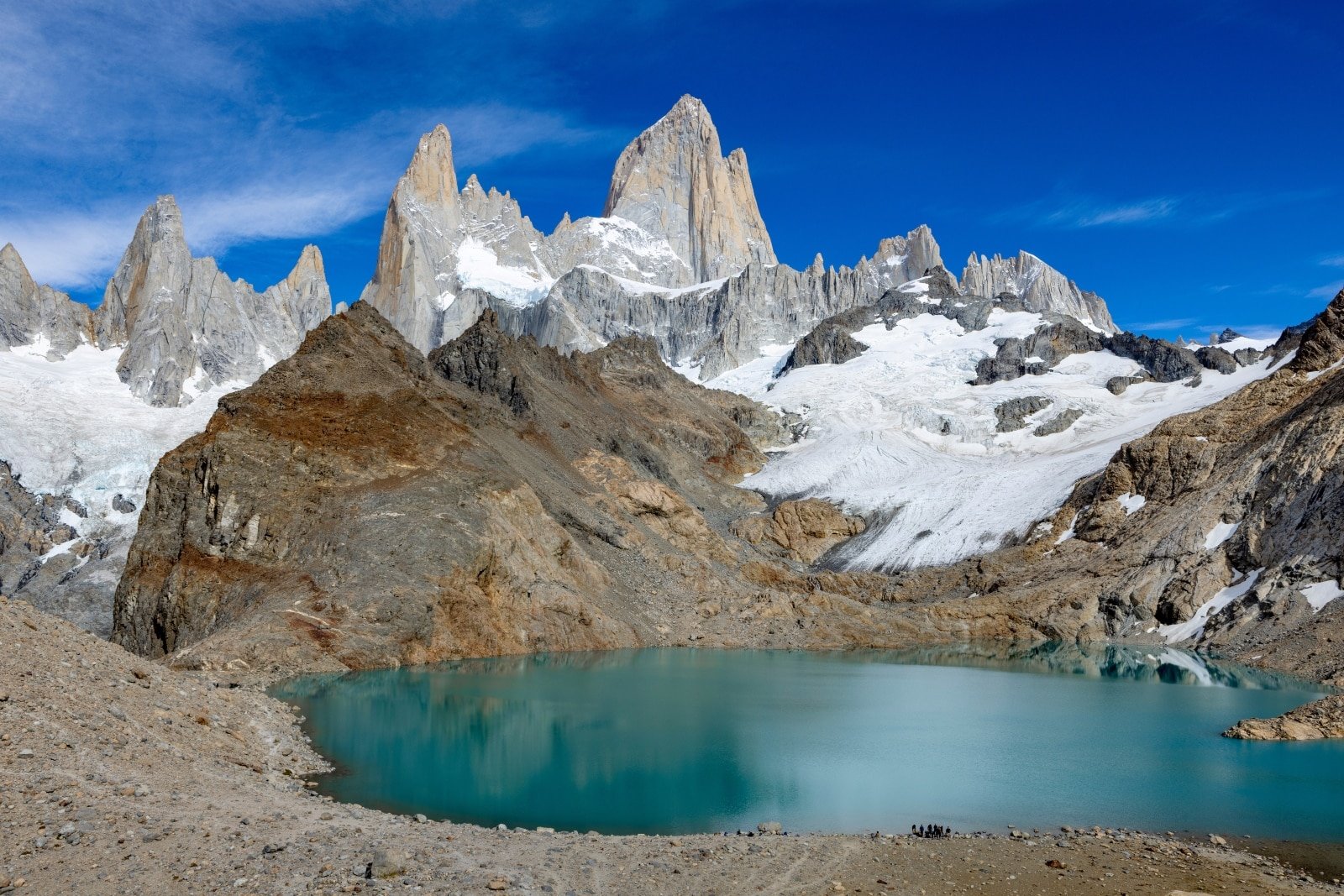
11. El Chaltén, Argentina
El Chaltén, often called Argentina’s trekking capital, is the gateway to some of Patagonia’s most iconic trails. The town offers a range of trekking options, from easy day hikes to challenging multi-day expeditions. The surrounding landscapes of glaciers, lakes, and mountains provide a stunning backdrop for outdoor activities. In addition to trekking, visitors can enjoy rock climbing, horseback riding, and fishing.
Insider’s Tip: Visit the Los Condores viewpoint for a stunning panoramic view of the town and surrounding peaks.
When To Travel: Trekking season is from October to April.
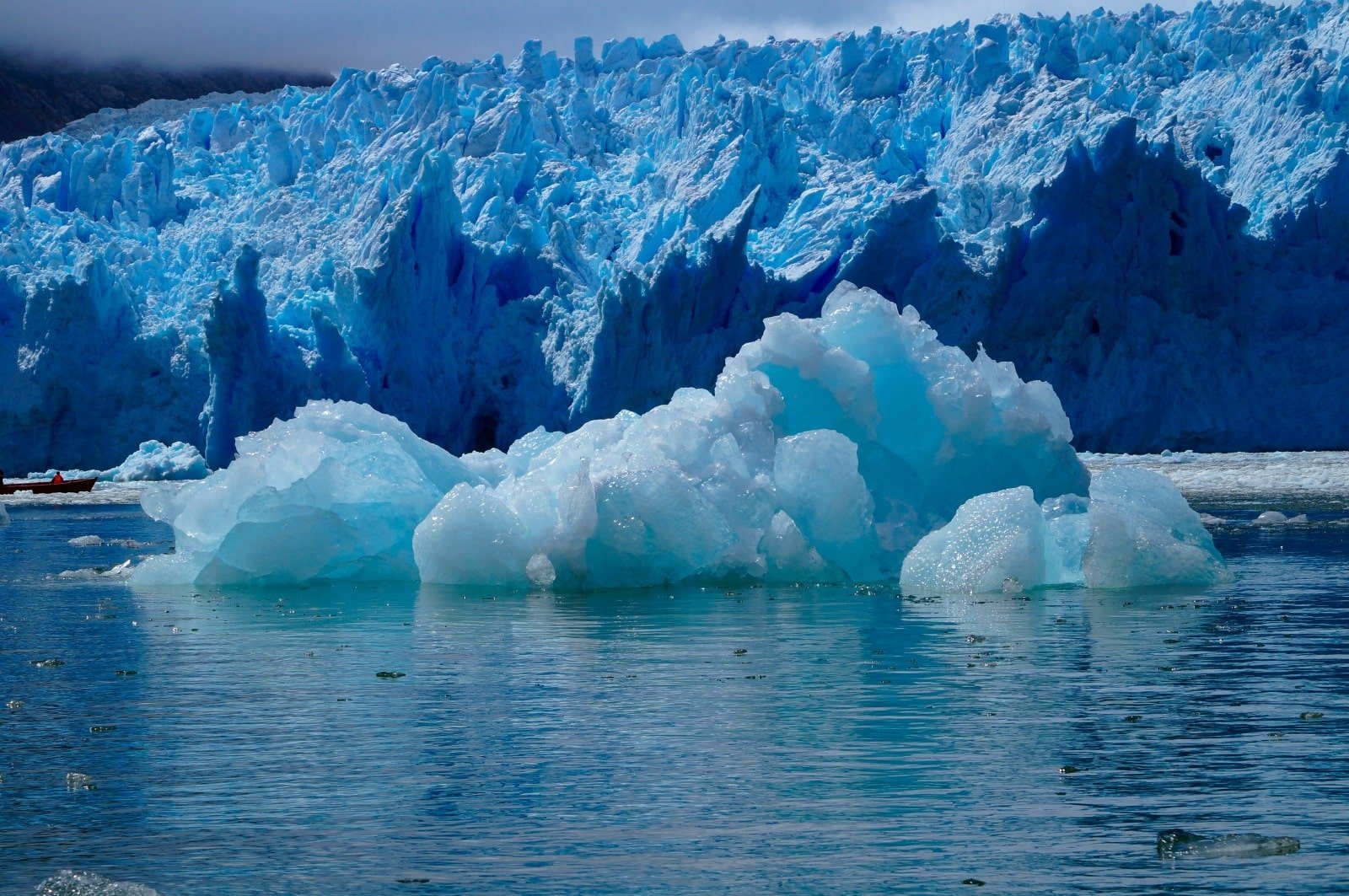
12. Laguna San Rafael National Park, Chile
Laguna San Rafael National Park is home to the San Rafael Glacier, one of the largest and most actively calving glaciers in the Chilean Patagonia. The park offers boat tours that provide close-up views of the glacier and the icebergs in the lagoon. The park’s remote location and stunning ice landscapes make it a must-visit for adventure seekers and nature enthusiasts. Visitors can also explore the surrounding rainforests and spot wildlife such as sea lions and dolphins.
Insider’s Tip: Take a boat tour that includes visiting the hot springs at Quitralco Fjord.
When To Travel: The best time for boat tours is from October to April.
How To Get There: Access is mainly by boat or plane from Coyhaique or Puerto Chacabuco.
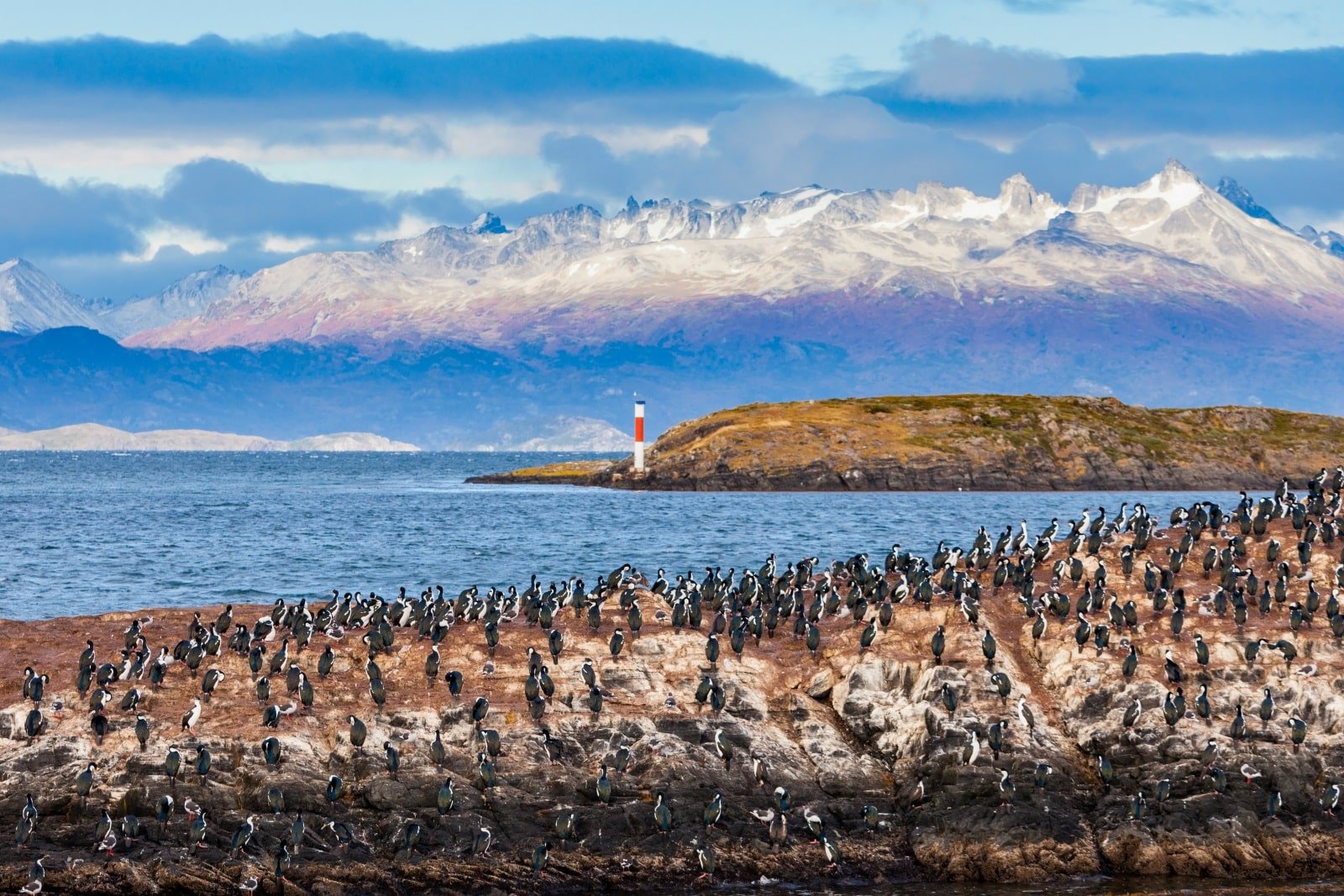
13. King Penguin Colony, Tierra del Fuego, Chile
The King Penguin Colony on the Chilean side of Tierra del Fuego offers a unique opportunity to observe these majestic birds. Located at Parque Pingüino Rey, the colony is one of the few places outside Antarctica where you can see king penguins in their natural habitat. The park provides a respectful and sustainable way to observe the penguins, with designated viewing areas to minimize disturbance.
Insider’s Tip: Respect the penguins’ space and observe them from a distance to avoid disturbing them.
When To Travel: Penguins can be seen year-round, but the best time is during the breeding season, from September to March.
How To Get There: Fly to Punta Arenas, take a ferry and drive to the park.
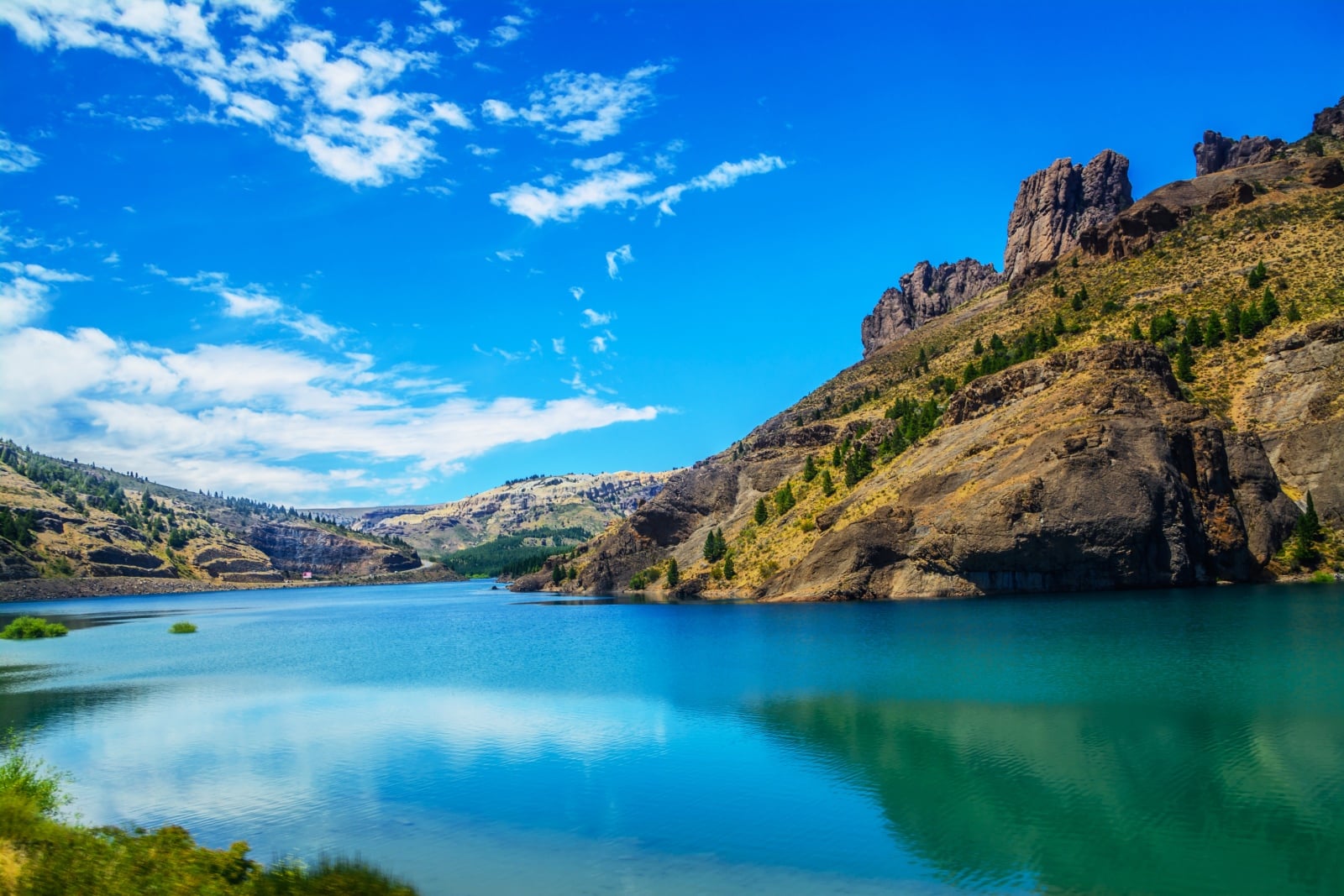
14. Bariloche, Argentina
San Carlos de Bariloche, known simply as Bariloche, offers a unique combination of stunning natural landscapes and a lively city atmosphere. Bariloche is located in Argentina’s Lake District, a hub for outdoor activities like hiking, kayaking, and mountain biking. The city’s Swiss-style architecture and renowned chocolate shops add to its charm, making it a popular destination year-round. In winter, Bariloche transforms into a ski resort, while the summer months are perfect for exploring the surrounding lakes and mountains.
Insider’s Tip: Take the cable car to Cerro Campanario for one of the best views in the region.
When To Travel: Visit from December to March for outdoor activities and pleasant weather.
How To Get There: Fly to Bariloche Airport, with regular flights from Buenos Aires.
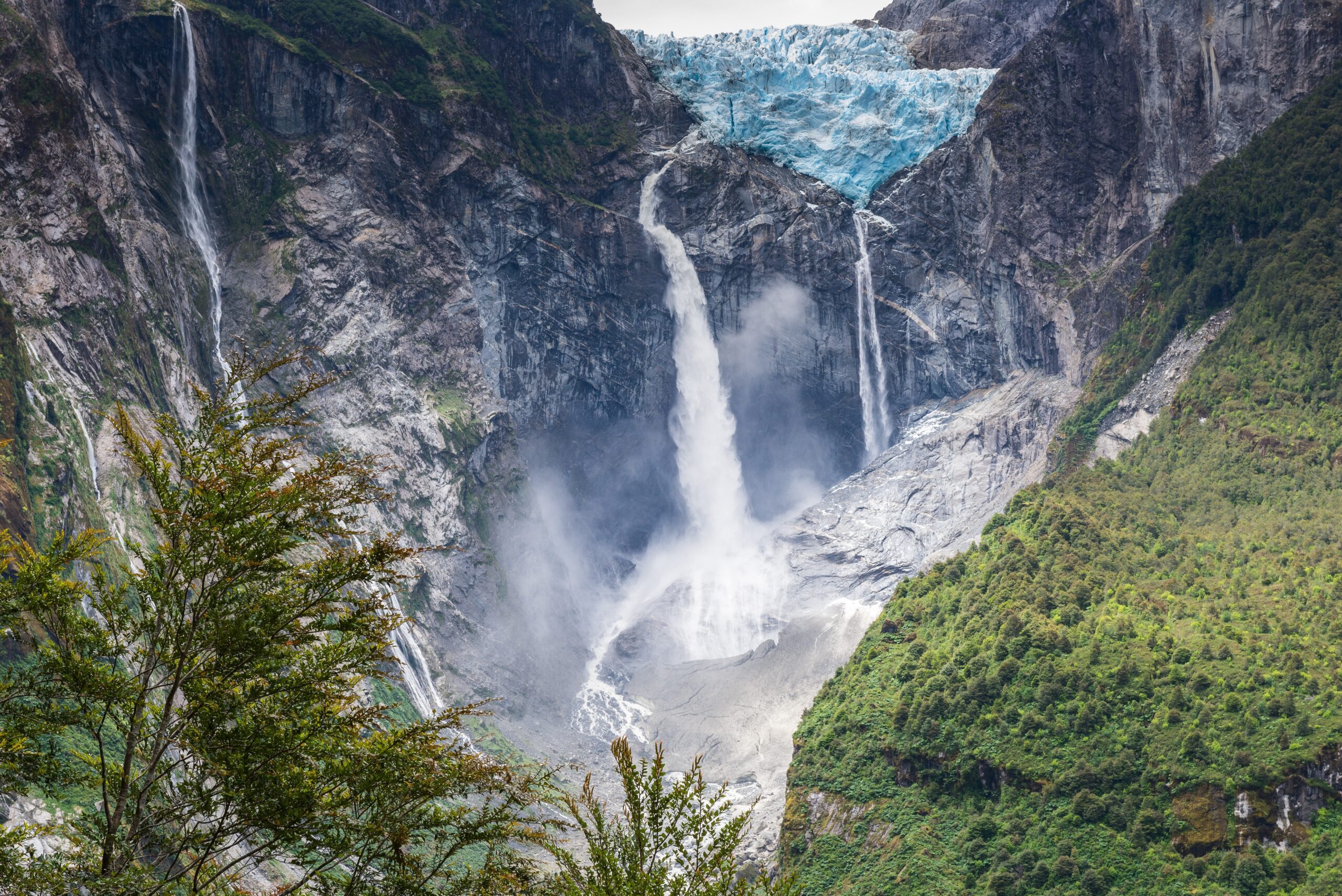
15. Aysén Region, Chile
The Aysén Region in Chilean Patagonia is a secluded paradise for adventurers. Less crowded and largely untouched, it offers a wilderness experience that includes the Northern Patagonian Ice Field and numerous fjords. The Carretera Austral, a scenic route through the region, leads to remote beauty spots ideal for hiking, kayaking, and fishing. Aysén’s rugged terrain and pristine landscapes are perfect for those seeking an immersive nature experience away from tourist trails.
Insider’s Tip: Plan a road trip along the Carretera Austral for a unique way to explore the region’s diverse landscapes.
When To Travel: The best time to visit is during the Southern Hemisphere’s summer, from December to March.
How To Get There: Fly to Balmaceda Airport and rent a car for the best exploration experience.
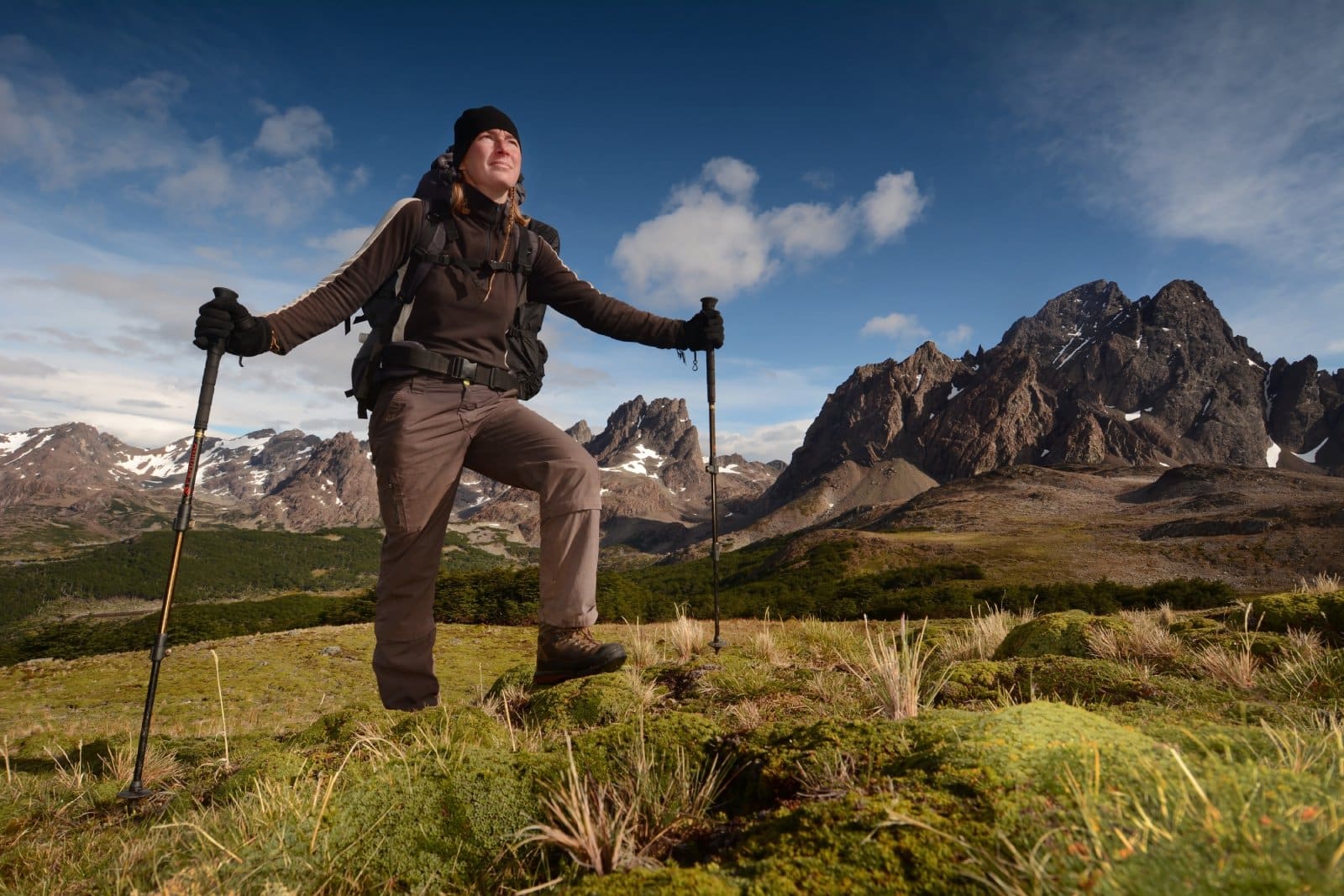
The Bottom Line
Patagonia is a land of endless natural wonders, offering experiences that range from witnessing colossal glaciers to trekking through pristine forests. Each destination in this vast region presents an opportunity to connect with nature and witness the raw beauty of one of the world’s most spectacular landscapes. As you plan your journey through Patagonia, remember that the true essence of this place lies in its wild and untamed spirit, inviting you to explore and discover its many treasures.
More Articles Like This…
Barcelona: Discover the Top 10 Beach Clubs
2024 Global City Travel Guide – Your Passport to the World’s Top Destination Cities
Exploring Khao Yai 2024 – A Hidden Gem of Thailand
The post 15 Best Places in Patagonia To Visit in 2024 republished on Passing Thru with permission from The Green Voyage .
Featured Image Credit: Shutterstock / Olga Danylenko.
For transparency, this content was partly developed with AI assistance and carefully curated by an experienced editor to be informative and ensure accuracy.
More for You
NATO Aircraft Scrambled After Massive Russian Missile Strikes
Woman with rare syndrome left allergic to ‘everything’ except just four foods
Your senses will shut down in a specific order when you’re about to die
Fireball drops from New Jersey sky, days after eclipse and earthquake
Putting money in bank accounts is 'the worst thing you can do' for taxes, says former Intuit CEO
13 McDonald's Menu Items From The 1990s You Probably Forgot About
Dam Starts to Leak After 60-Foot Crack Sparks Urgent Warning
New hypothesis emerges on Parkinson's disease's origins and spread
Reacher Season 3: Expected Release, Plot, Cast & News
The real US Navy Top Gun fighter school is nothing like the movies
Private Japanese Moon Lander's View Of Solar Eclipse Shadow And Earth
Jon Stewart is getting slammed for ‘overvaluing’ his NYC home by 829% after labeling the Trump case as 'not victimless' — but here’s what his critics are missing
Kim Jong Un Threatens North Korea's Enemies With 'Death Blow'
The Dumbest Things You Can Do With Your Money
Krispy Kreme's Newest Collection Looks Absolutely Incredible
Peanuts by Charles Schulz
Common over-the-counter medicine linked to increased dementia risk
Trump Deposition in SPAC Suit Scrapped Ahead of Criminal Trial
What Makes A Spanish Potato Omelet Unique?
32-year-old mom who makes $143,000/month in passive income: 5 books that helped me get started

IMAGES
VIDEO
COMMENTS
W trek in Torres del Paine - a 4-day itinerary. If for some reason your time in Torres del Paine is limited you can walk the W trek in 4 days. Day 1. Paine Grande campsite - Grey campsite - Paine Grande campsite, 22 km/13,6 mi. Bus Puerto Natales Torres del Paine (Pudeto); ferry Pudeto - Paine Grande, 3-4 hours.
2. Refugio Grey (5/5) - great lodge, well run, close to Grey glacier. 3. Refugio Chileno (4/5) - the most wild feeling but in a high traffic area. 4. Refugio Paine Grande (3/5) - nice facilities but crowded and long breakfast wait times. 5. Refugio Torres Central (2/5) - great food but brutal service and poor location.
Camping reservations for the W trek, Torres del Paine Torres del Paine National Park is one of Patagonia's most unmissable travel destinations. There are two different ways that you can hike the W, depending on whether you start at the western corner of the trek and hike east or at the eastern corner of the trek and hike west.
The red line is the Torres del Paine W Trek. You can see it forms a W on the map. Length: 80 km (50 mi) Elevation gain: 2,730 m (8,956 ft) Route type: Point to point Difficulty: Moderate The Torres del Paine W Trek is part of the complete circuit around the national park called the "O Circut" or "Big Circut".
When taking on the Torres del Paine W and Circuit, refugios offer the benefit that you only need to bring a minimum of gear - beds, sleeping bags, and meals at the restaurant can all be rented or purchased along the way. The downside is cost, as all in gear rental, meals, and refugio accommodation can easily hit ~$200 USD per day.
Hiking atop the John Gardner Pass and overlooking the South Patagonia Icefield. Photo: Getty. Distance: 85 miles (136km) Days: 7-9 days. If the W Trek is the most direct route to the highlights of Torres del Paine, the O Circuit is the more complete way to see the park.
The most popular trek in Patagonia, the Torres Del Paine W Trek is fast becoming one of the most well-respected short hikes in the world due to the trail's stunning scenery. Guanaco in Torres Del Paine. Located in the amazing Torres del Paine National Park which was made a World Biosphere Reserve by UNESCO in 1978.
The W Trek is in Torres Del Paine National Park, on the Chilean side of Patagonia. It is Torres del Paine's most famous hiking route: a four or five day hike that can be walked without carrying gear or food, between refugios or campsites, with spectacular views of the granite towers that gave the park its name.
Day 1 take the 2:30pm bus from Puerto Natales to Torres Del Paine National Park and arrive at (#1)Camp Central about 2.5 hours later. Explore the area, enjoy the sunny weather, get a drink at the fancy hotel near camp and Pisco Sours with dinner at the Refugio. Settle in for the night filled with excitement and naïveté.
Distance: 13 kilometers (8 miles) plus 8 kilometers (5 miles) for the hike from the Centro de Bienvenida to Laguna Amarga) Duration: 6 hours hiking (add an extra 1.5-2 hours for the hike to Laguna Amarga) 4:30am Wake up and take a small bag (including warm clothes and a snack) to see the torres at dawn.
Premium Camping - Fully Equipped Experience. Day 1: Transportation from Puerto Natales to Torres del Paine, lodging at Central Sector. Day 2: Hike to Las Torres Base, lodging at Central Sector. Day 3: Hiking to Francés Sector (o Cuernos), lodging Francés Sector (o Cuernos). Day 4: Hike to the Francés Valley, lodging at Paine Grande Sector.
Las Torres runs the other 5 campsites in Torres Del Paine. For the W Trek, you will utilize them on nights 3 & 4 (choosing between a couple options for each). They also run the Seron campsite that is located on the O. Frances (night 3) -> campsites & refugio; Cuernos (night 3 alternative) -> campsites, refugio, & mountain cabin
The Patagonia W Trek can be done all year round, but the best time is from November to March. Chile is in the southern hemisphere, so this is spring/summer when temperatures are warmer and there's usually less rain and snow. If you're planning to hike Torres del Paine without a guide, it's critical to download a GPS map ahead of time.
Camping in Torres Del Paine; 6 Options If You CAN'T Get Torres Del Paine Reservations; Torres Del Paine Park Information, Fees, and Boat Schedules [separator style_type="single" /] Leave No Trace When Hiking in Patagonia. Whether you are traveling with a guide or not, please educate yourself on local Leave No Trace practices.
The 'W' trek is the name given to the W shaped beaten track that interlinks the 3 Granite Paine Towers, the French Valley, and the Grey Glacier. The trek is approximately 70 kilometers (43 miles) in total distance and is one of the most scenic treks in the world. This trek option includes camping along the trail every night.
W Trek Torres del Paine Campsites. If you're planning on trekking the W, you can complete it in anywhere from 3-5 days, depending on how quickly you hike and where you choose to stay. There are two options for starting the trek: the west side (Lago Grey) or the east side (Torres Central). The itineraries in the previous section are a loose ...
Booking Camping and Accommodation on the W Trail. Bus tickets to and from Torres del Paine. Packing for the W Trek. Our Self-guided itinerary for hiking the W Trail. Day 1 - Puerto Natales to Chileno via Las Torres. Day 2 - Chileno to Francés. Day 3 - Francés to Paine Grande via Francés Valley. Day 4 - Paine Grande to Grey.
Here's a quick six-day trip that's simply perfect as an add-on to other Patagonian adventures. Torres del Paine's W Trek is celebrated by active travellers globally as one of the most scenic treks anywhere. Spend four days walking through stunning landscapes surrounding Grey Glacier, French Valley, and the imposing three towers. While the trek alone is challenging enough, the real contest ...
The W Trek in Torres Del Paine National Park is a visual symphony of natural wonders. Each leg of the journey unveils a new chapter in this captivating wilderness narrative. Here, we delve into the breathtaking highlights and scenic spots that await you: ... No. Camping in Torres del Paine is restricted to designated campgrounds. This means ...
This 5 day camping version of the W trek takes you along trails reaching glaciers, lakes, forests and the mighty Paine Towers, feeding your trekking-hungry soul every step of the way. The name "W" comes from the formation of a perfect W with the coming together of the paths than surround the southern sector of the Macizo del Paine. The principal attractions of the W Circuit are: Base ...
Step 1: Choose O trek or W trek (or Q trek) W trek is by far the most popular showing you the highlights of Torres del Paine with ski lodge-style accommodation available in addition to camping. O trek requires camping which alone excludes a lot of people who simply don't want to camp. The W trek is part of the O trek so by doing the O trek ...
4) Torres del Paine W Trek Camping Although the W Trek can be shortened, a 5 day W Circuit is the ideal amount of time to spend out on the trail. The W can be completed either west to east (preferred direction), or east to west.
Put simply, the O Trek or O Circuit, is a trail that loops within Torres del Paine National Park (also known as " Los Torres"). Visitors must book campsites in advance and walk counter ...
Torres del Paine - The W Trek (6 Days) Multi-Day Tour. Valid for Departures: 13 Apr 2024 - 18 Apr 2026. Puerto Natales, Chile to Puerto Natales, Chile. G Adventures Inc. Adventure. Here's a quick six-day trip that's simply perfect as an add-on to other Patagonian adventures. Torres del Paine's W Trek is celebrated by active travellers globally ...
Torres del Paine National Park, a highlight of Chilean Patagonia, is renowned for its dramatic peaks, bright blue icebergs, and vast pampas. The park's network of trails, including the famous W ...